TWO-DAY AUCTION
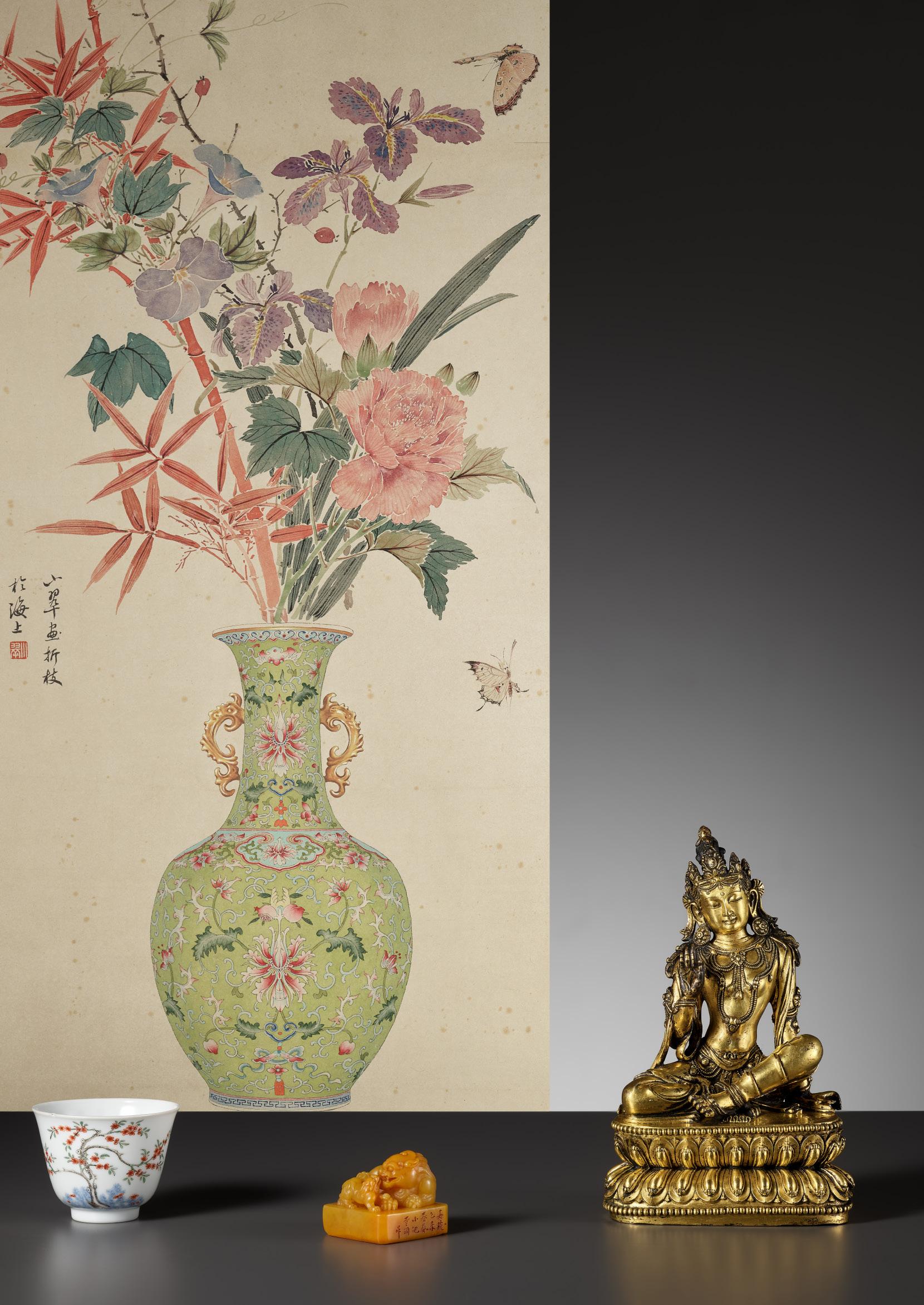
Thursday, 9 March 2023
Lots 1-258
Friday, 10 March 2023
Lots 259-702
ONLINE CATALOG
中文翻譯敘述,請參考 www.zacke.at 中國藝術集珍 Buddhism and Hinduism
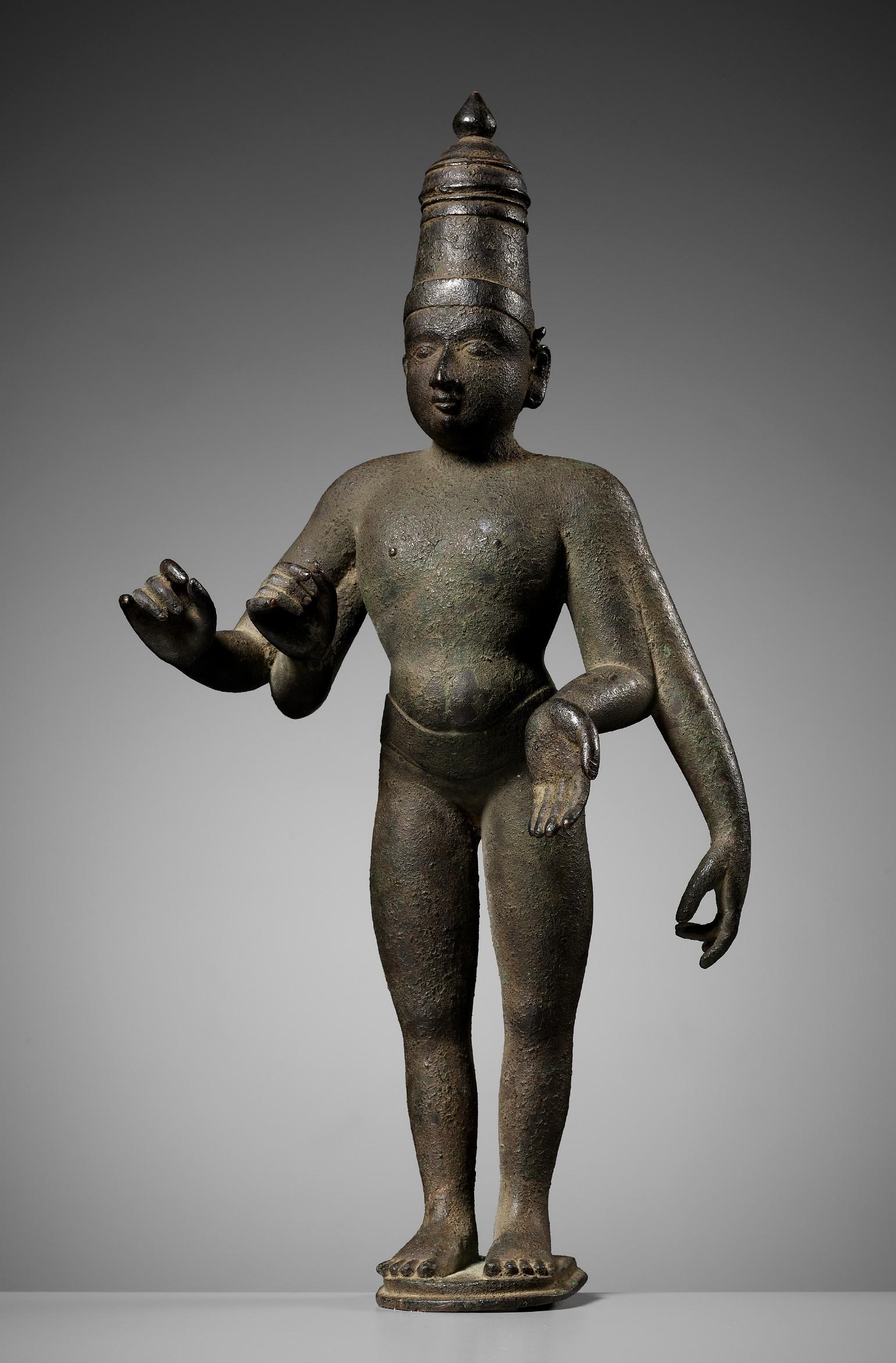
Provenances Museum Deaccessions
The Zelnik Istvan Southeast Asian Gold Museum, Budapest, Hungary
The Wou Lien-Pai Museum, United Kingdom
The Jiyuanshanfang Collection, New York
Museum of Far Eastern Antiquities, Stockholm, Sweden
Asia-Africa Museum, Geneva
Historic Gallery and Dealership Provenances
Hugh M. Moss, Hong Kong
Michael B. Weisbrod, Inc., New York
Leonardo Vigorelli, Italy
Spink & Son Ltd., London
S. Marchant & Son, London
Dr. Robert Bigler, Zurich, Switzerland
Linda Wrigglesworth, London
E & J Frankel Ltd., New York
Frédéric Rond, Indian Heritage, Paris
Art of the Past, New York
Arts et Décors, Zurich
Ancient Art, Stockholm
Robert C. Eldred Co., USA
Joseph Rondina (1927-2022), USA
J.A.N. Fine Art, London
Barry Stern Galleries, Paddington, Sydney
John Williams (d. 2015), Sydney
Galerie Gross, Wiesbaden
Louis-Pierre Denil (1965-2016), Leuven
Oriental Gem Co., London
Steven Finkelman, The Buddha Gallery, California
Chung Kiu Chinese Products Emporium, Hong Kong
Bruno Cooper, Norwich
Georges Anthony d’Offay (b. 1940)
Galerie Carré des Antiquaires, Versailles
Parminder Soin, Munich, Germany
Galerie Claude Jongen, Belgium
Gisal SA, Montreux, Switzerland
Axel Vervoordt Art & Antiques, Antwerp, Belgium
Galleria La Balaustra, Archeologia Classica Orientale e
Precolombiana, Bologna, Italy
Jacques How Asian Art, Brussels
Philip Suval, Inc., New York
Harlan J. Berk Ltd., Chicago, USA
Alistair Sampson Antiques Ltd
Chinese Antiques Co Ltd., Shanghai
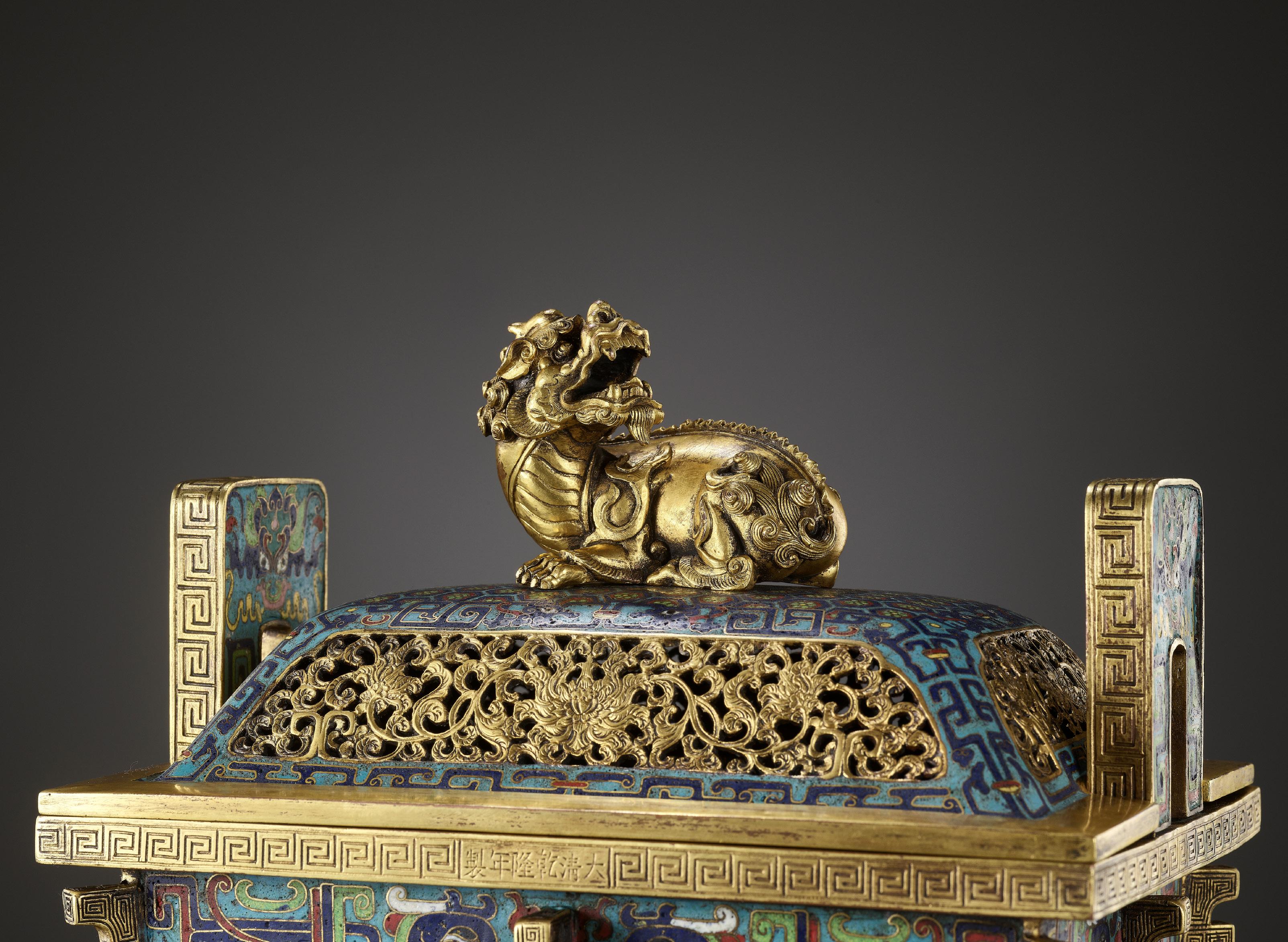
Richwood Fine Art, Wigan, United Kingdom
Maj and Carl-Axel Persson, Malmö, Sweden
Momoyama Gallery, Luxembourg
Cheng’s Gallery, Sampantawong, Bangkok, Thailand
Jeremy Knowles Ltd., London
The Antique Square, Hong Kong
Chamberlain Antiques, Amherst, New Hampshire, USA
Guy Portier (1919-2005)
Private Estates and Collection Provenances
Professor Jan Wirgin (1932-2020), Stockholm, Sweden
Dr. Wou Kiuan (1910-1997), UK
The Holzapfel collection, Geneva, Switzerland
The Jean-Marc Andral Collection, Belgium
Dr. Walter Rieder (1890-1986), Interlaken, Switzerland
Michael Sherrard (1928-2012), UK
René Ronveaux (d. 1991), Belgium
Jean-Pierre Rousset (1936-2021), Paris
Robert Rousset (1901-1982)
Professor David Seares Watson
Paolo Bertuzzi (1943-2022), Bologna
Dr. Friedrich Georg Zeileis (b. 1939)
Pierre Lallier (1946-2021)
Adrianus Cornelis Maria Verhelst (b. 1955), Netherlands
Guwan Cheng, Beijing
Dr. Rudolf Leopold (1925-2010), Vienna
The Harold (1931-2021) and Ruth Newman Collection, Connecticut
Robert Rossi, New York
The J. M. Hu (1911-1995), Zande Lou Collection
Sir Alan Campbell (1919-2007), England
Ivar Björnberg (1934-2021)
Stefanos Lagonico, Alexandria
Richard (1932-2021) and Maxine (1935-2019) Markell
Carl Gustav Kjellin (1910-1990)
The VWS Collection
Provenance list continues on the inside back cover
TWO-DAY AUCTION
Fine Chinese Art, Buddhism and Hinduism
DAY 1 | 1-258
Thursday, 9 March 2023, at 1.00 pm CET
DAY 2 | Lots 259-702 ONLINE CATALOG
Friday, 10 March 2023, at 10.00 am CET
CATALOG CA0323
Preview: 1. 3. - 8. 3. 2023, Monday – Friday 10 am – 6 pm and by appointment

VIEWING www.zacke.at IN OUR GALLERY
GALERIE ZACKE STERNGASSE 13, 1010 VIENNA AUSTRIA Tel +43 1 532 04 52 Fax +20 E-mail office@zacke.at 中文翻譯敘述,請參考 www.zacke.at
PLEASE RAISE MY BID BY ONE BIDDING INCREMENT (ca. 10%) IF NECESSARY
IMPORTANT NOTICE:
Bids do not include buyer’s premium and VAT. Margin taxation applies. Items with added VAT are marked † in the online catalog.
TELEPHONE BIDS:
ABSENTEE BIDDING FORM FOR THE AUCTION Fine Chinese Art, Buddhism and Hinduism CA0323 ON DATE 9 MARCH 2023, AT 1:00 PM CET & 10 MARCH 2023, AT 10:00 AM CET
PLEASE CALL ME WHEN A HIGHER BID THAN MINE HAS BEEN RECEIVED
MY PHONE NUMBER
If you like to bid by telephone, please state ‘TEL’ in the ‘BID IN EURO’ column instead of a Euro amount. Galerie Zacke will call you on the day of the auction, on the telephone number provided, 5 lots before the lot you are bidding on and the bidding will commence at the starting price, as stated in the catalog. If Galerie Zacke cannot reach you during the auction, Galerie Zacke will bid up to the estimate on your behalf.
TERMS OF PAYMENT, SHIPPING AND COLLECTION:
With the signature on this form, the client instructs the auctioneer to bid on his behalf. The Euro amount up to which the auctioneer shall bid on behalf of the client is either stated in this form or will be communicated to the auctioneer via telephone during the auction. All absentee bidding shall be governed by the terms and conditions [AGB] of Galerie Zacke. The client agrees with his signature that he has read, understood and fully accepted the AGB of Galerie Zacke. Galerie Zacke, founded 1968, is a registered brand of SZA Versteigerungen & Vertriebs GmbH, Vienna, Austria.
CREDIT CARD PAYMENT
PLEASE CHECK THE DESIRED CARD
COLLECTION BY CLIENT WITH PAYMENT ON THE PREMISES IN CASH, BY CERTIFIED CHEQUE OR CREDIT CARD
INVOICE PAYMENT
VIA BANK WIRE AFTER RECEIPT OF INVOICE SHIPPING AFTER RECEIPT OF PAYMENT
EXPRESS PARCEL SERVICE REQUIRED (ACCORDING TO TERMS AND CONDITIONS OF GALERIE ZACKE)
SHIPPING INSURANCE REQUIRED (ACCORDING TO TERMS AND CONDITIONS OF GALERIE ZACKE)
GALERIE ZACKE
Sterngasse 13, 1010 Vienna, Austria
Email: office@zacke.at
Tel: +43-1-532 04 52
Fax: +43-1-532 04 52 20
IMPORTANT NOTICE:
Whenever making a bid, whether personally or via an agent, in writing, online, telephone, or in any other way, the bidder fully and unconditionally accepts the Terms of Auction, the ‘Important Information’ section in the auction catalog, the Terms and Conditions (AGB) of Galerie Zacke, §1-50, the Fee Tariff, and the Bidding Increments table, all as published on www.zacke.at on the day of the auction.
NAME ADRESS CITY, COUNTRY POSTCODE PHONE NUMBER EMAIL DATE & SIGNATURE NAME ADDRESS CARD NUMBER EXPIRY DATE
MASTERCARD SECURITY CODE VISA AMEX
NR.
TITLE BID
EURO
LOT
LOT
IN
LOT NR. LOT TITLE BID IN EURO ABSENTEE BIDDING FORM FOR THE AUCTION Fine Chinese Art, Buddhism and Hinduism CA0323 ON DATE 9 MARCH 2023, AT 1:00 PM CET & 10 MARCH 2023, AT 10:00 AM CET Further images of all lots at www.zacke.at
Visit Us in Vienna
Our gallery and auction showroom is located in the heart of Vienna’s First District. We moved to a new location in the spring of 2022. The design honors our Austrian heritage and passion for Asian cultures, bringing together European, Chinese and Japanese architectural elements throughout the space.
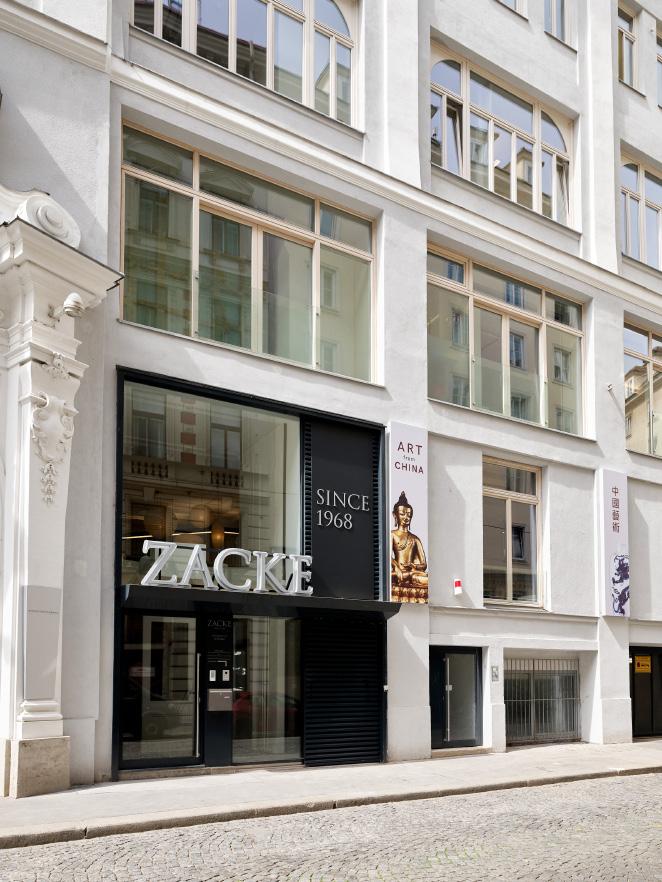
VIEW OUR AUCTION EXHIBITION
You can visit our gallery and view the fine objects in our auction on the following dates
1-8 March Monday – Friday 10 am – 6 pm and by appointment
We invite you to take part in the auction in our showroom on 9 March 2023 at 1 pm and 10 March at 10 am.
HOW TO FIND OUR OFFICE
Our address is Sterngasse 13, 1010 Vienna. We’re located in the heart of Vienna’s iconic first district, only a seven-minute walk away from the Stephansdom.
Our gallery is easily reachable by public transport or car.
Public Transport:
The Schwedenplatz station (U1/U4) is a six-minute walk away.
The Stephansplatz station (U1/U3) is a seven-minute walk away.
Several tram and bus lines are within walking distance, including 1, 57A, 59A, 5B and 69A.
You can also find detailed images of each lot and bid live on www.zacke.at GALERIE
Schulerstr.
1010 VIENNA AUSTRIA U1 U4 U1 U3
Graben Rotenturmstr. HoherMarkt Wipplingerstr.Sterngasse Salzgries ObereDonaustr.
SalztorgasseSalztorbrücke
platz
ZACKE Sterngasse 13
Schwedenplatz
Bäckerstr. Wollzeile
Marc-Aurel-Str. Stephans-
中文翻譯敘述,請參考 www.zacke.at
AUCTION DAY TWO




Friday, 10 March 2023 at 10.00 AM CET
LOTS
259-702 ONLINE CATALOG www.zacke.at
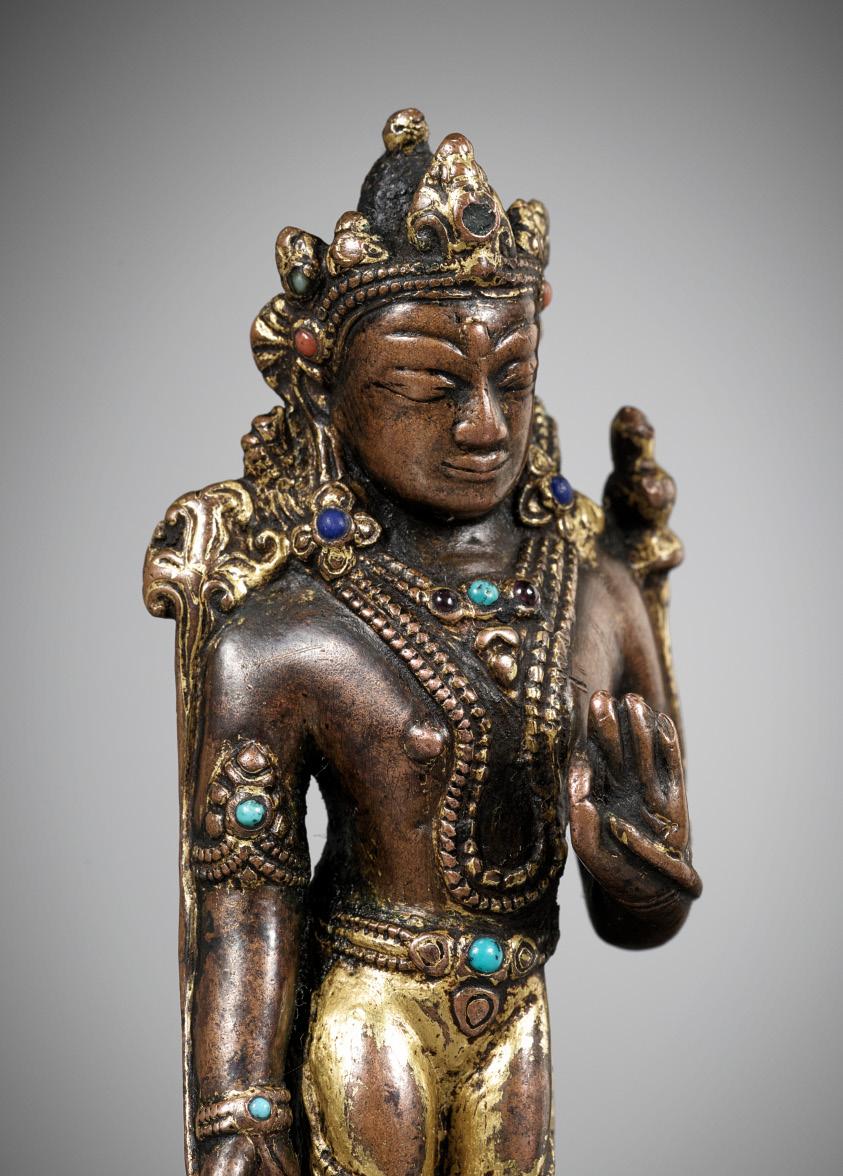
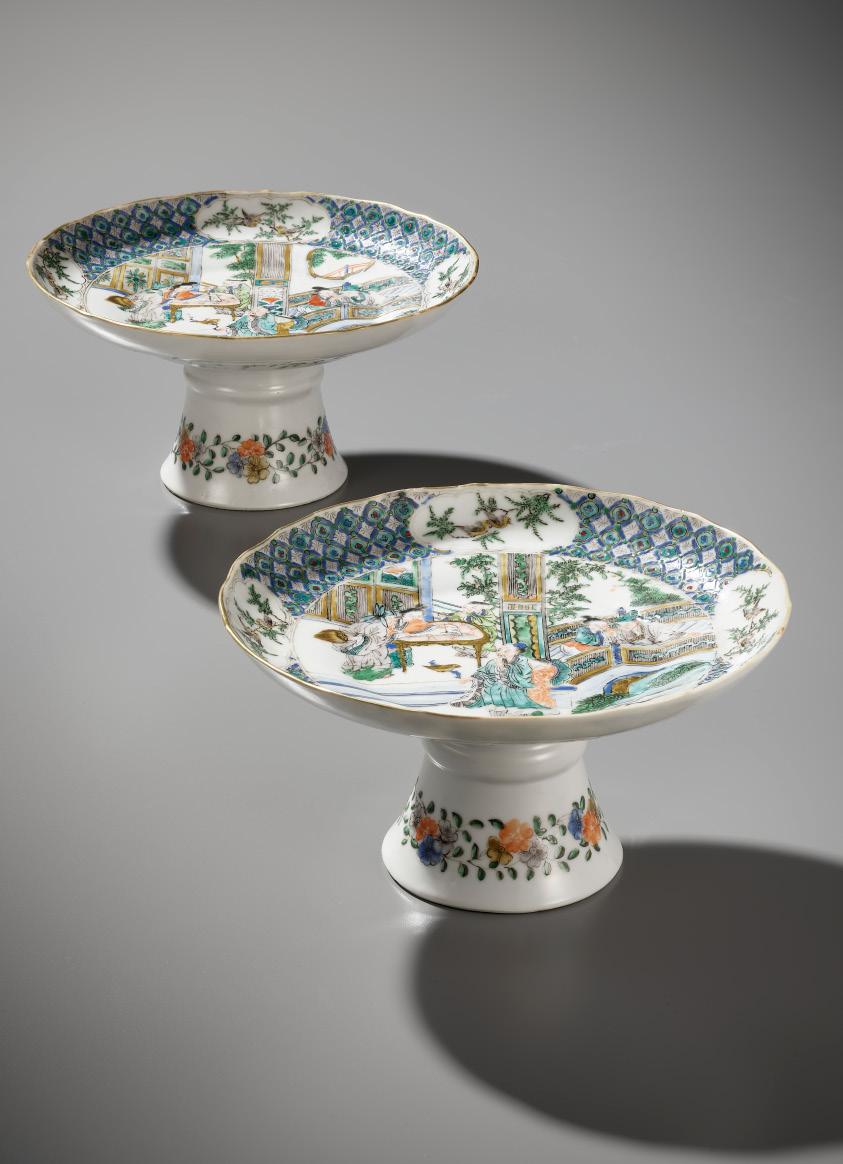


中文翻譯敘述,請參考 www.zacke.at
A SMALL LAC BURGAUTÉ MALLET VASE, KANGXI PERIOD, JIANG QIANLI MARK
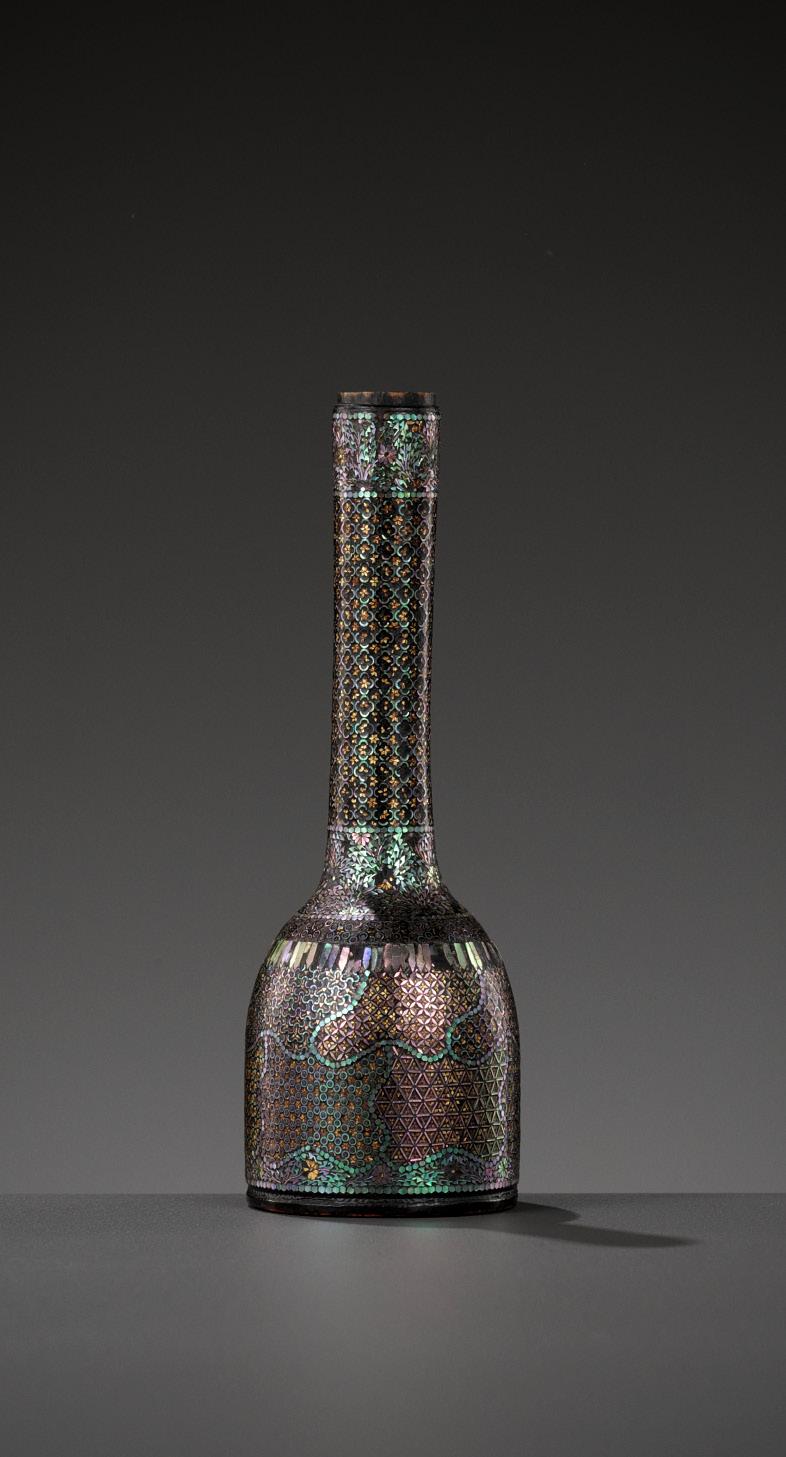
China, 1662-1722. The cylindrical body with the rounded shoulder surmounted by a tall slender neck, the lacquer intricately decorated with minuscule inlays of mother-of-pearl and gold depicting foliate panels enclosing floral and geometric diapered designs, between a lappet band at the shoulder and a floral band above the foot. The neck with floral diaper between dense foliate bands interspersed with flowerheads at the shoulder and below the mouth, the recessed base with a similar design enclosed by a geometric border and centered by the gold-foil-inlaid two-character seal mark ‘Qianli’ within a mother-ofpearl-inlaid roundel.
Provenance: From a Hungarian private collection.
Condition: Good condition with minor old wear, small losses, few minuscule nicks and age cracks.
Weight: 33.9 g
Dimensions: Height 10 cm
With a velvet-padded silk storage box. (2)
Jiang Qianli, alias Jiang Qiushui, was a master craftsman from Yangzhou in Jiangsu province. For early studies of Jiang’s work see Li Zhongqing ‘A Mother-of-Pearl Lacquer Tray by Jiang Qianli’, Wenwu, 1959, no. 11, pp. 59-61, and Paul Moss, Emperor, Scholar, Artisan, Monk - The Creative Personality in Chinese Works of Art, London, 1984, page 258. Jiang’s name is also mentioned in a number of historical records, including the 1810 edition of the Jiaqing Yangzhou fu zhi (Chronicles of Yangzhou Prefecture in the Jiaqing period) in which Zhang Shiyuan and Yao Youtian record: During the early years of the Kangxi reign there was Jiang Qiushui, whose skill produced mother-of-pearl inlaid lacquerware that was noted for its exquisiteness. These wares were widely sought after for use at banquets. A couplet says, ‘Where there are drinking cups and serving trays, there one finds Jiang Qiushui’. Jiang Qianli is traditionally thought to have lived in the late Ming or Kangxi periods, and his mark subsequently appeared on numerous inlaid lacquer pieces. The style of his true work is very intricate, with simple shapes embellished with perfect control and attention to detail, down to the tone and placement of each piece of inlay. The present lot appears to be of a quality associated with the master himself
AUCTION RESULT COMPARISON
Type: Related
Auction: Bonhams London, 6 November 2014, lot 432
Price: GBP 13,750 or approx. EUR 17,000 converted and adjusted for inflation at the time of writing
Description: A small ‘lac burgauté’ baluster vase, Kangxi, Qianli two-character mark
Expert remark: Compare the closely related decoration with similar floral diaper inlaid with gold foil and mother-of-pearl, as well as the two-character Qianli mark. Note the baluster form and smaller size (6.6 cm).
AUCTION RESULT COMPARISON
Type: Related

Auction: Christie’s Hong Kong, 29 November 2022, lot 3025
Estimate: HKD 700,000 or approx. EUR 84,500 converted at the time of writing
Description: A small mother-of-pearl inlaid blacklacquered vase, Qianlong two-character seal mark



Expert remark: Compare the closely related decoration with floral diaper inlaid with gold foil and mother-of-pearl. Note the inlaid Qianlong seal mark, which may be a later addition, and the size (10.7 cm).
Estimate EUR 4,000
Starting price EUR 2,000
8 1
A MAGNIFICENT AND EXTREMELY RARE MOTHER-OF-PEARL INLAID BLACK-LACQUER AND
SILVER POURING VESSEL, YI
China, 17th – 18th century. The black dry lacquer ground is intricately inlaid with several thousand microscopic pieces of gold foil and mother-of-pearl, to the interior with a central double vajra with ruyi heads issuing a scrolling border enclosing the design, encircled by bands of floral diaper and key fret, the interior sides with further diapered floral patterns and cloud designs below key-fret bands and at the rim continuing to the spout, the exterior similarly decorated with bands of ruyi heads, key fret, rounded lappets, and floral diaper.


Provenance: From a Hungarian private collection.
Condition: The rim, spout, and inlays with losses. The lacquer with minute age cracks, further with minuscule nicks and minor chips, some old wear, the silver base with a dark patina in some areas. Overall displaying remarkably well and in good condition commensurate with age and the fragile nature of this lot.
Weight: 75.8 g
Dimensions: Length 9.2 cm
The deep rounded sides supported on an oval foot with a recessed and rounded base and rising to a straight rim, one side set with slightly tapered spout of square U-shaped section, the foot and base made of solid silver. With a padded silk storage box. (2)
AUCTION RESULT COMPARISON
Type: Related
Auction: Christie’s Hong Kong, 27 November 2013, lot 3561
Price: HKD 1,000,000 or approx. EUR 154,000 converted and adjusted for inflation at the time of writing
Description: A very rare mother-of-pearl inlaid blacklacquered double gourd, Qing dynasty, 18th century Expert remark: Compare the intricate gold foil and mother-of-pearl inlays with similar ruyi designs and floral diaper. Note that this vessel has a Qianli mark to base. Also note that arguably the inlay work is not as fine as on the present lot, and that despite this vessel being 31 cm large, the total number of microscopic inlay pieces used for this example is probably smaller than on the present lot.
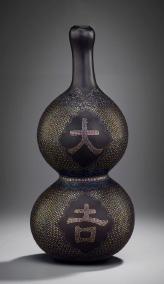
Estimate EUR 8,000
Starting price EUR 4,000
9 2
A PAIR OF ZITAN WEIQI COUNTER CONTAINERS, WEIQIZIHE, 17TH-18TH CENTURY
China. Each of melon form, with well-rounded double lobes divided by ridges, the high curving shoulder rising from the tapered base, the similarly carved elegantly domed cover with a central dimple. The zitan wood of an attractive grain and color with characteristic ‘crab’s claw’ marks. (2)
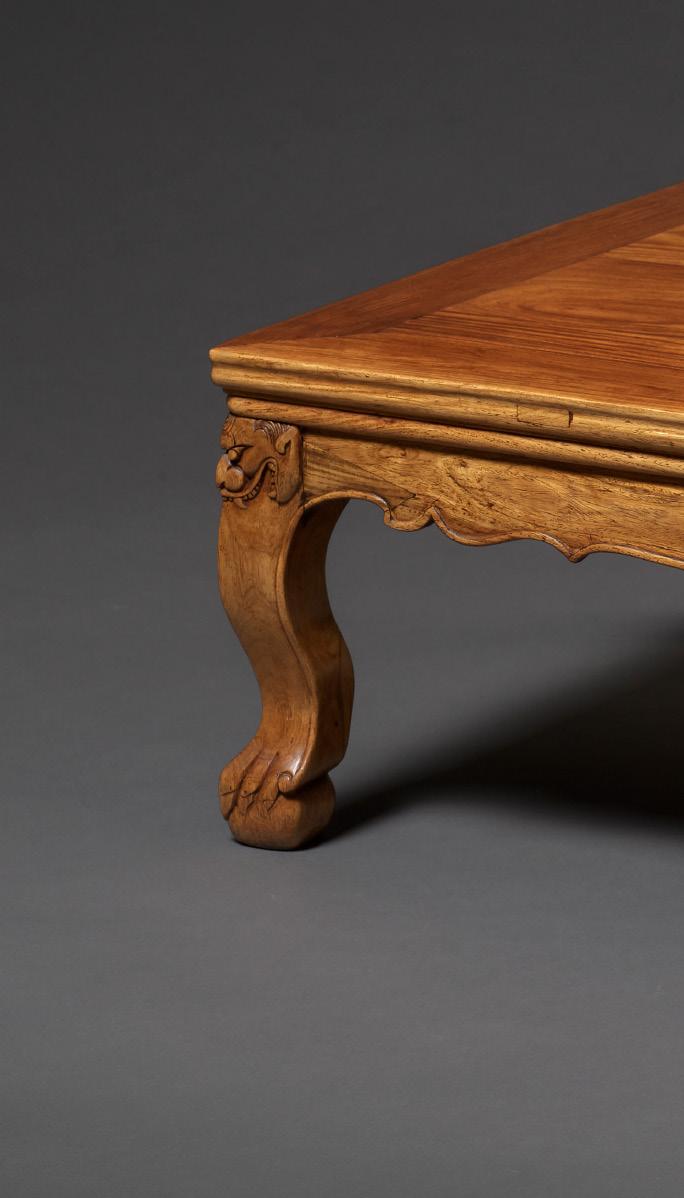
Provenance: Swedish trade.
Condition: Very good condition with minor wear, expected minor age cracks, few small chips and minuscule nicks, occasional light scratches, one box with a minor old repair.
Weight: 555 g and 536.7 g
Dimensions: Diameter 13 cm (each, at the widest points)
Weiqi (more commonly known in the West under its Japanese name, go) originated in ancient China and was one of the four accomplishments that a Chinese scholar had to practice. There is a tangle of conflicting popular and scholarly anecdotes attributing its invention to the two earliest emperors in China, Yao and Shun, an Imperial vassal, Wucao, or a court astrologer in the Western Zhou Dynasty. It is generally agreed that weiqi is more than 2,500 years old, which makes it the world’s oldest strategic board game continuously played to the present day.
AUCTION RESULT COMPARISON
Type: Closely related
Auction: Christie’s New York, 16 September 2016, lot 1213
Price: USD 68,750 or approx. EUR 77,500 converted and adjusted for inflation at the time of writing
Description: A pair of zitan weiqi counter containers, weiqizihe, 17th18th century
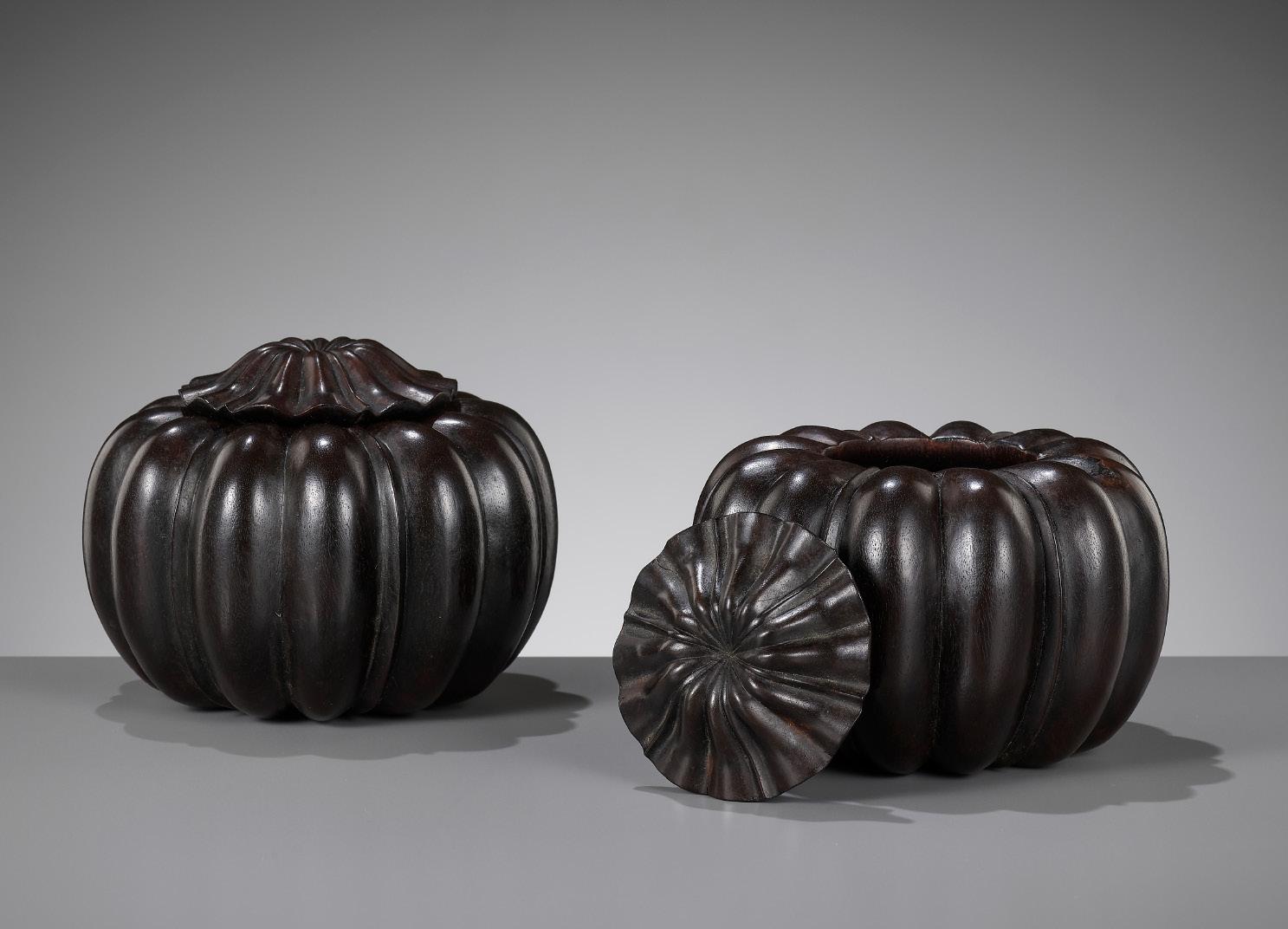
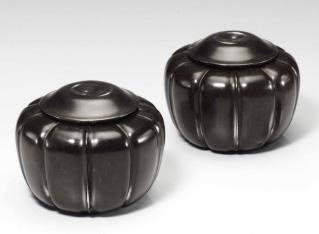
Expert remark: Note the similar size (11.7 cm)
Estimate EUR 4,000
Starting price EUR 2,000
10 3
A HUANGHUALI LOW TABLE, KANGZHUO, 17TH-18TH CENTURY
China. Superbly carved with the top panel set within a rectangular frame with a beaded ‘ice-plate’ (bingpanyan) edge above a shaped, beaded, and cusped apron, all raised on elegant cabriole legs carved with lion masks at the corners and terminating in claw feet, the wood of an attractive grain and color.
Provenance: From the private collection of Jean-Pierre Rousset, acquired in the 1980s, and housed in his famous Parisian home ever since (see in-situ photograph). Jean-Pierre Rousset (1936-2021) was a French art dealer and the nephew of Robert Rousset (1901-1982), one of the most prominent pioneers of the Chinese art market in Paris. With no children of his own, Robert took his nephew Jean-Pierre under his wing and began grooming him to eventually take over the gallery. He loved to wander with Jean-Pierre through the gallery’s exhibitions and storerooms, telling stories about each piece while cultivating his protégé’s eye. Jean-Pierre was also sent by his uncle to train with the great expert in Asian art and Robert’s close friend, Michel Beurdeley, whose numerous publications are still commonly referenced today. When Robert passed away, his private collection was divided between Jean-Pierre and his sister, Anne-Marie, whose part was sold with great success after her death in 2019.
Condition: Good condition with some wear and traces of use, expected minor age cracks, some with associated old fills, small chips, light scratches, the joints possibly reinforced.
Dimensions: Size 96.5 x 59 x 29.5 cm
Expert’s note: Kang tables were typically used on top of a platform, kang, or a couch-bed or daybed. For a discussion on kang tables, see S. Handler, Austere Luminosity of Chinese Classical Furniture, Berkeley, 2001, pp. 169171. See Wang Shixiang, Connoisseurship of Chinese Furniture: Ming and Early Qing Dynasties, vol. I, Hong Kong, 1990, pp. 48-52, for a discussion of different forms of kang tables.

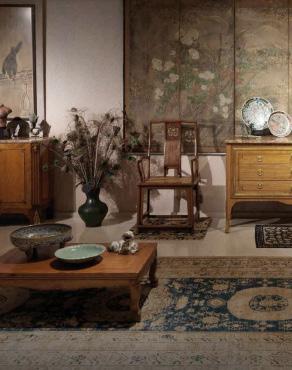

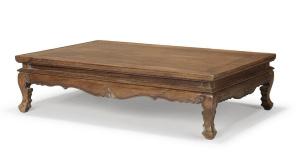
AUCTION RESULT COMPARISON
Type: Related
Auction: Christie’s Hong Kong, 31 May 2017, lot 3239
Price: USD 875,000 or approx. EUR 123,500 converted and adjusted for inflation at the time of writing
Description: A Large Huanghuali Kang Table, Qing Dynasty, 18th Century
Expert remark: Compare the closely related form, material, and size (94.3 x 63.5 x 25 cm)
AUCTION RESULT COMPARISON
Type: Related
Auction: Christie’s New York, 19 March 2021, lot 742
Price: USD 37,500 or approx. EUR 37,500 converted and adjusted for inflation at the time of writing
Description: A Huanghuali Kang Table, 17th Century Expert remark: Compare the related form, material, and size (104.7 x 67.6 x 32 cm). Note the related animal masks at the four corners.
Estimate EUR 12,000
Starting price EUR 6,000
4
The present lot inside Jean-Pierre Rousset’s private home
A CINNABAR LACQUER THREE-TIERED BOX AND COVER, LATE YUAN TO MID-MING DYNASTY

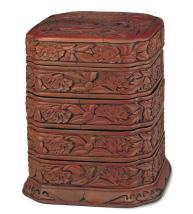
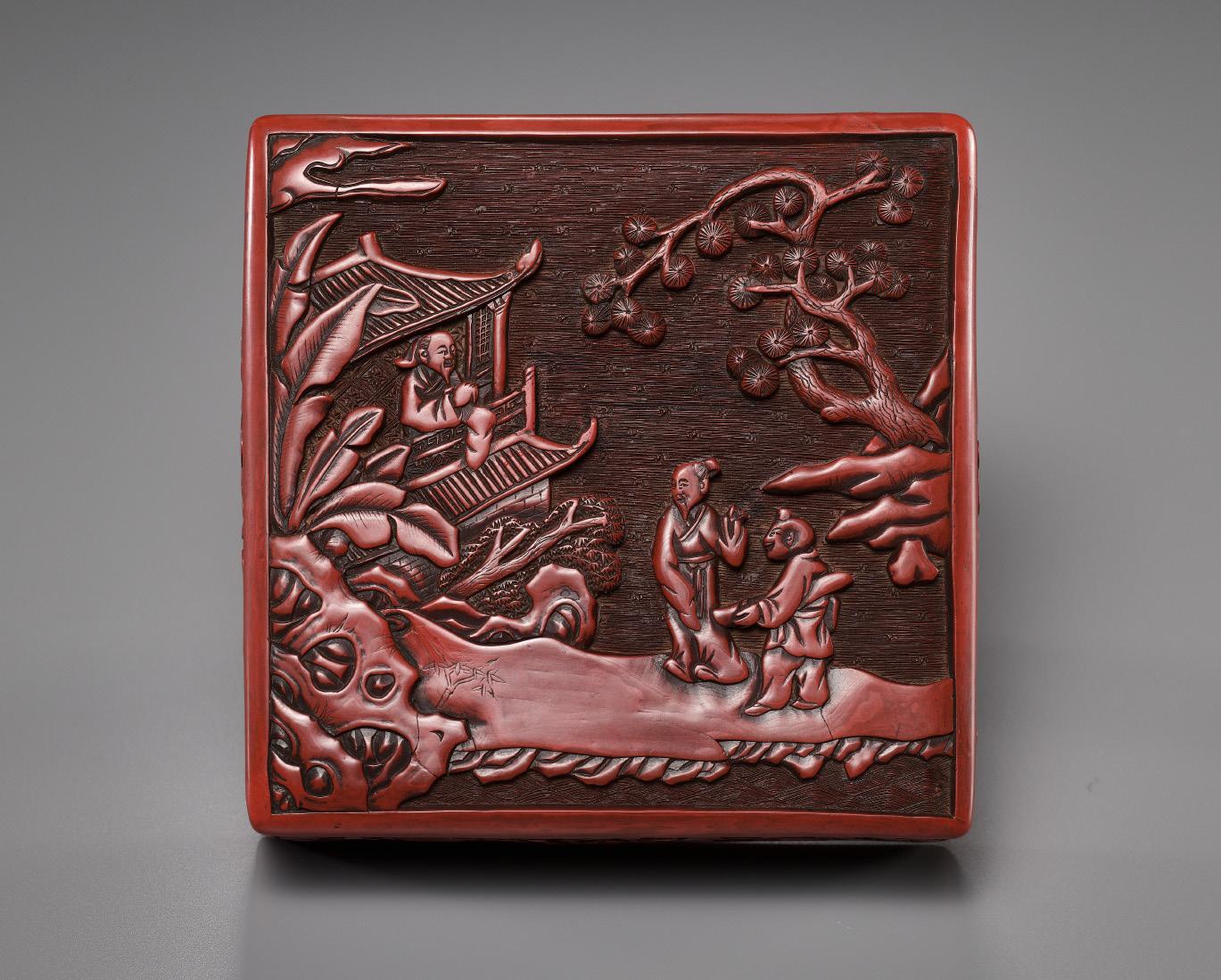
China, 14th-16th century. Of rounded square form, supported on a spreading foot with a shaped apron. The cover superbly carved with a scene of a scholar and his attendant standing on a path and looking toward another scholar in a pavilion, partly obscured by plantain leaves. A tree and craggy rockwork issuing neatly incised bamboo, below a wispy cloud and beside a gnarled tree, all against three notably different types of finely diapered grounds, a hallmark of excellence found only on the very best of Chinese lacquer wares. The sides carved with dense leafy sprays of peony and chrysanthemum. The interior and base lacquered black.
Provenance: English trade, by repute previously in an ancient Japanese private collection.
Condition: Very good condition with expected wear and small age cracks, few tiny nicks, occasional light scratches. By repute, the box was re-polished by a Japanese lacquer master in the mid-20th century.
Weight: 682 g
Dimensions: Height 16.2 cm, Length 12 cm
LITERATURE COMPARISON
Compare a closely related cinnabar lacquer three-tiered box and cover, 13.6 cm high, 12 cm long, dated to the late Yuan to early Ming dynasty, 14th century, exhibited in the Shanghai Museum, In A Myriad of Forms: The Ancient Chinese Lacquers, 16 November 2018 to 24 February 2019, p. 110-111, cat. no. 66. Compare a related cinnabar lacquer fourtiered box and cover, 14.3 cm high, dated to the mid-Ming dynasty, from the Qing Court Collection, illustrated in Lacquer Wares of the Yuan and Ming Dynasties. The Complete Collection of the Treasures of the Palace Museum (Yuan Ming Qiqi. Gugong Bowuyuan Cang Wenwu Zhenpin Quanji), vol. 45, Hong Kong, 2006, p. 112-113, no. 82. Compare a closely related cinnabar lacquer three-tiered box and cover, dated to 1451-1500, in the British Museum, registration number 1974,0226.21, illustrated by Garner, Chinese Lacquer, London, 1979, p. 99, no. 41.
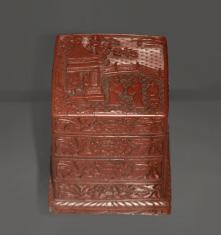
AUCTION RESULT COMPARISON
Type: Related
Auction: Christie’s New York, 19 March 2008, lot 346
Price: USD 55,000 or approx. EUR 71,000 converted and adjusted for inflation at the time of writing
Description: A rare four-tiered square lacquer box and cover, Ming dynasty, 16th century Expert remark: Compare the closely related manner of carving with a similar scholarly scene to the cover and blossoming flowers to the sides. Note the similar size (17.8 cm) and that the box is four-tiered.

Estimate EUR 12,000
Starting price EUR 6,000
12 5

A SMALL CINNABAR LACQUER BOX AND COVER, YUAN TO EARLY MING DYNASTY

Opinion: Recent research into the dating of carved lacquer has put forward the suggestion that boxes of this type with double key-fret decoration on the rim and relatively large figures or landscape scenes with rock formations on the cover can be dated as early as the Yuan dynasty (1279-1368). The strongest argument in favor of this early dating is the relatively recent discovery of a similar, somewhat larger box in a group of tombs near Shanghai that belonged to the Ren family, of which the latest was datable to 1351 and the earliest to 1338.
China, mid-14th to 15th century. Of lobed square form, the cover finely carved in relief with a potted bamboo on a scholar’s table, a plantain growing from rockwork behind a fence, and a two layered diaper ground, the upper layer with hexagons enclosing flowerheads, the lower layer of lozenge form. The sides of the cover and box with S-shaped key frets. The interior and base lacquered in black.
Provenance: From an English private collection.
Condition: Overall excellent condition, commensurate with age, and as expected for a cinnabar lacquer box of such high age. Old wear with an unctuous feel from centuries of handling, small age cracks, minute nicks and losses, shallow surface scratches. Beautiful, naturally grown patina.
Weight: 35.9 g
Dimensions: Size 5.5 x 5.5 cm
AUCTION RESULT COMPARISON
Type: Related
Auction: Christie’s Hong Kong, 2 October 2017, lot 215
Price: HKD 125,000 or approx. EUR 17,000 converted and adjusted for inflation at the time of writing
Description: A cinnabar lacquer ‘scholar on horseback’ circular box and cover, Ming dynasty, 16th century Expert remark: Compare the closely related S-shaped key-fret borders, two-tiered diapered ground, and manner of carving. Note the size (7.6 cm).


AUCTION RESULT COMPARISON
Type: Related
Auction: Christie’s Hong Kong, 29 May 2007, lot 1559
Price: HKD 96,000 or approx. EUR 18,000 converted and adjusted for inflation at the time of writing
Description: A rare finely carved cinnabar lacquer square incense box and cover, Ming Dynasty, 16th century

Expert remark: Compare the related key-fret borders, two-tiered diapered ground, and manner of carving. Note the size (6.6 cm).
Estimate EUR 4,000
Starting price EUR 2,000
14 6
AN IMPERIAL JADE-INLAID CINNABAR LACQUER WALL VASE INSCRIBED WITH A POEM BY HONGLI (1711-1799), QIANLONG PERIOD

The poem inscribed on the jade plaque was composed by Hongli (1711-1799), better known as the Qianlong Emperor (reigned from 1736-1795). It is recorded in Qing Gaozong yuzhi shiwen quanji (Anthology of Imperial Qianlong Poems and Texts), volume 3, juan 58, page 19, figure 1, and can be translated as follows:
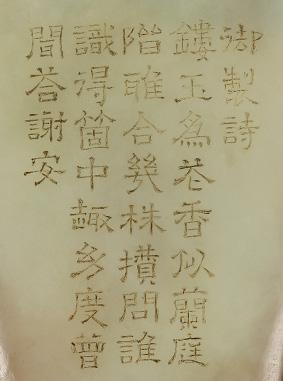
Jade carved into flowers are fragrant like orchids, Between the garden steps, a few are elegantly planted. Who knows their essential beauty? Youdu, once asked this, answered with “Xie An”.

15 7
The poem inscribed on the jade plaque inlaid to this wall vase was composed by Hongli (1711-1799), better known as the Qianlong Emperor (reigned from 1736-1795)
China, 1736-1795. Finely cast from gilt-bronze into baluster form flattened on one plane, mounted on the body with a shaped yellowishceladon jade plaque inscribed in clerical script with a thirty-onecharacter Imperial poem, all surrounded by superbly carved blossoms of peony, chrysanthemum, and prunus borne on leafy branches against a diaper ground, framed by bands of prunus blossoms below the neck and above the foot, the neck flanked by two short tubular handles incised with scroll.
Provenance: From the collection of Dr. Wou Kiuan. Wou Lien-Pai Museum, coll. no. Q.J.111.
Dr. Wou Kiuan (1910-1997) was a Chinese diplomat and noted scholar of Chinese art. His father, Wou Lien-Pai (1873-1944), was one the leading political figures of early 20th century China, remembered for his role as speaker and leader of parliament during the turbulent years of the Republican era.

Dr. Wou himself embarked on an illustrious career in diplomacy until his retirement in 1952, when he settled in London and devoted the rest of his life to the study of Chinese art. It was no doubt fortuitous that Dr. Wou’s years of collecting coincided with an abundant availability of exceptional Chinese art on the London market. From the mid-1950s to the late 1960s he was able to form a collection of well over 1,000 works that together represented virtually every category of Chinese art. At the heart of Dr. Wou’s drive to collect was a burning desire to preserve the relics of China’s rich historical past scattered across Europe, and to promote Chinese art and culture. It is unclear when Dr. Wou conceived of the idea to create a place to house his collection, but in 1968 he opened the doors to the Wou Lien-Pai Museum, named in honor of his father. Over the years the Museum became a ‘must see’ destination for collectors, academics, and visiting dignitaries, and Dr. Wou would delight in leading his visitors through the galleries, recounting stories of China’s glorious history.
Condition: Superb condition with expected minor wear, few minuscule nicks, the back with light surface scratches, the wood base with a small chip. Fine, naturally grown patina overall.
Weight: 512.2 g
Dimensions: Height 18.6 cm
Mounted on a short wood base, probably zitan and dating from the same period. (2)
Hongli was the fourth son of Yongzheng and born to Noble Consort Xi. He was adored by his grandfather, the Kangxi Emperor, and some historians argue to this day that Kangxi appointed Yongzheng as his successor only because Hongli was his favorite grandson. One of China’s eternal visionaries, Kangxi is said to have spotted the singular leadership talent of the later Emperor Qianlong in Hongli when he was still a child. In 1796, the Qianlong Emperor abdicated in favor of his son, the Jiaqing Emperor, in a filial act so as not to reign longer than his grandfather, the Kangxi Emperor, who ruled for 61 years. Despite his retirement, he retained ultimate power as the Emperor Emeritus until his death in 1799, making him one of the longest-reigning monarchs in history, and, dying at the age of 87, one of the longestlived. As a capable and cultured ruler inheriting a thriving empire, during his long reign, the Qing Empire reached its most splendid and prosperous era, boasting a large population and economy.

Wall vases were particularly popular during the reign of Qianlong and are known to have adorned the walls of the Sanxitang (The Hall of Three Rarities), a tiny studio next to the Imperial bedchamber in the Yangxindian. They were produced in a variety of materials, including porcelain, cloisonne enamel and lacquer, and occasionally inscribed with poems by the Emperor himself, such as the present lot. Compare several porcelain wall vases in the collection of the Palace Museum Beijing, illustrated in The Life of Emperor Qianlong, The Macau Museum of Art, Macau, 2002, cat. nos. 63-2 to 63-9. The present wall vase ranks among the most unusual and rarest examples produced during the Qianlong reign, as it combines gilt-bronze, cinnabar lacquer and carved jade.

Expert’s note: Carved cinnabar lacquer and gilt-bronze wall vases combined with jade inlays are very rare. The examples that come up for auction now and then almost invariably have condition issues such as strong wear to the gilding, losses and cracks to the lacquer, cracks or - worse - replacements to the jade inlays, and others. The pristine condition of the present wall vase makes it not just exceptionally rare, but literally unique
LITERATURE COMPARISON
Compare a pair of wall vases in the National Palace Museum, Taipei, included in the museum’s exhibition The Enchanting Splendor of Vases and Planters: A Special Exhibition of Flower Vessels from the Ming and Qing Dynasties, 2014, pl. II-48 (fig. 1), where the author notes that ‘Lacquerware with jade inlay on a copper body is very rarely seen’. Also compare two boxes, one rectangular, the other chime-shaped, both inset with jade plaques, in the Palace Museum Beijing, illustrated in Carved Lacquer in the Collection of the Palace Museum, Beijing, 1964, cat. nos. 313 and 315. Compare a jade plaque inset in a cinnabar lacquer moon flask, similarly incised with a Qianlong seal mark and of the period, at Christie’s Hong Kong, 27 April 1997, lot 21.
AUCTION RESULT COMPARISON
Type: Closely related
Auction: Sotheby’s Hong Kong, 25 April 2004, lot 19
Price: HKD 744,000 or approx. EUR 139,000 converted and adjusted for inflation at the time of writing

Description: A very rare jade inlaid cinnabar lacquer wall vase, Qing dynasty, Qianlong period Expert remark: Compare the closely related (and extremely rare) combination of carved lacquer and jade with an Imperial poem. Note the similar size (18 cm). Also note that the jade plaque on this example has several cracks, whereas on the present example it is in perfect condition.

Estimate EUR 40,000
Starting price EUR 20,000
16
fig. 1
The personal study of Emperor Qianlong at the Forbidden City, Sanxitang, with numerous wall vases seen on the left
Hongli (17111799), the Qianlong Emperor (reigned from 1736-1795)
Dr. Wou Kiuan, Paris, November 1939

8
A THREE-COLOR LACQUER ‘CHUN’ SPRING BOX AND COVER, QIANLONG PERIOD
China, 1736-1795. The top of the cover with a circular panel that is deeply carved through several layers of cinnabar, orange and black lacquer on the diapered ground with a bowl of precious objects radiating rays illuminating the large character Chun (Spring) centered with a roundel enclosing Shoulao flanked by two boy attendants, all enclosed by a key-fret border. The rounded sides of the box and cover are carved with further key-fret designs as well as large floral blossoms alternating with shaped panels enclosing flowers and rockwork, the foot with a key-fret band. The interior and base are lacquered black.
Provenance: From the collection of a gentleman in London, United Kingdom, who has been collecting Asian works of art for the last 50 years. The base with an old Christie’s label, ‘2554’, a lacquered inventory number ‘214.14.QT’, and an old label, ‘Antique cinnabar cared [sic] lacquer treasure box. 18th century. Qing dynasty’.
Condition: Good condition with expected old wear from centuries of handling, natural age cracks, small nicks and light scratches, few losses, minor soiling.
Weight: 1,372 g
Dimensions: Diameter 25.5 cm
The form and design of the chun-character lacquer boxes follows a Jiajing period prototype. Boxes from this group were so admired by the Qianlong Emperor that he ordered a number of copies during his reign, and they were frequently used to hold food presented as a ceremonial gift at the lunar new year or for birthdays.
The motifs decorating this box and others like it are all very auspicious. The character Chun (Spring) on the cover is also a metaphor for youth. Combined with the overlaying roundel of Shoulao, the God of Longevity, the box would have represented wishes for eternal youth.
LITERATURE COMPARISON
Qianlong period examples, such as the present lot, are extant in the Imperial collections in Beijing and Taipei: see the example now in the National Palace Museum, Taipei, image number K1H000047N000000000PAF (fig. 1), illustrated in Special Exhibition of Palace Lacquer Objects, Taipei, 1981, catalogue no. 67, and in the Palace Museum, Beijing, illustrated in Lacquer, The Complete Collection of the Treasures of the Palace Museum, vol. 8, 1999, pl. 172. Compare another Qianlong period example, 52.7 cm diameter, from the Avery Brundage Collection, in the Asian Art Museum of San Francisco, object number B60M317.a-.b, illustrated by Sir Harry Garner in Chinese Lacquer, London, 1979, pl. 90.
fig. 1
AUCTION RESULT COMPARISON
Type: Closely related
Auction: Christie’s London, 10 November 2015, lot 175
Price: GBP 68,500 or approx. EUR 99,500 converted and adjusted for inflation at the time of writing
Description: A carved polychrome lacquer ‘spring’ circular box and cover, Qianlong period
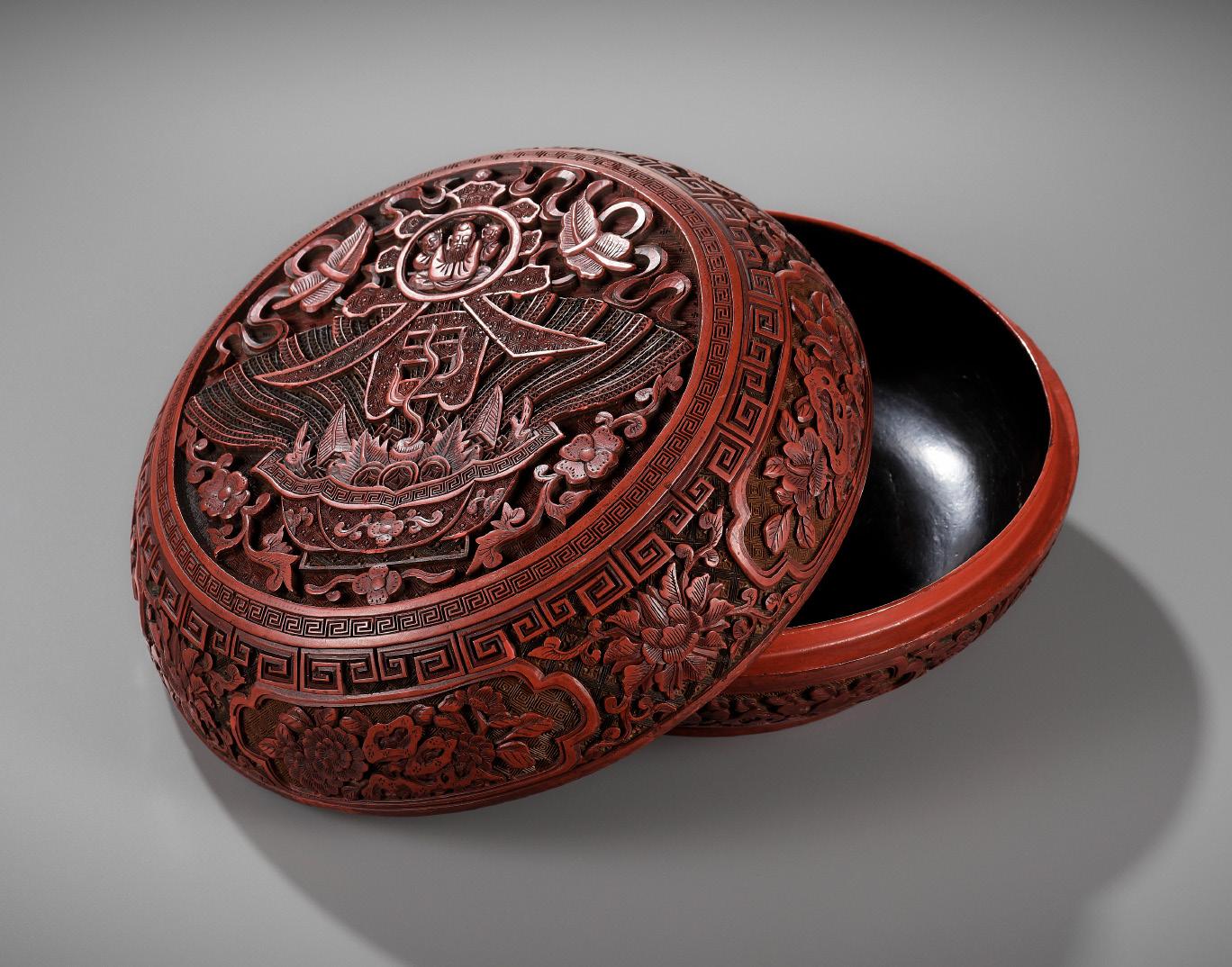
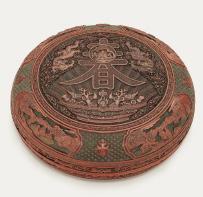

Expert remark: Compare the closely related form, motif, and threecolor lacquer decoration. Note the slightly larger size (30.8 cm).
AUCTION RESULT COMPARISON
Type: Closely related
Auction: Bonhams London, 8 November 2012, lot 27
Price: GBP 97,250 or approx. EUR 148,000 converted and adjusted for inflation at the time of writing
Description: An imperial carved three-color lacquer ‘chun’ box and cover, Qianlong
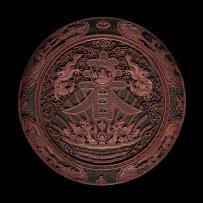
Expert remark: Compare the closely related form, motif, and threecolor lacquer decoration. Note the slightly larger size (31.1 cm).
Estimate EUR 12,000
Starting price EUR 6,000
18
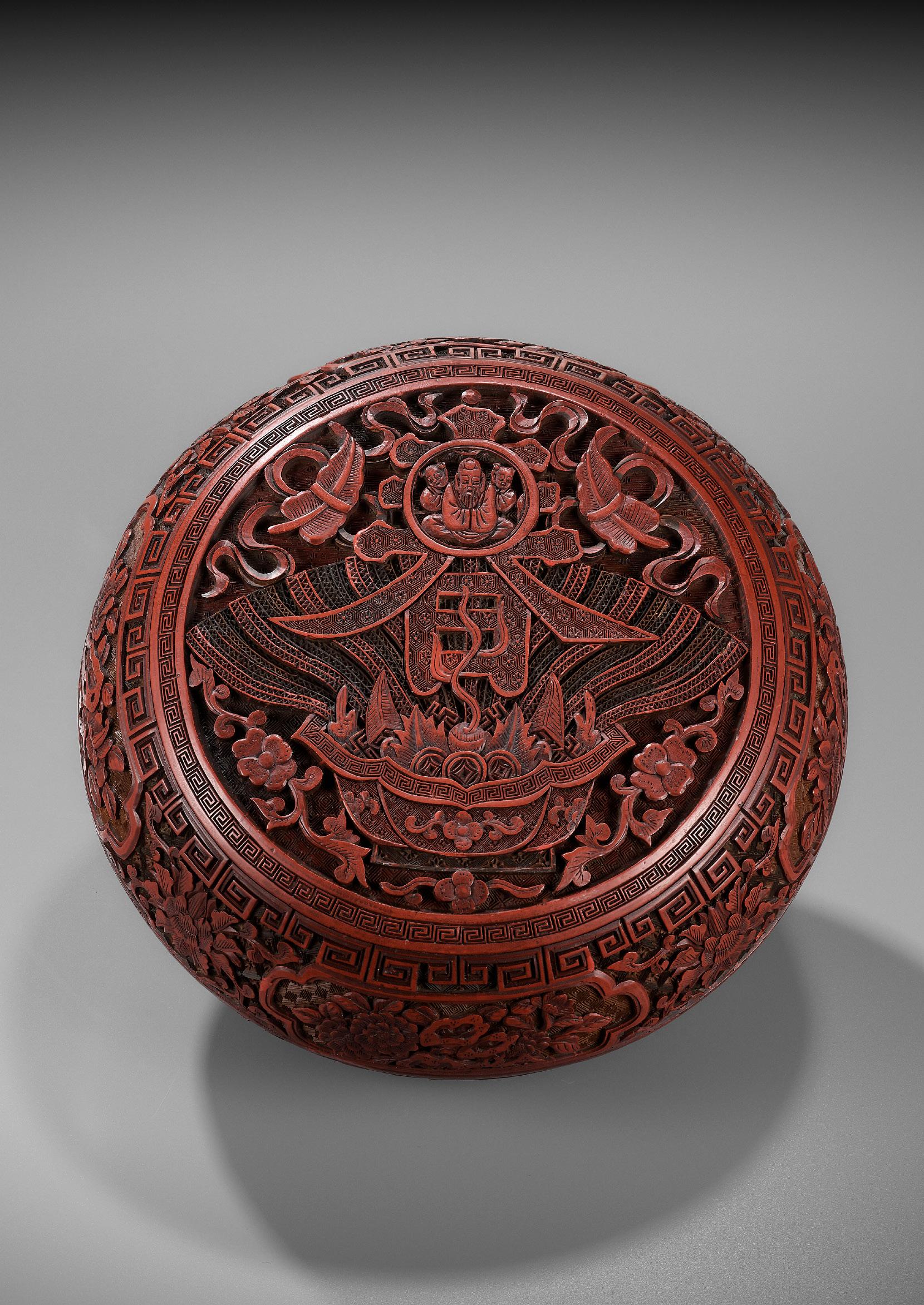
A MOTHER-OF-PEARL-INLAID ROSEWOOD APOSTLE CROSS, 17TH-18TH CENTURY
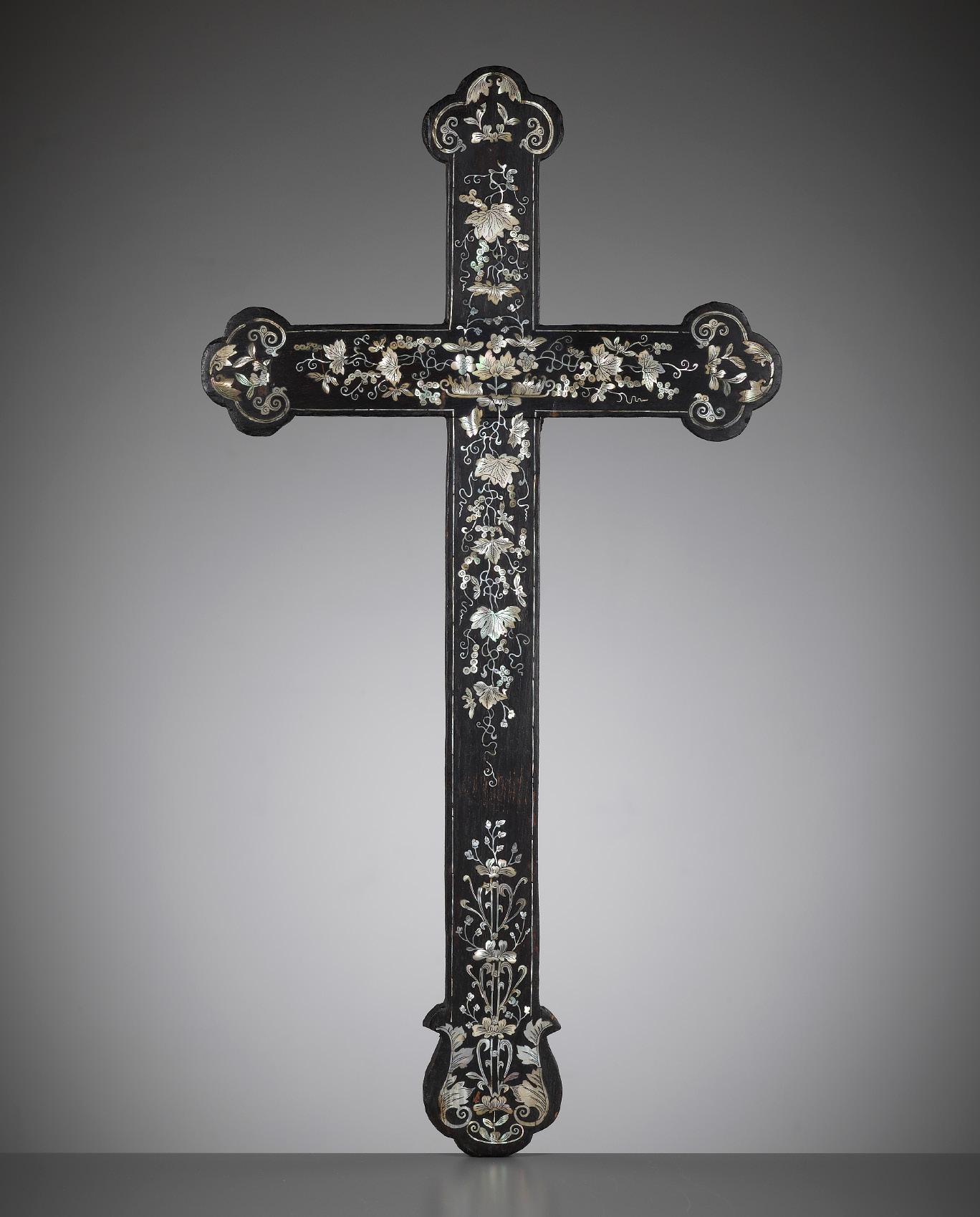

China, Macau. Finely inlaid with neatly incised mother-of-pearl to depict fruiting vines, lotus, small flowers, and foliage, the ends inlaid with foliate scrolls and centered by a lotus flower.
Provenance: From a British collector.
Condition: Good condition with expected old wear, traces of use and age, few nicks, light scratches, small chips, minor old repairs with associated remnants of adhesive.
Weight: 444.2 g
Dimensions: Height 45 cm
AUCTION RESULT COMPARISON
Type: Related
Auction: Christie’s London, 11 May 2015, lot 14
Price: GBP 27,500 or approx. EUR 41,500 converted and adjusted for inflation at the time of writing
Description: A Chinese mother-of-pearl inlaid wood apostle cross Expert remark: Compare the related form, mother-or-pearl decoration, and color of the wood. Note the size (60 cm).
Estimate EUR 6,000
Starting price EUR 3,000
20
9
The three upper terminals of the cross correspond to a design known as the cross botonée, used in Western heraldry as well as religious art – where the three lobes are said to represent the Trinity.
A MOTHER-OF-PEARL-INLAID ROSEWOOD APOSTLE CROSS, VIETNAM, NGUYEN DYNASTY, 19TH CENTURY

Supported on a triangular socle, finely inlaid with mother-of-pearl depicting Christian symbols including the implements of passion at the lower terminal, the upper three terminals ending with lotus, acanthus leaves, and scrolling vines, and inscribed to the top with INRI.
Provenance: British trade. Acquired from a private vendor who found this piece in a small, regional market in France.
Condition: Good condition with expected traces of age and wear, few nicks, light scratches, small chips, minor old repairs with associated remnants of adhesive. Fine, naturally grown patina overall.
Weight: 444.2 g
Dimensions: Height 45 cm
The initialism INRI represents the Latin inscription (in John 19:19), “Iesus Nazarenus, Rex Iudaeorum”, which in English translates to ‘Jesus the Nazarene, King of the Jews’. In the New Testament, Jesus is referred to as the King of the Jews, both at the beginning of his life and at the end. In the narrative of the Passion of Jesus, the title ‘King of the Jews’ leads to charges against Jesus that result in his crucifixion.
The three upper terminals of the cross correspond to a design known as the cross botonée, used in Western heraldry as well as religious art – where the three lobes are said to represent the Trinity, the Father, the Son, and the Holy Ghost.
Estimate EUR 2,000
Starting price EUR 1,000
10
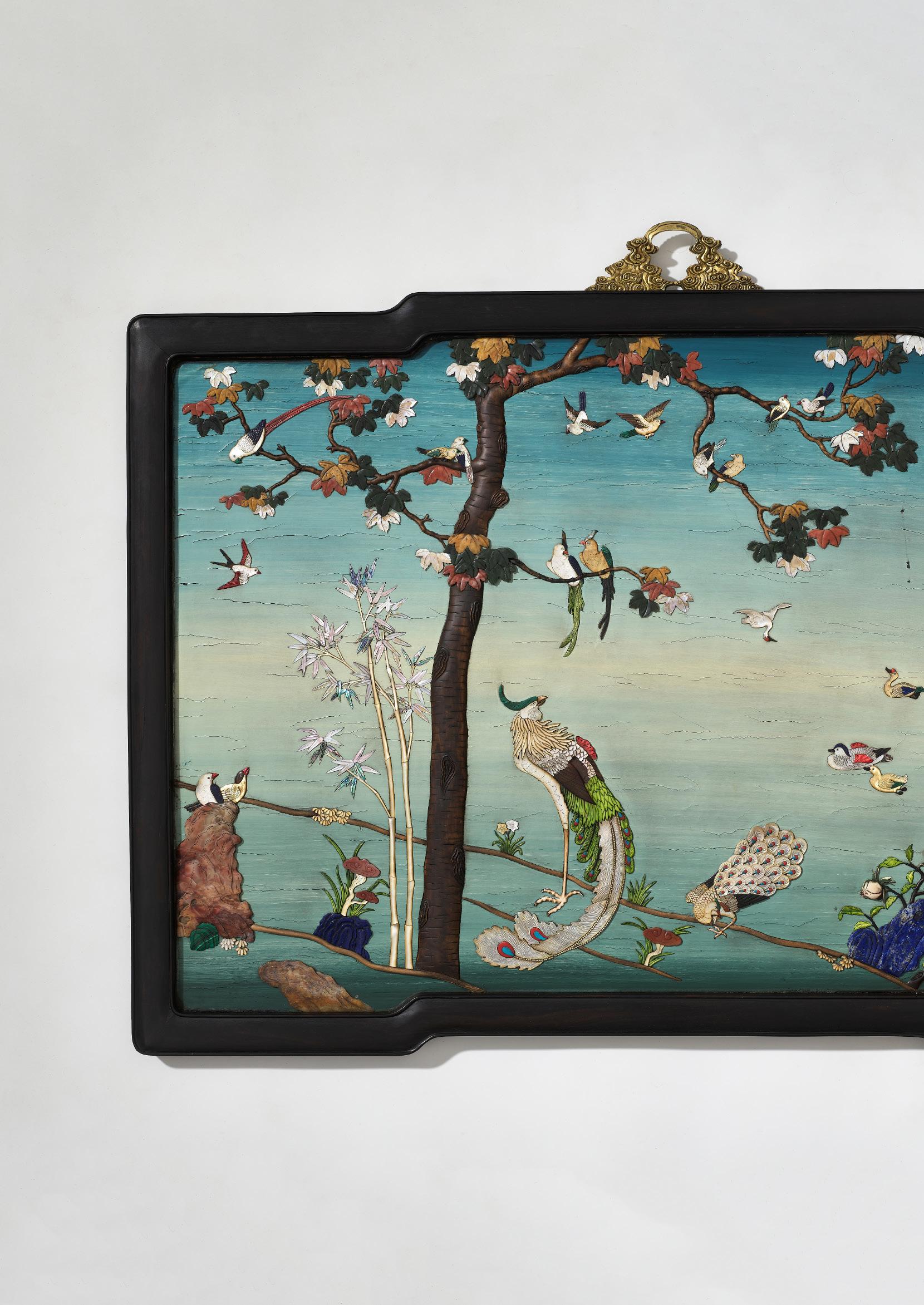
A LARGE INLAID LACQUER
‘HUNDRED BIRDS WORSHIP THE PHOENIX’ ZITAN-FRAMED HANGING PANEL, QIANLONG PERIOD


China, 1736-1795. Masterfully inlaid on a misty sky-blue lacquer ground with 11 different materials: Spinach green jade, lapis lazuli, malachite, carnelian, turquoise, soapstone, coral, wood, ivory, stained bone and tortoise shell, altogether depicting a phoenix perched under a wutong tree, surrounded and worshipped by a myriad of birds including a peacock, magpies, cranes, pheasants, and mandarin ducks, some perched on the tree, some in flight and others resting on rockwork, amid peonies, lingzhi, and bamboo.
Provenance: UK trade. Formerly in a European private collection. Condition: Displaying remarkably well, with no restoration or replacement work worth mentioning, making this one of the bestpreserved wall panels from the Qianlong period ever to be recorded. Some old wear, expected age cracks to lacquer with associated losses, only two small pieces (!) of the many hundred inlays lost. Light scratches. The frame with few minuscule chips, expected minor age cracks with an associated small touchup to the upper right corner. The suspension is made from gilt-bronze and is original to frame and panel.
Dimensions: Panel size 67.5 x 100.5 cm, Size incl. frame 76 x 109 cm
With a well-carved zitan frame mounted with a gilt-bronze suspension in the form of finely incised lingzhi-shaped clouds.
Paintings and embroideries with phoenixes surrounded by various birds, including cranes, mandarin ducks, and pheasants, are a common motif in Chinese culture. Phoenixes are regarded as the king of the birds, as they represent power, virtue, and grace. This large and impressive inlaid panel is an outstanding example and possibly of imperial origin.
Literature comparison: A related example of an inlaid screen was exhibited in Tributes from Guangdong to the Qing Court, Chinese University of Hong Kong Art Gallery, 28 February to 12 April 1987, no. 86.
AUCTION RESULT COMPARISON
Type: Closely related
Auction: Christie’s 11 July 2006, lot 73
Price: GBP 131,200 or approx. EUR 261,000 converted and adjusted for inflation at the time of writing
Description: An ivory and hardstone inlaid zitan hanging panel, Qianlong (1736-95)

Expert remark: Compare the closely related motif, material, frame, and size (81 x 118 cm).
AUCTION RESULT COMPARISON
Type: Related
Auction: Bonhams London, 7 November 2013, lot 339
Price: GBP 122,500 or approx. EUR 193,000 converted and adjusted for inflation at the time of writing
Description: A rare pair of jade and hardstone-inlaid wall screens, 18th/19th century
Expert remark: Compare the related motif, material, and size (82.5 x 111 cm). Note that this is a pair.
Estimate EUR 30,000
Starting price EUR 15,000
23 11

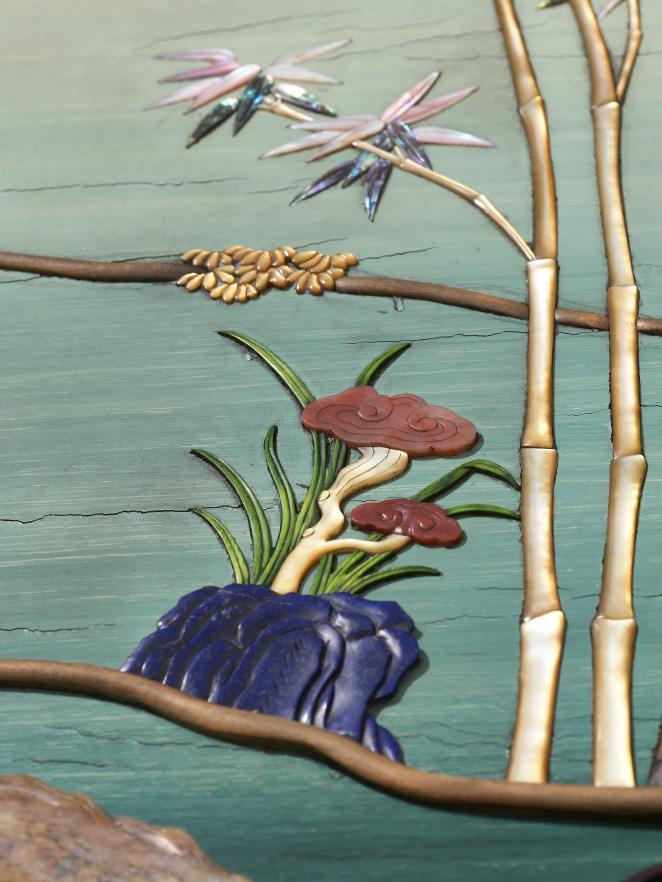

24
AN IMPERIAL BEIJING ENAMEL CUP STAND, KANGXI YUZHI MARK AND OF THE PERIOD (1662–1722)
China, c. 1700-1722. Of sixteen-lobed form, the body of heavily cast copper alloy and with the rims finely gilt. Exquisitely painted in bright enamels, the interior with eight phoenixes radiating from the central raised stand with kuilong decoration against a yellow ground. The central recessed ring, added to support a cup, with a half-open peony bloom and furled petals against a turquoise ground, the base similarly painted with radiating and overlapping flower petals, centered by a roundel enclosing a red-enameled four-character mark Kangxi yuzhi and of the period.
Provenance: By repute from an old estate in London, United Kingdom. English trade, acquired from the above.
Condition: Good condition, commensurate with age, presenting remarkably well with crisp colors and a subtle luster overall. Old wear and a dense crackling to the enamels, as well as minor warping, dents and nicks to the metal fittings, exactly as expected from this type of ware. Small areas of verdigris, the inner edges and corners of the well with minor yet distinct areas of calcification, indicating the piece may have been used as a jardinière for some time. Obvious nicks and losses, no restoration or repair of any kind.
Weight: 744.3 g
Dimensions: Diameter 21.6 cm
The sides painted on the interior with petals against a turquoise ground and on the exterior with colorful kuilong against a yellow ground, the galleried rim with blue foliate scroll against a white ground.

The rich color palette and the delicacy of the multi-colored design employed to decorate this exquisite cup stand demonstrate the superb craftsmanship of the Imperial Palace Workshops in Beijing, the Zaobanchu, and the extraordinary skill of their painters. The technique of enameling on metal was originally introduced to the Chinese craftsmen in the Guangzhou area by French Jesuit missionaries in 1684, following the lifting of restrictions at Chinese ports. Being a port city, these artisans were the first to be exposed to wares from Europe and initially developed the skills to replicate these imports. Enamored with the range of vivid and pastel tones of both the imported and tributary wares, the Kangxi Emperor recruited enamel artisans from Guangzhou and Jesuit missionaries to work in the Palace and advance the proficiency of the Enamel Workshops. Painted enamel thus became a defining art form of this period, in quality, innovation, and unsurpassed opulence.
The appearance of Kangxi yuzhi marks – unframed, inside double circles, as in the case of the current cup stand – on a number of the surviving examples provides an indication of the Emperor’s close personal attachment to these pieces. This exquisitely decorated cup stand can probably be dated to the latter years of the Kangxi reign, possibly to the period AD 1700-22, since a fully developed enamel palette has been used to great effect in its painted decoration on a yellow ground, which is found on the majority of enameled metal vessels from this era. The delicately-painted phoenixes are rendered in both pink and blue enamels, of types which were not successfully prepared in the imperial ateliers until around 1700. In fact, this lot can be seen as a celebration of these newly invented enamel colors and the way they could be used to create painterly, but at the same time jewel-like, decoration. A related palette can be found on a small white-ground lobed box, also with a Kangxi yuzhi mark, in the collection of the National Palace Museum, Taipei (see Enamel Ware in the Ming and Qing Dynasties, Taipei, 1999, page 172, no. 82), which also bears a blue Kangxi yuzhi mark. The painting on the current lot is, however, executed with even greater sophistication.

25 12
LITERATURE COMPARISON
Compare a Beijing enamel plate, also of sixteen-lobed form, with a Kangxi yuzhi mark, and painted with the same design, in the National Palace Museum, Taipei, image number K1E000374N000000000PBA. Also compare an almost exact reproduction of the present cup stand commissioned by the Qianlong Emperor, 22.5 cm diameter, with an enameled four-character Qianlong mark and of the period, from the Qing Court collection and still in Beijing, illustrated in Metal-bodied Enamel Ware: The Complete Collection of Treasures of the Palace Museum, Hong Kong, 2001, pages 212-213, no. 203. The fact that only a few details were slightly reinterpreted to suit the Qianlong Emperor’s taste speaks for the timeless beauty of the present cup stand.

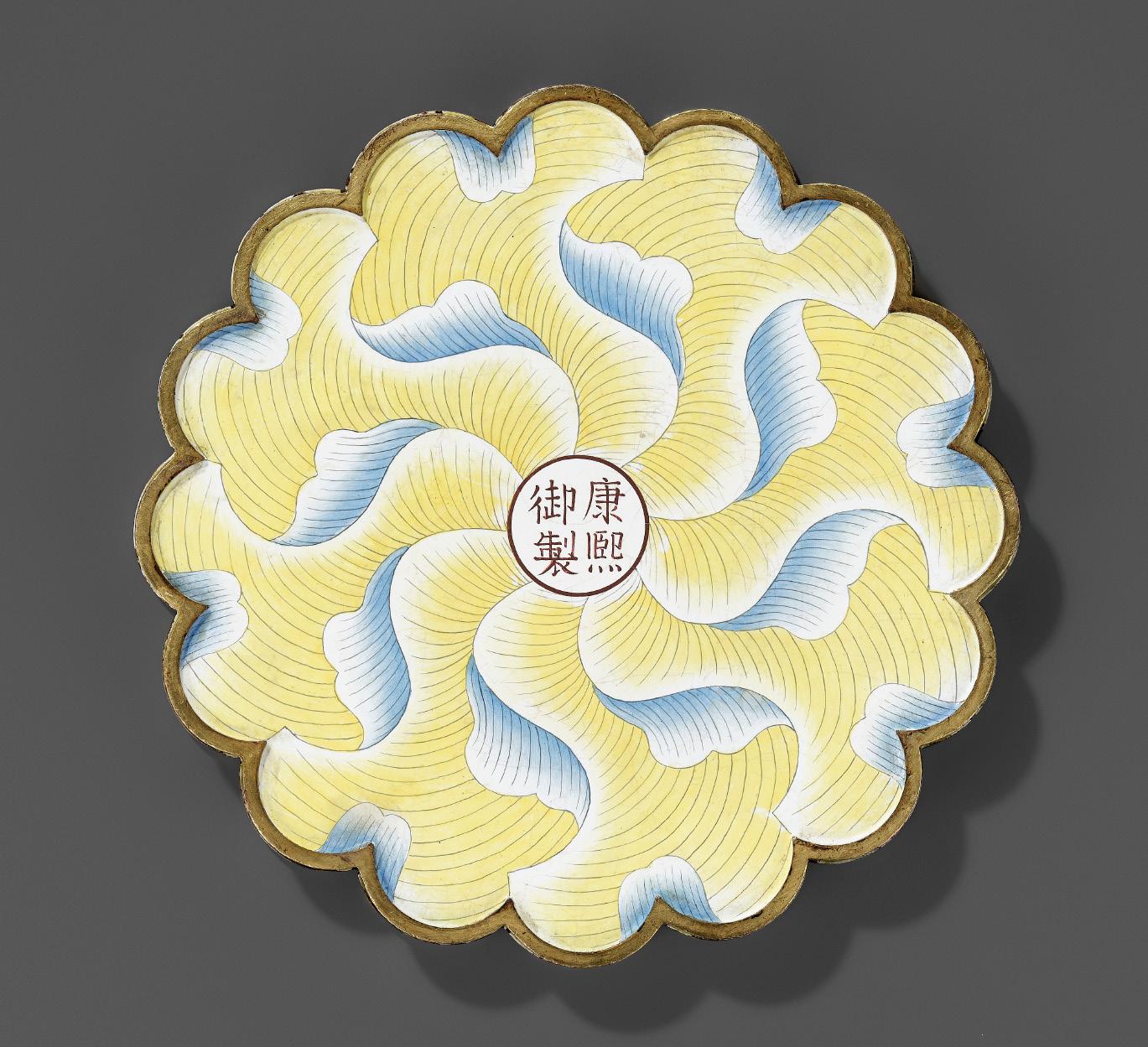
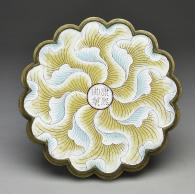
AUCTION RESULT COMPARISON
Type: Related
Auction: Bonhams Hong Kong, 30 November 2022, lot 27
Price: HKD 885,000 or approx. EUR 107,000 converted at the time of writing
Description: A superb and rare imperial Beijing enamel circular dish, Kangxi red enamel yuzhi four-character mark and of the period
Expert remark: Compare the closely related enamel decoration, yellow ground, and Kangxi yuzhi mark. Note the different form, motif, and the significantly smaller size (9.5 cm).
AUCTION RESULT COMPARISON
Type: Related
Auction: Christie’s Hong Kong, 29 May 2013, lot 2157
Price: HKD 1,230,000 or approx. EUR 186,000 converted and adjusted for inflation at the time of writing
Description: A very rare imperial painted-enamel cup and stand, Yongzheng enameled four-character marks and of the period
Expert remark: Compare the related enamel decoration and yellow ground of the cup stand. Note the different form, motif, smaller size (15.2 cm), Yongzheng reign mark, and that the lot also comprises the matching cup.
AUCTION RESULT COMPARISON
Type: Related
Auction: Sotheby’s Hong Kong, 7 April 2013, lot 3028
Price: HKD 1,840,000 or approx. EUR 278,000 converted and adjusted for inflation at the time of writing
Description: A rare imperial enameled goldbodied cup stand, Qing dynasty, Qianlong / Jiaqing period




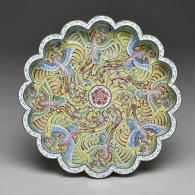
Expert remark: This lot is another example of an imperial enameled cup stand, however of later date and unmarked. Note the related size (20.5 cm). The Sotheby’s catalog note for this lot states that the Qianlong-marked cup stand in the National Palace Museum (see Literature comparison) is gold-bodied, which is contradicted by the Palace Museum’s own publication, stating that the rims of the cup stand are only gilt, e.g. not made from solid gold.
Estimate EUR 30,000
Starting price EUR 15,000
26

A LARGE ‘BIRDS WORSHIPPING THE PHOENIX’ CLOISONNÉ BASIN, MING DYNASTY
China, 16th to early 17th century. The interior exquisitely decorated in bright enamels with a majestic phoenix standing proudly on one leg, surrounded by adoring birds including a crane beside a tree, a peacock in flight amid colorful clouds, mandarin ducks in a pond, and pheasants perched on bamboo stalks, all encircled by red-ground foliate and white-ground lappet bands. The cavetto with a band of alternating lotus blossoms and the Eight Treasures (babao) below a diapered floral band, the everted rim with a band of chrysanthemum flowerheads and scrolling vines above a ruyi-head border, all against a dark blue ground.
Provenance: London trade.
Condition: Good condition with some old wear and expected manufacturing irregularities, including pitting to the enamel, the cavetto with small losses to enamel and associated old fills, minute dents, light wear to gilt.
Weight: 1,960 g
Dimensions: Diameter 37.5 cm
Phoenixes surrounded by various birds, including cranes, mandarin ducks, and pheasants, are a common motif in Chinese culture. Phoenixes are regarded as the king of the birds, as they represent power, virtue, and grace. The present lot is a rare example of such a depiction on a cloisonné basin.

LITERATURE COMPARISON
Compare a related cloisonné phoenix basin, dated to the late Ming dynasty, illustrated in the Compendium of Collections in the Palace Museum: Enamels 1, Beijing, 2011, no. 170. Two Ming dynasty cloisonné enamel basins decorated with phoenixes from the 15th and 16th centuries are illustrated by H. Brinker and A. Lutz in Chinese Cloisonné: The Pierre Uldry Collection, The Asia Society Galleries, USA, 1989, pls. 19 and 63.
AUCTION RESULT COMPARISON
Type: Closely related
Auction: Christie’s Paris, 9 June 2021, lot 166
Price: EUR 17,500 or approx. EUR 19,000 adjusted for inflation at the time of writing
Description: A cloisonné enamel ‘phoenix’ basin, China, Ming dynasty, 16th-17th century


Expert remark: Compare the closely related form, enamels, decorative bands, and phoenixes. Note the slightly smaller size (35 cm).
AUCTION RESULT COMPARISON
Type: Related
Auction: Sotheby’s Hong Kong, 30 May 2018, lot 653
Price: HKD 175,000 or approx. EUR 22,500 converted and adjusted for inflation at the time of writing
Description: A cloisonné enamel ‘carp’ basin, Ming dynasty, Wanli period
Expert remark: Compare the closely related form, enamels, and decorative bands. Note the slightly smaller size (35.5 cm) and different subject.
AUCTION RESULT COMPARISON
Type: Related
Auction: Christie’s Paris, 10 December 2020, lot 6
Price: EUR 56,250 or approx. EUR 61,500 adjusted for inflation at the time of writing
Description: A large cloisonné enamel basin, China, 17th century

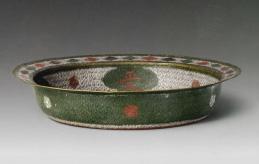
Expert remark: Compare the closely related form, enamels, and decorative bands. Note the significantly larger size (53.5 cm) and different subject.
Estimate EUR 8,000
Starting price EUR 4,000
28 13

AN EXTREMELY RARE CLOISONNÉ ENAMEL QUADRILOBED BOX AND COVER, QIANLONG FIVE-CHARACTER MARK AND OF THE PERIOD

China, 1736-1795. Supported on a flaring foot, the cover decorated with a central blossom encircled by four lotus flowers issuing meandering vines, the foot with further lotus and vines above a band of floral sprays, all above a turquoise ground, the interior, base, and rims in gilt. The recessed base incised with a five-character mark Qianlong nianzhi xuan and of the period.
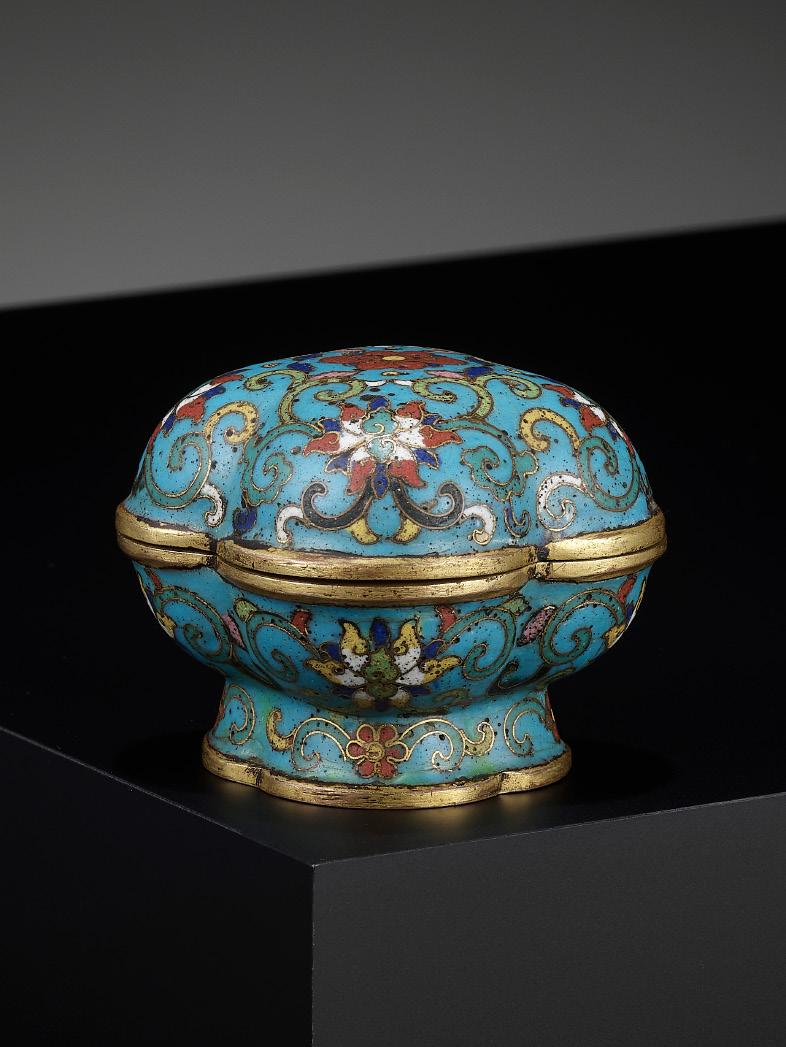

Provenance: From a noted private collection in Geneva, Switzerland, assembled since the 1960s, and thence by descent. An important part of this collection was on permanent loan and exhibited over several decades at the Asia-Africa Museum in Geneva. The interior of the cover with three old labels, ‘18’, ‘Signé Kun-Lung Impérial’, and ‘Geneve Art Ancien Chine & Extro-Orient. 2762 TFA’, and a lacquered inventory number ‘AMA-2762/2’. The interior of the bowl with three old labels, ‘Signé Kung Lung Impérial’, ‘K. Ming 1736-95’, and ‘Asia-Africa Museum Geneve’, and lacquered with an inventory number ‘AMA-2762/2’. The base with an old label, ‘Signé Kien Lung Impérial’. Two old paper labels with collection notes, one numbered ‘No 276/TFA’ and the other ‘No 2757/TFA’. According to the collector’s personal notes, the present lot was acquired on 13 October 1972. A copy of the corresponding entry in the collector’s notebook accompanies this lot.
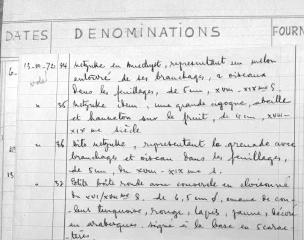
Condition: Very good condition with minor wear, few small nicks and light scratches, and manufacturing flaws, such as scattered pitting.
Weight: 140.0 g
Dimensions: Length 6.6 cm
The present lot belongs to a group of small cloisonné vases, censers, and instruments (luping sanshi) which were made for the burning of incense had an additional character below the reign mark and were made for the Qianlong court. Some scholars have suggested that the fifth character under the Qianlong mark could have been a way to number the large group of objects in a correct order, see H. Brinker and A. Lutz, Chinese Cloisonné: The Pierre Uldry Collection, New York, 1989, pp. 74-79.
The form of this four-lobed box supported by a broad foot rim directly references the crabapple (haitang), which could be combined with other emblems to create auspicious rebuses. Its second character, ‘tang’, is homophonous with the character for ‘hall’ and, by extension, ‘the family home’. For examples of Imperial objects of the Qing court of related haitang shape, see a bamboo tray at Bonhams Hong Kong, 24 November 2012, lot 323 (see fig. 1), and a pair of gilt bronze and cloisonne jardinieres at Bonhams London, 8 November 2012, lot 250 (see fig. 2).
AUCTION RESULT COMPARISON
Type: Closely related
Auction: Christie’s New York, 24 September 2021, lot 930
Price: USD 25,000 or approx. EUR 26,000 converted and adjusted for inflation at the time of writing
Description: A small cloisonné enamel circular box and cover, Qianlong four-character incised mark in a line and of the period, with an additional character ying

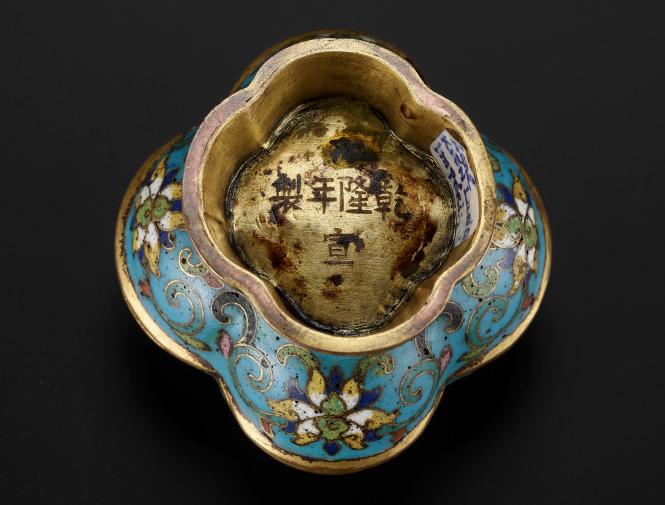
Expert remark: Compare the related lotus decoration, five-character Qianlong mark, and size (6.4 cm). Note the less rare circular form.
AUCTION RESULT COMPARISON
Type: Closely related
Auction: Sotheby’s Hong Kong, 4 October 2011, lot 2091
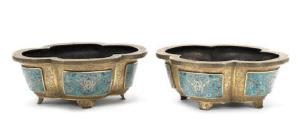
Price: HKD 250,000 or approx. EUR 41,500 converted and adjusted for inflation at the time of writing
Description: A small cloisonne seal-paste box and cover, incised mark and period of Qianlong

Expert remark: Compare the related lotus decoration, five-character Qianlong mark, and size (7 cm). Note the less rare circular form.
Estimate EUR 8,000
Starting price EUR 4,000
30
14
fig. 2
fig. 1
A CLOISONNÉ
ENAMEL ‘LOTUS’ BOTTLE VASE, QIANLONG FIVE-CHARACTER MARK AND OF THE PERIOD

China, 1736-1795. The globular body supported on a spreading foot, rising to a tall neck tapering towards the gilt rim, brightly decorated with stylized lotus blooms borne on meandering leafy tendrils below a ruyi-head band, the foot encircled with C-scrolls and circles, all reserved on a turquoise ground. The base incised with a five-character mark Qianlong nianzhi tong and of the period.
Provenance: From a private collection in South Africa, gifted to the previous owner by a former diplomat in Yugoslavia on 26 June 1982. French trade, acquired from the above.
Condition: Very good condition with old wear as expected and some manufacturing irregularities, including minimal pitting, as well as minor nicks to enamels.
Weight: 278.8 g
Dimensions: Height 12.7 cm
Based on its size and shape, this vase was made to hold incense instruments. These types of small cloisonné vases, censers, and instruments (luping sanshi) which were made for the burning of incense had an additional character below the reign mark and were made for the Qianlong court. Some scholars have suggested that the fifth character under the Qianlong mark could have been a way to number the large group of objects in the correct order, see H. Brinker and A. Lutz, Chinese Cloisonné: The Pierre Uldry Collection, New York, 1989, pp. 74-79.
Literature comparison: Compare a similar cloisonné enamel vase in the Pierre Uldry collection, published in Brinker and Lutz in Chinese Cloisonné: The Pierre Uldry Collection, New York, 1989, no. 285, p 283. Compare a related cloisonné enamel vase, Qianlong mark and period, in the Palace Museum, illustrated by Zheng Xinmiao, ed., Compendium of Collection in the Palace Museum: Enamels 2 - Cloisonné in the Qing Dynasty (16441911), Beijing, 2011, pl. 154. For a Kangxi-marked example of similar size and decoration from the Qing Court Collection, see Metal-bodied Enamel Ware. The Complete Collection of Treasures of the Palace Museum, Hong Kong, 2001, pl. 81.
AUCTION RESULT COMPARISON
Type: Closely related
Auction: Christie’s Hong Kong, 29 May 2013, lot 2057
Price: HKD 300,000 or approx. EUR 44,500 converted and adjusted for inflation at the time of writing
Description: A small cloisonné enamel bottle vase, Qianlong incised four-character mark and of the period

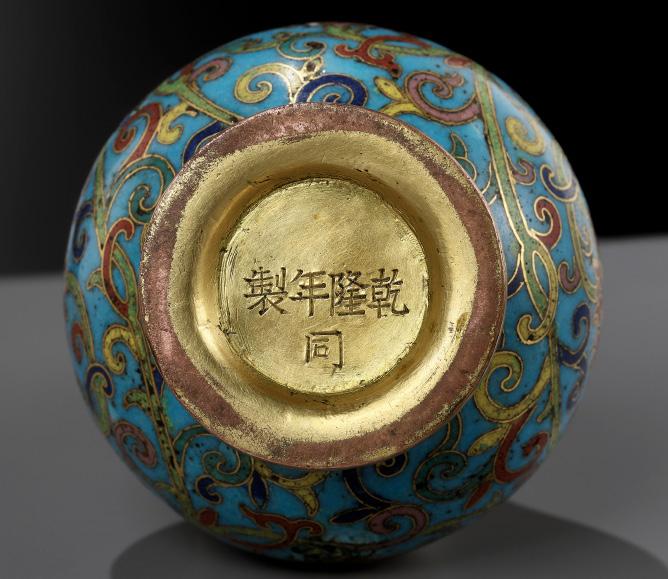
Expert remark: Compare the closely related form, motif, and four-character mark with an additional character. Note the size (12.3 cm).
Estimate EUR 8,000
Starting price EUR 4,000
31 15
A CLOISONNÉ ENAMEL MALLET VASE, QIANLONG FIVE-CHARACTER MARK AND OF THE PERIOD
China, 1736-1795. The cylindrical body rising from a spreading foot to a tall neck with gilt rim, decorated around the exterior with lotus blooms borne on meandering leafy scrolls between ruyi bands, the foot encircled with C-scrolls and circles, all reserved on a distinct turquoise ground. The base incised with a five-character mark Qianlong nianzhi zuo and of the period.

Provenance: British trade.
Condition: Good condition with expected old wear, minor crackling and small fills typical for these wares. Minuscule nicks, some dents with associated small losses, the vase slightly leaning.
Weight: 226 g
Dimensions: Height 14.4 cm
Based on its size and mallet shape, this vase was made to hold incense instruments. These types of small cloisonné vases, censers, and instruments (luping sanshi) which were made for the burning of incense had an additional character below the reign mark and were made for the Qianlong court. Some scholars have suggested that the fifth character under the Qianlong mark could have been a way to number the large group of objects in the correct order, see H. Brinker and A. Lutz, Chinese Cloisonné: The Pierre Uldry Collection, New York, 1989, pp. 74-79.
Literature comparison: Compare a similar cloisonné enamel vase with Qianlong five-character mark and of the period, from the Robert H. Clague Collection, Phoenix Art Museum, illustrated in Bèatrice Quette, Cloisonné: Chinese Enamels from the Yuan, Ming and Qing Dynasties, New York, 2011, p. 291, pl. 130.
AUCTION RESULT COMPARISON
Type: Near identical
Auction: Christie’s New York, 18 September 2014, lot 613
Price: USD 37,500 or approx. EUR 44,500 converted and adjusted for inflation at the time of writing
Description: A small cloisonné enamel bottle vase, Qianlong four-character mark inscribed in a line and of the period
Expert remark: Compare the near identical bottle or mallet form, motif, five-character mark, and size (14.5 cm).
AUCTION RESULT COMPARISON
Type: Closely related
Auction: Bonhams London, 11 May 2017, lot 180
Price: GBP 22,500 or approx. EUR 32,500 converted and adjusted for inflation at the time of writing
Description: A cloisonné enamel bottle vase, Qianlong five-character mark and of the period



Expert remark: Compare the closely related mallet or bottle form, motif, and five-character mark. Note the slightly larger size (17 cm).
AUCTION RESULT COMPARISON
Type: Closely related
Auction: Bonhams London, 17 May 2012, lot 139
Price: GBP 20,000 or approx. EUR 32,500 converted and adjusted for inflation at the time of writing
Description: A cloisonné enamel and gilt-bronze longnecked cylindrical vase, incised Qianlong five-character mark and of the period
Expert remark: Compare the closely related form, motif, and five-character mark.
Estimate EUR 12,000
Starting price EUR 6,000
32 16
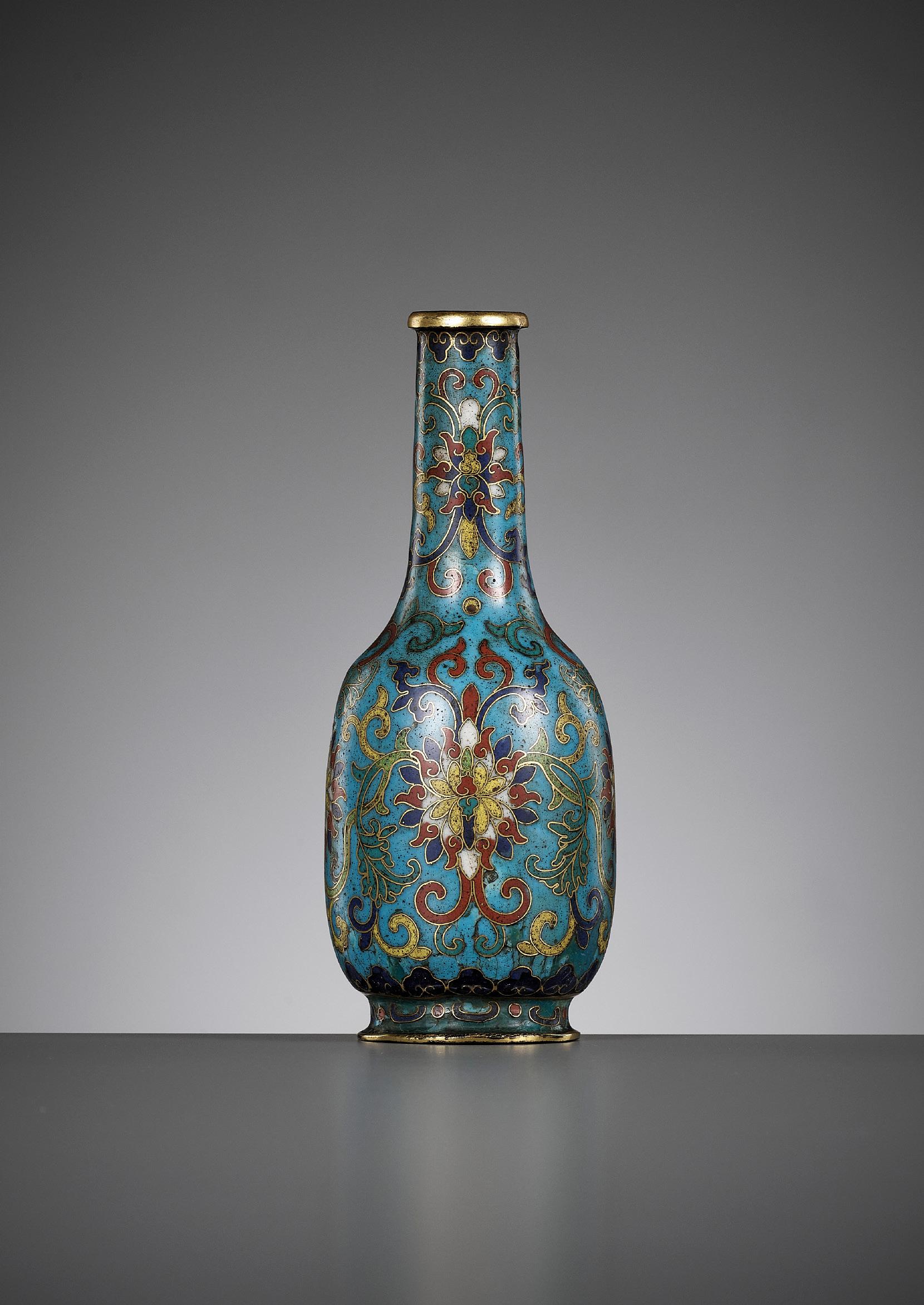
A LARGE IMPERIAL CLOISONNÉ ENAMEL ARCHAISTIC CENSER AND COVER, FANGDING, QIANLONG MARK AND PERIOD
China, 1736-1795. The tapering rectangular censer has twin upright handles and is decorated to each side with massive raised flanges separating finely enameled taotie masks surrounded by and below a band of confronting kui dragons, all supported on four bladeshaped legs emerging from mythical-beast terminals. The reticulated gilt copper alloy cover is decorated with pierced foliage, enameled with angular scrolls, and surmounted by a gilt finial in the shape of a Buddhist lion. The cover is neatly incised with a horizontal six-character mark da Qing Qianlong nianzhi on a gilt plaque and of the period.
Provenance: Hong Kong trade. By repute acquired from an old private estate.
Condition: Magnificent condition with minor wear and manufacturing irregularities, including expected pitting and tiny casting holes. The censer wobbles very slightly. No restorations or fills of any kind visible under the examination of strong UV light. Note that such a general state of preservation on a censer from this period is extremely rare.
Weight: 8,338 g
Dimensions: Height 44.5 cm, Width 27.7 cm
With a custom fitted silk storage box. (2)
The shape of this censer is based upon ancient bronze vessels. The finely gilt blade-shaped legs, loop handles and flanges, along with the wide spreading taotie masks, all have their prototypes in Zhou dynasty bronzes, many of which are illustrated in Xiqing Gujian, ‘Inspection of Antiques from the Zhou Dynasty’, the catalogues of ancient bronzes in the Qing Court Collection compiled under the authorization of the Qianlong Emperor in 1755. Censers of this type not only served as an important part of the palace furnishing, but were also used in rituals, banquets, and imperial ceremonies.
Literature comparison: Several similar cloisonné fangding-form censers have been preserved in the Qing Court Collection, which are found in varying sizes with different combinations of decorative elements. Compare the fangding with cover with a cloisonné enamel Qianlong six-character mark, similarly decorated with taotie design but with flat dragon-form legs in the National Palace Museum, Taipei, illustrated in Enamel Ware in the Ming and Ch’ing Dynasties, Taipei, 1999, no. 59 (33.8 cm). Compare also three examples in the Palace Museum, Beijing, the first dated to the early Qing dynasty with a gilt openwork cover, lion-form finial and flat bladeshaped legs (35.6 cm), the second the with a cast Qianlong six-character
mark without a cover and decorated with angular chilong motifs (28.7 cm), the third with a cast Qianlong four-character mark and decorated with taotie design with blade-shaped feet (48.3 cm), illustrated in Compendium of Collections in the Palace Museum, Enamels - 2 - Cloisonne in the Qing Dynasty (1644-1911), Beijing, 2011, nos. 68, 245 and 246, respectively. Compare also one with a lion-form finial and reticulated panels on the cover (38 cm) in the Shenyang Imperial Palace Museum, illustrated in The Prime Cultural Relics Collected by Shenyang Imperial Palace Museum - The Enamel Volume, Shenyang, 2007, pp. 146-147, no. 1.
AUCTION RESULT COMPARISON
Type: Closely related
Auction: Christie’s Hong Kong, 2 December 2015, lot 3250
Price: HKD 1,240,000 or approx. EUR 168,000 converted and adjusted for inflation at the time of writing
Description: A cloisonné enamel archaistic censer and cover, fangding, Qianlong period
Expert remark: Compare the closely related form and decoration as well as the similar size of 48.2 cm, the difference of 3.7 cm owed solely to the fact that the Buddhist lion on top of this censer has its body raised in an alerted position, while it is shown in a rather huddled position on the present lot. Note also the absence of a reign mark.
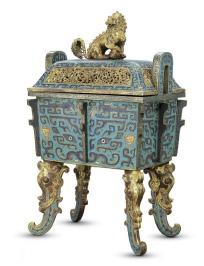
AUCTION RESULT COMPARISON
Type: Closely related
Auction: Christie’s Hong Kong, 30 November 2020, lot 2911
Price: HKD 4,750,000 or approx. EUR 570,000 converted and adjusted for inflation at the time of writing
Description: A superb imperial cloisonnné enamel ‘taotie’ fangding-form censer and cover, and a champlevé stand, Qianlong period

Expert remark: Compare the closely related form and decoration as well as the similar size (46.5 cm excl. stand). Note the absence of a reign mark and the additional champlevé stand.
Estimate EUR 40,000
Starting price EUR 20,000
34 17
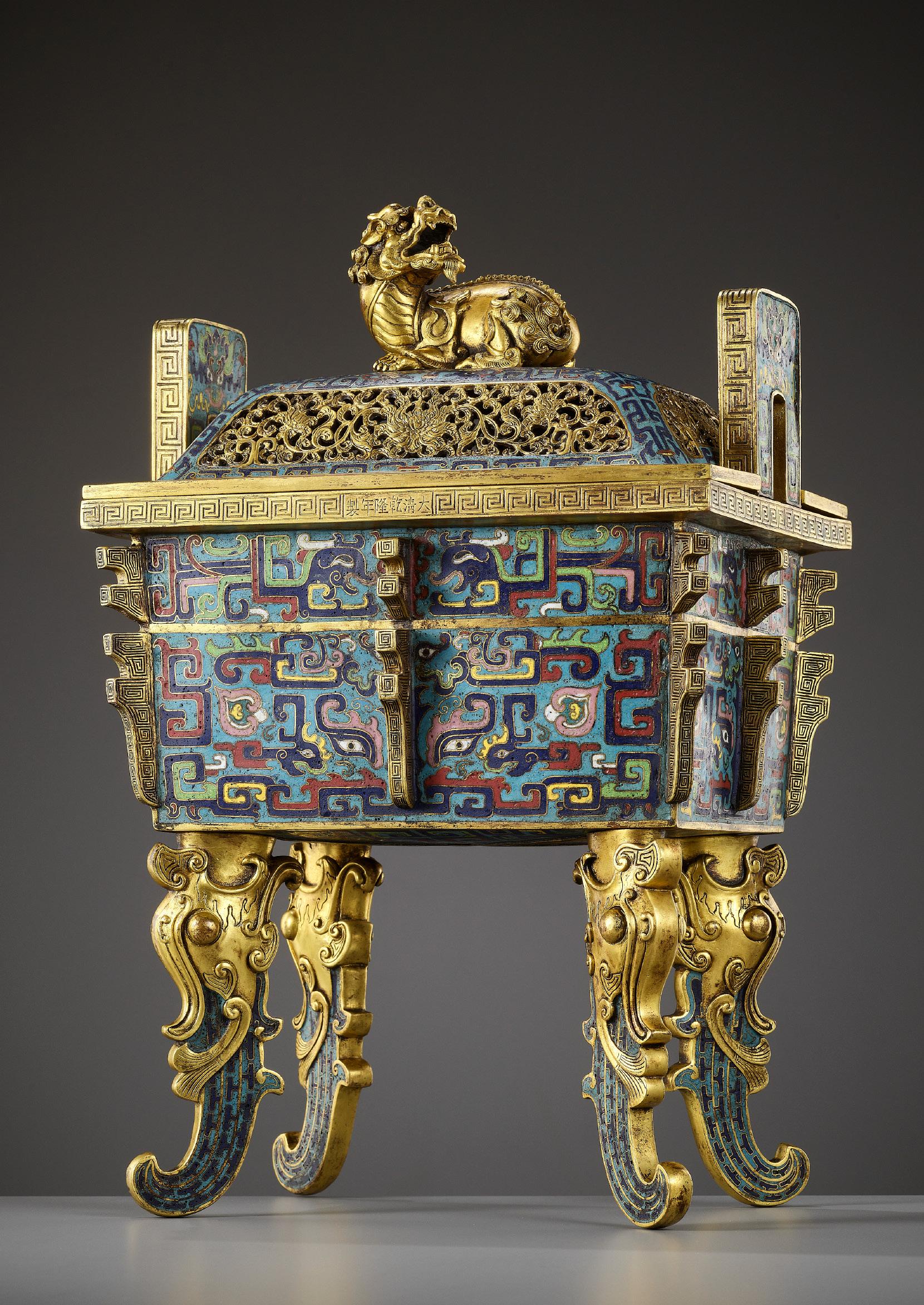

A VERY RARE SILVER BOX AND COVER DEPICTING THE BLACK TORTOISE, XUANWU, TANG DYNASTY
China, 618-907. Both sides of the flat circular box are finely chased, the cover neatly embossed to the center with a tortoise entwined with a snake, their heads confronted, the serpent’s scales and tortoise’s carapace meticulously incised, encircled by two foliate bands divided by a raised line band. The sides of the box and cover with a similar foliate band, the underside similarly decorated with two confronted phoenixes centered by a flowerhead and encircled by a raised line and a foliate band, all against a ring-punched ground.
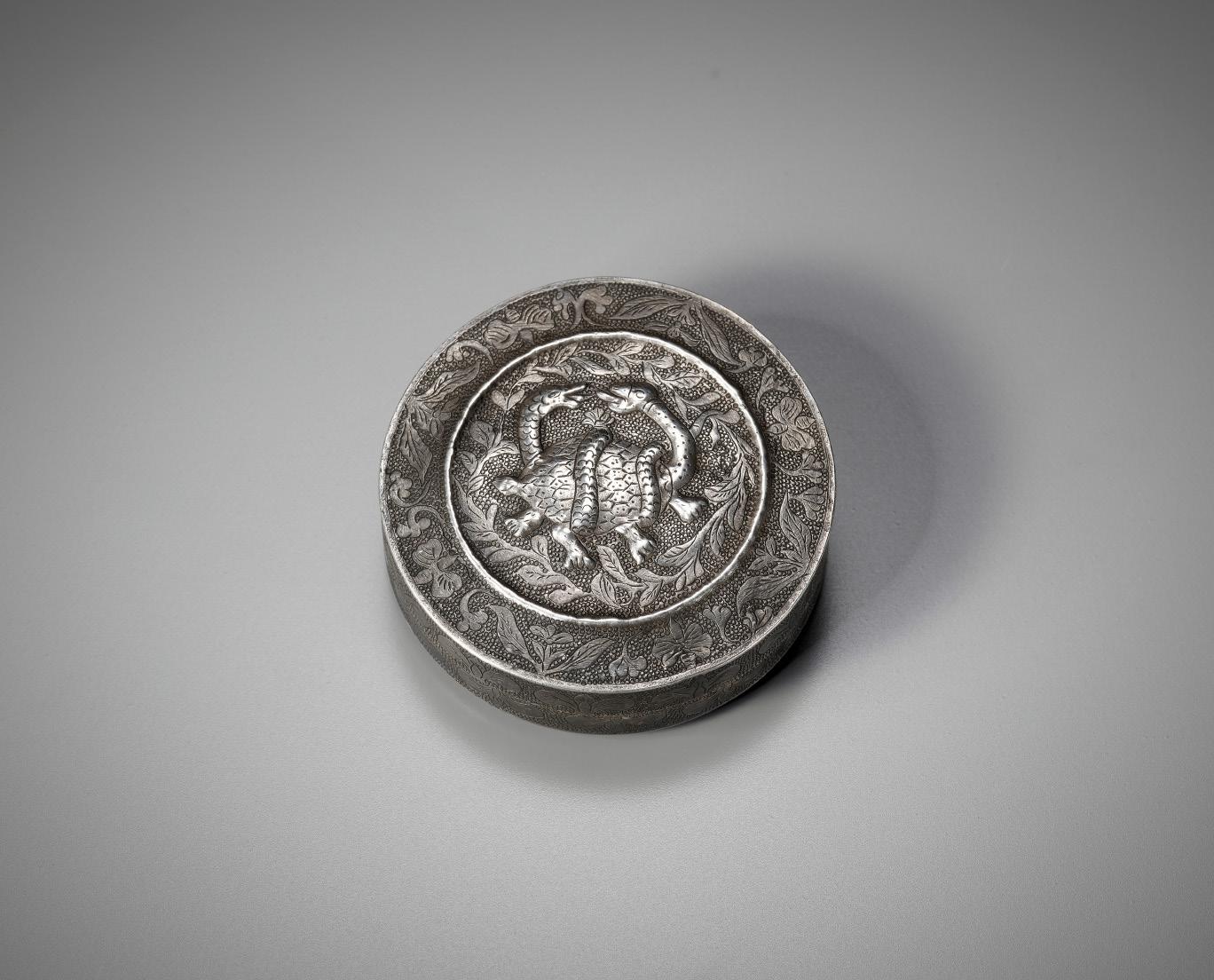
Provenance: Hong Kong trade.
Condition: Very good condition with some old wear, traces of use and manufacturing irregularities, expected minor tarnishing to the silver, and few tiny dents.
Weight: 50.3 g
Dimensions: Diameter 6 cm
The Black Tortoise (xuanwu) is one of the Four Symbols of the Chinese constellations, which emerged in Chinese cosmology around the third century BC and became firmly established in the following centuries. Despite its English name, it is usually depicted as a tortoise entwined together with a snake. The name used in East Asian languages does not mention either animal. The alternative name ‘Black (or Dark or Mysterious) Warrior’ is a more faithful translation. It represents the north and the winter season, thus it is sometimes called Xuanwu of the North. The creature’s name is identical to that of the important Taoist god Xuanwu, who is sometimes (as in Journey to the West) portrayed in the company of a turtle and a snake.
This depiction of a tortoise entwined with a snake is highly symbolic. According to Chinese mythology, tortoises are exclusively female and must be paired with snakes, which have similarly shaped heads, to

conceive. Therefore, the adroitly entwined tortoise and snake do not represent a violent struggle, but rather a harmonious balance of Yin and Yang. Interestingly, neither is capable of defeating the other, as the snake is unable to crush the tortoise’s shell and reach its vital organs while the tortoise is unable to attack the serpent due to its short limbs and neck. Furthermore, the creature’s name is identical to that of the important Daoist god Xuanwu, who is sometimes (as in Journey to the West) portrayed in the company of a turtle and a snake.
LITERATURE COMPARISON
Compare the mural of the Black Tortoise, dated early 7th century, Goguryeo Kingdom, painted on the northern wall of the Great Tomb of Kangso in Pyongyang (fig. 1). Compare a bronze mirror with symbols of the four cardinal directions, including the Black Tortoise, dated 7th century, Sui or Tang dynasty, in the Metropolitan Museum of Art, accession number 2022.151.
AUCTION RESULT COMPARISON
Type: Related
Auction: Christie’s New York, 12 September 2019, lot 544
Price: USD 102,500 or approx. EUR 108,000 converted and adjusted for inflation at the time of writing
Description: A finely engraved small silver ‘mandarin duck’ box and cover, Tang dynasty Expert remark: Compare the related circular (though convex) form and chased decoration, however lacking the embossed details to the center. Note the smaller size (4.4 cm).

Estimate EUR 4,000
Starting price EUR 2,000
36 18
fig. 1
A GILT-COPPER REPOUSSÉ AND PALE CELADON JADE BOWL, LIAO DYNASTY


China, 907-1234. The deep round sides supported on a short foot, the jade bowl fitted with neatly incised gilt-copper repoussé decorations depicting flying geese amid scrolling foliage in openwork, the rim and foot in gilt copper as well, the translucent stone of a pale celadon tone.
Provenance: Old Japanese private collection. Czech private collection, acquired from the above.
Condition: Good condition, commensurate with age. Some old wear and minor corrosion, dents and nicks, light scratches, signs of weathering and erosion, the bronze with malachite encrustations, the jade with extensive creamy-white calcification and iron residue overall.
Weight: 141 g
Dimensions: Diameter 10.3 cm
Estimate EUR 6,000
Starting price EUR 3,000
37 19
A TIANHUANG ‘BUDDHIST LION AND CUB’ SEAL, QING DYNASTY
China, first half of the 19th century. Of square section, surmounted by a seated lion with its head turned towards its cub, one paw holding it down, their snouts gently touching and eyes interlocked. The mane, paws, and bushy tails finely carved and incised, the claws and spine well detailed. The seal face inscribed with a section of a poem by Tang dynasty poet Bai Juyi. The stone of a magnificent and even amberorange color.
Inscriptions: The seal face inscribed ‘Ma jiang song gong shou, xin yu zhu ju kong’ (The appearance of the pine is thin, the heart is empty like a bamboo).
Provenance: West Berkshire, United Kingdom, local trade. By repute acquired from a private estate.
Condition: Excellent condition with expected old wear, light scratches, little nibbling to edges, the stone with natural fissures and inclusions.
Weight: 86.0 g
Dimensions: Size 4.1 x 3.9 x 3.6 cm
The fine coloration and luminosity of this tianhuang stone are skillfully accentuated through its intricately carved details which reveal the layers of subtle golden hues. The combination of carving in the round and low-relief detailing effectively captures the sunlight as it shines on and passes through the seal to further intensify the richness of color.

Tianhuang is a type of soapstone that is valued for its warm tones of amber and egg yolk as well as its lustrous sheen and was considered the rival to the finest and purest jade. Apart from being graded by its color, tianhuang was also priced according to its weight rather than size, hence making it one of the most expensive materials to carve.
AUCTION RESULT COMPARISON
Type: Related
Auction: Sotheby’s Hong Kong, 7 October 2015, lot 3734
Price: HKD 1,937,500 or approx. EUR 271,000 converted and adjusted for inflation at the time of writing
Description: A tianhuang ‘Buddhist lion’ seal, Qing dynasty
Expert remark: Compare the related motif, carving style, facial expressions, color of the stone, and size (4.9 x 3 x 3 cm)
AUCTION RESULT COMPARISON
Type: Related
Auction: Sotheby’s Hong Kong, 29 May 2019, lot 546
Price: HKD 312,500 or approx. EUR 40,000 converted and adjusted for inflation at the time of writing
Description: A finely carved soapstone ‘lion’ seal, Qing dynasty


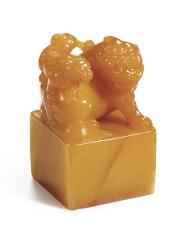
Expert remark: Compare the related motif, carving style, color of the stone, and size (3.8 x 3.1 x 3.1 cm)
Estimate EUR 8,000
Starting price EUR 4,000
38 20

A LIMESTONE ‘LION’ MAT WEIGHT, HAN DYNASTY
China, 206 BC to 220 AD. Carved as a recumbent lion with its feet tucked underneath, the head resting on his paws, the face with bulging eyes and a ruyi-shaped snout, finely incised with a central ridge along the face and scrolling fur. The stone of an even blackish-brown color.
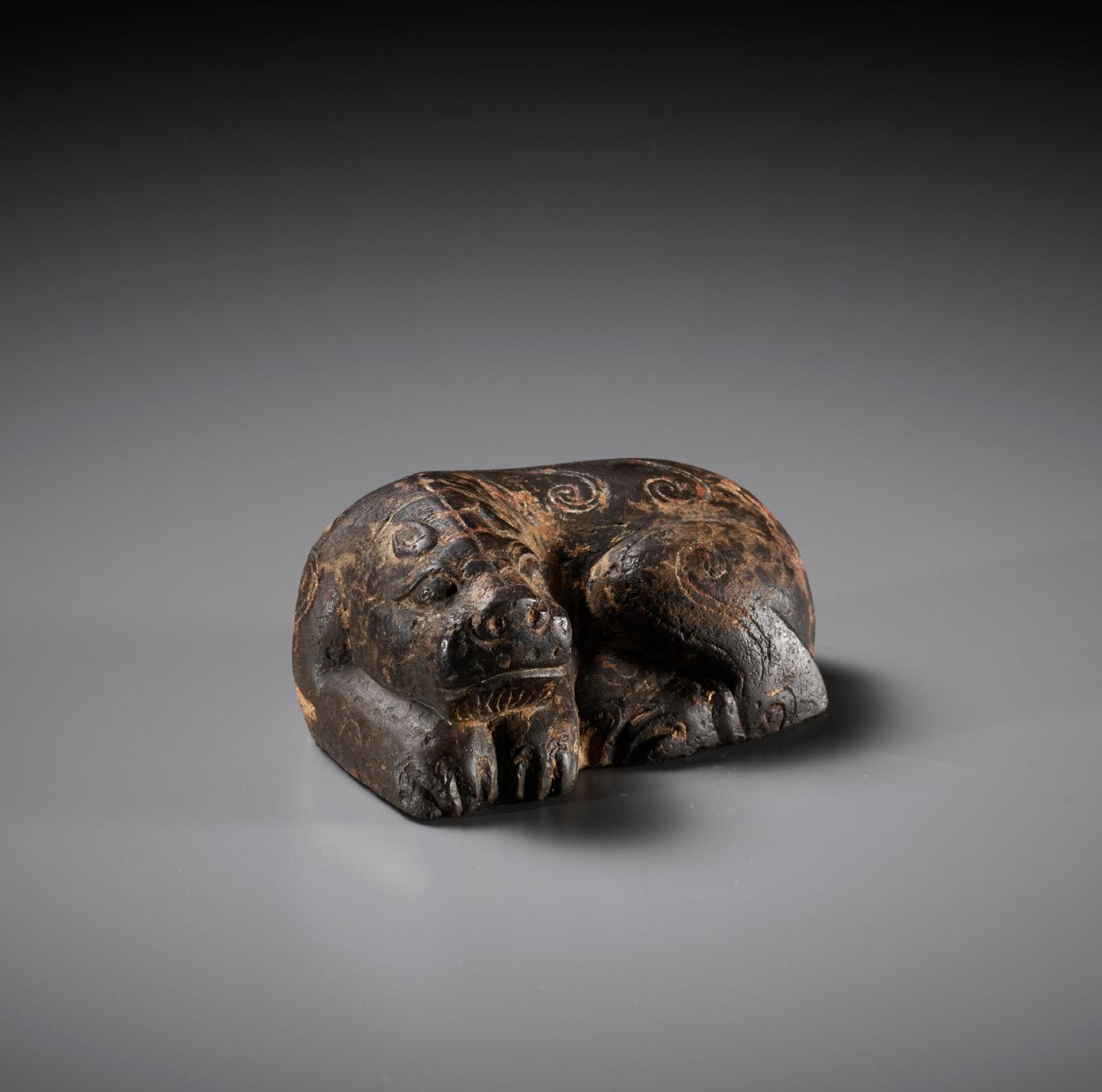

Provenance: From a noted Czech private collection. Originally acquired in Japan.
Condition: Good condition, commensurate with age. Small nicks, cracks and losses, light surface scratches, few little chips, remnants of pigment, signs of weathering and soil encrustations. Overall exactly as expected for an authentic Han dynasty limestone sculpture.
Weight: 358 g
Dimensions: Length 9.5 cm
AUCTION RESULT COMPARISON
Type: Related
Auction: Christie’s New York, 27 March 2015, lot 8267
Price: USD 27,500 or approx. EUR 33,000 converted and adjusted for inflation at the time of writing
Description: A pair of ivory-colored stone recumbent lion-form mat weights, China, Western Han dynasty or later Expert remark: Note the size (8.3 cm), the ivory-colored stone, and that this lot comprises two mat weights.

AUCTION RESULT COMPARISON
Type: Related
Auction: Christie’s New York, 22 June 2011, lot 436
Price: USD 8,125 or approx. EUR 12,500 converted and adjusted for inflation at the time of writing
Description: A Chinese soapstone figure of a recumbent tiger, Han dynasty
Expert remark: Compare the closely related pose, central ridge at the head, and size (10.2 cm). Note the different material.
Estimate EUR 2,000
Starting price EUR 1,000
40 21
A JADE SWORD CHAPE, WARRING STATES PERIOD TO WESTERN HAN DYNASTY
China, 475 BC to 8 AD. Of trapezoidal form and lenticular section, finely carved in low relief to both sides with a sinuous chilong, its head with a single horn, the coiled body dissolved into scrolls and hooks, the tail furcated. The top pierced with two apertures. The opaque stone of a mottled gray tone with deep-brown, almost plum-colored shadings and dark striations.

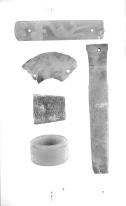

Provenance: Professor David Seares Watson.

Sotheby’s London, 19 October 1965, lot 4 (dated to the Han dynasty). Dr. Wou Kiuan, acquired from the above. Wou Lien-Pai Museum, coll. no. E.8.36. A copy of the catalog entry and illustration for the present lot from Sotheby’s London, 19 October 1965, lot 4, noting the buyer as “Wou” and a purchase price of thirty British pounds and eight shillings, roughly equivalent to a monthly salary at the time, accompanies this lot. Professor David Meredith Seares Watson, FRS FGS HFRSE LLD (1886-1973), was the Jodrell Professor of Zoology and Comparative Anatomy at University College, London, from 1921 to 1951. He received many awards and academic honors including the Darwin Medal from the Royal Society, the Linnean Medal from the Linnean Society, the Wollaston Medal from the Geological Society of London, and honorary degrees from many universities in Britain and elsewhere. Besides his interest in fossils, he was also an avid collector of Chinese works of art, his collection being auctioned by Sotheby’s in London after he retired in 1965. Condition: Good condition, commensurate with age. Expected old wear, traces of use, weathering, some erosion with associated losses, minor nicks, the stone with natural fissures, some of which have developed into small hairline cracks over time. Despite the obvious traces and marks that millennia of burial have left, this still displays remarkably well.
Weight: 20.4 g
Dimensions: Height 3.9 cm

AUCTION RESULT COMPARISON
Type: Related
Auction: Sotheby’s Hong Kong, 7 April 2010, lot 2071
Price: HKD 118,750 or approx. EUR 20,000 converted and adjusted for inflation at the time of writing

Description: A jade scabbard chape, Western Han dynasty
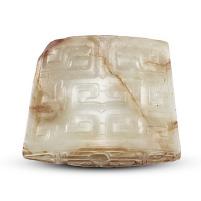
Expert remark: Compare the related form and depiction of a chilong, though carved in a slightly different manner (and only to one side of the chape). Note the similar size (4.5 cm).
AUCTION RESULT COMPARISON
Type: Related
Auction: Sotheby’s Hong Kong, 30 November 2021, lot 459
Price: HKD 189,000 or approx. EUR 23,000 converted and adjusted for inflation at the time of writing
Description: A jade sword chape Late Eastern Zhou - Han dynasty
Expert remark: Compare the related form and the slightly larger similar size (5.2 cm).
Estimate EUR 3,000
Starting price EUR 1,500

41 22
Professor David Meredith Seares Watson, FRS FGS HFRSE LLD (1886-1973)
A RARE GREEN JADE TOOTHED ANIMAL MASK ORNAMENT, LATE HONGSHAN CULTURE

China, c. 4000-3000 BC. The well-polished stone is carved and pierced in the form of an animal mask, decorated with arched brows above circular eyes, and horns which are carved to the top of the curved protruding ears. The details of the face are carefully rendered with thick concave troughs and the bottom of the jade is carved with five teeth. The translucent stone of a deep green tone with russet, dark green, and icy white inclusions.
Provenance: French trade. Previously in an old private estate.
Condition: Very good condition with old wear, minuscule nibbling. Some distinct areas of decomposition and erosion around the edges, as expected from a jade which has been buried for several millennia. Superb naturally grown patina overall.
Weight: 91.6 g
Dimensions: Length 14 cm
Hongshan ‘toothed’ pendants are characterized by a stylized mask carved in the center and a row of double-pointed protrusions at the bottom that resemble the teeth of an animal: the central mask is flanked on both sides by flattened extensions with a straight incision at the center.
Literature comparison: Compare a jade mask ornament with closely related central design, in the collection of the National Palace Museum (acquisition no. gou yu 272) and illustrated in Art in Quest of Heaven and Truth - Chinese Jades through the Ages, Taipei, 2012, pl. 3-3-28. Compare also a related jade toothed mask ornament, Hongshan culture, in the collection of the Smithsonian Freer Gallery of Art, accession number F1991.52.
AUCTION RESULT COMPARISON
Type: Closely related
Auction: Christie’s Hong Kong, 28 November 2018, lot 2708
Price: HKD 1,750,000 or approx. EUR 232,000 converted and adjusted for inflation at the time of writing
Description: A very rare celadon jade toothed animal mask ornament, Hongshan culture, circa 4000-3000 BC
Expert remark: Note the size (12 cm) and compare the similarly decomposed areas along the edges
AUCTION RESULT COMPARISON
Type: Closely related
Auction: Christie’s Hong Kong, 29 November 2017, lot 2704
Price: HKD 10,900,000 or approx. EUR 1,472,000 converted and adjusted for inflation at the time of writing
Description: A very rare green jade toothed animal mask ornament, late Hongshan culture


Expert remark: Compare the closely related form and color of the jade. Note the slightly larger size (19.6 cm)
Estimate EUR 10,000
Starting price EUR 5,000
42 23

A GREEN JADE ‘HORSE-HOOF’ ORNAMENT, HONGSHAN CULTURE

China, c. 3500-2500 BC. The tubular form flaring towards the sloping top in the form of a horse hoof (mati), cut across at an oblique angle forming an arched profile to the rim, the narrower end pierced with two holes. The translucent stone of a variegated green and light brown color with darker speckles and russet veining.
Provenance: From the collection of Paolo Bertuzzi. Paolo Bertuzzi (1943-2022) was a fashion stylist from Bologna, Italy. He was the son of Enrichetta Bertuzzi, founder of Hettabretz, a noted Italian fashion company with customers such as the Rothschild family, Audrey Hepburn, and Elizabeth Taylor. Paolo Bertuzzi later took over his mother’s business and designed exclusive pieces, some of which were exhibited in the Costume Institute of the Metropolitan Museum in New York, USA. He was also an avid collector of antiques for more than 60 years. His collection includes both archaic and contemporary art, and he edited two important books about Asian art, Goa Made - An Archaeological Discovery, about a large-scale archaeological project carried out with the Italian and Indonesian governments, and Majapahit, Masterpieces from a Forgotten Kingdom.
Condition: Excellent condition with minor wear, few minuscule nibbles to the edges, the upper and lower rim uneven, the stone with few natural fissures, some of which may have developed into small hairline cracks over time.
Weight: 264.6 g
Dimensions: Height 12.9 cm
Large jade ornaments of this specific form were a product of the Hongshan culture, and examples have been recovered at the Niuheliang burial site in Liaoning province. While generally referred to as headpieces, Jenny F. So has recently suggested that they may have been worn on the forearm to protect the arm and wrist (Jenny F. So, Early Chinese Jades in the Harvard Art Museums, Cambridge, 2019, page 74). She cites an example worn on the forearm of the occupant of Site III at Niuheliang, and another recovered from the Bronze Age burial site at Dadianzi, in present-day inner Mongolia.
AUCTION RESULT COMPARISON
Type: Related
Auction: Bonhams Los Angeles, 21 June 2022, lot 30
Price: USD 7,650 or approx. EUR 7,400 converted at the time of writing

Description: A yellowish-celadon jade hoofshaped ornament, Neolithic period, Hongshan culture
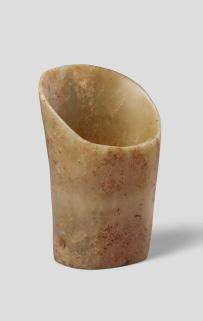
Expert remark: Compare the related plain form. Note the smaller size (8.6 cm) and yellowishceladon color.
Estimate EUR 3,000
Starting price EUR 1,500
44 24
Paolo Bertuzzi (1943-2022)
A CELADON AND RUSSET YELLOW JADE ‘BIRD’ AMULET, HONGSHAN CULTURE

China, c. 3500-3000 BC. Of flattened form, carved with protruding round eyes and proud chest, the outstretched wings subtly detailed with grooves and ridges simulating feathers. The reverse pierced with an aperture for suspension. The translucent stone of a striking yellow and pale celadon color with icy white inclusions and russet patches and veins.
Provenance: From the collection of Paolo Bertuzzi, by repute acquired in the European trade ca. 1990. Paolo Bertuzzi (1943-2022) was a fashion stylist from Bologna, Italy. He was the son of Enrichetta Bertuzzi, founder of Hettabretz, a noted Italian fashion company with customers such as the Rothschild family, Audrey Hepburn, and Elizabeth Taylor. Paolo Bertuzzi later took over his mother’s business and designed exclusive pieces, some of which were exhibited in the Costume Institute of the Metropolitan Museum in New York, USA.
He was also an avid collector of antiques for more than 60 years. His collection includes both archaic and contemporary art, and he edited two important books about Asian art, Goa Made - An Archaeological Discovery, about a large-scale archaeological project carried out with the Italian and Indonesian governments, and Majapahit, Masterpieces from a Forgotten Kingdom.
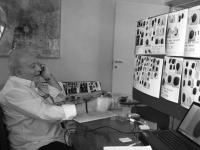
Condition: Very good condition with expected old wear, few small nicks, some chips and obvious losses which have smoothened over time. The stone with natural fissures which may have developed into hairlines over time. Fine, unctuous patina.
Weight: 36.1 g
Dimensions: Height 4.6 cm
AUCTION RESULT COMPARISON
Type: Closely related
Auction: Sotheby’s New York, 19 May 2019, lot 144
Price: USD 32,500 or approx. EUR 37,000 converted and adjusted for inflation at the time of writing
Description: A green jade bird-form amulet, Neolithic period, Hongshan culture

Expert remark: Compare the closely related form. Note the size (3 cm).
AUCTION RESULT COMPARISON
Type: Closely related
Auction: Sotheby’s Hong Kong, 22 May 2020, lot 5123
Price: HKD 50,000 or approx. EUR 6,400 converted and adjusted for inflation at the time of writing
Description: A celadon jade ‘bird’ amulet, Neolithic period, Hongshan culture

Expert remark: Compare the closely related form and size (4.3 cm)
Estimate EUR 3,000
Starting price EUR 1,500
45 25
Paolo Bertuzzi working on one of his books, Goa Made. An Archaeological Discovery
A THREE-TIERED WHITE AND RUSSET JADE CONG, LATE LIANGZHU CULTURE
China, c. 2600-2300 BC. Of square section, each corner worked with three registers of stylized animal masks, the four corners divided by gently recessed vertical bands to the center of each side. The originally opaque white jade now of a white, creamy beige and reddish-black tone with numerous dark veins, scattered speckles and russet patches.
Provenance: Daniel Milano, Paris, 2002. Paolo Bertuzzi, acquired from the above. A copy of the original invoice from D. Milano, dated 20 October 2002, describing the present lot as a Jade Cong from the Liangzhu culture, and stating a purchase price of EUR 9,500 or approx. EUR 14,000 (adjusted for inflation at the time of writing), accompanies this lot. Paolo Bertuzzi (1943-2022) was a fashion stylist from Bologna, Italy, and the son of Enrichetta Bertuzzi, founder of Hettabretz, a noted Italian fashion company with customers such as the Rothschild family, Audrey Hepburn, and Elizabeth Taylor. Paolo Bertuzzi later took over his mother’s business and designed exclusive pieces, some of which were exhibited in the Costume Institute of the Metropolitan Museum in New York, USA. He was also an avid collector of antiques for more than 60 years. His collection includes both archaic and contemporary art, and he edited two important books about Asian art, Goa Made - An Archaeological Discovery, about a largescale archaeological project carried out with the Italian and Indonesian governments, and Majapahit, Masterpieces from a Forgotten Kingdom.
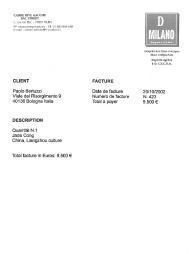
Condition: Condition overall commensurate with age, with extensive weathering, erosion and associated losses, areas of calcification and alteration, smoothened chips, and natural fissures, some of which have developed into cracks over time. Displays magnificently, with the colors of the jade in remarkable natural harmony.
Weight: 230 g
Dimensions: Height 8.2 cm
The present jade displays the distinctive characteristics of cong vessels from the Liangzhu culture, with a square outer section around a circular inner tube, decorated with stylized masks neatly arranged on each of the four corners.
AUCTION RESULT COMPARISON
Type: Related
Auction: Christie’s Hong Kong, 29 November 2017, lot 2710
Price: HKD 8,500,000 or approx. EUR 1,138,000 converted and adjusted for inflation at the time of writing
Description: An exceedingly rare nine-tiered jade cong, late Liangzhu culture, circa 2600-2300
Expert remark: While this cong is larger (23.5 cm) than the present lot, the stylized masks are less rudimentarily carved. The similar colors of the stone and especially the closely related marks of weathering and erosion indicate that this example and the present lot may have been excavated not far away from each other.
AUCTION RESULT COMPARISON
Type: Related
Auction: Christie’s Hong Kong, 27 November 2019, lot 2721
Price: HKD 275,000 or approx. EUR 35,500 converted and adjusted for inflation at the time of writing
Description: A fragment of a green jade cong, Liangzhu culture, circa 3300-2300 BC
Expert remark: Compare the related signs of weathering and erosion. Note the smaller size (5.5 cm) and that this cong is only a fragment.
AUCTION RESULT COMPARISON
Type: Related
Auction: Christie’s New York, 25 September 2020
Price: USD 8,125 or approx. EUR 9,100 converted and adjusted for inflation at the time of writing

Description: A mottled opaque jade or hardstone four-tier cong, Neolithic Period, Liangzhu Culture, 3rd millennium BC
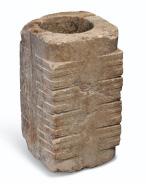
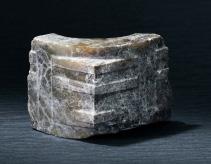

Expert remark: Compare the related decoration. Note the slightly larger size (12.8 cm), the related signs of weathering and erosion, and the description of the material as “jade or hardstone”.
Estimate EUR 6,000
Starting price EUR 3,000
46 26
Paolo Bertuzzi (1943-2022)

A PALE
CELADON AND RUSSET JADE ‘BIRD’ PENDANT, LATE SHANG DYNASTY
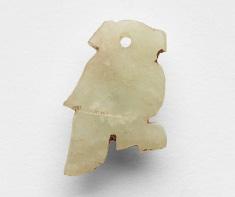
China, 1300-1050 BC. The flat stone worked in the form of a bird in profile, perched on its claws, with a distinct round beak pierced with a circular aperture for suspension, the head surmounted by a crest, and finely incised with plumage. The semi translucent stone of pale celadon color with russet inclusions and areas of white calcification.
Provenance: From the collection of Dr. Wou Kiuan. Wou Lien-Pai Museum, coll. no. E.3.21A-H. Dr. Wou Kiuan (1910-1997) was a Chinese diplomat and noted scholar of Chinese art. His father, Wou Lien-Pai (1873-1944), was one the leading political figures of early 20th century China, remembered for his role as speaker and leader of parliament during the turbulent years of the Republican era. Dr. Wou himself embarked on an illustrious career in diplomacy until his retirement in 1952, when he settled in London and devoted the rest of his life to the study of Chinese art. It was no doubt fortuitous that Dr. Wou’s years of collecting coincided with an abundant availability of exceptional Chinese art on the London market. From the mid-1950s to the late 1960s he was able to form a collection of well over 1,000 works that together represented virtually every category of Chinese art. At the heart of Dr. Wou’s drive to collect was a burning desire to preserve the relics of China’s rich historical past scattered across Europe, and to promote Chinese art and culture. It is unclear when Dr. Wou conceived of the idea to create a place to house his collection, but in 1968 he opened the doors to the Wou Lien-Pai Museum, named in honor of his father. Over the years the Museum became a ‘must see’ destination for collectors, academics, and visiting dignitaries, and Dr. Wou would delight in leading his visitors through the galleries, recounting stories of China’s glorious history.

Condition: Very good condition with expected old wear and weathering, little nibbling, and minuscule chips.
Weight: 3.2 g
Dimensions: Height 2.7 cm
LITERATURE COMPARISON
Compare a related jade pendant of a bird, late Shang dynasty, 3.7 cm, in the Smithsonian Museum, accession number F1979.25.
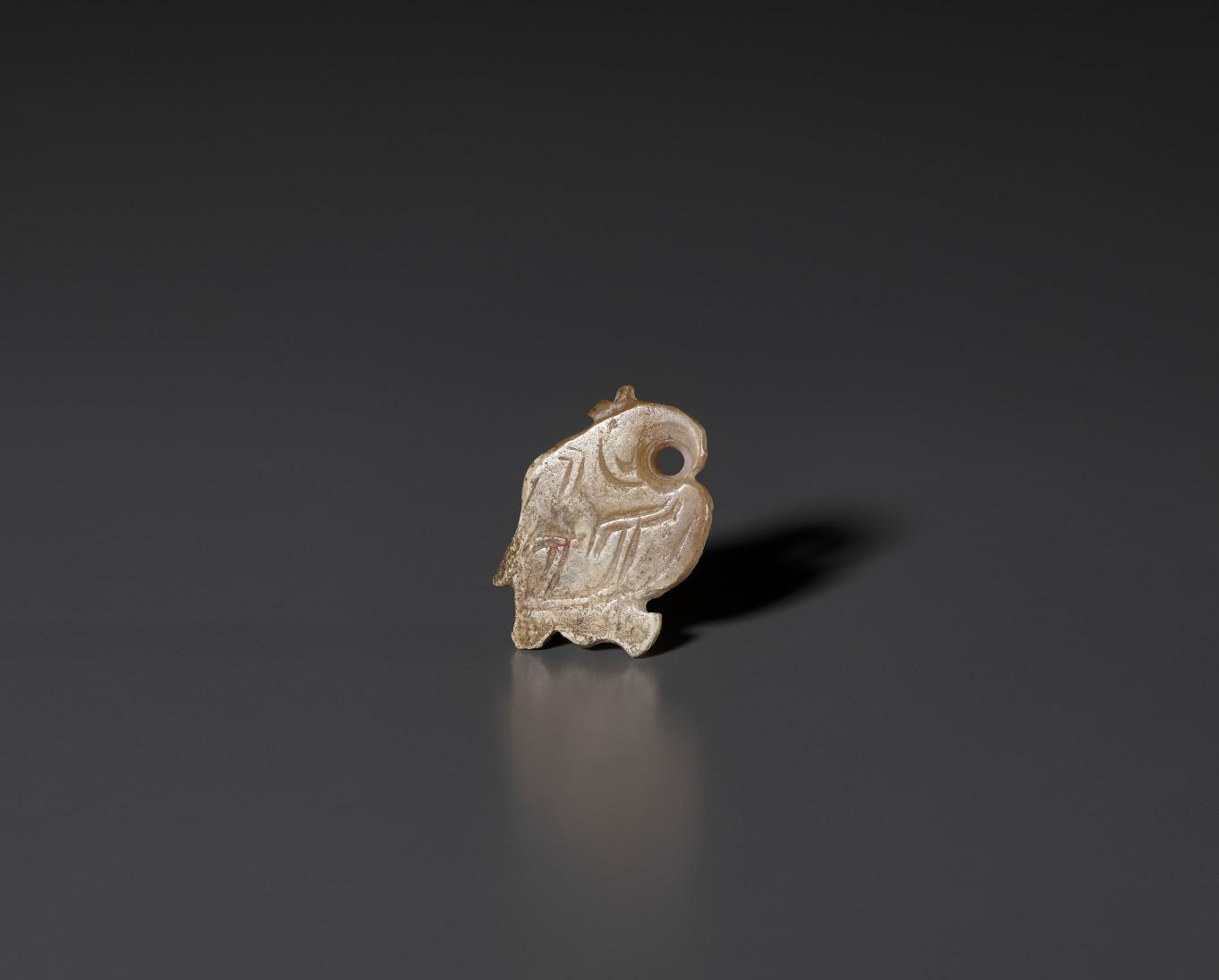
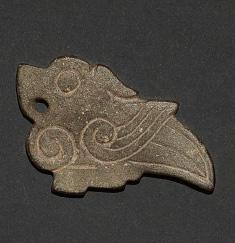
AUCTION RESULT COMPARISON
Type: Related
Auction: Sotheby’s New York, 22 September 2020, lot 248
Estimate: USD 8,000 or approx. EUR 8,700 converted and adjusted for inflation at the time of writing
Description: A calcified jade ‘bird’ pendant, Shang dynasty or later
Expert remark: Compare the related flat form, pierced beak, and incision work. Note the slightly larger size (3.7 cm) and different color of the stone. Also note that this lot is possibly of a later date.
Estimate EUR 3,000
Starting price EUR 1,500
48 27
Dr. Wou Kiuan, Paris, November 1939
A PALE CELADON JADE ‘HARE’ PENDANT, LATE SHANG TO WESTERN ZHOU DYNASTY
China, 1100-1000 BC. Depicted crouching with its feet tucked underneath, slightly protruding eyes beneath short ears, and pierced through the mouth for suspension. The translucent stone of a pale celadon tone with darker shadings and areas of white calcification.
Provenance: From the collection of Dr. Wou Kiuan. Wou Lien-Pai Museum, coll. no. E.3.21A-H. Dr. Wou Kiuan (1910-1997) was a Chinese diplomat and noted scholar of Chinese art. His father, Wou Lien-Pai (1873-1944), was one the leading political figures of early 20th century China, remembered for his role as speaker and leader of parliament during the turbulent years of the Republican era. Dr. Wou himself embarked on an illustrious career in diplomacy until his retirement in 1952, when he settled in London and devoted the rest of his life to the study of Chinese art. It was no doubt fortuitous that Dr. Wou’s years of collecting coincided with an abundant availability of exceptional Chinese art on the London market. From the mid-1950s to the late 1960s he was able to form a collection of well over 1,000 works that together represented virtually every category of Chinese art. At the heart of Dr. Wou’s drive to collect was a burning desire to preserve the relics of China’s rich historical past scattered across Europe, and to promote Chinese art and culture. It is unclear when Dr. Wou conceived of the idea to create a place to house his collection, but in 1968 he opened the doors to the Wou Lien-Pai Museum, named in honor of his father. Over the years the Museum became a ‘must see’ destination for collectors, academics, and visiting dignitaries, and Dr. Wou would delight in leading his visitors through the galleries, recounting stories of China’s glorious history.
Condition: Very good condition with expected old wear, some weathering, calcification and minuscule nibbling.
Weight: 6.7 g
Dimensions: Length 3.5 cm
LITERATURE COMPARISON
Compare a closely related jade pendant of a rabbit, late Shang dynasty to Western Zhou dynasty, 3.5 cm, in the Smithsonian Museum, accession number S2012.9.852. Compare two closely related rabbit-form pendants, dated to the late Shang dynasty, excavated from Tomb no. 2 at Jingjiecun, Lingshi, Shanxi Province, in the Shangxi Provincial Institute of Archeology, and illustrated in The Complete Collection of Jades Unearthed in China, vol. 3, Beijing, 2005, p. 62-63.
AUCTION RESULT COMPARISON
Type: Related
Auction: Sotheby’s Hong Kong, 3 December 2021, lot 840
Price: HKD 94,500 or approx. EUR 11,500 converted and adjusted for inflation at the time of writing
Description: An archaic jade ‘hare’ plaque, Shang dynasty

Expert remark: Compare the related form, pose, and manner of carving. Note the larger size (5.9 cm) and different color of the jade.
Auction result comparison:
Type: Related
Auction: Sotheby’s New York, 22 March 2022, lot 36
Price: USD 27,720 or approx. EUR 26,500 converted at the time of writing
Description: A small pale green jade hare-form pendant, Early Western Zhou dynasty

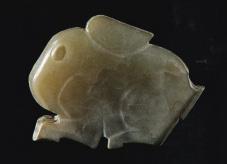

Expert remark: Compare the related flat form, pose, and simplistic carving style. Note the smaller size (2.5 cm) and different color of the jade.
Estimate EUR 4,000
Starting price EUR 2,000
49 28
A PALE CELADON JADE ‘FISH’ PENDANT, LATE SHANG TO WESTERN ZHOU DYNASTY
China, 1300-771 BC. Of flattened form, carved as a curved fish with rounded eyes, the long dorsal fin rising along the spine and two smaller fins extending from the belly, the mouth and tail pierced with a circular aperture for suspension. The semi-translucent stone of a pale celadon tone with areas of white calcification.
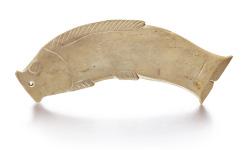
Provenance: From the collection of Dr. Wou Kiuan. Wou Lien-Pai Museum, coll. no. E.3.21A-H. Dr. Wou Kiuan (1910-1997) was a Chinese diplomat and noted scholar of Chinese art. His father, Wou Lien-Pai (1873-1944), was one the leading political figures of early 20th century China, remembered for his role as speaker and leader of parliament during the turbulent years of the Republican era. Dr. Wou himself embarked on an illustrious career in diplomacy until his retirement in 1952, when he settled in London and devoted the rest of his life to the study of Chinese art. It was no doubt fortuitous that Dr. Wou’s years of collecting coincided with an abundant availability of exceptional Chinese art on the London market. From the mid-1950s to the late 1960s he was able to form a collection of well over 1,000 works that together represented virtually every category of Chinese art. At the heart of Dr. Wou’s drive to collect was a burning desire to preserve the relics of China’s rich historical past scattered across Europe, and to promote Chinese art and culture. It is unclear when Dr. Wou conceived of the idea to create a place to house his collection, but in 1968 he opened the doors to the Wou Lien-Pai Museum, named in honor of his father. Over the years the Museum became a ‘must see’ destination for collectors, academics, and visiting dignitaries, and Dr. Wou would delight in leading his visitors through the galleries, recounting stories of China’s glorious history.
Condition: Very good condition with expected old wear, weathering and small nibbles.
Weight: 11.4 g
Dimensions: Length 8.2 cm
Literature comparison: Compare a related jade pendant of a fish, late Shang dynasty, 6.2 cm, in the Smithsonian Museum, accession number S1987.473. Also compare a related jade pendant of a fish, late Shang dynasty, 5.9 cm, in the Smithsonian Museum, accession number S1987.634.
AUCTION RESULT COMPARISON
Type: Closely related
Auction: Sotheby’s New York, 10 September 2019, lot 37
Price: USD 17,500 or approx. EUR 19,500 converted and adjusted for inflation at the time of writing
Description: A calcified jade ‘fish’ pendant, Shang - Western Zhou dynasty
Expert remark: Compare the related form, motif, similar color of the jade, and size (8.8 cm)
AUCTION RESULT COMPARISON
Type: Related
Auction: Christie’s Hong Kong, 30 November 2020, lot 2772
Price: HKD 250,000 or approx. EUR 31,000 converted and adjusted for inflation at the time of writing
Description: A jade fish-form pendant, Western Zhou dynasty

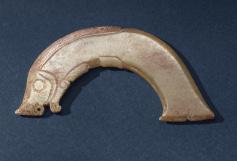
Expert remark: Compare the related form, motif, and size (9 cm). Note the different color of the stone.
Estimate EUR 4,000
Starting price EUR 2,000
50 29
A PALE GREEN JADE ‘DRAGON’ PENDANT, SHANG TO WESTERN ZHOU DYNASTY
China, 1300-1000 BC. Of flattened form, carved in the form of a dragon with open mouth and long tail. The translucent stone of a green tone with creamy white and russet speckles.
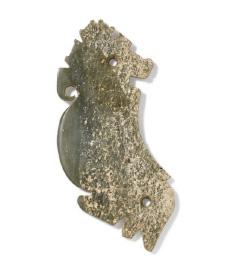
Provenance: From the collection of Dr. Wou Kiuan. Wou Lien-Pai Museum, coll. no. E.3.21A-H. Dr. Wou Kiuan (1910-1997) was a Chinese diplomat and noted scholar of Chinese art. His father, Wou Lien-Pai (1873-1944), was one the leading political figures of early 20th century China, remembered for his role as speaker and leader of parliament during the turbulent years of the Republican era. Dr. Wou himself embarked on an illustrious career in diplomacy until his retirement in 1952, when he settled in London and devoted the rest of his life to the study of Chinese art. It was no doubt fortuitous that Dr. Wou’s years of collecting coincided with an abundant availability of exceptional Chinese art on the London market. From the mid-1950s to the late 1960s he was able to form a collection of well over 1,000 works that together represented virtually every category of Chinese art. At the heart of Dr. Wou’s drive to collect was a burning desire to preserve the relics of China’s rich historical past scattered across Europe, and to promote Chinese art and culture. It is unclear when Dr. Wou conceived of the idea to create a place to house his collection, but in 1968 he opened the doors to the Wou Lien-Pai Museum, named in honor of his father. Over the years the Museum became a ‘must see’ destination for collectors, academics, and visiting dignitaries, and Dr. Wou would delight in leading his visitors through the galleries, recounting stories of China’s glorious history.
Weight: 10.3 g
Dr. Wou Kiuan, Paris, November 1939

Dimensions: Length 8.4 cm
Small pendants in the form of animals form a major category of jades in the Shang period and can be found in many of the major burials of highranking individuals.
Expert’s note: The carving is unfinished on both sides, with only a small slit defining the opening of the mouth. For a similarly unfinished jade pendant, see Sotheby’s London, 3 November 2021, lot 126.

Condition: Very good condition with expected old wear and weathering, little nibbling, few nicks, and light scratches.
Estimate EUR 3,000
Starting price EUR 1,500
51 30
A RUSSET AND BROWN JADE NOTCHED DISC, XUANJI, LATE NEOLITHIC TO SHANG DYNASTY


Published: Friedrich Georg Zeileis, Ausgewählte Chinesische Jade aus Sieben Jahrtausenden (selected Chinese jades from seven millennia), 1994, pages 80-81, no. 64.


China, c. 3000-1000 BC. The exterior rim carved as three arcs, each rising to a point and carved with raised teeth, the interior with a plain circle. The stone of a beautiful russet and honey-brown tone with dark veins.
Provenance: A private collection in San Francisco, USA, 1980s. Friedrich Georg Zeileis, acquired from the above. Dr. Friedrich Georg Zeileis (b. 1939) is a retired physician who built an important collection of ancient Chinese jades and bronzes. He was also a pianist and composer, and published several books, as well as catalogs of his substantial art collections, including fine Chinese jades and bronzes. Condition: Condition commensurate with age. Old wear and tiny nibbles. The stone with natural fissures, some of which have developed into small cracks over time, with associated old fills.
Weight: 58.8 g
Dimensions: Diameter 9.7 cm (at the widest points)
Literature comparison: Compare a related jade xuanji, 11.3 cm wide, dated Neolithic or Shang, 15th-10th century BC, in the British Museum, registration number 2022,3034.82, illustrated by Jessica Rawson, Chinese Jade from the Neolithic to the Qing, 1995, cat. no. 8.1. Compare a related jade xuanji, 13.9 cm diameter, dated to the Shandong or Henan Longshan culture, c. 2300-1700 BC, in the Museum of East Asian Art, Bath, record number 589. Compare a related jade notched disc, 15.6 cm diameter, in the Metropolitan Museum of Art, accession number 27.15.
AUCTION RESULT COMPARISON
Type: Closely related
Auction: Sotheby’s New York, 18 March 2014, lot 123

Price: USD 75,000 or approx. EUR 85,500 converted and adjusted for inflation at the time of writing
Description: A jade ritual notched disc (xuanji), Neolithic period

Expert remark: Note the significantly larger size (18.5 cm)
AUCTION RESULT COMPARISON
Type: Closely related
Auction: Christie’s New York, 23 September 2022, lot 822
Price: USD 18,900 or approx. EUR 17,500 converted and adjusted for inflation at the time of writing
Description: A rare pale green and beigishbrown jade notched disc, Northwest China, late Neolithic period-early Bronze Age, 3rd-2nd millennium BC

Expert remark: Note the similar size (11.5 cm)
AUCTION RESULT COMPARISON
Type: Closely related
Auction: Christie’s Hong Kong, 28 November 2018, lot 2709
Price: HKD 1,000.000 or approx. EUR 137,500 converted and adjusted for inflation at the time of writing
Description: A Celadon Jade Notched Disc, Yabi Expert remark: Note the slightly larger size (13 cm)
Estimate EUR 6,000
Starting price EUR 3,000
52 31
AN ARCHAIC YELLOW & RUSSET JADE DRAGON PENDANT, EASTERN ZHOU DYNASTY


Opinion: The quality of this example is perhaps most visible when images of the right and left sides are viewed simultaneously, because only then it becomes apparent how much care was given by the craftsman to ensure that the spiral c-scroll clouds were laid out in an identical fashion. The quality is further personified by the rare color of the jade and the magnificent polish.
China, 6th-4th century BC. Carved in the form of a sinuous dragon, with head turned looking back, the s-shaped body with spirals carved in relief. The translucent stone of a fine yellow tone with russet shadings at the edges.
Provenance: Collection of Pierre Lallier. Pierre Lallier (1946-2021) was a master printer, having run the famous Atelier Georges Leblanc since 1968. He was also a passionate scholar and committed private collector, spending nearly half a century of his life building his private collection. He started at the age of 12, perusing the Parisian flea markets with his father, extensively researching every piece of interest, while also confirming its dating and provenance. He loved his objects, cherished them, and never wanted to part with them. Condition: Very good condition with minor wear, few minuscule nicks, some of which have smoothened over time. Natural inclusions and fissures.
Weight: 21.9 g
Dimensions: Length 8 cm
Jade, known as the ‘Stone of Heaven’, represents wisdom, beauty, courage, and perfection. This combined with the powerful iconography of the dragon, creates a strong symbol of luck and good fortune. Jades in this form have a long tradition of being used as ritualistic objects, in particular tokens of rank and symbolic aids for the celestial journey thought to be undertaken by the dead. In the Zhou dynasty, the number of ritualistic jades increased significantly in burial sites, as multiple plaques, pendants, and beads were draped over the face and body of the deceased.
Literature comparison: Refer to Michael Gulbenkian’s article Archaic Jades, Arts of Asia, May-June 1983, where the carved c-scroll cloud motif is used as a methodology to date archaic jades.

AUCTION RESULT COMPARISON
Type: Closely related
Auction: Christie’s Hong Kong, 30 May 2017, lot 2719
Price: HKD 1,860,000 or approx. EUR 239,000 converted and adjusted for inflation at the time of writing.
Description: A white jade dragon-form pendant, Warring States period (475-221 BC)
Expert remark: This comparable shows another iteration of the same design. Particular attention should be paid to the depiction of the lower jaw and snout of the dragon as they are executed in the same manner. While the primary color of the stone is of a different hue, the Christie’s pendant also has an attractive russet tinge around the outer edges, possibly signifying that both these ‘pendants’ were carved from pebbles just slightly larger than their finished size.
AUCTION RESULT COMPARISON
Type: Closely related
Auction: Christie’s Hong Kong, 2 December 2021, lot 2702
Price: HKD 687,500 or approx. EUR 82,500 converted and adjusted for inflation at the time of writing.
Description: A group of three jade dragon form pendants, late Spring and Autumn period, circa 570-476 BC

Expert remark: The first pendant in the lot is part of a closely related group of archaic jades that includes our pendant. While the color of the chosen stone is just as attractive, there is a clear demarcation between the two pieces. Christie’s carving is clearly a work of art, but it is not accompanied by the same level of quality or beauty as our pendant. It is also worth noting the placement and number of suspension apertures on each of the three Christie’s pendants. Looking at the multiple examples simultaneously shows that these are later-added features, as they are either off-center or through part of the carved design, and so these features should not be taken into account when assessing such ‘pendants’ as this was not their original function.
Estimate EUR 8,000
Starting price EUR 4,000
32
Pierre Lallier (1946-2021)
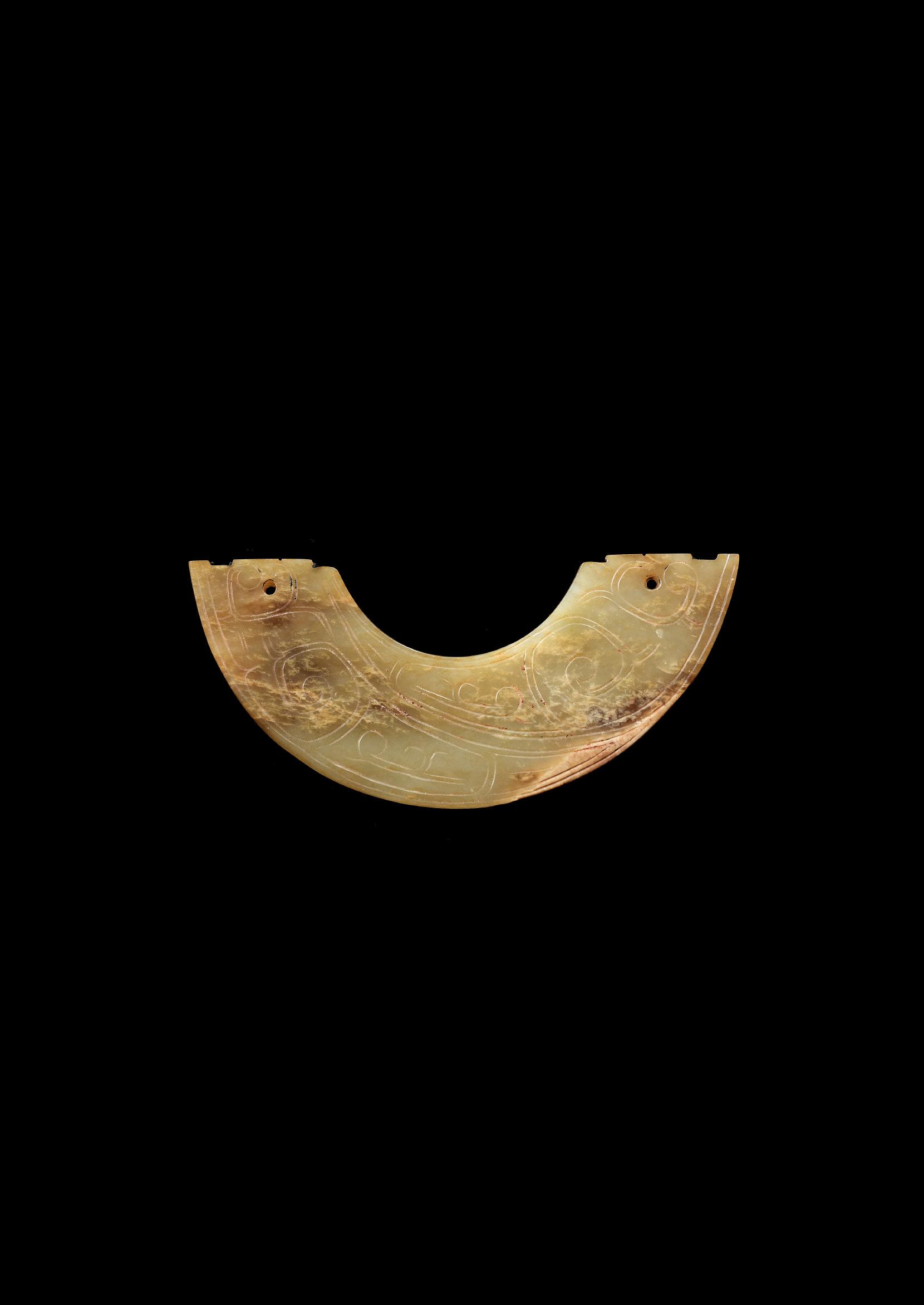
A YELLOW JADE ‘DOUBLE DRAGON’ PENDANT, HUANG, WESTERN ZHOU DYNASTY
China, c. 1100-771 BC. The arc-shaped huang is carved on one side with a stylized motif that represents the dragon’s body and legs, terminating at each end with an abstract dragon head. Two small holes are drilled for suspension. The translucent stone of a superb yellow color with brown shadings, russet veins, and small areas of opaque calcification.

Provenance: Wiltshire, United Kingdom, local trade. By repute acquired from a private estate.
Condition: Very good condition with expected old wear and traces of use, tiny nibbles to edges, remnants of pigment, one smoothened area to the upper edge.
Weight: 30.7 g
Dimensions: Length 11.9 cm
Literature comparison: The dragon on the current huang was a common design during the mid-Western Zhou Dynasty. Compare a similarly decorated jade huang, excavated from the Rui State tomb, illustrated in Selected Bronze, Jade and Gold Treasures from the Rui State of Early Spring and Autumn Period, Xian, 2007, no. 16, pp. 68-69. Compare a related huang, 7.5 cm long, excavated from Tomb no. 49 at the burial site of Shangguo, Wenxi, in the Shanxi Provincial Museum, illustrated in The Complete Collection of Jades Unearthed in China, vol. 3, Beijing, 2005, p. 159. Compare a related huang, 7.3 cm long, excavated from Tomb no. 31 in the Necropolis of the Marquis of Jin State, Quwo, in the Shanxi Provincial Institute of Archeology, illustrated in The Complete Collection of Jades Unearthed in China, vol. 3, Beijing, 2005, p. 101.
AUCTION RESULT COMPARISON
Type: Closely related
Auction: Sotheby’s Hong Kong, 29 November 2018, lot 4
Price: HKD 225,000 or approx. EUR 29,500 converted and adjusted for inflation at the time of writing
Description: An archaistic yellowish-celadon jade pendant, huang, Han dynasty or earlier


Expert remark: Compare the closely related form and carving. Note the slightly smaller size (9.4 cm) and the paler color of the jade. Also note that the dating “Han dynasty or earlier” was somewhat overruled by the market, the hammer price far exceeding the original estimate of HKD 20,000-30,000.
AUCTION RESULT COMPARISON
Type: Closely related
Auction: Sotheby’s London, 6 November 2019, lot 215
Price: GBP 32,500 or approx. EUR 42,500 converted and adjusted for inflation at the time of writing
Description: A Celadon Jade Pendant, Huang, Western Zhou Dynasty Expert remark: Compare the closely related form and carving. Note the slightly smaller size (10.8 cm) and the pale celadon color of the jade.
AUCTION RESULT COMPARISON
Type: Closely related
Auction: Christie’s Hong Kong, 28 November 2018, lot 2741
Price: HKD 437,500 or approx. EUR 62,500 converted and adjusted for inflation at the time of writing
Description: A Celadon Jade ‘Dragon’ Pendant, Huang, Mid-Western Zhou Dynasty

Expert remark: Compare the closely related form, the carving and the near-identical size (11.3 cm). Note the pale celadon color of the jade.
Estimate EUR 12,000
Starting price EUR 6,000
55 33
A RARE, LARGE AND POWERFUL JADE FIGURE OF A BIXIE, MID-WESTERN HAN DYNASTYEARLY SIX DYNASTIES PERIOD
Expert’s note: The magnificent polish and remarkably unctuous feel overall are a distinctive testimony of many centuries of passionate handling, indicating that this piece may either be a rare heirloom example, or at the least was only buried for a rather short period, and thence handed down from generation to generation of respectful keepers.
China, c. 100 BC to 400 AD. Powerfully carved in a prowling pose with the legs and the right haunch tucked under the body and the left extended backward, rigorously pushing the winged body forward. The face with bulging eyes below thick brows and a pair of curved horns, the pierced mouth baring teeth above the distinct goat beard. The body neatly incised with wings, fur markings, and scroll motifs. The softly polished translucent stone is of a pale green and creamy russetbrown tone with distinct chestnut inclusions and russet veining.
Provenance: The personal collection of Robert Rousset, acquired before 1935. Thence by descent to Jean-Pierre Rousset. The underside with an old label, ‘C. 1085’. Robert Rousset was a former French radio officer in the merchant navy, who became one of the most prominent pioneers of the Chinese art market in Paris. As a child, his father, an insurance agent, would take him to Hôtel Drouot where he started to buy at a very young age. His true passion for Asian art started in the 1920s, when he was sent on a mission to Beijing after the decline of the Qing empire, along with Osvald Sirén, the famous Swedish Asian art historian and connoisseur. He then became one of the main contributors of Chinese antiques for the Compagnie de la Chine et des Indes, founded in Paris in the early 20th century by the Blazy brothers. After the 1929 stock market crash, he had the opportunity to acquire the company. With his sister Suzanne in charge of the porcelain, they developed the business and became one of the most important dealers in France, selling pieces to the greatest museums, including the Musée Guimet and the Metropolitan Museum of Art. With no children of his own, Robert took his nephew Jean-Pierre (1936-2021) under his wing and began grooming him to eventually take over the gallery. He loved to wander with Jean-Pierre through the gallery’s exhibitions and storerooms, telling stories about each piece while cultivating his protégé’s eye. Jean-Pierre was also sent by his uncle to train with the great expert in Asian art and Robert’s close friend, Michel Beurdeley, whose numerous publications are still commonly referenced today. When Robert passed away, his private collection was divided between Jean-Pierre and his sister, Anne-Marie, whose part was sold with great success after her death in 2019.
Condition: Good condition with minor wear, few tiny nicks and light scratches. A small section of the tail has been reattached. The stone with natural inclusions and fissures, some of which may have developed into small hairline cracks over time.
Export License: A French certificat d’exportation pour un bien culturel, document Nr. 233778, dated 31 May 2022, has been granted by the French government. A copy of the document accompanies this lot.
Weight: 183.4 g
Dimensions: Length 10 cm
Moving away from the highly stylized depictions of animals in the Shang and Zhou dynasties, artisans of the early Western Han Dynasty through to the early Six Dynasties period continuously developed a more naturalistic approach to representing animals. This aesthetic was applied to images of both real and mythical creatures, and across artistic mediums. At the same time, lapidary arts flourished, and jade animals of unprecedentedly high quality started to be carved. The present bixie is a superb example of the sculptural practices of the period, and the era’s enthusiasm for miraculous creatures that were believed to possess supernatural power.
Pixiu are mythical hybrid creatures, considered powerful protectors, resembling strong, winged tigers or lions, auspicious for wealth, and said to have a voracious appetite exclusively for gold, silver, and jewels. Therefore, Pixiu have always been regarded as being capable of drawing cai qi (wealth) from all directions, and according to the Chinese zodiac, they are especially helpful for those who are going through a bad year. There are two types of Pixiu: The one with two horns is the female, called Bixie. The one with only one antler is the male, called Tianlu.
Emperor Wu of the Han dynasty declared that the pixiu would be forever known as the ‘Treasure of the Emperor’, that only royal personage could possess a pixiu, and that it was strictly forbidden for all others to own one, including officials. This law was kept through to the very end of the Qing dynasty. Lifelike sculptures of these mythical beings made from durable materials, such as jade, were made to embody and pacify the elemental and supernatural forces of the living world.
Winged beasts in general (lion, tiger, deer, ram, eagle… etc.) are a popular and enduring subject in ancient Chinese works of art, and exist in many different forms (as a decorative pattern, flat carving or carving in the round). The most eye-catching amongst them are carvings of bixie in the round. The term bixie first appeared in Jijiupian by Shi You in the Western Han period: ‘Sheji, bixie are both names of mythical beasts… bixie means ‘warding off the wicked’. It is said that jade pendants in the form of these two beasts can help prevent adversity and provide protection.’
The iconography of the bixie is closely associated with that of the griffin, popular in the Western Asia and Eurasia steppes, and originated in Mesopotamia in 3000 B.C. Bixie occupies a curious position in Chinese art. It is based on the imagery of a lion, a foreign animal, but has the spirit of a fierce tiger. It is often depicted alongside other exotic animals as artistic backdrops for monumental architectures, especially in the Han dynasty where palaces, temples, shrines and tombs were often decorated with large scale bronze or stone sculptures of Weng Zhong, qilin, tianlu, elephants, camels or horses. Bixie is an important component amongst the array that makes up this subject matter.
Jade bixie carvings in the round are extremely rare and precious There are two jade bixie excavated in the Weiling tomb in Xianyang, Shaanxi province: one is striding upright, with two horns curling backwards along the head (fig. 1), the other is crouching with its head down, with two horns growing closely alongside and bifurcating at the tip (fig. 2). There is an Eastern Han jade bixie (fig. 3) in the Taipei Palace Museum with a long snout resembling either a dragon or a horse, unlike the more common tiger-like bixie with shorter snouts, and closely resembles the griffin of Western Asia. Amongst the very few excavated and heirloom examples of jade bixie, the two examples from the Weiling tomb are dated the earliest, indicating that the production of these bixie carvings in the round began as early as the mid-Western Han dynasty. Although none of the bixie carvings from the Two Han dynasties appear identical to one another, they share these characteristics: Double or single-horned, with lion or tiger head and body, goat beard and bird wings. They are also extremely fierce, powerful in musculature, gallant in stature, carved in the round and decorated with incised decoration, shallow relief, high relief and pierced decoration in precise and neat wheel cuts
Although jade bixie have heads like a lion or a tiger, it is the tiger that most embodies its essence. In the Three Kingdoms period, Zhuge Liang in his military strategy coined the now well-known term ‘like a tiger added with wings’ to describe a general that excels at deploying his troops. The origin of this phrase can be found in his anthology Zhuge Zhongwuhou wenji, juan 4, edited by Zhang Shu (1781-1847): “Military command is the mandate to lead the three armies, and the authority of the chief commander. A general who has the command of the army and knows the essence of troop deployment to gain the upper hand, is like a fierce tiger that has been given wings and able to travel the four seas, to apply force when he sees fit.”
Zhuge Liang’s description of an able general as ‘a tiger added with wings’ is the Han dynasty jade bixie personified.
Estimate EUR 40,000
Starting price EUR 20,000

56 34
Robert Rousset (1901-1982)
AUCTION RESULT COMPARISON
Type: Closely related
Auction: Sotheby’s New York, 21 September 2021, lot 46
Price: USD 107,100 or approx. EUR 107,000 converted and adjusted for inflation at the time of writing
Description: A beige and russet jade bixie, Han - Six Dynasties
Expert remark: Compare the closely related subject, pose, manner of carving, and russet veining. Note the beige color and much smaller size (7 cm).
AUCTION RESULT COMPARISON
Type: Related
Auction: Sotheby’s New York, 27 September 2021, lot 524
Price: USD 746,000 or approx. EUR 741,000 converted and adjusted for inflation at the time of writing
Description: A beige and brown jade figure of a bixie, Ming dynasty or later
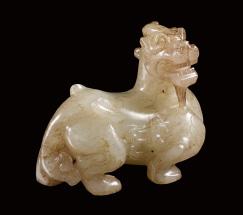

Expert remark: Compare the closely related subject, the similar pose and manner of carving. Note the different color of the jade and larger size (12 cm). Also note the original estimate of USD 8,000-12,000 and the market’s rather unambiguous response to the conservative dating of this lot.
AUCTION RESULT COMPARISON
Type: Related
Auction: Sotheby’s Hong Kong, 9 October 2020, lot 40
Price: HKD 2,142.000 or approx. EUR 285,000 converted and adjusted for inflation at the time of writing
Description: A Rare Celadon Jade Figure of a Bixie, Eastern Han Dynasty
Expert remark: Compare the closely related subject, the related pose and manner of carving. Note the different color of the jade and much smaller size (4.8 cm).
AUCTION RESULT COMPARISON
Type: Related
Auction: Christie’s Hong Kong, 29 November 2022, lot 2748
Price: HKD 26,850.000 or approx. EUR 3,170,000 converted and adjusted for inflation at the time of writing
Description: An Exceedingly Rare and Exceptional Jade Carving of a Mythical Beast, Bixie, Late Western Han Dynasty, c. 1st Century BC

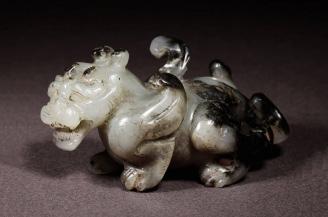
Expert remark: Compare the related carving and subject. Note the different color and smaller size (7.2 cm).
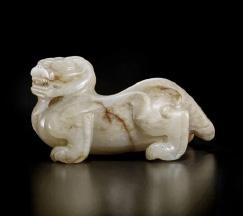
57
AN EXCEPTIONAL CREAMY-WHITE AND BLACK JADE FIGURE OF A BEAR, SONG DYNASTY OR EARLIER

China, 960-1279 or earlier. Powerfully and sensitively carved. The mighty yet gentle animal seated with the knees and elbows bent, the hands resting on the legs, the lowered head slightly turned to the left, evoking a pensive state of mind. The body with slightly drooping chest and rotund belly. The lower legs are accented with a neatly incised scroll below each knee, while the clawed paws and short tail are finely incised as well. The face is well detailed with almond-shaped eyes, a long muzzle and snout, thin lips framing rows of teeth, and subtle fur markings incised to the ruff.
Provenance: From the private collection of Adrianus Verhelst, Netherlands. Adrianus Cornelis Maria Verhelst (b. 1955) is a retired Dutch entrepreneur and manager, stemming from the Verhelst family, who served as a director of Verlascon Management, a noted financial holding company based in Roosendaal, Netherlands. He was a passionate and discerning collector of Chinese and Buddhist art, displaying some of his pieces prominently across the family properties in the Netherlands, Belgium, and England.
Condition: Very good condition commensurate with age, showing old wear, microscopic nicks here and there, few small areas with minuscule age-related losses, smoothened over time. The stone with natural fissures, some of which have developed into small hairline cracks over time, consistent with jade figures dating from the Song dynasty. The stone with a smooth, unctuous feel overall, the result of centuries of gentle handling.
Weight: 237.3 g
Dimensions: Height 7.5 cm, Width 6 cm
The superbly polished, translucent stone is of a creamy white, somewhat yellowish tone with brownish-black shadings ingeniously incorporated into the carving, as well as russet and black veins, and cloudy inclusions.
The bear has been a popular totemic emblem in China since ancient times. China’s foundation myths hold that the legendary Yellow Emperor, or Huang Di, early on lived with his tribe in the northwest, presumably in modern Shanxi Province, but then later migrated to Zhuolu, in present-day Hebei Province, where he became a farmer and tamed six different types of ferocious beasts, including the bear, or xiong, with which the Yellow emperor ever since has been linked. According to legend, Gun – said to have been the great-grandson of the Yellow emperor and the father of Yu the Great, or Da Yu – stole a special soil with which he planned to build dikes in an attempt to control the Yellow River’s constantly recurring and very devastating floods. He failed in his mission, however, and, as punishment for his theft, was killed by Zhurong, the God of Fire. Gun’s corpse turned into a yellow bear, or huangxiong, and jumped into a pool. A while later, a golden bear, alternatively said to be a golden dragon, emerged from the corpse’s stomach and ascended into heaven, where the Yellow Emperor instructed it to complete his father’s work in taming the Yellow River’s waters. That bear turned out to be Da Yu, who – according to popular belief – heroically controlled the floods and became the mythological forefather of China’s Xia dynasty. Therefore, the bear has been prominently associated with legendary rulers and Chinese national foundation myths since the earliest times.
58 35
Bears are native to China, their presence there known since antiquity. They were kept in Han imperial zoos and parks, where the emperor and his entourage enjoyed watching them in performance or in combat with other animals. On the other hand, they were perceived as enlightened creatures and it was believed that they resided in spiritual mountains and possessed the ability to intermediate between heaven and earth. Bears have also been linked with military prowess, shamanism, and immortality. As a corollary, it might be noted that the words for ‘bear’ and ‘virility’ are exact homonyms, pronounced xiong. According to the ‘Rites of Zhou’, Zhou Li, edited during the Han dynasty, bears were employed in exorcism rituals, their skin worn over the head of the performer who, holding a lance and a shield, led the officials to perform the Seasonal Exorcism by searching through houses and driving away pestilences. See J. Lagerway, Early Chinese Religion. Part One. Shang through Han (1250 BC-220 AD), Boston, 2008, page 287.
In ancient China, immortality was often considered the ultimate pursuit for royalty. The First Emperor who united the country in 221 BC is known to have sent expeditions into the eastern sea in search of Penglai, a mountainous island shrouded in a mysterious cloud, which at the time was believed to be the home of immortals, where elixirs of immortality could be retrieved. Once every 99th year, an immortal from this mysterious island would descend to the earthly realm and bestow immortality upon a select few. These immortals were believed to take the form of carved jade animals, for example bears.
Jade was the only material in which these mythological epitomes were believed to exist. This conviction is probably due to the near-indestructible quality of the mineral, which would make such a carving outlive every human being. When inhabited by an immortal, the jade would have looked almost fully translucent, especially when held against strong moonlight. According to ancient creed, the owner of such a magical jade animal was ensured an extended life. By having everyday contact with the object through rubbing its surface, the power of the inhibiting immortal would slowly be transferred to its owner. Highly sought after by the rich and wealthy, a jade animal as such was extremely rare and thus widely copied throughout Chinese history, particularly during the Song and Ming dynasties.
Evidence of this rich tradition of craftsmanship has been transmitted down through a small number of exquisite carvings, of which the present jade bear is a fine example. The craftsman has made good use of the lustrous colored stone in which the contours have been so skillfully and compactly utilized to depict the form of a seated bear. While it is superbly rendered, it lacks some of the ferocity of Han examples, being of a more benign appearance, thus pointing to a date closer to the Song dynasty when a deliberate revival of ancient styles and forms was behind some of these marvelous carvings of jade animals.
Literature comparison: Compare an earlier gilt-bronze figure of a bear, seated in a highly similar manner and sharing several other features, such as the almond-shaped eyes, drooping chest, and rotund belly, 7.6 cm high, dated to the Western Han dynasty, exhibited in Flora and Fauna: Themes and Symbolism in the Decorative Arts of China, The Bruce Museum, Greenwich, Connecticut, 23 June to 9 September 2007, and sold at Christie’s New York, 17 March 2015, lot 1. Compare a related black jade bear, with similar almond-shaped eyes, 5.1 cm high, dated to the Han dynasty, purchased by Oscar Raphael from Wannieck in November 1923 and previously found by Wannieck when excavating Ma Chang, now in the Fitzwilliam Museum, Cambridge, object number O.17-1946. Compare a related white and russet jade figure of a seated bear, also carved in the Han style and dated to the Song dynasty, 8.2 cm long, in the British Museum, registration number 1947,0712.487.
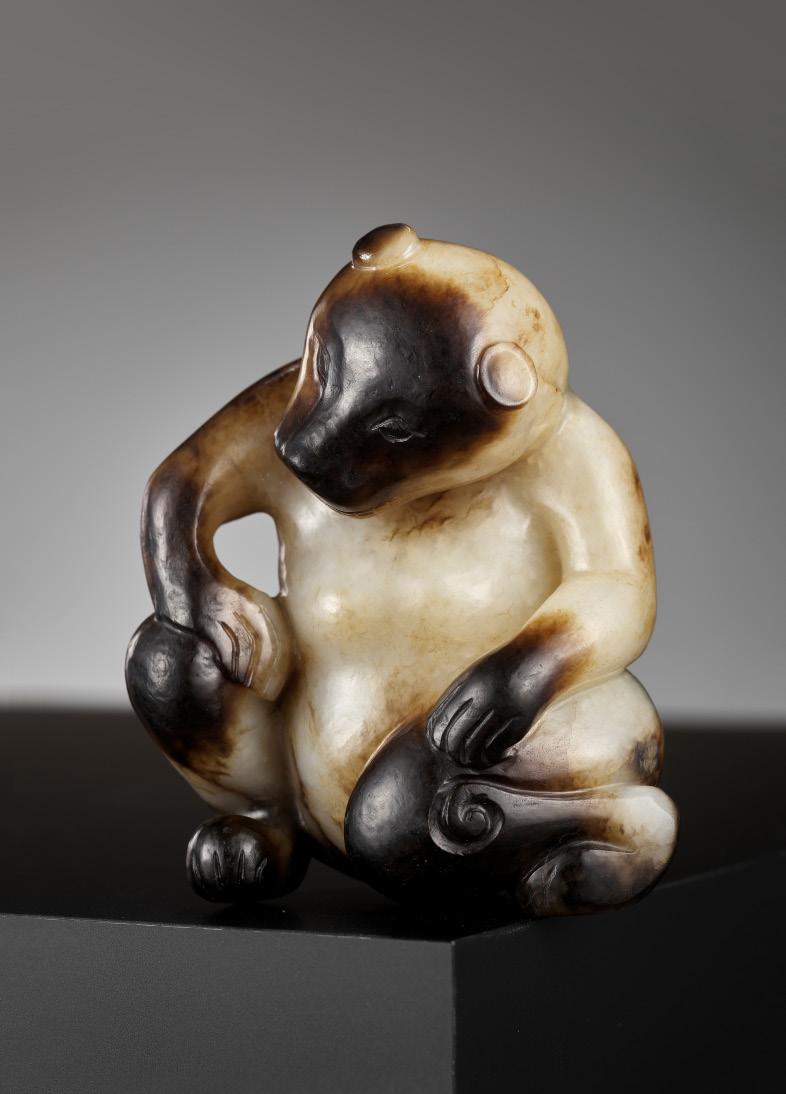
AUCTION RESULT COMPARISON
Type: Closely related
Auction: Christie’s London, 13 May 2014, lot 156
Price: GBP 43,750 or approx. EUR 63,500 converted and adjusted for inflation at the time of writing
Description: A small white and russet jade carving of a bear, Song/Ming dynasty

Expert remark: Compare the closely related subject and pose. Compare also the dark shadings, which are less pronounced than on the present lot, and the fine detailing and incision work. The bear is of much smaller size (4.4 cm wide) than the present lot.
AUCTION RESULT COMPARISON
Type: Related
Auction: Sotheby’s Paris, 13 May 2014, lot 20
Price: EUR 247,500 or approx. EUR 283,000 adjusted for inflation at the time of writing
Description: A rare celadon-yellow jade bear, Song dynasty or earlier
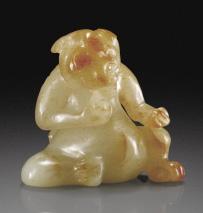

Expert remark: Compare the closely related subject. Compare also the fine detailing and incision work. Note the slightly smaller size (5.1 cm) and celadon-yellow color.
AUCTION RESULT COMPARISON
Type: Related
Auction: Sotheby’s Paris, 13 May 2014, lot 18
Price: EUR 4,207,500 or approx. EUR 4,818,000 adjusted for inflation at the time of writing
Description: A rare yellow jade mythical animal, Song dynasty or earlier
Expert remark: Compare the closely related pose. Compare also the related carving with similar drooping chest and rotund belly as well as the fine detailing and incision work. The mythical animal has a bear-like appearance with the addition of wings and horns. Note the slightly smaller size (5 cm) and yellow color. Note also that this jade was previously published and exhibited by J. J. Lally & Co., Chinese Archaic Jades and Bronzes from the Estate of Professor Max Loehr and Others, New York, 1993, cat. no. 85.
Estimate EUR 20,000
Starting price EUR 10,000
59
AN ARCHAISTIC CELADON AND RUSSET JADE ‘CHILONG’ DISC, BI, MING DYNASTY
China, 1368-1644. Of circular form, carved in high relief with three chilong dragons to one side, their manes and faces finely incised and with scrolling tails, the reverse with archaistic comma spirals interspersed by dots within raised borders. The translucent stone of a deep celadon tone with distinct russet skin and shadings.

Provenance: British trade.
Condition: Very good condition with age related wear and traces of usage, the edges with small nicks and nibbling as expected from an authentic bi disc of this period. Fine, smooth polish overall.
Weight: 112.1 g
Dimensions: Diameter 6.9 cm
AUCTION RESULT COMPARISON
Type: Closely related
Auction: Christie’s London, 4 November 2014, lot
81
Price: GBP 15,000 or approx. EUR 23,000 converted and adjusted for inflation at the time of writing
Description: A pale celadon and russet jade ‘chilong’ disc, bi, Ming dynasty (1368-1644)


Expert remark: Compare the closely related decoration, color of the jade and incision work. Note the size (10.7 cm).
Estimate EUR 4,000
Starting price EUR 2,000
60 36
China, 16th-17th century. The shallow box of oval form, carved and incised to the top with two lychees borne on a leafy branch, one lychee with a lozenge pattern, the other with double lined hexagons, all encircled by a line border. The sides carved with bands of stylized phoenixes and key-fret borders. The translucent stone is of a fine white color with a russet and dark gray vein. Note the broad foot rim.
Provenance: West Berkshire, United Kingdom, local trade. By repute acquired from a private estate.
Condition: Very good condition with expected old wear, little nibbling, a minuscule hairline and loss. The stone with natural inclusions and fissures.
Weight: 70.8 g
Dimensions: Length 6.6 cm
Literature comparison: Compare a closely related celadon jade box and cover with lychee motif, Ming dynasty, in the National Palace Museum of Taiwan, image numbers K1C000839N000000000PAC and K1C000839N000000000PAB. Also compare a pale celadon jade ‘lychee’ box and cover of related form and decoration, 6.3 cm, Ming dynasty, in the Victoria and Albert Museum, accession number FE.154-1988.
AUCTION RESULT COMPARISON
Type: Related
Auction: Christie’s Hong Kong, 30 November 2016, lot 3446
Price: HKD 625,000 or approx. EUR 85,000 converted and adjusted for inflation at the time of writing
Description: A carved white jade ‘lychee’ box and cover, Qing dynasty, 17th-18th century
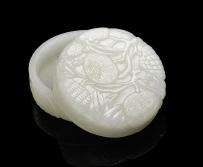
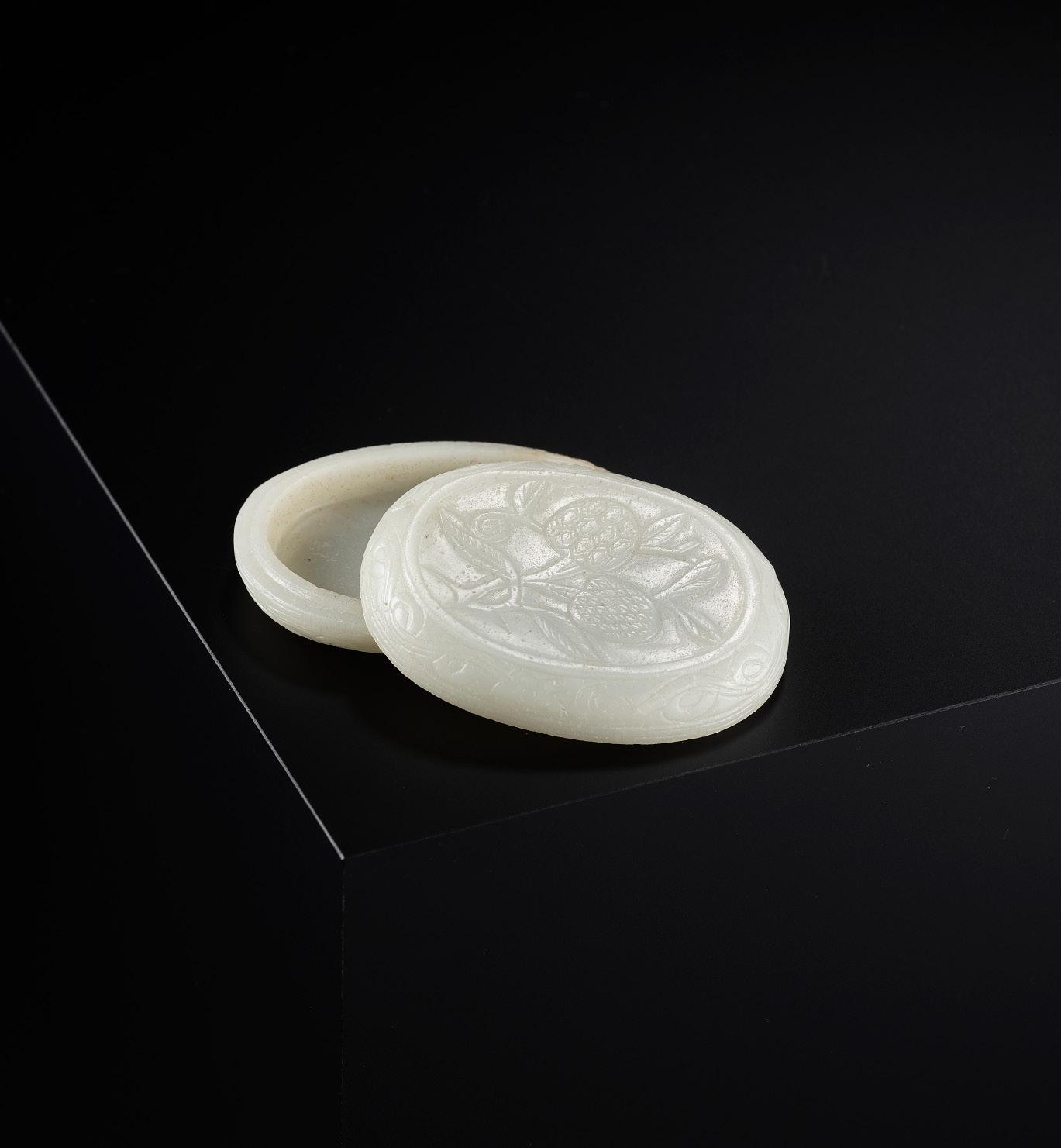
Expert remark: Compare the similar color of the jade, the patterns of the lychees, and the size (7 cm). Note the slightly later dating of the piece.
Estimate EUR 6,000
Starting price EUR 3,000
61 37
A WHITE JADE ‘LYCHEE’ BOX AND COVER, LATE MING DYNASTY
A PALE CELADON JADE ‘TIGER’ BOULDER, 17TH-18TH CENTURY

China. The boulder is naturalistically carved on one side depicting a crouching tiger within a grotto beside a pine tree rooted in rockwork, the reverse with further craggy rocks and grass. The translucent stone of a pale celadon color with shadings of cream and gray and interspersed with dark speckles.
Provenance: British trade.
Condition: Good condition with expected old wear, few minuscule chips, natural inclusions and fissures, some of which may have developed into hairline cracks. The wood stand with some wear and minor losses.
Weight: 573.6 g (excl. stand) and 671.6 g (incl. stand)
Dimensions: Length 12 cm (excl. stand) and 13.1 cm (incl. stand)
With a fitted wood stand from the Qing dynasty, finely carved in openwork in the form of rockwork issuing bamboo, lingzhi, and lotus. (2)
AUCTION RESULT COMPARISON
Type: Related
Auction: Bonhams London, 7 November 2013, lot 122
Price: GBP 37,500 or approx. EUR 59,000 converted and adjusted for inflation at the time of writing
Description: A white jade boulder, 17th/18th century

Expert remark: Compare the related form, rockwork, and size (13 cm). Note that the color of the jade, described as white, may in fact be pale celadon. Also note the different main subject.
Estimate EUR 4,000
Starting price EUR 2,000
62 38
39 A CELADON AND RUSSET JADE ‘LUOHAN IN A GROTTO’ BOULDER, 17TH - 18TH CENTURY



China. Deeply carved to depict a luohan with a book in his hand, seated in a grotto next to a censer, the smoke neatly carved in relief, surrounded by craggy rockwork, the reverse with further rocks and lingzhi. The translucent stone of a grayish celadon color with russet skin and icy inclusions.
Provenance: Wiltshire, United Kingdom, local trade. By repute acquired from a private estate.
Condition: Very good condition with expected old wear, minor nicks, and the stone with natural inclusions and fissures. The wood stand with minor losses and some wear.
Weight: 576.2 g (excl. stand) and 646.0 g (incl. stand)
Dimensions: Height 10.7 cm (excl. stand) and 13.4 cm (incl. stand)
The
AUCTION RESULT COMPARISON
Type: Related
Auction: Sotheby’s New York, 29 September 2021, lot 975
Price: USD 11,970 or approx. EUR 15,500 converted and adjusted for inflation at the time of writing
Description: A gray jade ‘luohan’ boulder, Qing dynasty, 19th century
Expert remark: Compare the related form, motif, craggy rockwork, and finely carved smoke. Note the later dating, different color of the jade, and size (15.3 cm).
AUCTION RESULT COMPARISON
Type: Related
Auction: Sotheby’s Hong Kong, 4 October 2016, lot 34
Price: HKD 500,000 or approx. EUR 68,000 converted and adjusted for inflation at the time of writing
Description: A pale celadon and russet jade ‘ascetic luohan’ boulder, Qing dynasty, 18th century
Expert remark: Compare the related form, color of the jade, motif, craggy rockwork, and finely carved smoke. Note the size (15.7 cm).
Estimate EUR 6,000
Starting price EUR 3,000
63
fitted wood stand dates from the Qing dynasty and is carved in openwork in the form of rockwork issuing bamboo, pine, prunus, and lingzhi. (2)
40
A CELADON JADE FIGURE OF BUDDHA, 17TH-18TH CENTURY
China. Finely carved, seated in dhyanasana, holding an offering bowl in his lowered right hand, his raised left held in abhaya mudra, wearing heavily pleated robes draped over his right shoulder and opening at the chest to reveal a beaded necklace. His serene face with heavy-lidded eyes centered by a circular urna and slender lips forming a benevolent smile. The superbly polished stone is of a deep celadon tone with cloudy inclusions and russet veins. Note the high translucency of the jade, particularly striking in the left hand.


Provenance: The trade in Paris, France.
Condition: Very good condition with minor old wear, few minuscule nicks, remnants of ink, the stone with natural fissures, some of which may have developed into small hairline cracks over time.
Weight: 1,180 g (excl. stand)
Dimensions: 16.5 cm (excl. stand) and 19.5 cm (incl. stand)
With a finely carved and fitted zitan double lotus stand, dating from the same period. (2)
Buddhism flourished during the Qing dynasty, and was encouraged by the devotion of the Kangxi, Yongzheng, and Qianlong emperors. Buddhist artifacts were consequently produced in significant numbers for the imperial court, particularly as ceremonial gifts, such as for the birthdays of members of the court. The popularity of the present form of Buddha carved in jade is apparent from a number of examples of the highest quality surviving in the Imperial collections, most notably in the Palace Museum, Beijing.
Expert’s note: The present jade shows superficial remnants of ink, which we have left in place to some extent, despite the fact they are rather easy to remove, as they indicate appreciation by a previous collector, perhaps a scholar or artist who often had ink-stained fingers as they handled this Buddha.
Literature comparison: See for example a fine celadon jade Buddha, illustrated in Compendium of Collections in the Palace Museum, Jade 8: Qing Dynasty, Beijing, 2011, no. 234, and other Buddhas illustrated ibidem, nos. 236-238. The Imperial association for such jade Buddhas is further evidenced by a related white jade Buddha from the Prince Kung Collection, illustrated in the catalog produced by American Art Galleries,
The Remarkable Collection of the Imperial Prince Kung of China, New York, 1913, no. 71. A celadon jade figure of Buddha Shakyamuni, holding a small stupa, is illustrated in Treasures from Snow Mountains, Gems of Tibetan Cultural Relics, Shanghai Museum, 2001, no. 37.
AUCTION RESULT COMPARISON
Type: Closely related
Auction: Christie’s Hong Kong, 28 May 2021, lot 2718
Price: HKD 1,375,000 or approx. EUR 168,000 converted and adjusted for inflation at the time of writing
Description: A pale greenish-white jade seated figure of Buddha, Qing dynasty, 18th century Expert remark: Note the similar size (17.2 cm)


AUCTION RESULT COMPARISON
Type: Closely related
Auction: Christie’s London, 9 November 2012, lot 1281
Price: GBP 70,850 or approx. EUR 105,000 converted and adjusted for inflation at the time of writing
Description: A large celadon jade Buddha mounted on a gilt bronze stand, 18th century Expert remark: Note the larger size (24.2 cm incl. stand)
AUCTION RESULT COMPARISON
Type: Closely related
Auction: Sotheby’s London, 7 November 2012, lot 231
Price: GBP 70,850 or approx. EUR 105,000 converted and adjusted for inflation at the time of writing
Description: A celadon jade figure of Buddha, Qing dynasty, 18th century Expert remark: Note the similar size (15.9 cm)
Estimate EUR 12,000
Starting price EUR 6,000
64
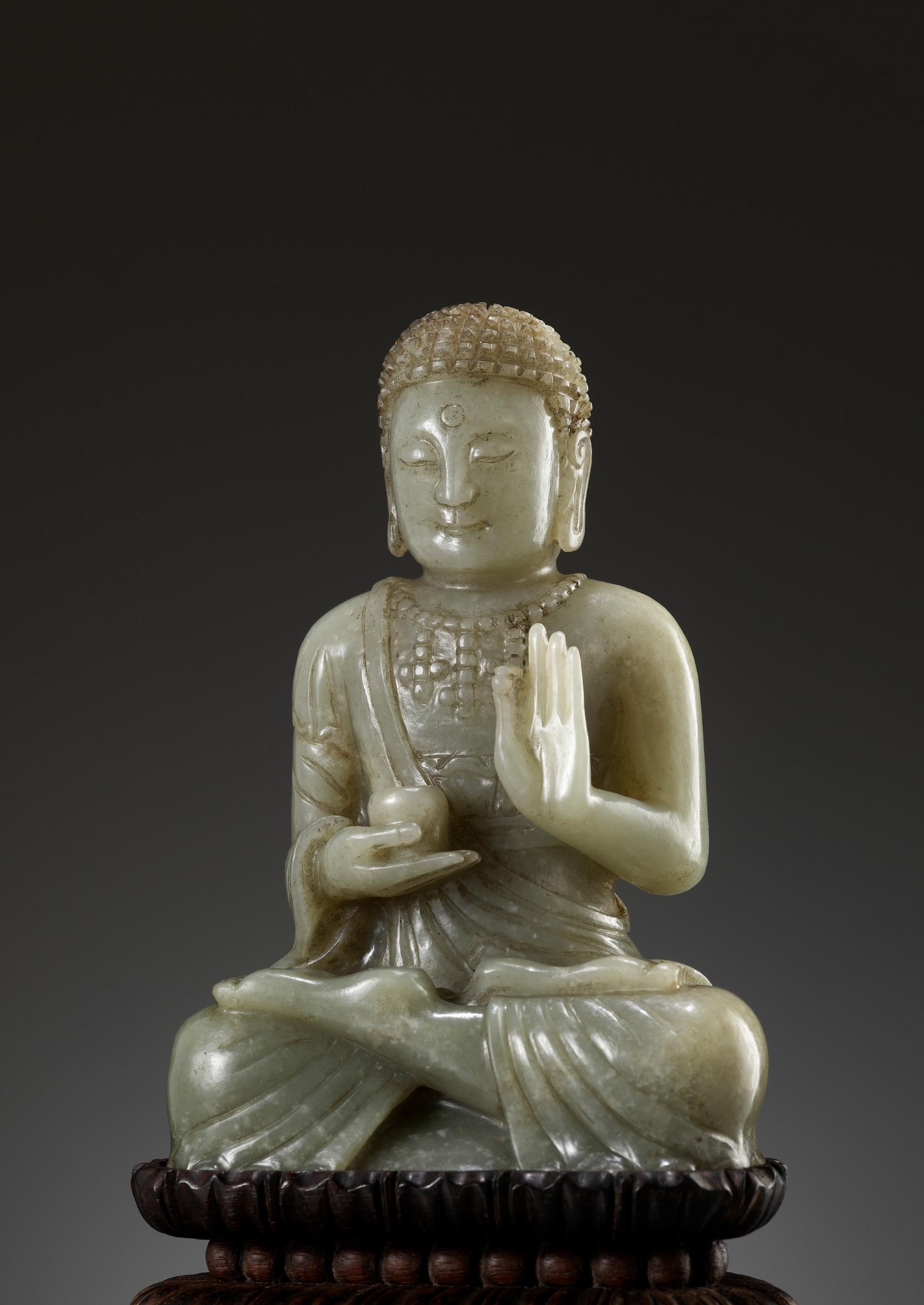
A PALE GRAY JADE FIGURE OF A DEER WITH YOUNG, 17TH CENTURY
China. Well carved in the form of a recumbent deer resting with its head turned back and facing the young stag with short antlers resting by its side, both animals grasping a long lingzhi stem in their mouths, the lingzhi sprig and underside of the jade well defined. The semitranslucent stone of a pale gray color with darker striations and few dark gray veins.
Provenance: British trade.
Condition: Very good condition with minor wear, little nibbling, the stone with natural inclusions and fissures.
Weight: 281.3 g
Dimensions: Length 11.2 cm
AUCTION RESULT COMPARISON
Type: Closely related
Auction: Bonhams London, 7 November 2013, lot 143
Price: GBP 12,500 or approx. EUR 19,500 converted and adjusted for inflation at the time of writing
Description: A white and grey jade ‘horse and foal’ group, 17th century Expert remark: Compare the closely related pose, color of the jade, and size (10.8 cm).

Auction result comparison:
Type: Closely related
Auction: Sotheby’s Hong Kong, 7 April 2015, lot 3682
Price: HKD 562,500 or approx. EUR 79,500 converted and adjusted for inflation at the time of writing
Description: A white jade ‘deer’ group, Qing dynasty, 18th century


Expert remark: Compare the closely related motif. Note the different color and size (8.2 cm) of the jade.
Estimate EUR 4,000
Starting price EUR 2,000
41
A CELADON AND RUSSET JADE GROUP DEPICTING THREE GEESE WITH LOTUS, 18TH CENTURY
China. Finely carved and reticulated as two geese and a gosling swimming atop froth-capped waves, probably created to serve as a brush rest, the wings and tail feathers finely tucked into the body and detailed with plumage. Each goose grasping a stalk of lotus in their beaks, the stalk issuing leaves, lotus flowers and buds. The waves neatly incised with bold lines. The translucent stone of a rather pale celadon tone with few distinct russet veins.
Provenance: Spink & Son, London, 1998, no. 73. A British private collection, acquired from the above. A noted Hungarian private collection, acquired from the above.
Condition: Very good condition with minor wear, few small nicks here and there. The stone with natural fissures, some of which may have developed into small hairline cracks over time. The jade with a good, unctuous feel overall.
Weight: 156 g
Dimensions: Length 10.6 cm

Geese symbolize the wish for a happy marriage, because geese mate for life, see Terese Tse Bartholomew in Hidden Meanings in Chinese Art, Hong Kong, 2006, page 192. Geese also represent good news, stemming from a story about Su Wu, who was captured by the Xiongnu in the 2nd century BC. He was able to engineer his rescue by sending a distress letter to his emperor that was attached to the leg of a goose who was returning to China.
Literature comparison: Compare a similar white jade brush rest in the form of three geese, Qing dynasty, in the Qing Court collection, illustrated in Jade ware (I): The Complete Collection of Treasures of the Palace Museum, 1999, p. 119, no. XX.
Published: Spink, Chinese Jade, London, 1998, page 42, no. 73


AUCTION RESULT COMPARISON
Type: Closely related
Auction: Christie’s New York, 20 September 2013, lot 1705
Price: USD 99,750 or approx. EUR 106,500 converted and adjusted for inflation at the time of writing
Description: A pale greenish-white jade carving of three geese, 18th century

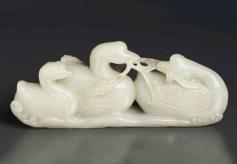
Expert remark: Compare the closely related motif, reticulated details, color of the jade, and related size (13.3 cm)
Auction result comparison:
Type: Closely related
Auction: Bonhams London, 11 May 2021, lot 268
Price: GBP 20,250 or approx. EUR 26,500 converted and adjusted for inflation at the time of writing
Description: A pale green jade ‘goose and goslings’ brush rest, 18th century
Expert remark: Compare the closely related motif, reticulated details, color of the jade, and related size (12.3 cm)
Estimate EUR 6,000
Starting price EUR 3,000
42

A FINE PALE CELADON AND CHESTNUT BROWN JADE ‘MONKEYS AND PEACH’ GROUP, 18TH CENTURY
China. Intricately and imaginatively depicted with an adult monkey gently embracing a young in its right arm, both holding a peach, the young further with a ruyi scepter in his left raised hand, the scepter suspending a long band with a jade chime, all naturalistically carved with wrinkled foreheads and the adult monkey with protruding spines finely detailed with incised hairs. The translucent stone of a pale celadon tone with areas of chestnut-brown and grayish white, interspersed with few dark speckles.
Provenance: From the private collection of Anthony Gustav de Rothschild. Gifted to his daughter Renée Robeson. Thence by descent within the same family. Anthony Gustav de Rothschild (1887-1961) was born in London as the third youngest of three sons of the banker Leopold de Rothschild. He studied at the University of Cambridge and became the managing partner of the N M Rothschild & Sons banking house after the death of his father. De Rothschild inherited his father’s passion for collecting, starting to collect Chinese jade and works of art after a trip to China in 1911. Most of his objects were assembled during the 1920s and 1930s. The present lot belongs to a group of important jades which Rothschild gifted to his eldest daughter Renée Louise Robeson (1927-2015) before he eventually donated the family home to charity.
Condition: Good condition with expected old wear, the feet with a few small nicks, the stone with natural inclusions and fissures, some of which may have developed into hairline cracks. The wood stand with minor wear.
Weight: 428.0 g (excl. base), 464.4 g (incl. base)
Dimensions: Height 11.9 cm (excl. stand), 13.4 cm (incl. stand)
With a fitted, carved, and lacquered wood stand dating from the late Qing dynasty to the Republic period. (2)
This jade carving of monkeys exemplifies the masterful craftsmanship achieved in the jade ateliers during the 18th century. The craftsman would have assessed the unusual jade stone composed of the rare contrasting pale celadon and chestnut-brown tones, utilizing the fine natural material to create the exceptionally skillful carving.



Homophones for monkey, hou, include the Chinese words for ‘nobleman’, ‘high official’, and ‘descendants’. The monkey therefore represents the wish for the success of one’s descendants. The representation of monkey and peach also relates to the legendary figure of Sun Wukong, also known as the Monkey King, who became notorious for stealing the peaches of immortality.
AUCTION RESULT COMPARISON
Type: Related
Auction: Sotheby’s Hong Kong, 7 April 2013, lot 3209
Price: HKD 475,000 or approx. EUR 72,500 converted and adjusted for inflation at the time of writing
Description: A pale celadon and brown jade ‘monkey’ group carving, Qing dynasty, 18th century Expert remark: Compare the related motif, color of the jade, and fine carving. Note the slightly smaller size (9.2 cm).
AUCTION RESULT COMPARISON
Type: Related
Auction: Christie’s Hong Kong, 27 November 2007, lot 1557
Price: HKD 2,287,500 or approx. EUR 420,000 converted and adjusted for inflation at the time of writing
Description: A fine brown and white jade group of two monkeys
Expert remark: Compare the related motif and color of the jade. Note the slightly larger size (15 cm).
AUCTION RESULT COMPARISON
Type: Related
Auction: Bonhams Hong Kong, 29 November 2016, lot 14
Price: HKD 1,250,000 or approx. EUR 170,000 converted and adjusted for inflation at the time of writing
Description: A very fine white and brown jade carving of four monkeys, 18th century


Expert remark: Compare the related motif and color of the jade. Note the slightly smaller size (8.8 cm).
Estimate EUR 30,000
Starting price EUR 15,000

69 43
Anthony Gustav de Rothschild (1887-1961)
A PALE CELADON JADE FIGURE OF A PERSIAN FALCONER, 18TH CENTURY
China. Finely carved, clad in a long cloak hanging over the shoulders and loose robes tied at the waist, wearing a large hat, a falcon perched on his right hand, and holding a treasure in his left hand, his square face with a broad mouth and short beard, flanked by elongated earlobes. The finely polished stone of translucent quality showing an even, pale celadon color with only scattered cloudy-white inclusions.
Provenance: British trade.
Condition: Very good condition with expected old wear and few minuscule nicks to the rim of the hat. Good, unctuous feel overall.
Weight: 143.4 g
Dimensions: Height 8.4 cm
The costume of this well-carved figure identifies him as a foreigner, while the treasure held in his hand suggests he is a tribute bearer. The falcon in his right hand also indicates that he is a falconer, most likely of Persian descent. Small jade figures of this type were first made during the Tang dynasty when figures of foreigners were produced in various materials, representing the cosmopolitan society of the period.
Falcons and falconry have been part of the religious and ideological tradition of the Persianate world from remote antiquity to the pre-modern period. The falcon has been important as a symbol of royal ideology and political legitimation. Already from the earliest Zoroastrian hymns, the Avesta, to manuals on falconry in the nineteenth century, the importance of this bird and the sport is detailed. As the privileged
hobby of sovereigns and high dignitaries, falconry seems to have flourished in pre-Islamic Iran, as evidenced by various legends relating to hunting parties. In Islamic Iran, the expensive sport of hunting with falcons continued to be a favorite entertainment of the rulers and high dignitaries, enabling them to parade military prowess in times of peace. The prestige of such sport was enhanced because the Arab overlords in Baghdad and their provincial deputies, after having encountering the Persians, Byzantines, and others, had developed a keen enthusiasm for falconry.


Auction result comparison:
Type: Related
Auction: Sotheby’s London, 18 May 2018, lot 455
Price: GBP 5,000 or approx. EUR 7,000 converted and adjusted for inflation at the time of writing
Description: A carved pale celadon jade figure of a foreigner, Qing dynasty, 17th/18th century
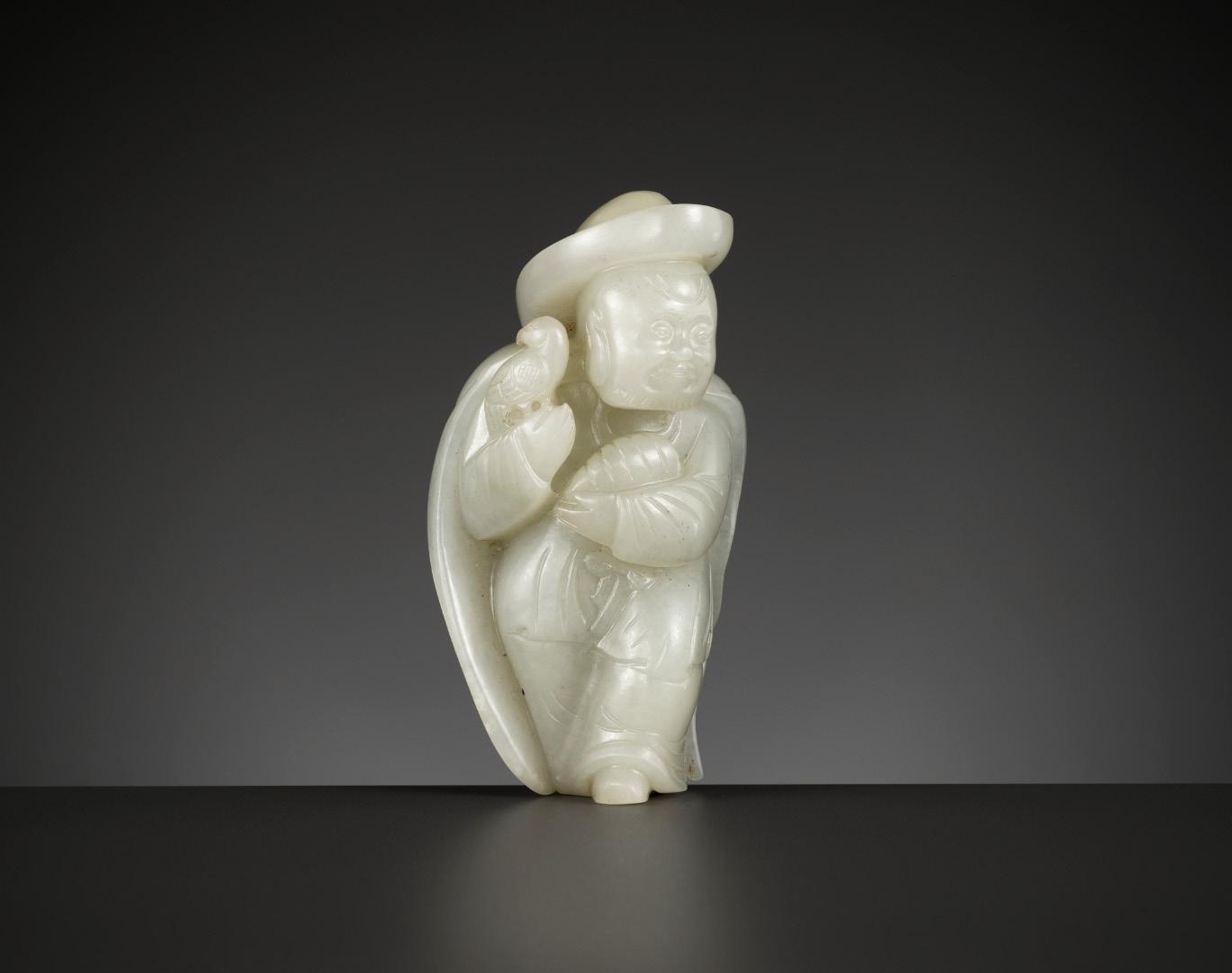
Expert remark: Compare the related robe, facial features, and color of the jade. Note the slightly smaller size (7.5 cm).
Auction result comparison:
Type: Related
Auction: Christie’s New York, 17 March 2016, lot 950
Price: USD 93,750 or approx. EUR 111,000 converted and adjusted for inflation at the time of writing
Description: A rare small pale greenish-white jade figure of a foreigner, late Ming-early Qing dynasty, 16th-18th century
Expert remark: Compare the related robe, pose, and near-identical size (8.9 cm).
Estimate EUR 4,000
Starting price EUR 2,000
70 44
A portrait of a Persian court falconer, Safavid dynasty, 16th century, in the British Museum, registration number 1948,1211,0.9
A Liao-dynasty painting depicting Khitan falcon hunters on horseback, 10th century
A WHITE JADE MUGHAL-STYLE LOBED BOWL, 18TH CENTURY
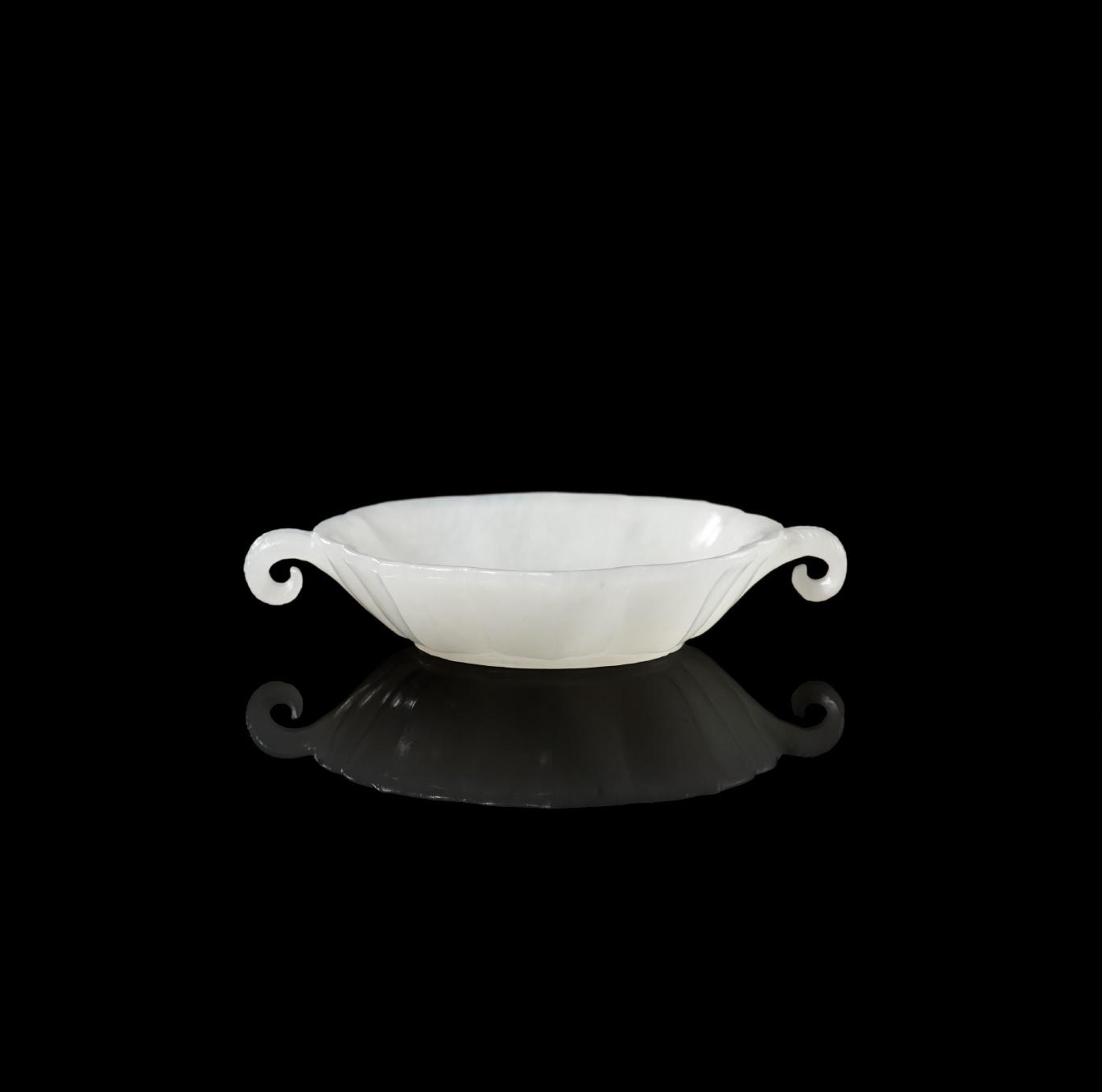

China. The shallow washer with petal lobed sides, barbed rim, flanked by scrolling handles with foliate incision work, supported on a sturdy foot with a recessed and rounded base. The translucent stone of an even white color with cloudy white inclusions.
Provenance: From a private collector in England who has been collecting Chinese jades for over 20 years.
Condition: Very good condition with minor wear, few minuscule chips, the stone with natural fissures, some of which may have developed into small hairline cracks over time. Fine, smooth polish with an unctuous feel overall.
Weight: 61 g
Dimensions: Width 9.3 cm (across handles)
LITERATURE COMPARISON
The simplistic and elegant carving style of this bowl is clearly inspired by that of 17thcentury Mughal and 18th-century Hindustan jade bowls, such as the imperially inscribed Hindustan white jade bowl of circular form in the collection of the National Palace Museum, Taipei, included in the exhibition, Great National Treasures of China, Kaohsiung City, Taiwan, 1994, no. 69. Compare a related Mughal-style jade floral bowl with an inscription by the Qianlong Emperor, 21.6 cm wide, dated to the 18th century, in the Metropolitan Museum of Art, accession number 02.18.762.
AUCTION RESULT COMPARISON
Type: Closely related
Auction: Christie’s New York, 20 March 2001, lot 25
Price: USD 28,200 or approx. EUR 45,500 converted and adjusted for inflation at the time of writing
Description: A Mughal style white jade lobed bowl, 18th century Expert remark: Compare the closely related color, polish, lobed body, and foot. Note the larger size (17.5 cm).
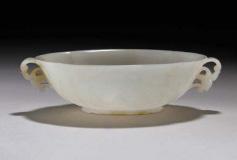
Estimate EUR 3,000
Starting price EUR 1,500
71 45
A MUGHAL-STYLE WHITE JADE ‘CHRYSANTHEMUM’ MARRIAGE BOWL, 18TH CENTURY
China. Superbly carved as a chrysanthemum flowerhead, the elegantlyrounded sides with finely-curved petals radiating from the central pistil, the foot similarly carved as petals, flanked by bat-form handles suspending loose rings, the translucent stone of a pure white tone with russet veins.
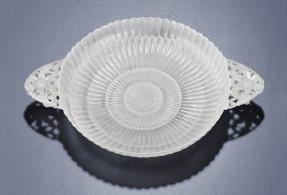
Provenance: From a noted private collection of jades and snuff bottles. Condition: Very good condition with minor wear, microscopic nicks, the stone with natural inclusions and fissures, some of which have developed into small hairline cracks over time.
Weight: 203.9 g (excl. stand)
Dimensions: Length 17.8 cm (across)
With a finely carved and fitted zitan stand dating from the same period. (2)
The present lot demonstrates the craftsmanship achieved in the jade ateliers during the height of the Qing dynasty. ‘Hindustani’ jades, as they were called by the Qianlong Emperor, were highly prized and therefore influenced Chinese jade carvings. Bowls decorated with auspicious symbols expressing wishes relating to marital bliss and blessing were traditional gifts bestowed at Imperial celebrations.
Chrysanthemums were emblematic of longevity and fertility, because of their health-giving properties and the multitude of their petals. The word for chrysanthemum is a homophone with that for ‘eternity’ but also with the number nine which also evoked infinity, being the product of three times three, the most basic unit comprising Heaven, Man and Earth.
From at least the Han dynasty, people drank chrysanthemum wine on the ninth day of the ninth lunar month to prolong their life. As symbols of good luck and happiness, bats have few rivals in Chinese culture, and their admiration for bats is ancient. The Chinese word for bat is ‘fu,’ pronounced the same as the word for good fortune.
Out of over 800 compositions which the Emperor wrote on jade, more than 50 were devoted to Mughal jade, which he described as ‘thin as paper’. One such example is a poem written in 1770 in praise of a Hindustan white jade bowl and may be translated as:
Hindustan jade is selected from the river, Smoothed by stream water to give its exceptional finish. Fine workmanship makes a myriad of petals to form a steady foot, Double flowers are exquisitely paired. Fine jade comes from Xi Cheng* as of old, Fair and delicate it now surpasses the jade maiden. Forbidden to be used regardless of the tea, A stern prohibition edict issued long hence.
*Name of an ancient location near Xinjiang
This poem was also followed by a note written by the Emperor, in which he mentions that the Hindustan bowl is carved with “twelve long leaves rising to the mouth rim, flanked by a pair of handles each in the form of a flower supported on leaves. The material is glossy and smooth, worked to be thin as paper. This fine jade is so exquisitely carved that it is unable to be reproduced by craftsmen of the Middle Kingdom”.

AUCTION RESULT COMPARISON
Type: Closely related
Auction: Christie’s Hong Kong, 28 November 2012, lot 2357
Price: HKD 437,500 or approx. EUR 67,500 converted and adjusted for inflation at the time of writing
Description: A Mughal pale celadon jade chrysanthemum dish, 18th century Expert remark: Note the similar size (18.9 cm).
Estimate EUR 4,000
Starting price EUR 2,000
72 46
A WHITE AND BROWN JADE ‘LOTUS, CRAB AND MILLET’ BRUSH WASHER AND MATCHING WOOD STAND, 18TH CENTURY

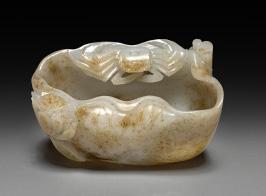
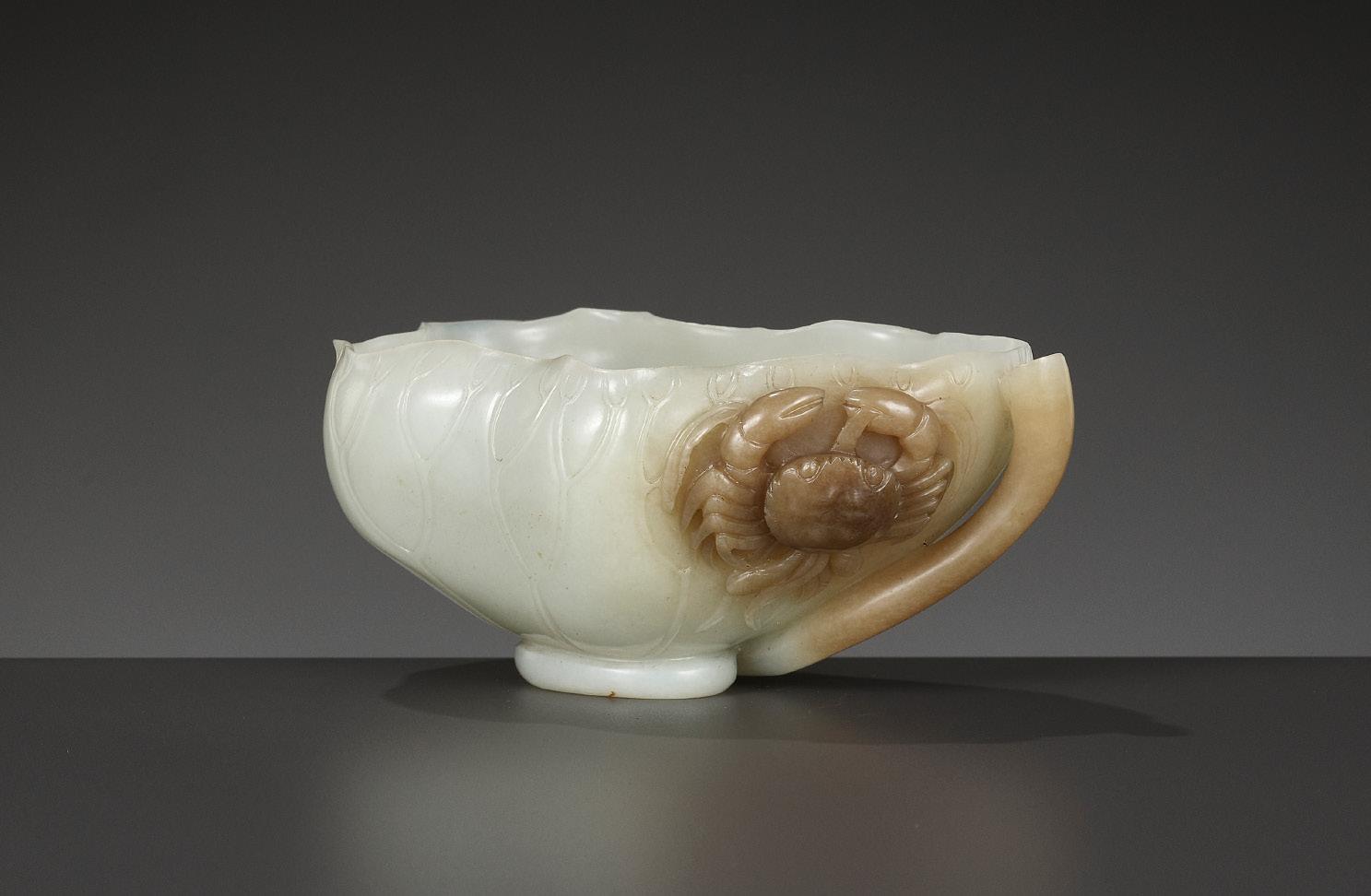
China. Exquisitely carved as a furled lotus leaf, finely detailed with veins, the curled stem serving as the foot and handle of the vessel, one side carved with a clambering crab. The superbly polished translucent stone of a pure white tone with pale sugar brown shadings and few russet inclusions and veins.
Provenance: An old English private collection. A Hungarian private collection, acquired from the above.
Condition: Very good condition with minor wear and few tiny nibbles. The stone with natural fissures, some of which have developed into small hairline cracks over time. The wood stand with minor wear, few expected age cracks, and small losses.
Weight: 203.7 g (the washer) and 84.2 g (the stand)
Dimensions: Length 11 cm
The matching wood stand, probably huali, lacquered and finely carved in openwork as two lotus leaves borne on curled stems further issuing lotus pods and millet stalks. (2)
This brush washer is an exceptional example of the level of carving achieved by craftsmen in the 18th century. From the exquisitely detailed veins of the lotus leaf and modeling of the crab, to the fluid naturalistic form of the leaf, the carving has been expertly positioned and composed within the pebble to ensure minimal wastage and the clever incorporation of the brown portion of the stone to highlight the crab and stem.
Lotus-leaf brush washers and water droppers were popular from the Ming dynasty, and were produced in various materials including porcelain, agate, bronze and jade. Such vessels are an example of the ideal natural world that was miniaturized and brought into the scholar’s studio. These perfect representations of nature, which encompassed a range of objects including boulder carvings, brush pots and brush washers, proved a means of inspiration and escape for the scholar who was caught in the day-to-day duties of officialdom. An old name in Chinese for crab was jia, a reference to the creature’s shell, and the word for lotus is lian.
Such scenes were also imbued with auspicious meaning. Together, the crab and lotus formed the rebus lian ke jia di, meaning ‘first place in consecutive examinations’. The lotus is also called hehua, and the common name for crab, xie, also combines to form the phrase hexia which means ‘harmony’.
Expert’s note: It is rare to find a brush washer in white and brown jade, as this combination of colors was usually reserved for figural jades. The lapidary has masterfully utilized the different shades of the stone and polished it to a high translucency to further heighten the awe-inspiring effect, and even added a matching stand which strikingly complements the depiction, altogether leaving no doubt that the present lot was made during the 18th century.
LITERATURE COMPARISON
Compare a related jade
“cup” carved as a lotus leaf surmounted by a crab, dated to the Kangxi period, in the Cleveland Museum of Art, accession number 1952.501.
Estimate EUR 6,000
Starting price EUR 3,000
73 47
A RARE SPINACH-GREEN JADE CUP, ZUN, 17TH-18TH CENTURY


China. Of lobed melon form supported on a tall foot, the sides finely carved with lotus blossoms, plantain leaves, and scrolling vines, the foot further carved with floral designs. The semi-translucent stone of a deep green tone with dark specks as well as lighter and darker striations.

Provenance: From the collection of a gentleman in London, United Kingdom, who has been collecting Asian works of art for the last 50 years. A label to the base, ‘Antique Jade Spinich [sic!] carved archaic vessel 18/19th century’. An inventory number, ‘217.14.QT’, lacquered to the mouth. An old price label, ‘HC 102 BIR 2’’ $160’. An inventory number, ‘22’ lacquered to the base.
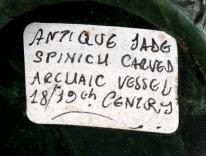
This austere form, sometimes also referred to as chi kou zun, appears to derive from the earthenware originals, popular during the Shang and Zhou eras, as ‘A Dictionary of Chinese Ceramics’ by Wang Qingzheng, page 45, refers. This genre oscillates between the shape offered here, and the more conventional stem cup forms of gao zu bei and ba bei. Interestingly, both are known in gray jade from examples made during the Ming dynasty, but never before has a version carved from spinach green jade appeared on the market, at least not to the knowledge of this author. For an example of the gao zu bei form in gray hue, see No.2823 of the 1935-36 International Exhibition of Chinese Art at The Royal Academy, lent to the Exhibition by Major General Sir Neil Malcolm.
AUCTION RESULT COMPARISON
Type: Remotely related
Auction: Bonhams Hong Kong, 3 December 2015, lot 39
Condition: Very good condition with expected old wear, few small nicks, the stone with natural inclusions and fissures, some of which have developed into hairline cracks. The wood stand with minor wear.
Weight: 305.4 g (excl. stand), 331.5 g (incl. stand)
Dimensions: Height 7.7 cm (excl. stand), 10.1 cm (incl. stand)
With a fitted and reticulated wood stand supported on four short feet, dating from the Qing dynasty. (2)
Price: HKD 312,500 or approx. EUR 44,000 converted and adjusted for inflation at the time of writing

Description: A rare spinach-green jade ‘heavenly bird’ jar, Zun, Qianlong/Jiaqing
Expert remark: Compare the related color of the jade and the similarly detailed floral carving. Note the additional bird heads and the slightly larger size (10.1 cm).
Estimate EUR 4,000
Starting price EUR 2,000
74 48
China. Of rectangular form, decorated on top with two opposing kui dragons, centered by a pierced aperture for suspension, the plaque depicting a scene from the Romance of the Western Chamber, with a reclining lady, a courtier and an attendant in the back, a bird looking out the circular window, with bamboo and rockwork. The reverse incised with a poem and two seals. The translucent stone of an even white tone with scattered cloudy inclusions.
Provenance: British trade.
Condition: Very good condition with minor old wear and traces of usage, minuscule nibbling here and there, some of which may be inherent to the carving.
Weight: 45.8 g
Dimensions: Size 6.2 x 3.9 cm
The Romance of the Western Chamber, written by Wang Shifu (12501300), was immensely popular among all levels of society. Woodblock illustrations in the many editions helped conventionalize images that were instantly recognizable to the general public, thus creating a corpus of motifs that was widely used by jade carvers, painters, silk embroiderers, lacquer workers, and other craftsmen.
Professor Herbert Giles, whose History of Chinese Literature was published in 1924, refers to The Xixiang Ji as the play “which will best repay reading”. It is the typical story where a handsome student and a beautiful girl attempt to cross the social divide, aided and incited by the girl’s maid. The dialogue is punctuated with images of wind, snow, moonlight, and flowers, emphasizing both the passion and the romance felt by the struggling couple.
AUCTION RESULT COMPARISON
Type: Closely related
Auction: Christie’s New York, 13 September 2018, lot 969
Price: USD 68,750 or approx. EUR 95,000 converted and adjusted for inflation at the time of writing
Description: A white jade shaped rectangular plaque, 18th century
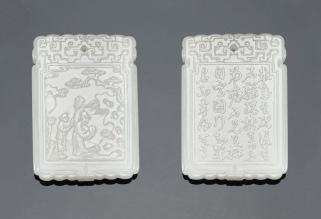


Expert remark: Compare the closely related form, color of the jade, kui dragon decoration, figural scene, and incised poem to the reverse. Note the smaller size (4.8 cm).
Inscriptions: To the reverse, inscribed ‘In the night, stillness in the morning mist, the flowers spraying their scent in the garden, the curtains do not move, the wind rests.’ Two seals.
Estimate EUR 6,000
Starting price EUR 3,000
75
49
A WHITE JADE ‘ROMANCE OF THE WESTERN CHAMBER’ PLAQUE, 18TH CENTURY
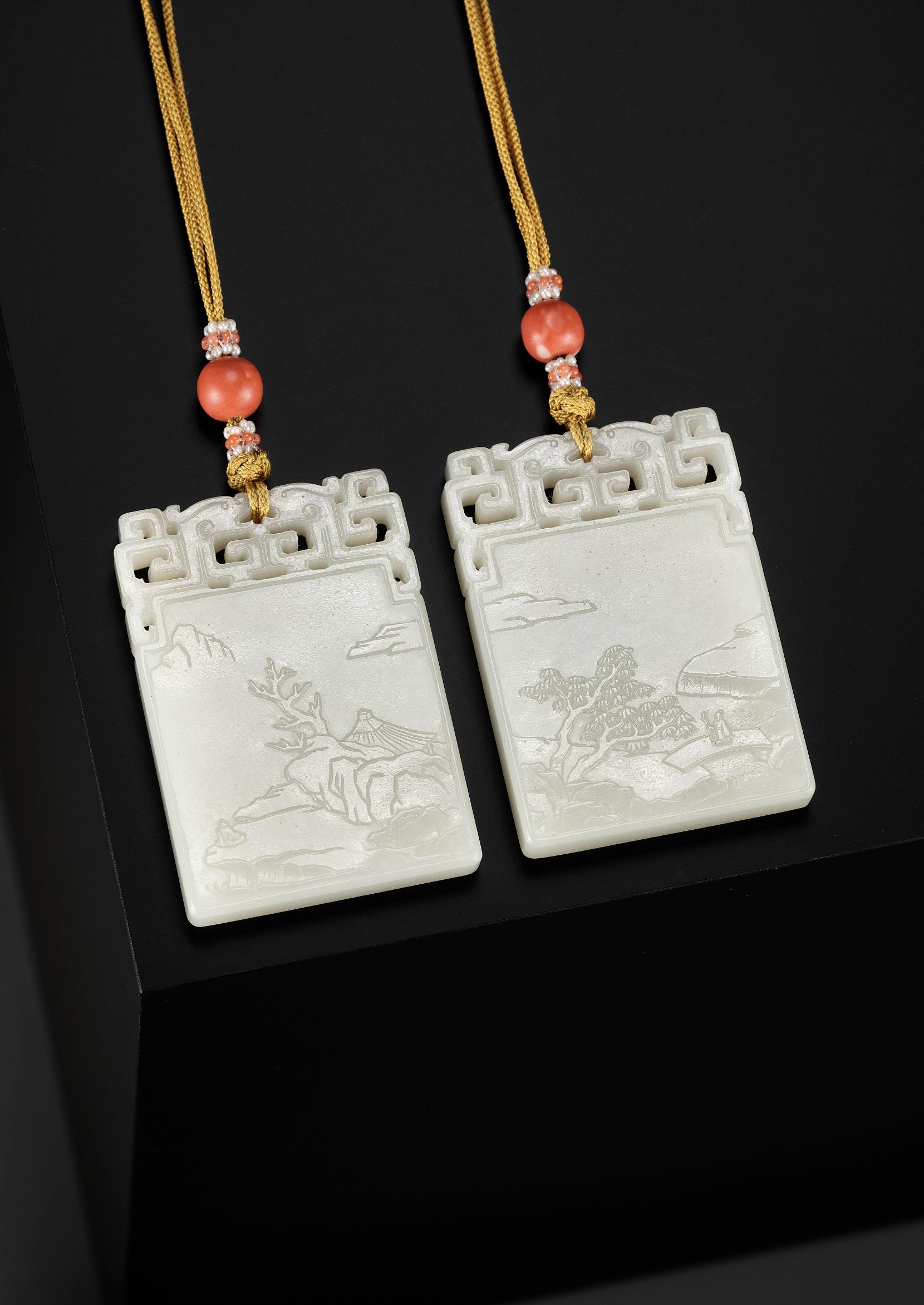
AN EXTREMELY RARE PAIR OF ‘CONTINUOUS LANDSCAPE’ CONNECTED JADE PLAQUES, 18TH TO 19TH CENTURY
China. Of rectangular form, each plaque neatly carved and incised with one half of a connected mountain and river landscape, depicting a pavilion, rocks, a traveler crossing a bridge, and a scholar resting near a cliff while appreciating the landscape. The reverse of each plaque carved in relief with a poem and signed. The reticulated top with confronting kui dragons, pierced at the center for suspension. A yellow string with small pearls and coral beads attached. The translucent stone of a fine and even pale celadon tone. (2)
Inscriptions: Each plaque signed ‘Wen Zhen’ to the reverse. This artist signature could also be translated as ‘scholarly treasure’. Each plaque is further inscribed with one half of a poem, beginning with the right plaque, ‘The clear water mirrors the shadows of the trees, one can see the mountain landscape through the wall. The autumnal trees have yellow leaves and are shrouded in the light of the setting sun,’ and continuing on the left plaque, ‘The bamboo and chrysanthemums in the garden are only here for me. Slowly the new moon shows itself, I will stay in this garden for a while.’
Provenance: British trade.
Condition: Very good condition with expected old wear, few minuscule nibbles here and there. Microscopic natural inclusions to the stone.
Weight: 50.9 g and 47.7 g
Dimensions: Size 5.9 x 4.2 cm (each)
Expert’s note: It is extremely rare to find a pair of jade plaques carved with a continuous landscape such as the present lot, with no comparable examples found by this author. Jade plaques of this type are usually either crafted as a single piece or as pairs showing the same depiction, sometimes in mirror image.
AUCTION RESULT COMPARISON
Type: Related
Auction: Sotheby’s Hong Kong, 5 June 2020, lot 685
Price: HKD 100,000 or approx. EUR 12,500 converted and adjusted for inflation at the time of writing
Description: A white jade plaque, Qing dynasty, 18th century


Expert remark: Compare the related form, reticulated top, color of the jade, beads and cord, and size (5.9 cm). Note the color of the jade is described as white in the title, but of a more celadon tone, as can be seen in the photo. Note also that the lot comprises only one plaque.
AUCTION RESULT COMPARISON
Type: Related
Auction: Christie’s London, 8 November 2013, lot 1307
Price: GBP 13,750 or approx. EUR 20,500 converted and adjusted for inflation at the time of writing
Description: A pair of pale celadon jade rectangular plaques, 19th century

Expert remark: Note that while this lot also comprises a pair of jade plaques, the depiction is not continuous as on the present pair of jade plaques, but mirrored instead, which is decidedly more common.
Estimate EUR 8,000
Starting price EUR 4,000
77 50
51
A PALE CELADON JADE ‘SCHOLARS’ PARFUMIER, 18TH CENTURY

China. Of tubular form carved in openwork and high relief with a mountain landscape, the craggy bluffs ascending in overlapping layers creating a sense of verticality and movement, gnarled pine trees emerging from rocky outcrops throughout, one side with a bearded scholar and attendant crossing a bridge above a waterfall, ambling toward a pavilion, the reverse with two young boys, one carrying a peach branch and the other a lingzhi, the top and bottom finely incised with a band of key-fret. The translucent stone of an even, almost pure pale celadon tone with scattered cloudy white inclusions.
Provenance: Formerly in an Italian private collection.
Condition: Very good condition with minor old wear, few small nicks here and there.
Weight: 282.9 g
Dimensions: Height 18.6 cm
AUCTION RESULT COMPARISON
Type: Closely related
Auction: Christie’s Hong Kong, 6 April 2015, lot 252
Price: HKD 350,000 or approx. EUR 49,000 converted and adjusted for inflation at the time of writing
Description: A pale celadon jade cylindrical parfumier, Qing dynasty, 18th century

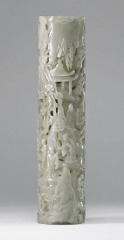

Expert remark: Compare the closely related form, color of the jade, motif, and carving. Note the size (20.5 cm).
AUCTION RESULT COMPARISON
Type: Closely related
Auction: Sotheby’s New York, 10 September 2019, lot 30
Price: USD 35,000 or approx. EUR 39,000 converted and adjusted for inflation at the time of writing
Description: A celadon jade ‘scholar’s retreat’ parfumier, Qing dynasty, 18th century
Expert remark: Compare the closely related form, color of the jade, motif, and carving. Note the size (17.2 cm).
Estimate EUR 12,000
Starting price EUR 6,000
78

A PALE CELADON JADE POURING VESSEL, YI, QING DYNASTY
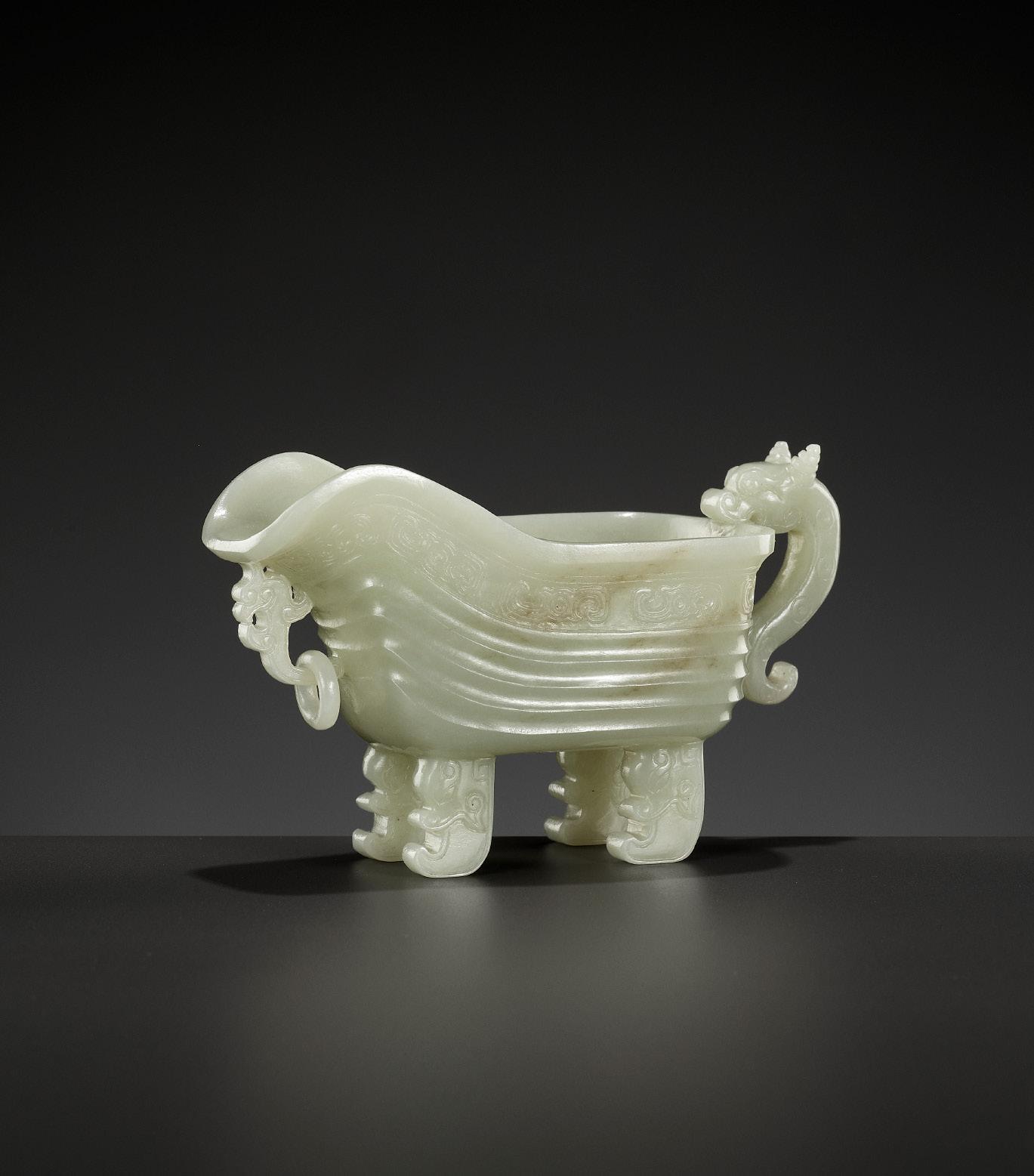

China, 19th century. Supported on four beast-mask feet, the body carved to the side with four elegantly curved grooves below a band of archaistic motifs, the S-shaped handle with a two-horned dragon terminal, further decorated below the spout with a pierced loop suspending a loose ring. The translucent stone of a pale celadon tone with few pale brown veins and cloudy white inclusions.
Provenance: An old British private collection, by repute acquired in China during the 1940s. A private collection in Edinburgh, Scotland, acquired from the above.
Condition: Excellent condition with expected old wear and tiny nibbles here and there.
Weight: 167.3 g
Dimensions: Length 11.5 cm
AUCTION RESULT COMPARISON
Type: Related
Auction: Christie’s London, 11 May 2016, lot 165
Price: GBP 17,500 or approx. EUR 26,000 converted and adjusted for inflation at the time of writing
Description: A pale celadon and russet jade pouring vessel, yi
Expert remark: Compare the related form, dragon handle, ring suspension, color of the jade, and archaistic design. Note the larger size (16.8 cm).
Estimate EUR 4,000
Starting price EUR 2,000
80
52
MUGHAL STYLE PALE CELADON JADE CENSER AND COVER

China, 19th century. The censer of globular form with thin walls, the deep bowl raised on a stepped foot with a retictulated mid-section suspending four rings, flanked by a pair of dragon head handles framed by scrolling vines and suspending loose rings. The domed cover also reticulated with meandering vines below a chrysanthemum finial from which project four foliate loops suspending loose rings. The translucent stone of a pale celadon tone with few small russet areas and cloudy white inclusions.
Provenance: From the collection of a gentleman in London, United Kingdom, who has been collecting Asian works of art for the last 50 years, and thence by descent. The base with an old label, ‘Antique jade incense burner on stand. 18th/19th century. Qing dynasty.’
Condition: Excellent condition with minor wear, minuscule nibbling, and a small nick to the base which has been smoothened. The stone with few small fissures, some of which have developed into thin hairline cracks. The wood stand with minor wear and expected age cracks.
Weight: 405.1 g (excl. base) and 738.4 g (incl. base)
Dimensions: Height 16.1 cm (excl. base) and 23.1 cm (incl. base)
With an old, lacquered wood stand. (2)
AUCTION RESULT COMPARISON
Type: Closely related
Auction: Christie’s New York, 6 April 2011, lot 420
Price: USD 8,125 or approx. EUR 10,000 converted and adjusted for inflation at the time of writing
Description: A Chinese whitish jade censer and pierced cover

Expert remark: Compare the closely related form, reticulated cover, and loose rings. Note the size (15.2 cm).
AUCTION RESULT COMPARISON
Type: Related
Auction: Christie’s New York, 21 March 2013, lot 880
Price: USD 20,000 or approx. EUR 24,500 converted and adjusted for inflation at the time of writing
Description: A pale greenish-white jade tripod censer and cover


Expert remark: Compare the related form, reticulated cover, and loose rings, as well as the closely related color of the jade. Note the size (18.8 cm) and foliate feet.
Estimate EUR 4,000
Starting price EUR 2,000
81 53
A
A TURQUOISE GLASS FACETED SNUFF BOTTLE, WHEEL-CUT QIANLONG MARK AND OF THE PERIOD
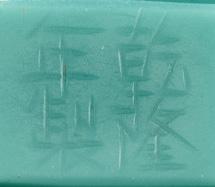
China, 1736-1795. The opaque turquoise glass snuff bottle of octagonal shape, with a flat foot, surmounted by a cylindrical neck, carved to either side with a raised faceted panel. The base with a wheel-cut four-character mark Qianlong nianzhi and of the period. Note the wide opening of the mouth, as expected from early and authentic bottles from this group.

Provenance: From a private family collection in Brittany, France. Condition: Good condition with old wear, shallow surface scratches and some manufacturing irregularities, few tiny nibbles to lip and edges.
Stopper: Glass in imitation of coral and with black platelet, nice spoon with dark patina
Weight: 37.7 g
Dimensions: Height including stopper 53 mm. Diameter neck 15 mm and mouth 9 mm
AUCTION RESULT COMPARISON
Type: Closely related
Auction: Sotheby’s Hong Kong, 26 May 2013, lot
236
Price: HKD 106,250 or approx. EUR 16,500 converted and adjusted for inflation at the time of writing
Description: A facetted turquoise-green glass snuff bottle, Imperial glassworks, Qing dynasty, 18th century

Expert remark: Compare the closely related form and turquoise color. Note that this bottle is unmarked, unlike the present lot.

Estimate EUR 6,000
Starting price EUR 3,000
54
A SMALL JASPER-GREEN FACETED GLASS SNUFF BOTTLE, IMPERIAL GLASSWORKS, 18TH CENTURY

China, Beijing, 1700-1780. Of compressed horizontal ovoid form with octagonal profile, surmounted by a cylindrical neck with flat lip, and a flat foot, the two main sides with raised, faceted oval panels surrounded by further faceting. The glass of an opaque jasperturquoise color with few yellow streaks around the base.
Provenance: Guwan Cheng, Beijing, November 2006, by repute excavated from a tomb. Hugh Moss Ltd., Hong Kong, 2010. An English private collector of Snuff Bottles, acquired from the above. A copy of the original invoice from Hugh Moss Ltd., Hong Kong, dated 11 October 2010, dating the piece to 1700-1780, noting the tomb excavation, and stating a purchase price of USD 5,400 (or approx. EUR 6,900 converted and adjusted for inflation at the time of writing), accompanies this lot. Hugh Moss (b. 1943) is an author, dealer, artist, lifelong collector, and enthusiast of Chinese art, and foremost authority on Chinese snuff bottles.
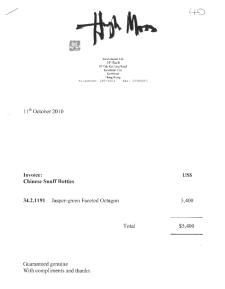
Condition: Excellent condition with minor wear and manufacturing irregularities, including open bubbles, few nibbles to the edges and light surface scratches.
Stopper: Mother-of-pearl with gilt bronze collar
Weight: 20.7 g
Dimensions: Height incl. stopper 40 mm, Diameter neck 12 mm and mouth 7 mm
With a padded silk box. (2)
The present snuff bottle belongs to a series of octagonal faceted snuff bottles made at the court for distribution by the Qing Emperors as gifts to officials, scholars, and other worthies on specific occasions each year. The faceting arose out of the influence of the Bavarian Kilian Stumpf who set up the Imperial Glassworks in 1696 and became a popular form of decoration for glass bottles and other wares throughout the earlier Qing dynasty. Because they were frequently distributed as gifts, the bottles became symbols of honor and were frequently buried with Qing snuff-takers.
This bottle is typical of the smaller-sized range for this form. The mouth is well within the range of early wide mouths on glass bottles. The jasper green color, perhaps inspired by the natural stone, is among the rarer ones found in Palace-faceted octagonal snuff bottles of the 18th century and does not appear to have been produced at all during the 19th century.
Expert’s note: According to Hugh Moss, this bottle was excavated from a tomb near Beijing in the early 2000s. Many such tombs have been uncovered in the past decades due to the expansion of Beijing and massive building programs such as the 2008 Olympics, and thus a number of glass snuff bottles (along with many other types of precious objects) were discovered. The glass snuff bottles typically show obvious signs of burial as they are affected by contact with damp soil for so long. They are, as a rule, polished after coming out of the tomb, having lost much of their surface gloss from long burial, but in this case traces of the original iridescence have remained intact. The foot and lip, however, were wisely left cleaned but unpolished so as not to obscure the original extent of wear on the bottle from before it was buried.
Auction result comparison:
Type: Closely related

Auction: Sotheby’s Hong Kong, 26 May 2013, lot 236
Price: HKD 106,250 or approx. EUR 16,000 converted and adjusted for inflation at the time of writing
Description: A facetted turquoise-green glass snuff bottle, imperial glassworks, Qing dynasty, 18th century
Expert remark: Compare the closely related form and similarly small size (36 mm). Note the slightly paler color of the glass.
Estimate EUR 4,000
Starting price EUR 2,000
55
Hugh Moss (c. 1970)
A ‘JOURNEY
TO THE WEST’ CINNABAR LACQUER SNUFF BOTTLE, PROBABLY IMPERIAL
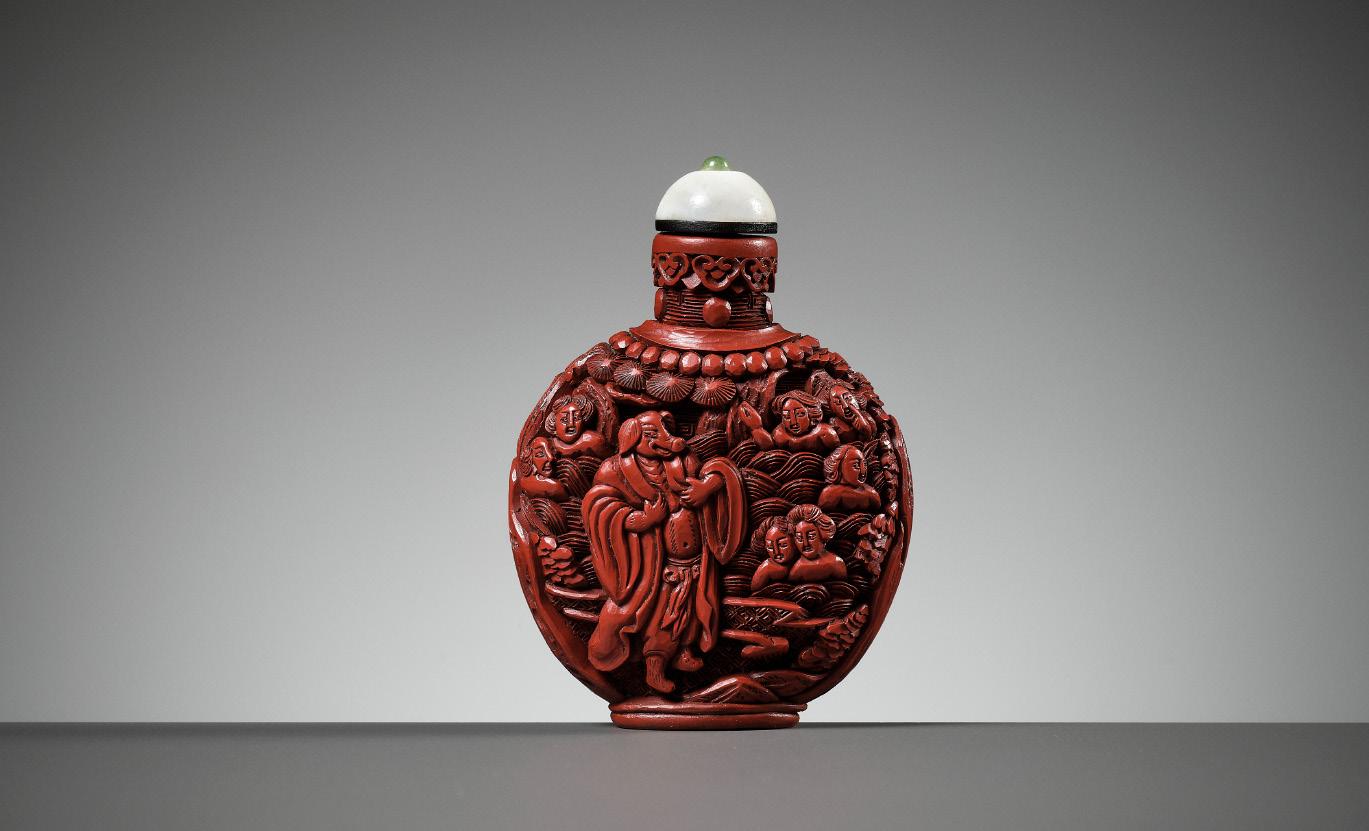
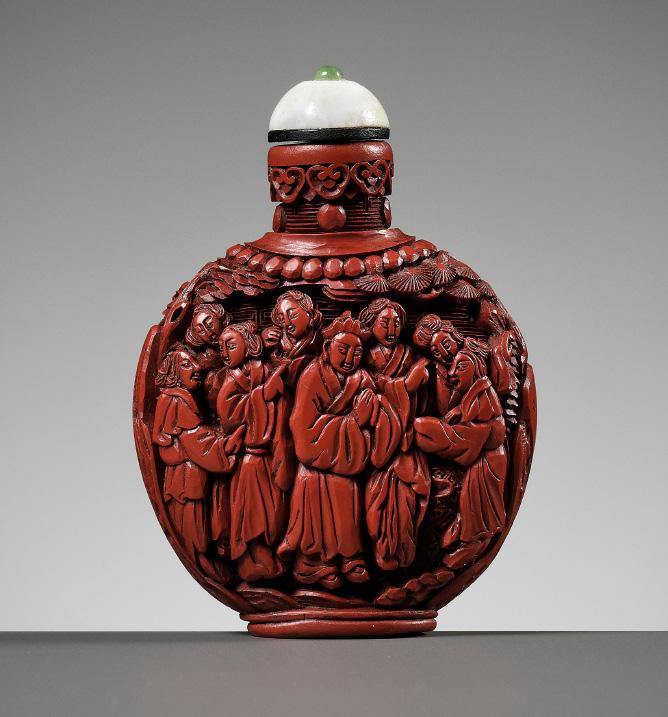
China, 1740-1820. Of flattened globular form, deftly carved to each side with a scene from the Journey to the West, one side with Zhu Bajie disguised as a monk in a bath with beautiful ladies, about to discard his robes and join them in the water with a lustful expression on his face, the other with Tang Sanzang surrounded by court ladies, all on a variety of diaper grounds, the neck with a band of ruyi-heads. The recessed oval base neatly incised with a four-character mark Qianlong nianzhi and probably of the period.
Provenance: Previously in a Scottish private collection. Condition: Very good condition with minor wear and few tiny nicks.
Stopper: Pearl
Weight: 50.2 g
Dimensions: Height incl. stopper 67 mm. Diameter neck 15 mm and mouth 4 mm
Journey to the West (Xi You Ji) is a Chinese novel published in the 16th century during the Ming dynasty and attributed to Wu Cheng’en. It is regarded as one of the greatest Classic Chinese Novels, and has been described as arguably the most popular literary work in East Asia. The novel is an extended account of the legendary pilgrimage of the Tang dynasty Buddhist monk Xuanzang, who traveled to the ‘Western Regions’ (Central Asia and India) to obtain Buddhist sacred texts and returned after many trials and much suffering. The monk is referred to as Tang Sanzang in the novel, which retains the broad outline of Xuanzang’s own account, Great Tang Records on the Western Regions, but adds elements from folk tales and the author’s invention: Gautama Buddha gives a task to the monk and provides him with three protectors who agree to help him as atonement for their sins. These disciples are Sun Wukong, Zhu Bajie, and Sha Wujing, together with a dragon prince who acts as Tang Sanzang’s steed, a white horse. The pilgrims then journey towards enlightenment through the power and virtue of cooperation.
Zhu Bajie (literally ‘Pig of the Eight Prohibitions’) is also known as Zhu Wuneng (‘Pig Awakened to Power’). Once an immortal who was the Marshal of the Heavenly Canopy commanding 100,000 naval soldiers of the Milky Way, he drank too much during a celebration of the gods and attempted to harass the moon goddess Chang’e, resulting in his banishment to the mortal world. He was supposed to be reborn as a human but ended up in the womb of a sow due to an error on the Reincarnation Wheel, which turned him into a half-man, half-pig, humanoid-pig monster. Zhu Bajie was very greedy, and could not survive without eating ravenously. Staying within the Yunzhan Dong (cloud-pathway cave), he was commissioned by Guanyin
to accompany Tang Sanzang to India and given the new name Zhu Wuneng. However, Zhu Bajie’s lust for women led him to the Gao Family Village, where he posed as a handsome young man and helped defeat a group of robbers who tried to abduct a maiden. Eventually, the family agreed to let Zhu Bajie marry the maiden. But on the day of the wedding, he drank too much alcohol and accidentally returned to his original form. His lust for women, extreme laziness, and greediness made his spirituality the lowest in the group, and he remained on Earth and was granted the title “Cleaner of the Altars,” with the duty of cleaning every altar at every Buddhist temple for eternity by eating excess offerings.
Expert’s note: The present lot belongs to a group of carved cinnabar lacquer snuff bottles which are probably imperial and attributable to the Palace workshops in Beijing. The addition of the incised Qianlong reign mark, which is most likely of the period, makes this bottle an especially rare example.

Estimate EUR 2,000
Starting price EUR 1,000
84 56
AN IMPERIAL CINNABAR LACQUER SNUFF BOTTLE, 1730-1830
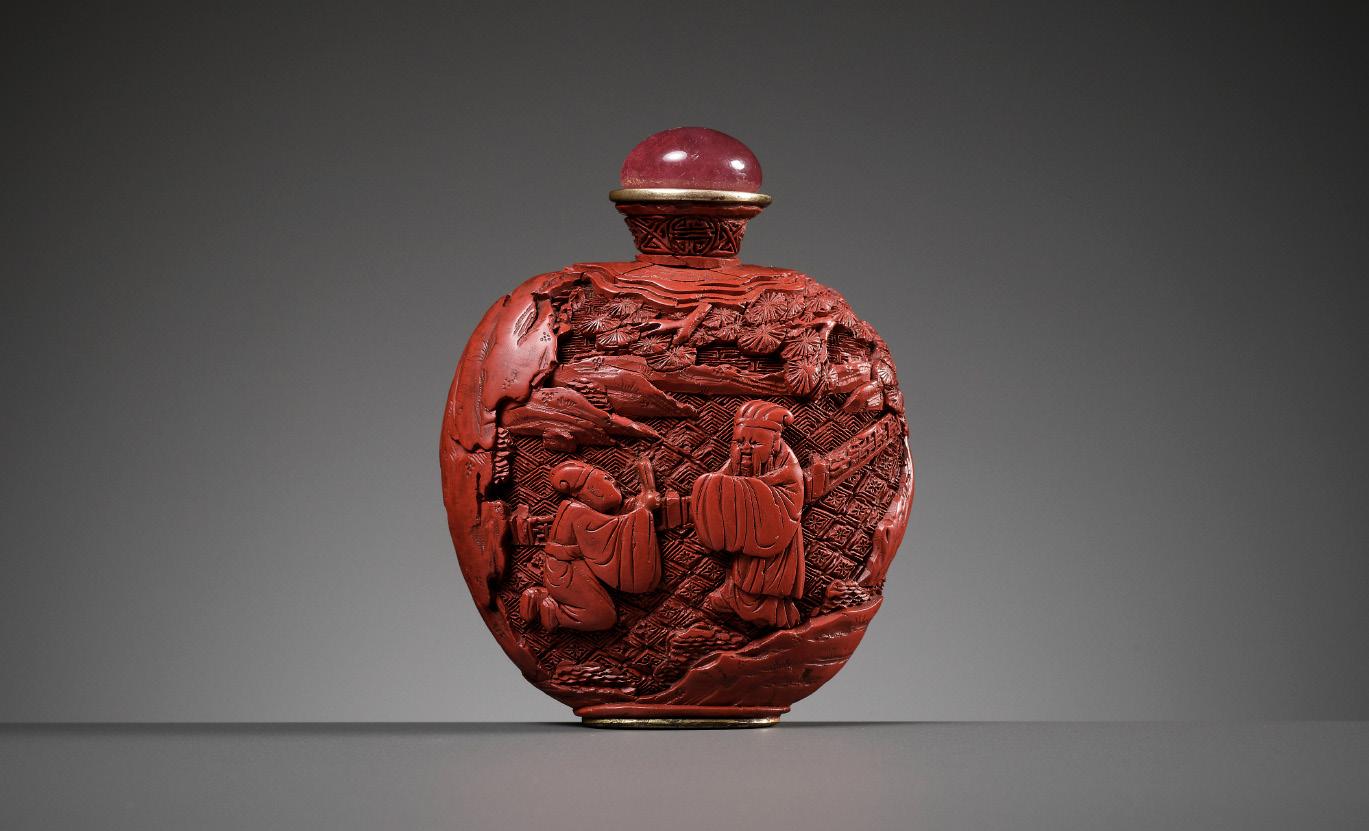


China. Of flattened ovoid form, deeply carved through the layers of cinnabar lacquer with a continuous landscape scene divided by rockwork and a pine tree into two separate subjects, one with a pupil kneeling in front of his teacher in a fenced garden, the other with a man offering fruit to his companion carrying a long stick, all on a variety of diaper grounds.
Provenance: From an English private collection. Condition: Good condition with minor wear, expected small age cracks, minuscule nicks, and few tiny losses.
Stopper: Pink glass
Weight: 81.6 g
Dimensions: Height incl. stopper 75 mm. Diameter neck 20 mm and mouth 7 mm
This is a classic imperial lacquer snuff bottle on bronze. This group of bottles represents masterly carving in lacquer that is splendidly sculptural and covers a range of delightful subject matter usually drawn from popular dramas, operas or novels, or myths and legends. We can be sure that the group as a whole was imperial, even if we cannot be sure that every last example was made for the court. If they were for example made in Suzhou, the same workshops might have made a few pieces for private sale as well.
Literature comparison: Four cinnabar lacquer bottles from this group carved with figural scenes are in the Qing Court Collection in the Palace Museum, Beijing, and are illustrated in Masterpieces of Snuff Bottles in the Palace Museum, Beijing, 1995, pp. 187-90, nos. 192-95. Another is illustrated in Moss, Graham, Tsang, A Treasury of Chinese Snuff Bottles, The Mary and George Bloch Collection, Vol. 7, Part 1, Hong Kong, 2009, pp. 175-82, no. 1538.
AUCTION RESULT COMPARISON
Type: Closely related
Auction: Bonhams New York, 20 March 2012, lot 66
Price: USD 25,000 or approx. EUR 31,000 converted and adjusted for inflation at the time of writing
Description: A carved cinnabar lacquer snuff bottle, probably Imperial, possibly Palace workshops, 1730-1820

Expert remark: Note the size (5.7 cm)
AUCTION RESULT COMPARISON
Type: Closely related
Auction: Christie’s New York, 22 March 2007, lot 7
Price: USD 20,400 or approx. EUR 28,000 converted and adjusted for inflation at the time of writing
Description: A fine carved lacquer snuff bottle, probably Imperial, attributed to the Palace workshops, Beijing, 1730-1820
Expert remark: Note the size (6.35 cm)
Estimate EUR 2,000
Starting price EUR 1,000
85 57
RARE ‘HUNDRED SHOU-CHARACTER’ BAMBOO VENEER SNUFF BOTTLE, ZHUHUANG
China, 1750-1800. Of rounded spade shape, with plain narrow sides tapering towards the flat foot, the slightly flared neck of rectangular section, each main face neatly carved with 50 shou characters. The matching bamboo stopper with veneer surmounted by a ball shaped finial. The bamboo with a naturally grown, golden-brown patina overall.
Provenance: Robert C. Eldred Co., 10 December 2004, lot 495. A private collection in the United States, acquired from the above. Eldred’s is the oldest continuously operating auction house in New England, founded in 1947 by Robert C. Eldred, Sr. In 1978, his son Robert C. Eldred, Jr. became President of the company, leading it for over three decades until his retirement in 2014.

Condition: Excellent condition with expected old wear and minor traces of use.
Stopper: Bamboo, bone spoon
Weight: 14.6 g
Dimensions: Height including stopper 65 mm. Length neck 13 mm and mouth 6 mm
This bottle belongs to a group of bamboo bottles of distinctive type, apparently developed in the Beijing Palace workshops during the late 18th century.

Bamboo veneer, or zhuhuang, was a technique developed in Jiangxi province in the mid-Qianlong period and taken up by the Palace Workshops thereafter remaining popular at the Court well into the 19th century. It required tremendous skill, using the inner layer from the cortex of the bamboo, which was resistant to insects, to create the veneer. This was then decoratively applied to a base form, usually also made of bamboo, and subsequently carved.
The subject of the present bottle, the 100 shou longevity characters, is appropriately matched with the bamboo medium as the grass is known for its long life. A bamboo veneer bottle such as this would have been appropriate for a scholar-official in the court, because bamboo is also representative of the attributes of a gentleman, being strong, yet flexible, and evergreen (symbolizing constancy).
Literature comparison: A bottle of the identical design is in the collection of the Palace Museum in Beijing and illustrated in Masterpieces of Snuff Bottles in the Palace Museum, Beijing, 1995, fig. 186, p. 181. Another identical bottle, from the collection of Denis Low, is illustrated in Robert Kleiner, Treasures from the Sanctum of Enlightened Respect, Hong Kong, fig. 207, 1999, p. 242. This spade-shaped example probably bears the closest comparison to two moon-flask bottles illustrated in Snuff Bottles in the Collection of The National Palace Museum, Taipei, 1992, Catalogue, nos. 414 and 415, p. 271.
AUCTION RESULT COMPARISON
Type: Closely related
Auction: Sotheby’s New York, 14 September 2010, lot 96
Price: USD 46,875 or approx. EUR 60,500 converted and adjusted for inflation at the time of writing
Description: A rare bamboo veneer ‘hundred shou character’ snuff bottle

Expert remark: Compare the closely related form, decoration, and material. Note the size (54 mm).
Estimate EUR 6,000
Starting price EUR 3,000
86 58 A
Robert C. Eldred Co. (1943-2016), President and CEO of Eldred’s between 1978-2014
A WHITE JADE ‘BAT’ SNUFF BOTTLE, 1730-1850

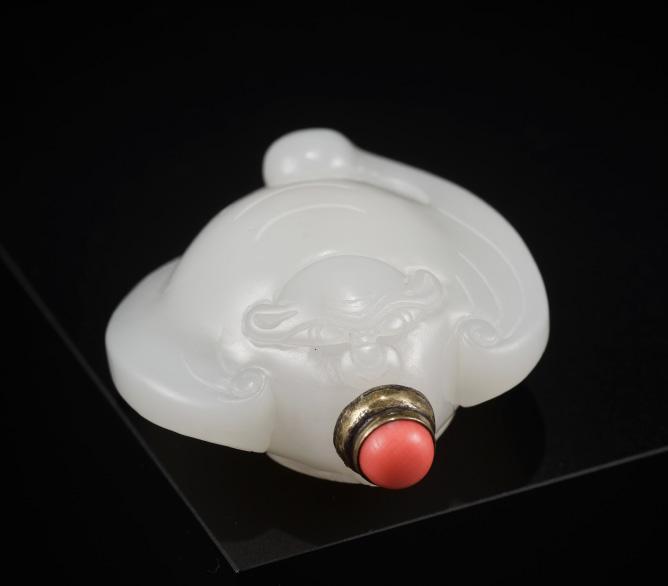
China. Well hollowed, carved in the form of a bat, each side with a face, incised with bulging eyes above a protruding snout, the body flanked by wings curling along the body and forming the foot of the bottle. The translucent stone of a beautiful white color with scattered icy inclusions.
Provenance: From a private collection in Pennsylvania, USA. The collection was assembled over a period of 30 years specializing primarily in glass, jade and hardstone snuff bottles.
Condition: Very good condition with minor wear and few minuscule nibbles here and there.
Stopper: Coral with gilt metal collar, metal spoon
Weight: 77.3 g
Dimensions: Height including stopper 58 mm. Diameter mouth 5 mm
Literature comparison: This rare bat-form bottle seems to fit into the group of superbly carved, very well hollowed animal-form bottles represented by related bottles from the Bloch collection, sold at Bonhams Hong Kong, 28 May 2010, lot 19, 23 November 2010, lot 113, and 25 May 2011, lot 118. The material is rather similar, as are the quality of the carving, degree of hollowing, soft matte polish, and the fact that the mouth of the bottle is drilled straight through the detailing of the bat’s mouth.
AUCTION RESULT COMPARISON
Type: Closely related
Auction: Sotheby’s Hong Kong, 26 May 2013, lot 156
Price: HKD 100,000 or approx. EUR 15,500 converted and adjusted for inflation at the time of writing
Description: A white jade ‘bat’ snuff bottle, Qing dynasty, mid-18th / mid-19th century

Expert remark: Compare the closely related form, the color of the jade, and size (57 mm)
Estimate EUR 3,000
Starting price EUR 1,500
87 59
60 A SAPPHIRE-BLUE OVERLAY ‘MONKEY KING STEALING THE PEACHES OF IMMORTALITY’ GLASS SNUFF BOTTLE

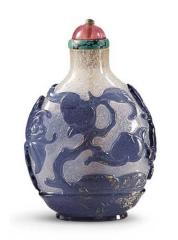
China, c. 1700-1780, probably Imperial, attributed to the Palace Workshops, Beijing. Of compressed globular form, supported on a wide oval foot with recessed base, and cylindrical neck flaring slightly towards the rim, carved through the sapphire blue layer to the bubble suffused ‘snowflake’ ground, one side depicting a crane striding through lotus, water, and rockwork, the reverse with a monkey perched on a branch bearing peaches, decorated with a butterfly, bat, and lingzhi, the neck encircled by a band of stiff leaves.

Provenance: From a private collection in Pennsylvania, USA. The collection was assembled over a period of 30 years specializing primarily in glass, jade and hardstone snuff bottles.
Condition: Minor wear, few nibbles to rim and foot, minor manufacturing irregularities, possibly with a small repair to the neck.
Stopper: Glass in imitation of jadeite
Weight: 64.1 g
Dimensions: Height including stopper 74 mm. Diameter neck 16 mm and mouth 8 mm
Homophones for monkey, hou, include the Chinese words for ‘nobleman’, ‘high official’, and ‘descendants’. The monkey therefore represents the wish for the success of one’s descendants. The representation of monkey and peach relates to the legendary Sun Wukong, also known as the Monkey King, who stole the peaches of immortality. Similarly, the crane is a symbol of longevity, as the animal has a life expectancy of more than 20 years. Therefore, the present lot bestows auspicious wishes for success and longevity for generations.
AUCTION RESULT COMPARISON
Type: Related
Auction: Christie’s New York, 29 March 2006, lot 55
Price: USD 24,000 or approx. EUR 33,500 converted and adjusted for inflation at the time of writing
Description: A Rare Blue Overlay ‘Fruit Bowl’ Glass Snuff Bottle
Expert remark: Compare the form, the superb quality of the carving, the translucent sapphire-blue overlay on snowflake ground, and the peach subject.
AUCTION RESULT COMPARISON
Type: Related
Auction: Christie’s Hong Kong, 5 April 2004, lot 826
Price: HKD 262,900 or approx. EUR 49,500 converted and adjusted for inflation at the time of writing
Description: A Very Rare Blue Overlay BubbleSuffused Glass Snuff Bottle
Expert remark: Compare the form, the superb quality of the carving, the translucent sapphire-blue overlay on snowflake ground, and the peach subject.
Estimate EUR 3,000
Starting price EUR 1,500
88
61
AN UNDERGLAZE-BLUE AND COPPER-RED ‘FIVE MONKEYS’ SNUFF BOTTLE, DAOGUANG MARK AND PERIOD
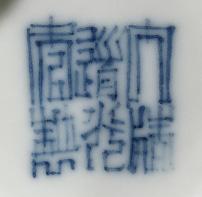

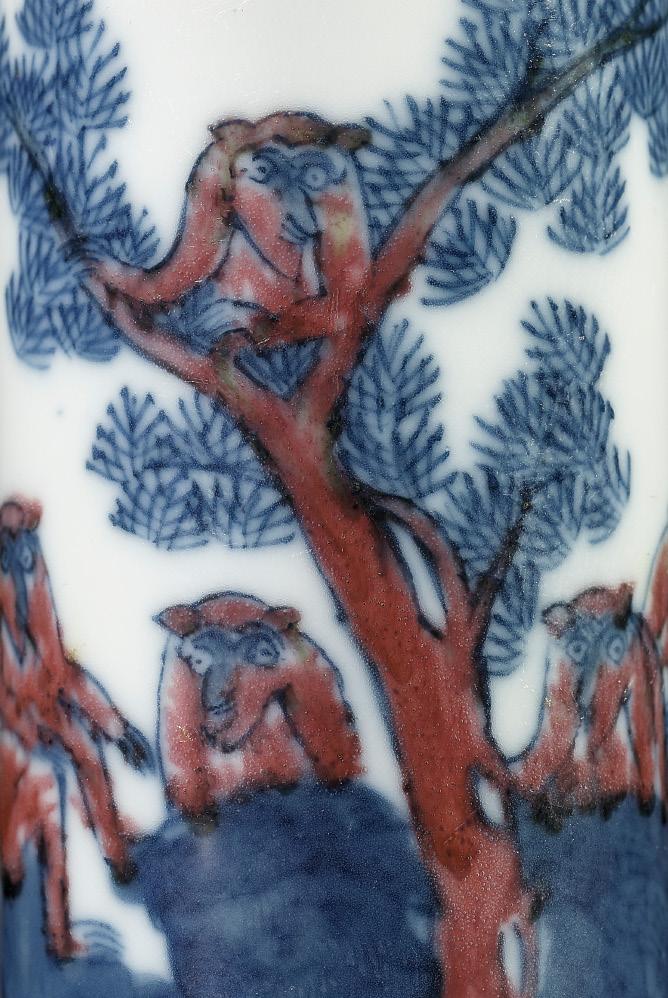
China, Jingdezhen kilns, 1820-1850. Of cylindrical form with straight neck, finely painted in cobalt blue and copper red with four monkeys seated on craggy rocks below a further monkey peeking out from the branches of a pine tree, their faces with comical expressions, circular eyes, and long noses. The recessed base with an underglaze-blue six-character mark da Qing Daoguang nianzhi and of the period.
Provenance: Swiss trade.
Condition: Very good condition with minor wear, the stopper with minor nibbling.
Stopper: Stained bone in imitation of coral, good spoon
Weight: 57.9 g
Dimensions: Height including stopper 99 mm. Diameter neck 13 mm and mouth 8 mm
The homophone for monkey, hou, one of the twelve zodiac animals, is ‘nobleman’ or ‘high official’ as well as ‘descendants’. The monkey therefore represents the wish for the success of one’s descendants.
AUCTION RESULT COMPARISON
Type: Related
Auction: Bonhams Hong Kong, 25 May 2011, lot 88
Price: HKD 50,400 or approx. EUR 8,300 converted and adjusted for inflation at the time of writing
Description: A blue and white porcelain ‘monkeys’ snuff bottle, Jingdezhen, 1800-1860

Expert remark: Compare the related form and motif. Note the lack of copper-red and the fact that there is no reign mark.
Estimate EUR 2,000
Starting price EUR 1,000
89
A VERY LARGE AND RARE BLACK POTTERY AMPHORA WITH APPLIED GILT-BRONZE BOSSES, LIFAN, HAN DYNASTY
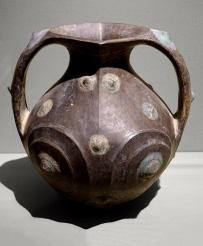
Scientific Analysis Report: A thermoluminescence analysis report issued by Oxford Authentication on 4 May 2022, based on sample number C122d90, sets the firing date of two samples taken at between 1500 and 2400 years ago. A copy of the report, issued by Oxford Authentication, accompanies this lot. A copy of an associated report from Antiques Analytics, Institute for Scientific Authenticity Testing, dated 4 May 2022, written and signed by Dr. Robert Neunteufel, accompanies this lot.

China, 202 BC to 220 AD. Heavily potted, the lozenge-form mouth rim tapering to form two wide strap handles above the neck with a finely incised and red-painted striated band to either side, the interior mouth with red paint as well. The ovoid body centered by spiral designs. Applied overall with conical metal bosses with beaded decoration.
Provenance: From the private collection of Dr. Rudolf Leopold, and thence by descent. Dr. Rudolf Leopold (1925-2010) was an Austrian physician and important collector of art. He was born in Vienna and started actively collecting in the mid-1950s, with an early and major focus being works by Egon Schiele, whose paintings were available inexpensively at the time. Leopold acquired a catalog of Schiele’s work in 1950 and became enamored with the artist’s work, despite the fact that he was distinctly out of fashion. Pieces that he bought for little money would later be worth millions. Other Austrian artists he collected included Gustav Klimt and Oskar Kokoschka. A substantial part of his collection, numbering around 5,000 works of art, was purchased by the Republic of Austria and used as the foundation to create the Leopold Museum, of which the collector was made a director for life. Dr. Rudolf Leopold was also a passionate collector of Chinese works of art.
Condition: Very good condition, commensurate with age. Old wear, minor firing cracks and other irregularities, small nicks here and there, the bosses with malachite and cuprite encrustations, drilled holes from sample-taking, some old repairs and minor touchups, all exactly as expected from an authentic piece with this age.
Weight: 15.8 kg
Dimensions: Height 58.5 cm
The surface of the vessel has been shaped with tools and then burnished. This process of manufacture gives the jar its attractively rugged, yet carefully detailed and distinctive characteristics. The surface of the body is an amalgamation of complex curves with various convex and concave shapes.
This type of black earthenware amphora was produced from the Warring States period and throughout the Han dynasty. It is assumed that the largest versions of these vessels, sumptuously embellished with gilt bronze bosses, were made during the pinnacle of this era, e.g. during the first half of the Han dynasty. As noted by Regina Krahl in Yuegutang, A Collection of Chinese Ceramics in Berlin, 2000, page 55, amphorae of this distinct type are characteristic products of the Western Sichuan province where they were made by non-Chinese peoples. Hence, this type of vessel is known as Lifan, named after the area of Sichuan province in the far west of China, in which such jars have been found.
There are obvious stylistic similarities between these Lifan vessels and objects from much earlier periods such as the Neolithic cultures of Machang (c. 3000-2000 BC) and Xindian (c. 1500-1000 BC). Similar black ware food containers with two handles have also been unearthed in Dena County, Yunan, an area that was the home of the southwestern Yi tribe during the Spring and Autumn period.
Expert’s note: The present lot is an extremely rare example of an enigmatic type of ware. The most striking features of this amphora are its massive size and applied gilt-bronze bosses; the examples recorded in public and private collections are significantly smaller and most lack the bosses. It therefore seems very likely that only very few Lifan amphoras of this size were ever made, and even fewer have survived. In any case, this amphora is the first of its kind to appear on the market in a very long time.
LITERATURE COMPARISON
Compare a related Lifan amphora with applied gilt-bronze bosses, dated to the Western Han dynasty, previously exhibited in the Portland Art Museum (fig. 1). Compare a related Lifan amphora, lacking the bronze bosses, 34.3 cm high, dated Warring States period to Han dynasty, in the Nelson-Atkins Museum of Art, object number F98-9. fig. 1
AUCTION RESULT COMPARISON
Type: Closely related
Auction: Galerie Zacke, Vienna, 5 March 2021, lot 138

Price: EUR 56,880 or approx. EUR 64,500 adjusted for inflation at the time of writing
Description: A black pottery amphora with applied bronze bosses, Han dynasty Expert remark: Compare the closely related form and decoration. Note that the applied bronze bosses are not gilt, as opposed to those on the present lot, and that the amphora is of significantly smaller size (33 cm).

Estimate EUR 14,000
Starting price EUR 7,000
90 62
Dr. Rudolf Leopold in front of Gustav Klimt’s famous painting “Death and Life”


63
A DUCK-HEADED PAINTED POTTERY VESSEL, HAN DYNASTY
China, 2nd century BC to 2nd century AD. The bulbous body raised on a spreading foot ring and surmounted by an arched neck terminating in a duck head, neatly detailed with round eyes and a long beak, a rimmed aperture in the top of the head, the vessel finely painted in red, black, and white with feathers and geometric decorations between horizontal bands.
Provenance: From the collection of Joseph Rondina (1927-2022), who was born into a first-generation Florentine-American family in Auburn, upstate New York. Returning to the U.S. after being stationed in Berlin at the end of the Second World War, he studied at the Whitman School of Design before opening Joseph Rondina Antiques on Madison Avenue in Manhattan’s Upper East Side in 1957. In the beginning, his interests focused primarily on European 18thcentury decorative arts and furniture, over time developing to include Chinese, Korean, Indian, Thai, Cambodian, Persian and Japanese art, bringing a more esoteric and exotic style to the market. His clientele included stars of the stage and screen, royalty, notables, dignitaries, and denizens of the social register from the United States and abroad.

Condition: Excellent condition, commensurate with age. Old repairs and minor touchups as generally expected from authentic Han dynasty excavations. Wear, flaking, losses to pigment, small nicks, minor chips, light scratches, soil encrustations.
Weight: 3,364 g
Dimensions: Height 31.5 cm
LITERATURE COMPARISON
Compare a related goose-headed vessel, 34.8 cm high, dated to the Western Han dynasty, in the Metropolitan Museum of Art, accession number 1994.605.17. A closely related vessel in the NelsonAtkins Museum of Art is illustrated in A Handbook of the Collection, New York, 1993, p. 286 (upper left). Compare the smaller (21 cm) pair of painted pottery ducks dated to the Han dynasty, 1st century BC or 1st century AD, in the Meiyintang Collection, illustrated by Regina Krahl in Chinese Ceramics in the Meiyintang Collection, London, vol. 1, London, 1994, p. 49, fig. 14. Like the present vessel, the Meiyintang vessels also have apertures at the top.
AUCTION RESULT COMPARISON
Type: Closely related
Auction: Christie’s, 21 March 2000, lot 239
Price: USD 6,900 or approx. EUR 11,500 converted and adjusted for inflation at the time of writing
Description: A grey pottery duck-headed vessel, Warring States period/Western Han dynasty
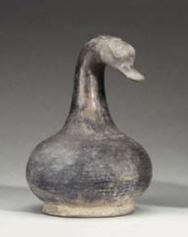

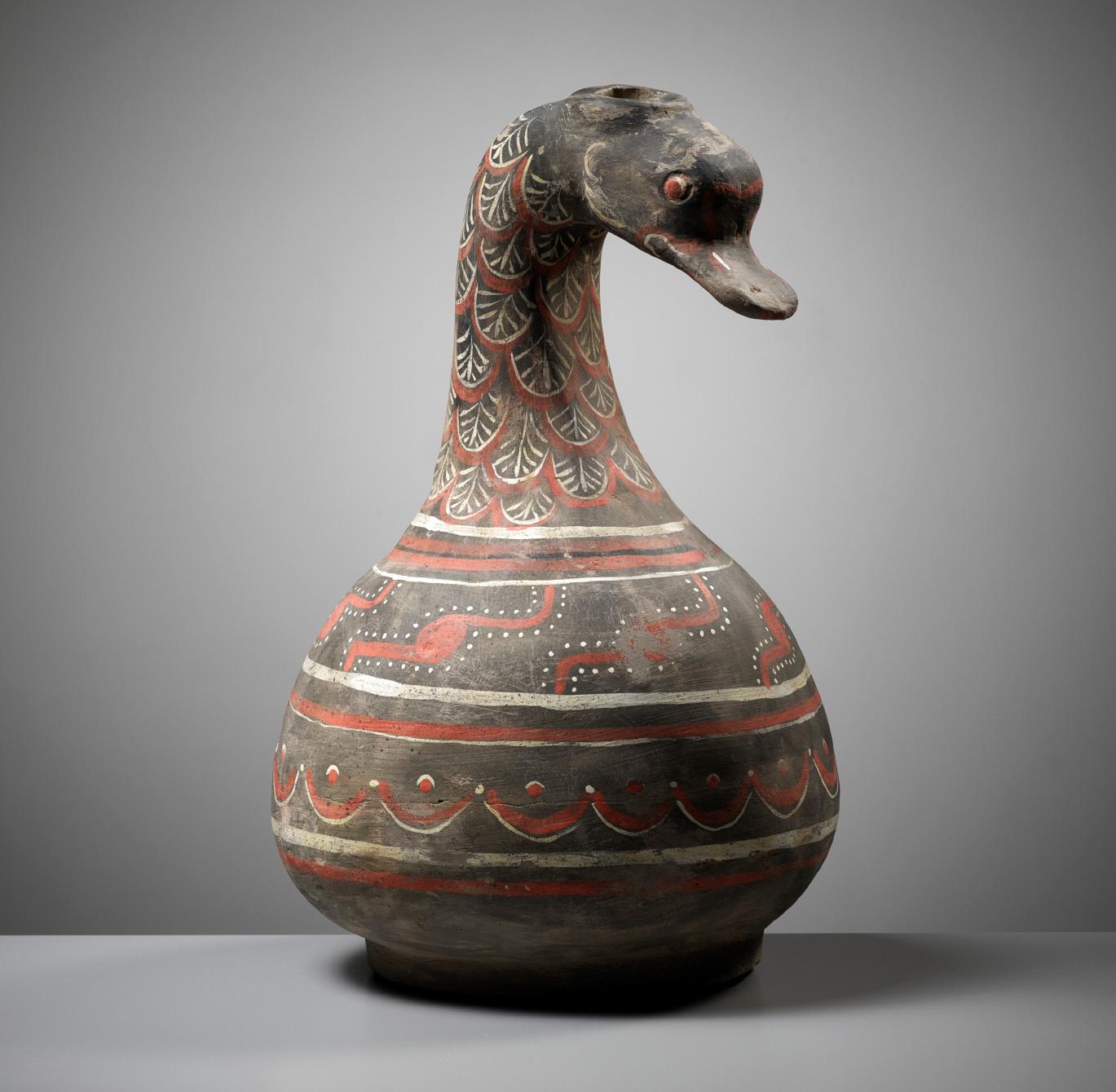
Expert remark: Compare the closely related form with a similar aperture in the top of the head. Note this vessel shows only faint traces of pigment as opposed to the present lot. Note the similar size (33 cm).
Estimate EUR 4,000
Starting price EUR 2,000
93
Joseph Rondina standing at the entrance of his store on Madison Avenue

A PAIR OF LARGE PAINTED POTTERY SQUARE VASES AND COVERS, FANGHU, HAN DYNASTY
China, 202 BC to 220 AD. Each with a facetted pear-shaped body supported on a tall foot and rising to a gently waisted neck with everted rim surmounted by a faceted cover. Each vase is applied at the shoulders with two impressive taotie masks suspending loose rings. Exquisitely painted to each side of the body with two swirling designs in pale green and lavender, below pendent stiff leaves in red and white alternating with hooked designs in pale green at the neck, framed by horizontal bands, the covers similarly painted. (4)
Provenance: Collection of Joseph Rondina. Joseph Rondina (1927-2022) was born into a first-generation Florentine-American family in Auburn, upstate New York. Returning to the U.S. after being stationed in Berlin at the end of the Second World War, he studied at the Whitman School of Design before opening Joseph Rondina Antiques on Madison Avenue in Manhattan’s Upper East Side in 1957. In the beginning, his interests focused primarily on European 18thcentury decorative arts and furniture, over time developing to include Chinese, Korean, Indian, Thai, Cambodian, Persian and Japanese art, bringing a more esoteric and exotic style to the market. His clientele included stars of the stage and screen, royalty, notables, dignitaries, and denizens of the social register from the United States and abroad.

Condition: Good condition, commensurate with age. Old repairs and minor touchups as generally expected from Han dynasty excavations. Wear, flaking, losses and fading to pigment, small nicks, minor chips, light scratches, encrustations. One of the four loose rings broken and restored.
Weight: 8,124 g and 8,352 g
Dimensions: Height 51.5 cm and 50.2 cm
Expert’s note: Expressive polychrome designs on ancient archaic wares from China, such as those on the present lot, are said to have inspired the Art Deco movement in Europe. A good example for this theory may be the advertising design work of noted architect Henry van der Welde (1863 Antwerp – 1957 Zurich).
Advertising design for Tropon, 1898, by Henry van der Welde (1863–1957)

Bronze and lacquer ritual Fanghu vessels were expensive commodities that only the privileged class could afford, but in the Han dynasty, ceramic funerary wares that simulated these luxurious objects became a more affordable means of outfitting one’s tomb, as a finished ceramic piece required far less fuel and specialized labor than its bronze or lacquer prototype. Fired at relatively low temperatures, earthenware vessels are not fully vitrified and are slightly porous, making them less than ideal as containers for daily use, but suitable as burial items. Only very few colored compounds can withstand kiln temperatures without alteration. In order to replicate the multiple bright colors and dynamic designs of painted lacquers, durable mineral pigments were applied to earthenware vessels after firing, hence the term ‘cold-painted.’
LITERATURE COMPARISON
Compare a related painted pottery fanghu and cover, painted with taotie masks, 55.1 cm high, dated to the Western Han dynasty, in the Harvard Art Museums (acquired from J.J. Lally & Co.), object number 1990.85 (fig. 1). Compare a related pair of painted pottery fanghu and covers, dated to the Western Han dynasty, in the Musée Cernuschi, Paris, object number MC 9915. fig. 1
AUCTION RESULT COMPARISON
Type: Related
Auction: Christie’s New York, 20 March 2015, lot 782
Price: USD 21,250 or approx. EUR 25,500 converted and adjusted for inflation at the time of writing
Description: A large painted grey pottery faceted pear-shaped jar and cover, Fanghu, China, Western Han dynasty


Expert remark: Compare the related form and manner of painting. Note the size (56 cm).
Estimate EUR 8,000
Starting price EUR 4,000
95 64
Joseph Rondina standing at the entrance of his store on Madison Avenue
A LARGE GREEN-GLAZED RED POTTERY FIGURE OF A DOG, HAN DYNASTY
Scientific Analysis Report: A thermoluminescence analysis report issued by Oxford Authentication on 28 March 2022, based on sample number C122d95, sets the firing date of two samples taken at between 1400 and 2200 years ago. A copy of the report, issued by Oxford Authentication, accompanies this lot. A copy of an associated report from Antiques Analytics, Institute for Scientific Authenticity Testing, dated 4 May 2022, written and signed by Dr. Robert Neunteufel, accompanies this lot.
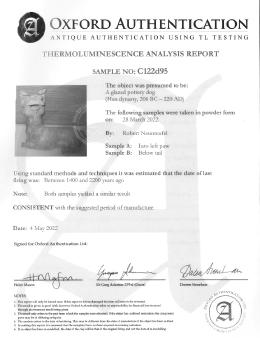
China, 206 BC to 220 AD. Powerfully modeled in a recumbent position with a tall, thick-set neck with several horizontal ribs, surmounted by an animated head raised in an alert attitude to one side, the mouth open to reveal a tongue flanked by two sharp teeth, the large and distinctive ears folding inwards. The body covered overall with an emerald-green glaze save for the underside. Also note the neatly curved short tail.
Provenance: From the private collection of Dr. Rudolf Leopold, and thence by descent. Dr. Rudolf Leopold (1925-2010) was an Austrian physician and important collector of art. He was born in Vienna and started actively collecting in the mid-1950s, with an early and major focus being works by Egon Schiele, whose paintings were available inexpensively at the time. Leopold acquired a catalog of Schiele’s work in 1950 and became enamored with the artist’s work, despite the fact that he was distinctly out of fashion. Pieces that he bought for little money would later be worth millions. Other Austrian artists he collected included Gustav Klimt and Oskar Kokoschka. A substantial part of his collection, numbering around 5,000 works of art, was purchased by the Republic of Austria and used as the foundation to create the Leopold Museum, of which the collector was made a director for life. Dr. Rudolf Leopold was also a passionate collector of Chinese works of art.
Condition: Good condition, commensurate with age. Displaying exceptionally well. Extensive wear, firing flaws, some losses and associated old repairs, small chips, few structural cracks, signs of weathering and erosion, encrustations, a drilled hole from sampletaking, all exactly as expected from Han dynasty excavations of this rather large size.
Weight: 5.4 kg
Dimensions: Height 42.9 cm
Expert’s note: It is rare to find Han glazed pottery figures of dogs of this exceptionally large size. The present example is also unusual for its animated expression, literally as if greeting its owner.
Literature comparison: Compare a related large figure of a dog in the Shanghai Museum, illustrated in Zhongguo taoci quanji, vol. 3, Shanghai, 2000, pl. 173. For another example, unearthed at Nanyang, Henan province, see the Nanyang Municipal Museum, in the exhibition China 5000 Years: Innovation and Transformation in the Arts, Guggenheim Museum, New York, 1998, cat. no. 101. Compare a related pottery dog excavated from an Eastern Han tomb in the northern suburbs of Yichang, Hebei, illustrated in Kaogu Xuebao, 1976:2, pl. 12, fig. 3.
AUCTION RESULT COMPARISON
Type: Closely related
Auction: Christie’s Hong Kong, 6 October 2015, lot 70
Price: HKD 200,000 or approx. EUR 28,000 converted and adjusted for inflation at the time of writing
Description: A green-glazed pottery figure of a dog, Eastern Han dynasty (25-220)


Expert remark: Compare the closely related pose and glaze. Note the much smaller size (26 cm).
AUCTION RESULT COMPARISON
Type: Closely related
Auction: Sotheby’s New York, 19 March 2007, lot 591

Price: USD 36,000 or approx. EUR 49,500 converted and adjusted for inflation at the time of writing
Description: A green-glazed red pottery figure of a dog Han dynasty
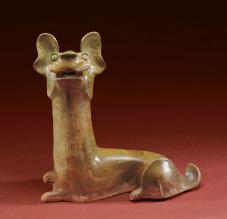
Expert remark: Compare the closely related pose and glaze. Also note the near identical size (43 cm).
Estimate EUR 8,000
Starting price EUR 4,000
65
Dr. Rudolf Leopold in front of Gustav Klimt’s famous painting “Death and Life”

A RARE SANCAI-GLAZED POTTERY FIGURE OF A SEATED COURT LADY, TANG DYNASTY
China, 618-906. Well modeled seated on a waisted stool, poised with one hand at the waist holding a lotus flower, the other arm along the torso. The long gown glazed in alternating swaths of bright green and amber, crisply modeled with vertical stripes enclosing trefoil florets, the amber glazed décolleté bodice with a blue glazed hem and green glazed sleeves, two blue glazed shoes peeking out under the dress. The unglazed face with painted features framed by an elaborate coiffure, parted at the center and swept up to either side into a double-topknot.
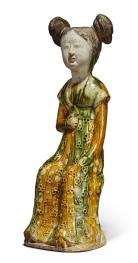

Provenance: British trade.
Condition: Overall good condition, commensurate with age and presenting very well. Extensive wear, minor losses, firing cracks, glaze flakes, small chips, old repairs, the seat with an aperture for steaming drilled before the firing and with minor associated nibbles, all exactly as expected from authentic Tang dynasty excavations.
Weight: 1,307 g
Dimensions: Height 37.1 cm
This particularly charming figure is rare due to it being applied with the precious cobalt-blue glaze. The application of this expensive glaze suggests that the original owner was one of wealth and privilege. The present figure combines an elaborately decorated dress with hair simply bunched on either side of the head in a style more usually associated with younger girls. This gives a rather endearing impression of a young girl in her best clothes. In her introduction to the Exhibition of Tang Sancai Pottery Selected from the Collection of Alan and Simone Hartman, Margaret Medley notes that a similarly dressed standing figure with hair in side-bunches was that of a ‘young adolescent girl’.

The source of manufacture for these figures has proven difficult to identify. Among figural representations, sancai-glazed sculptures of seated ladies are relatively rare and to date it appears that there were very few kilns known to produce sancai-glazed statues at all. The Gongyi (Gongxian) kilns in Henan province in north China are well known as the producers of China’s finest sancai lead-glazed wares, but excavations at the site have revealed few figural remains. A misfired sancai-glazed lady, seated and holding a duck-form vessel, was discovered at the Liquanfang kilnsite in Chang’an, illustrated in Lu Junmao & Zhang Guozhu, Fragmentary Ceramics of Ancient Xi’an, Xi’an, 2003, page 8, which is of similar form to a sancai figure unearthed from the tomb of Li Du and his wife in Changzhi, Shanxi, dated to AD 710, illustrated in Hsie Mingliang, Zhongguo gudai qianyoutao de shijie (The world of lead-glazed objects from ancient China: from the Warring States to Tang), Taipei, 2014, fig. 5.28.
LITERATURE COMPARISON
Compare a closely related sancai pottery figure of a seated court lady, 8th to 9th century, in the Phoenix Art Museum, accession number 2006.36. A nearidentical figure, seated with a related hair style and blue and amber-glazed dress, was exhibited at Sui to Tang Dynasty Art, Osaka City Museum, 1976, catalog no. 200. Another closely related female seated figure, with slightly different hair style but wearing an identical dress, is in the Nezu Museum of Art and illustrated in Selected Masterpieces from the Nezu Museum Collection, Japan, 2009, pl. 67 (fig. 1).
AUCTION RESULT COMPARISON
Type: Closely related
Auction: Sotheby’s New York, 11 September 2019, lot 741
Price: USD 27,500 or approx. EUR 30,500 converted and adjusted for inflation at the time of writing
Description: A sancai-glazed pottery figure of a seated court lady, Tang dynasty
Expert remark: Compare the closely related pose, dress, decoration, hair, and size (31.8 cm)
AUCTION RESULT COMPARISON
Type: Closely related
Auction: Christie’s Hong Kong, 29 November 2017, lot 2916
Price: HKD 1,250,000 or approx. EUR 166,000 converted and adjusted for inflation at the time of writing
Description: A very rare inscribed blue and amberglazed pottery figure of a seated lady, Tang dynasty (618-907)
Expert remark: Compare the closely related pose, dress, decoration, hair, and size (30 cm). Note the inscription to the base in black ink ‘Guang jia zhi nu zi‘, which may be translated as ‘daughter of the Guang family’.
Estimate EUR 8,000
Starting price EUR 4,000
98 66
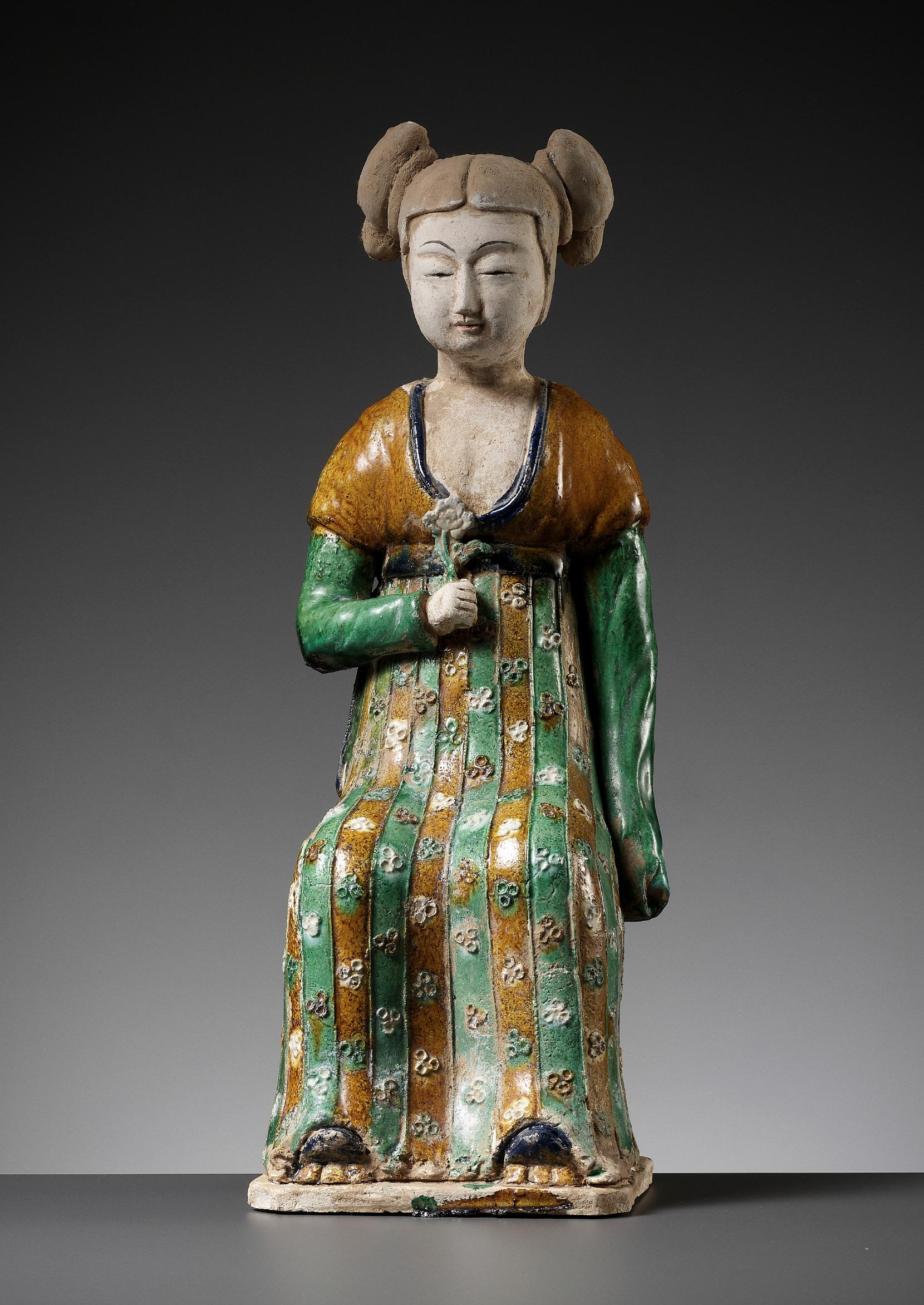
A STRAW GLAZED POTTERY FIGURE OF A TOMB GUARDIAN, SUI TO TANG DYNASTY
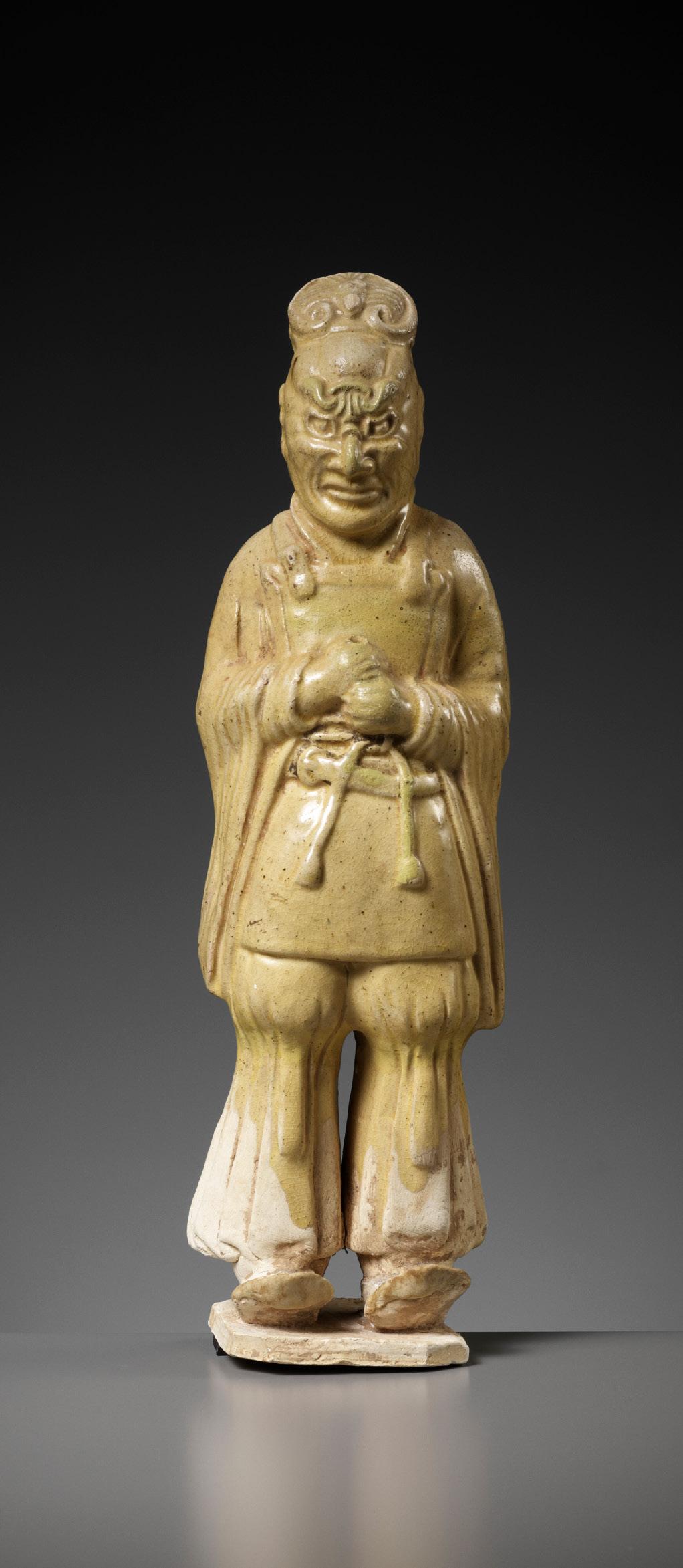
Scientific Analysis Report: A thermoluminescence analysis report issued by Oxford Authentication on 26 July 2012, based on sample number C112g85, sets the firing date of two samples taken between 1000 and 1600 years ago. A copy of the report, signed by Doreen Stoneham for Oxford Authentication, accompanies this lot.

China, 581-907. Modeled standing with his hands crossed at the chest, the face wrinkled and with an intimidating expression, dressed in armor above a robe with wide sleeves and flaring trousers, wearing a ruyi shaped headdress. Covered overall in a fine straw glaze with attractive pooling and ending irregularly above the feet.
Provenance: From an English private collection in the Peak District.
Condition: Good condition with some wear, glaze flakes, expected firing flaws, small firing cracks, few touchups to the glaze, old repairs to the feet, minuscule drilled holes from sample-taking. The hands are pierced at the top, suggesting a now-lost implement was once inserted there.
Weight: 1,582 g
Dimensions: Height 37.1 cm
LITERATURE COMPARISON
Compare a closely related figure of a guardian, 38.2 cm high, dated to the Sui dynasty, in the Brooklyn Museum, accession number 34.5652.
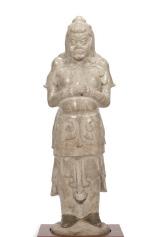

AUCTION RESULT COMPARISON
Type: Closely related
Auction: Christie’s Hong Kong, 7 June 2022, lot 3005
Price: HKD 277,200 or approx. EUR 33,500
converted at the time of writing
Description: A strawglazed pottery figure of a warrior, Tang dynasty
Expert remark: Compare the closely related pose, facial expression, and glaze. Note the size (49 cm).
Estimate EUR 4,000
Starting price EUR 2,000
67
A PAINTED POTTERY FIGURE OF A POLO PLAYER, SUI TO TANG DYNASTY
China, 581-907. Modeled sitting in a saddle on a galloping horse, her head facing forward, her hair tied into a high chignon, the face finely painted with eyes and red lips, the arms bent to swing a polo stick, the horse energetically leaping forward extending all legs to their fullest in mid-air, its mouth agape and ears pricked.
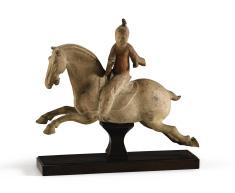
Provenance: From an old private collection in Illinois, USA.
Condition: Some repair, filling and touchups as generally expected from authentic Sui and Tang dynasty excavations. Losses, fissures, firing cracks, and encrustations, remnants of pigments. Natural wear and weathering overall.
Weight: 2,988 g (excl. stand), 4,788 g (incl. stand)
Dimensions: Length 36.8 cm
With a modern stand. (2)
The earliest literary and visual evidence of polo in China dates from the 7th and 8th centuries, including stories of polo-playing emperors and members of the imperial family. A mural depicting a game of polo, datable to the years AD 706-11, found in the tomb of Li Xian, Crown Prince Zhanghuai (AD 654-84), is discussed and illustrated by J. Fontein and Wu Tung in Han and Tang Murals, Boston, 1976, p. 101, nos. 122-25, col. pl. 15.
LITERATURE COMPARISON
Pottery figures of polo players fall into two categories: dynamic riders seated on horses shown in full “flying gallop”, with no support or stand, and elegant riders seated stiffly on horses standing on a rectangular base. The present figures belong to the first category, as do the four closely related figures of female polo players in the Nelson-Atkins Museum of Art, dated ca. 650-700, object numbers 48-31/1, 2, 3, and 4. See, also, the figure in the Tenri Museum in Japan, illustrated by Hasebe and Sato, Sekai toji zenshu, vol. 11, Tokyo, 1976, pl. 183.
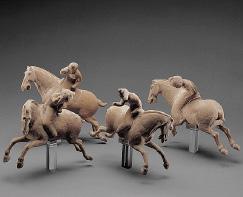
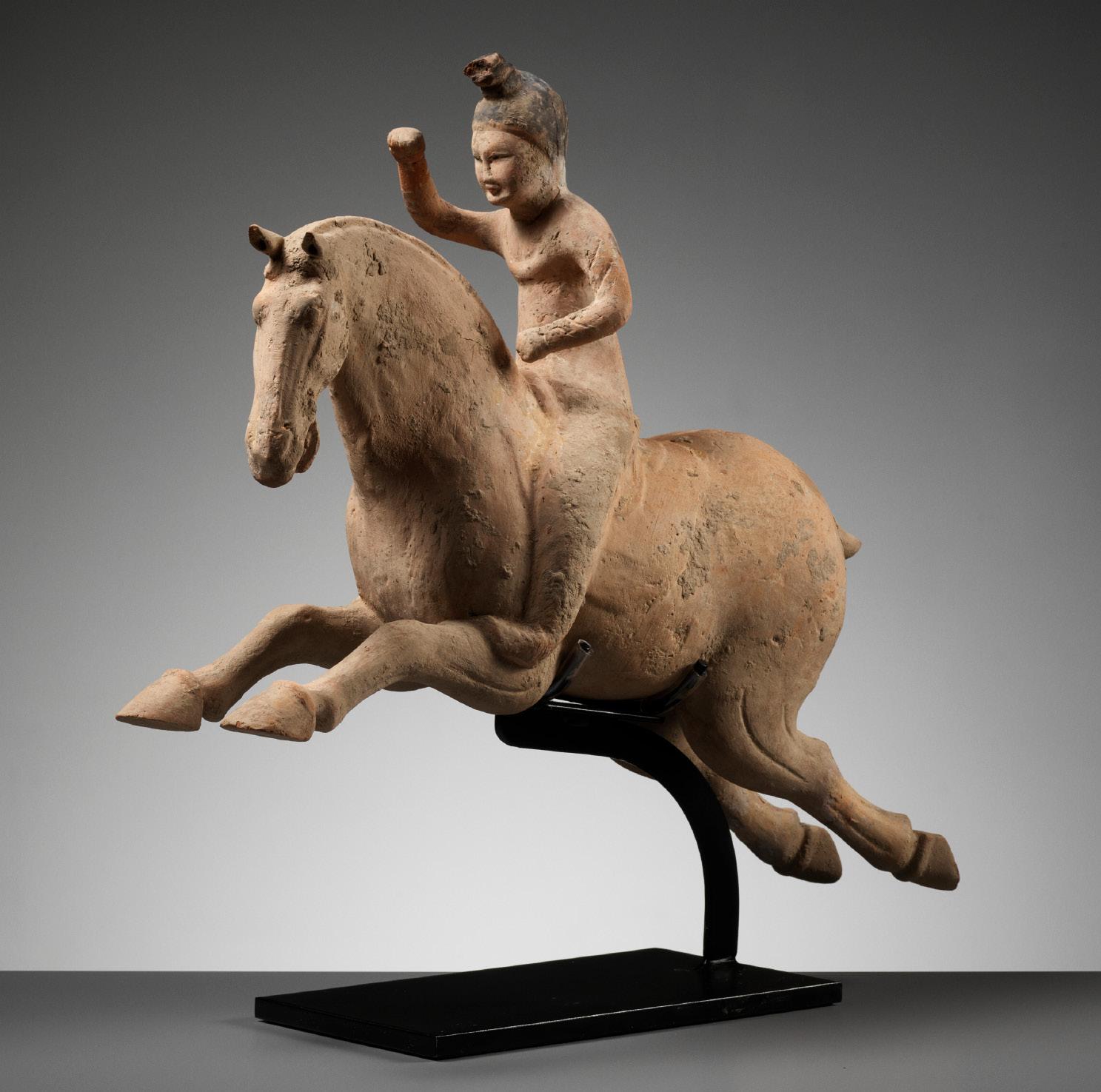
AUCTION RESULT COMPARISON
Type: Closely related
Auction: Sotheby’s Paris, 18 October 2018, lot 118
Price: EUR 16,250 or approx. EUR 19,000 adjusted for inflation at the time of writing
Description: A painted pottery figure of a polo player, Sui dynasty
Expert remark: Compare the closely related pose, pigments, and size (38 cm)
Estimate EUR 6,000
Starting price EUR 3,000
101 68
A MASSIVE PAINTED POTTERY FIGURE OF A BACTRIAN CAMEL AND SOGDIAN RIDER, TANG DYNASTY

Scientific Analysis Report: A thermoluminescence analysis report issued by Oxford Authentication on 3 February 2005, based on sample number C105a47, sets the firing date of three samples taken between 900 and 1500 years ago (one further sample contained restoration material and could not be dated). A copy of the report, signed by Doreen Stoneham for Oxford Authentication, accompanies this lot.
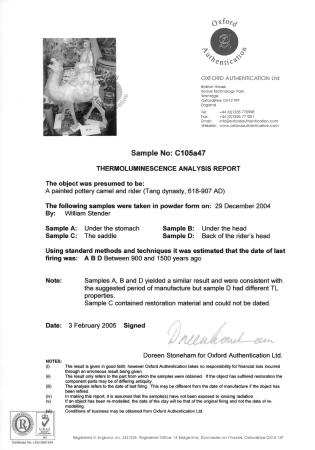
China, 618-907. The large camel is modeled with its head slightly turned to the left, protruding eyes, flaring nostrils and ears lying against its neck, its mouth held wide open with the tongue in the center. A detachable saddle bag hangs between its humps and is surmounted by a bearded Turk or Sogdian rider, wearing a distinctively pointed hat, with one arm raised to hold the reins.
Provenance: From the collection of Joseph Rondina (1927-2022), who was born into a first-generation Florentine-American family in Auburn, upstate New York. Returning to the U.S. after being stationed in Berlin at the end of the Second World War, he studied at the Whitman School of Design before opening Joseph Rondina Antiques on Madison Avenue in Manhattan’s Upper East Side in 1957. In the beginning, his interests focused primarily on European 18thcentury decorative arts and furniture, over time developing to include Chinese, Korean, Indian, Thai, Cambodian, Persian and Japanese art, bringing a more esoteric and exotic style to the market. His clientele included stars of the stage and screen, royalty, notables, dignitaries, and denizens of the social register from the United States and abroad.

Condition: Some old repairs and touchups as generally expected from Tang dynasty excavations. Losses, fissures, and encrustations. Drilled holes from sample-taking. Overall very good condition.
Dimensions: Height 84.3 cm
The Tang dynasty is undoubtedly one of the most artistically exciting periods in China’s long history. The arts are characterized by their diversity, the cosmopolitan nature of their design and the high technical skill employed in their manufacture as this pottery example amply demonstrates. In the first half of this dynasty, up to the An Lushan rebellion of 756, the level of luxury enjoyed by the court and the Tang elite ensured the production of a wide range of goods of the highest quality. As China prospered as a result of trade with the west along the famous Silk Road, camels became increasingly important for the transport of wares, since these impressive
animals could carry heavy loads over long distances, surviving several days without water. As their large and broad feet did not sink easily into the sand, they became known as ‘the ships of the desert’. Many camels were imported from the states of the Tarim basin, Eastern Turkmenistan and Mongolia and are known as Bactrian camels. The Tang civil servants created a special office to supervise their breeding and services. It seems that no pottery examples showing Chinese riders have been excavated. Perhaps only the Central Asian foreigners were able to tame and guide the camels.
Literature comparison: A related large painted pottery group of camel and foreign rider, dressed in a fur coat and wearing a large pointed hat, excavated from the tomb of Wang Chen (buried 679), Changzhi, Shaanxi province in 1954 and now in the Museum of Chinese History, Beijing, is illustrated by Li Jian (ed.), The Glory of the Silk Road, Art from Ancient China, The Dayton Art Institute, 2003, p. 170, pl. 85.
AUCTION RESULT COMPARISON
Type: Closely related
Auction: Christie’s London, 5 November 2019, lot 4
Price: GBP 75,000 or approx. EUR 99,000 converted and adjusted for inflation at the time of writing
Description: A massive painted pottery figure of a camel and rider, Tang dynasty Expert remark: Compare the closely related pose, detachable saddle bag (albeit with a slightly different Sogdian rider), and painted details. Note the slightly smaller size (78.1 cm).
Estimate EUR 10,000
Starting price EUR 5,000
102 69
Joseph Rondina standing at the entrance of his store on Madison Avenue

A RARE AND LARGE POTTERY GROUP OF A MONKEY RIDING A CAMEL, TANG DYNASTY

Scientific Analysis Report: A thermoluminescence analysis report issued by Oxford Authentication on 2 July 1997, based on sample number C97c95, sets the firing date of two samples taken at between 900 and 1400 years ago. A copy of the report, issued by Oxford Authentication, accompanies this lot.
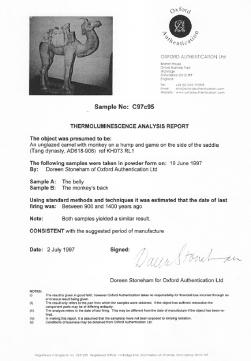
China, 618-906. The camel standing foursquare on a pierced rectangular base, the neck raised, carrying a saddle with saddle bag in the form of beast masks, coils of twisted cloth, vessels, game birds, a hare, and other provisions, surmounted by a small monkey clinging to the front hump, the buff ware highlighted in red, black, and white pigments. The saddle attached to the camel with a painted key-fret band.
Provenance: Christie’s New York, 18 September 1997, lot 344, sold for USD 55,200 or approx. EUR 98,000 (converted and adjusted for inflation at the time of writing). The Harold and Ruth Newman Collection, Connecticut, acquired from the above. Harold Newman (1931-2021) earned his undergraduate degree at the University of Oklahoma, where he first developed a lifelong interest in Asian studies. He served in the U.S. Army in Strategic Intelligence for two years before beginning an investment career with Goldman Sachs. In addition to his career in finance, Newman was a trustee of the Asia Society in New York City, a board member of The Hertz Foundation and MCC Theater, and a producer of well-known plays In the Heights and Hamilton, among others. Newman established the University of Oklahoma Institute for US-China Issues and the Newman Prize, the first American award for Chinese literature. Together with his wife Ruth, they also supported the Asia Society Museum with a significant gift including works from famous East Asian artists.

Condition: Some old repair as generally expected from Tang dynasty excavations. Extensive wear, soiling, losses, chips, cracks, and soil encrustations. Holes from sample taking.
Dimensions: Height 73.5 cm

Depictions of monkeys perched on camels are quite rare. The inclusion of a monkey on the pack may be a whimsical notion. It could also depict the trader’s pet or may represent part of the trade goods carried by the camel.
Camels played a crucial part in the long-distance trade along the Silk Road during the Tang dynasty. Camels were treasured for their reliability and capability of crossing the two main deserts, Gobi and the Tarim, and were specially bred in China on the grasslands of present-day Shanxi and Gansu provinces. Even though camels were not native to China, they became a common sight in the Tang capital Chang’an and large cities such as Luoyang.
LITERATURE COMPARISON
Compare a related glazed pottery group depicting a monkey seated on a Bactrian camel, Tang dynasty, in the collection of the Museum of Far Eastern Antiquities, Stockholm, illustrated in Oriental Ceramics, The World’s Great Collections, vol. 8, Tokyo, 1982, no. 35. Compare also a related group depicting a camel with monkey, Tang dynasty, in the collection of the Asian Civilizations Museum, accession number 2003-00227.
AUCTION RESULT COMPARISON
Type: Related
Auction: Sotheby’s New York, 9 September 2005, lot 253
Price: USD 120,000 or approx. EUR 174,000 converted and adjusted for inflation at the time of writing
Description: A superb ‘camel-and-monkey’ pottery group, early Tang dynasty Expert remark: Compare the closely related subject. Note the different pose and smaller size (61 cm).


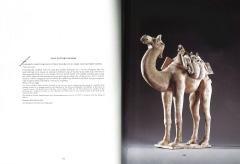
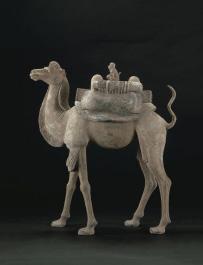
Estimate EUR 12,000
Starting price EUR 6,000
104 70
Harold and Ruth Newman

71 A POLYCHROME STUCCO HEAD OF A NOBLE DAOIST BEAUTY, SONG DYNASTY
China, 12th century. Finely modeled with small pursed lips, straight nose and elegantly-shaped eyes, with painted eyelid folds and eyebrows, the forehead with a recessed urna, the delicate features framed by the well-proportioned ears with fine floral earrings and upswept hair secured by a tiara decorated with applied florets and clouds.
Provenance: J.A.N. Fine Art, London, 2003. A European private collection, acquired from the above. A copy of the original invoice, dated 9 June 2003, dating the present lot to the Song dynasty, 12th century, and stating a purchase price of GBP 4,250 or approx. EUR 8,000 (converted and adjusted for inflation at the time of writing), accompanies this lot. J.A.N. Fine Art is a noted art gallery specializing in Chinese, Japanese, Korean, Himalayan, and Southeast Asian ceramics, porcelain paintings, and works of art. The company was first established in 1977 in Tokyo, Japan by Kikue Shimizu and has been located on Kensington Church Street in London, United Kingdom for over thirty years. Many of their pieces originate from Japanese collections and have museum-established provenance.

Condition: Good condition, commensurate with age. Expected old wear and weathering, obvious losses, nicks, minor structural fissures, small touch-ups. Good, naturally grown patina overall. Displaying exceptionally well.
Weight: 7,580 g (excl. stand)
Dimensions: Height 37.5 cm (excl. stand) and 48 cm (incl. stand)
Mounted on an associated stand. (2)
Expert’s note: The style of the tiara and smaller ears point to the head belonging to a Daoist figure rather than a Buddhist bodhisattva, as bodhisattvas are usually depicted with long pendulous earlobes.

Literature comparison: For examples of Song and Yuan dynasty female figures, see Chai Zejun and Chai Yumei, Shanxi gudai caisu (Ancient Stucco Sculptures of Shanxi), Beijing, 2008, pp. 236-242, 244-247, and 264-267.
AUCTION RESULT COMPARISON
Type: Closely related
Auction: Sotheby’s New York, 16 September 2015, lot 426
Price: USD 11,250 or approx. EUR 13,500 converted and adjusted for inflation at the time of writing
Description: A polychrome stucco head of a female attendant, China, Jin / Yuan dynasty
Expert remark: Compare the closely related expression with similar features, hairstyle, urna, and tiara. Note the similar size (40.5 cm).
Auction result comparison:
Type: Related
Auction: Sotheby’s New York, 23 March 2022, lot 291
Price: USD 31,500 or approx. EUR 30,000 converted at the time of writing
Description: A polychrome-painted lacquered stucco head of a bodhisattva, Song - Yuan dynasty

Expert remark: Compare the related expression and features, hairstyle, urna, and tiara. Note the larger size (52.5 cm).
Estimate EUR 8,000
Starting price EUR 4,000
106
Kikue Shimizu, J.A.N. Fine Art

AN EXTREMELY RARE DINGYAO PETAL-LOBED DISH, SONG DYNASTY
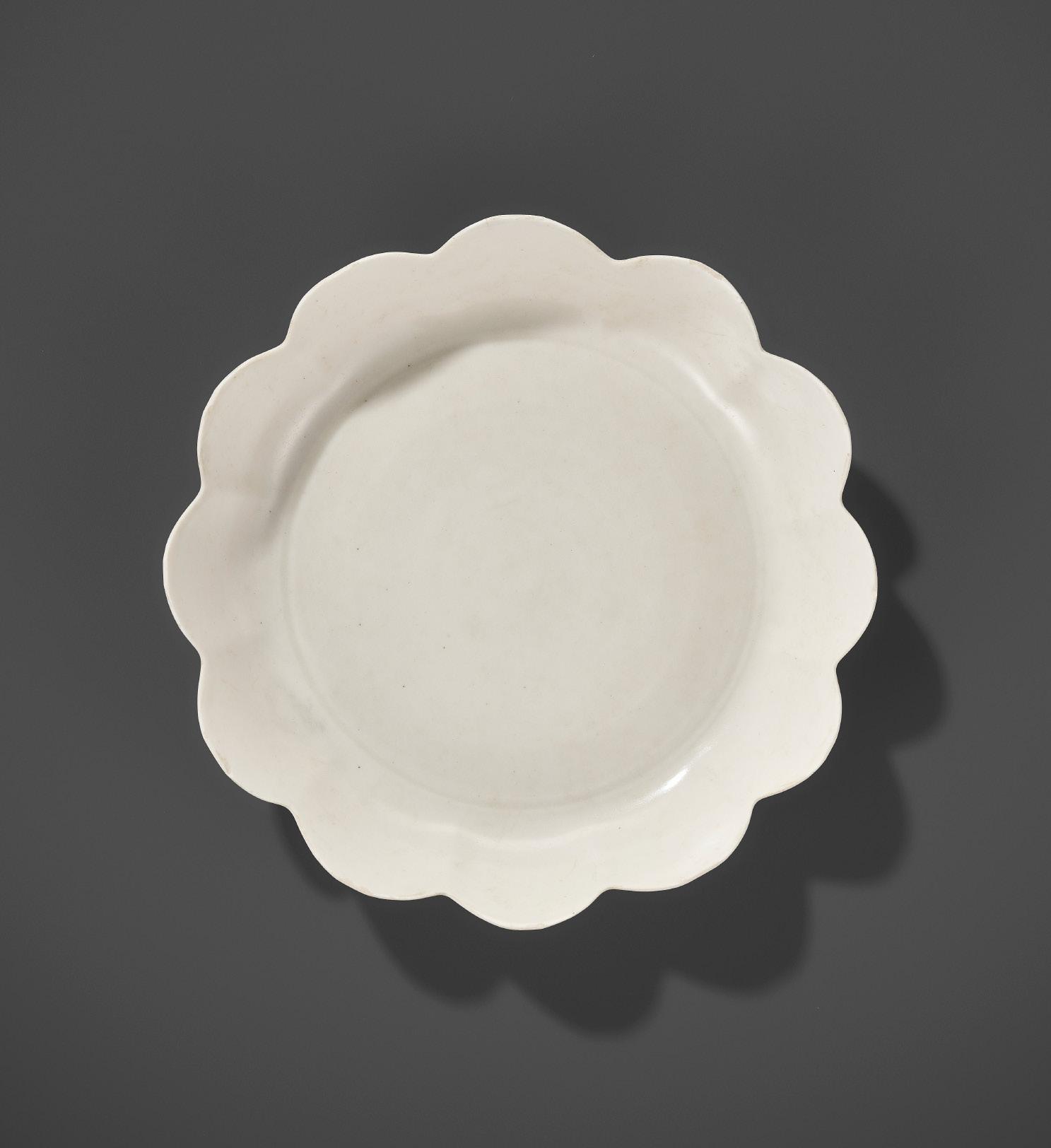
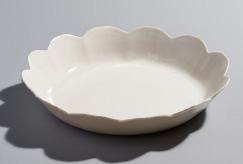
China, 960-1279. Finely potted with flaring sides neatly divided into twelve lobes, covered overall with an exquisite ivory-tinged transparent glaze except the foot ring exposing the fine white body.
Provenance: From a noted dealership in London, United Kingdom. Condition: Very good condition with expected old wear, traces of use and shallow surface scratches overall. Some firing irregularities, pottery marks, minor fritting, tiny glaze flakes. Some of the lobes with smoothened tips, possibly inherent to manufacture.
Weight: 229.5 g
Dimensions: Diameter 20.2 cm
Literature comparison: Large Ding petal-rim dishes or washers of such size are very rare. Compare a related Ding foliate-rimmed dish incised with plantain, rocks and insects, Northern Song/ Jin dynasty, illustrated in Tsai Meifen, Decorated Porcelains of Dingzhou: White Ding Wares from the Collection of the National Palace Museum, Taipei, 2014, no.II-72. Compare also with a Qingbai dish with a foliate rim, 11th century, of similar form to the present lot, illustrated in B. Gray, Sung Porcelain & Stoneware, London, 1984, pl. 123.
AUCTION RESULT COMPARISON
Type: Near identical
Auction: Bonhams Hong Kong, 28 May 2019, lot 115
Estimate: HKD 800,000 or approx. EUR 102,000 converted and adjusted for inflation at the time of writing
Description: A very rare Dingyao petal-lobed dish, Song dynasty
Expert remark: Note the near identical form, glaze, and size (20 cm)
Estimate EUR 8,000
Starting price EUR 4,000
108 72

A RARE CIZHOU SGRAFFIATO TRUNCATED MEIPING, TULUPING, NORTHERN SONG OR JIN DYNASTY

Published:
Song Ceramics, the Eight Kiln Groups at a Glance, Examples from the Jiyuanshanfang Collection, 2008, page 166.

China, 11th-12th century. The high-shouldered body surmounted by a short narrow neck and outwardly curved rim, finely decorated in a cut-slip technique through the outer dark-brown layer of the slip to the white layer underneath and covered overall in a clear pale-crackled glaze. The body encircled by foliate motifs and interlinked diapered ‘cash’ designs against a vertically striped ground, framed by key-fret bands, all below a band of overlapping lotus petals. The mouth left in white slip, the unglazed base revealing the smooth pale gray ware.
Provenance: The Jiyuanshanfang Collection. Currently housed on New York’s Upper East Side and originally founded upon an old family collection, a comprehensive catalog of the Jiyuanshanfang collection titled “Song Ceramics: The Eight Kiln Groups” was published in 2008 with a foreword written by Li Zhiyan, Research Fellow at the Beijing Palace Museum. Another contributor to this catalog was Martin Lorber, formerly Director of Sotheby’s New York. Jiyuanshanfang’s first exhibition was held in 2012 at the Morris Museum in New Jersey. In 2015, Jiyuanshanfang lent early Chinese ceramics to a large-scale exhibition at the Norton Museum of Art in Palm Beach, Florida, titled “High Tea: Glorious Manifestations – East and West”. Condition: Good condition commensurate with age and with expected old wear, shallow surface scratches, some firing irregularities, glaze flakes, minor chips to foot.
Weight: 842.5 g
Dimensions: Height 15.2 cm
Some of the most attractive Cizhou wares are those made by various kilns in northern China with designs reserved in black against a white ground. The complicated technique used to create the striking decoration in contrasting colors seen on the present piece is known by the Italian term

sgraffiato, literally ‘scratched’. It first appeared around the late eleventh century, and was created through the application of contrasting layers of slip or glaze. On the present truncated bottle, a layer of dark brown, almost black slip was applied over white slip, which was later carefully incised to create decorative patterns by revealing the pristine white layer beneath, and then finally covered by a layer of clear glaze. This labor-intensive and time-consuming technique adds a sense of opulence and luxury to the stoneware.
The vase is also notable for its well-proportioned form, with small mouth, broad shoulder and wide base, which is known as ‘tuluping’ or ‘truncated meiping’. This form, which was produced at many northern kilns, is closely related to the taller meiping, a quintessential Song shape, but enjoyed a much shorter period of production. It was produced for only about a hundred years during the eleventh and twelfth centuries, leaving behind a relatively small number of extant examples.
AUCTION RESULT COMPARISON
Type: Related
Auction: Sotheby’s New York, 17 March 2021, lot 123
Estimate: USD 200,000 or approx. EUR 212,000 converted and adjusted for inflation at the time of writing
Description: A superb black-glazed ‘Cizhou’ sgraffiato ‘peony’ ‘tulu’ vase, Northern Song / Jin dynasty

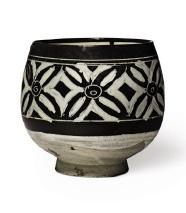

Expert remark: Compare the related form and sgraffiato decoration. Note the significantly larger size (23 cm).
AUCTION RESULT COMPARISON
Type: Related
Auction: Christie’s New York, 22 March 2018, lot 508
Price: USD 200,000 or approx. EUR 229,000 converted and adjusted for inflation at the time of writing
Description: A rare cizhou sgraffiato deep bowl, Northern Song-Jin dynasty
Expert remark: Compare the related sgraffiato decoration with similar ‘cash’ patterns. Note the different form.
Estimate EUR 4,000
Starting price EUR 2,000
73
A SMALL JUNYAO PURPLE-SPLASHED ‘LOTUS BUD’ WATERPOT, NORTHERN SONG OR JIN DYNASTY
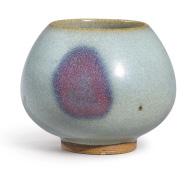
China, 960-1234. The broad sides narrowing towards the mouth from a short foot, all covered in a thick, crackled, and bubble-suffused sky-blue glaze with light lavender streaks, thinning to mushroom around the rim, continuing over the mouth into the interior, the exterior dashed with a bold splash of purple, the glaze falling short above the foot revealing the body burnt to orange in the firing.
Provenance: From a Swedish private collection.
Condition: Excellent condition with only minor old wear and expected firing flaws including kiln grit and pottery lines.
Weight: 209.2 g
Dimensions: Height 8.1 cm
AUCTION RESULT COMPARISON
Type: Closely related
Auction: Sotheby’s Hong Kong, 1 December
2017, lot 536
Price: HKD 250,000 or approx. EUR 33,500 converted and adjusted for inflation at the time of writing
Description: A Junyao purple-splashed ‘lotus
bud’ waterpot, Northern Song – Jin dynasty
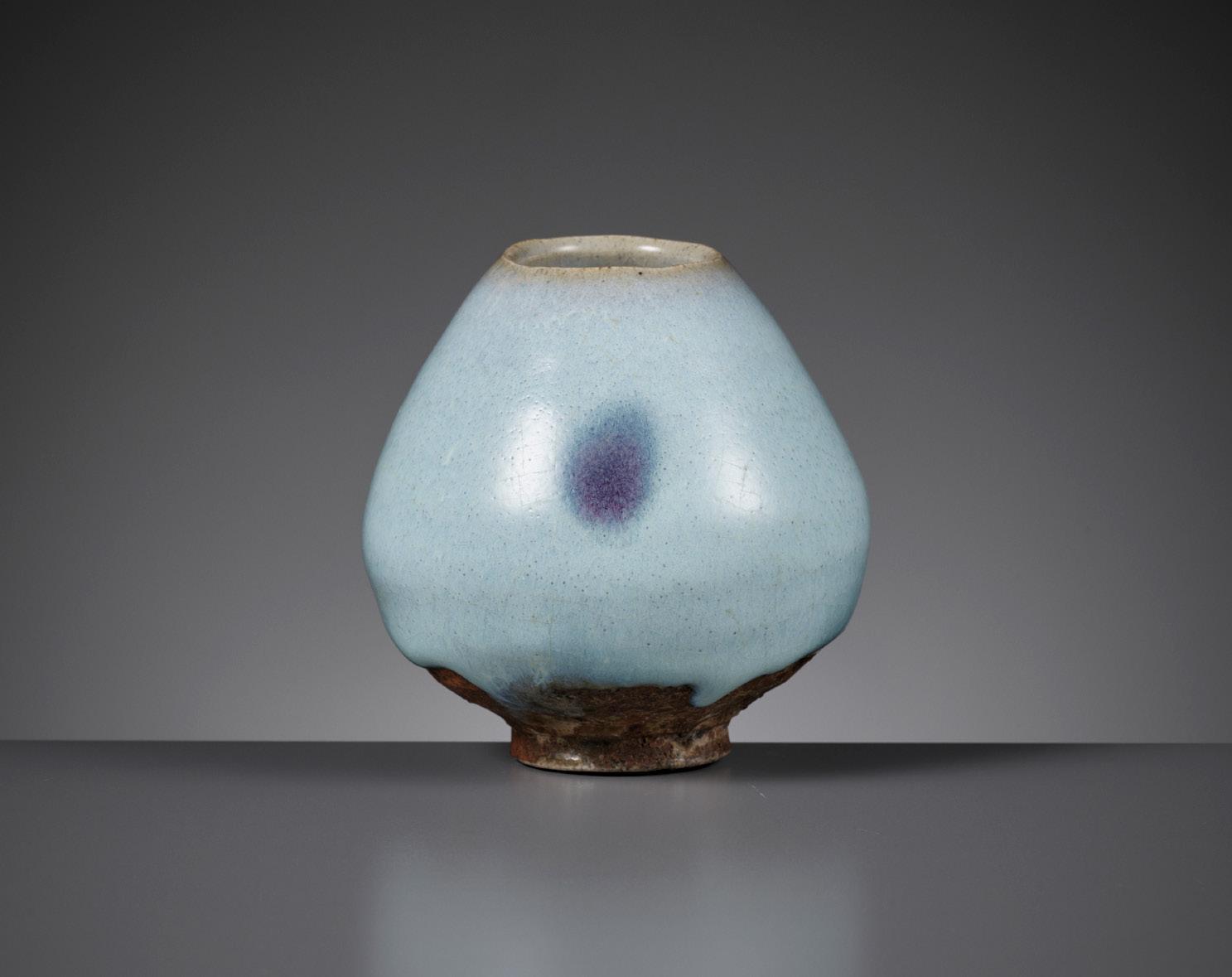
Expert remark: Compare the closely related glaze, lavender splash, and small size (7.5 cm). Note the slightly wider mouth.

Estimate EUR 4,000
Starting price EUR 2,000
111 74
A JIZHOU PHOSPHATIC-SPLASHED
BLACK-GLAZED BOWL, SOUTHERN SONG DYNASTY




China, 1127-1279. The bowl is potted with conical sides rising to the finger-grooved rim, applied with a lustrous dark brown glaze splashed with variegated russet and pale milky brown strokes stopping at the base revealing the buff body burnt orange during firing.
Provenance: New York trade, by repute acquired from a Japanese private collection.
Condition: Old wear and firing irregularities as expected, the rim with two old kintsugi repairs, minuscule losses, light surface scratches.
Weight: 180.7 g
Dimensions: Diameter 12 cm
AUCTION RESULT COMPARISON
Type: Closely related
Auction: Christie’s Hong Kong, 30 November 2016, lot 3161
Price: HKD 162,500 or approx. EUR 22,500 converted and adjusted for inflation at the time of writing
Description: A Jizhou phosphatic-splashed blackglazed bowl, Southern Song dynasty
Expert remark: Compare the closely related glaze, splashes, form, and size (12.1 cm)
AUCTION RESULT COMPARISON
Type: Closely related
Auction: Christie’s New York, 17 September 2008, lot 429
Price: USD 30,000 or approx. EUR 40,000 converted and adjusted for inflation at the time of writing
Description: A rare Jizhou splashed black-glazed bowl, Southern Song dynasty
Expert remark: Compare the closely related glaze, color of splashes, and form. Note the size (16 cm)
Estimate EUR 4,000
Starting price EUR 2,000
75
A JIZHOU ‘TORTOISESHELL’ GLAZED BOWL, SOUTHERN SONG DYNASTY

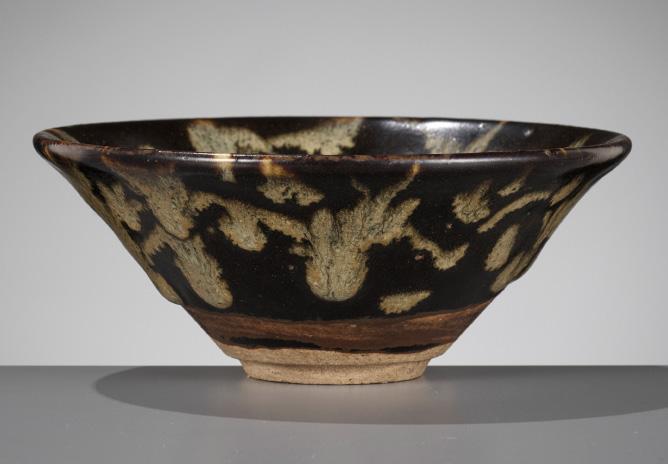
China, 1127-1279. The deep conical sides supported on a knife-pared foot and rising to a gently everted rim, covered inside and out with a dark brown glaze liberally splashed with translucent yellow-brown dashes in imitation of mottled tortoiseshell, the splashes attractively pooling and the glaze stopping above the foot to reveal the buff ware partly covered in a brown wash.
Provenance: From the estate of Robert Rossi, New York, United States. Old collector’s labels to base and exterior, one numbered “91”.
Condition: Excellent condition with expected old wear, shallow surface scratches and firing irregularities including pitting and glaze recesses.
Weight: 216.3 g
Dimensions: Diameter 12.3 cm
The ‘tortoiseshell’ glaze was another important innovation of the potters at the Jizhou kilns in Jiangxi province during the Song dynasty. Its name was supposedly derived from its similarity to the shell of a warm-water sea turtle known as the hawksbill. For a discussion of these kilns, and this specific type of glaze, see R. Mowry, Hare’s Fur, Tortoiseshell, and Partridge Feathers, Cambridge, 1996, pages 225-28.
AUCTION RESULT COMPARISON
Type: Closely related
Auction: Bonhams London, 17 May 2018, lot 26
Price: GBP 13,750 or approx. EUR 19,000 converted and adjusted for inflation at the time of writing
Description: A Jizhou ‘tortoiseshell’-glazed bowl, Southern Song dynasty
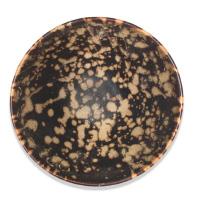
Expert remark: Compare the closely related form and glaze. Note the size (10.7 cm).
Estimate EUR 4,000
Starting price EUR 2,000
76
A LONGQUAN CELADON ARROW VASE, TOUHU, SOUTHERN SONG DYNASTY
China, 1127-1279. Delicately potted, the pear-shaped body supported on a short tapered foot and rising to a long slender neck flanked by a pair of tubular handles. Covered overall in a rich vitreous glaze of soft sea-green color, save for the unglazed foot rim revealing the ware burnt to orange in the firing.
Provenance: The J. M. Hu, Zande Lou Collection. Jenmou Hu (1911-1995) was arguably the most important collector of Chinese ceramics in the last century. In both his personal collection and in his bequests to cultural institutions, J. M. Hu stood as a model of the modern scholar-collector. The eldest son of the influential banker Hu Chun, he was raised in an elegant private residence amongst his many stepbrothers and stepsisters. In keeping with tradition, he was given a rigorous background in the Chinese classics, supplemented by a Western-style education. He first encountered Chinese ceramics during his student years, when he purchased a nineteenth-century brush washer for his desk. This initial foray into collecting would become emblematic of J. M. Hu’s poignant relationship with art: even amidst the upheavals of war and the evolution of his collection, the modest brush-washer stayed with him until his death in 1995. Hu’s boyhood studies within the Chinese literati tradition greatly informed his philosophical approach to life and collecting; humble and erudite, he consistently affirmed that it was the visceral connection between a collector and his acquisitions that was of essential importance. True value, in J. M. Hu’s estimation, lay far beyond monetary worth. A noted traditionalist, he went to great lengths designing wooden stands and fitted boxes to preserve and display his Chinese treasures and delighted in sharing the collection with fellow connoisseurs. For J. M. Hu, collecting was a serious, scholarly pursuit not to be taken lightly. The joy of art came with a responsibility to honor both the artist and the object. Hu often spoke of the three necessary criteria in collecting: zhen (authenticity), jing (rarity and quality), and xin (condition). Yet it was an individual’s bond with a work of art, as evidenced in J. M. Hu’s beloved brush washer, that was of fundamental significance. In handling and examining his ceramics, Hu sought that indefinable delight that could come only from the beauty of artistry. In the tradition of Chinese literati who bestowed symbolic monikers upon their studios, libraries, and collections, the name of J. M. Hu’s studio, Zande Lou, referenced the influential Lanting Xu of the famed Jin dynasty calligrapher Wang Xizhi, a text that describes Zande as a person’s inner happiness. Although J. M. Hu intended the meaning of Zande to express this fleeting happiness, which he experienced as a collector when examining an object, the word has also come to be interpreted as the inherently transitory nature of collecting and possessing fine art. J. M. Hu’s collection of Chinese ceramics provided abundant opportunity for personal scholarship and historical investigation. As early as the 1940s, he longed for a welcoming social environment where like-minded collectors could share and discuss art and objects. Two decades later, he established the Min Chiu Society in Hong Kong alongside fellow collectors K.P. Chen and J.S. Lee. A noted cultural philanthropist, J. M. Hu gifted substantial groupings from his collection to the Shanghai Museum in 1950 and again in 1989. Many of these objects remain on view in the museum’s Zande Lou Gallery. To this day, J. M. Hu remains a celebrated figure amongst collectors of Chinese art.

Condition: Excellent condition with expected old wear and minor firing irregularities, including glaze recesses and other minuscule glaze faults. The neck is slightly leaning. The unglazed areas of the ware burnt to orange in the firing.
Weight: 149.2 g
Dimensions: Height 12.3 cm
The form of this vase is based on arrow vases, or touhu, the primary accessory of a drinking game which involved throwing all of one’s arrows into the mouth of the vessel. The loser was assessed a penalty drink for every errant throw. This game had been popular among elite men and women from the Spring and Autumn period (770-476 BC) onwards. In line with emerging trends of antiquarianism and archaism, the game was revived during the Song dynasty and touhu vases, made in various materials including bronze, cloisonné, and ceramic, remained popular throughout the Ming dynasty and later.
Elaborate rituals and intricate rules, recorded in the Li Ji (Book of Rites), added further complexity to the game. Puzzling pitching techniques were described in the Touhu Yijie (Ceremonial Usages and Rules of Touhu), an illustrated manual written by Wang Ti (1490-1530), and these shots were given fancy names, like ‘A Pair of Dragons Enters the Sea’ when two arrows were thrown from a great height at once into the vase. The touhu game was used to practice archery, one of the essential accomplishments of a gentleman. Later in the Ming era, the game became more widespread and was played by rich merchants as well as the aristocracy and scholarly elite. A scene in the famous late Ming novel Jin Ping Mei (Plum Blossom in the Golden Vase), written in 1619, describes the wealthy merchant Ximen Qing’s seduction of his concubine Panjinlian. She becomes inebriated while playing touhu on a picnic and the game leads to an amorous encounter. For a further discussion of the game see Isabelle Lee, ‘Touhu: Three Millennia of the Chinese Arrow Vase and the Game of Pitch-pot’, Transactions of the Oriental Ceramic Society, vol. 56, 1991-2, pp. 13-7.
Too small to actually be used in the drinking game, the present vase was probably intended to hold a single branch, a small flower, or an incense stick.
Literature comparison: A pair of related Longquan arrow vases, of slightly larger size and with wider necks, was recovered from the tomb of the Yuan calligrapher Xian Yushu (1251-1302), see Zhang Yulan, Hangzhoushi faxian Yuandai Xian Yushu mu, Wenwu, 1990:9, page 24, figures 11-12. A similar vase was included in the exhibition, The Scholar as Collector: Chinese Art at Yale, Yale University Art Gallery and China Institute in America, New York, 2004, page 18, figure 8.
AUCTION
RESULT
Type: Related
COMPARISON
Auction: Christie’s New York, 25 March 2022, lot 1081
Price: USD 27,720 or approx. EUR 26,000 converted at the time of writing
Description: A Longquan celadon ‘arrow’ vase, Southern Song dynasty

Expert remark: Compare the related pearshaped form and soft sea-green glaze. Note the size (16 cm).
AUCTION RESULT COMPARISON
Type: Related
Auction: Christie’s New York, 25 March 2022, lot 1033
Price: USD 119,700 or approx. EUR 113,000 converted at the time of writing
Description: A small Longquan celadon bowl, Southern Song dynasty

Expert remark: Compare the almost identical vitreous sea-green glaze and the similarly designed foot rim, also burnt to orange in the firing. Note that this bowl was previously also in the J. M. Hu Collection.
Estimate EUR 12,000
Starting price EUR 6,000
114 77
Jenmou Hu, The Master of Zande Lou

A GUAN-TYPE LONGQUAN TRIPOD CENSER, LIAN, SOUTHERN SONG DYNASTY
China, 1127-1279. The cylindrical body is encircled by three sets of raised bow-string bands, comprised of two ribs above the three foliatemolded ruyi-head supports, three encircling the mid-body and three below the flat inward-canted mouth rim. The censer is covered overall with a rich, finely crackled, bluish-green glaze which thins slightly on the rim and raised decoration, the unglazed edge of the tapering rim on the underside burnt orange in the firing.
Provenance: The Jiyuanshanfang Collection. Currently housed on New York’s Upper East Side and originally founded upon an old family collection, a comprehensive catalog of the Jiyuanshanfang collection titled “Song Ceramics: The Eight Kiln Groups” was published in 2008 with a foreword written by Li Zhiyan, Research Fellow at the Beijing Palace Museum. Another contributor to this catalog was Martin Lorber, formerly Director of Sotheby’s New York. Jiyuanshanfang’s first exhibition was held in 2012 at the Morris Museum in New Jersey. In 2015, Jiyuanshanfang lent early Chinese ceramics to a large-scale exhibition at the Norton Museum of Art in Palm Beach, Florida, titled “High Tea: Glorious Manifestations – East and West”.
Condition: Good condition commensurate with age, showing expected old wear, traces of usage and shallow surface scratches. Some firing irregularities, the rim with a short hairline and associated microscopic loss, the foot rim with a tiny crack, one ruyi foot with an old kintsugi repair. The interior with remnants of calcification and russet discoloration to the crackle, consistent with temporary use as a jardinière.
Weight: 808.3 g
Dimensions: Diameter 14 cm

The shape of the present censer originates from archaic bronze lian vessels, which were among the ritual implements aimed to present food and drink offerings to the ancestors during the Han dynasty. This archaistic shape was also produced in the Ruyao glaze during the Northern Song period as exemplified in a related Ruyao tripod incense burner from the Qing Court collection, illustrated in The Complete Collection of Treasures of the Palace Museum: Porcelain of the Song Dynasty (I), Hong Kong, 1996, p. 2, no. 1. Ceramic vessels of this form are often molded with bow-strings around the body, such as the well-known Northern Song Ru censer in the Percival David Collection, illustrated in Sekai Toji Zenshu, vol. 12, Tokyo, 1977, p. 70, no. 62.
Published: Song Ceramics, the Eight Kiln Groups at a Glance, Examples from the Jiyuanshanfang Collection, 2008, page 332.

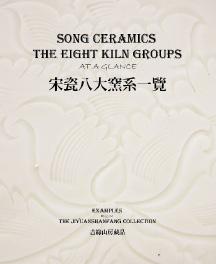
Expert’s note: The glaze on this censer is a particularly good example of the attractive bluish-green tone characteristic of the finest Longquan glazes of the guan type.
Literature comparison: A closely related Longquan tripod censer, in the collection of the Hangzhou Archaeological Bureau, is illustrated by Zhu Boqian (ed.), Celadons from Longquan Kilns, Taipei, 1998, p. 149, no. 116. A small Longquan censer of similar form was discovered in 1991 in Suining, Sichuan province, amongst a cache of ceramics dating from the late Southern Song period, and is illustrated in Newly Discovered Southern Song Ceramics, A Thirteenth-Century “Time Capsule”, Tokyo, 1998, p. 32, no. 23.
AUCTION RESULT COMPARISON
Type: Closely related
Auction: Christie’s New York, 22 March 2018, lot 527
Price: USD 62,500 or approx. EUR 71,500 converted and adjusted for inflation at the time of writing
Description: A Longquan celadon tripod censer, Southern Song dynasty

Expert remark: Compare the closely related form, with similar bowstring bands, ruyi feet, inward-canted rim, and bluish-green glaze. Note the similar size (14.7 cm).
Estimate EUR 8,000
Starting price EUR 4,000
116 78

LITERATURE COMPARISON
A
LARGE LONGQUAN ‘TRIGRAM’ TRIPOD CENSER, YUAN TO MING DYNASTY
China, 13th to 15th century. Heavily potted, the deep flaring sides rising from a flat base and set over three short cabriole legs, the exterior molded with a band of Bagua trigrams between two raised fillets and freely carved with foliate scrolls, the well with a central aperture framed by a raised disc underneath, covered overall in an even sea-green celadon glaze save for the areas around the aperture, partly burnt to orange in the firing.
Provenance: Sir Alan Campbell, probably acquired in Beijing between 1956 and 1957, and thence by descent within the same family. Sir Alan Campbell (1919-2007) was an English diplomat. His father Hugh Campbell was a silk merchant and the Director of Ilbert & Co, Shanghai. Sir Alan joined the Foreign Office in 1946 and served in Singapore and China. From 1956 to 1957, he was in Beijing as Head of Chancery at the British Legation. He inherited his interest in Chinese porcelain from his parents and was a keen collector. Sir John Addis, the British Ambassador to China from 1972 to 1974 and an authority on Ming porcelain, likely advised him on purchases from the Beijing merchants they both bought from.
Sir Alan Campbell (1919-2007)

Condition: Good condition commensurate with age, with some wear and manufacturing flaws including firing cracks, glaze recesses, kiln grit, and a burst bubble smoothened in the kiln, one foot with a small loss and old repair. The central aperture is clearly intentional and original to the piece, as evidenced by the glaze inside.
Weight: 4,042 g
Dimensions: Diameter 25.2 cm
Compare to a similarly decorated censer in the National Palace Museum, Taipei, illustrated in Longquan Celadon of the Ming Dynasty, Taipei, 2009, pp. 226-227, no. 124.
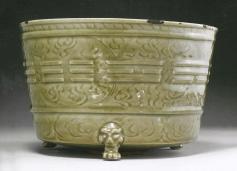
AUCTION RESULT COMPARISON
Type: Closely related
Auction: Sotheby’s New York, 11 September 2019, lot 783
Estimate: USD 15,000 or approx. EUR 17,000 converted and adjusted for inflation at the time of writing
Description: A large celadon-glazed ‘longquan’ ‘trigram’ tripod censer, Ming dynasty


Expert remark: Compare the closely related form, decorations, glaze, and aperture in the well. Note the larger size (30.5 cm).
AUCTION RESULT COMPARISON
Type: Closely related
Auction: Sotheby’s New York, 29 March 2022, lot 559
Price: USD 18,900 or approx. EUR 18,000 converted and adjusted for inflation at the time of writing
Description: A ‘Longquan’ celadon-glazed ‘eight trigrams’ censer, Yuan dynasty
Expert remark: Compare the closely related form, decorations, glaze, and aperture in the well. Note the smaller size (21.7 cm).
Estimate EUR 10,000
Starting price EUR 5,000
118 79
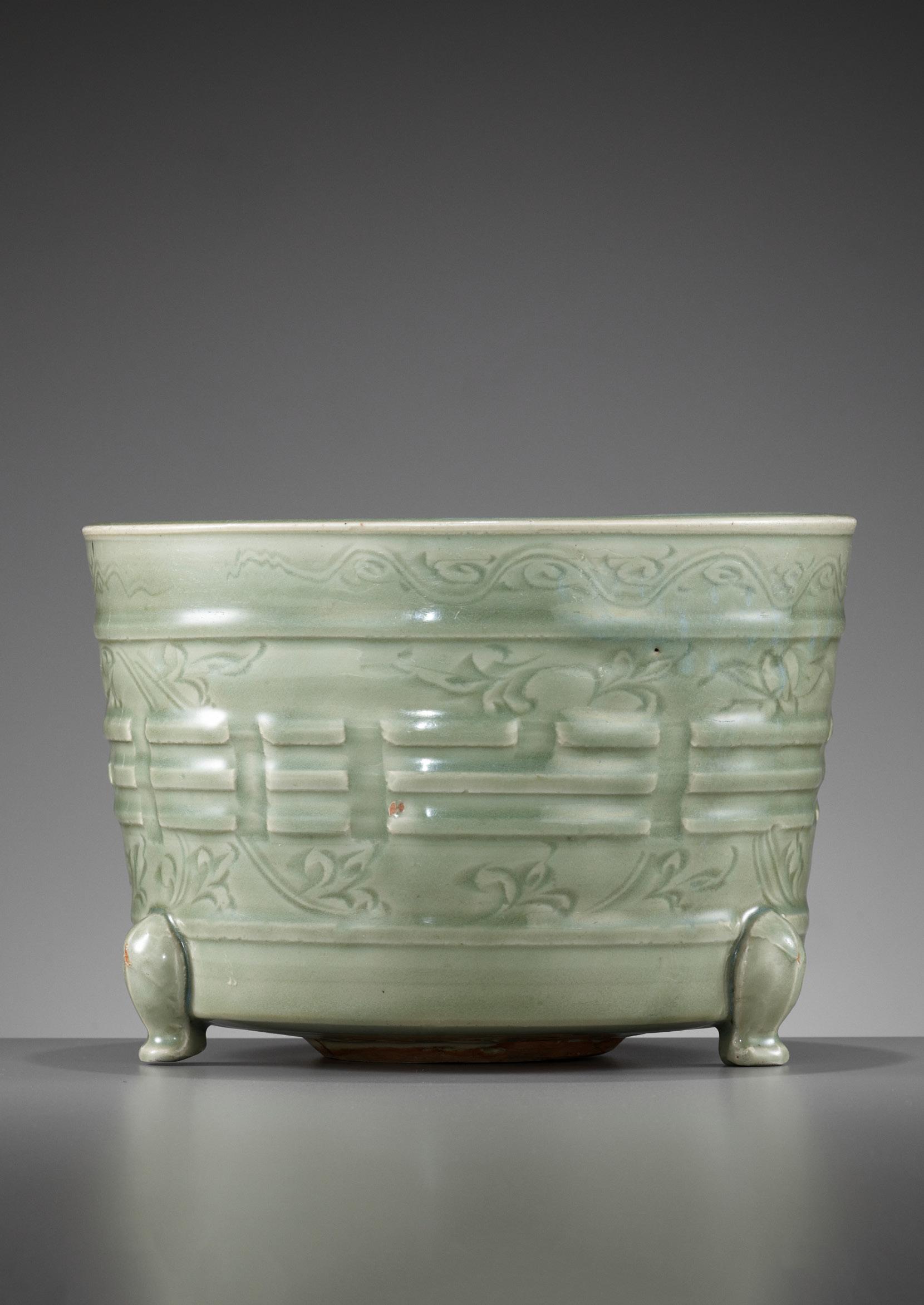
A CELADON GLAZED CERAMIC BOTTLE VASE, GORYEO DYNASTY


Korea, 12th century. The faceted pear-shaped body supported on a short straight foot, surmounted by a waisted neck with everted rim, the neck decorated with a neatly incised band of lotus leaves above three lines, the body with multiple vertical ribs, the exterior covered in a crackled celadon glaze that pools to a bluish tone in the recesses and stops irregularly above the foot to reveal the buff orange wear.
Provenance: Old French private estate.
Condition: Extensive old wear and manufacturing flaws including firing cracks, brown spots and glaze recesses. The neck with an old restoration. Minor nicks here and there. The glaze with intentional crackling, as expected from this type of ware.
Weight: 1,304 g
Dimensions: Height 23.7 cm
The celadon wares, Korea’s best-known ceramics, exemplify the refined sensibilities of Goryeo culture. Though numerous kilns produced celadon wares, the very best pieces—which were used by the royal court, the aristocracy, and wealthy Buddhist temples— came from kilns in Gangjin (in South Jeolla province) and in Bu’an (in North Jeolla province), areas in the southwestern part of the peninsula that are rich in fine stoneware clays. Vessels with molded, incised, or carved decoration, such as this exquisite bottle, typify twelfth-century wares, while ones with designs inlaid in black and white slips epitomize those of the thirteenth and fourteen centuries (the inlay technique known in Korean as sanggam gisul).
Literature comparison: Compare also a related faceted bottle vase, also dated 12th century, with incised decoration in the Horim Museum, Seoul, treasure no. 1454.
AUCTION RESULT COMPARISON
Type: Related
Auction: Bonhams London, 8 November 2012, lot 135
Estimate: GBP 10,000 or approx. EUR 16,000 converted and adjusted for inflation at the time of writing
Description: A rare Korean inlaid green-glazed pear-shaped vase, Koryo dynasty, 12th/13th century
Expert remark: Compare the related pearshaped form. Note that this vase also shows repairs to the neck and mouth. This slip-decorated vase is of a slightly later date than the present lot.
AUCTION RESULT COMPARISON
Type: Related
Auction: Sotheby’s Hong Kong, 29 April 2022, lot 3708
Price: HKD 100,000 or approx. EUR 12,500 converted at the time of writing
Description: A Korean celadon vase, Goryeo dynasty, 11th century

Expert remark: Compare the incised decoration and glaze. Note that this vase is of a slightly earlier date than the present lot.
Estimate EUR 2,000
Starting price EUR 1,000
120 80
A LARGE BLUE AND WHITE ‘FLORAL’ JAR, JOSEON DYNASTY
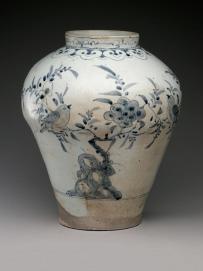

Korea, 18th century. The ovoid body supported on a short foot and rising to a cylindrical neck with a galleried rim, freely painted in sensitively graduated shades of cobalt blue to the upper body with leafy chrysanthemum sprays and to the neck with foliate designs.
Provenance: French trade.
Condition: Very good condition with expected old wear, traces of use and firing irregularities, the dark glazed circular section above the foot inherent to manufacture. The base with a small old fill and scattered remnants of plaster. A minor hairline to the neck, the interior with further hairlines not visible to the exterior. Overall displaying very well.
Dimensions: Height 51.5 cm, Width 52 cm (at the widest points)
LITERATURE COMPARISON
Compare a related blue and white vase, similarly painted with birds, plum blossoms, and rocks, 38.1 cm high, dated to the 18th century, in the Johnson Museum of Art, Cornell University, accession number 67.172 (fig. 1). Compare a related jar of similar form, decorated in underglaze-blue and iron-brown, 39.7 cm high, dated c. 1700, in the Ashmolean Museum Oxford, accession number EA1974.16. fig. 1
Estimate EUR 4,000
Starting price EUR 2,000
121 81
A BLUE AND WHITE ‘SCHOLARS AND BOYS’ JAR, GUAN, WANLI MARK AND PERIOD


China, 1573-1619. Superbly painted in shades of cobalt blue with a continuous scene depicting scholars engaged in leisurely pursuits and boys at play, including a scholar seated by a large painted screen and holding a fan as well as a young boy flying a kite, all amid trees, rockwork, and flowers, framed by a ruyi-head band at the shoulder and a lappet band above the foot, the short neck with a band of freely painted scroll. The base with an underglaze blue six-character mark da ming wanli nianzhi within double circles and of the period.
Provenance: British trade.
Condition: Minor old wear and some expected firing irregularities. Several stabilized cracks, running from the shoulder to the foot, across the base and extending upwards to the middle section of the jar. Please request a video, shot under strong blue light, for further documentation of the exact condition of this lot. Despite these issues, displaying remarkably well.
Weight: 394.8 g
Dimensions: Height 11 cm, Width 13 cm
AUCTION RESULT COMPARISON
Type: Closely related
Auction: Christie’s New York, 25 September 2020, lot 1563
Price: USD 40,000 or approx. EUR 43,500 converted and adjusted for inflation at the time of writing
Description: A small blue and white ‘Daoist immortals’ jar, Wanli sixcharacter mark in underglaze blue within a double circle and of the period
Expert remark: Compare the related form and decoration. Note the height (16.2 cm).
AUCTION RESULT COMPARISON
Type: Closely related
Auction: Sotheby’s New York, 23 September 2020, lot 517
Estimate: USD 50,000 or approx. EUR 54,000 converted and adjusted for inflation at the time of writing
Description: A small and rare blue and white ‘Daoist immortals’ jar, Wanli mark and period
Expert remark: Note the diameter (12.1 cm)
Auction result comparison:
Type: Related
Auction: Christie’s Hong Kong, 30 May 2018, lot 3106
Price: HKD 625,000 or approx. EUR 81,000 converted and adjusted for inflation at the time of writing
Description: A blue and white ‘Daoist immortal and lantern’ bowl, Wanli sixcharacter mark in underglaze blue within a double circle and of the period

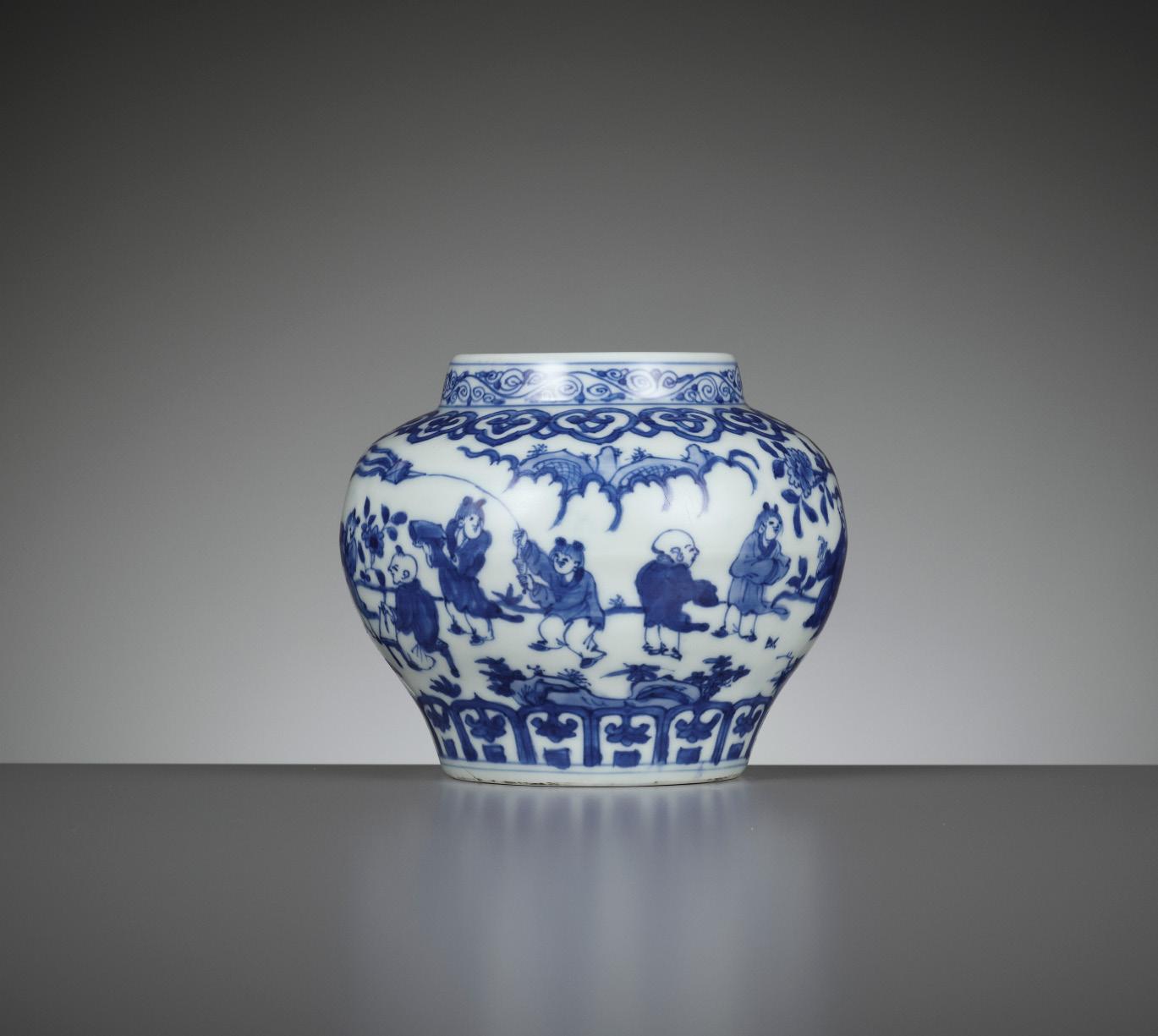
Expert remark: Note the diameter (15.5 cm).
Estimate EUR 8,000
Starting price EUR 4,000
122 82
A PAIR OF LARGE LONGQUAN CELADON PHOENIX TAIL VASES, YENYEN, LATE MING DYNASTY

China, 15th-16th century. Heavily potted, the baluster body rising from a spreading foot to a cylindrical neck and flaring rim, the body finely carved and incised with large lotus blooms amongst foliage, with horizontal ribbing to the upper neck and vertical ribs to the lower body. The glaze stopping just above the foot rim, revealing the ware. (2)
Provenance: Collection of Joseph Rondina. The base of one vase with an old paper label, inscribed “Celadon $9,000 pr.” Joseph Rondina (1927-2022) was born into a firstgeneration Florentine-American family in Auburn, upstate New York. Returning to the U.S. after being stationed in Berlin at the end of the Second World War, he studied at the Whitman School of Design before opening Joseph Rondina Antiques on Madison Avenue in Manhattan’s Upper East Side in 1957. In the beginning, his interests focused primarily on European 18th-century decorative arts and furniture, over time developing to include Chinese, Korean, Indian, Thai, Cambodian, Persian and Japanese art, bringing a more esoteric and exotic style to the market. His clientele included stars of the stage and screen, royalty, notables, dignitaries, and denizens of the social register from the United States and abroad.

Condition: Excellent condition with expected old wear, traces of use and shallow surface scratches. Firing flaws include minor kiln grit, dark spots, glaze recesses and irregular glaze pooling. The foot rims and bases of both vases partially burnt to orange in the firing.
Weight: 6,114 g and 6,012 g
Dimensions: Height 49.5 cm (each)
LITERATURE COMPARISON
A closely related example was included in the exhibition Chinese Celadons and Other Related Wares in Southeast Asia, National Museum, Singapore, 1979, cat. no. 207. A group of yen-yen vases in the Topkapi Saray Museum, Istanbul, is illustrated in Regina Krahl, Chinese Ceramics in the Topkapi Saray Museum, London, 1986, vol. I, fig. 206, p. 289. Another good example is illustrated in the National Palace Museum of Taipei, an Exhibition of Longquan Wares, cat. no. 78, pages 154-155 (fig. 1). fig. 1
AUCTION RESULT COMPARISON
Type: Closely related
Auction: Christie’s New York, 14 September 2017, lot 702
Price: USD 87,500 or approx. EUR 99,500 adjusted for inflation at the time of writing
Description: A Carved Longquan Celadon ‘PhoenixTail’ Vase, Late Yuan-Early Ming Dynasty, 14th Century Expert remark: Compare the closely related form and finely carved and incised floral decoration. Note the size (45.4 cm), that the lot comprises a single vase and that it has been dated to the 14th century.

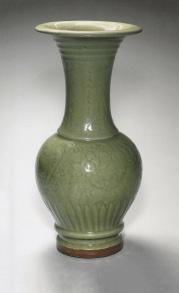
Estimate EUR 8,000
Starting price EUR 4,000
123 83
Joseph Rondina standing at the entrance of his store on Madison Avenue
A LARGE AND VERY HEAVY BLUE AND WHITE ‘HUNDRED DEER’ JARDINIÈRE, MING DYNASTY
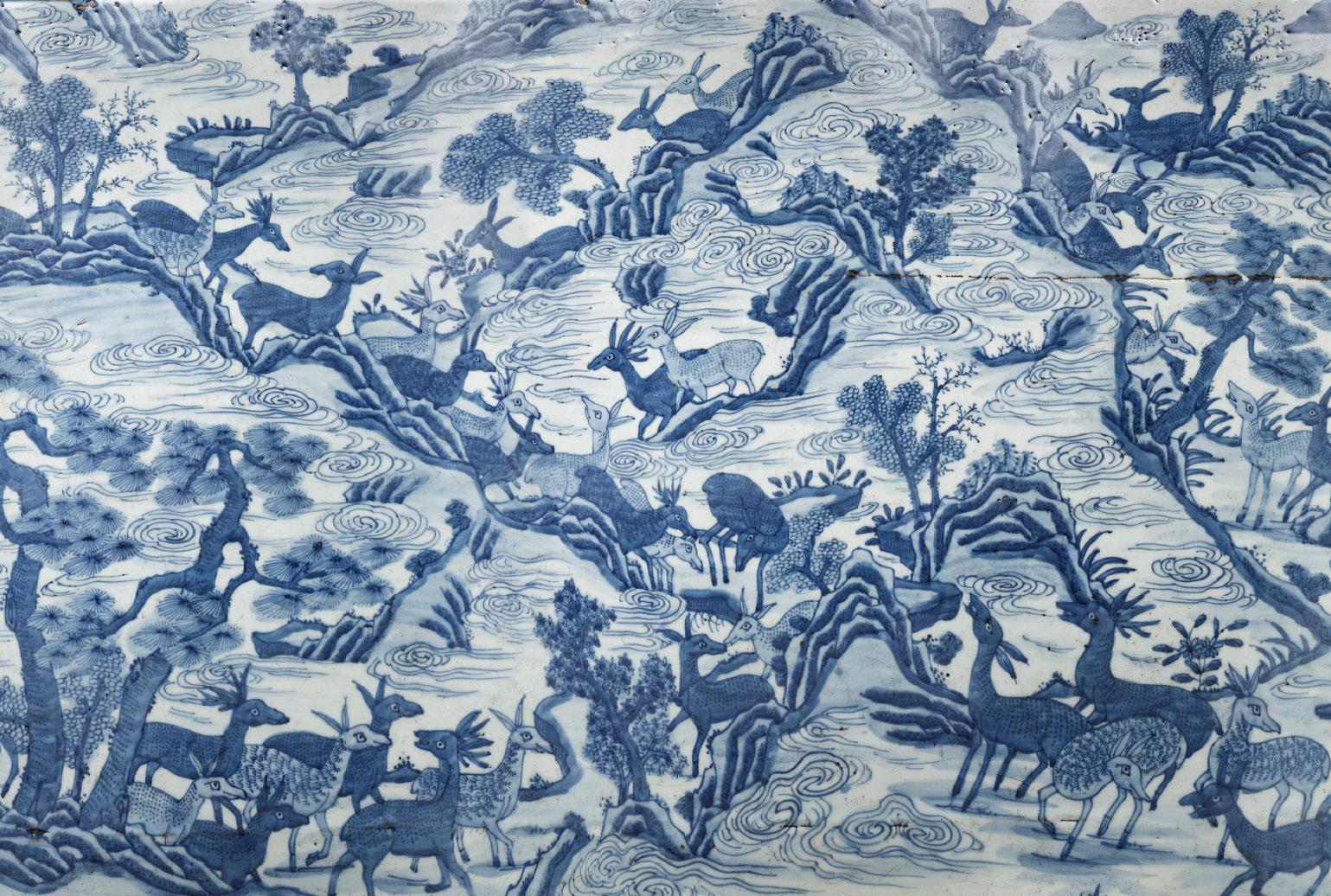
China, 1368-1644, second half of the 16th to early 17th century. Sturdily potted, of conical form, finely painted to the exterior in various shades of underglaze blue with a mountain landscape depicting one hundred deer amid scrolling clouds, rockwork and trees. The upper rim with a border of meandering vines interspersed with blossoms, and a double line above the foot.
Provenance: Wiltshire, United Kingdom, local trade. By repute acquired from a private estate.
Condition: Good condition, commensurate with age, showing extensive old wear, surface scratches, and manufacturing flaws including glaze recesses, pitting, firing flaws, and firing cracks, all exactly as expected from a large porcelain jardinière from this period. Displaying exceptionally well.
Weight: 38.9 kg
Dimensions: Height 51.6 cm, Diameter 58.9 cm
The ‘hundred deer’ motif was very popular, as the landscape depicted contains important symbolic references. The subject of deer has a long history in Chinese art, as it refers to the rebus where the Chinese word for ‘deer’ is a homophone for ‘emolument’ or ‘civil service salary’. The ‘hundred deer’ motif therefore represents the ultimate success, a career in government service in Imperial China.
In the troubled times of the late Ming dynasty emperors were particularly keen for evidence of Heaven’s blessing on their rule. Hu Zongxian (1512-1565) for example, submitted a memorial to the Jiajing emperor on the sighting of a rare white deer – a good omen for the superstitious Jiajing emperor – for which Hu was richly rewarded. Jars such as the present lot, decorated with deer, were particularly favored at Court during the second half of the 16th century and early 17th century.
Literature comparison: Compare a related Wanli ‘hundred deer’ jar in the collection of the Musée Guimet, Paris, illustrated in Alexandre Hougron, La Céramique Chinoise Ancienne, Paris, 2015, page 138. Compare a pair of blue and white jars and covers of related design, in the Museum of Far Eastern Antiquities, Stockholm, illustrated in Oriental Ceramics, volume 8, pl. 247, and by D.Lion-Goldschmidt, Ming Ceramics, New York, 1978, page 187, no. 183.
AUCTION RESULT COMPARISON
Type: Closely related
Auction: Sotheby’s Hong Kong, 25 May 2022, lot 457
Price: HKD 126,000 or approx. EUR 15,500 converted at the time of writing
Description: A large blue and white ‘hundred deer’ jardinière, Ming dynasty, Wanli period Expert remark: Compare the related motif. Note the much smaller size of only 34.5 cm.

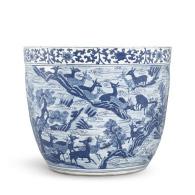
AUCTION RESULT COMPARISON
Type: Closely related
Auction: Bonhams London, 3 November 2022, lot 145
Price: GBP 69,600 or approx. EUR 81,000 converted at the time of writing
Description: A rare large blue and white ‘hundred’ deer jar, Wanli Expert remark: Compare the closely related motif and near-identical size (55 cm). Note the different form.
Estimate EUR 10,000
Starting price EUR 5,000
84


A WUCAI GLAZED ‘HEAVENLY HORSES’ BALUSTER JAR AND COVER, TRANSITIONAL PERIOD

China, c. 1640-1660. Of baluster form, the broad shoulders tapering to a flat base, surmounted by a slender cylindrical neck and domed cover, brightly painted in underglaze blue and enamels, with four horses galloping amid auspicious symbols above tall mountain peaks, all reserved on a dense ground of swirling iron-red waves capped with green froth and dotted with plum blossoms, the shoulder with an ice-crack band below a band of stiff leaves to the neck, the domed cover similarly decorated, with a broad rim decorated with an iron-red scroll band, and surmounted by a bud finial.
Provenance: British trade. By reputed acquired from a private estate in London.
Condition: Good condition with extensive old wear, few small glaze flakes, a hairline to the upper rim of the vessel, and manufacturing flaws including firing cracks, kiln grit, dark spots, fritting and pitting. The wood base with small cracks and an old repair to the legs.
Weight: 3,962 g (excl. base) and 4,526 g (incl. base)
Dimensions: Height 39 cm (excl. base) and 45 cm (incl. base)
With a fitted wood base. (2)
Literature comparison: Similar examples of this type are illustrated in E.W. Van Orsoy de Flines, Guide to the Ceramic Collection, Museum Pusat Djakarta, 1969, pl. 60, no. 1816, and A. Du Boulay, Christie’s Pictorial History of Chinese Ceramics, New Jersey, 1984, p. 194, nos. 5 and 6.
AUCTION RESULT COMPARISON
Type: Closely related
Auction: Sotheby’s New York, 24 March 2021, lot 685
Price: USD 12,600 or approx. EUR 13,500 converted and adjusted for inflation at the time of writing
Description: A wucai ‘horse’ jar and cover, Qing dynasty, 17th century
Expert remark: Compare the closely related form, decoration and size (39.3 cm). Note the condition issues.
AUCTION RESULT COMPARISON
Type: Closely related
Auction: Christie’s New York, 19 September 2007, lot 286
Price: USD 17,500 or approx. EUR 24,000 converted and adjusted for inflation at the time of writing
Description: A wucai baluster jar, transitional period, circa 1640-1660


Expert remark: Compare the closely related form and decoration. Note the size (30.7 cm) and missing cover.
Estimate EUR 6,000
Starting price EUR 3,000
126
85

A RARE BLUE AND WHITE ‘DRAGON’ CENSER, WANLI MARK AND PERIOD
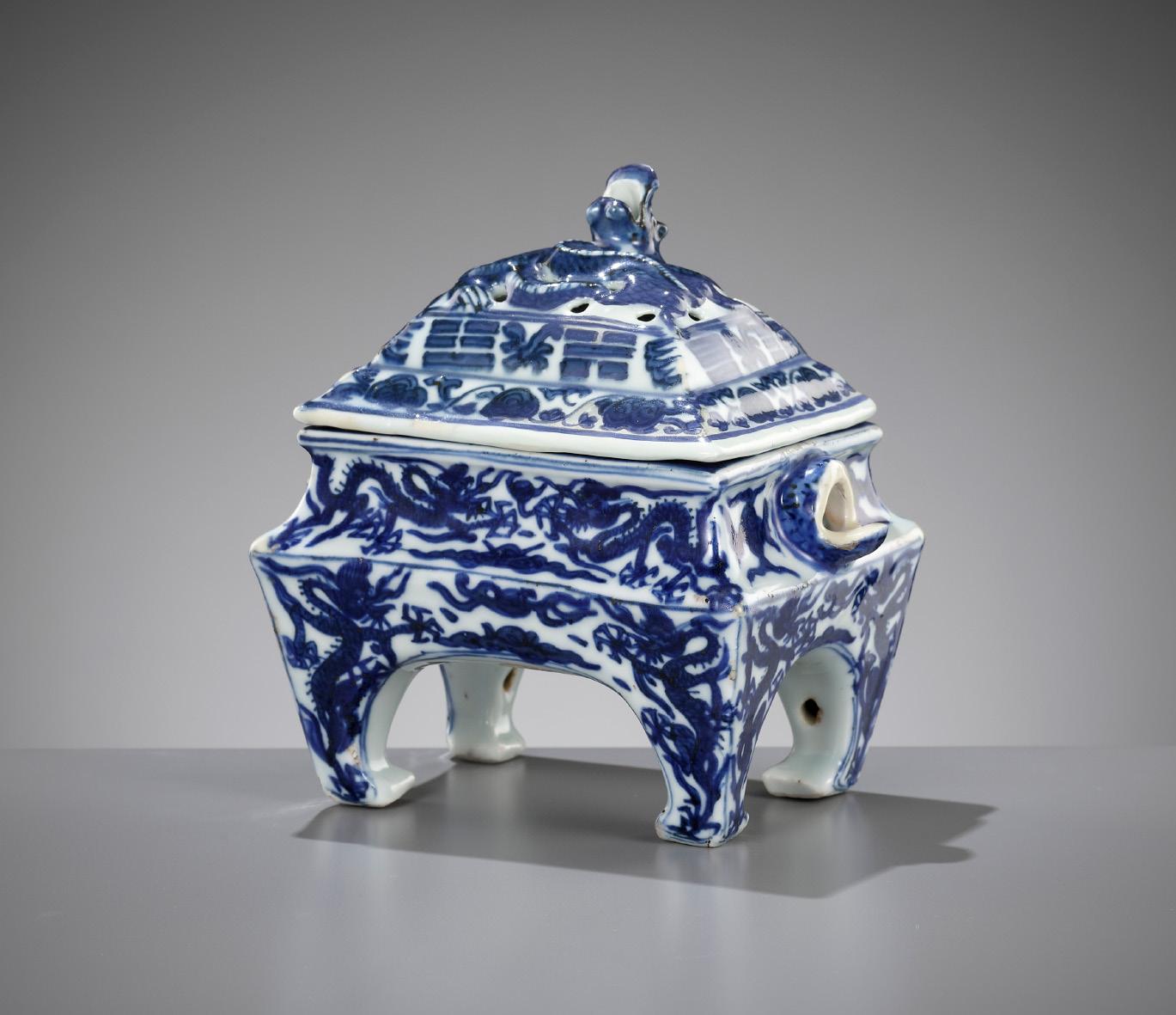
China, 1573-1619. Heavily potted, the body of rectangular form with four graduated square in-curved legs, the body applied with two animal mask handles, lively painted with twelve five-clawed dragons amongst clouds and flames, the stepped cover with bands of ruyi scrolls and trigrams, below a pierced dragon finial. The base with an underglaze-blue six-character mark da Ming Wanli nianzhi within a double rectangular and of the period.
Provenance: From the estate of Ivar Björnberg (1934-2021), who was a noted art director from Stockholm, Sweden. He was friends with Victoria Lindström, a reputed dealer and collector of Chinese art, also based in Stockholm at the time. Björnberg worked at her gallery at a young age and when he eventually started his own collection, she mentored him. His collection was an academic one and it showed his keen eye, discerning taste and great passion for the aesthetics of Chinese art. Condition: The vessel with smoothened losses to mask handles and small chips to edges, both with old fills and touchups. The lid with one section of the cover broken off and reattached, associated overpainting, and small chips to edges with old fills and touchups.
Weight: 757 g
Dimensions: Height 13.5 cm, Length 13.5 cm
Literature comparison: See a similar censer, but lacking a cover, in the Idemitsu Museum of Arts, illustrated in Imperial overglaze - Enamelled Wares in the Late Ming Dynasty, Osaka, 1995, pl. 735, and another from the collection of Gustaf Hillestrom, Stockholm, included in the exhibition Ming Blue-and-white, The Museum of Far Eastern Antiquities, Stockholm, 1964, cat. no. 75.
AUCTION RESULT COMPARISON
Type: Closely related
Auction: Christie’s New York, 17 March 2017, lot 1187
Price: USD 25,000 or approx. EUR 27,500 converted and adjusted for inflation at the time of writing
Description: A rare blue and white rectangular censer, Wanli six-character mark within a double rectangle and of the period
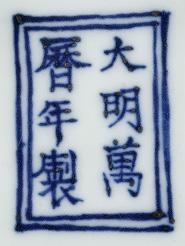
Expert remark: Compare the closely related form, decoration, and mark, as well as the near-identical size (13.5 cm). Note that the vessel has condition issues (ring handles missing, firing crack to corner with associated shallow chips, one re-stuck, shallow chip to one rim corner, and another shallow chip above one foot, expected small glaze flakes, frits and burst bubbles). Also note the missing cover.
AUCTION RESULT COMPARISON
Type: Closely related
Auction: Sotheby’s London, 4 November 2009, lot 68
Price: GBP 39,650 or approx. EUR 64,000 converted and adjusted for inflation at the time of writing
Description: A blue and white dragon censer and cover, Ming dynasty, Wanli mark and period


Expert remark: Compare the closely related form, decoration, and mark. Note the slightly larger size (16.2 cm). Also note that this piece has significant condition issues and is extensively restored, the condition report is available online.
Estimate EUR 10,000
Starting price EUR 5,000
128 86
A FAMILLE VERTE ‘FLORAL’ DISH, KANGXI MARK AND PERIOD
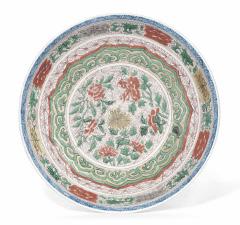

China, 1662-1722. The interior finely decorated in shades of yellow, aubergine, green, and iron-red with a petal-lobed medallion enclosing peonies and other flowers growing from behind a tall pierced craggy rock, encircled by a band of peonies against a trellis-patterned ground followed by a band of chrysanthemums and leafy stems, all below a narrow geometric band in underglaze-blue. The base with an underglaze-blue six-character mark da Qing Kangxi nianzhi and of the period.
Provenance: French trade, by repute acquired from an old private estate in northeastern France. The base with an old label.
Condition: Good condition with expected old wear, little rubbing to enamels, few small chips to rim.
Weight: 1,282 g
Dimensions: Diameter 32.6 cm
The exterior similarly painted with floral sprays above a band of stiff leaves. The deep rounded sides supported on a short tapered foot with channeled foot rim and rising to an everted rim.
AUCTION RESULT COMPARISON
Type: Closely related
Auction: Christie’s London, 22 January 2013, lot 319
Price: GBP 5,000 or approx. EUR 7,500 converted and adjusted for inflation at the time of writing
Description: A Chinese famille verte dish, Kangxi underglaze blue six-character mark and of the period
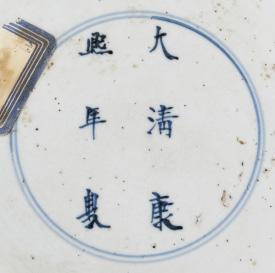
Expert remark: Compare the closely related decoration with similar colors, floral motif, trellis-patterned ground, underglaze-blue band below the rim, and Kangxi reign mark. Note the near-identical size (33 cm).
Estimate EUR 4,000
Starting price EUR 2,000
129
87
A RARE SANCAI GLAZED ‘BOVINE’ RHYTON, KANGXI PERIOD
China, 1662-1722. Well modeled in the form of a bovine head with two horns joined by a raised rope leading to the animal’s nostrils. Further detailed with large eyes and splashed with aubergine, green, and ochre glazes, all typical for this ware and as expected for the period.

Provenance: Stefanos Lagonico, Alexandria, and thence by descent over several generations in the same family. Stefanos Lagonico was a member of the wealthy Greek community of Alexandria whose family settled in Egypt in the late 19th century. His collection of important Iznik ceramics was formed after the First World War, comprising mostly plates and jugs from the classic period (post 1570). At least six pieces from this collection were included in the important 1925 Exposition d’Art Musulman in Alexandria. Lagonico eventually left Egypt for Switzerland, just before the rise of nationalism and the abolition of the Capitulations in May 1937. His son Jean, an importer of dried fruits and nuts from the Levant, inherited most of the collection, and kept it in obscurity at his house in southern France until its dispersal at auction beginning in 1991.
Condition: Fine wear overall. Some firing irregularities, minuscule hairlines, the horns with small old repairs, a minute chip with associated fill to the rim.
Weight: 161.5 g (excl. base) and 225.5 g (incl. base)
Dimensions: Length 11.7 cm (excl. base) and 11 cm (the base)
With a fitted huali wood base from the late 19th century. (2)

Estimate EUR 2,000
Starting price EUR 1,000
130
88
A FAMILLE VERTE ‘LADIES’ DISH, KANGXI PERIOD
China, 1661-1722. The shallow dish with scalloped rim, boldly painted in gilt and bright enamels of emerald-green, apple-green, yellow, red, and aubergine, as well as iron-red. The central roundel depicting two court ladies in a garden beside a prunus tree, a table with antique treasures to their right, encircled by a band of floral sprays interspersed with four cartouches enclosing Buddhist lions and auspicious objects. The rim painted with gilt and iron-red lappets.


Provenance: From the private collection of Richard and Maxine Markell. Richard Markell (1932-2021) was the son of chiropractor Maurice J. Markell, who established the family business Markell Shoes focusing on orthopedic footwear and orthotic devices. Richard and his wife Maxine (1935-2019) were avid collectors of Asian art, specializing in Chinese porcelain. Over the years, the couple amassed an extraordinary selection of extremely well-enameled pieces. They bought from some of the best dealers of their generation, and their purchases spanned 250 years of Chinese porcelain production. Their earliest works date from the beginning of the Qing dynasty, and generally reflect the Western taste for the famille verte and famille rose wares of the Kangxi, Yongzheng, and Qianlong reigns.
Condition: Very good condition with only minor old wear and manufacturing flaws including pitting and dark spots, and minor fritting.
Weight: 495.5 g
Dimensions: Diameter 23.7 cm
AUCTION RESULT COMPARISON
Type: Closely related
Auction: Christie’s New York, 26 January 2015, lot 65
Price: USD 9,375 or approx. EUR 11,500 converted and adjusted for inflation at the time of writing
Description: A famille verte dish, Kangxi period
Expert remark: Compare the closely related from, motif, rim, and glaze. Note the larger size (38 cm).
Estimate EUR 3,000
Starting price EUR 1,500
89
A POWDER-BLUE GROUND ‘THREE CARP’ BOTTLE VASE, KANGXI PERIOD


China, 1662-1722. The globular body rising from a short foot to a tall cylindrical neck, finely painted with three large iron-red carps swimming among gilt-decorated algae, floral blooms, and small aquatic creatures, the confronting carps with black pupils and gilt highlights.
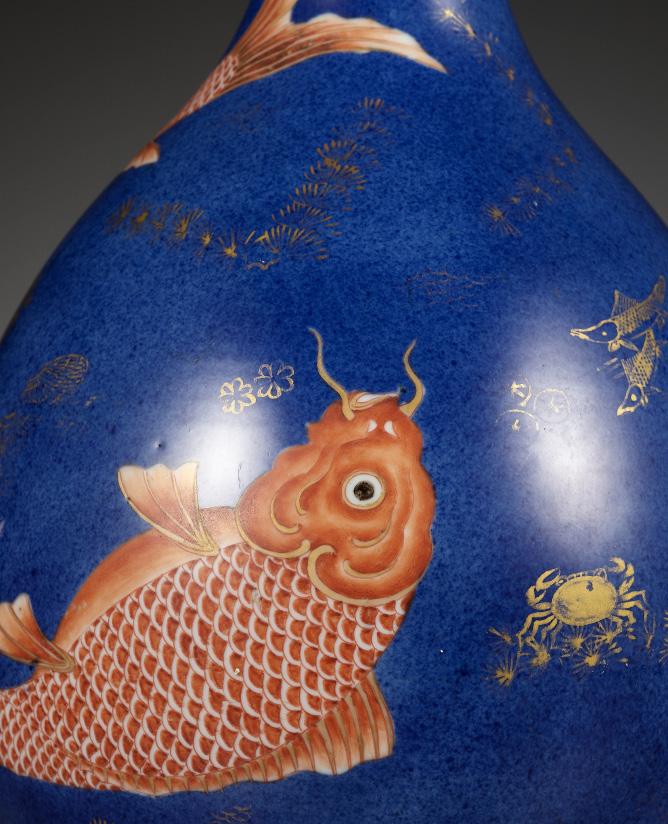
Provenance: British trade.
Condition: Very good condition with minor wear and firing irregularities, some rubbing to gilt, light surface scratches to base, the vase slightly leaning.
Weight: 2,638 g
Dimensions: Height 44 cm
Expert’s note: A 19th-century dating for the present vase can be safely excluded due to the fine use of and characteristic wear to the gilt, the skillful shadings of the iron-red, the brilliance of the powder-blue glaze, as well as the distinct pottery marks inside the neck and the fact that the vase is slightly leaning. These features do not appear in such coherent unity on later pieces, removing any doubt as to the Kangxi dating of this piece.
AUCTION RESULT COMPARISON
Type: Related
Auction: Christie’s London, 5 November 2013, lot 417
Price: GBP 20,000 or approx. EUR 29,500 converted and adjusted for inflation at the time of writing
Description: A pair of powder-blue ground ironred and gilt decorated vases, Kangxi period

Expert remark: Compare the closely related subject, manner of painting, and decoration with similar iron-red and gilt on a powder-blue ground. Note the smaller size (36.1 cm), different form, and that the lot comprises a pair.
AUCTION RESULT COMPARISON
Type: Related
Auction: Christie’s New York, 29 March 2006, lot 444
Price: USD 15,600 or approx. EUR 21,500 adjusted for inflation at the time of writing
Description: An Iron-Red and Gilt-Decorated PowderBlue-Ground Rouleau Vase, Kangxi Period (1662-1722)
Expert remark: Compare the closely related subject with four carps painted in similar iron-red and gilt on a powder-blue ground. Also note the similar size (45.1 cm).
Estimate EUR 4,000
Starting price EUR 2,000
132 90
A SQUARE COPPER-RED AND UNDERGLAZE-BLUE ‘LOTUS’ VASE, EARLY QING DYNASTY

China, 18th century. Finely painted with variously shaped panels enclosing flowers and rockwork, surrounded by lotus blossoms borne on leafy scrolling vines. Covered in a transparent glaze save for the unglazed broad foot rim, the recessed square in the center glazed as well.
Provenance: British trade.
Condition: Very good condition with minor old wear and expected firing irregularities typical of period and ware, minor fritting to shoulders, tiny frits to rim and edges. The vase slightly leaning.
Weight: 3,927 g
Dimensions: Height 44 cm
AUCTION RESULT COMPARISON
Type: Related
Auction: Sotheby’s New York, 21 September 2022, lot
391
Price: USD 25,200 or approx. EUR 23,500 converted at the time of writing
Description: A copper-red and underglaze-blue ‘landscape’ quadrangular vase, Qing dynasty, Kangxi period
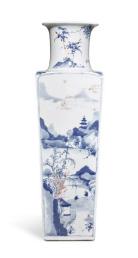
Expert remark: Compare the closely related form and underglaze-blue and copper-red decoration. Note the related size (46.4 cm). Note also that unlike the present lot this vase has considerable condition issues, including a restored break at the mouth rim, a restored chip to one shoulder, a hairline crack, and overspray.
Estimate EUR 4,000
Starting price EUR 2,000
133 91
92
A BLUE AND WHITE ‘ANTIQUE TREASURES’ BOTTLE VASE, KANGXI PERIOD

Inscriptions: To the neck, ‘As an accompaniment on the table, clearing the air in the Qin studio’, and with two seals, ‘[…] quan’ and ‘Juanqing’.
China, 1662-1722. Exceptionally well painted in neatly graduated shades of deep cobalt blue with precious objects including censers, a quadrilobed vase holding a coral branch and a peacock feather, a ruyi scepter, and a qin, as well as shaped panels enclosing landscapes. The slightly waisted neck further with a ruyi-head border. The compressed globular body supported on a massive, spreading foot.
Provenance: From an English private collection, and thence by descent within the family.
Condition: Good condition commensurate with age with minor wear and expected firing irregularities, including few dark spots and minute glaze recesses, a stabilized hairline and tiny old fills, the foot with few minuscule chips, minor crackling to base.
Weight: 3,200 g
Dimensions: Height 42.7 cm
The base with an apocryphal underglaze-blue six-character mark da Ming Jiajing nianzhi

AUCTION RESULT COMPARISON
Type: Closely related
Auction: Christie’s New York, 24 March 2011, lot 1658
Price: USD 35,000 or approx. EUR 43,500 converted and adjusted for inflation at the time of writing
Description: An unusual large blue and white bottle vase, Kangxi period

Expert remark: Compare the closely related form and decoration. Note the near-identical size (45.7 cm).
Estimate EUR 10,000
Starting price EUR 5,000
134

A RARE BLUE AND WHITE ‘EIGHT IMMORTALS’ BEAKER VASE, GU, KANGXI PERIOD
China, 1662-1722. The vase is well painted in bright blue tones with ogival-shaped reserves, each enclosing one of the Eight Immortals, four on the neck, two on the convex mid-section, and two on the lower body, all reserved on a diaper ground between various decorative borders.
Provenance: From an old French private estate.
Condition: Very good condition with some old wear and shallow surface scratches overall, scattered firing irregularities such as pitting, glaze recesses, dark spots. The cobalt-blue with small areas of firingrelated fading, as expected from this group. The vase slightly leaning.
Weight: 2,740 g
Dimensions: Height 43.7 cm
The Baxian (Eight Immortals) are a legendary group of Chinese heroes who fight to vanquish evil. Popular during the Tang and Shang dynasties, these Eight Immortals were said to live on a group of five islands in the Bohai Sea. Their stories were first recorded by the Ming dynasty poet Wu Yuantai. Their status as fabled folk icons makes them well-known in popular culture.
Literature comparison: A similarly decorated blue and white baluster vase, dated to the Kangxi period, is illustrated in Blue and White Porcelain with Underglazed Red III: Complete Collection of Treasures of the Palace Museum, vol. 36, Hong Kong, 2000, page 33, no. 27.

AUCTION RESULT COMPARISON
Type: Closely related
Auction: Christie’s New York, 21 March 2014, lot
2132
Price: USD 37,500 or approx. EUR 45,500 converted and adjusted for inflation at the time of writing
Description: A blue and white beaker vase, Kangxi period
Expert remark: Compare the closely related form, subject, decoration with similar panels, geometric bands, and diapered ground. Note the identical size (43.7 cm). Also compare the cobalt-blue with small areas of firing-related fading, as expected from this group.
Auction result comparison:
Type: Closely related
Auction: Sotheby’s New York, 18 September 2007, lot 273
Estimate: USD 30,000 or approx. EUR 41,000 converted and adjusted for inflation at the time of writing
Description: A rare blue and white yen-yen vase, Qing dynasty, Kangxi period

Expert remark: Compare the closely related subject and decoration with similar panels, geometric bands, and diapered ground. Note the size (45.7 cm) and phoenix tail form.
Estimate EUR 12,000
Starting price EUR 6,000
136 93


China, 1662-1722. Of cylindrical form with a flaring mouth and foot, the bulging middle section vibrantly painted with detached floral sprigs, leaves, and a beetle, below a river landscape scene with a sage and his attendant walking toward a bridge below towering trees and swirling clouds, and above a similar landscape scene with the same sage and attendant continuing their journey as well as a fisherman in a boat and a scholar seated on a rocky outcrop.
Provenance: From a private collection in Oxfordshire, United Kingdom, acquired in London during the 1990s.
Condition: Good condition with some old wear and expected firing irregularities, a small chip to the rim, minor fritting to the rim and lower bowstring, drilled to base with associated glaze nibbles, the foot with a tiny chip. Small smoothened areas, possibly inherent to the manufacture. The vase slightly leaning. Overall presenting spectacularly well.
Weight: 2,979 g
Dimensions: Height 43 cm
The base with an apocryphal underglaze-blue six-character mark da Ming Chenghua nianzhi
AUCTION RESULT COMPARISON
Type: Closely related
Auction: Christie’s Hong Kong, 11 June 2021, lot
3253
Price: HKD 250,000 or approx. EUR 30,500 converted and adjusted for inflation at the time of writing
Description: A large blue and white ‘figural’ gu-form beaker vase, Kangxi period
Expert remark: Compare the closely related form, subject, decoration, and manner of painting. Note the related size (44.5 cm) and empty double circle to base.
AUCTION RESULT COMPARISON
Type: Closely related
Auction: Sotheby’s New York, 19 March 2013, lot
138
Price: USD 37,500 or approx. EUR 45,000 converted and adjusted for inflation at the time of writing
Description: A blue and white beaker vase (gu), Qing dynasty, Kangxi period

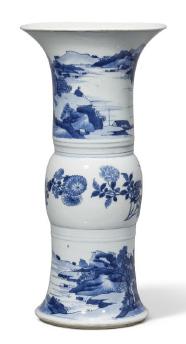
Expert remark: Compare the closely related form, decoration, manner of painting, and apocryphal Chenghua reign mark. Note the related size (44.7 cm).
Estimate EUR 8,000
Starting price EUR 4,000
139 94
A BLUE AND WHITE ‘SAGE AND ATTENDANT’ BEAKER VASE, GU, KANGXI PERIOD
China, 1662-1722. Painted in deep purplish underglaze blue with figures in mountainous river landscapes, on both the body and the neck a scholar converses with an attendant on a river bank while a fisherman is in a sampan in the river nearby. Note the finely graduated shades of blue, adding a third dimension to the magnificent scene.
Provenance: The Holzapfel Collection (label to base). A Swedish private collection, formed during the 1950s and 1960s, acquired from the above, and thence by descent in the family.

Condition: The mouth rim with a small chip and associated old fill. A U-shaped crack extending from there, with a section of the mouth broken off and sensitively reattached. Some wear, expected firing irregularities, extensive fritting to rim, but no spraying or overpainting of any kind.
Weight: 3,536 g
Dimensions: Height 44 cm
AUCTION RESULT COMPARISON
Type: Closely related
Auction: Christie’s New York, 29 March 2006, lot 431
Price: USD 27,600 or approx. EUR 37,000 converted and adjusted for inflation at the time of writing
Description: A blue and white yenyen vase, Kangxi period


Expert remark: Note the size (45.1 cm)
Estimate EUR 4,000
Starting price EUR 2,000
140
95 A BLUE AND WHITE YENYEN VASE, KANGXI PERIOD
A RARE PAIR OF MING-STYLE GREEN-ENAMELED ‘DRAGON’ BOWLS, KANGXI PERIOD
China, 1662-1722. Each with deep rounded sides supported on a short foot and rising to an everted rim, the exterior finely incised with two five-clawed dragons amid flames and clouds, reserved on the biscuit and covered with green enamel, the interior similarly decorated with three clouds.
Provenance: From an old German private collection, acquired in 1980 and thence by descent in the same family. German trade, acquired from the above.
Condition: Excellent condition with only very minor old wear and some firing irregularities.
Weight: 338 g and 345.9 g (excl. stands)
Dimensions: Diameter 18.7 and 18.9 cm
The recessed bases each with an apocryphal underglaze-blue six-character mark da Ming Chenghua nianzhi within a double circle.
Each bowl with a finely carved zitan stand, dating from the Qing dynasty. (4) Imperial porcelain bowls decorated with green-enameled dragons first appeared in the Chenghua period, with and sometimes without reign marks, and either enameled with dragons over the glaze or over the biscuit. More were manufactured in later periods of the Ming dynasty, particularly during the Hongzhi and Zhengde reigns, where they were always inscribed with their corresponding reign marks. This motif, which is also found on matching saucer dishes, required each vessel to be fired twice: First the design was incised on the biscuit and covered with a layer of wax, which would melt during the first firing and reveal the pinkish buff body underneath. This was later filled with green enamel and fired a second time at a much lower temperature. The result is rather spectacular, because the dragons appear as if they are literally leaping off the surface of the bowls.
LITERATURE COMPARISON
For the Chenghua prototype of this design, see two bowls with dragons enameled over the biscuit silhouettes, in the National Palace Museum, Taipei, included in the Museum’s exhibition Chenghua ciqi tezhan (Special Exhibition of Ch’eng-Hua Porcelain Ware), Taipei, 2003, cat. nos. 110 and 111. Porcelain wares decorated with green dragons continued to be produced in the Qing dynasty, from the Kangxi to the Guangxu reigns, such as a dish with an apocryphal Hongzhi mark, in the Palace Museum, Beijing, illustrated in Miscellaneous Enameled Porcelains, Plain Tricolour Porcelains. The Complete Collection of Treasures in the Palace Museum, Shanghai, 2009, pl. 75.


AUCTION RESULT COMPARISON
Type: Closely related
Auction: Christie’s London, 20 February 2020, lot 134
Price: GBP 23,750 or approx. EUR 31,000 converted and adjusted for inflation at the time of writing
Description: A green-enameled ‘dragon’ bowl, 18th century Expert remark: Compare the closely related form, incised and greenenameled dragon design, apocryphal Ming reign mark, and nearidentical size (18.4 cm)


Estimate EUR 12,000
Starting price EUR 6,000
141 96
A SUPERB DOUCAI DOUBLE-GOURD VASE, LINGZHI MARK, LATE 17TH TO EARLY 18TH CENTURY
China, c. 1680-1730. Finely painted in underglaze blue and enamels in shades of green, red, yellow, and aubergine to the upper pearshaped section with three boys at play and to the lower section with a continuous scene of officials meeting foreign envoys in a garden with palm trees and lingbi stones. The recessed base with a lingzhi fungus mark within a double circle, neatly painted in underglaze blue.

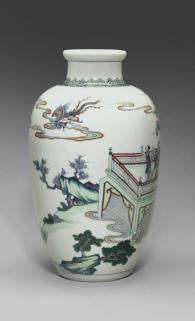
Provenance: A noted private collection in Texas, USA. Christie’s New York, 19 March 2021, lot 871 (dated 18th century), sold for USD 15,000 or approx. EUR 15,000 (converted and adjusted for inflation at the time of writing). A private collector, acquired from the above. A copy of the original invoice from Christie’s accompanies this lot.
Condition: Magnificent condition with only minor wear to enamels, some shallow surface scratches here and there, and few firing irregularities. Extremely rare to find an authentic, early and large piece of Doucai ware in such a pristine state of preservation.
Weight: 957 g
Dimensions: Height 26.5 cm
Expert’s note: During the early Qing dynasty, up until the 1680s, conditions were unsettled in China and the making of Imperial wares as well as the use of reign marks on porcelain was restricted in various ways. During this period, different types of other marks came into use, including lingzhi fungus marks in double circles.
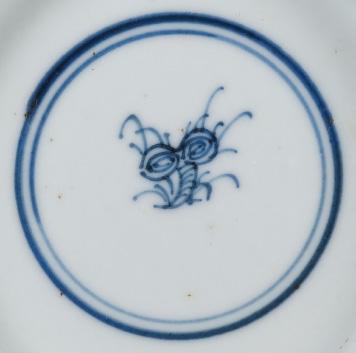
AUCTION RESULT COMPARISON
Type: Closely related
Auction: Christie’s New York, 17 March 2017, lot 1213
Price: USD 118,750 or approx. EUR 131,000 converted and adjusted for inflation at the time of writing

Description: A Large Doucai Vase, KangxiYongzheng Period (1662-1735)
Expert remark: Compare the subject, style of painting, enamels, and material. Note the larger size (39 cm).
Estimate EUR 10,000
Starting price EUR 5,000
142 97
A FAMILLE VERTE BRUSHPOT, BITONG, KANGXI PERIOD
China, c. 1700. Well potted, of cylindrical form with straight sides finely decorated to the exterior in bright enamels with a court lady and young boy playing in a fenced garden amid blossoming flowers, gnarled trees, and craggy rockwork as well as a stool behind the lady. The base with an unglazed ring between the foot rim and countersunk center.
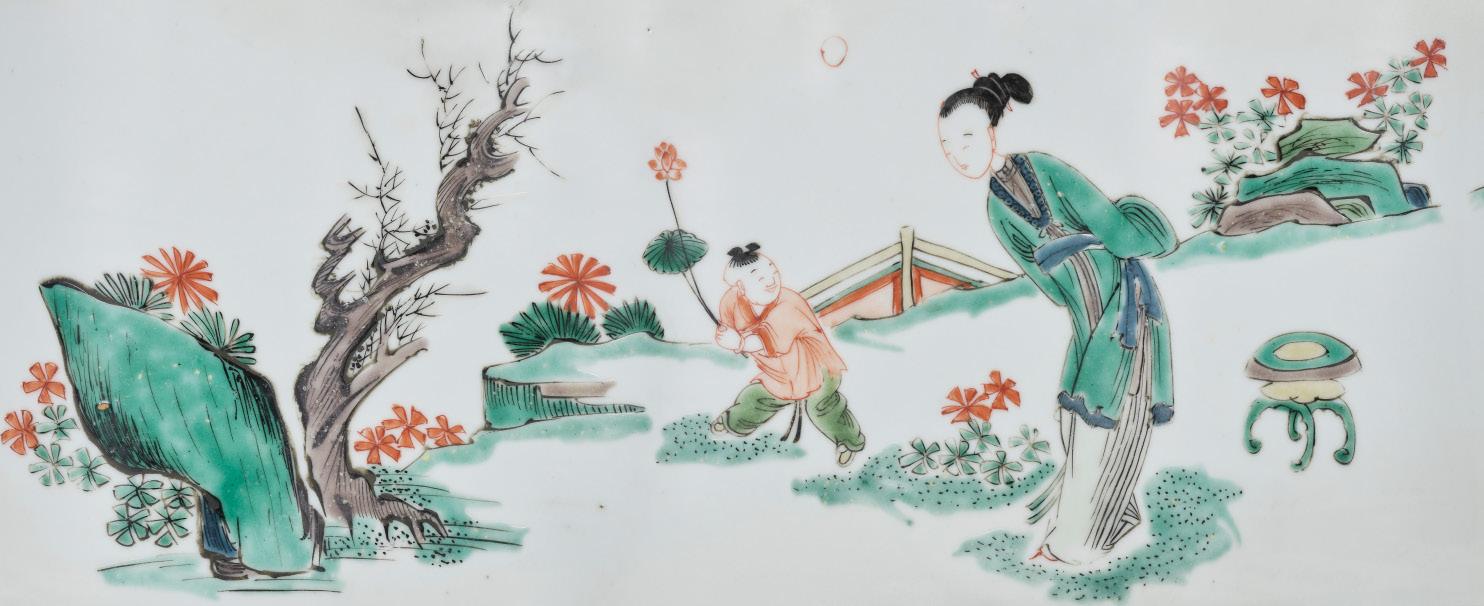

Provenance: Arts et Décors, Zurich, Switzerland, 1991. A private collection in Berlin, Germany, acquired from the above. The base with an old label, ‘J10N000’. A copy of a signed “Pedigree” certificate from Arts et Décors, dated 11 September 1991, confirming the dating above, accompanies this lot. Arts et Décors was a noted gallery in Zurich run by Marguerite IseliMooser, who has been described as the “Grand Dame” of the Swiss antique trade. The gallery was a hot spot among international collectors of 18th-century French furniture for many decades. After her retirement in 2004, Koller conducted a single owner sale of her inventory and part of her private collection, which also included Chinese porcelain of the 18th and 19th centuries. Condition: Good condition with minor old wear and some firing irregularities. The mouth and foot rim with minor fritting and associated small touchups and fills.
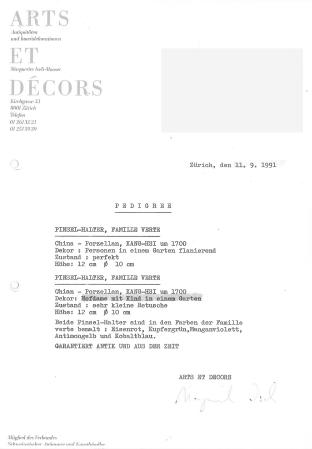
Weight: 657 g
Dimensions: Height 11.8 cm
AUCTION RESULT COMPARISON
Type: Closely related
Auction: Christie’s London, 6 November 2013, lot
970
Price: GBP 11,250 or approx. EUR 16,500 converted and adjusted for inflation at the time of writing
Description: A Chinese famille verte brush pot, bitong, Kangxi period
Expert remark: Compare the closely related form, decoration, and subject. Note the size (12.5 cm).
AUCTION RESULT COMPARISON
Type: Closely related
Auction: Sotheby’s New York, 18 March 2014, lot 431
Price: USD 23,750 or approx. EUR 27,000 converted and adjusted for inflation at the time of writing
Description: A famille-verte cylindrical brushpot, Qing dynasty, Kangxi period


Expert remark: Compare the closely related form, decoration, subject, and size (13.3 cm).
Estimate EUR 6,000
Starting price EUR 3,000
143 98
A RARE WUCAI ‘MONTH’ CUP, KANGXI MARK AND PERIOD

China, 1662-1722. Delicately potted with deep rounded sides rising from a short foot to a flared rim, superbly enameled around the exterior with a red-flowering peach tree with small blossoms among scant leaves, representing the third month, the reverse inscribed in underglaze blue with a poem followed by a seal mark, the recessed base with an underglaze-blue six-character mark da Qing Kangxi nianzhi and of the period.
Inscriptions: To one side, ‘Fenghua xinshe yan / shijie jiuchun nong’ (The swallow returns when the blossoms sway in the breeze / It is the season in late spring when farmers return to their fields). One seal, ‘Shang’ (appreciation).
Provenance: From the collection of Carl Gustav Kjellin, acquired in Shanghai during the 1940s, and thence by descent in the family. Carl Gustav Kjellin (1910-1990) was a Swedish diplomat who was stationed in China until 1945 and thereafter at the Swedish embassy in Tokyo. He acquired most of his collection of Chinese porcelain and works of art during his time in Asia.
Condition: Perfect condition with only minor wear. Minimal firing irregularities, including a microscopic glaze blister of less than 2 mm to the rim.
Weight: 28.5 g
Dimensions: Diameter 6.5 cm
This finely potted cup is one of the so-called ‘month cups’, made at the imperial kilns during the Kangxi reign. One was made for each month of the lunar calendar. As in the case of the current example, these cups are so thinly potted that the blue of the inscription on the exterior can be seen through the porcelain from the interior of the vessel. Their decoration is characterized by very delicately painted decoration in underglaze blue and wucai enamels. Each of the cups has on one side a floral design appropriate to a particular month, and on the other side a poem which complements the design. Each of the cups also bears an underglaze blue seal character after the poem, which can be read as ‘shang’ (appreciation).

LITERATURE
COMPARISON
Compare a closely related cup included in the Oriental Ceramic Society
exhibition
Enamelled Polychrome Porcelain of the Manchu Dynasty (1644-1912), London, 1951, cat. no. 253. The Percival David Foundation in London has one of the few complete sets of cups for all twelve months, now in the collection of the British Museum, registration number PDF.815. The design on the current cup is very similar to the third month cup in the Percival David Foundation and bears the same poem, see Rosemary Scott, For the Imperial Court - Qing Porcelain from the Percival David Foundation of Chinese Art, New York, 1997, pp. 82-83, no. 23. The Palace Museum, Bejing owns at least two sets, illustrated in Chugoku toji zenshu (Complete works on Chinese ceramics), Kyoto, 1981-86, vol. 21, pl. 61, and in Kangxi, Yongzheng, Qianlong - Qing Porcelain from the Palace Museum Collection, Hong Kong, 1989, page 65, no. 48. One is in the Idemitsu Museum of Art, Tokyo, illustrated in Idemitsu Bijutsukan zohin zuroku, Chugoku toji (Chinese Ceramics in the Idemitsu Collection), Tokyo, 1987, pl. 221. One set in the Hong Kong Museum of Art was included in the exhibition ‘The Wonders of the Potter’s Palette’, Qing Ceramics from the Collection of the Hong Kong Museum of Art, 1984-5, cat. no. 15.
Auction result comparison:
Type: Closely related
Auction: Sotheby’s Hong Kong, 3 April 2012, lot 45
Estimate: HKD 18,000,000 or approx. EUR 2,756,000 converted and adjusted for inflation at the time of writing
Description: An extremely rare set of twelve wucai ‘month’ cups, marks and period of Kangxi

Expert remark: Note that this lot comprises a complete set of twelve wucai month cups, the third month cup being near identical to the present lot.
AUCTION RESULT COMPARISON
Type: Near identical
Auction: Sotheby’s London, 6 November 2019, lot 149
Price: GBP 112,500 or approx. EUR 149,000 converted and adjusted for inflation at the time of writing
Description: A rare wucai ‘month’ cup, Kangxi mark and period
Expert remark: Compare the near identical form, decoration, enamels, and size (6.5 cm).
AUCTION RESULT COMPARISON
Type: Near identical
Auction: Christie’s Hong Kong, 29 May 2013, lot 1911
Price: HKD 2,670,000 or approx. EUR 393,000 converted and adjusted for inflation at the time of writing
Description: A fine famille verte ‘peach blossom’ cup, Kangxi sixcharacter mark within double-circles and of the period


Expert remark: Compare the near identical form, decoration, enamels, and size (6.5 cm). Note that the enamels on this month cup are described as ‘famille verte’. It appears that for these month cups, the terms ‘famille verte’ and ‘wucai’ are interchangeable, however to this author, the term ‘wucai’ seems more accurate due to the presence of underglaze-blue decoration.
Estimate EUR 60,000
Starting price EUR 30,000
144 99

China, 1662-1722. Each bowl is incised on the exterior with four floral roundels divided by cloud scrolls above petal lappets around the foot, the interior with another floral medallion in the center enclosed within a double circle, covered inside and out with an egg-yolk yellow glaze, save for white base. Each bowl with an underglaze-blue six-character mark within a double circle da Qing Kangxi nianzhi and of the period.
Provenance: The VWS Collection, acquired by the previous owner’s father (1890-1977) in China during the 1930s and thence by descent within the family. Each bowl with an old collection label, ‘VWS’. One bowl with an old label, ‘62’. French trade, acquired from the above. The VWS collection tells the extraordinary story of a family fleeing the Tsarist Empire in Russia. Their journey began in 1903 as the Chinese Eastern Railway, the eastern branch of the Trans-Siberian Railway, was completed. Fleeing, like others, a climate of political persecution and anti-Semitism, the family settled in Harbin, the most northerly city in China and started to develop its businesses from 1906 onwards. Like many others, they were attracted to this cosmopolitan place, then a major economic and cultural center in Manchuria, because of its large Jewish community. In Harbin, the father, a cultured, open-minded and multilingual man, felt at home and his early successes in business earned him respect. By 1932, he and his family were forced to flee again, following the Japanese invasion of Manchuria, and found a new home in Shanghai. From there, his businesses took him to Hong Kong, North America, and other Asian countries, where the family would remain for many years. They began collecting art in China during the 1930s and these artworks have remained with the family heirs ever since.
The previous owner’s father (1890-1977), who acquired the present lot in China during the 1930s


LITERATURE COMPARISON
Compare a closely related yellow-glazed incised bowl, 12 cm high, also with a Kangxi mark and of the period, sold at Christie’s London, 13 December 1976, lot 55, and illustrated by Regina Krahl, Chinese Ceramics from the Gulexuan Collection, p. 128, no. 97. A bowl of this design from the Elphinstone collection in the Percival David Foundation, London, is listed in the Foundation’s Illustrated Catalogue of Ming and Qing Monochrome Wares, London, 1989, no. A599. Another bowl of this design from the Kostolany collection was included in the exhibition Monochrome Porcelain of the Ming and Manchu Dynasties, Oriental Ceramic Society, London, 1948, cat. no. 188.
AUCTION RESULT COMPARISON
Type: Near identical
Auction: Christie’s Hong Kong, 26 November 2014, lot 3291
Price: HKD 325,000 or approx. EUR 46,000 converted and adjusted for inflation at the time of writing
Description: An incised yellow-enameled ‘floral medallion’ bowl, Kangxi six-character mark in underglaze blue within a double circle and of the period


Expert remark: Compare the closely related form, decoration, Kangxi mark, and size (11.8 cm). Note that the lot comprises only one bowl.

Estimate EUR 40,000
Starting price EUR 20,000
Condition: Superb condition with only minor wear and firing irregularities: The first bowl with a faint glaze line to the rim, the second bowl with three faint glaze lines to the rim, all of which are inherent to the manufacture. None of these glaze lines are visible to the naked eye, or even under the strongest blue light. Also, they are not noticeable to the touch.
Weight: 162.1 g and 147.6 g
Dimensions: Diameter 12 cm (each)
146 100
AN EXCEEDINGLY RARE PAIR OF INCISED YELLOW-GLAZED ‘FLORAL MEDALLION’ BOWLS, KANGXI MARKS AND PERIOD
(2)
The previous owner (1918-1974) as a young boy in China during the 1930s


A RARE COPPER-RED GLAZED WATER POT, PINGGUO ZUN, KANGXI MARK AND PROBABLY OF THE PERIOD (1662–1722)
Expert’s note: The present lot clearly distinguishes itself from the usual late 19th century wares by its magnificent crushed strawberry glaze, which is well-controlled and even, only mutating to a fine liver tone in two distinct areas. Also note the remarkable pale celadon corona circling the foot, another obvious hallmark of an early 18th-century glaze.
Of classic pingguo zun form, the compressed globular body deeply depressed after the wide shoulders to create an overturned channel and rising to a low waisted neck and lipped rim. The exterior covered with a rich glaze of crushed-strawberry tone thinning to a paler shade at the shoulder and to a distinct pale celadon corona circling the foot, the sides with two circular patches of a darker liver-red tone. The rim, interior, and base covered in a transparent glaze. The recessed base with an underglaze-blue six-character mark da Qing Kangxi nianzhi and probably of the period.
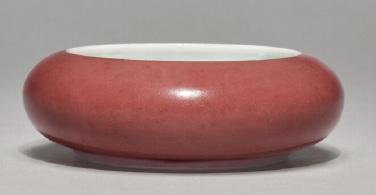

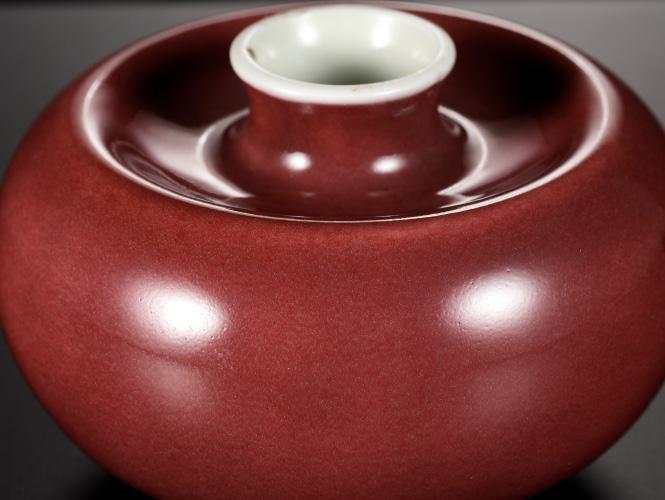
Provenance: From a noted private collection in Geneva, Switzerland, assembled since the 1960s, and thence by descent. An important part of this collection was on permanent loan and exhibited over several decades at the Asia-Africa Museum in Geneva. The base lacquered with an old inventory number, ‘AMA-2866’, and further with two old labels, one reading ‘Art Ancien de Chine & Extrême-Orient Genève. Kang Shi. 1662-1722. 2866’ and the other inscribed with further inventory numbers. The wood stand with two old labels, ‘AMA 2866’ and ‘4096/2 […] imperiale’. According to the collector’s personal notes, the present lot was acquired on 30 April 1973 from Wing Po Chai (probably in Hong Kong). A copy of the corresponding entry in the collector’s notebook accompanies this lot.
Condition: Very good condition with expected old wear and minor firing irregularities, minute fritting and small smoothened areas to the foot, probably inherent to the manufacture. The glaze with an unctuous feel and subtle luster overall.
Weight: 249.6 g (excl. stand)
Dimensions: Diameter 9.5 cm (at the widest points)
With a finely carved and open worked wood stand. (2)
Water pots for washing brushes were designed to be placed on a Chinese scholar’s desk. This form is known as pingguo zun (apple jar), of which there are two variations: ones with a short waisted neck and lipped rim, such as the present lot, and ones with an incurved rounded neck. The form of the present lot is the classic, earlier, and considerably rarer variation.
The use of copper-red glaze at Jingdezhen was revived by the Kangxi Emperor after a decline in usage during the late 15th century. With the effort to reproduce classic Ming jihong (‘sacrificial red’) porcelains, Qing copper-red pieces quickly outnumbered their Ming counterparts. Nigel Wood in Chinese Glazes, London, 1999, p. 180, notes how the French Jesuit missionary, François Xavier d’Entrecolles (1664-1741), wrote letters giving detailed accounts of the copper-red production at Jingdezhen, the sourcing of the copper for the glaze, the recipes and the kiln location of the firing of these wares. Père d’Entrecolles was aware of the difficulties involved in the making of copper-red wares and his account confirms the high level of technical knowledge of the potters at Jingdezhen.
LITERATURE COMPARISON
Compare a water pot of closely related form, covered with a peach bloom glaze, 9.5 cm diameter, with a Kangxi mark and of the period, in the Metropolitan Museum of Art, accession number 29.100.331, illustrated by Suzanne G. Valenstein, A Handbook of Chinese Ceramics, New York, 1989, page 237, fig. 238 (fig. 1). Compare a copper-red glazed bowl, with similar shadings of pale celadon and transmutations of liver-red, 15.5 cm diameter, with a Kangxi mark and of the period, at Christie’s Hong Kong, 28 May 2014, lot 3434.
AUCTION RESULT COMPARISON
Type: Related
Auction: Sotheby’s New York, 22 September 2020, lot 113
Price: USD 315,000 or approx. EUR 339,500 converted and adjusted for inflation at the time of writing
Description: A Fine Peachbloom-Glazed Brush Washer, Kangxi Mark and Period
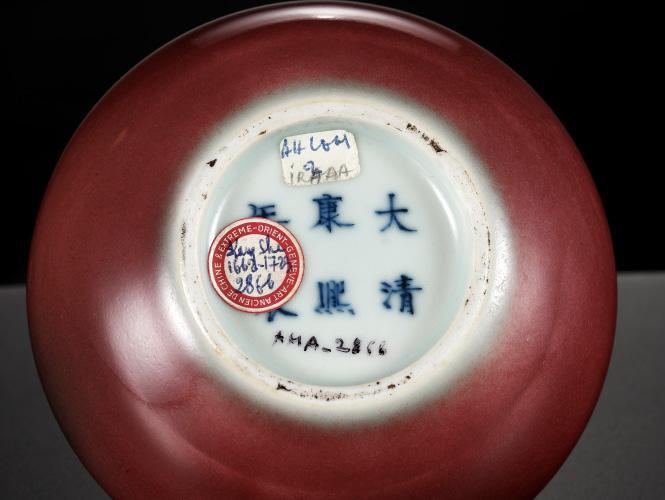
Expert remark: Compare the related glaze.
Estimate EUR 8,000
Starting price EUR 4,000
148 101
fig. 1


A RARE DOUCAI SQUARE TEA CADDY, 17TH-18TH CENTURY
China. Well potted with straight sides, finely decorated in bright enamels and underglaze-blue linework to one side with gnarled flowering prunus tree, leafy bamboo, craggy rockwork, and a full moon partly obscured by a wispy cloud, and to the other with peonies and a pomegranate borne on leafy stems issuing from gnarled branches amid rockwork, the short sides with sinuous confronting dragons centered by a large flaming pearl, the base left unglazed.
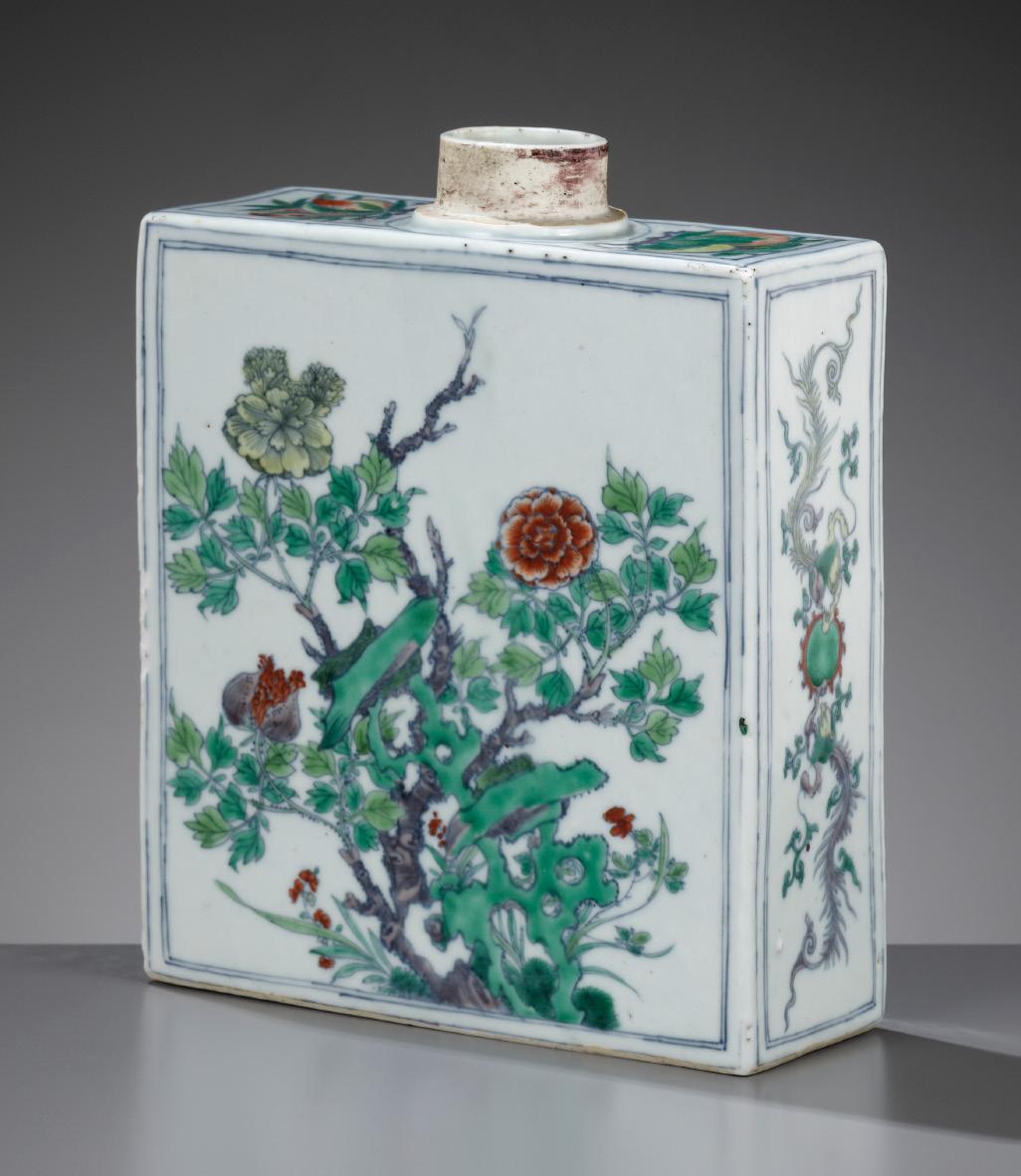

Provenance: Ancient Art, Stockholm, no. 178 (label to base). A Swedish private collection, acquired from the above.

Condition: Very good condition with old wear, traces of use, and firing irregularities, including small glaze recesses and minor frits. A small hairline to the interior of the mouth. Slightly leaning.
Weight: 1,830 g
Dimensions: Height 24 cm (incl. stopper) and 22 cm (excl. stopper)
With an associated wood stopper. (2)
Expert’s note: Tea caddies of this flattened square form are rare, and there appear to be no other examples of this size decorated in the doucai palette recorded in public or private collections. The superb quality of the painting and distinct firing irregularities, however, leave no doubt that this vessel was made during the late 17th or rather early 18th century.
Estimate EUR 8,000
Starting price EUR 4,000
151 102

A RARE PAIR OF DOUCAI ‘POMEGRANATE AND FOLIAGE’ DISHES, YONGZHENG MARKS AND PERIOD
China, 1723-1735. Each dish is delicately potted with shallow rounded sides supported on a short tapered foot, finely painted in cobalt-blue and shades of green, red, yellow, and aubergine, the interior with a central medallion enclosing a fruiting pomegranate tree, encircled by grape vines, peony, and pomegranate branches, the exterior similarly painted with fruiting sprays. The bases each with an underglaze-blue six-character mark da Qing Yongzheng nianzhi and of the period. (2)
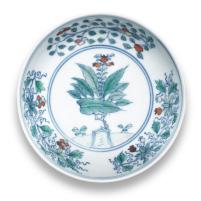

Provenance: Lynn Greenwold, Stow-on-the-Wold, Gloucestershire, United Kingdom, 1985. A private collector in the United Kingdom, acquired from the above. A copy of the original invoice, issued by Lynn Greenwold and dated 19 February 1985, accompanies this lot.
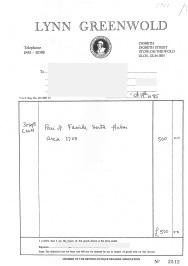
Condition: Very good condition with expected old wear and minor firing irregularities, small frits to feet.
Weight: 326.1 g and 313.8 g
Dimensions: Diameter 19.9 and 19.8 cm
AUCTION RESULT COMPARISON
Type: Closely related
Auction: Bonhams London, 12 May 2022, lot 176
Price: GBP 25,500 or approx. EUR 30,000 converted and adjusted for inflation at the time of writing
Description: A small doucai ‘pomegranate and foliage’ saucer dish, Yongzheng six-character mark and of the period
Expert remark: Compare the closely related form and decoration. Note that this lot comprises only a single dish of significantly smaller size (11.2 cm).
AUCTION RESULT COMPARISON
Type: Closely related
Auction: Sotheby’s Hong Kong, 8 April 2011, lot 3157
Price: HKD 275,000 or approx. EUR 45,500 converted and adjusted for inflation at the time of writing
Description: A pair of doucai dishes, with pomegranates, plums and grapes, Qing dynasty, Kangxi period


Expert remark: Compare the closely related form and decoration. Note that this pair has apocryphal Chenghua reign marks and is dated to the Kangxi period, although a dating to the Yongzheng period seems reasonable as well.
Estimate EUR 16,000
Starting price EUR 8,000
103
China, 1723-1735. The deep rounded sides supported on a short tapered foot, the interior finely decorated in bright enamels with peonies, roses, and asters borne on leafy and thorned stems also issuing small buds below a butterfly, all below the café-au-lait rim.


Provenance: From the Neame family collection, Chesham, United Kingdom, and thence by descent. The base with two old labels, ‘For information see ‘The Arts of China’ in s. room.’ and ‘Famille rose. P227/8’. Condition: Very good condition with minor wear and firing irregularities, the foot with minor fritting.
Weight: 1,095 g
Dimensions: Diameter 34.2 cm
Estimate EUR 6,000
Starting price EUR 3,000
AUCTION RESULT COMPARISON
Type: Related
Auction: Christie’s New York, 17 September 2010, lot 1484
Price: USD 11,250 or approx. EUR 14,500
converted and adjusted for inflation at the time of writing
Description: A fine well-painted famille rose dish, engraved Johanneum mark N=176, Yongzheng period
Expert remark: Note the Johanneum mark and smaller size (22.4 cm)
154 104
A LARGE FAMILLE ROSE ‘FLOWERS AND BUTTERFLY’ DISH, YONGZHENG PERIOD
China, 1723-1735. The deep rounded sides supported on a short tapered foot, the interior finely decorated in bright enamels with blooming yellow and pink roses borne on thorned leafy stems and further issuing small buds below two colorful butterflies, all below the café-au-lait rim.

Provenance: From the Neame family collection, Chesham, United Kingdom, and thence by descent. The base with an old collector’s label.

Condition: Very good condition with minor wear and firing irregularities, the foot with few tiny nicks.
Weight: 1,201 g
Dimensions: Diameter 35 cm
Estimate EUR 6,000
Starting price EUR 3,000
AUCTION RESULT COMPARISON
Type: Related
Auction: Christie’s New York, 25 March 2022, lot
1144
Price: USD 12,600 or approx. EUR 12,000
converted and adjusted for inflation at the time of writing
Description: A Famille Rose Saucer Dish, Yongzheng Period (1723-1735)
Expert remark: Note the Johanneum mark and the much smaller size (12.2 cm)
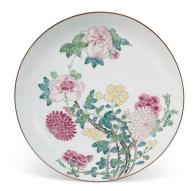
155 105
A LARGE FAMILLE ROSE ‘BUTTERFLIES AND ROSES’ DISH, YONGZHENG PERIOD
A FAMILLE ROSE ‘DOCTOR’S VISIT’ DISH, BY CORNELIUS PRONK, EARLY QIANLONG PERIOD
China, circa 1738-1740. The shallow dish painted in gilt and bright enamels after a design by Cornelius Pronk entitled ‘The Doctor’s Visit to the Emperor’, the central roundel with a scene of four Chinese noblemen conversing in a fenced garden below a blossoming tree, a large Ming dish on the table before them and a peacock at their side, enclosed by a gilt border with geometrical design, the rim with fish encircled by scalloped green bands, interspersed with birds standing in grasses and diaper pattern, the rim lined in gilt.
Provenance: S. Marchant & Son, London, 1999. Richard and Maxine Markell, acquired from the above. A copy of the original invoice from S. Marchant & Son, London, dated 10 June 1999, describing the piece as a famille rose plate painted after a design by Cornelius Pronk with the scene of the ‘doctor’s visit’, dating it to the Yonzheng period, 1723-1735, and stating a purchase price of GBP 6,500 or approx. EUR 15,500 (converted and adjusted for inflation at the time of writing), accompanies this lot. Label ‘Marchant London Yongzheng 17231735’ to base. S. Marchant & Son was founded in 1925 by Samuel Sydney Marchant (1897-1975). It held a large stock of Asian art, but also dealt in arms and armor, paintings, and continental porcelain. In 1953, Richard Marchant joined his father and from that time onwards the partnership specialized in Asian art. Nowadays the company’s focus is on Imperial Chinese Ming and Qing porcelains, jades, cloisonné, pottery, and works of art.
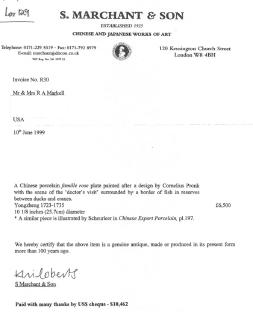
Condition: Very good condition, the enamels still fresh and crisp, minor wear to the gilt and enamels mostly along the rim, and manufacturing flaws including pitting, dark spots, glaze recesses, and light warping.
Weight: 522 g
Dimensions: Diameter 25.8 cm
The scene, entitled ‘The Doctors’ or ‘The Doctors Visiting the Emperor’, was designed by Pronk in 1735 and sent to China in 1736, arriving only at the end of 1737. The finished products were sent back to the Netherlands at the end of 1738 and in 1739. A second, simpler version of the design with only three figures was sent to China in 1739. This scene was originally designed after a motif in traditional Chinese iconography, illustrating the legend of the woodcutter Wang Shi who encountered three Daoist gods playing chess in a cave.
Only one of Cornelis Pronk’s four official commissions for the Dutch East India Co., an original watercolor design, can still be seen in the Rijksmuseum, Amsterdam. While the experiment in commissioned designs was quickly discontinued, dinner sets, tea pieces and large jars with covers were made with the ‘The Doctors’ motif. See C.J.A. Jörg, Porcelain and the Dutch China Trade, pp. 99-101, and Howard & Ayers, op. cit., pp. 193-194.

Literature comparison: Compare a near identical Pronk ‘Doctor’s visit’ dish, ca. 1738, in the collection of the Victoria and Albert Museum, accession number C.43-1912.

AUCTION RESULT COMPARISON
Type: Near identical
Auction: Christie’s New York, 17 January 2019, lot 541

Price: USD 6,875 or approx. EUR 7,700 converted and adjusted for inflation at the time of writing
Description: A famille rose ‘Pronk doctors’ large dish, Qianlong period, circa 1738-1740

Expert remark: Compare the near identical design, crisp enamels, and gilt embellishments. Note the size (32.1 cm).
Estimate EUR 4,000
Starting price EUR 2,000
106
Cornelius Pronk, self-portrait, c. 1725-1730
Richard Marchant
107

A PAIR OF ‘SPOTTED BAMBOO’ FAMILLE ROSE DISHES, EARLY QIANLONG PERIOD
China, circa 1740. The dishes with openwork sides in the form of overlapping rings imitating spotted bamboo (xiangfei zhu), enameled in yellow and brown. The center decorated with peonies, chrysanthemums and butterflies superbly painted in crisp enamels, enclosed by a floral diaper band, detailed with radiating lines within cells on a green ground with horizontal lines. (2)

Provenance: Sotheby’s, London, 6 November 1973, lot 132. Dr. Anton C.R. Dreesmann, acquired from the above. Christie’s, London, 10 April 2002, lot 374, sold for GBP 3,525 or approx. EUR 7,800 (converted and adjusted for inflation at the time of writing).
S. Marchant and Son, London, 2002. Richard and Maxine Markell, acquired from the above. A copy of the original invoice from S. Marchant and Son, London, dated 14 June 2002, dating the plates to circa 1740, and stating a purchase price of GBP 6,500 or approx. EUR 14,500 (converted and adjusted for inflation at the time of writing), accompanies this lot. Each dish with two old inventory labels from the Dreesmann collection to the base, one dish further with a label ‘Marchant London Qianlong 1736-1795’. Dr. Anton C.R. Dreesmann (1923-2000) was a third-generation member of the founding family of the biggest Dutch department store, Vroom & Dreesmann, and a passionate collector, amassing over 1,300 works of art, including the famous ‘Waterloo Bridge’ by Claude Monet. Condition: Very good condition, superbly enameled and with only light wear, manufacturing flaws including minor warping, pitting, dark spots, glaze recesses, and few firing cracks.
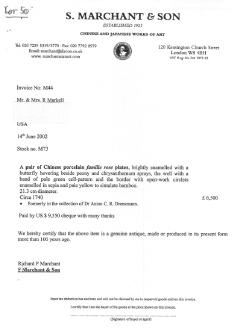
Weight: 316.6 g and 312.2 g
Dimensions: Diameter 21.4 cm and 21.2 cm
Xiangfei zhu, or spotted bamboo, a native plant of Hunan, Henan, Jiangxi and Zhejiang, refers to several types of bamboo with stems that are mottled by dark spots. The stems of the spotted bamboos are generally esteemed for making the handles of Chinese brushes, used for calligraphy and painting. Early examples from brushes made of spotted bamboo date back to the 8th century, Tang dynasty, and were highly valued in China as well as Japan, as can be seen from objects imitating spotted bamboo in the Shosoin (treasure house) in Japan.

LITERATURE COMPARISON
Compare a closely related dish with openwork rim, late 17th to early 18th century, in the collection of the Metropolitan Museum of Art, accession number 79.2.1037.


Estimate EUR 4,000
Starting price EUR 2,000
157
Natural spotted bamboo
Dr. Anton C. R. Dreesmann (1923-2000)
Spotted bamboo decor at the openwork sides of the present lot
108
A FINELY PAINTED FAMILLE ROSE
‘IMMORTALS’ PLAQUE, QIANLONG PERIOD
China, 1736-1795. Exquisitely painted in remarkably fine detail and bright enamels with female immortals and their attendants in a raft over crashing and swirling waves, floating towards further immortals standing on rocky cliffs. All wearing long flowing robes and holding various attributes including a basket of peaches, a parasol, a ruyi scepter, and a lotus flower, amid colorful shrubs and trees, below a pavilion nestled between towering craggy rocks emerging from wispy scrolling clouds beside a crane in flight.

Provenance: From a private collection in Kent, United Kingdom.
Condition: Very good condition with only minor wear and expected small firing irregularities. The enamels are spectacularly crisp and well preserved. The frame with wear, minor nicks, and light scratches.
Dimensions: Panel size 38.5 x 29.5 cm, Size incl. frame 45 x 35.5 cm
With a fine old wood frame, possibly from the period. (2)
AUCTION RESULT COMPARISON
Type: Related
Auction: Sotheby’s Hong Kong, 22 April 2021, lot 3636

Price: HKD 856,800 or approx. EUR 105,000 converted and adjusted for inflation at the time of writing
Description: A famille-rose ‘immortal on raft’ plaque, Qing dynasty, Qianlong period
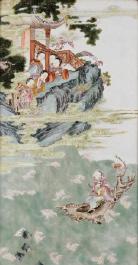
Expert remark: Compare the closely related subject and manner of painting. Note the size (66.4 x 35.6 cm).
AUCTION RESULT COMPARISON
Type: Related
Auction: Sotheby’s Hong Kong, 29 November 2018, lot 424
Price: HKD 412,500 or approx. EUR 53,500 converted and adjusted for inflation at the time of writing
Description: A famille-rose ‘eight immortals’ plaque, Qing dynasty, Qianlong period

Expert remark: Compare the closely related subject, enamels, and manner of painting. Note the size (height 76 cm with frame).
AUCTION RESULT COMPARISON
Type: Related
Auction: Sotheby’s Hong Kong, 22 April 2021, lot 3637
Price: HKD 630,000 or approx. EUR 77,500 converted and adjusted for inflation at the time of writing
Description: A famille-rose ‘immortals’ plaque, Qing dynasty, 18th century
Expert remark: Compare the closely related subject, enamels, and manner of painting. Note the size (41 by 57.2 cm).
Estimate EUR 10,000
Starting price EUR 5,000
158
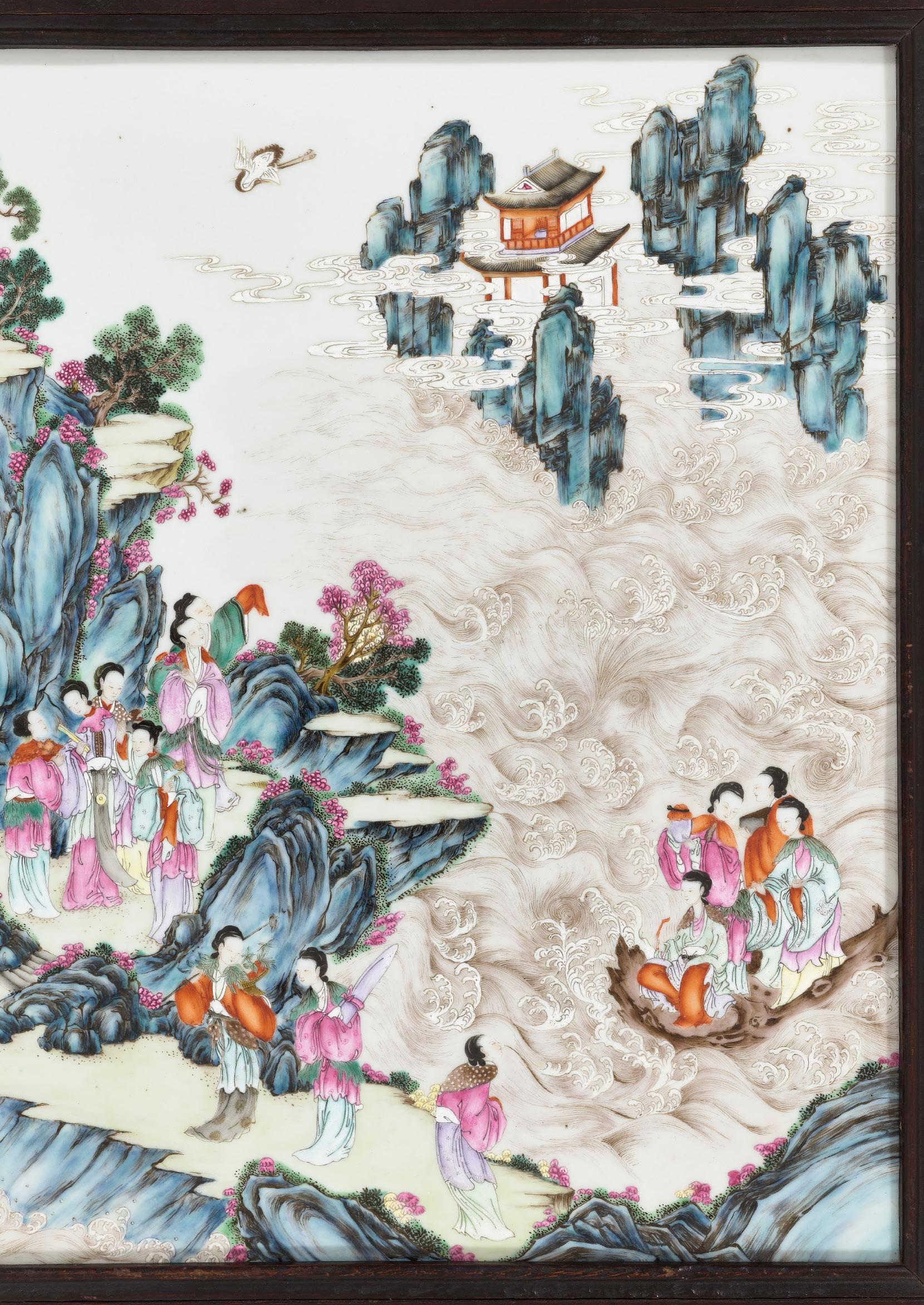
POLYCHROME-DECORATED ‘DRAGON’ BOWL, QIANLONG MARK AND PERIOD

China, 1736-1795. Superbly potted with deep rounded sides rising from a straight foot to a gently flared rim, the exterior vividly enameled with two ferocious dragons, one in green enamel, the other iron-red, racing through green, yellow and iron-red flames in pursuit of flaming pearls positioned above cruciform clouds, resting on a band of overlapping petals, all reserved on a washed underglaze-blue ground, the interior with a central medallion enclosing a similar green dragon. The recessed base with an underglaze-blue six-character seal mark da Qing Qianlong nianzhi and of the period.
Provenance: From a private collection in North Yorkshire, United Kingdom.
Condition: Very good condition with expected wear and shallow surface scratches, minimal firing irregularities, few barely visible glaze lines.
Weight: 227.8 g
Dimensions: Diameter 14 cm
Literature comparison: A Kangxi-marked bowl of this same design was included in the exhibition Joined Colors, Decoration and Meaning in Chinese Porcelain, Ceramics from Collectors in the Min Chiu Society, Hong Kong, illustrated by L.A. Cort and J. Stuart, Catalogue, Hong Kong, 1993, p. 84, pl. 13. Qianlong-marked bowls of this type are relatively rare, examples include one sold at Christie’s New York, 28 March 1996, lot 363, and another at Sotheby’s Hong Kong, 1 December 1977, lot 648.
AUCTION RESULT COMPARISON
Type: Near identical
Auction: Christie’s Hong Kong, 29 May 2013, lot 1924
Price: HKD 870,000 or approx. EUR 132,000 converted and adjusted for inflation at the time of writing
Description: A rare blue-ground polychrome-decorated ‘dragon’ bowl, Qianlong six-character seal mark and of the period
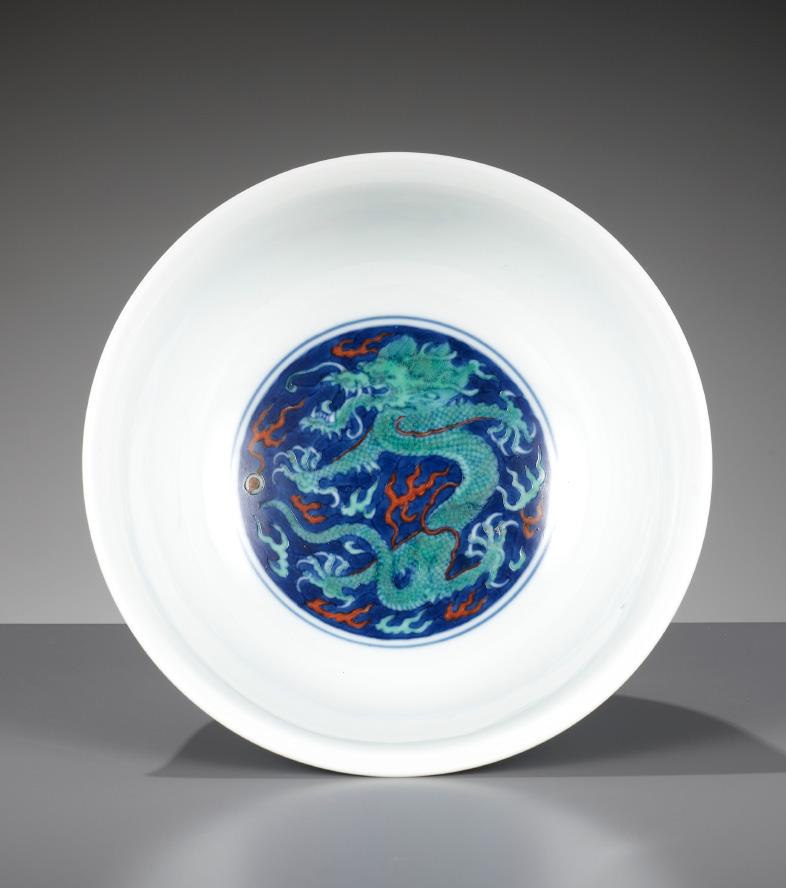
Expert remark: Note the near identical form, decoration, reign mark, and size (14 cm). Also note that this lot is in excellent condition.
AUCTION RESULT COMPARISON
Type: Near identical
Auction: Christie’s Hong Kong, 28 May 2014, lot 3456
Price: HKD 475,000 or approx. EUR 72,000 converted and adjusted for inflation at the time of writing
Description: A Rare Blue-Ground Polychrome-Decorated ‘Dragon’ Bowl, Qianlong Six-Character Seal Mark and of the Period (1736-1795)


Expert remark: Note the near identical form, decoration, reign mark, and size (14 cm). Also note that this lot is in restored condition.
Estimate EUR 30,000
Starting price EUR 15,000
160 109 A
RARE BLUE-GROUND
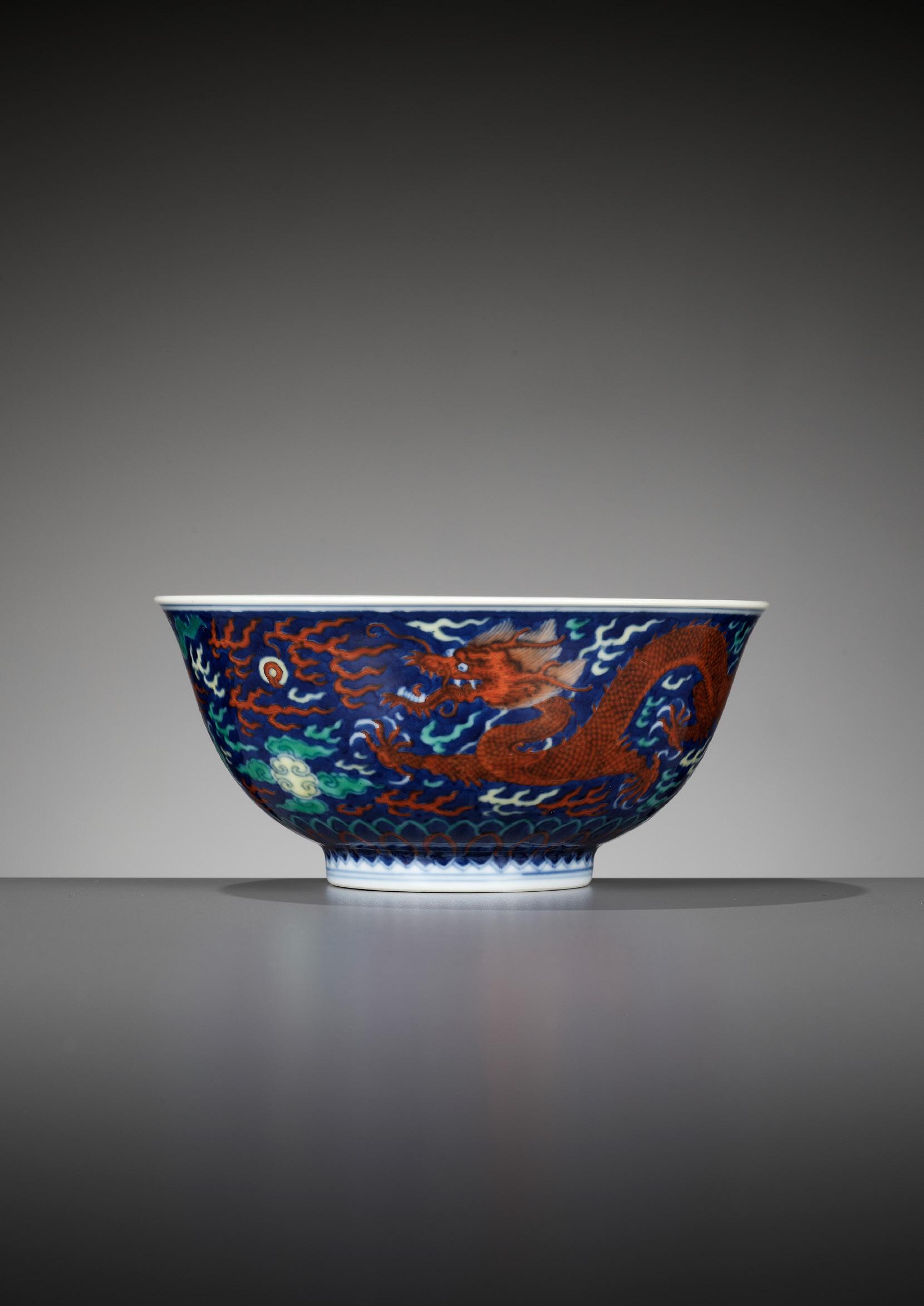

A COPPER-RED GLAZED DISH, QIANLONG MARK AND PERIOD
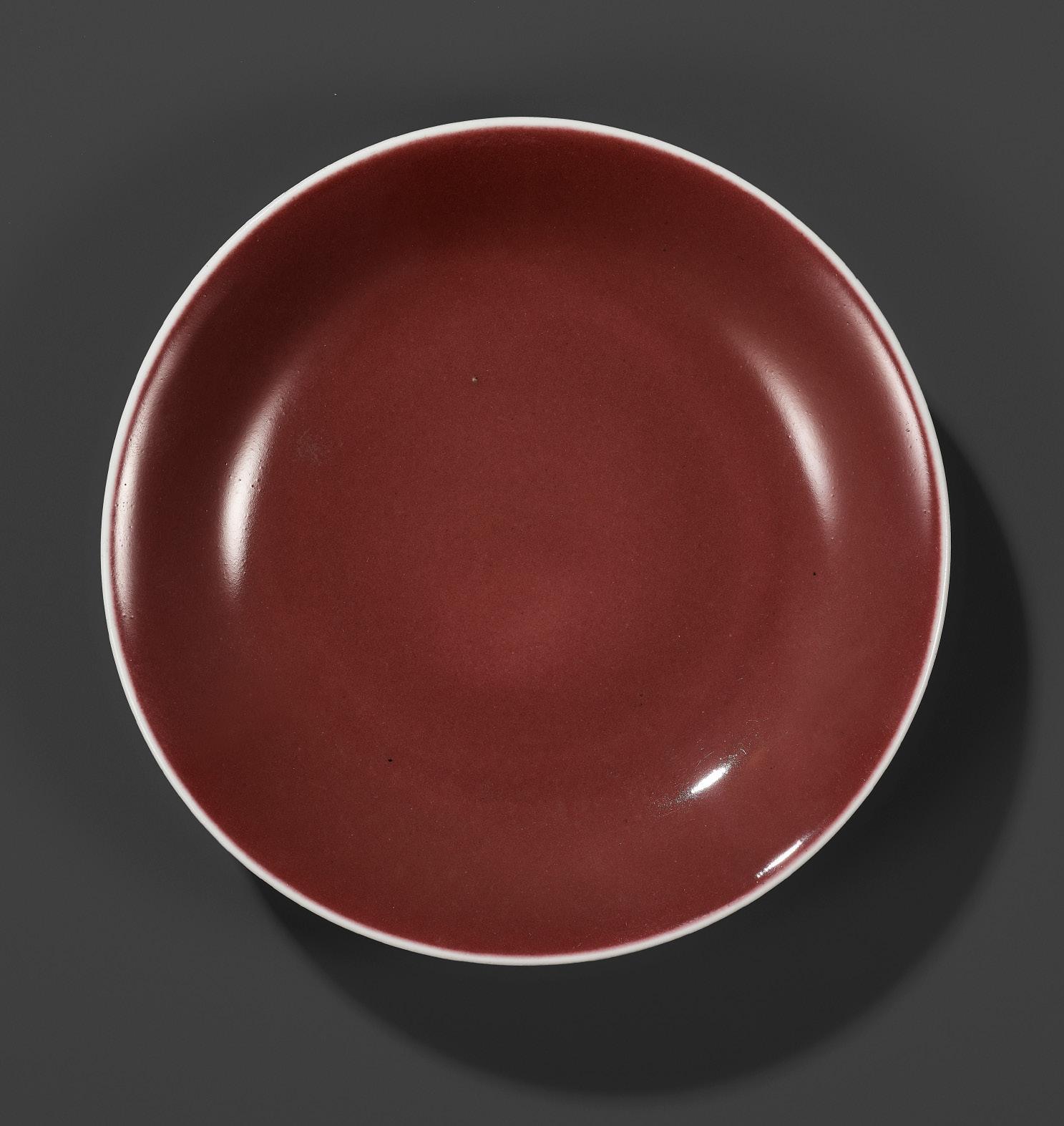

China, 1736-1795. The shallow rounded sides supported on a short foot. The interior and exterior covered in a rich glaze of crushedstrawberry tone, the rim and base with a clear colorless glaze, the base with an underglaze-blue six-character seal mark da Qing Qianlong nianzhi and of the period.
Provenance: From an old private collection in the United Kingdom, acquired in Shanghai and Hong Kong from the 1930s onwards, and thence by descent within the same family. The base with an old label, ‘No. (9) 178’.
Condition: Excellent condition with only minor wear and expected firing irregularities.
Weight: 193.5 g
Dimensions: Diameter 15.8 cm
AUCTION RESULT COMPARISON
Type: Closely related
Auction: Sotheby’s Paris, 10 June 2021, lot 64
Price: EUR 13,860 or approx. EUR 15,000 adjusted for inflation at the time of writing
Description: A very fine copper-red glazed saucer dish, seal mark and period of Qianlong
Expert remark: Compare the closely related copper-red glaze. Note the near-identical size (16.5 cm).
AUCTION RESULT COMPARISON
Type: Closely related
Auction: Christie’s New York, 23 September 2022, lot 908
Price: USD 37,800 or approx. EUR 35,000 converted at the time of writing
Description: Qianlong Six-Character Seal Mark in Underglaze Blue and of the Period (1736-1795)

Expert remark: Compare the closely related copper-red glaze. Note the larger size (20.9 cm).

Estimate EUR 8,000
Starting price EUR 4,000
110
111
A COPPER-RED GLAZED DISH, WITH A LIVER-RED GLAZE POOLING IN THE WELL, QIANLONG MARK AND PERIOD

China, 1736-1795. The shallow rounded sides supported on a short foot. The interior and exterior covered in a rich glaze of crushedstrawberry tone, transmuting to a deep liver-red pooling in the well, the rim and base with a clear colorless glaze, the base with an underglaze-blue six-character seal mark da Qing Qianlong nianzhi and of the period.
Provenance: From an old private collection in the United Kingdom, acquired in Shanghai and Hong Kong from the 1930s onwards, and thence by descent within the same family. The base with an old label, ‘No. 178 (9)’.
Condition: Excellent condition with minor wear and expected firing irregularities.
Weight: 178.9 g
Dimensions: Diameter 15.7 cm
AUCTION RESULT COMPARISON
Type: Closely related
Auction: Sotheby’s New York, 22 June 2021, lot 1
Price: USD 35,280 or approx. EUR 33,000 converted and adjusted for inflation at the time of writing
Description: A copper-red-glazed dish, Seal mark and period of Qianlong


Expert remark: Compare the closely related copper-red glaze with similar liver-red glaze transmutation pooling in the well. Note the nearidentical size (16.4 cm).
Estimate EUR 8,000
Starting price EUR 4,000
163
A SHALLOW CAFÉ-AU-LAIT GLAZED BOWL, QIANLONG MARK AND PERIOD

China, 1736-1795. The gently rounded sides rising from a shallow foot to a lightly flared rim, the body embellished with a raised double bow-string band, the interior and exterior covered with a lustrous café-au-lait glaze of a reddish-brown tone, the white base with an underglaze-blue six-character seal mark da Qing Qianlong nianzhi and of the period.
Provenance: Sotheby’s Hong Kong, May 2000, lot 724 (according to label to base). A distinguished Asian collection, acquired from the above. Sotheby’s Hong Kong, 3 October 2018, lot 3644. A noted private collection, acquired from the above.
Condition: Very good condition with some wear and minor firing irregularities, shallow surface scratches, and few small glaze bumps.
Weight: 274 g
Dimensions: Diameter 17 cm
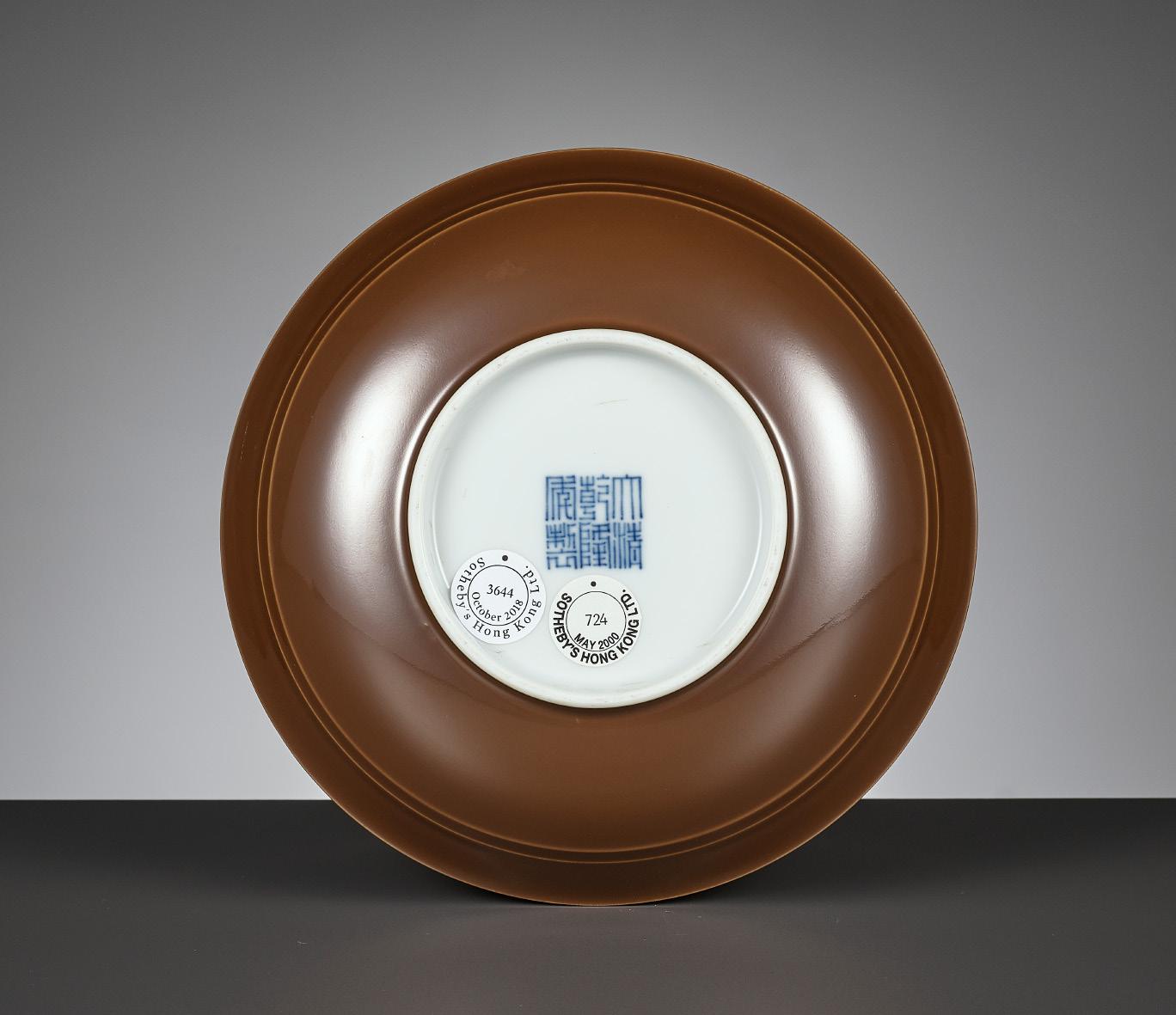
With a silk storage box. (2)
Literature comparison: It is rare to find a bowl of this type with a Qianlong mark, but one is in the collection of the Asian Art Museum, San Francisco, illustrated by He Li, Chinese Ceramics, A New Comprehensive Survey, New York, 1996, p. 284, no. 565. For a Kangxi precursor of this Qianlong example see the bowl in the Percival David Foundation, illustrated in Oriental Ceramics, The World’s Great Collections, vol. 6, Tokyo, 1982, no. 233. Yongzheng-marked examples are represented by one illustrated in Old Oriental Ceramics Donated by Mr. Yokogawa, Tokyo National Museum, 1953, pl. 389, and another included in the exhibition, Chinese Antiquities from the Brian S. McElney Collection, Hong Kong Museum of Art, 1987, no. 100.
AUCTION RESULT COMPARISON
Type: Near identical
Auction: Sotheby’s Hong Kong, 8 April 2011, lot 3012
Price: HKD 325,000 or approx. EUR 52,500 converted and adjusted for inflation at the time of writing
Description: A shallow café-au-lait glazed bowl, seal mark and period of Qianlong

Expert remark: Compare the closely related form, decoration, Qianlong reign mark, and size (17.1 cm).
AUCTION RESULT COMPARISON
Type: Near identical
Auction: Christie’s New York, 19 September 2006, lot 380
Price: USD 36,000 or approx. EUR 48,000 converted and adjusted for inflation at the time of writing
Description: A café-au-lait-glazed shallow bowl, Qianlong seal mark in underglaze blue and of the period
Expert remark: Compare the closely related form, decoration, Qianlong reign mark, and size (17.1 cm).
Estimate EUR 20,000
Starting price EUR 10,000
164
112


113
A VERY LARGE ‘ROBIN’S EGG’ ENAMELED AND GILT PORCELAIN FIGURE OF AMITAYUS, QIANLONG TO JIAQING PERIOD
China, 1736-1820. Heavily potted, seated in dhyanasana on a cloth draped over a rectangular plinth with a shaped recessed gilt panel above a dragon emerging from crashing waves. His hands are lowered in dhyana mudra and holding an alms bowl. He is wearing long flowing robes opening at the chest adorned with a beaded jeweled necklace. His serene face with heavy-lidded eyes, gently arched brows, a circular urna, and bow-shaped lips. His hair elegantly falling in tresses over the shoulders and piled up into a topknot surmounted by a jewel behind the foliate tiara. The cloth, base, robe, hair, and jewels enameled in robin’s egg with details picked out in turquoise and blue. The face, torso, hands, feet, tiara, and dragon gilt.
Provenance: From an old German private collection, acquired in the 1970s and 80s. Thence by descent.
Condition: As expected, the tips of the tiara, topknot, fingers, earrings and dragon’s horns are restored to perfection. Further with glaze recesses, flaking and abrasions. Microscopic remnants of pigment which indicate that the figure was painted at some stage. Gilt porcelain figures of such a large size are usually restored to a much wider extent, due to their fragility, and it is therefore exceedingly rare to find one in such a well-preserved state overall.
Weight: 5,156 g
Dimensions: Height 43.5 cm
Expert’s note: Gilt porcelain figures of bodhisattva were produced from the Qianlong period onwards. The inspiration for such figures may have come from Ming dynasty bronze prototypes, such as the Xuande period giltbronze figure currently in the Berti Aschmann Foundation, Museum Rietberg, illustrated in On the Path to Enlightenment, Zurich, 1995, no. 72. An unmarked example, dated to the Xuande period, is in the V&A collection, no. 275&A-1898.
Literature comparison: For a related example from the Malcolm MacDonald collection, no. DUROM.1969.358, and now in the Oriental Museum, University of Durham, United Kingdom, see Ireneus Legeza, A Descriptive and Illustrated Catalogue of the Malcolm MacDonald Collection of Chinese Ceramics, London, 1972, p. 122, no. 72. Another enameled porcelain figure of a bodhisattva is illustrated by Lou Pin-heng, Precious Treasures of My Humble House, Taipei, 1988, pg. 54, no. 12
AUCTION RESULT COMPARISON
Type: Related
Auction: Sotheby’s New York, 17 September 2013, lot 52
Price: USD 68,750 or approx. EUR 80,000 converted and adjusted for inflation at the time of writing
Description: An unusual enameled and giltdecorated figure of a bodhisattva, Qing dynasty, 18th / 19th century

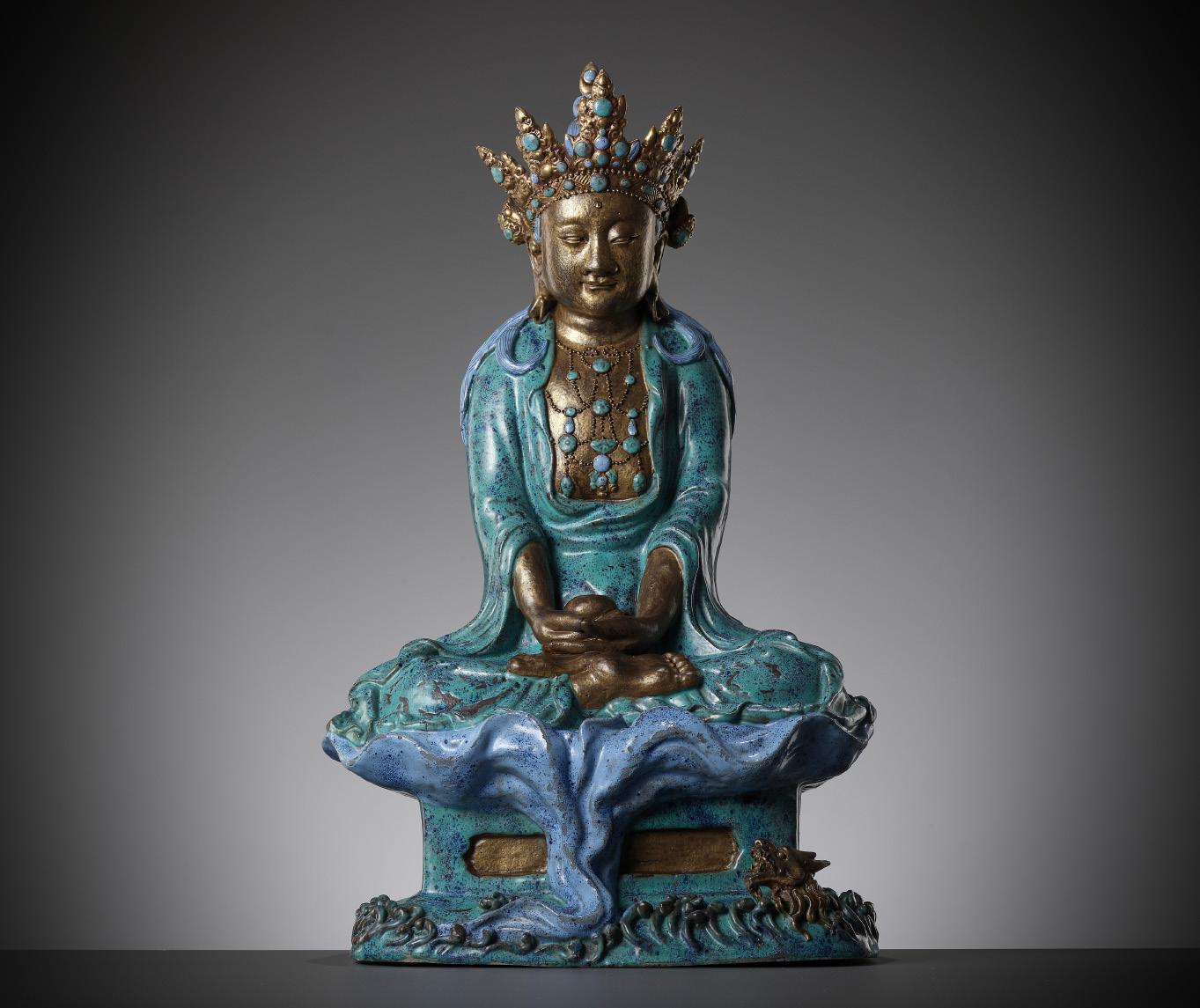
Expert remark: Compare the closely related robin’s egg enamels, gilt decoration, and face. Note the related size (40 cm). Note the different pose and base.
AUCTION RESULT COMPARISON
Type: Related
Auction: Bonhams Hong Kong, 29 May 2008, lot 578
Price: HKD 960,000 or approx. EUR 169,000 converted and adjusted for inflation at the time of writing
Description: A rare enameled figure of a kneeling bodhisattva, Qianlong


Expert remark: Compare the closely related robin’s egg enamels, gilt decoration, and face. Note the much smaller size (29 cm) as well as the different pose and base.
Estimate EUR 20,000
Starting price EUR 10,000
167
114
A SMALL ROBIN’S
18TH CENTURY
EGG GLAZED ‘ARCHAISTIC’ BASIN,
China. The vessel of flattened circular form, the exterior finely molded with mask handles suspending mock rings, framed by recessed bands below an incurved rim and short foot, covered overall with an opaque turquoise glaze densely mottled in bright and dark blue save for the broad unglazed foot rim encircling the countersunk base.
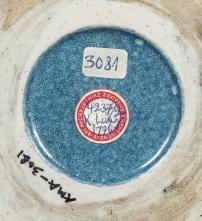

Provenance: From a noted private collection in Geneva, Switzerland, assembled since the 1960s, and thence by descent. An important part of this collection was on permanent loan and exhibited over several decades at the Asia-Africa Museum in Geneva. The base lacquered with an old inventory number, ‘AMA-3081’, and further with two old labels, ‘3081’ and ‘Art Ancien de Chine & Extrême-Orient Genève. 4237/2. K. Lung 1736’
Condition: Good condition with some wear and expected traces of use, the interior with light surface scratches, tiny glaze recesses. One side with a thin, barely visible hairline.
Weight: 170.4 g
Dimensions: Width 10 cm (at the widest points)
As early as the Song dynasty, the Imperial court was fascinated with archaic objects and many wares were produced in imitation of ancient forms. The shape of the present censer, although flattened, is reminiscent of bronze containers known as lian, which were among the ritual implements aimed to present food and drink offerings to the ancestors during the Han dynasty. As such, the present censer may not only be emulating the bronze prototype, but also the ceramic form of the Northern Song dynasty, as exemplified by a Ruyao tripod incense burner from the Qing Court collection, illustrated in Porcelain of the Song Dynasty (I): The Complete Collection of Treasures of the Palace Museum, Hong Kong, 1996, p. 2, no. 1.
The ‘Robin’s egg’ glaze represents a significant technical innovation of the Yongzheng period (1723-35) attributable to Tang Ying (1682-1756), the greatest porcelain superintendent in Chinese history. The Yongzheng Emperor, who initiated many revivals of earlier ceramic techniques, was particularly enamored with the variegated Jun glazes of the Song (960-1279) and Ming (1368-1644) dynasties. In order to have the glazes recreated or imitated, Tang Ying sent his trusted assistant from the imperial kilns in Jingdezhen, Jiangxi province, on study trips to the Jun region in Henan province to learn from the local potters and even went as far as having ceramic raw materials mined in the Jun area transported over thousands of kilometers to Jingdezhen. Among the many types of glazes derived from those efforts are mottled purple ones such as the flambé variety, and mottled turquoise ones such as ‘robin’s egg’, which Tang Ying termed Lu Jun or Oven Jun, i.e., a Jun glaze fired in low-temperature ovens instead of high-temperature kilns (see Jingdezhen Institute of Ceramic Archaeology et al, The Cultures of Porcelain Superintendents and Jingdezhen, conference volume, Nanchang, 2011). The ‘robin’s egg’ glaze is mentioned on a stele in Jingdezhen, inscribed by Tang Ying, as one of the major types of ceramics that he succeeded in firing and proposed as suitable for regular delivery to the Imperial court. Its color is described as intermediate between the glazes of the Shiwan kilns of Foshan, Guangdong, and those used by the Yixing kilns in Jiangsu for their zisha tea pots, but having a better and more beautiful flow.
AUCTION RESULT COMPARISON
Type: Related
Auction: Sotheby’s London, 3 November 2021, lot 9
Price: GBP 5,292 or approx. EUR 7,000 converted and adjusted for inflation at the time of writing
Description: A ‘robin’s egg’-glazed ‘doublepeach’ washer, Qing dynasty, 18th/19th century Expert remark: Compare the related glaze. Note the similar size (length 9.6 cm).

Estimate EUR 3,000
Starting price EUR 1,500
168
A ROBIN’S EGG GLAZED BRUSHPOT, BITONG, 18TH CENTURY
China. Of cylindrical form with straight sides rising to an incurved rim, and supported on a tall, gently rounded and unglazed foot, applied all over with a mottled turquoise and blue glaze.
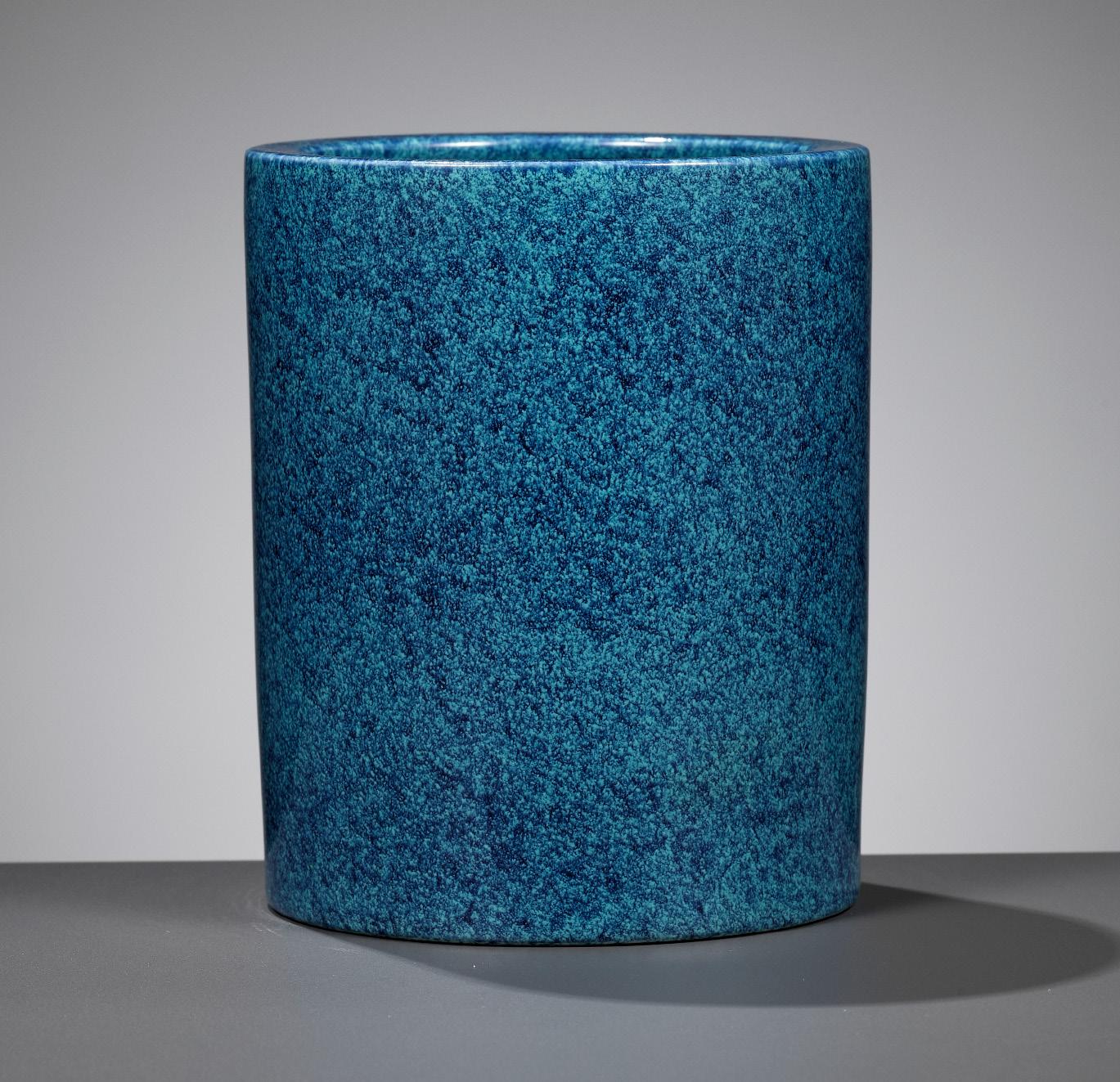

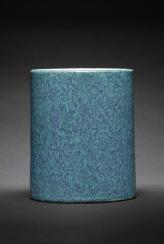
Provenance: British trade.
Condition: Very good condition with expected wear to glaze, few traces of use, and small manufacturing flaws. Some black ink stains to the interior, probably from previous usage as a brush pot.
Weight: 689.3 g
Dimensions: Height 13.1 cm
The ‘Robin’s egg’ glaze represents a significant technical innovation of the Yongzheng period (1723-35) attributable to Tang Ying (1682-1756), the greatest porcelain superintendent in Chinese history. The Yongzheng Emperor, who initiated many revivals of earlier ceramic techniques, was particularly enamored with the variegated Jun glazes of the Song (960-1279) and Ming (1368-1644) dynasties. In order to have the glazes recreated or imitated, Tang Ying sent his trusted assistant from the imperial kilns in Jingdezhen, Jiangxi province, on study trips to the Jun region in Henan province to learn from the local potters and even went as far as having ceramic raw materials mined in the Jun area transported over thousands of kilometers to Jingdezhen. Among the many types of glazes derived from those efforts are mottled purple ones such as the flambé variety, and mottled turquoise ones such as ‘robin’s egg’, which Tang Ying termed Lu Jun or Oven Jun, i.e., a Jun glaze fired in low-temperature ovens instead of high-temperature kilns (see Jingdezhen Institute of Ceramic Archaeology et al, The Cultures of Porcelain Superintendents and Jingdezhen, conference volume, Nanchang, 2011). The ‘robin’s egg’ glaze is mentioned on a stele in Jingdezhen, inscribed by Tang Ying, as one of the major types of ceramics
that he succeeded in firing and proposed as suitable for regular delivery to the Imperial court. Its color is described as intermediate between the glazes of the Shiwan kilns of Foshan, Guangdong, and those used by the Yixing kilns in Jiangsu for their zisha tea pots, but having a better and more beautiful flow.
AUCTION RESULT COMPARISON
Type: Closely related
Auction: Bonhams Hong Kong, 28 November 2011, lot 455
Price: HKD 187,500 or approx. EUR 31,000 converted and adjusted for inflation at the time of writing
Description: A robin’s egg brushpot, mid-Qing dynasty
Expert remark: Compare the closely related form and glaze. Note the size (11.1 cm).
AUCTION RESULT COMPARISON
Type: Closely related
Auction: Christie’s New York, 19 September 2014, lot 907
Price: USD 21,250 or approx. EUR 25,000 converted and adjusted for inflation at the time of writing
Description: A ‘robin’s egg’-enameled brush pot, 18th19th century
Expert remark: Compare the closely related form and glaze. Note the size (10.7 cm). Note also that the hammer price far exceeded the low estimate of USD 3,000 only, somewhat insinuating that bidders may have found an 18th-century date to be more likely.
Estimate EUR 3,000
Starting price EUR 1,500
115
A GUAN-TYPE CONG-FORM ARCHAISTIC VASE, 18TH CENTURY
China. Of archaic jade form, the straight-sided square section body rising from a short foot to a narrow tapering circular neck, finely molded in shallow relief with two vertical bars down each side, and alternating shorter and longer horizontal bars down the four corners. Covered overall in a thick pale-gray glaze suffused with a network of golden and black crackles, masterfully controlled so that they emphasize the archaic form of the vessel.
Provenance: From the collection of Felix Tikotin, and thence by descent within the family. Felix Tikotin (1893-1986) was an architect, art collector, and founder of the first Museum of Japanese Art in the Middle East. Born in Glogau, Germany, to a Jewish family, his ancestors had returned with Napoleon from Russia from a town named Tykocin. He grew up in Dresden and after World War I, he traveled to Japan and immediately fell in love with the culture. In April 1927, he opened his own first gallery in Berlin. The entire family survived the holocaust, and in the 1950s Tikotin slowly resumed his activities as a dealer in Japanese art. He became, once again, very successful and prominent, holding exhibitions all over Europe and the United States. When he first visited Israel in 1956, he decided that the major part of his collection belonged in that country. In 1960, the Tikotin Museum of Japanese Art was opened in Haifa. Condition: Very good condition with minor wear and firing irregularities, intentional crackling, one tiny nick to the mouth. The foot slightly smoothened, probably inherent to manufacture.
Weight: 255.8 g
Dimensions: Height 11.8 cm
Expert’s note: One feature that sets the present Guan-type cong-form vase apart from later examples is the masterly control of the two-tone crackle, with the dark lines accentuating the form of the vase and the smaller, golden network highlighting the molded decoration. This level of precision on such an inspired yet simple design is not found on any Chinese porcelain later than the 18th century.
Literature comparison: Compare the guan-type vase of this shape and decoration illustrated in Monochrome Porcelain (Beijing): The Complete Collection of Treasures of the Palace Museum, Hong Kong, 1999, page 221, pl. 199.
AUCTION RESULT COMPARISON
Type: Closely related
Auction: Sotheby’s New York, 16 September 2014, lot 161
Price: USD 15,000 or approx. EUR 18,000 converted and adjusted for inflation at the time of writing
Description: A ‘Guan’-type cong vase, Qing dynasty, 18th century
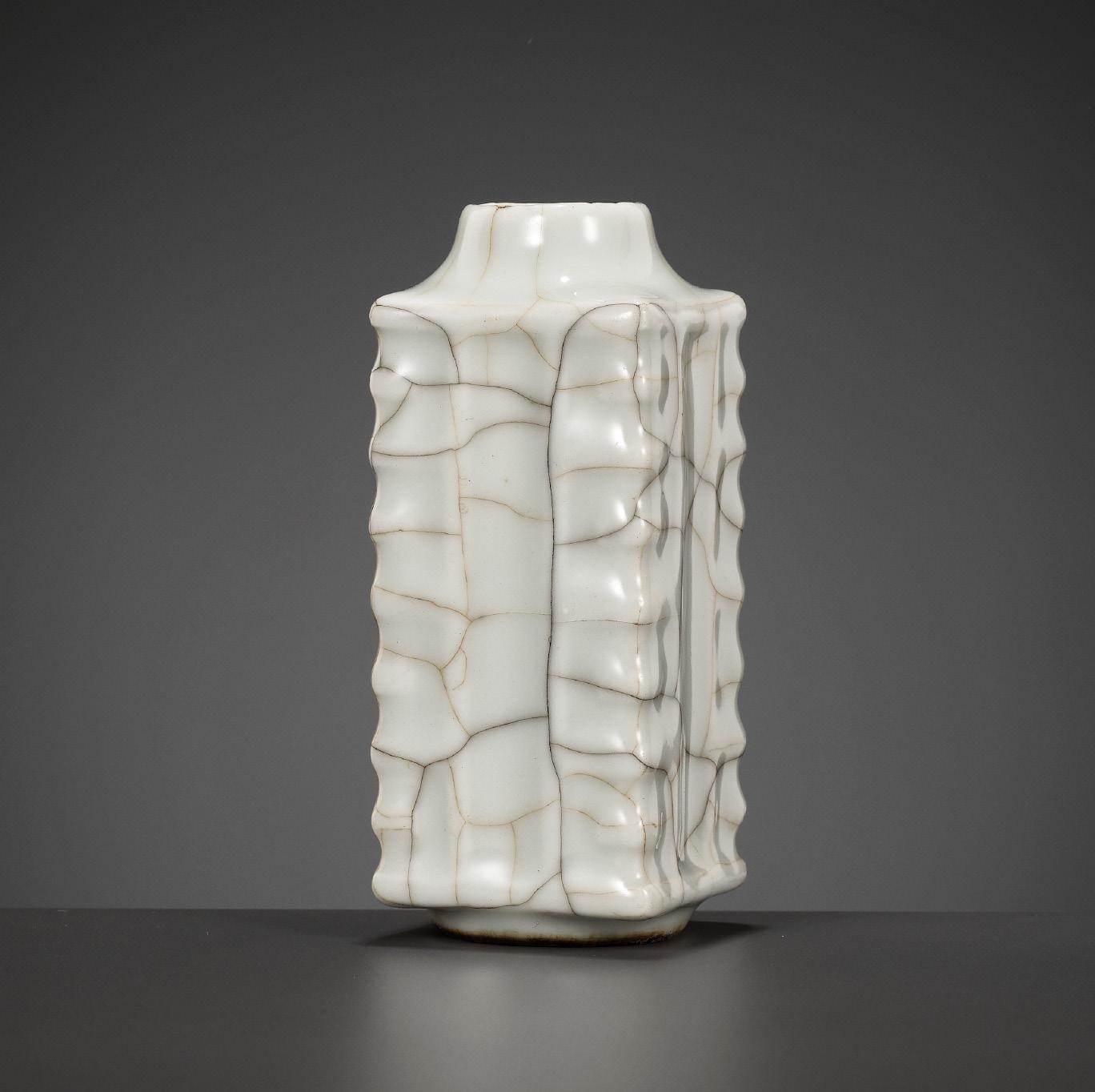
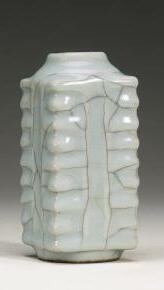
Expert remark: Compare the closely related form and thick glaze with similar two-tone crackle. Note the near-identical size (13.6 cm).
Estimate EUR 3,000
Starting price EUR 1,500

170 116
Felix Tikotin (1893-1986)
AN
EXTREMELY RARE GUAN-TYPE FIGURE OF A HOUND, QIANLONG PERIOD
China, 1736-1795. Finely modeled seated on its haunches with front legs placed on the ground, the tail curled, the jaw agape revealing tongue and teeth, a bell hanging from the collar around its neck, covered overall in a thick pale gray glaze suffused with a dense network of dark gray and transparent crackle.

Provenance: From a noted private collection in Geneva, Switzerland, assembled since the 1960s, and thence by descent. An important part of this collection was on permanent loan and exhibited over several decades at the Asia-Africa Museum in Geneva. The underside with several old labels, ‘Art Ancien de Chine & Extrême-Orient Genève’, ‘KienLung 1736-1795’, ‘434’, and ‘4237/2’. The wood stand with two old labels, ‘4237/2’ and ‘Chine celadon XVIIIe’.
Condition: Very good condition with expected old wear and some firing irregularities, an obvious larger glaze recess to the right haunch, minor nicks, one paw with a smoothened area, probably inherent to the manufacture.
Weight: 711 g (excl. stand)
Dimensions: Height 13.8 cm (excl. stand)
With a well-carved and fitted wood stand, possibly zitan. (2)
Expert’s note: Guan-type or crackle-glazed figures of animals are extremely rare, with only very few other examples found in public or private collections. Most ceramic animal figures of the period were made for export, but the glaze on the present figure is much more in line with the taste of the Qing Emperors (and thus the entire court) of the 18th century.
AUCTION RESULT COMPARISON
Type: Related
Auction: Sotheby’s London, 22 February 2022, lot 81
Price: GBP 5,292 or approx. EUR 6,200 converted and adjusted for inflation at the time of writing
Description: A celadon-glazed seated hound, Qing dynasty, Qianlong period

Expert remark: Compare the closely related modeling with similar pose and open mouth revealing tongue and teeth. Note the celadon glaze, which like the present lot reflects the Qing court taste, and the size (19 cm).
Estimate EUR 3,000
Starting price EUR 1,500
171
117
A FAMILLE ROSE ‘NIULANG AND ZHINÜ’ QUATREFOIL BRUSHPOT, BITONG, JIAQING MARK AND PERIOD
China, 1796-1820. Exquisitely painted to the exterior in underglaze blue and gilt with lotus vines and floral sprays framing two panels depicting the story of Niulang and Zhinü, one with Niulang riding a buffalo, and the other with Zhinü being carried on magpies, thus symbolizing the day of their reunion. The interior and base covered in a turquoise glaze, the upper rim gilt. The recessed base with an iron-red four-character mark Jiaqing nianzhi and of the period.
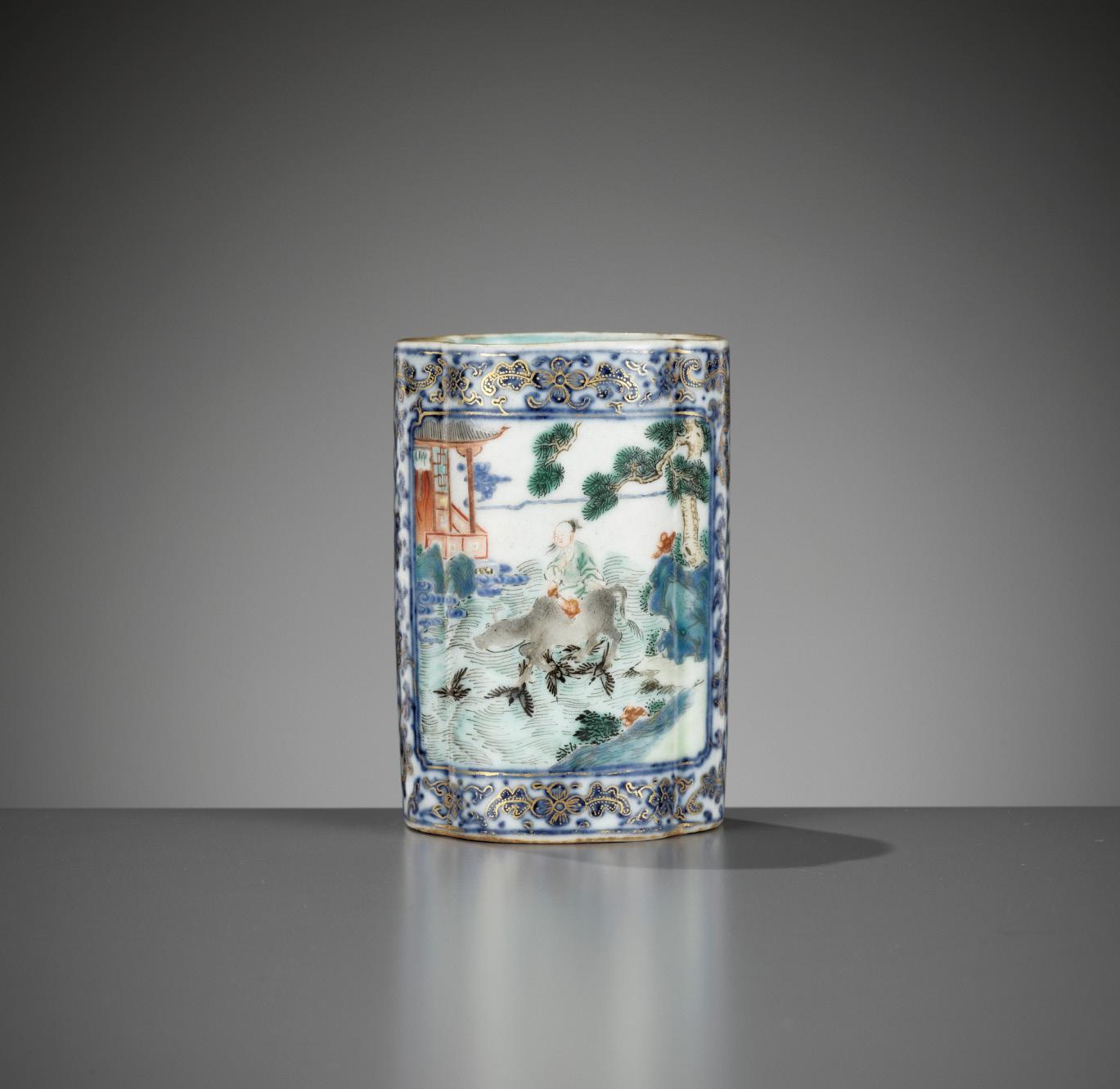
Provenance: From a noted French private collection.
Condition: Good condition with old wear, a fine hairline with small touchups to the rim, and expected firing flaws including a firing crack to the interior and scattered dark spots.
Weight: 102.4 g
Dimensions: Height 7.9 cm
Niulang and Zhinü, the Weaving Maiden and the Oxherd, are characters found in Chinese mythology and the subject of a romantic Chinese folk tale. The story tells of the romance between Zhinü (symbolizing the star Vega) and Niulang (symbolizing the star Altair). Their love was not allowed, and thus they were banished to opposite sides of the heavenly river (symbolizing the Milky Way). Once a year, on the seventh day of the seventh lunar month, a flock of magpies would form a bridge to reunite the lovers for a single day. Though there are many variations of the story, the earliestknown reference to this famous myth dates back to a poem from over 2600 years ago.
Expert’s note: The quadrilobed form is reminiscent of the crabapple (haitang), adding to the auspicious nature of this piece.
AUCTION RESULT COMPARISON
Type: Closely related
Auction: Christie’s New York, 22 March 2019, lot 1844
Price: USD 5,000 or approx. EUR 5,700 converted and adjusted for inflation at the time of writing
Description: A famille-rose quatrefoil brush pot, Jiaqing four-character seal mark in iron red and of the period (1796-1820)
Expert remark: Compare the closely related form, enamel decorations, Jiaqing mark, and size (7.7 cm).


Estimate EUR 3,000
Starting price EUR 1,500
172 118
A FAMILLE ROSE WATER POT, JIAQING MARK AND PERIOD
China, 1796-1820. Delicately potted, of beehive form, brightly painted to the exterior with large lotus blossoms interspersed with smaller similar blooms, all borne on leafy scrolls, the rim framed by a band of yellow and blue ruyi-heads, all against a white ground. The recessed base with an iron-red six-character mark da Qing Jiaqing nianzhi and of the period.
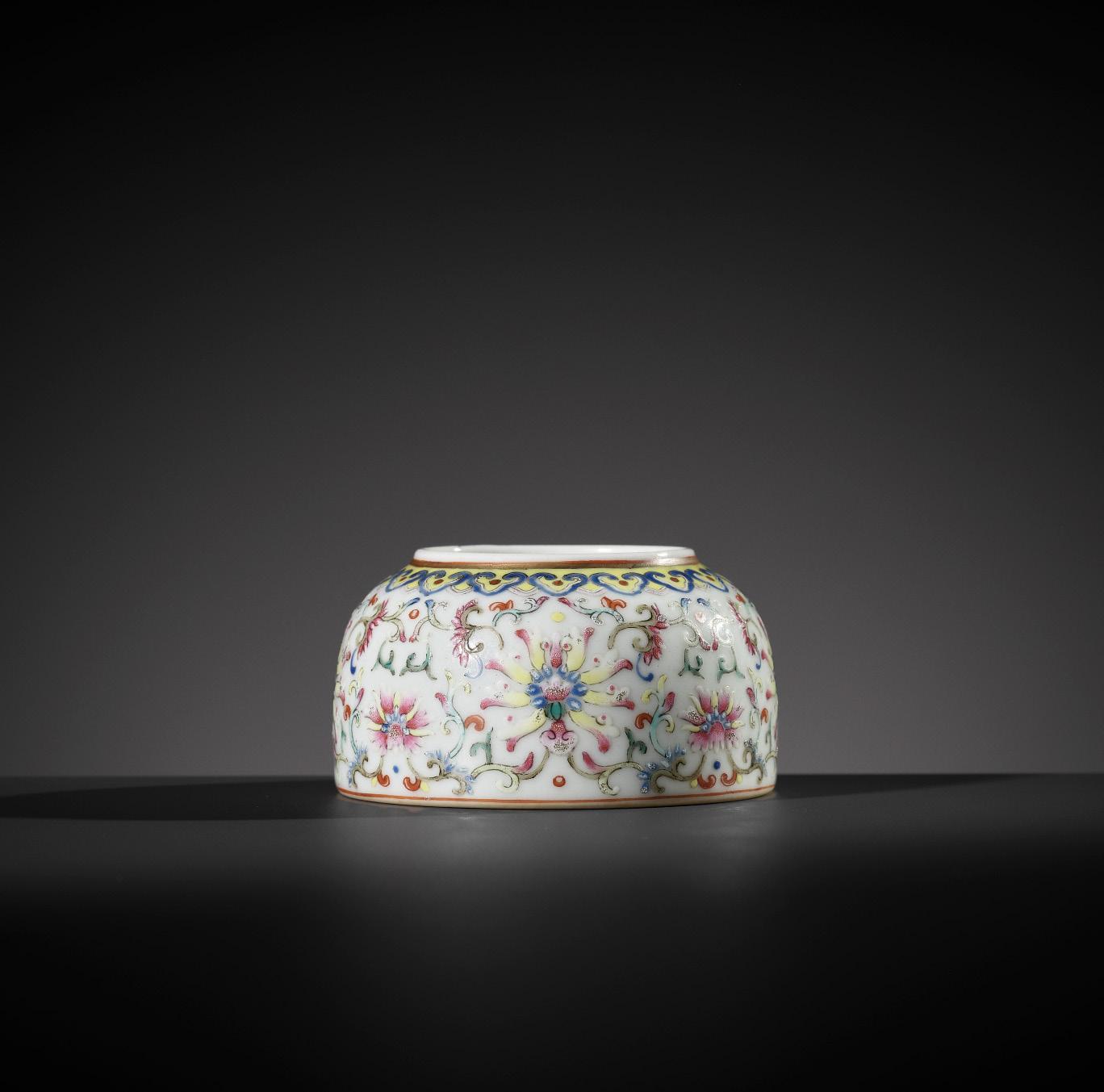


Provenance: British trade.
Condition: Fine condition with old wear and traces of use. A minuscule star crack forming several small hairlines, all barely visible to the naked eye. Light rubbing to the enamels and minor manufacturing flaws, including the expected microscopic bubbles typical for these wares. Overall displaying remarkably well.
Weight: 82.0 g
Dimensions: Diameter 6.9 cm
AUCTION RESULT COMPARISON
Type: Near identical
Auction: Christie’s London, 6 November 2012, lot 248
Price: GBP 12,500 or approx. EUR 20,500 converted and adjusted for inflation at the time of writing
Description: A small famille rose water pot, Jiaqing iron-red seal mark and of the period
Expert remark: Compare the closely related form, enamels with similar wear, and size (6.8 cm)
AUCTION RESULT COMPARISON
Type: Near identical
Auction: Sotheby’s London, 10 November 2010, lot 130
Price: GBP 22,500 or approx. EUR 36,500 converted and adjusted for inflation at the time of writing
Description: A ‘famille rose’ waterpot, Jiaqing mark and period
Expert remark: Compare the closely related form, enamels, motif, and size (7 cm)

Estimate EUR 3,000
Starting price EUR 1,500
173 119
A FAMILLE ROSE ‘CONCH’ INK PALETTE, JIAQING MARK AND OF THE PERIOD
China, 1796-1820. Finely modeled as a flattened conch, with stepped layers depicting the concentric cone shape, the exterior textured with raised dots under a pale turquoise-green glaze, the opening of the shell formed as the sunken well, further painted in penciled iron-red lines with swirls. The rim finely gilt. The reverse with an underglazeblue six-character seal mark da Qing Jiaqing nianzhi and early in the period, c. 1796-1798.
Provenance:
Sotheby’s Hong Kong, 25 April 2004, lot 59, sold for HKD 480,000 or approx. EUR 45,000 (this amount is for one of originally two pieces, converted and adjusted for inflation at the time of writing). A private collector in the United States, acquired from the above, and thence by descent.

Condition: Very good condition with minor wear, mostly to gilt. A microscopic nick with a 2 mm hairline to the edge, almost invisible to the naked eye.
Weight: 84 g
Dimensions: Length 8.8 cm
With a padded box. (2)
Expert’s note: Although dated Jiaqing period, the style of imitating living objects, as exemplified by the current lot, is typical of the late Qianlong period. While the Qianlong Emperor abdicated in 1795, when he assumed the title of the Emperor Emeritus, the works of art produced during the early Jiaqing period retain many stylistic qualities of the Qianlong period. It is commonly agreed that this period of transition lasts between 1796-1798.
Literature comparison: Compare three Qianlong washers imitating shells illustrated in Kangxi, Yongzheng, Qianlong. Qing Porcelain from the Palace Museum Collection, Hong Kong, 1989, pl. 86, and other related examples illustrated in Geng Baochang, Ming Qing ciqi jianding, Hong Kong, 1993, pl. 468.
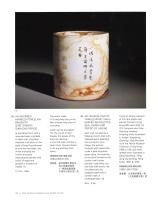
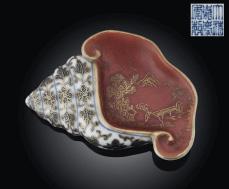
AUCTION RESULT COMPARISON
Type: Related
Auction: Christie’s New York, 24 March 2011, lot
1750
Price: USD 11,875 or approx. EUR 15,000 converted and adjusted for inflation at the time of writing
Description: A rare small blue-enameled shell-form ink palette, Qianlong four-character seal mark in iron red and of the period
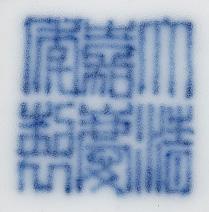



Expert remark: Compare the closely related form with similar raised bosses. Note the size (7.6 cm) and Qianlong reign mark.
AUCTION RESULT COMPARISON
Type: Related
Auction: Christie’s London, 15 May 2012, lot
317
Price: GBP 12,500 or approx. EUR 19,000 converted and adjusted for inflation at the time of writing

Description: A small underglaze blue, ironred and gilt decorated ‘shell-form’ brush washer, xi, Jiaqing underglaze blue six-character seal mark and of the period
Expert remark: Compare the closely related form, gilt rim, and underglaze-blue Jiaqing seal mark. Note the closely related size (8.9 cm).
Estimate EUR 6,000
Starting price EUR 3,000
174 120
A FAMILLE ROSE PORCELAIN ‘LINGZHI’ RUYI SCEPTER, MID-QING DYNASTY
China, 1770-1850. The biscuit handle finely modeled as a gnarled branch with a twisting vine bearing leaves, blossoms, and peaches, the ruyi head in the form of a large lingzhi fungus, the head and lower end of the handle each with a gilt-decorated bat.
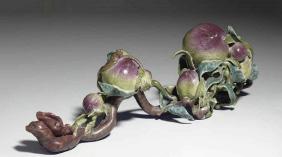
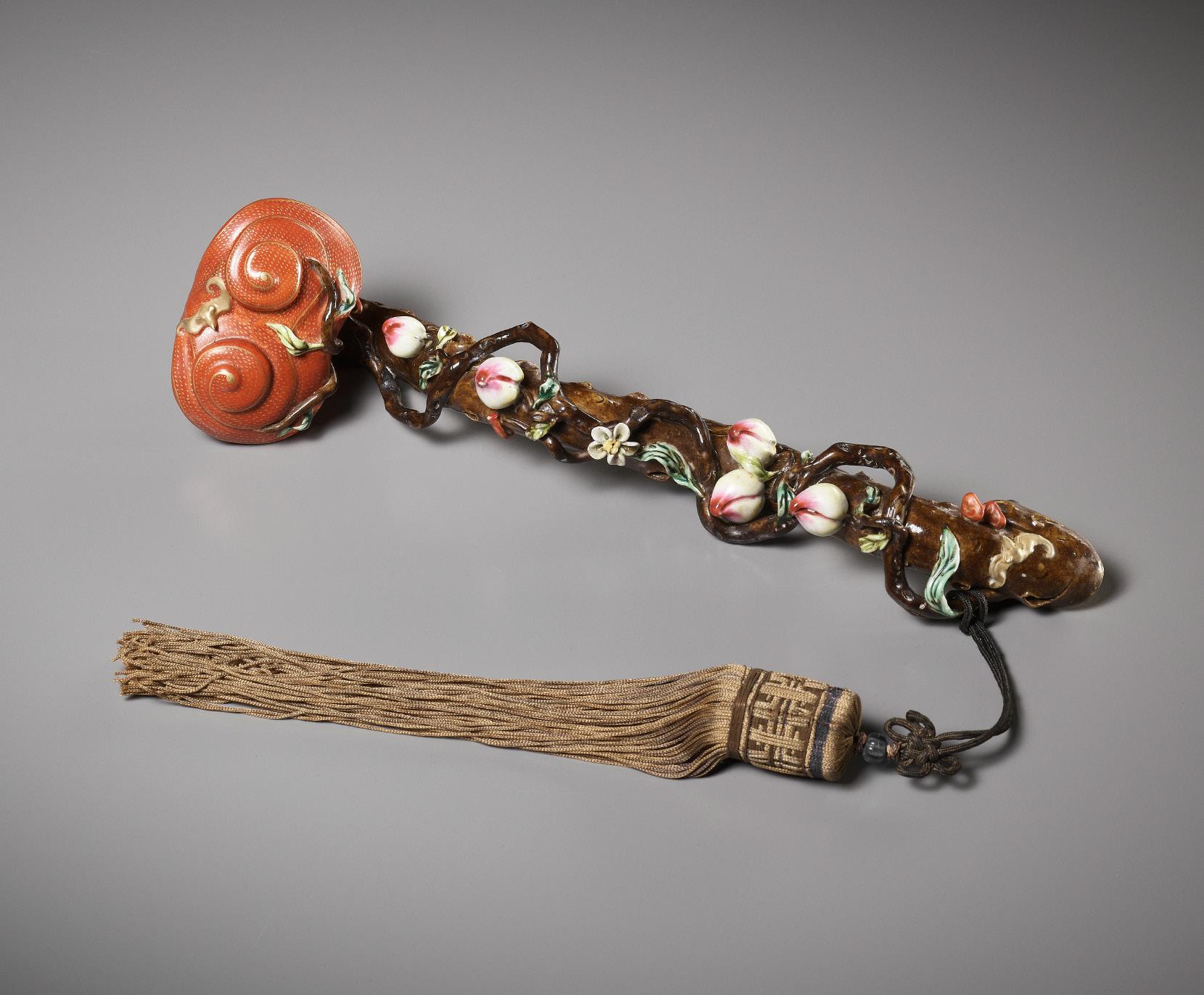

Provenance: From the collection of a gentleman in London, United Kingdom, who has been collecting Asian works of art for the last 50 years, and thence by descent.
Condition: Good condition with expected old wear and some firing irregularities, few tiny losses, little rubbing to gilt and enamels.
Weight: 452 g
Dimensions: Length 32 cm
With a fine silk tassel dating from the same period. (2)
The ruyi scepter, meaning ‘as you wish’, expresses the desire that someone’s wishes come true. As such, it was considered a most suitable gift for an honored friend or high ranking official, particularly on the occasion of a birthday.
Ruyi scepters were made in the widest range of materials, from jade and hardwoods to gilt bronze, semi-precious stones and organic materials such as lacquer, ivory, and bamboo. It is particularly rare, however, to find a ruyi scepter made of porcelain, perhaps due to its natural fragility making it a less suitable material for such a long, slender shape.
AUCTION RESULT COMPARISON
Type: Related
Auction: Christie’s New York, 24 March 2011, lot 1610
Price: USD 18,750 or approx. EUR 23,500 converted and adjusted for inflation at the time of writing
Description: An unusual famille rose ruyi scepter, 19th century Expert remark: Compare the related form, modeling, famille rose enamels, and size (30 cm).
Estimate EUR 6,000
Starting price EUR 3,000
121
122
A
China, 1750-1850. Of rectangular form, meticulously decorated in underglaze-blue with ‘heaping and piling’, featuring nine dragons painted in iron-red amid scrolling vines issuing lingzhi fungi and lily flowers. Each dragon is shown in a different pose and with individual features: The central dragon with a bifurcated tail and biting a lingzhi fungus, flanked by two dragons, one with two horns, the other front facing. The lower row featuring a winged dragon, a dragon with a flaming tail, and another dragon with a bifurcated tail. The upper row depicting two dragons with bifurcated tails centered by a two horned dragon. All within a delicately painted key-fret border.
Provenance: British trade.
Condition: Very good condition with minor wear to the iron-red and manufacturing flaws including pitting, firing flaws, dark spots, and light surface scratches. The hardwood frame with expected minor age cracks and nicks.
Weight: 5,1 kg
Dimensions: Size 50.4 x 49.8 cm
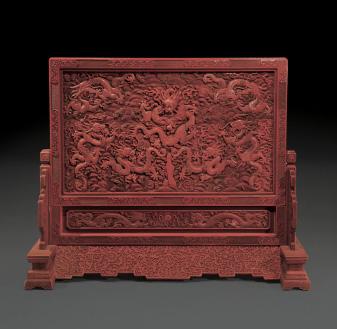

With a matching hardwood frame. (2)

The number nine is considered auspicious in Chinese astrology and folk beliefs. Representing the fullest expression of yang, nine is closely associated with heaven in that it evokes infinity, partly because it was the product of three times three, the most basic unit of three being heaven, earth, and man, and partly because the number nine was homophone with the word ‘jiu’ meaning eternity.
The most prestigious decorative motif for the Chinese imperial court in the Qing dynasty is the Imperial dragon - the symbol of the Son of Heaven, the Emperor himself. In this case there are nine dragons, an association for the nine sons of the Dragon King. This use of the sacred number nine reinforces the imperial connection and suggests that the piece was intended for use within the Imperial household.

LITERATURE COMPARISON
Compare a related iron-red and underglaze-blue ‘nine dragon’ charger, Yongzheng period, sold at Sotheby’s Hong Kong, 8 October 2012, lot 125. Compare further a large cinnabar lacquer ‘nine dragon’ screen, Qianlong period, sold at Sotheby’s Hong Kong, 10 April 2008, lot 2827. Compare also a yellow-ground silk embroidered ‘nine dragons’ Kang cushion cover, circa 1800, sold at Christie’s London, 15 May 2008, lot 100. Compare a large archaistic rhinoceros’ horn ‘nine dragon’ libation cup, 17th century, sold at Christie’s London, 10 May 2011, lot 13. Compare also a pale greenish-white jade ‘nine-dragon’ brush washer, 18th century, Christie’s New York, 23 March 2012, lot 1962.

176
‘NINE DRAGONS’ PLAQUE, PROBABLY IMPERIAL, MID-QING DYNASTY
Estimate EUR 10,000 Starting price EUR 5,000



178
A MASSIVE COPPER-RED AND UNDERGLAZE-BLUE ‘HUNDRED BOYS’ JARDINIÉRE, DATED 1779 OR 1839
Inscriptions: To the base, inscribed in black ink “Commissioned by […] Mu in the summer of the Year of Jihai”, this date corresponding to 1779 or 1839.
China. Heavily potted, the exterior finely decorated with a festive scene depicting numerous boys in a fenced garden outside a small building amid trees, plantain leaves, rockwork, and swirling clouds, carrying lanterns and toy bats attached to sticks, others moving a large elephant-form cart on four wheels with a tall vase containing a gnarled branch on its back, with further boys playing percussive instruments, one boy blowing into a horn, with distant mountains in the background.
Provenance: English trade.
Condition: Excellent condition with old wear, traces of use and shallow surface scratches overall. Some firing irregularities such as distinct glaze recesses along the foot, which have darkened over time, and dark spots.
Weight: 19.7 kg
Dimensions: Diameter 59 cm
The present lot is filled with auspicious imagery. The ‘hundred boys’ motif symbolizes the Chinese perpetual wish for many sons, while the image of an elephant with a vase on its back (taiping youxiang, or ‘when there is peace, there are signs’) represents a good harvest and peacetime. According to Terese Tse Batholomew in Hidden Meanings in Chinese Art, San Francisco, 2006, page 63, the ‘hundred boys’ theme has its origins in the Western Zhou dynasty when King Wen of the Zhou adopted one son in addition to his ninety-nine sons to complete the number of one hundred.

AUCTION RESULT COMPARISON
Type: Related
Auction: Sotheby’s London, 9 November 2016, lot 247
Price: GBP 35,000 or approx. EUR 50,500 converted and adjusted for inflation at the time of writing
Description: A copper-red and underglaze-blue ‘landscape’ jardinière, Qing dynasty, 18th century Expert remark: Compare the copper-red and underglaze-blue painting. Note the similar size (57 cm). Also note the different form and subject, and possibly slightly earlier date.

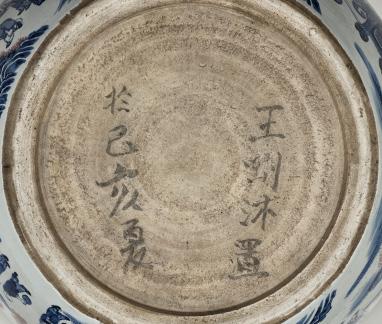
Estimate EUR 6,000
Starting price EUR 3,000
179 123
A NEAR PAIR OF IMPERIAL YELLOW-GLAZED BOWLS, DAOGUANG MARKS AND PERIOD

China, 1821-1850. Each with deep rounded sides supported on a short foot and rising to an everted rim, applied overall with a rich yellow glaze of even tone. The white base of each bowl with an underglazeblue six-character seal mark da Qing Daoguang nianzhi and of the period.
Provenance: From a private collection in Calgary, Canada, acquired in Hong Kong before 1995, while the previous owner was active as an auctioneer in Hong Kong. Thence by descent in the same family.
A copy of a Hong Kong auctioneer’s license, issued to the previous owner on 18 September 1994 and valid until 17 September 1995, accompanies this lot.
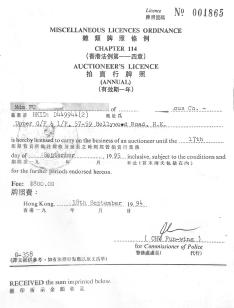
Condition: One bowl in excellent condition with only a small glaze recess. The other bowl in good condition with a minor hairline, which is not visible under strong blue light and only noticeable to the touch on one side. Both bowls with minor wear and firing irregularities.
Weight: 256.9 g and 250.6 g
Dimensions: Diameter 14.4 cm and 14.6 cm
With a single padded storage box, fitted to carry the pair of bowls, bearing an old collector’s label on the outside. (3)
AUCTION RESULT COMPARISON
Type: Near identical
Auction: Sotheby’s Hong Kong, 26 May 2021, lot 349
Price: HKD 100,800 or approx. EUR 12,000 converted and adjusted for inflation at the time of writing
Description: A yellow-glazed bowl, seal mark and period of Daoguang

Expert remark: Compare the closely related form, glaze, Daoguang seal mark, and size (14.8 cm). Note that the lot comprises only one bowl.
Auction result comparison:
Type: Near identical
Auction: Sotheby’s London, 10 November 2017, lot 208
Price: GBP 10,000 or approx. EUR 13,500 converted and adjusted for inflation at the time of writing
Description: A yellow-glazed bowl, Daoguang seal mark and period


Expert remark: Compare the closely related form, glaze, Daoguang seal mark, and size (14.6 cm). Note that the lot comprises only one bowl.
Estimate EUR 10,000
Starting price EUR 5,000
180 124
AN IMPERIAL YELLOW-GLAZED BOWL, DAOGUANG MARK AND PERIOD

China, 1821-1850. The deep rounded sides supported on a short foot and rising to an everted rim, applied overall with a rich yellow glaze of even tone. The white base with an underglaze-blue six-character seal mark da Qing Daoguang nianzhi and of the period.
Weight: 258 g
Dimensions: 14.7 cm
Auction result comparison:
Type: Near identical
Auction: Sotheby’s Hong Kong, 26 May 2021, lot 349
Price: HKD 100,800 or approx. EUR 12,000 converted and adjusted for inflation at the time of writing
Description: A yellow-glazed bowl, seal mark and period of Daoguang

Expert remark: Compare the closely related form, glaze, Daoguang seal mark, and size (14.8 cm)

AUCTION RESULT COMPARISON
Type: Near identical
Baron Ago von Maltzan (18771927), Library of Congress

Provenance: Ago von Maltzan, acquired in Beijing between 1912 and 1916, and thence by descent within the same family. Adolf Georg Otto “Ago” von Maltzan, Freiherr zu Wartenberg und Penzlin (1877-1927), was a preeminent German diplomat of the Weimar Republic, who served in Beijing between 1912 and 1916, after posts in Kristiania (1909), St. Petersburg (1911), and Rio de Janeiro (1907). As the Permanent Under-Secretary for Foreign Affairs, he was a signatory of the Treaty of Rapallo (1922) between Germany and Soviet Russia, under which both countries renounced all territorial and financial claims against each other and opened friendly diplomatic relations. From 1924, he served as Ambassador to the United States in Washington, D.C. The Vossische Zeitung, a nationally known Berlin newspaper that represented the interests of the liberal middle class and was generally regarded as Germany’s national newspaper of record, described Maltzan as the most competent diplomat that Germany ever had.
Condition: Some old wear as expected, minor firing irregularities, one side with a forked hairline.
Auction: Sotheby’s London, 10 November 2017, lot 208
Price: GBP 10,000 or approx. EUR 13,500 converted and adjusted for inflation at the time of writing
Description: A yellow-glazed bowl, Daoguang seal mark and period
Expert remark: Compare the closely related form, glaze, Daoguang seal mark, and size (14.6 cm)
Estimate EUR 4,000
Starting price EUR 2,000
181 125
126
AN IMPERIAL FAMILLE ROSE ‘LOTUS POND’ BOWL, TONGZHI MARK AND PERIOD

China, 1861-1875. Delicately potted, the deep sides supported on a short straight foot, rising to a gently everted rim, finely painted to the exterior in polychrome enamels and iron red with a continuous scene of lotus, bamboo, and wild flowers growing from a pond, with birds including a pair of magpies, a kingfisher, two mandarin ducks, and an egret, and insects such as butterflies and various beetles, as well as fish swimming in the water. The rim neatly lined in gilt. The recessed base with an underglaze blue six-character mark da Qing Tongzhi nianzhi and of the period.
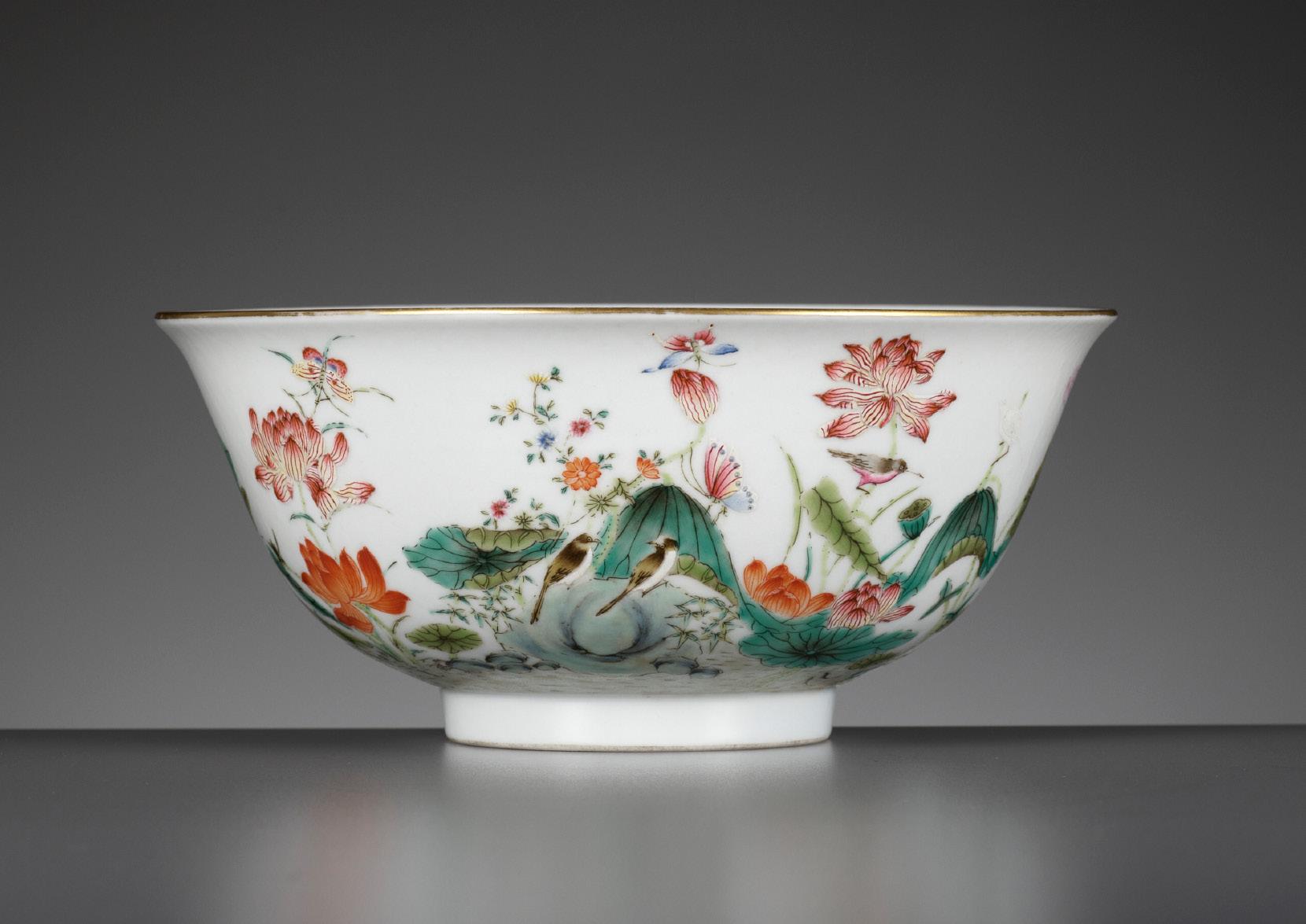
Provenance: From a Slovakian private collection. The base with a fragment of an old label ‘B&T’.
Condition: Excellent condition with some wear to gilt and enamels, and expected firing flaws such as minor warping.
Weight: 230.4 g
Dimensions: Diameter 15.5 cm
AUCTION RESULT COMPARISON
Type: Related
Auction: Christie’s Paris, 9 June
2021, lot 245
Price: EUR 17,500 or approx.
EUR 19,250 adjusted for inflation at the time of writing
Description: A pair of famille rose ‘butterfly’ bowls, China, Qing dynasty, Tongzhi six-character marks and of the period (1862-1874)

Expert remark: Compare the related form, enameled decoration, gilt rim, and size (15.6 cm). Note the different motif and that this lot consists of two bowls.
Estimate EUR 4,000
Starting price EUR 2,000
182
A YELLOW-GROUND AND GREEN-ENAMELED ‘BAMBOO’ BOWL, TONGZHI MARK AND PERIOD
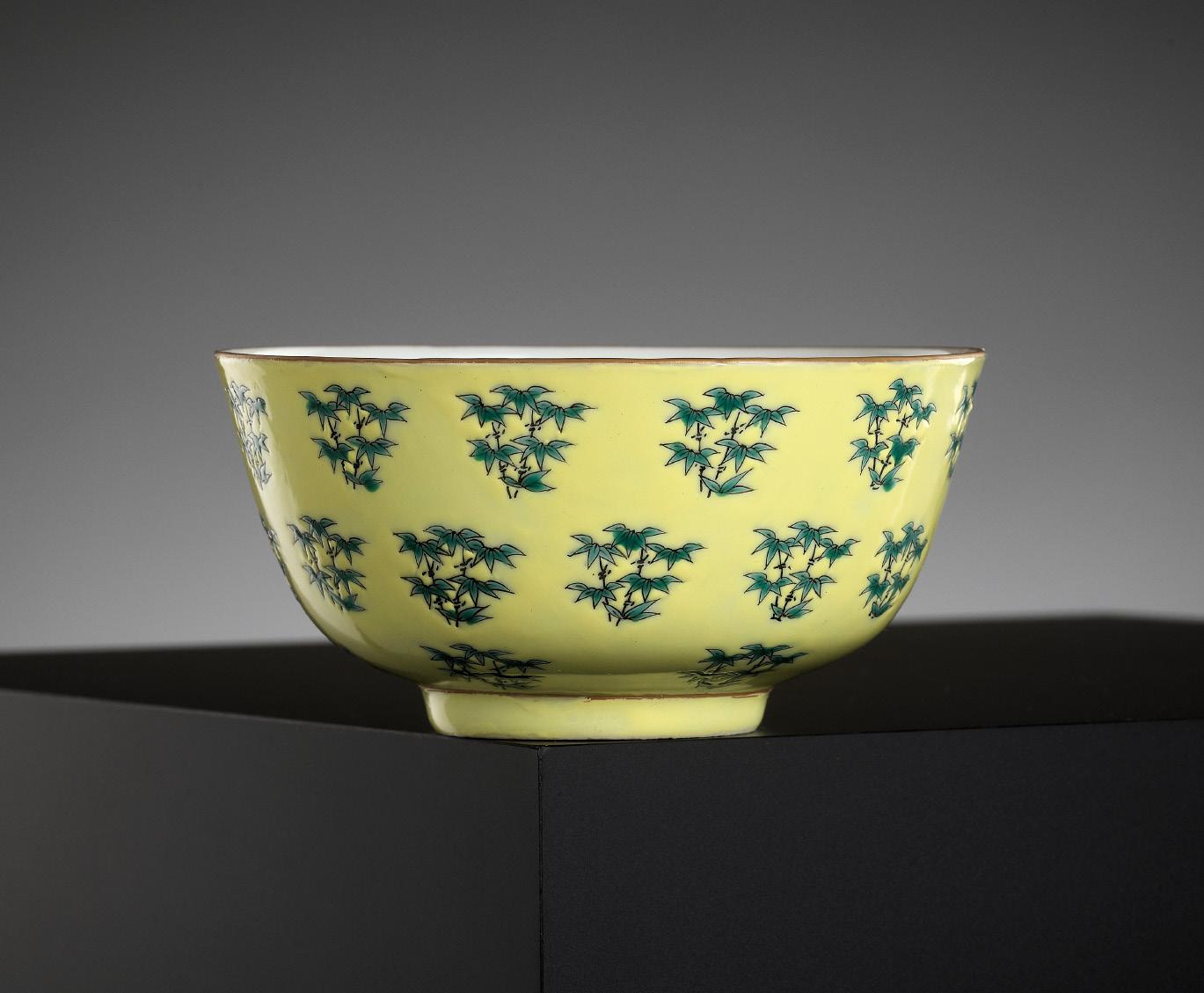


China, 1862-1874. The deep rounded sides rising supported on a short tapered foot, the exterior delicately enameled with rows of bamboo sprays against a bright yellow ground, framed by the rim and foot highlighted in gilt. The interior and base covered with a transparent glaze, the recessed base with an iron-red four-character mark Tongzhi nianzhi and of the period.
Provenance: English trade.
Condition: Excellent condition with expected minor old wear and firing irregularities.
Weight: 122.3 g
Dimensions: Diameter 11.2 cm
AUCTION RESULT COMPARISON
Type: Related
Auction: Christie’s London, 5 November 2019, lot 203
Price: GBP 12,500 or approx. EUR 17,000 converted and adjusted for inflation at the time of writing
Description: A yellow-ground greenenameled ‘bamboo’ zhadou, dish, and cup, Tongzhi four-character marks in iron-red and of the period
Expert remark: Note that this lot comprises three objects of the same decoration and also with Tongzhi four-character marks in iron-red and of the period.
Estimate EUR 4,000
Starting price EUR 2,000
183 127
128
AN IMPERIAL YELLOW-GROUND BLUE-ENAMELED ‘SHOU’ DISH, TONGZHI MARK AND PERIOD

China, 1861-1874. The deep rounded sides supported on a short foot and rising to a gently everted rim. The interior finely decorated with six concentric bands of 138 stylized shou characters in blue enamel, encircling a larger central shou character, all reserved on an even Imperial yellow ground. The rim finely gilt. The exterior covered with a transparent glaze and decorated with three evenly spaced floral sprays and scrolling vines in exquisite Famille Rose enamels. The recessed base with an iron-red four-character mark Tongzhi nianzhi and of the period.
Provenance: English trade. By repute from an old estate in northern Scotland.
Condition: Magnificent condition with expected minor wear to gilt and enamels as well as few minute firing irregularities. Intentional fine craquelure to the glaze overall.
Weight: 744.9 g
Dimensions: Diameter 29 cm
AUCTION RESULT COMPARISON
Type: Related
Auction: Christie’s New York, 23 September 2022, lot 1058
Price: USD 47,880 or approx. EUR 46,000 converted and adjusted for inflation at the time of writing
Description: A pair of yellow-ground ‘Shou’ bowls, Tongzhi fourcharacter marks in iron red and of the period
Expert remark: Compare the closely related yellow ground, blueenameled shou characters, gilt rim, and iron-red Tongzhi mark. Note the different form and smaller size (21 cm). Also note that this lot consists of two bowls.


Estimate EUR 10,000
Starting price EUR 5,000
184


A LARGE AND IMPORTANT DAYAZHAI-TYPE IMPERIAL YELLOW-GROUND FISH BOWL, TIHEDIAN MARK, TONGZHI/GUANGXU PERIOD
Inscriptions: With an iron-red seal mark ‘Tihedian zhi’ in a line below the rim.
China, 1862-1908. Sturdily potted with rounded sides virtuously decorated in black grisaille with leafy peony branches issuing large blooms in various stages of growth against a bright yellow-ground below an iron-red line border at the massive lipped rim. The top of the rim and interior with a transparent glaze.

Provenance: English trade, formerly in a French private collection. Condition: Excellent condition with expected old wear, shallow surface scratches and traces of use overall. Kiln irregularities include glaze recesses, small firing cracks and dark spots.
Weight: 24.3 kg
Dimensions: Diameter 53.5 cm (at the widest points)
The Hall of Manifest Harmony, Tihedian, was one of the six palaces in the northwestern sector of the Forbidden City where the Empress Dowager Cixi lived during much of her tenure as Regent to her son, Emperor Tongzhi. Special porcelains, such as the present example, were designed and produced for several of these palaces.
Literature comparison: Compare a pair of massive yellow-ground Tihedian-marked fishbowls at Christie’s New York, 29 November 1984, lot 577. Compare a turquoise-ground grisaille-decorated fishbowl in the Chuxiugong (Palace of Concentrated Beauty), Beijing, illustrated in The Forbidden City, The Forbidden City Publishing House, Beijing, 1988.
AUCTION RESULT COMPARISON
Type: Closely related
Auction: Christie’s Hong Kong, 30 May 2018, lot 3126
Price: HKD 1,000,000 or approx. EUR 132,000 converted and adjusted for inflation at the time of writing
Description: A very rare large dayazhai-type yellow-ground fish bowl, Tihedian iron-red seal mark in a line, Guangxu period
Expert remark: Compare the closely related form, decoration, and mark. Note the closely related size (53 cm)
AUCTION RESULT COMPARISON
Type: Closely related
Auction: Christie’s New York, 15 September 2011, lot 1599
Price: USD 290,500 or approx. EUR 362,000 converted and adjusted for inflation at the time of writing
Description: A Very Rare Pair of Large Grisaille-Decorated Yellow-Enameled Jardinieres, Tihedian Zhi Iron-Red Marks in a Line, Tongzhi/Guangxu Period (1862-1908)


Expert remark: Compare the closely related form, decoration, and marks. Note the closely related size (50.8 cm). Also note that this lot consists of two bowls.
Estimate EUR 10,000
Starting price EUR 5,000
129

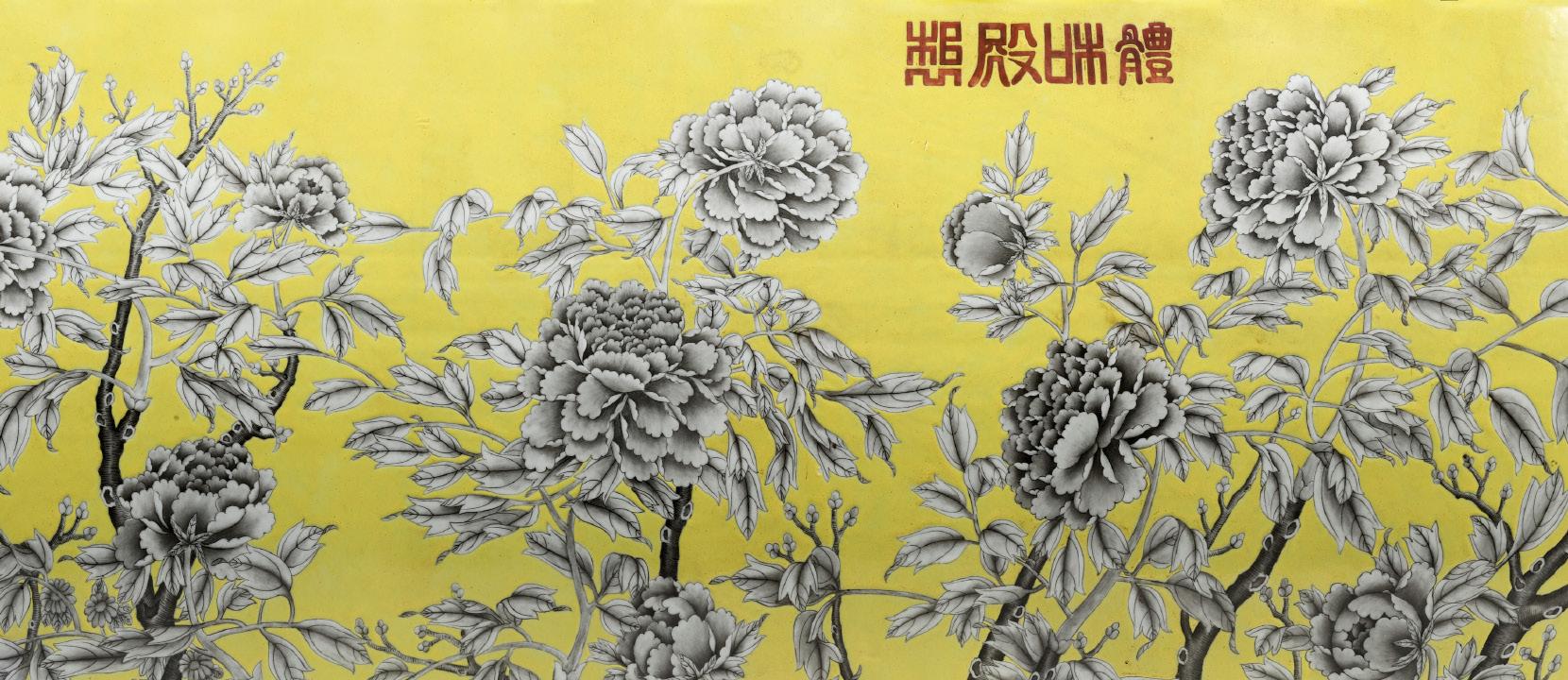
A LARGE IRON-RED AND GILT ‘DRAGONS’ DISH, GUANGXU MARK AND PERIOD
China, 1875-1908. Nicely potted with rounded sides and finely painted in iron red and gilt with two confronting dragons amid ruyi-shaped clouds and flames chasing a pearl, the dragons’ eyes dotted in black on an opaque white enamel ground also used to depict their fangs and claws. The design repeated along the exterior walls. The recessed base with an iron-red six-character mark da Qing Guangxu nianzhi and of the period.
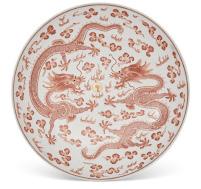
Provenance: From a Swedish private collection. Originally gifted to the previous owner in the 1950s, and thence by descent in the same family.
Condition: Magnificent condition with only minimal firing irregularities, little wear to gilt and enamels, minor fritting to foot, and light surface scratches. The gilt remarkably well-preserved!
Weight: 1,892 g
Dimensions: Diameter 34 cm
AUCTION RESULT COMPARISON
Type: Near identical
Auction: Christie’s London, 3 November 2020, lot 184
Price: GBP 18,750 or approx. EUR 25,000 converted and adjusted for inflation at the time of writing
Description: A large iron-red-decorated ‘dragon’ dish, Guangxu six-character mark in iron-red and of the period
Expert remark: Compare the near identical motif to the interior, and similar size (37 cm). Note the exterior is enameled with four blooms on leafy scrolls.
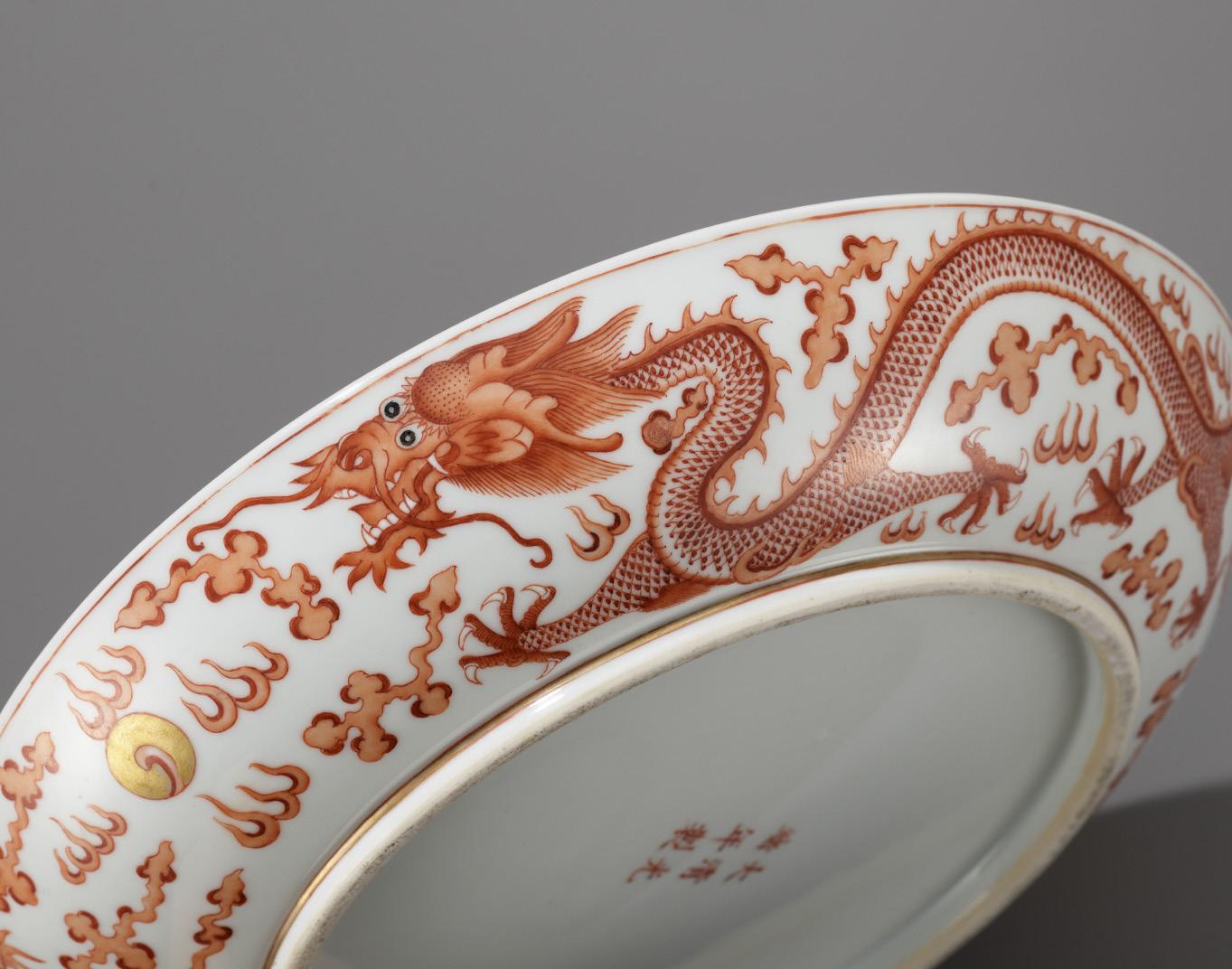
AUCTION RESULT COMPARISON
Type: Near identical
Auction: Christie’s London, 14 May 2013, lot 281
Price: GBP 22,500 or approx. EUR 35,500 converted and adjusted for inflation at the time of writing
Description: A pair of iron-red-decorated ‘dragon’ dishes, Guangxu sixcharacter mark and of the period

Expert remark: Compare the near identical motif to the interior and exterior, and the similar size (33.2). Note the lot comprises two dishes.
Estimate EUR 12,000
Starting price EUR 6,000
188 130

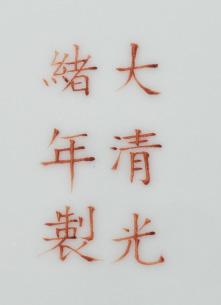
A MING-STYLE BLUE AND WHITE BOTTLE VASE, GUANGXU MARK AND PERIOD


China, 1875-1908. The globular body is finely painted in vibrant tones of cobalt blue with a composite floral scroll above a band of lotus petals and classic scroll at the foot, and below a trefoil cloud collar and another composite floral scroll around the shoulder. The tall neck is further decorated with key fret and upright plantain leaves, and breaking waves at the flaring mouth. The base with an underglaze-blue six-character mark da Qing Guangxu nianzhi and of the period.

Provenance: The trade in Paris, France. Condition: Excellent condition with minor wear and firing irregularities, including few minute glaze gaps.
Weight: 2,418 g
Dimensions: Height 39 cm
Literature comparison: A similar Guangxu-period vase is illustrated in Blue and White Porcelain with Underglazed Red (III). The Complete Collection of Treasures of the Palace Museum, vol. 36, Hong Kong, 2000, p. 174, no. 159. See a related vase from the Daoguang period, illustrated by G. Avitabile, Vom Schatz der Drachen (From the Dragon’s Treasure), London, 1987, p. 65, no. 87, where the author notes that “this type of bottle vase is mentioned in the imperial lists of the Tongzhi and Guangxu periods, and was used as a gift for the distinguished service to the emperor”.
AUCTION RESULT COMPARISON
Type: Closely related
Auction: Christie’s New York, 23 March 2018, lot 787
Price: USD 52,500 or approx. EUR 56,500 converted and adjusted for inflation at the time of writing
Description: A Ming-style blue and white bottle vase, Guangxu six-character mark in underglaze blue and of the period
Expert remark: Compare the closely related form and decoration. Note the smaller size (35.5 cm).
AUCTION RESULT COMPARISON
Type: Closely related
Auction: Christie’s Hong Kong, 30 November 2011, lot 2956
Price: HKD 437,500 or approx. EUR 71,000 converted and adjusted for inflation at the time of writing
Description: A fine blue and white Ming-style bottle vase, Tongzhi six-character mark and of the period

Expert remark: Compare the closely related form, decoration, and near-identical size (39.4 cm). Note the Tongzhi reign mark.
Estimate EUR 30,000
Starting price EUR 15,000
190
131
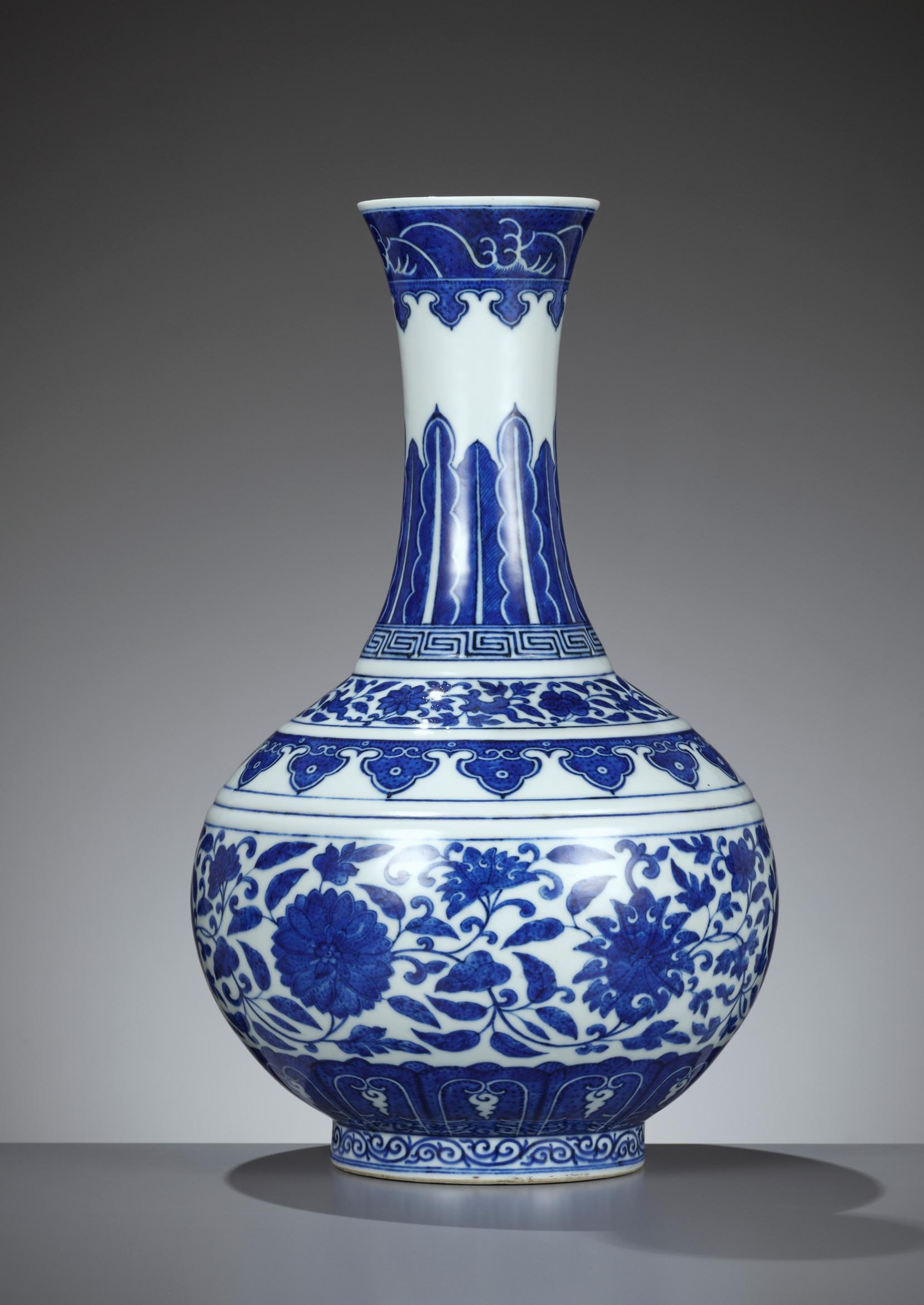
A FLAMBÉ GLAZED VASE, FANGHU, XUANTONG MARK AND PERIOD

China, 1908-1911. Of archaic bronze form, the pear-shaped body of square section and molded with a peach-shaped panel on the front and back face, rising to a broad neck with indented corners and flanked by tubular handles, covered with a rich crackle-suffused crushed-strawberry glaze streaked to a milky lavender tone at the edges and the rim, thinning to pale mushroom at the edges. The base incised with a six-character mark da Qing Xuantong nianzhi and of the period.
Provenance: Sotheby’s London, 9 November 2011, lot 100, estimate GBP 12,000 or approx. EUR 18,500 (converted and adjusted for inflation at the time of writing).
A private collection in Maryland, USA, acquired from the above in an after-sale transaction, and thence by descent.
Condition: Very good condition with minor wear and firing irregularities, the foot with small chips and minor glaze flakes.
Weight: 3,348 g
Dimensions: Height 30 cm
AUCTION RESULT COMPARISON
Type: Closely related
Auction: Sotheby’s Hong Kong, 30 May 2018, lot 520
Price: HKD 275,000 or approx. EUR 36,500 converted and adjusted for inflation at the time of writing
Description: A flambé-glazed vase, hu, incised mark and period of Xianfeng

Expert remark: Compare the closely related form, similar size (30.4 cm) and rich red glaze streaked to a milky lavender tone at the edges. Note the Xianfeng reign mark.


Estimate EUR 6,000
Starting price EUR 3,000
192 132
A LARGE DEHUA FIGURE OF BUDDHA, QING DYNASTY, LATE 18TH - EARLY 19TH CENTURY
China. Seated in dhyanasana atop a lotus base composed of three rows of petals rising from furled lily pads and lotus buds amid waves and dew drops, his hands held above the crossed legs, wearing loosefitting robes draped over his left shoulder, the right arm with a beaded armlet. His serene face with heavy-lidded downcast eyes centered by an urna. The hair arranged in tight spikes around the domed ushnisha.

Inscriptions: To the back, within a double gourd, ‘de hua’, above an impressed commendation seal mark, ‘boji yuren’ (shall virtue extend to all fishermen).
Provenance: Sotheby’s London, 17 March 1964, lot 38, together with a seated figure of Guanyin, dated 18th century. Dr. Wou Kiuan, acquired from the above. Wou Lien-Pai Museum, coll. no. Q.4.22. A copy of the catalog entry for the present lot at Sotheby’s London, 17 March 1964, lot 38, noting the buyer “Wou” and a purchase price of eighty-four British pounds, approximately three months’ salary at the time, accompanies this lot. Dr. Wou Kiuan (1910-1997) was a Chinese diplomat and noted scholar of Chinese art. His father, Wou Lien-Pai (1873-1944), was one the leading political figures of early 20th century China, remembered for his role as speaker and leader of parliament during the turbulent years of the Republican era. Dr. Wou himself embarked on an illustrious career in diplomacy until his retirement in 1952, when he settled in London and devoted the rest of his life to the study of Chinese art. It was no doubt fortuitous that Dr. Wou’s years of collecting coincided with an abundant availability of exceptional Chinese art on the London market. From the mid-1950s to the late 1960s he was able to form a collection of well over 1,000 works that together represented virtually every category of Chinese art. At the heart of Dr. Wou’s drive to collect was a burning desire to preserve the relics of China’s rich historical past scattered across Europe, and to promote Chinese art and culture. It is unclear when Dr. Wou conceived of the idea to create a place to house his collection, but in 1968 he opened the doors to the Wou Lien-Pai Museum, named in honor of his father. Over the years the Museum became a ‘must see’ destination for collectors, academics, and visiting dignitaries, and Dr. Wou would delight in leading his visitors through the galleries, recounting stories of China’s glorious history.
Condition: Very good condition with minor wear and firing irregularities, including small glaze recesses, firing cracks, and kiln grit, the lotus petal tips with few tiny nicks.
Weight: 1,428 g
Dimensions: Height 32.3 cm
AUCTION RESULT COMPARISON
Type: Closely related
Auction: Sotheby’s Paris, 18 December 2012, lot 160
Price: EUR 19,950 or approx. EUR 23,000 adjusted for inflation at the time of writing
Description: A blanc-de-chine figure of Buddha, Qing dynasty, 19th century


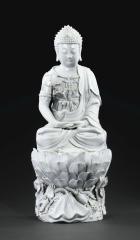
Expert remark: Compare the closely related pose, expression, hair, and base. Note the larger size (43.4 cm).
AUCTION RESULT COMPARISON
Type: Closely related
Auction: Sotheby’s New York, 16 September 2014, lot 168
Price: USD 17,500 or approx. EUR 20,500 adjusted for inflation at the time of writing
Description: A Dehua Figure of Buddha Qing Dynasty, 19th Century
Expert remark: Compare the two identical seals, one within a double-gourd reading Dehua, the other reading Bo ji yu ren within a square. Note the larger size (39.9 cm).


Estimate EUR 6,000
Starting price EUR 3,000
193 133
Dr. Wou Kiuan, Paris, November 1939
134
A BLUE AND WHITE ‘LANCA’ STEM CUP, DAOGUANG MARK AND PERIOD


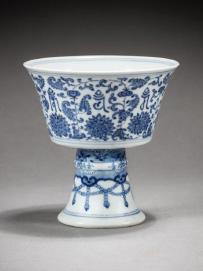
China, 1821-1850. The cup is decorated to the exterior with lanca characters divided by lotus scrolls above a band of lotus lappets, the interior with a central medallion enclosing an elaborate radiating foliate design. The spreading foot is painted with flower-heads above jeweled tassels and ruyi-heads. The interior of the foot with an underglaze-blue six-character seal mark da Qing Daoguang nianzhi in a line and of the period.
Provenance: From the estate of Soo Sui-ling and Dr. Cornelius Osgood, and thence by descent in the same family. The interior of the foot with remnants of an old label. Dr. Cornelius Osgood (1905-1983) was a professor of anthropology at Yale University and a leading scholar of the cultures of the Arctic and East Asia. His association with the Peabody Museum of Natural History at Yale began in 1930 when he joined the university’s faculty, and over the years he was instrumental in building up and organizing the museum’s collection. He became curator of the museum’s anthropology department in 1934, and was appointed the Peabody’s associate director in 1966. He held both positions until his retirement in 1973. His publications include a multivolume study of the Athabascan tribes of northern Canada and Alaska as well as Winter, a memoir of the year he spent living among the Indians of Canada’s Northwest Territories in the 1920s. In later years, he specialized in Far Eastern societies, publishing “The Koreans and Their Culture” in 1951, and “Village Life in Old China” in 1963.
Condition: Good condition with minor wear and firing irregularities, one short hairline, and a minuscule chip to the rim.
Weight: 176.5 g
Dimensions: Height 9.7 cm
AUCTION RESULT COMPARISON
Type: Closely related
Auction: Sotheby’s Paris, 8 November 2022, lot 160
Price: EUR 17,640
Description: A blue and white ‘lanca’ stem cup, mark and period of Daoguang
Expert remark: Compare the closely related form, decoration, and Daoguang reign mark. Note the size (10.8 cm).
AUCTION RESULT COMPARISON
Type: Closely related
Auction: Christie’s London, 6 November 2018, lot 84
Price: GBP 11,875 or approx. EUR 16,000 converted and adjusted for inflation at the time of writing
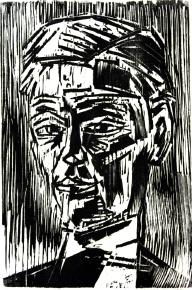
Description: A blue and white ‘lanca’ stem cup, Daoguang six-character seal mark in underglaze blue and of the period

Expert remark: Compare the closely related form, decoration, and Daoguang reign mark. Note the size (10.9 cm).
Estimate EUR 8,000
Starting price EUR 4,000
194
A woodcut print depicting Dr. Cornelius Osgood by Werner Drewes, dated 1959, in the American Art Museum, Smithsonian Institution, Washington D.C.
A VERY FINE FAMILLE ROSE ‘BIRDS AND FLOWERS’ PEAR-SHAPED VASE, YUHUCHUNPING, REPUBLIC PERIOD

China, 1912-1949. Vividly decorated in bright enamels with swallows perched on entwined gnarled branches bearing leaves, buds, and blossoming peonies above leafy sprays of aster, one swallow in flight. Note the remarkable attention to detail overall, and the unusually high quality of the enameling.

Provenance: Dutch trade.
Condition: Excellent condition with minor wear and firing irregularities.
Weight: 2,200 g
Dimensions: Height 35.5 cm
Auction result comparison:
Type: Related
Auction: Christie’s London, 13 November
2015, lot 1310
Price: GBP 20,000 or approx. EUR 28,500 converted and adjusted for inflation at the time of writing
Description: A finely enameled famille rose ‘peony and butterfly’ vase, Republic period
Expert remark: Note the smaller size (27.6 cm) and apocryphal Qianlong reign mark
AUCTION RESULT COMPARISON
Type: Related
Auction: Christie’s New York, 15 September 2011, lot 1641
Price: USD 23,750 or approx. EUR 28,500 converted and adjusted for inflation at the time of writing
Description: A famille rose bottle vase, 20th century
Expert remark: Note the smaller size (22.3 cm) and Jurentang zhi hall mark
Auction result comparison:
Type: Related
Auction: Christie’s London, 11 November
2016, lot 746
Price: GBP 12,500 or approx. EUR 18,000 converted and adjusted for inflation at the time of writing
Description: A large famille rose ‘peony’ vase, 20th century
Expert remark: Note the slightly larger size (39.5 cm) and apocryphal Qianlong reign mark
Estimate EUR 6,000
Starting price EUR 3,000
135

A FAMILLE ROSE ‘NINE PEACHES’ VASE, TIANQIUPING, LATE QING DYNASTY TO REPUBLIC PERIOD
China, 19th to early 20th century. The vase is decorated with the spreading leafy branches of a peach tree bearing nine large fruit and numerous pink and white blossoms, the slender leaves decorated in two shades of green, the shoulder with three iron-red bats. The base with an apocryphal underglaze-blue six-character mark da Qing Qianlong nianzhi

Provenance: From an old Norwegian private collection, and thence by descent in the same family. Acquired in Qingdao, China, in 1954, by the second mate of the Oakland (Holmen & Vaboen shipping company from Kristiansand, Norway), while the ship was on a trip to deliver ore to China, and his wife, a telegraph operator. A scan of an old photograph, showing the present lot with the son of the couple, taken in the family home in 1957 or 1958, accompanies this lot.

Condition: Good condition with only minor wear and few expected firing irregularities, shallow surface scratches, the lower body with a U-shaped hairline.
Weight: 10.1 kg
Dimensions: Height 47 cm
AUCTION RESULT COMPARISON
Type: Closely related
Auction: Sotheby’s New York, 29 June 2022, lot 42
Price: USD 44,100 or approx. EUR 41,000 converted at the time of writing
Description: A large famille-rose ‘peach’ vase (Tianqiuping), Late Qing dynasty / 20th century
Expert remark: Note the closely related size (47.3 cm).
Auction result comparison:
Type: Closely related
Auction: Bonhams San Francisco, 24 June 2015, lot 8397
Price: USD 22,500 or approx. EUR 25,500 converted and adjusted for inflation at the time of writing
Description: A large famille rose Nine Peaches vase, tianqiuping, Qianlong mark, late Qing dynasty
Expert remark: Note the closely related size (48.5 cm)
Auction result comparison:
Type: Closely related
Auction: Christie’s Hong Kong, 8 October 2020, lot 340
Price: HKD 250,000 or approx. EUR 30,000 converted and adjusted for inflation at the time of writing
Description: A large famille rose ‘nine peaches’ vase, tianqiuping, late Qing dynasty-Republic period, late 19th-early 20th century
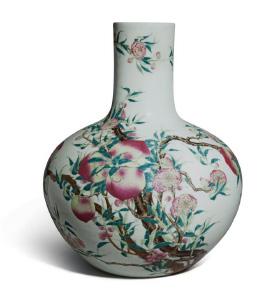
Expert remark: Note the related size (51.8 cm)
Estimate EUR 10,000
Starting price EUR 5,000
197 136
A photograph of the present lot and previous owner in the family home, taken 1957 or 1958
A CEREMONIAL BRONZE HELMET, ZHOU, LATE SHANG DYNASTY
China, 13th-11th century BC. The helmet, modeled with a prominent central taotie mask and once surmounted by a loop-form finial, tapers gracefully to cover the neck, ears, and cheeks. The décor in high relief, with prominently raised ears, brows and nostrils.
Provenance: Jerry Vest and Peter Kuring, Woollahra, Sydney, Australia. Barry Stern Galleries, Paddington, Sydney, Australia, April 1987, by repute acquired from the above. John Williams, Sydney, Australia, before 1992, by repute acquired from the above. A noted private collection in the United States, acquired from the above. Peter Kuring (1951-1987), known as the King of Sydney Style, was a well-known Australian interior decorator and orchidologist. He entered the design scene early in his life, became popular amongst Australia’s elite, and was much loved for his flamboyant attire. He operated an import company with his partner, Jerry, and they often traveled to the Orient during the 1970s to bring back artifacts for clients. Aware of his illness, one of Peter’s last wishes was to have a selling exhibition at Barry Stern’s Gallery, which happened on 21 April 1987. The helmet was eventually acquired by John Williams (d. 2015), a local antique dealer and friend of Peter and Jerry. John spent over 45 years in the antiques and arts trade, first as an auction specialist, then as a noted antique dealer, and finally as an auctioneer. He sold his business to Theodore Bruce shortly before his death.

Condition: Good condition, commensurate with age. Wear and casting flaws. The loop finial lost. One lower corner of ca. 3-4 cm reattached or replaced. Possibly minor old fills to lower edge. Signs of weathering and erosion, corrosion, minor dents and scratches. Fine, naturally grown patina overall, with malachite and cuprite encrustation as well as a patch of distinct olive-green.
Weight: 1,717 g
Dimensions: Height 25 cm
The designs of the Shang people are unrivaled in the history of art Shang dynasty armor and weaponry are no exception. While we know of bronze examples, it is questionable whether metallurgical techniques at the time were advanced enough to produce armor that was light enough to actually wear. Shang armor was more often fashioned from other materials, like lacquer and leather, which were seen as both economical and light enough for battle. Literature suggests that the bulk of Shang armor and weapons were intended to be used as ceremonial ornamentation or for use in funerary rituals.
LITERATURE COMPARISON
A related bronze helmet was unearthed in a Shang tomb at Dayangzhou, Xingan country, Jiangxi Province in 1989. Compare another related bronze helmet, 24.1 cm high, dated to the Shang dynasty, 13th to early 11th century BC, in the Saint Louis Art Museum, object number 283:1949 (fig. 1). Compare a related bronze helmet in the collection of the Nanking Academy of Sciences, illustrated in Dagny Carter, Four Thousand Years of China, New York, 1951, page 17. fig. 1

Estimate EUR 20,000
Starting price EUR 10,000

198 137
John Williams (d. 2015)
Photograph of Peter Kuring, taken January 26, 1974

A ‘FIRE AND FOUR-PETAL LEAVES’ BRONZE RITUAL FOOD VESSEL,
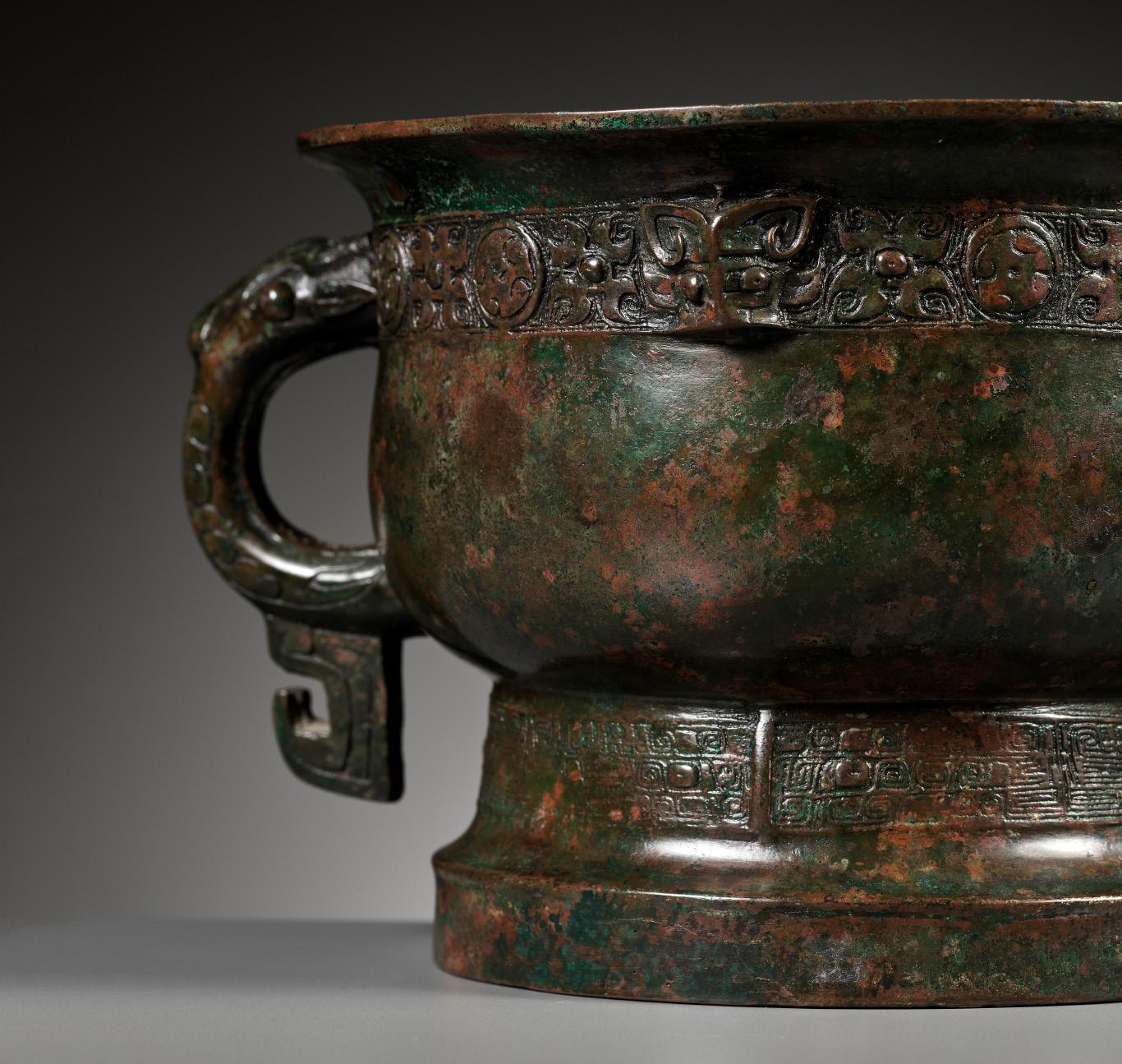

GUI, EARLY WESTERN ZHOU DYNASTY
China, 11th century BC. The deep body of slight S-profile raised on a spreading foot with a tall straight foot rim below a band of leiwen divided by four flanges, cast below the everted rim with a band of alternating fire and four-petal leaves centered on two sides with a small animal mask, flanked by a pair of loop handles with an animal mask at the top and a hooked tab projecting from the bottom. The bronze with a superb, naturally grown, rich, brown patina with distinct malachite and cuprite encrustations.
Provenance: Gottfried and Helga Hertel, Cologne, Germany. The property of a gentleman in the United States, acquired from the above.
Gottfried Hertel (1925-2019) was the Executive Director of the German Nuclear Reactor Insurance Association in Cologne. Together with his wife, Helga (1928-2013), he formed a substantial collection of Asian art, antiquities, and Old Master paintings, over many decades, beginning in 1970.

Gottfried
Parts of the Egyptian art and classical antiquities collection were sold at Bonhams in London, 3 July 2019.
Condition: Excellent condition, commensurate with age. Old wear and shallow surface scratches, losses, small nicks and dents. One side of the wall and an area of the foot rim sympathetically restored. The interior of the foot rim with minor flaking. Superb, naturally grown patina overall and thus displaying exceptionally well.
X-Ray imagery: X-Ray images of the present lot are available on request.
Weight: 1,447 g
Dimensions: Width 25.5 cm (across)
Literature comparison: Compare a related early Western Zhou dynasty gui, illustrated by Wu Zhenfeng, Shangzhou qingtongqi mingwen ji tuxiang jicheng (Compendium of Inscriptions and Images of Bronzes from the Shang and Zhou Dynasties), Shanghai, 2012, pl. 3862. The decoration on the present gui, resembling fire and four-petal leaves, belongs to a distinct type which first appeared in the Western Zhou dynasty, see Shang Zhou qingtongqi wenshi (Decorative Patterns on Shang and Zhou dynasties Bronzes), Beijing, 1984, p. 248, pl. 703-708 for a related discussion and study carried out by the Shanghai Museum Bronze Research Group on this design. Compare the similar gui, also dated early Western Zhou, illustrated by J. Rawson in Western Zhou Ritual Bronzes from the Arthur M. Sackler Collections, vol. IIB, Arthur M. Sackler Foundation, 1990, p. 385, fig. 43.1. See, also, the similar gui in the collection of the Danish National Museum, illustrated by M. Boyer, Some Chinese Archaic Bronzes in the Danish National Museum, BMFEA, No. 27, Stockholm, 1955, pp. 1-10, pl. 5 (b).
AUCTION RESULT COMPARISON
Type: Closely related
Auction: Christie’s New York, 24 March 2011, lot 1247
Price: USD 194,500 or approx. EUR 233,000 converted and adjusted for inflation at the time of writing
Description: A bronze ritual food vessel, gui, early Western Zhou dynasty, 11th century BC Expert remark: Compare the closely related form, handles, and decoration with similar animal masks and alternating fire and fourpetal leaves (described here as “stars and whorls”), as well as the related size (26.7 cm). Note the five-character inscription.
Estimate EUR 30,000
Starting price EUR 15,000
138
(19252019) and Helga Hertel (1928-2013), Cologne, Germany

A BRONZE BELL, YONGZHONG, WESTERN ZHOU DYNASTY


China, 1100-771 BC. The bell is cast to either side with three rows of neatly cast protruding spiral bosses, divided by rope-twist lines.
Provenance: From an important old French private collection assembled since the end of the 19th century. The family used to own one of the most expensive pieces of Asian art ever sold in France. According to the previous owner, “the present lot was hidden in a chest” and he discovered it there when he went to the place for the first time, many years ago.
Condition: Original condition, commensurate with age. Wear, small dents, minor losses, minuscule nicks, signs of weathering and erosion, encrustations. The base of the handle with ancient soldering marks, probably inherent to manufacture, or from only a little time thereafter. No hidden restoration whatsoever. Spectacular naturally grown patina with various tones of green, including deep malachite.
Weight: 1,595 g
Dimensions: Height 33.8 cm
Bells of this type were made in graduated sizes to form a set or instrumental ‘chime’. Each bell was capable of emitting two different tones, dependent on the exact location struck. Robert Bagley explains, “sets of bells were both aurally and visually the most prominent instruments of musical ensembles” in ancient China, but were unknown outside of China, see Jenny So (ed.), Music in the Age of Confucius, Freer Gallery of Art and Arthur M. Sackler Gallery, Washington DC, 2000, pp. 35-63.
LITERATURE COMPARISON
Compare a related bell, 54.7 cm high, dated to the Warring States period, ca. 300-250 BC, in the collection of the Arthur M. Sackler Gallery of the National Museum of Asian Art, Smithsonian Institution, accession number S2012.9.2558.
AUCTION RESULT COMPARISON
Type: Closely related
Auction: Christie’s New York, 20 September 2013, lot 1477
Price: USD 47,500 or approx. EUR 55,000 converted and adjusted for inflation at the time of writing
Description: A Small Bronze Bell, Yongzhong, Early/ Middle Western Zhou Dynasty, 11th-9th Century BC
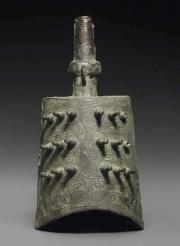
Expert remark: Note the much smaller size (25 cm)
AUCTION RESULT COMPARISON
Type: Closely related
Auction: Sotheby’s New York, 20 March 2019, lot 663
Price: USD 325,000 or approx. EUR 343,000 converted and adjusted for inflation at the time of writing
Description: An Extremely Rare Set of Seven Archaic Bronze Ritual Bells (Zhong) Western Zhou Dynasty

Expert remark: Note this lot contains a complete set of 7 bells
Estimate EUR 8,000
Starting price EUR 4,000
202 139


140 AN ARCHAIC BRONZE RITUAL FOOD VESSEL, LI, LATE WESTERN ZHOU DYNASTY
Exhibited: According to label ‘Univ Museum Exhibition C10 4-33’ exhibited at Treasures of the Chinese Scholar, Chinese Culture Center of San Francisco, USA, 1997, and University of Pennsylvania Museum of Archaeology and Anthropology, USA, 1998.

China, 9th-7th century BC. The compressed body raised on three legs with flat, partially open backs, each leg positioned below a notched flange centering pairs of stylized confronting dragons, the flat everted rim undecorated. The bronze with a superb, naturally grown, rich patina with distinct malachite and azurite encrustations.

Provenance: Sotheby’s New York, 28-29
November 1994, lot
202 (dated late Shang to early Western Zhou dynasty). Lacquered with an inventory number, ‘L-1042-145’, indicating a prior museum deaccession. The Ji Zhen Zhai Collection, Dr. John Fong, acquired from the above. The underside of one foot with two labels, ‘Ji Zhen Zhai Collection’ and ‘Univ Museum Exhibition C10 4-33’. John K. Fong (Fang Jinpei) was a psychiatrist and Professor of Archaeology at The University of Pennsylvania Museum of Archaeology and Anthropology in Philadelphia, USA. He studied and collected Chinese art for more than 25 years, developing the Ji Zhen Zhai (Studio of Accumulated Treasures) Collection. He curated the exhibition Treasures of the Chinese Scholar, which first opened at the Chinese Culture Center of San Francisco, USA, in 1997 and then moved to the University of Pennsylvania Museum of Archaeology and Anthropology in 1998.
Condition: Superb original condition, commensurate with age, with no fills or restorations. As expected with minor nicks and small losses, signs of weathering and corrosion, soil encrustations.
Weight: 1,215 g
Dimensions: Diameter 17 cm, Height 12.5 cm

Expert’s note: Decorated with a shallow yet crisp design of taotie masks or S-shaped dragons, vessels of this type were discovered in Fufeng, Shaanxi Provence.
Literature comparison: Compare a closely related bronze li, 13 cm high, dated to the Western Zhou dynasty, ca. 8th-7th century BC, in the collection of the Arthur M. Sackler Gallery of the National Museum of Asian Art, Smithsonian Institution, accession number S1987.351, illustrated by Jessica Rawson, Western Zhou Ritual Bronzes from the Arthur M. Sackler Collections, Arthur M. Sackler Foundation, Washington DC, 1990, pp. 328329, no. 29.
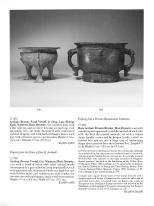
AUCTION RESULT COMPARISON
Type: Closely related
Auction: Christie’s New York, 24 March 2011, lot 1251
Price: USD 62,500 or approx. EUR 75,000 converted and adjusted for inflation at the time of writing
Description: A Bronze Ritual Tripod Food Vessel, Liding, Late Western Zhou Dynasty, 8th Century BC
Expert remark: Compare the closely related form, flanges, and dragon decoration. Note the near-identical diameter (18 cm).
AUCTION RESULT COMPARISON
Type: Related
Auction: Sotheby’s New York, 22 March 2011, lot 31
Price: USD 56,250 or approx. EUR 67,500 converted and adjusted for inflation at the time of writing
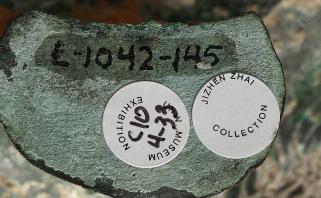
Description: An archaic bronze ritual food vessel (li), late Western Zhou dynasty, 9th / 8th century BC

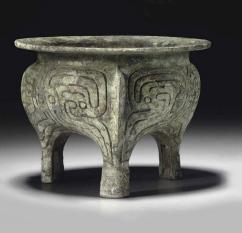
Expert remark: Compare the closely related form, flanges, and dragon decoration. Note the larger size (height 18.4 cm).
Estimate EUR 20,000
Starting price EUR 10,000
205

A RARE AND IMPORTANT BRONZE RITUAL WINE VESSEL, EASTERN ZHOU DYNASTY, SHANXI OR HEBEI, CHINA, 7TH-5TH CENTURY BC

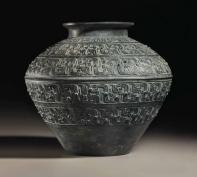
Published: Friedrich Georg Zeileis, Von Shang bis Qing - Dreieinhalb Jahrtausende Chinesischer Bronze (From Shang to Qing – Three and a Half Millenia of Chinese Bronze), 1999, pages 252-253, no. 86.
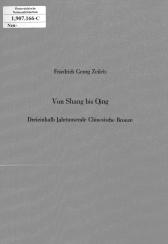
Superbly cast, the globular body rising to a short waisted neck with an everted rim, densely decorated with rectangular panels full of archaic scrolls divided by rope-twist bands, all neatly incised in fine relief. The bronze with a rich, solid, naturally grown patina with malachite and cuprite encrustation.
Provenance: A noted private collection in New York, assembled since the 1920s. E & J Frankel Ltd., New York, early 1990s. Friedrich Georg Zeileis, acquired from the above, according to his publication. E & J Frankel was a major New York gallery specializing in Asian Art since 1967. Run by Edith (1939-2012) and Joel Frankel (1937-2018), it was one of the oldest galleries in the United States focusing exclusively on Asian art. Leaders in their field, the Frankels traveled the world in search of Asian art treasures and educated the general public about their shared passion. Their gallery on Madison Avenue in New York City became a local institution, best known for its regular schedule of innovative thematic exhibitions, and frequently visited by the biggest names in the field, such as Eskenazi, Ellsworth, Junkunc, and the Alsdorfs. Dr. Friedrich Georg Zeileis (b. 1939) is a retired physician who built an important collection of ancient Chinese jades and bronzes. He was also a pianist and composer, and published several books, as well as catalogs of his substantial art collections, including fine Chinese jades and bronzes. Condition: Very good condition, commensurate with age, displaying spectacularly. Extensive old wear, minor dents, small nicks, light scratches, minute losses, signs of weathering and erosion, soil encrustations. Absolutely original with no fills or repairs whatsoever! A Zhou-dynasty bronze in such a well-preserved state must be considered exceedingly rare.
Weight: 2,628 g
Dimensions: Height 23.5 cm

Several names have been given to vessels of this shape. A variety of designations, including lei, ling, fou, and pou, appear in inscriptions cast on the everted rims of some of these bronzes, even vessels closely comparable in shape. This type first appeared in the late Shang/early Western Zhou period, and the first versions typically had a long neck and sharply angled shoulders. By the end of the eighth century, the necks on these vessels had become proportionately shorter, and the shoulders more rounded. With its sharply angled shoulders and short neck, the present vessel would appear to represent a transitional period in the vessel’s development.


Expert’s note: According to the Zeileis publication, the present lot was judged by Dr. W. Thomas Chase, retired Head Conservator of the Department of Conservation and Scientific Research at the Arthur M. Sackler Gallery and the Freer Gallery of Art, as a “doubtless genuine bronze”, while it was with E & J Frankel. According to the same publication, the present lot was examined in 1998 by Dr. Anna Bennett, an archeological scientist and conservator, who found it to be irreproachably authentic as well as unusual in this form, and extremely rare.
Literature comparison: Compare a related bronze fu with similar decoration, also without handles, illustrated by Jenny So, Eastern Zhou Ritual Bronzes from the Arthur M. Sackler Collections, 1995, page 217, no. 34. The author notes that vessels with ‘twist-rope’ panels can be found from the provinces Shanxi to Hebei. Compare a related bronze pou, 20.5 cm high, dated to the Eastern Zhou dynasty, 7th century BC, in the collection of the Arthur M. Sackler Gallery in the National Museum of Asian Art, Smithsonian Institution, accession number S1987.277, illustrated by Jenny So, ibid., p. 210-213, no. 32. A lei without handles and with related dragon scroll cast on the shoulder, but undecorated on the lower body, from Henan Xinyang Guangshan Baoxiangsi G1, is illustrated by Jenny So, ibid., p. 134, fig. 13.2, where it is dated to the second quarter of the 6th century BC.

AUCTION RESULT COMPARISON
Type: Related
Auction: Christie’s New York, 19 September 2013, lot 1113
Price: USD 663,750 or approx. EUR 771,000 converted and adjusted for inflation at the time of writing
Description: A fine and rare bronze ritual wine vessel, lei, Spring and Autumn period, early 7th century BC
Expert remark: Compare the closely related form and related decoration. Note the slightly larger size (29.5 cm).
AUCTION RESULT COMPARISON
Type: Related
Auction: Christie’s Amsterdam, 6 November 2007, lot 334
Price: EUR 86,650 or approx. EUR 125,000 adjusted for inflation at the time of writing
Description: An archaic bronze ceremonial wine vessel, fou, Eastern Zhou dynasty
Expert remark: Compare the related form and decoration. Note the animal handles and slightly larger size (29.7 cm).
Estimate EUR 12,000
Starting price EUR 6,000
207
141
A RARE CARVED BONE FIGURE OF A TIGER, SHANG DYNASTY
China, 11th century BC. Well carved in the round as a crouching tiger with tucked-in legs, curled tail, and forward-facing head, the rib cage neatly incised, the ears pricked and eyes open in an alert expression. The bone has a superb, naturally grown, warm patina.
Provenance: From the collection of Dr. Wou Kiuan. Wou Lien-Pai Museum, coll. no. E.4.13. Dr. Wou Kiuan (1910-1997) was a Chinese diplomat and noted scholar of Chinese art. His father, Wou Lien-Pai (1873-1944), was one the leading political figures of early 20th century China, remembered for his role as speaker and leader of parliament during the turbulent years of the Republican era. Dr. Wou himself embarked on an illustrious career in diplomacy until his retirement in 1952, when he settled in London and devoted the rest of his life to the study of Chinese art. It was no doubt fortuitous that Dr. Wou’s years of collecting coincided with an abundant availability of exceptional Chinese art on the London market. From the mid-1950s to the late 1960s he was able to form a collection of well over 1,000 works that together represented virtually every category of Chinese art. At the heart of Dr. Wou’s drive to collect was a burning desire to preserve the relics of China’s rich historical past scattered across Europe, and to promote Chinese art and culture. It is unclear when Dr. Wou conceived of the idea to create a place to house his collection, but in 1968 he opened the doors to the Wou Lien-Pai Museum, named in honor of his father. Over the years the Museum became a ‘must see’ destination for collectors, academics, and visiting dignitaries, and Dr. Wou would delight in leading his visitors through the galleries, recounting stories of China’s glorious history.

Condition: Good condition, commensurate with age. Displaying exceptionally well. Extensive wear, minor losses, chips, expected age cracks and other natural flaws in the bone, minor old repairs, signs of weathering and erosion, encrustations. Note that the patina took more than 3,000 years to develop and therefore is not only spectacular in appearance, but literally one-of-a-kind.
Weight: 61.5 g
Dimensions: Length 12.5 cm
Bone was widely used for both practical and decorative purposes in ancient China. It was made into vessels, spoons, and personal adornments. With its coiled tail and long muzzle, this bone carving of a tiger was probably used as an amulet or talisman, protecting its wearer from harm and danger.
The tiger, called hu or laohu in Chinese, is among the most recognizable of the world’s charismatic megafauna. Originating in China and northern Central Asia, the tiger was known to the earliest Chinese, who likely feared, admired, and respected it for its strength, ferocity, and regal bearing. Though its precise symbolism in Shang times (c. 1600–c. 1046 BC) remains unknown, the tiger doubtless played a totemic, tutelary, or talismanic role. By the Western Han period (206 BC–AD 9) – a thousand years after this pendant was made – the tiger was regarded as the ‘king of the hundred beasts’, or baishou zhi wang, due to its power and ferocity and especially for the markings on its forehead which typically resemble the character wang, or ‘king’. In addition, not only did the tiger figure among the twelve animals of the Chinese zodiac, but it gained a place among the auspicious animals that symbolize the four cardinal directions – the white tiger, or baihu, of the west, the azure dragon of the east, the vermillion bird of the south, and the black tortoise of the north.
LITERATURE COMPARISON
Compare a related bone carving of a tiger, 4.3 cm long, dated 13th-11th century BC, in the Metropolitan Museum of Art, accession number 1985.214.119.


Compare a related bone carving of a tiger, 11.1 cm long, dated late Shang dynasty, 11th century BC, illustrated and exhibited by Eskenazi in Early Chinese Art from Private Collections, 3-25 November 2016, London.

AUCTION RESULT COMPARISON
Type: Closely related
Auction: Christie’s New York, 22 March 2013, lot 1192
Price: USD 30,000 or approx. EUR 36,000 converted and adjusted for inflation at the time of writing
Description: A rare carved bone figure of a tiger, late Shang dynasty, 11th century BC
Expert remark: Compare the related pose, with similar coiled tail and long muzzle, and patina. Note the size (11.1 cm).
Estimate EUR 10,000
Starting price EUR 5,000
208 142
Dr. Wou Kiuan, Paris, November 1939

143
A SUPERB BRONZE FIGURE OF A DRAGON, EASTERN ZHOU DYNASTY, CHINA, 770-256 BC
Published:
Friedrich Georg Zeileis, Von Shang bis Qing - Dreieinhalb Jahrtausende Chinesischer Bronze (From Shang to Qing – Three and a Half Millenia of Chinese Bronze), 1999, page 318, no. 118.

Finely cast as a dragon standing foursquare with the head turned back. The elegantly curved tail with a curled tip, the body with raised and finely incised S-scroll, clouds, and spiral designs. The bronze with a solid and naturally grown, rich patina with malachite and cuprite encrustation.
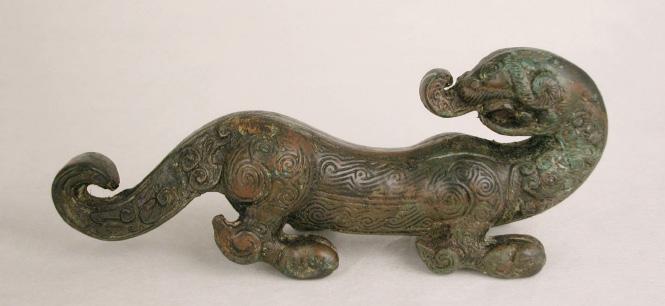
Provenance: Sotheby’s London, 1995. Friedrich Georg Zeileis, acquired from the above, according to his publication, Von Shang bis QingDreieinhalb Jahrtausende Chinesischer Bronze (From Shang to Qing – Three and a Half Millenia of Chinese Bronze), 1999, page 318, no. 118. Dr. Friedrich Georg Zeileis (b. 1939) is a retired physician who built an important collection of ancient Chinese jades and bronzes. He was also a pianist and composer, and published several books, as well as catalogs of his substantial art collections, including fine Chinese jades and bronzes.
Condition: Remarkably well preserved, commensurate with age. Extensive wear, minor losses, some nicks, scratches, signs of weathering and erosion, soil encrustations. Fine naturally grown patina overall, with small areas of faint cuprite and various shades of malachite green.
Weight: 288.2 g
Dimensions: Length 16 cm
LITERATURE COMPARISON
Compare a near identical bronze in the form of a dragon, 16.2 cm long, in the collection of the Arthur M. Sackler Gallery in the National Museum of Asian Art, Smithsonian Institution, accession number S2012.9.2118.
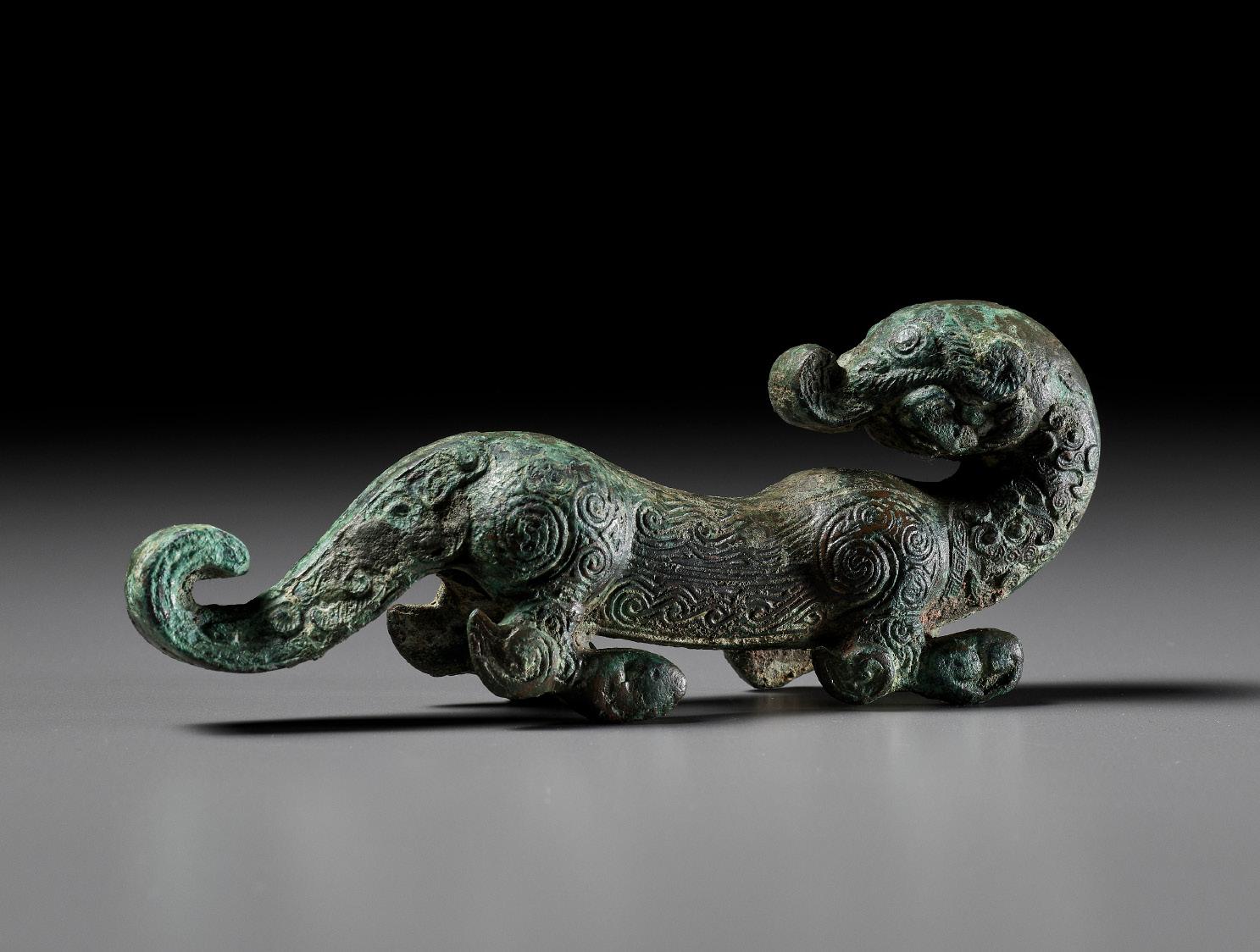
Auction result comparison:
Type: Closely related
Auction: Sotheby’s Hong Kong, 28 July 2022, lot 3031

Price: HKD 352,800 or approx. EUR 41,500 converted at the time of writing
Description: A rare bronze figure of a winged tiger, Eastern Zhou dynasty
Expert remark: Note the much smaller size (11 cm)
Auction result comparison:
Type: Closely related
Auction: Christie’s New York, 22 March 2013, lot 1233
Price: USD 62,500 or approx. EUR 72,500 converted at the time of writing
Description: A Very Rare Bronze Tiger-Form Applique, Late Eastern Zhou Dynasty, 5th-4th Century BC

Expert remark: Note the much smaller size (11.1 cm)
Estimate EUR 20,000
Starting price EUR 10,000
210
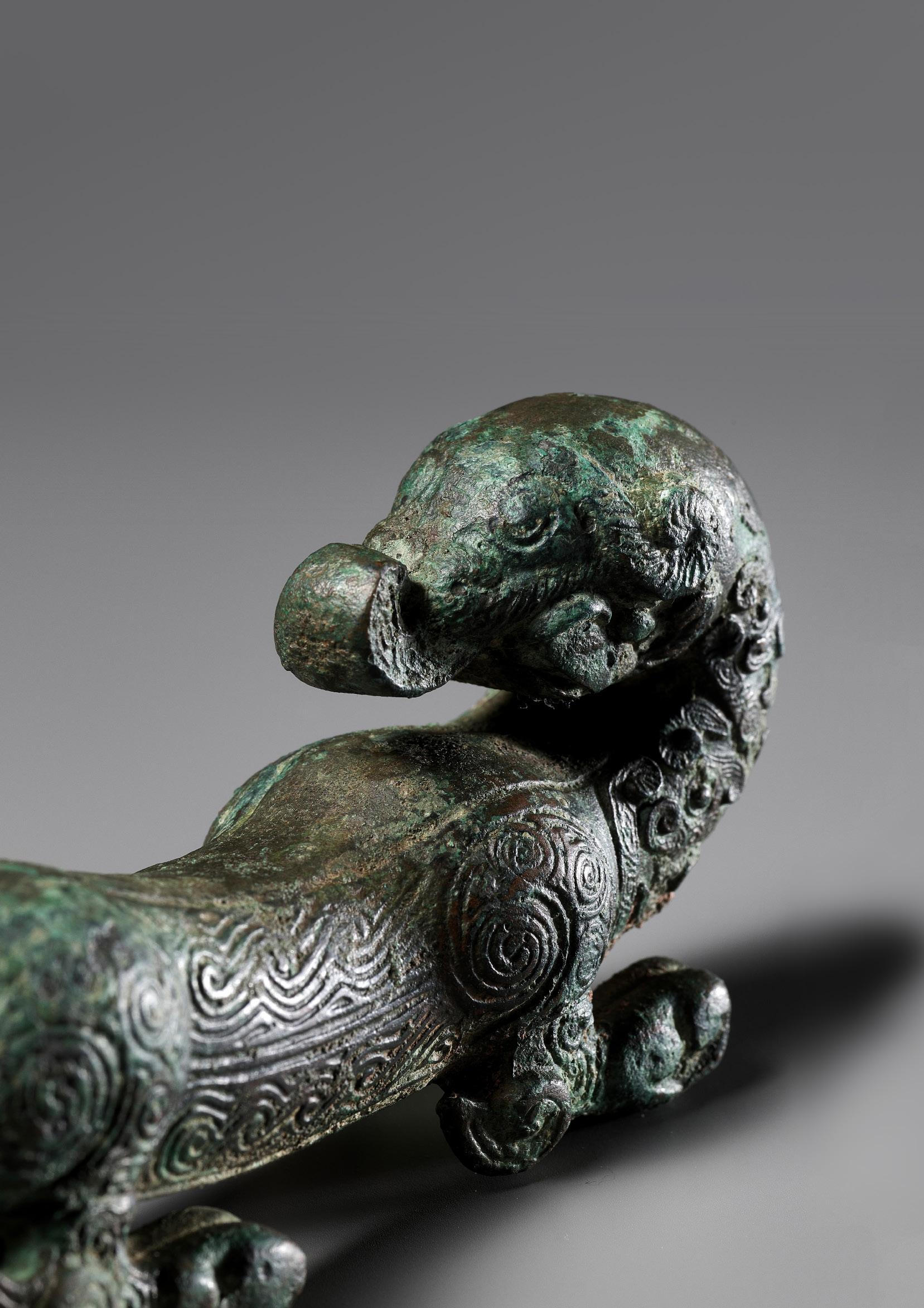
A RARE BRONZE WINE JAR, HU, EASTERN HAN DYNASTY
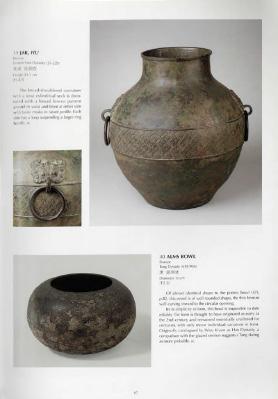
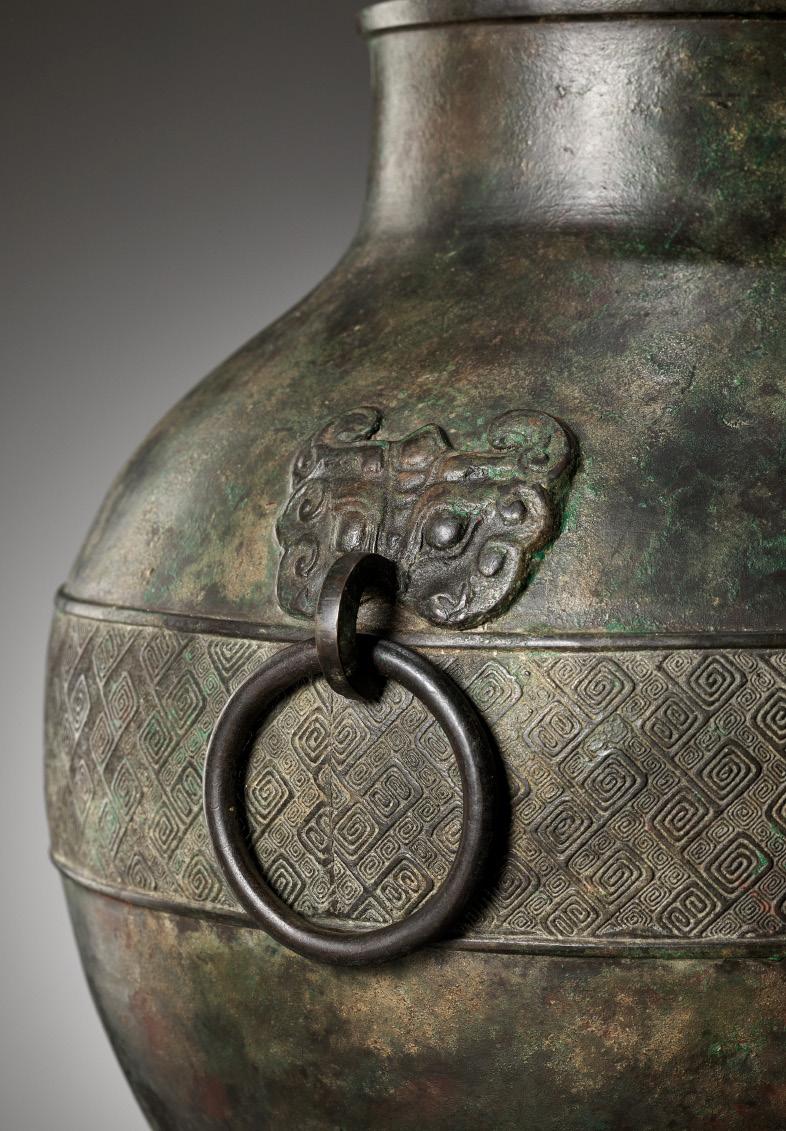
China, 25-220 AD. The globular body supported on a short foot and rising to a stout cylindrical neck with galleried rim, finely cast with a broad leiwen band encircling the waist, applied with two taotie masks in high relief, each with a loop handle suspending a loose ring. The bronze with a superb, naturally grown, rich patina with malachite and cuprite encrustations.
Provenance: Sotheby’s London, 24 June 1958, lot 91 (dated to the Six Dynasties period). Dr. Wou Kiuan, acquired from the above. Wou Lien-Pai Museum, coll. no. H.4.2. A copy of the catalog entry for the present lot from Sotheby’s London, 24 June 1958, lot 91, noting the buyer “Wou” and a purchase price of forty-six British pounds, approximately two months’ salary at the time, accompanies this lot. Dr. Wou Kiuan (1910-1997) was a Chinese diplomat and noted scholar of Chinese art. His father, Wou Lien-Pai (1873-1944), was one the leading political figures of early 20th century China, remembered for his role as speaker and leader of parliament during the turbulent years of the Republican era. Dr. Wou himself embarked on an illustrious career in diplomacy until his retirement in 1952, when he settled in London and devoted the rest of his life to the study of Chinese art. It was no doubt fortuitous that Dr. Wou’s years of collecting coincided with an abundant availability of exceptional Chinese art on the London market. From the mid-1950s to the late 1960s he was able to form a collection of well over 1,000 works that together represented virtually every category of Chinese art. At the heart of Dr. Wou’s drive to collect was a burning desire to preserve the relics of China’s rich historical past scattered across Europe, and to promote Chinese art and culture. It is unclear when Dr. Wou conceived of the idea to create a place to house his collection, but in 1968 he opened the doors to the Wou Lien-Pai Museum, named in honor of his father. Over the years the Museum became a ‘must see’ destination for collectors, academics, and visiting dignitaries, and Dr. Wou would delight in leading his visitors through the galleries, recounting stories of China’s glorious history.


Condition: Excellent condition, commensurate with age. Expected old wear, minor dents and losses, casting flaws, encrustations, signs of weathering and erosion, one loop handle with a small crack, all exactly as expected from a bronze that is 2,000 years old.
Weight: 5,664 g
Dimensions: Height 34.3 cm

Estimate EUR 6,000
Starting price EUR 3,000

212 144
Dr. Wou Kiuan, Paris, November 1939
Published: Rose Kerr et al., Chinese Antiquities from the Wou Kiuan Collection, page 67, no. 39.

145
AN OVAL BRONZE FOLDING OIL LAMP, DENG, HAN DYNASTY
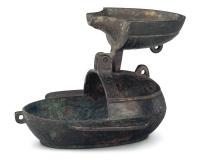
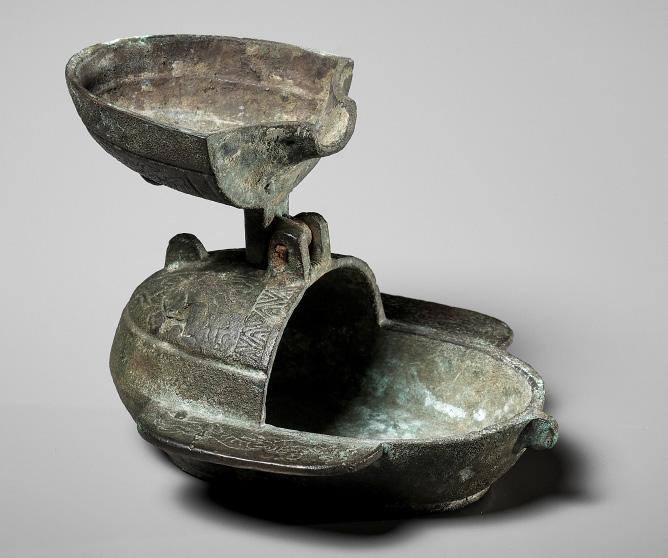
China, 206 BC to 220 AD. The lamp is made in the shape of an ear cup and raised on a narrow foot ring. One side of the cover is hinged and has a spout at one end and a pricket on the interior. The cover is divided into quadrants cast with dragons and tigers separated by a central panel with inscriptions and set with tiny loops similar to a third at one end of the lamp. The dragon and tiger motifs are repeated on the handles.

Inscriptions: To the central panel, ‘[…] zi ji’.
Provenance: Guy Portier, Paris, France, 22 February 1969. Dr. Wou Kiuan, acquired from the above. Wou Lien-Pai Museum, coll. no. H.1.1. Guy Portier (1919-2005) was an important French auctioneer and Asian art expert. His father André specialized in the import of silk from the Far East and later served as an expert in the sales of major French collections of Asian art. Guy was in charge of the silk department of the family company until he took over in 1942, gradually focusing on Far Eastern works of art, Japanese prints being one of his passions. In 1967, he included a list of estimates for the objects put up for sale in one of his catalogs for the first time, back in these days a revolutionary change. The family company, Cabinet Portier, still exists to this day. Dr. Wou Kiuan (1910-1997) was a Chinese diplomat and noted scholar of Chinese art.


Condition: Very good condition, commensurate with age. Extensive wear, minor losses, signs of weathering and erosion, small nicks, light scratches. Fine, naturally grown, rich patina with malachite and cuprite encrustations.
Weight: 287.6 g
Dimensions: Length 10 cm
Dr. Wou’s immense passion and superior knowledge sometimes allowed him to pick up unusual and exquisite Chinese works of art with rare inscriptions, right under the noses of the most experienced dealers and collectors of his days, simply because most of them were unable to read Chinese. The present lot is yet another testimonial to this fact.
LITERATURE COMPARISON
A closely related bronze oil lamp, also dated to the Han dynasty, is illustrated in Bronze Articles for Daily Use: The Complete Treasures of the Palace Museum, Hong Kong, 2006, no. 90 (fig. 1). It is inscribed yi zi sun ji (‘blessings for future generations’) in the center panel of the cover. Note that two of these characters (‘zi’ and ‘ji’) are also found on the present lot. A closely related bronze oil lamp, 13 cm long, also dated to the Han dynasty, is in the Art Institute of Chicago, reference number 1930.907, illustrated by C.F. Kelley and Chen Mengjia in Chinese Bronzes from the Buckingham Collection, 1946, p. 199, pl. LXIX.
AUCTION RESULT COMPARISON
Type: Near-identical
Auction: Christie’s New York, 22 March 2013, lot 1245
Price: USD 30,000 or approx. EUR 36,000 converted and adjusted for inflation at the time of writing
Description: A small bronze oval oil lamp, Han dynasty Expert remark: Compare the near-identical form, decorations, and size (10.2 cm). Note that the oil lamp is inscribed yi zi sun ji (‘blessings for future generations’) in the center panel of the cover, with two of these characters (‘zi’ and ‘ji’) also found on the present lot.
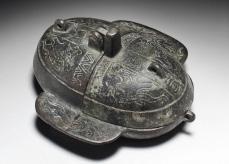
Estimate EUR 4,000
Starting price EUR 2,000
214
fig. 1
Dr. Wou Kiuan, Paris, November 1939
Guy Portier and his son Thierry during the viewing of the Le Véel auction in 1979
146
A TRANSLUCENT AQUAMARINE GLASS ‘COSMIC EGG’, HAN DYNASTY

China, 202 BC to 220 AD. The ritual object of ovoid form, the deep-blue glass of high translucency.
Provenance: Paolo Bertuzzi (1943-2022), who was a fashion stylist from Bologna, Italy. He was the son of Enrichetta Bertuzzi, founder of Hettabretz, a noted Italian fashion company with customers such as the Rothschild family, Audrey Hepburn, and Elizabeth Taylor. Paolo Bertuzzi later took over his mother’s business and designed exclusive pieces, some of which were exhibited in the Costume Institute of the Metropolitan Museum in New York, USA. He was also an avid collector of antiques for more than 60 years. His collection includes both archaic and contemporary art, and he edited two important books about Asian art, Goa Made - An Archaeological Discovery, about a large-scale archaeological project carried out with the Italian and Indonesian governments, and Majapahit, Masterpieces from a Forgotten Kingdom.

Condition: Good condition, commensurate with age. Extensive wear, small losses, nicks, scratches, cracks, extensive signs of weathering and erosion. Displaying remarkably well overall.
Weight: 852.2 g
Dimensions: Height 9.5 cm
In Chinese history, glass played a peripheral role in arts and crafts when compared to ceramics and metal work. The limited archaeological distribution and use of glass objects are evidence of the rarity of the material. Literary sources date the first manufacture of glass to the 5th century AD. However, the earliest archaeological evidence for glass manufacture in China comes from the Warring States period. The Chinese learned to manufacture glass comparatively later than the Mesopotamians, Egyptians and Indians. Imported glass objects first reached China during the late Spring and Autumn and early Warring States periods, c. early 5th century BC, in the form of polychrome ‘eye beads’. These imports created the impetus for the production of indigenous glass beads. During the Han dynasty, the use of glass diversified. The introduction of glass casting in this period encouraged the production of molded objects, such as bi disks and other ritual objects.
The cosmic egg is a mythological motif found in the cosmogonies of the Proto-Indo-European culture and several other major civilizations. Typically, the world egg is a beginning of some sort, and the universe or some primordial being comes into existence by “hatching” from the egg, sometimes lain on the primordial waters of the Earth. Eggs symbolize the unification of two complementary principles (represented by the egg white and the yolk) from which life or existence, in its most fundamental philosophical sense, emerges.
In the myth of Pangu, developed by Taoist monks hundreds of years after Lao Zi, the universe began as an egg that symbolizes the primordial state of Taiji. A primeval hermaphroditic giant named Pangu, born inside the egg, broke it into two halves: the upper half became the sky, while the lower half became the earth. As the god grew taller, the sky and the earth grew thicker and were separated further. Finally Pangu died and his body parts became the sun, moon, different parts of the earth and living things. The first writer to record the myth of Pangu was Xu Zheng during the Three Kingdoms period. Recently his name was found in a tomb dated AD 156, during the later Han period
LITERATURE COMPARISON
Compare a related “glob” of glass, 3.5 cm high, in the collection of the Arthur M. Sackler Gallery in the National Museum of Asian Art, Smithsonian Institution, accession number S2012.9.698 (fig. 1). Compare a related glass bi disk, 17.8 cm diameter, dated to the Western Han dynasty, in the Metropolitan Museum of Art, accession number 2006.404. Compare a glass bowl, 8.3 cm diameter, dated to the Western Han dynasty, excavated from Tomb 70 at Wenchangta, Hepu county, Guangxi, 1987, lent by the Guangxi Zhuang Autonomous Region Museum, exhibited in The Metropolitan Museum of Art, Age of Empires: Chinese Art of the Qin and Han Dynasties, 3 April to 16 July 2017.
AUCTION RESULT COMPARISON
Type: Related
Auction: Galerie Zacke, Vienna, 5 March 2021, lot 48
Price: EUR 7,584 or approx. EUR 8,600 adjusted for inflation at the time of writing
Description: An aquamarine green glass bi disk, Han dynasty Expert remark: Note the size (14.3 cm)

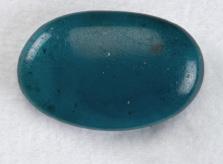
AUCTION RESULT COMPARISON
Type: Remotely related
Auction: Christie’s Hong Kong, 1 December 2010, lot 2902
Price: HKD 620,000 or approx. EUR 108,000 converted and adjusted for inflation at the time of writing
fig. 1
Description: A very rare early translucent aqua glass cup, Han dynasty Expert remark: Note the diameter (7.7 cm)

Estimate EUR 4,000
Starting price EUR 2,000
Paolo Bertuzzi (1943-2022)
A GOLD AND SILVER-INLAID BRONZE ARCHAISTIC STEAMER, SONG TO MING DYNASTY

China, 960-1644. Heavily cast, the upper cauldron with two upright loop handles to the rim, decorated with interlocking scroll and confronting stylized phoenixes. The sides with three animal masks flanked by confronting phoenixes divided by short flanges, above pendent stiff leaves, all reserved on leiwen grounds. The shoulders of the three legs cast with stylized large-eyed animal masks, decorated with scroll and lozenge designs. The bronze with a rich, solid, naturally grown, dark patina with scattered malachite encrustations.
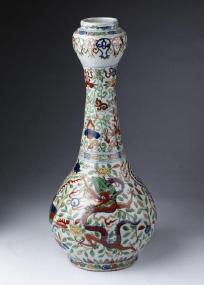
Provenance: From the personal collection of Dr. David McCay, and thence by descent in the same family. Dr. David McCay was an English physician and later surgeon general with the Indian Medical Service in Bengal, India. He was sent to China during the Boxer Rebellion and served as an army doctor at the Siege of Peking. While in India, he wrote a book titled Investigations on Bengal Jail Dietaries. Upon his retirement, he returned to England with his collection of Chinese bronzes, cloisonné, and porcelain. After his death, his wife gifted his favorite piece, a highly important Wanli garlic mouth vase, among other items, to the Victoria and Albert Museum, accession number CIRC.231950, where it remains to this day.
Condition: Very good condition with expected old wear, traces of age and usage, some casting irregularities, small nicks and losses, light scratches, the undersides of the feet with tiny old fills. The gold inlays are fresh and in very good condition overall. The silver inlays have darkened over time and show expected tarnish. However, we chose not to clean the silver inlays, so to preserve the piece’s impressive natural appearance.
Weight: 5,200 g
Dimensions: Height 31.5 cm
Referring to the importance of reverence to the past in Chinese art, Ulrich Hausmann writes:
“Archaic bronzes and their inscriptions, the subject of centuries of epigraphic and stylistic studies by literary men and artists, became inseparable, so much so that since that time scholars writing characters have seen at the back of their minds the image of ancient bronze vessels whose rubbings they had carefully studied. Generations of painters and calligraphers [...] spent a lifetime studying these inscriptions. What could be more fitting than to embellish one’s studio with subtle allusions to the magnificent past, or to furnish the ancestral altar with vessels expressing the continuation of their inheritance.” (Quote from Ulrich Hausmann, Later Chinese Bronzes: In Search of Later Bronzes in Documentary Chinese Works of Art: In Scholars’ Taste, Ed. Paul Moss, Sydney L. Moss, London, 1983, page 233, requoted again by Hugh Moss and Gerard Tsang in Arts from the Scholar’s Studio, The Oriental Ceramic Society of Hong Kong and the Fung Ping Shan Museum, University of Hong Kong, 1986, cat. no. 161.)
Expert’s note: The present steamer is quite likely to date from the Song dynasty, because the earliest archaistic bronzes generally tend to be the closest in form and design to their archaic prototypes. This is clearly the case here, as shown by the two literature comparisons below, which prove that the present lot is very much in the spirit of its Shang and Western Zhou paragons. The example from the National Palace Museum, Taipei, even has gold and silver inlays just like our vessel, which is unusual for such an early piece. Another important aspect is the superb, naturally grown patina on the present lot with its distinct malachite encrustations. This is beyond doubt not a patina from the late Ming or early Qing dynasty: It not only does closely resemble that of ancient bronzes, but with its unique appearance, reminiscent of savage elementary forces rather than the genteel creations of later periods, essentially makes this bronze an archaic vessel of its own merit.
LITERATURE COMPARISON
Compare a closely related prototype for this steamer, also with gold and silver inlays, dated to the Shang dynasty, in the National Palace Museum, Taipei, image number K1A002369N000000000PAB. A related prototype, lacking gold and silver inlays, dated to the Western Zhou dynasty, 11th-10th century BC, in the collection of the Arthur M. Sackler Gallery in the National Museum of Asian Art, Smithsonian Institution, accession number S1987.352a-b, is illustrated by Jessica Rawson, Western Zhou Ritual Bronzes from the Arthur M. Sackler Collections, Vol. IIB, Massachusetts, 1990, pp. 342-344, no. 33.
AUCTION RESULT COMPARISON
Type: Related
Auction: Bonhams London, 11 November 2010, lot 139
Price: GBP 31,200 or approx. EUR 49,500 converted and adjusted for inflation at the time of writing
Description: A large archaistic bronze tripod steamer, yan, probably Song dynasty

Expert remark: Compare the closely related form with similar legs cast with animal masks. This steamer is however vastly inferior to the present lot as it lacks the gold and silver inlays and the design is overall less lively. Note the larger size (44.5 cm).
AUCTION RESULT COMPARISON
Type: Related
Auction: Sotheby’s New York, 1 December 2022, lot 694
Price: USD 37,800 or approx. EUR 35,000 converted at the time of writing
Description: An archaistic copper-inlaid bronze tripod censer (Ding), Ming dynasty

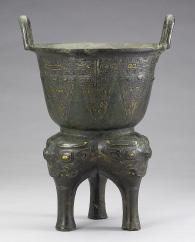

Expert remark: Compare the related form with similar legs cast with animal masks. This censer is however vastly inferior to the present lot, not only because the inlays are merely copper, but also because it completely lacks the cauldron found on the present lot. Also note the significantly smaller size (16.7 cm).

AUCTION RESULT COMPARISON
Type: Related
Auction: Sotheby’s London, 14 May 2014, lot 252
Price: GBP 80,500 or approx. EUR 116,000 converted and adjusted for inflation at the time of writing
Description: An archaistic silver and gold-inlaid bronze wine vessel and cover, you, Ming dynasty
Expert remark: Compare the closely related manner of casting and decorations with similar gold and silver inlays. Note the related size (30.2 cm).
AUCTION RESULT COMPARISON
Type: Related
Auction: Sotheby’s Hong Kong, 8 October 2014, lot 3350
Price: HKD 2,680,000 or approx. EUR 380,000 converted and adjusted for inflation at the time of writing
Description: A large gold and silver-inlaid bronze incense burner, gui, late Ming dynasty
Expert remark: Compare the closely related manner of casting and decorations with similar gold and silver inlays. Note the similar size (28.5 cm).
Estimate EUR 30,000
Starting price EUR 15,000
216 147
The Wanli garlic mouth vase from the collection of Dr. David McCay, gifted by F. H. McCay to the Victoria and Albert Museum
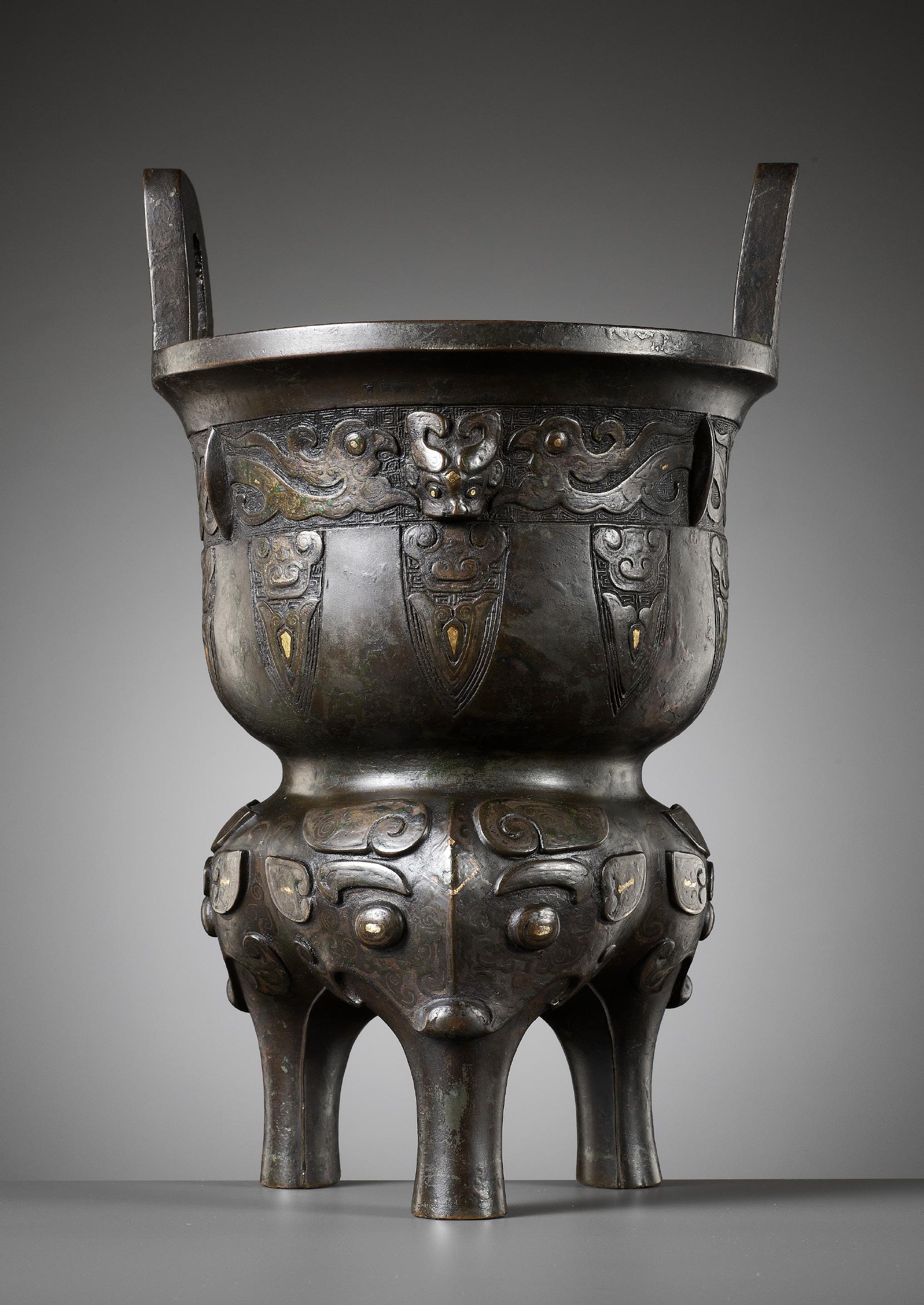
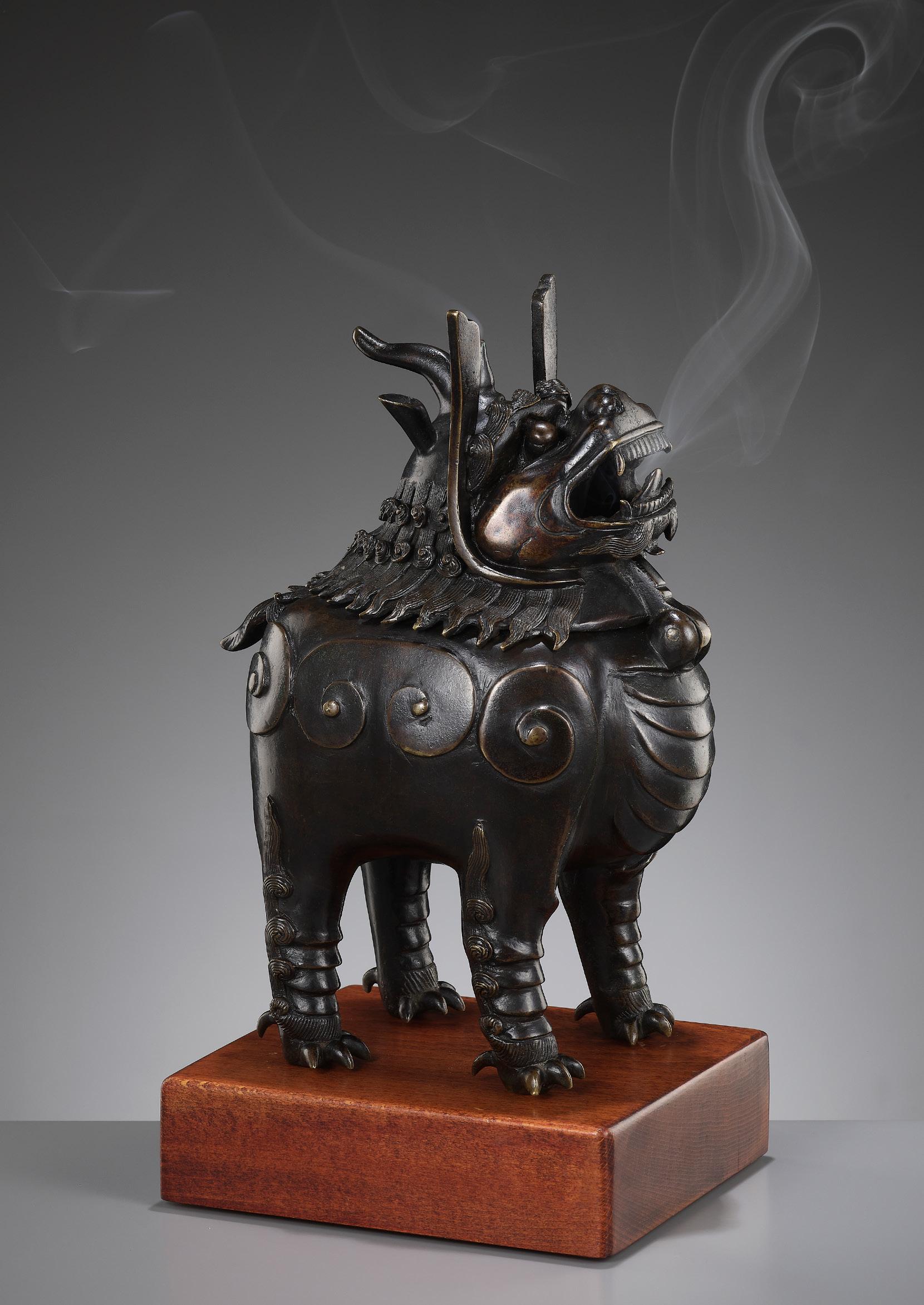
A LUDUAN-FORM BRONZE CENSER, MING DYNASTY
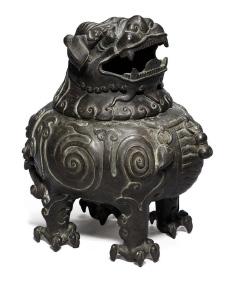
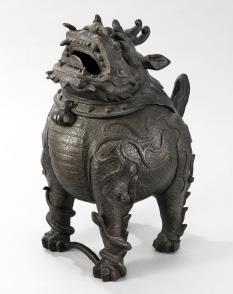
China, 1368-1644. Finely cast standing foursquare, the chest of the hollow body with a long strip of scaling, the sides with swirls and stylized ruyi-heads, flanking a short tail. The hinged cover rendered in the form of a single-horned head with bulging eyes, scrolling mane, and funnel-shaped ears, the mouth wide open revealing tongue and teeth.
Provenance: Galerie Gross, Wiesbaden, Germany, 12 December 1980. An old German private collection, according to the family acquired from the above, and thence by descent.
Condition: Very good condition with expected old wear and casting irregularities. The hinge original and remarkably well-preserved, thus functioning properly. A few minuscule nicks and small dents. Naturally grown, rich and very dark patina overall.
Weight: 4,612 g
Dimensions: Height 30 cm (excl. base, incl. pegs) and 33.5 cm (incl. base)
With an old wood base. (2)
The throne of the Emperor of China in the Hall of Supreme Harmony in the Forbidden City in Beijing has two incense burners shaped as Luduans
The throne of the Emperor of China in the Hall of Supreme Harmony in the Forbidden City in Beijing has two incense burners shaped as luduan, the legendary auspicious creatures who can travel 18,000 li (9,000 km) in a single day and speak all world languages. A legend says that a Luduan once appeared to Genghis Khan and convinced him to abandon his efforts to conquer India.
Luduan are mythical creatures with strong lion bodies, a single horn and the paws of a bear. They are believed to have the ability to foretell the future, give life to the good, and kill the evil. According to legend, they were originally known as ‘jiaoduan’, and their name changed to ‘luduan’ because the character for ‘lu’ matched their appearance better. Known as guardians of enlightened rulers, luduan were said to appear in areas where a wise and virtuous leader was present.
The auspicious nature of luduan was particularly appropriate for the purpose of these censers. Cast with hinged or removable heads, they were made for burning incense and smoke would emerge from the beast’s mouth, animating and empowering the sculpture. As Chuimei Ho and Bennet Bronson note in their discussion of a pair of Qianlong cloisonné enamel examples from the Palace Museum, Beijing, included in the exhibition ‘Splendors of China’s Forbidden City, The Glorious Reign of Emperor Qianlong’ by The Field Museum, Chicago, 2004, these burners were traditionally valued at the Imperial Court, as with their open mouths and smoke billowing forth, they were a reminder to the emperor that he should always be receptive to honest advice (see page 37).
The origin of incense burners of this form is difficult to determine. An example attributed to the Song dynasty was recovered from the Ming dynasty tomb of the scholar-official Zhang Shupei (1552-1615) in Tonglian, Sichuan (Wenwu, 1989, no. 7, pp 45-46, figs 14-16). Mythical beast incense burners, however, became a popular model only from the Xuande period onwards. A censer in the form of a mythological animal was included in the painting ‘Enjoying Antiquities’ by Du Jin (ca. 1467-1505), where two scholars are depicted scrutinizing a selection of antiquities (illustrated in Through the Prism of the Past, Antiquarian Trends in Chinese Art of the 16th to 18th Century, National Palace Museum, Taipei, 2003, catalog no. I-44). A drawing of a similar beast is also published in the Shizu zhai jian pu (Ten Bamboo Studio Catalogue of Letter Paper Designs), a woodblock printed book of stationery papers from 1645, compiled by Hu Zhengyan and illustrated in Ip Yee and Laurence C.S. Tam, Chinese Bamboo Carving, volume 1, Hong Kong, 1978, page 179, figure 15. Its popularity continued well into the Kangxi reign, when censers of this form were made in a variety of media, including porcelain, cloisonné enamel, and bronze.
AUCTION RESULT COMPARISON
Type: Closely related
Auction: Christie’s Hong Kong, 4 April 2017, lot 60
Price: HKD 350,000 or approx. EUR 49,500 converted and adjusted for inflation at the time of writing
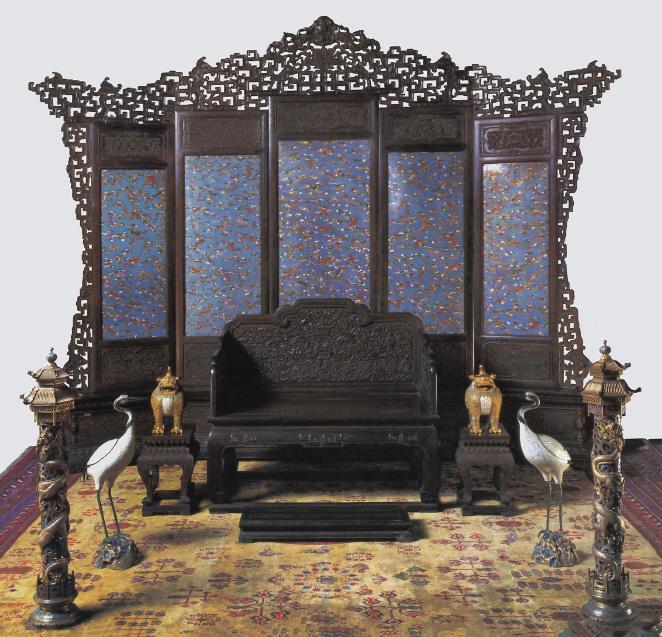
Description: A Rare Bronze Luduan-Form Censer, Yuan-Ming Dynasty (1279-1644)
Expert remark: Note the similar size (35.2 cm)
AUCTION RESULT COMPARISON
Type: Closely related
Auction: Christie’s Hong Kong, 3 June 2015, lot 2870
Price: HKD 275,000 or approx. EUR 40,500 converted and adjusted for inflation at the time of writing
Description: A Bronze Luduan-Form Censer and Cover, Late Ming Dynasty, 17th Century
Expert remark: Note the smaller size (23 cm)
Estimate EUR 6,000
Starting price EUR 3,000
219 148
149
A
MASSIVE AND LARGE ARCHAISTIC BRONZE VASE AND COVER, FANGHU, MING DYNASTY

China, 1368-1644. Heavily cast, of rounded square section, the baluster body supported on a tall spreading foot, the shoulder and neck applied with phoenix-form handles, the sides and edges with narrow flanges. The body decorated with taotie masks below a band of kui dragons, the shoulder with a band of pendent stiff leaves below further taotie masks to the neck, the foot with taotie masks flanked by ruyi-cross designs, all against diapered key-fret grounds. The similarly decorated cover surmounted by a large finial.
Expert’s note: The present archaistic bronze vase is exceptional for its massive size, which makes it exceedingly rare.
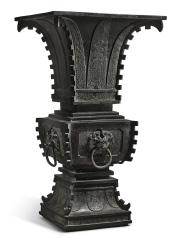
Provenance: From the estate of Anthony Powell, London, United Kingdom. Anthony Powell (1935-2021) was a British costume designer who brought deep research to his work in both theater and film. His costume designs for John Gielgud’s production of The School for Scandal (1963) earned him a Tony Award. Powell collaborated on movies with Steven Spielberg and Roman Polanski and won three Academy Awards for Best Costume Design, including 1978’s Death on the Nile. He was an avid collector of fabrics and trimmings as well as Chinese, Indian, and Southeast Asian works of art.
Condition: Good condition with expected old wear, traces of use, shallow surface scratches and casting flaws. Some nicks and dents, minor losses, the lower body on the backside with obvious cracks. Naturally grown dark patina overall.
Weight: 20.4 kg
Dimensions: Height 74 cm
AUCTION RESULT COMPARISON
Type: Related
Auction: Sotheby’s New York, 11 September 2019, lot 805
Price: USD 27,500 or approx. EUR 30,000 converted and adjusted for inflation at the time of writing
Description: A massive bronze beaker vase, Ming dynasty
Expert remark: Compare the archaistic design and diapered key-fret grounds. Note the size (64.8 cm).
Estimate EUR 10,000
Starting price EUR 5,000

220
Anthony Powell (19352021), holding one of his designs for the Steven Spielberg film Hook (1991)
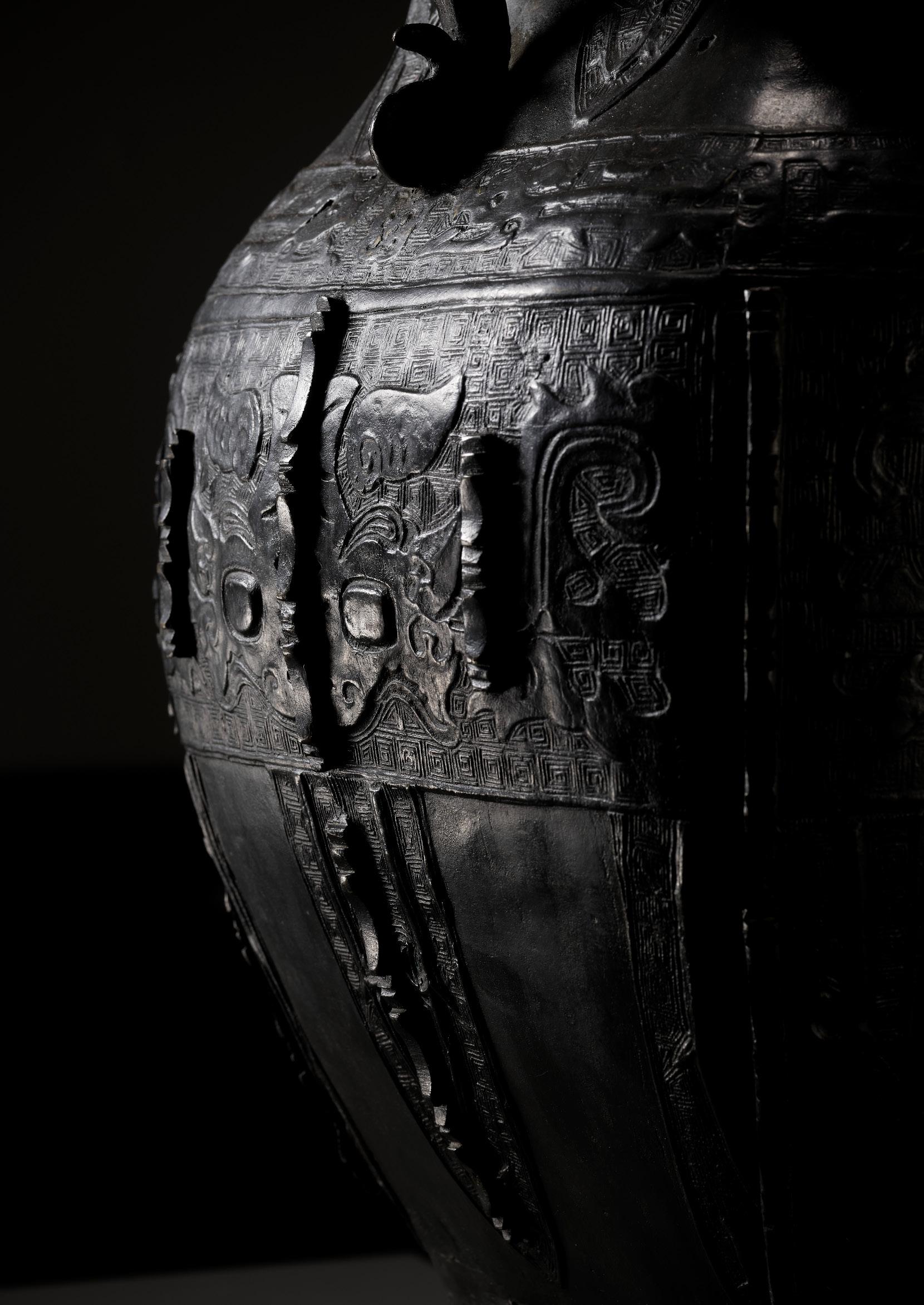
A LARGE BRONZE ‘CHILONG’ FOUR-TUBE ARROW VASE, TOUHU, YUAN TO MING DYNASTY



China, 1279-1644. Heavily cast with a compressed globular body rising from a stepped foot and surmounted by a tall slender cylindrical neck, with four tubular rings surrounding the mouth. The body cast in relief with two beast masks suspending loose rings flanked by qilin and short flanges, the neck similarly cast with two chilong dragons. The foot and base of the neck decorated with archaistic motifs.
Provenance: Swedish trade.
Condition: Good condition with minor wear and casting irregularities, few minuscule nicks and dents here and there. The body and neck cast separately and joined together, with the neck being somewhat loosened. Excellent, naturally grown patina overall.
Weight: 10 kg
Dimensions: Height 58.5 cm
Vases such as the present lot were designed for the ancient Chinese game of touhu, or ‘arrow-throwing’, which would form part of the entertainment at banquets and is mentioned in early classical texts such as the Chunqiu Zuo Zhuan attributed to Zuoqiu Ming (c.556-451 BC). Contestants would aim feathered arrows at the various cylinders applied to the vase, with higher points awarded for the less accessible openings. The loser was made to drink wine, leading to increased inebriation and diminished throwing accuracy.
Literature comparison: See a related bronze arrow vase, dated as first half 17th century, illustrated in The Chinese Scholar’s Studio: Artistic Life in the Late Ming Period, New York, 1987, no. 63. For a similar example, see Chinesische Kunstgeschichte von Oskar Münsterberg, Esslingen, 1910, p. 136.
AUCTION RESULT COMPARISON
Type: Related
Auction: Bonhams Hong Kong, 29 May 2022, lot 43
Price: HKD 318,000 or approx. EUR 37,000 converted at the time of writing
Description: A rare and large ‘eighttube’ ‘eight immortals’ arrow vase, touhu, Ming dynasty
Expert remark: Compare the related form, manner of casting, and size (55 cm). Note the vase also has four tubes to the neck around the mouth, although unlike the present lot there are also four additional tubes around the body.
AUCTION RESULT COMPARISON
Type: Related
Auction: Bonhams London, 6 November 2014, lot 388
Price: GBP 18,750 or approx. EUR 27,000 converted and adjusted for inflation at the time of writing
Description: A large and unusual bronze ‘arrow’ vase, touhu, Ming dynasty
Expert remark: Compare the related form, manner of casting, chilong decoration, and size (55 cm). Note the vase also has four tubes to the neck around the mouth, although unlike the present lot two of them are slanted and there are also four additional tubes around the body.
Estimate EUR 6,000
Starting price EUR 3,000
150
A GOLD AND SILVER-INLAID BRONZE HU-FORM ARCHAISTIC VASE, 18TH CENTURY
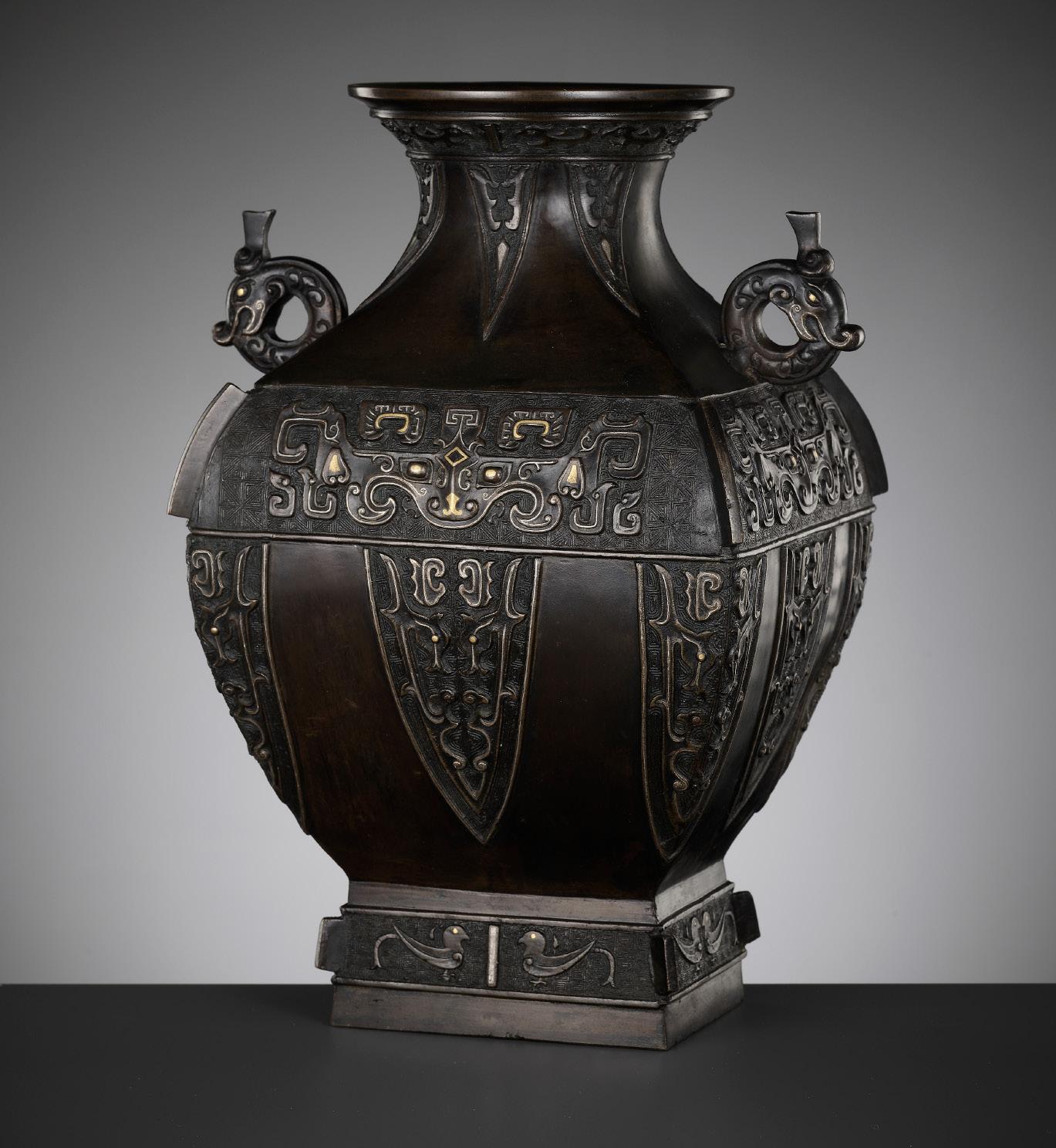

China. Well cast, the square baluster body supported on a tall spreading foot and rising to a waisted neck with a circular mouth, the shoulder flanked by two dragon-form loop handles. Finely decorated to the body with a band of taotie masks above pendent stiff leaves with confronting dragon designs, to the foot with a band of confronting dragons, and to the neck with a band of dragons above pendent stiff leaves with confronting beasts, all divided by flanges and reserved against leiwen grounds.
Provenance:
Lempertz, Cologne, 2 June 1981, lot 989. An old German private collection, acquired from the above, and thence by descent in the same family.
Condition: Excellent condition with minor old wear, traces of use, minuscule nicks and scratches, and some casting irregularities, the base plate reattached some time ago.
Weight: 4,192 g
Dimensions: Height 34.5 cm

AUCTION RESULT COMPARISON
Type: Related
Auction: Sotheby’s London, 6 November 2019, lot 120
Estimate: GBP 15,000 or approx. EUR 19,500 converted and adjusted for inflation at the time of writing
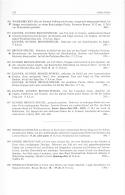
Description: A Large Gold and Silver-Inlaid Bronze Archaistic Vase Qing Dynasty, 17th/18th Century
Expert remark: Compare the related style and manner of casting, form, and inlay work. Note the larger size (48 cm).

Estimate EUR 6,000
Starting price EUR 3,000

151
A RARE GILT-SPLASHED BRONZE ‘THREE HARES’ CENSER, 17TH-18TH CENTURY
China. Heavily cast, supported on three short feet, of compressed globular form with three hare’s heads, each flanked with two long ears and neatly incised with almond shaped eyes, a curling mouth, and fur framing the neck, the exterior finely embellished with irregular gilt splashes.

Provenance: Wiltshire, United Kingdom, local trade. By repute acquired from a private estate.
Condition: Good condition with old wear and casting flaws as expected, remnants of ancient varnish, few small nicks and dents, light scratches. An old circular fill to the top side, probably inherent to manufacture. Naturally grown patina overall.
Weight: 1,044 g
Dimensions: Length 16.7 cm
The three hares is a circular motif appearing in sacred sites in East Asia, the Middle East, and Europe. It has been used as an architectural ornament, a religious symbol, and in modern works of art. The three hares first appear in the Mogao Caves in Dunhuang, but over the centuries the iconography slowly spread towards the
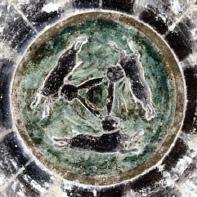
The Three Hares, Mogao Cave 407, Sui dynasty (581–618)
Window of the ‘Three Hares’, Paderborn Cathedral, 13th century
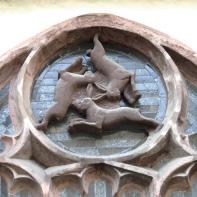
West. They next appear on early 13th-century Mongol metalwork, and on a copper coin, found in Iran, dated to 1281. Then they are found again on a 14th-century box, later used as a reliquary, made in Iran under Mongol rule, and now preserved in the treasury of the Cathedral of Trier in Germany. On its base, the casket has Islamic designs, and originally featured two images of the three hares, one later lost through damage. Thereafter, it eventually occurs with the greatest frequency in the churches of Devon, England, where it appears to be a recollection of earlier Insular design, such as the Romano-British designs which are known from Celtic (La Tène) metalwork. The main theory pertaining to the dissemination of the motif is that it was transported from China across Asia and as far as the southwest of England via designs found on expensive Oriental ceramics by merchants traveling the Silk Road. According to researchers, the ‘three hares’ is an auspicious symbol that represents peace and tranquility.
AUCTION RESULT COMPARISON
Type: Closely related
Auction: Christie’s Hong Kong, 6 April 2015, lot 155
Price: HKD 425,000 or approx. EUR 59,500 converted and adjusted for inflation at the time of writing
Description: A gilt-splashed bronze censer, Qing dynasty, 18th century Expert remark: Compare the related form, gilt splashes, zoomorphic design, and size (16.8 cm). Note the apocryphal Xuande mark.

Estimate EUR 4,000
Starting price EUR 2,000
224 152
153
A BRONZE ‘DUCK’ CENSER AND COVER, MING DYNASTY
China, 1368-1644. Modeled standing on one of its webbed feet, the other raised, the curved neck supporting its upwards turned head, detailed with a long opened beak and plumage, the upper body forming the cover, with three openings at the beak and plumage, mounted to a rectangular wood stand.
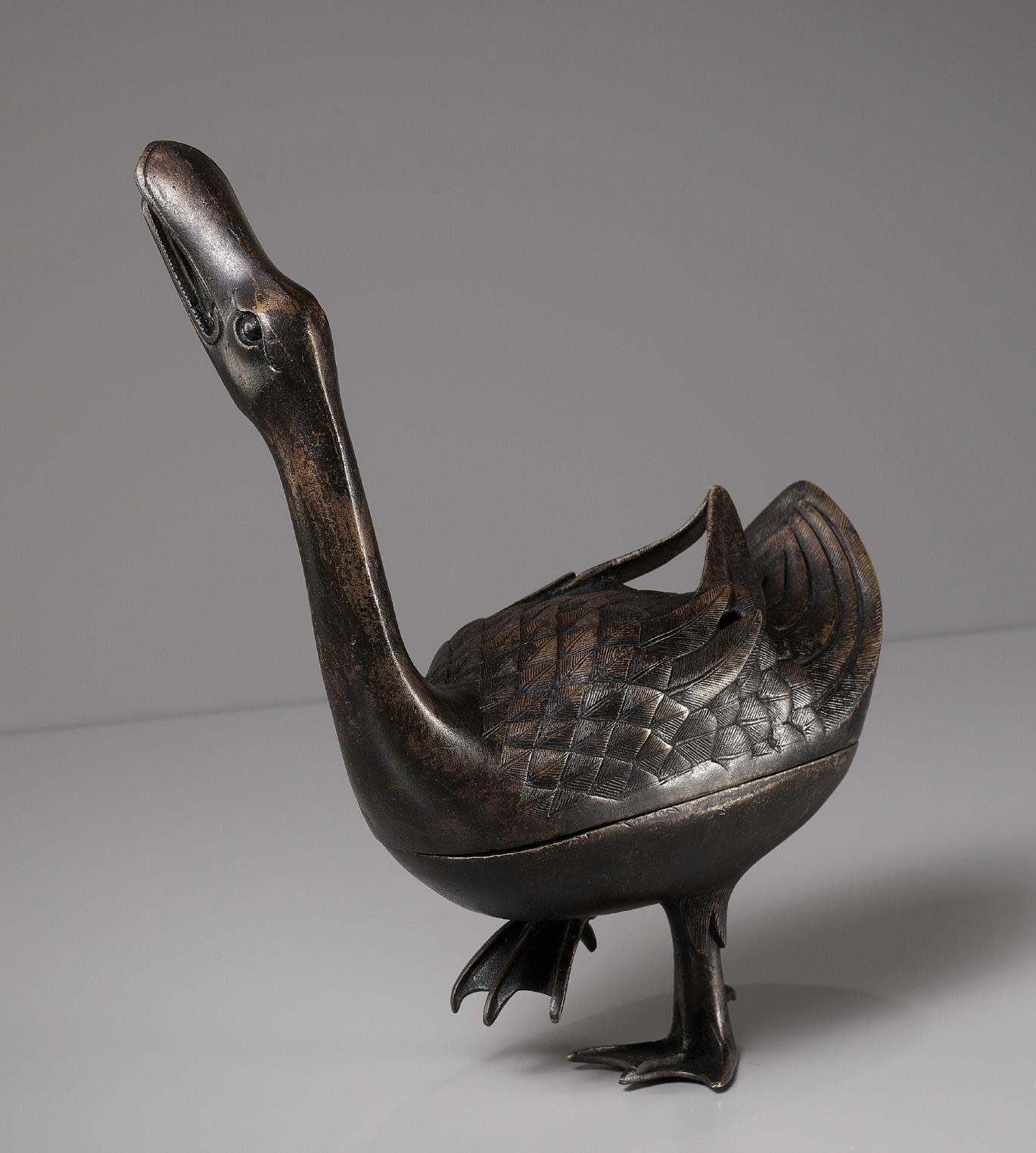
Provenance: From the collection of a gentleman in London, United Kingdom, who has been collecting Asian works of art for the last 50 years, and thence by descent. The base with an old label, ‘Antique Ming dynasty bronze incense burner 17th c.’.
Condition: Very good condition with minor wear, few small nicks, light surface scratches, and casting flaws.
Weight: 1,164 g (excl. stand), 1,511 g (incl. stand)
Dimensions: 26.4 cm (excl. stand), 31.8 cm (incl. stand)
With a modern, fitted wood stand. (2)
AUCTION RESULT COMPARISON
Type: Related
Auction: Bonhams London, 10 May 2021, lot 303
Price: GBP 7,012 or approx. EUR 9,200 converted and adjusted for inflation at the time of writing
Description: A bronze mandarin duck form incense burner and cover, Ming dynasty
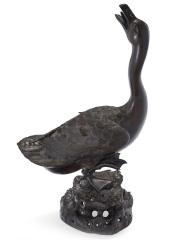
Expert remark: Compare the related form of the beak, plumage, and feet. Note the smaller size (21 cm).
AUCTION RESULT COMPARISON
Type: Related
Auction: Christie’s New York, 29 June 2021, lot 99
Price: USD 25,000 or approx. EUR 26,000 converted and adjusted for inflation at the time of writing
Description: A bronze duck-form censer and cover, late Ming dynasty, 17th century

Expert remark: Compare the related form, pose, and plumage. Note the larger size (44.8 cm) and rockwork base.
Estimate EUR 3,000
Starting price EUR 1,500
225
AN INLAID BRONZE ‘ELEPHANT’ TRIPOD CENSER AND OPENWORK COVER, 18TH CENTURY

China. Heavily cast, the censer is decorated in relief with lotus scrolls flanked by a pair of handles in the form of caparisoned elephant heads with their trunks raised, supported on three further elephant heads, their curved trunks forming the legs. The openwork cover is pierced with lotus scrolls surrounding the finial cast as a recumbent elephant with an urn on its back filled with auspicious and precious objects including a conch, ingot, the Three Jewels, and a cash coin. The censer is embellished with inlays of pearl, glass, and semiprecious stones. The base cast with a lotus knop.
Provenance: From a Danish private collection and thence by descent. The underside with faint remnants of an old collector’s inscription. Condition: Very good condition with old wear, traces of use and casting irregularities, some losses to inlays, the handles slightly loose. Fine, naturally grown, rich patina.
Weight: 3,577 g
Dimensions: Height 31 cm
Expert’s note: The fine inlays of pearl, glass, and semiprecious stones strongly indicate an imperial connection to this censer, which also compares favorably to Qianlong-marked examples, see for example Christie’s Hong Kong, 29 May 2019, lot 3115.
Literature comparison: The tradition of using three elephant heads as the feet of imperial bronze censers and braziers can be traced back at least as far as the Xuande reign (1426-1435). An example of a censer, bearing a six-character Xuande reign mark, on which the elephants balance on their rolled trunks, as on the present lot, is in the collection of the National Palace Museum, Taipei, and illustrated in A Special Exhibition of Incense Burners and Perfumers Throughout the Dynasties, Taipei, 1994, p. 199, no. 54.
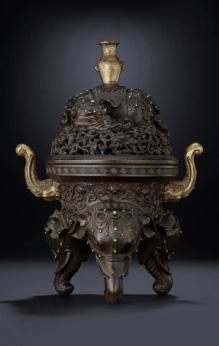
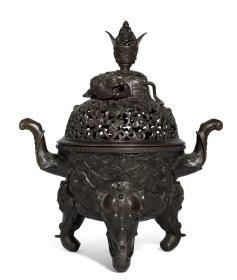
AUCTION RESULT COMPARISON
Type: Closely related
Auction: Christie’s Hong Kong, 30 May 2012, lot 4128
Price: HKD 524,000 or approx. EUR 82,000 converted and adjusted for inflation at the time of writing
Description: A bronze ‘elephant’ tripod censer and openwork cover, Qing dynasty, 18th century Expert remark: Compare the closely related form, decoration, and inlays, as well as the related size (33.6 cm). Note the gilt handles and finial, which may possibly be of a later date.
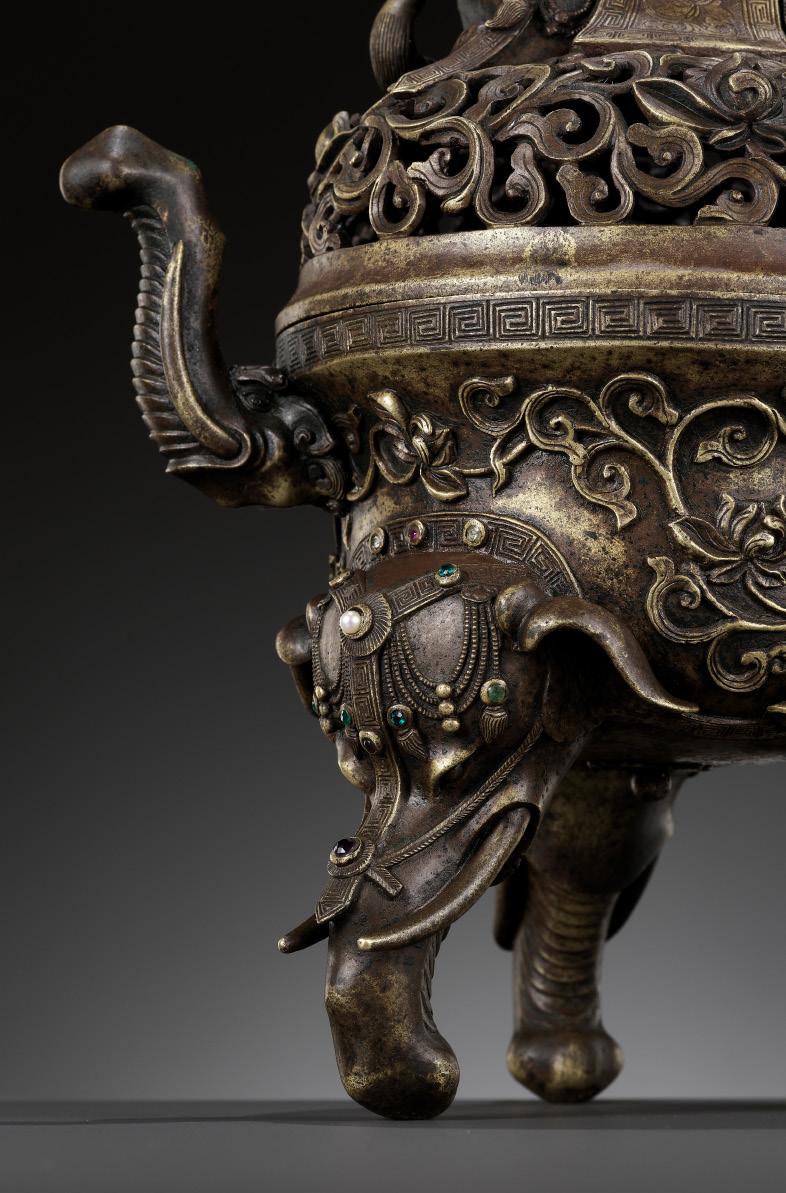
AUCTION RESULT COMPARISON
Type: Closely related
Auction: Bonhams San Francisco, 24 June 2013, lot 1119
Price: USD 92,500 or approx. EUR 107,000 converted and adjusted for inflation at the time of writing
Description: A large bronze tripod censer and cover, Qianlong period
Expert remark: Compare the closely related form, decoration, and inlays. Note the apocryphal dating inscription (corresponding to 1651) as well as the larger size (51.5 cm).
Estimate EUR 10,000
Starting price EUR 5,000
226 154

A LARGE GILT-BRONZE FIGURE OF AVALOKITESHVARA, SUI DYNASTY, CHINA, 581-618


Published: Friedrich Georg Zeileis, Von Shang bis Qing - Dreieinhalb Jahrtausende Chinesischer Bronze (From Shang to Qing – Three and a Half Millenia of Chinese Bronze), 1999, pages 372-373, no. 153.
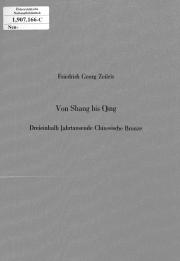


Standing in tribhanga atop an elaborate lotus base, composed of two petaled sections framing an open worked foliate design, all above a tiered pedestal with faceted sides that rises from a separately cast rectangular four-legged stand with open sides.
His lowered right hand holds a water vessel while his left hand is raised. He is wearing a long flowing robe with billowing scarves and is adorned with fine jewelry. A flaming mandorla with pierced circular floral nimbus is affixed to the back of the head.
The bronze with a superb, solid, naturally grown, rich patina with malachite and cuprite encrustation overall.
Provenance: A noted private collection in New York, USA. E & J Frankel Ltd., New York, early 1990s. Friedrich Georg Zeileis, acquired from the above, according to his publication. E & J Frankel was a major New York gallery specializing in Asian Art since 1967. Run by Edith (1939-2012) and Joel Frankel (1937-2018), it was one of the oldest galleries in the United States focusing exclusively on Asian art. Leaders in their field, the Frankels traveled the world in search of Asian art treasures and educated the general public about their shared passion. Their gallery on Madison Avenue in New York City became a local institution, best known for its regular schedule of innovative thematic exhibitions, and frequently visited by the biggest names in the field, such as Eskenazi, Ellsworth, Junkunc, and the Alsdorfs. Dr. Friedrich Georg Zeileis (b. 1939) is a retired physician who built an important collection of ancient Chinese jades and bronzes. He was also a pianist and composer, and published several books, as well as catalogs of his substantial art collections, including fine Chinese jades and bronzes. Condition: Good condition, commensurate with age. Extensive wear, minor losses, nicks, scratches, signs of weathering and erosion, encrustations, corrosion. Minor old repairs. Remarkably well preserved, especially the gilt.
Weight: 251.4 g
Dimensions: Height 21.2 cm

The unifying but brief Sui dynasty (581-618) set the stage for an artistic and cultural renaissance that reached its zenith in the succeeding Tang dynasty (618-907). Characteristics of Sui period bronze figures of bodhisattvas include subtly swaying, elongated columnar bodies that are adorned in elaborate robes and jewelry. The artisan of the present figure employed a subtle contrapposto positioning, elegant body proportions, a separate mandorla, and a lotus base, elements that developed further during the early and high Tang dynasty.
LITERATURE COMPARISON
Compare a related gilt bronze figure of Avalokiteshvara, 43.8 cm high, dated to the Sui dynasty, late 6th century, in the Metropolitan Museum of Art, accession number 12.161ac, illustrated in Christian Deydier, Chinese Bronzes, New York, 1980, p. 160, no. 126.
AUCTION RESULT COMPARISON
Type: Related
Auction: Christie’s New York, 14 September 2017, lot 818
Price: USD 23,750 or approx. EUR 26,000 converted and adjusted for inflation at the time of writing
Description: A small gilt-bronze figure of a bodhisattva, Sui dynasty
Expert remark: Compare the closely related manner of casting and gilding, pose, robes and scarves, lotus base with tiered pedestal. Note the much smaller size (8.9 cm).
AUCTION RESULT COMPARISON
Type: Related
Auction: Sotheby’s New York, 21 March 2018, lot 558
Price: USD 68,750 or approx. EUR 74,000 converted and adjusted for inflation at the time of writing
Description: A gilt-bronze figure of Avalokiteshvara, Sui dynasty



Expert remark: Compare the closely related manner of casting and gilding, pose, and robes and scarves. Compare the related lotus base, four-legged stand, and flaming mandorla. Note the similar size (22.9 cm).
AUCTION RESULT COMPARISON
Type: Related
Auction: Christie’s New York, 14 September 2017, lot 829
Price: USD 106,250 or approx. EUR 117,000 converted and adjusted for inflation at the time of writing
Description: A gilt-bronze seated figure of Buddha, SuiTang dynasty, 6th-7th century
Expert remark: Compare the closely related manner of casting and gilding, lotus base with similar foliate design, and four-legged stand with open sides. Note that this figure depicts a seated Buddha as opposed to the standing bodhisattva in the present lot. Also note the slightly larger size (26 cm).
Estimate EUR 6,000
Starting price EUR 3,000
228
155

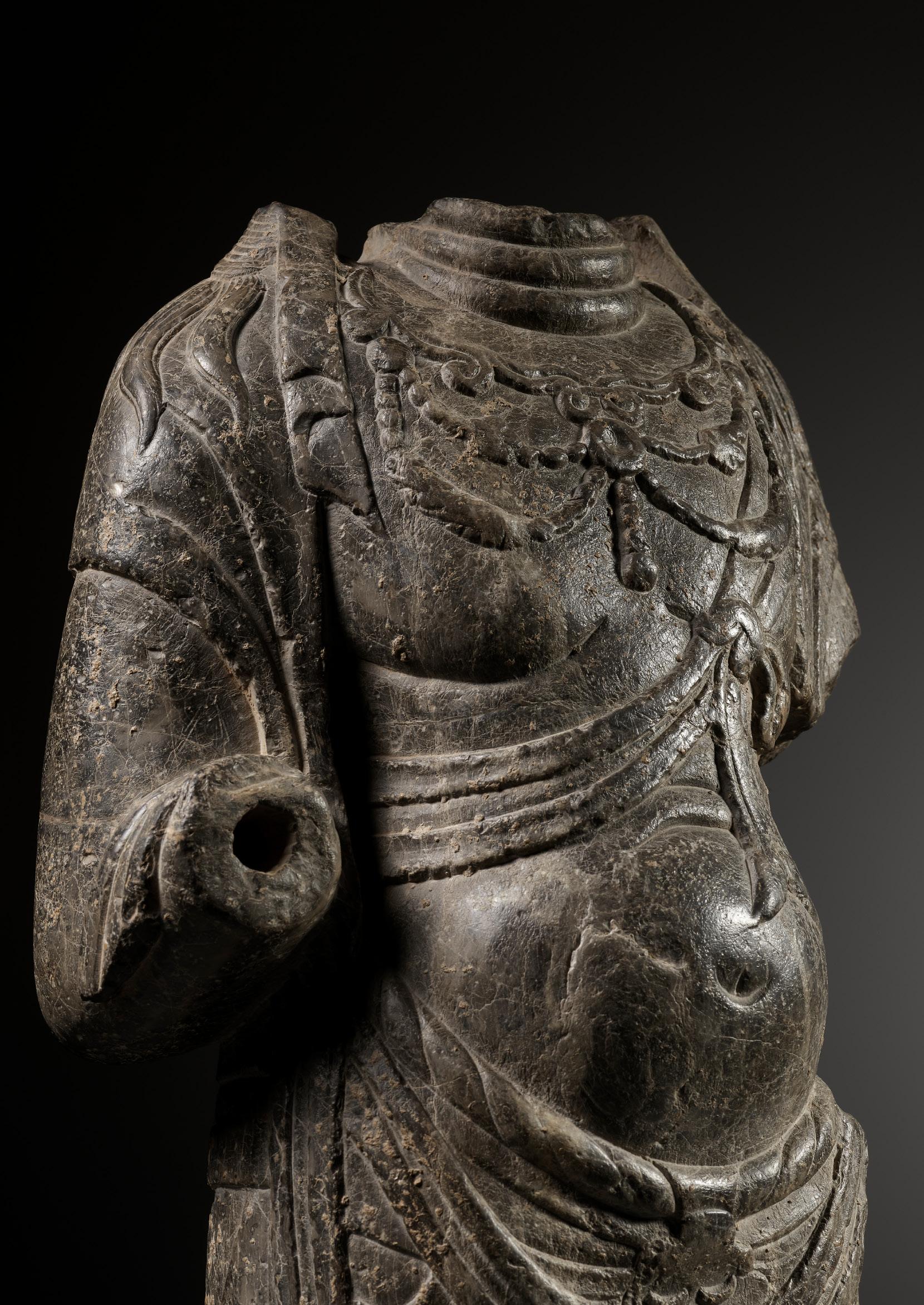
A LIMESTONE TORSO OF A BODHISATTVA, TANG DYNASTY
China, early 8th century. The slender, elegant figure well carved standing in a subtle tribhanga pose, wearing a clinging diaphanous skirt falling in graceful folds, with scarves tied diagonally around the torso and draped from the shoulders, richly adorned with elaborate jewelry including beaded and foliate necklaces as well as pendent ornaments of beaded and floral designs. The gray limestone with a magnificent, naturally grown, smooth patina.
Provenance: French trade, acquired from a French private collection built between ca. 1980 and 2012.
Condition: Good condition, commensurate with age. Extensive wear, losses, small nicks, light scratches, a minor surface crack with associated old fill (only visible under strong blue light), signs of weathering and erosion, encrustations.
Weight: 29 kg (incl. stand)
Dimensions: Height 60 cm (excl. stand) and 64 cm (incl. stand)
Mounted on an associated stand. (2)
The 5th-century Gupta influence on Tang Buddhist sculpture is manifest in the sensuously rounded body of the present lot, together with the diaphanous robes and jewelry.

LITERATURE COMPARISON
This statue is related to some of the larger figures from Longmen, such as the standing bodhisattva in a similar pose, with U-shaped drapery folds and roll of material at the waist, illustrated in Longmen Liusan Diaoxiang Ji (The Lost Statues of the Longmen Caves), Shanghai, 1993, p. 71, no. 78. Compare with a similar stone figure of a bodhisattva illustrated by O. Siren, Kinas Kunst Under Tre Artusenden, vol. 2, Stockholm, 1943, fig. 73A. Compare also a related sandstone figure from Tianlongshan, Shanxi Province, 101.6 cm high, dated approx. 700-750, in the Asian Art Museum of San Francisco, object number B60S6+. For a related figure in white marble with more elaborate realization of the drapery and with one foot placed slightly forward, see the figure from Longyenshan, Hebei, illustrated by W. Willetts, Foundations of Chinese Art, London, 1965, p. 222, fig. 139.
Auction result comparison:
Type: Closely related
Auction: Christie’s New York, 22 March 1999, lot 162
Price: USD 134,500 or approx. EUR 218,000 converted and adjusted for inflation at the time of writing
Description: A rare well-carved gray stone torso of a bodhisattva, Tang dynasty, early 8th century

Expert remark: Compare the closely related pose, drapery, and folds. Note the similar size (63.5 cm).
AUCTION RESULT COMPARISON
Type: Closely related
Auction: Christie’s New York, 22 March 1999, lot 161
Price: USD 36,800 or approx. EUR 59,500 converted and adjusted for inflation at the time of writing
Description: A rare dark gray stone torso of a bodhisattva, Tang dynasty, circa 700, from the Longmen caves
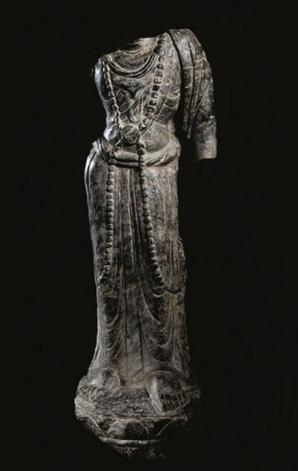
Expert remark: Compare the closely related pose and color of the stone. Note the similar size (54.6 cm).
Estimate EUR 8,000
Starting price EUR 4,000
156
A RARE WOOD HEAD OF A LUOHAN, SONG DYNASTY
China, 960-1279. Superbly carved with a gentle contemplative expression, marked by heavy-lidded eyes below thick arched brows centered by a distinct nose bridge and full lips forming a slight smile, flanked by long pendulous earlobes, the forehead with a characteristic bump.
Provenance: The estate of Louis-Pierre Denil, Leuven, Belgium. Bertin Verstraete, Belgium, acquired from the above. A Belgian private collector, acquired from the above. Louis-Pierre Denil (1965-2016) was an internationally renowned restorer, collector, and dealer of antique chandeliers. Since the 1990s, he was purveyor to the Belgian court, including King Albert II and King Philippe, and became close friends with members of the Imperial family.


Condition: Good condition, commensurate with age. Extensive wear, minor chips and losses, expected age cracks, small nicks, light scratches. Covered with numerous layers of lacquer applied over many centuries, of which only fragments remain, with a stable wood core underneath.
Weight: 5,215 g
Dimensions: Height 38 cm
Sensitively modeled with meticulous attention to detail which successfully captures the luohan’s expressive countenance, this superbly carved head is striking for both its large size and vivid realism, with intricate and naturalistic detailing of the gentle curvature of the skull.
Luohan, or arhats, were close personal disciples of Shakyamuni Buddha. Although they attained Buddhahood during the course of their lives, they delayed entering Nirvana and remained on earth to protect the Buddhist dharma and to aid others in seeking enlightenment according to the instruction of the Buddha. Invested with extraordinary spiritual power, they are believed to possess perfect wisdom and insight into all existence while being freed from the bonds of desires. Luohan figures became increasingly popular from the Song dynasty. Li Song in ‘From the Northern Song to the
Qing’, Chinese Sculpture, New Haven, 2006, pp. 389, suggests that during the Song dynasty, various Buddhist schools were eager to trace their lineages to Shakyamuni. Thus luohan, with their direct connections to the Historical Buddha, became the ultimate iconographic bridge to the Indian founders of Buddhism.
LITERATURE COMPARISON
Compare a closely related limestone head of a luohan, 41.3 cm high, dated Song to early Ming dynasty, at Sotheby’s New York, 12 September 2018, lot 14.

AUCTION RESULT COMPARISON
Type: Closely related
Auction: Christie’s New York, 20 September 2005, lot 144
Price: USD 72,000 or approx. EUR 99,500 converted and adjusted for inflation at the time of writing
Description: A rare wood head of a luohan, Song dynasty
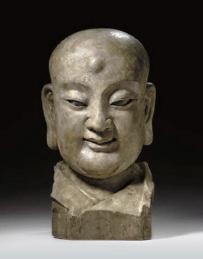

Expert remark: Note the related size (39.7 cm)
AUCTION RESULT COMPARISON
Type: Closely related
Auction: Bonhams London, 7 November 2019, lot 51
Price: GBP 68,813 or approx. EUR 91,000 converted and adjusted for inflation at the time of writing
Description: A rare carved wood head of a Lokapala, Song dynasty

Expert remark: Note the related size (39 cm)
Estimate EUR 14,000
Starting price EUR 7,000
232 157
Louis-Pierre Denil (1965-2016) Bertin Verstraete

A PAIR OF GILT STUCCO TEMPLE FIGURES OF BODHISATTVAS, YUAN - MING DYNASTIES
China, 1279-1644. Each modeled on iron armatures, standing with head slightly bowed and dressed in loose-fitting robes open at the chest, the plump face with downcast eyes, broad nose and delicate smiling mouth, the hair neatly dressed in a topknot and encircled by a diadem, one of which is decorated with a rosette.
Provenance:
Sotheby’s London, 9 November 2005, lot 518 (part-lot, together with another pair of similar figures), sold for GBP 6,240 or approx. EUR 11,000 (converted and adjusted for inflation at the time of writing). A European private collection, acquired from the above.

Condition: Good condition with minor wear, expected minor age cracks, rubbing to gilt and pigments, tiny losses, minuscule nicks, light scratches.
Weight: 2,207 g and 2,366 g (excl. stands)
Dimensions: Height 35 cm and 34.2 cm (excl. stands)
Each with a modern stand. (4)
The Xiaoxitian (Little Western Paradise) Temple, as well as various other temples in Shanxi Province, is profusely decorated with wood and stucco sculptures which have been particularly well preserved, partly due to beneficial climate conditions in the area. The temples range in date from the Liao period through to the late Qing dynasty, and due to the fragile nature of the material were subject to renovation from time to time.
Literature comparison: For similar figures in Xiaoxitian Temple, Xi County, see Buddhist Sculpture of Shanxi Province, Beijing, 1991, pl. 31. See also the Ming dynasty stucco figures of bodhisattvas in the Shuanglin Temple, illustrated ibid., pl. 172.
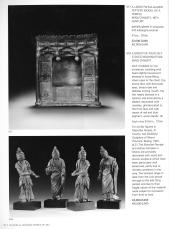
AUCTION RESULT COMPARISON
Type: Related
Auction: Christie’s New York, 23 March 2012, lot 1766

Price: USD 37,500 or approx. EUR 45,000 converted and adjusted for inflation at the time of writing
Description: A pair of painted stucco figures of bodhisattvas, Yuan dynasty
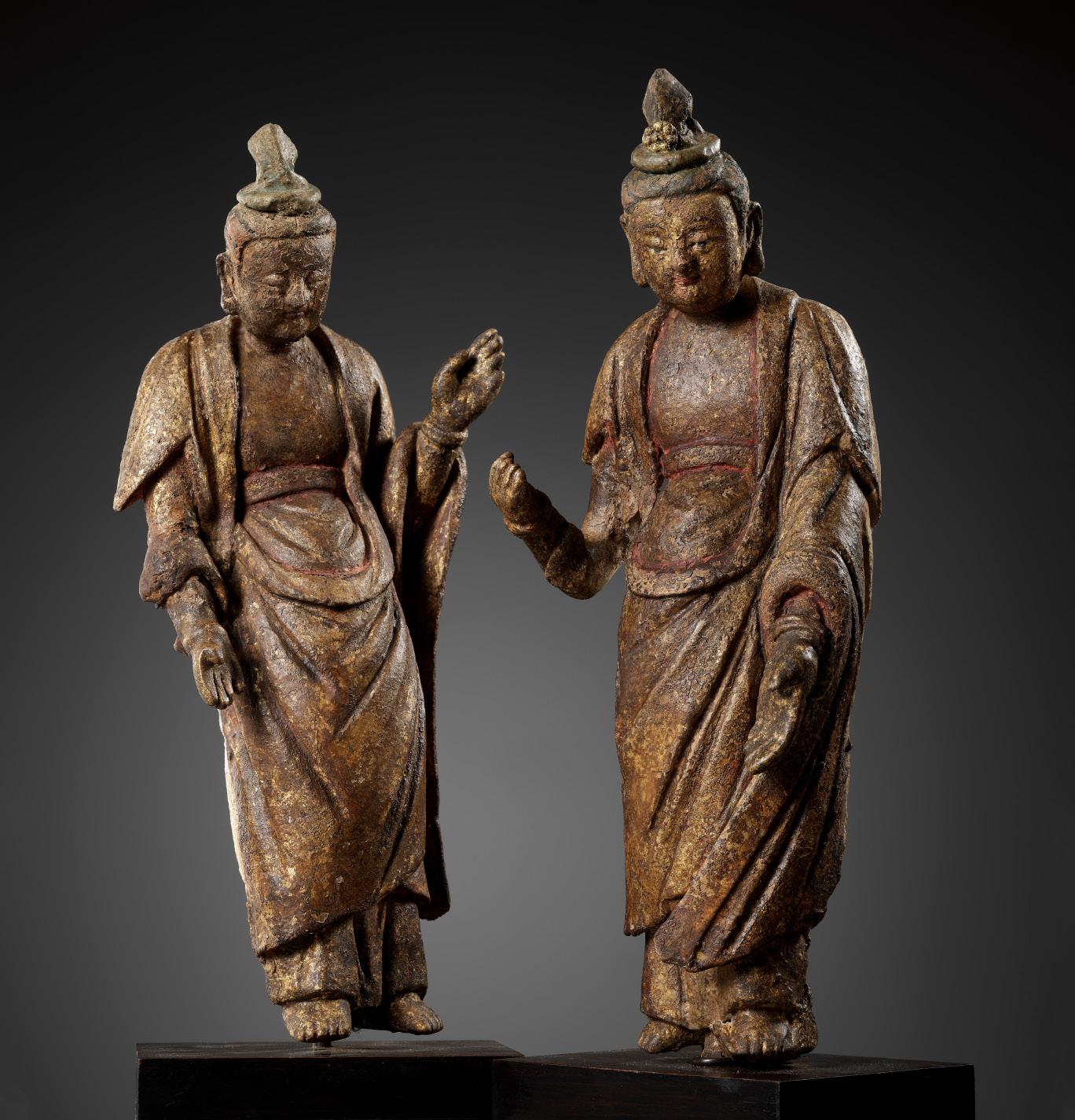
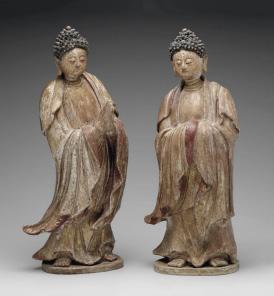
Expert remark: Note the significantly larger size (54.6 and 55.9 cm)
Estimate EUR 4,000
Starting price EUR 2,000
234 158
159
A SMALL WHITE MARBLE TORSO OF BUDDHA, NORTHERN QI DYNASTY
China, 550-577. Finely carved standing, wearing long flowing robes draped over both shoulders with loose sleeves, gathering at the lower legs.

Provenance: French trade, acquired from a French private collection built between ca. 1980 and 2012.
Condition: Good condition, commensurate with age. Extensive wear, losses, nicks, scratches, signs of weathering and erosion, encrustations.
Weight: 12.6 kg (incl. stand)
Dimensions: Height 47 cm (incl. stand) and 45 cm (excl. stand)
Mounted on an associated stand. (2)
AUCTION RESULT COMPARISON
Type: Related
Auction: Sotheby’s London, 2 November 2022, lot 209
Price: GBP 27,720 or approx. EUR 31,200
converted at the time of writing
Description: A marble torso of Bodhisattva, Sui/Tang dynasty
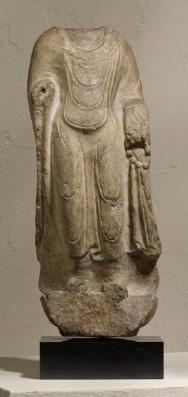
Expert remark: Note the slightly later date and smaller size (36.5 cm)
Estimate EUR 4,000
Starting price EUR 2,000

160
AN EXTREMELY RARE GILT-BRONZE FIGURE OF AVALOKITESHVARA IN ROYAL EASE, YONGLE INCISED SIX-CHARACTER MARK AND OF THE PERIOD
China, 1402-1424. Superbly cast seated in rajalilasana, with swaying torso and head inclined, the left leg drawn up and the right folded in front, the left hand raised and held in vitarka mudra and the right elegantly resting on the rear of the double-lotus pedestal base with beaded rims. The front left corner at the top of the base is neatly incised with the six-character mark Da Ming Yongle nianzhi and of the period.
Provenance: From the private collection of a gentleman in the United Kingdom.
Condition: Superb condition with only minor wear, minimal casting flaws, minuscule nicks, and remnants of old varnish. The base retains the original sealing.
X-Ray Images: Available upon request.
Weight: 1,441 g
Dimensions: Height 17 cm
Expert’s remark: The present figure was in private ownership for a long time. Until just recently, it was covered entirely by a thick layer of old varnish, which had blackened completely over the years. The six-character mark was unrecognizably hidden under this coating, and the owner was unaware of its presence. A significant portion of the varnish has now been removed to reveal the magnificent original gilding hidden below. Needless to say, this was done in a most sensitive manner, without scratching the gilding, using only pure alcohol and cotton. There are still some remains of varnish, mostly in the many corners and recesses, which may also be removed if one wishes. Prospective bidders are encouraged to study our high-resolution images in full detail. These will confirm that most of the black areas remaining are ancient varnish, under which the gilding is well preserved.
The bodhisattva is wearing a finely detailed foliate tiara, a profusion of beaded jewels around the neck, arms, waist and ankles, a diaphanous scarf billowing at either side, and a voluminous lower garment gathered at the waist with a jeweled girdle and spreading onto the lotus pedestal. The face is exquisitely modeled to provide a benevolent expression with downcast eyes, gently arched brows, circular urna, and smiling lips. The neatly incised hair is drawn up into a knotted jatamakuta topped by a cintamani jewel and elegantly falling in tresses over the shoulders.
Bronzes in the Tibetan-Chinese style produced during the reign of Emperor Yongle in the first quarter of the 15th century and bearing his reign mark are highly distinguished for their unsurpassed craftsmanship, overall refinement and gracefulness. Executed by the Imperial ateliers, they display a highly consistent and uniform style, which evolved out of the influence of the Nepalese artist Anige (1244-1306) at the Yuan court and the close links with Tibet established by the Yongle Emperor. The distinct Imperial style includes double-lotus bases with beaded rims and characteristic facial features with broadened outline, gently arched brows above the lidded eyes and subtle smile, all finished with great attention to detail.
The future Yongle Emperor was likely introduced to Tibetan Buddhism and became interested in it around 1380, when he was enfeoffed in Beijing, and of course he had strong ties to the Mongol military elite, who were also adherents of lamaist Buddhism, so it appears that he continued to practice this form of Buddhism for the rest of his life. Certainly more works of art depicting lamaist Buddhist deities and imagery were produced during his reign period than under any other Chinese emperor, with the exception of the Qing Emperor Qianlong. For further discussion of this topic see J.C.Y. Watt and D.P. Leidy, Defining Yongle: Imperial Art in Early Fifteenth-Century China, Yale University Press, 2005.
In 1406, the Yongle Emperor sent a mission to Tibet inviting the famous hierarch of the Karmapa monastery, Halima, to Nanjing, to take part in the memorial services for the Hongwu Emperor and Empress Ma. Halima first sent a tribute mission, and then in the Spring of 1407 came to the Ming court in person. There he was received with great honor, given the title Dabao Fawang (Great Precious Religious Prince) and asked to perform religious ceremonies for the Emperor’s deceased parents. After his return to Tibet, Halima continued to exchange gifts with the Emperor. The Yongle Emperor also invited the hierarch of the Sakyapa to the court at Nanjing in 1413 and treated him too with great honor. Thereafter missions were sent from Sakya abbots until the 1430s. A high-ranking representative of the Yellow Sect was invited to Nanjing in 1413 and was also greatly honored and returned to Tibet in 1416 with many gifts. Gifts and missions continued to be exchanged with the Yellow Sect until the 1430s.
237
Literature comparison: Compare a closely related figure of Avalokiteshvara, also with the Yongle mark incised to the front left corner at the top of the base, below Avalokiteshvara’s left knee, at exactly the same place where it is found on the present lot, in the Norbulingka Palace in Lhasa, recorded by von Schroeder in his survey of the holdings of Tibetan monastery collections, illustrated in von Schroeder, Buddhist Sculptures in Tibet, Hong Kong, 2001, pp. 1270-1, pl. 353D, and in E. F. Lo Bue (ed.), Tesori del Tibet: Offetti d’arte dai Monasteri di Lhasa, 1994, p. 110, no. 70.
AUCTION RESULT COMPARISON
Type: Closely related
Auction: Sotheby’s London, 7 November 2007, lot 362

Price: GBP 546,900 or approx. EUR 939,000 converted and adjusted for inflation at the time of writing
Description: A rare and extremely fine gilt-bronze figure of Avalokiteshvara, erased mark of Yongle and of the period Expert remark: Compare the regal pose, bodhisattva jewelry, smiling expression, double-lotus pedestal base with beaded rims, and near identical size (18 cm). Note that this figure has an erased Yongle reign mark.

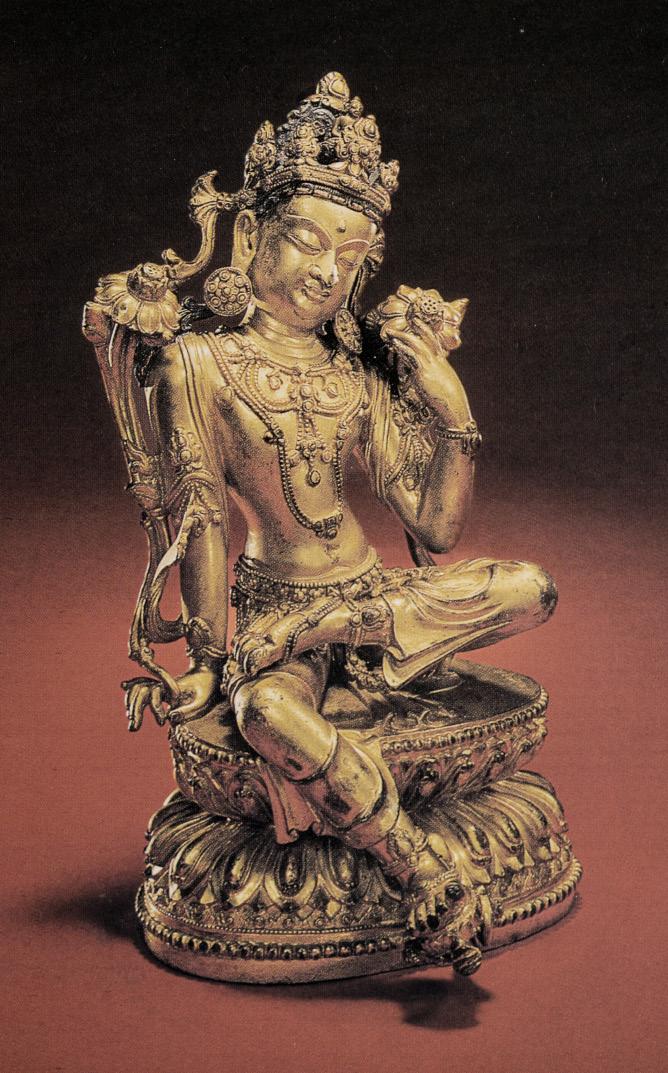
Estimate EUR 100,000
Starting price EUR 50,000
238
Incised six-character Yongle reign mark on the present lot

AN EXCEPTIONALLY RARE AND SIGNED GILT BRONZE FIGURE OF BUDDHA, EARLY MING DYNASTY
Published: Svenska Hem i Ord och Bilder (Swedish Home in Words and Pictures), Stockholm, 1922, page 109. Note that this information is according to the family of the previous owner, as the present lot cannot be identified beyond any doubt on the ancient image in the publication.
China, early 15th century. Finely cast, seated in dhyanasana on a double-lotus base with beaded edges, his hands lowered in dhyanamudra above his lap, wearing a richly pleated robe with neatly incised foliate hems. The serene face with heavy-lidded eyes, gently arched brows, a circular urna, and full lips forming a calm smile, flanked by long pendulous earlobes. The hair arranged in tight snailshell curls, the high ushnisha surmounted by a jewel. Magnificent, naturally grown patina overall.
Provenance: From the collection of Inez Utter (née Bonnier, 1890-1968) and Tore Utter (1880-1953), and thence by descent within the same family.
Condition: Excellent condition commensurate with age, with wellpreserved gilt, some old wear and expected casting flaws, including one to the back of the head with an associated small loss. The base resealed with ancient remnants of soldering, otherwise absolutely original with no restoration or repair of any kind. Presenting exceptionally well.
Inez Utter (1890-1968) and Tore Utter (1880-1953)

Weight: 2,841 g
Dimensions: Height 27.5 cm
This exquisite figure is notable for its fine casting and gilding, as evidenced in the naturalistically modeled folds of the robes and in the figure’s serene facial expression. Stylistically it follows in the tradition established in the Yuan period, when Tibetan Buddhism became the court religion, and a new sculptural style began to appear. The full, yet somewhat squared facial features, robust body and stylization of the boldly cast lotus lappet base all indicate a rather early 15th-century date.
Expert’s note: Figures with gently smiling faces, full rounded bodies and tiered thrones are depicted in the early 14th-century woodblock prints made for the monastery of Yanshen Yuan, Hangzhou, and illustrated in
Inscriptions:
Signature to the back, ‘Made by the lay follower Guo with the maiden name Huiming’.

Heather Stoddard Karmay, Early Sino-Tibetan Art, Warminster, 1975, pls. 26, 29, and 30. It is possible that these images, which reflect the style favored in Tibet at the time, were used for inspiration by craftsmen active in the early 15th century.
Literature comparison: Compare a related gilt-bronze figure of Bhaisajyaguru Buddha, dated to the first year of the Jingtai reign (1450), illustrated in Gems of Beijing Cultural Relics Series: Buddhist Statues (I), Beijing, 1999, page 153, no. 115.
AUCTION RESULT COMPARISON
Type: Closely related
Auction: Sotheby’s London, 8 November 2017, lot 67
Price: GBP 187,500 or approx. EUR 258,000 converted and adjusted for inflation at the time of writing
Description: A gilt-bronze figure of Shakyamuni


Buddha, Ming dynasty, early 15th century
Expert remark: Compare the closely related manner of casting, pose, robe, face, base, and size (27 cm). Note that this bronze is also signed. Note that the gilt is even better preserved than on the present lot.
AUCTION RESULT COMPARISON
Type: Closely related
Auction: Christie’s Amsterdam, 23 March 2011, lot 161
Price: EUR 133,000 or approx. EUR 179,000 adjusted for inflation at the time of writing
Description: A Chinese Ming period gilt bronze figure of Buddha Shakyamuni, indistinct mark, 15th century
Expert remark: Compare the closely related manner of casting, pose, robe, face, base, and size (27 cm). Note this bronze is also marked. Also note that the gilt is not as well preserved as on the present lot.
Estimate EUR 30,000
Starting price EUR 15,000
240 161

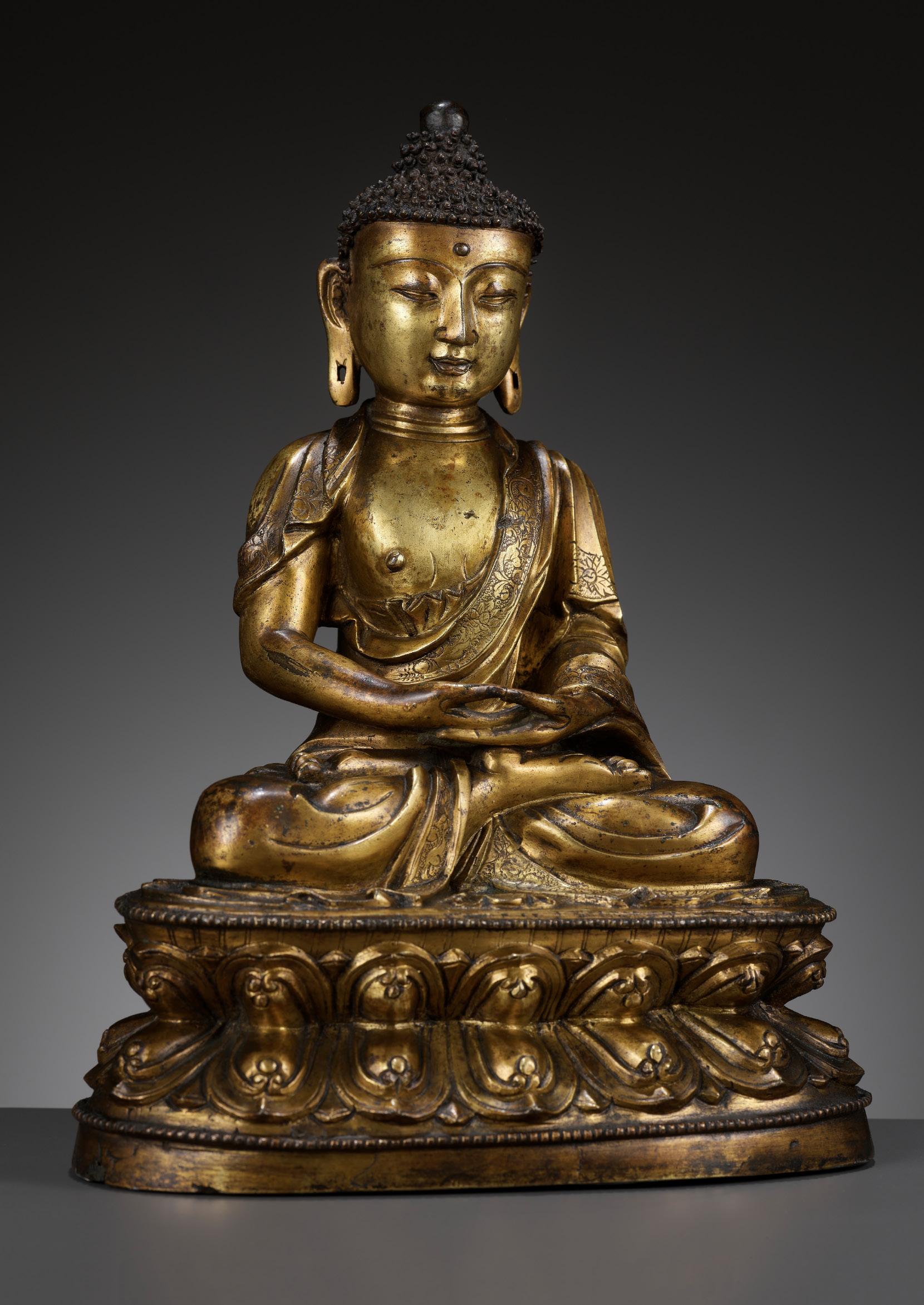
162
A COPPER-INLAID BRONZE FIGURE OF BUDDHA, TIBET, 13TH-14TH CENTURY
Seated in dhyanasana atop a double-lotus base with a beaded upper rim, his right hand lowered in bhumisparsha mudra and his left held in dhyana mudra above his lap, his body clad in a close-fitting sanghati gathered on one shoulder, the robe bordered with neatly incised hems inlaid in copper. The finely painted face with a meditative expression marked by heavy-lidded eyes, gently arched brows, an urna, and full lips, flanked by a pair of long pendulous ears. The head and domed ushnisha covered with tight curls and surmounted by a jewel.
Provenance: Swedish trade.
Condition: Good condition with some wear and casting irregularities, minor nicks and dents, the base with small tears, the seal plate replaced, minimal warping. Very good, naturally grown patina overall, with an unctuous feel from centuries of handling. Remnants of ancient pigments.
Weight: 731 g
Dimensions: Height 16 cm
Expert’s note: The close-fitting robe, which fans out before the shins, eclipses his left wrist, and drapes over Buddha’s left shoulder, indicate a stylistic borrowing from Northeastern Indian Pala prototypes, reflected in five 10th-century bronzes held in the Calcutta Museum (see Niharranjan, Eastern Indian Bronzes, New Delhi, 1986, nos. 217-21). Meanwhile, the fishtail hem, draped high above his left shoulder, and the additional hems neatly draped over his left bicep are characteristics of the 13th-century Khasa Malla style, evident in bronzes held in the Rubin Museum of Art and the Patan Museum (see HAR item nos. 65687 & 59501 (fig. 1), respectively). The fusion of these elements indicates to art historians that early Tibetan bronze casters turned to Buddha images from both India and Nepal for inspiration when first creating their own.
AUCTION RESULT COMPARISON
Type: Closely related
Auction: Christie’s New York, 20 March 2009, lot 1358
Price: USD 9,375 or approx. EUR 12,000 converted and adjusted for inflation at the time of writing
Description: A bronze figure of Buddha Shakyamuni, Tibet, 13th/14th century

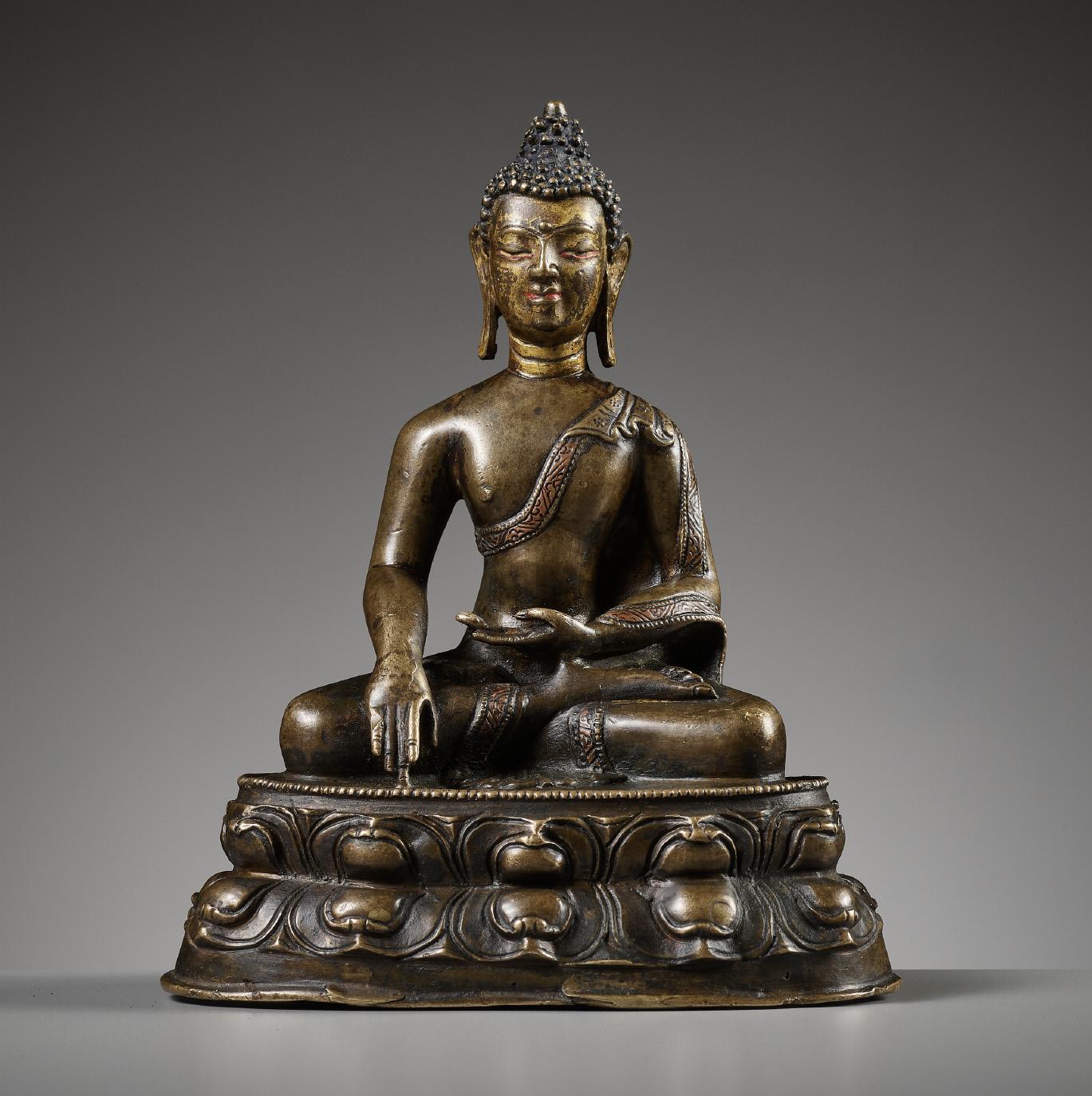

Expert remark: Note the similar size (17 cm)
Estimate EUR 4,000
Starting price EUR 2,000
243
fig. 1
163
A LARGE BRONZE FIGURE OF GUANYIN, LATE MING DYNASTY
China, 16th-17th century. Heavily cast seated in dhyanasana on a lotus base, the hands lowered and folded above the feet, dressed in loose-fitting, elegantly flowing robes opening at the chest to reveal beaded jewelry. The cuffs and hems of the robes finely incised with floral bands, the face with a serene expression and downcast eyes above a subtle smile, flanked by elongated earlobes suspending floral earrings, the hair tied in a high chignon, all surmounted by a floral openwork crown with Amithaba at the center. The figure and base cast separately.

Provenance: Swiss trade, by repute acquired from an old Swiss private estate.
Condition: Very good condition with expected old wear, nicks and dents, light scratches, small losses, and casting irregularities. Naturally grown dark patina overall with distinct hues of malachite-green.
Weight: 8,810 g (excl. acrylic stand), 9,602 g (incl. acrylic stand)
Dimensions: 41.2 cm (excl. acrylic stand), 43.5 cm (incl. acrylic stand)
With a modern acrylic stand. (3)
AUCTION RESULT COMPARISON
Type: Related
Auction: Sotheby’s New York, 11 September 2012, lot 179
Price: USD 25,000 or approx. EUR 30,500 converted and adjusted for inflation at the time of writing
Description: A bronze figure of Guanyin, Ming dynasty, 16th century

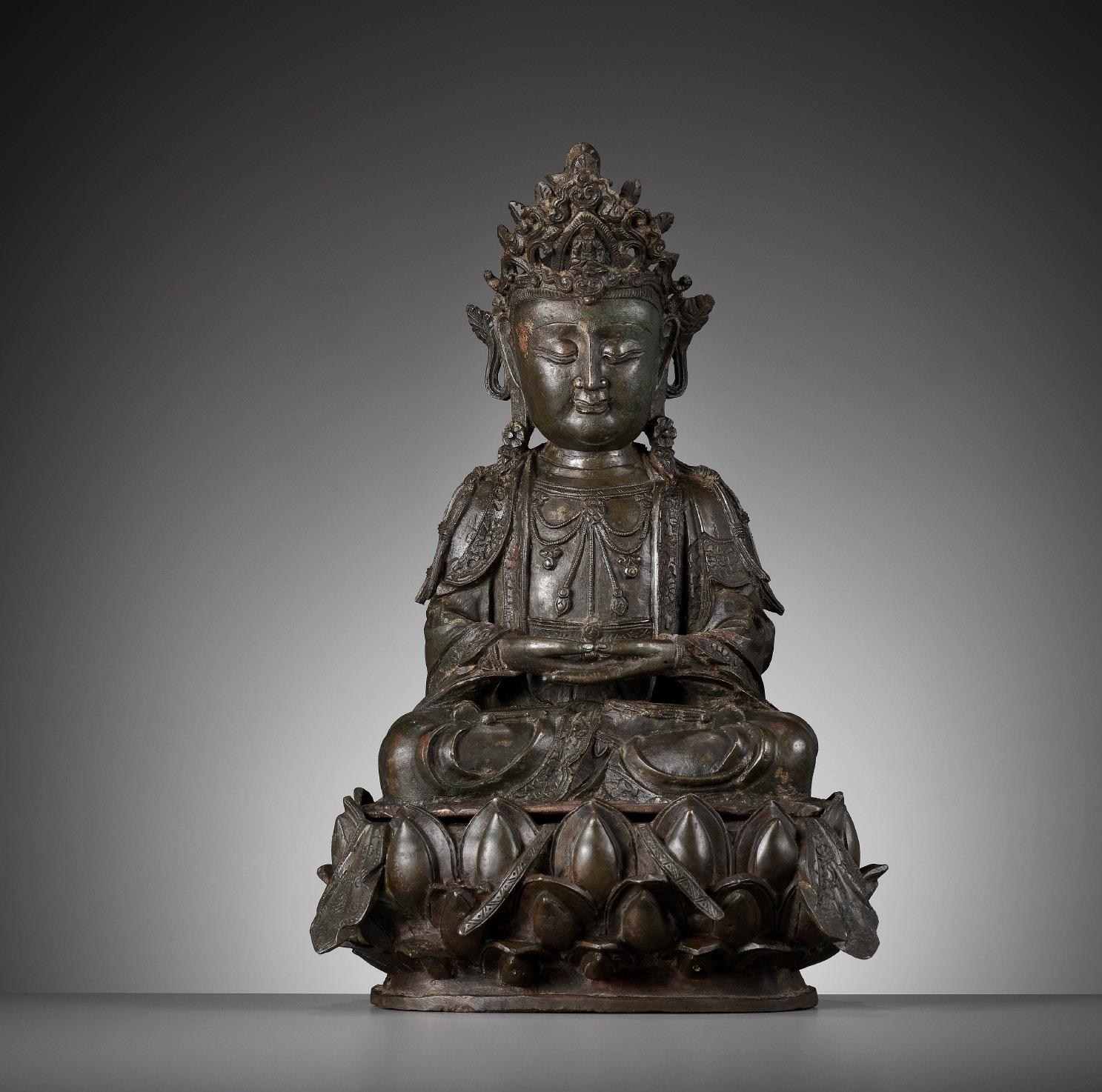
Expert remark: Compare the related pose, and facial expression. Note the smaller size (34.5 cm).
AUCTION RESULT COMPARISON
Type: Related
Auction: Sotheby’s London, 12 May 2021, lot 74
Price: GBP 23,940 or approx. EUR 31,000 converted and adjusted for inflation at the time of writing
Description: A bronze figure of Guanyin, late Ming dynasty
Expert remark: Compare the related pose and facial expression. Note the near-identical size (41.6 cm).
Estimate EUR 8,000
Starting price EUR 4,000
244
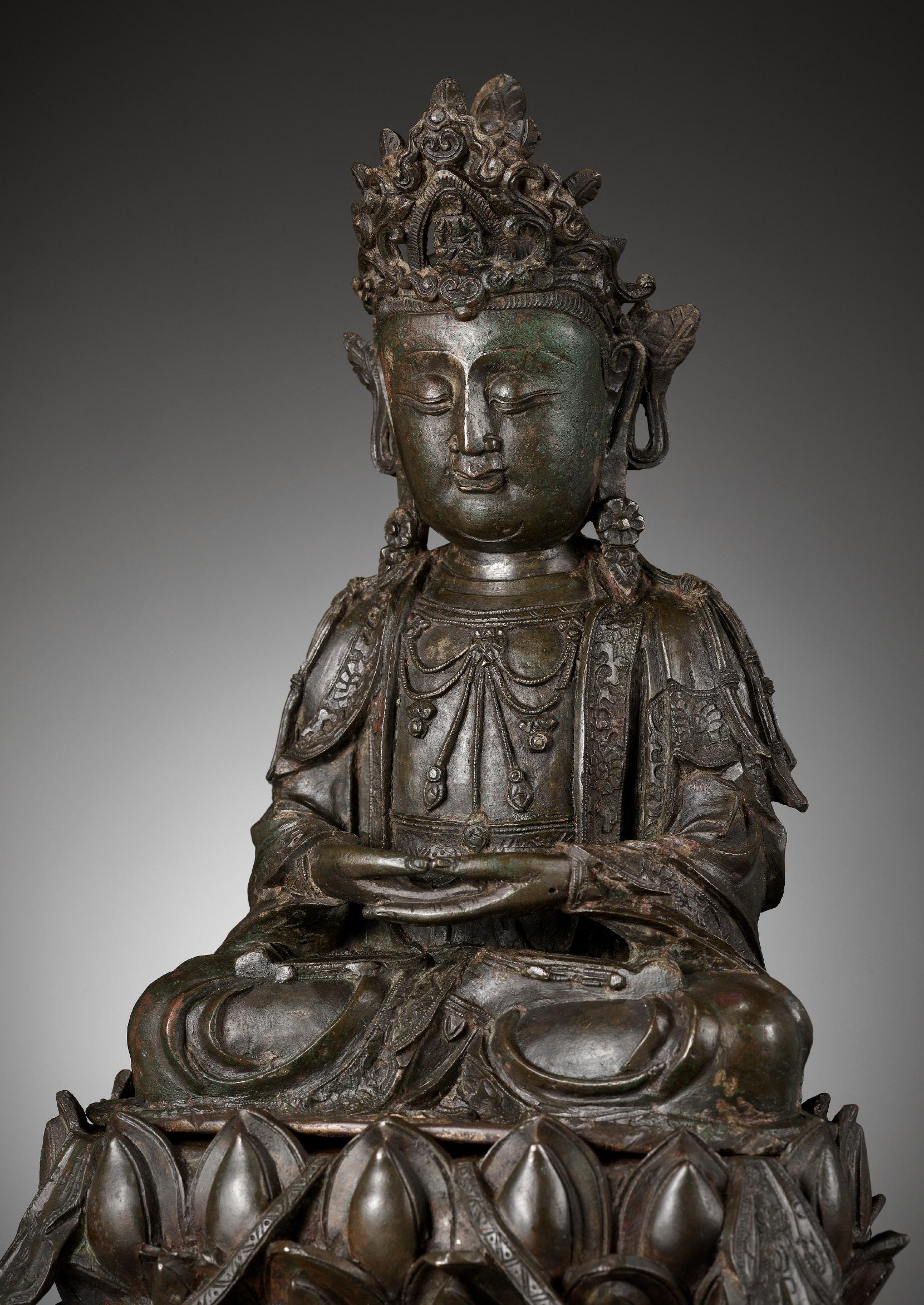
164
A RARE SANCAI GLAZED ROOF TILE OF SAMANTABHADRA, MING DYNASTY
China, 1368-1644. Well modeled on an arched tile riding on his elephant, the left hand on his chest, dressed in long flowing robes cascading in voluminous folds, the long hair tied behind a foliate tiara, his face with a serene expression and downcast eyes, covered overall in sumptuous glazes of emerald-green, amber, ochre, and black.

Provenance: Theodore Schrire, Cape Town, South Africa, and thence by descent in the same family. Theodore Schrire (1906-1991) attained his MA at the University of Cape Town, where he also received the medal in physiology in 1925. He worked as a general surgeon in private practice and was attached to the department of surgery at the University of Cape Town Medical School under Professor Saint.
Weight: 4,990 g
Dimensions: Height 39.5 cm
Known as Puxian in Chinese, Samantabhadra is sometimes shown in Chinese art with feminine characteristics, bearing similar dress and features to some depictions of Guanyin. It is in this guise that Samantabhadra is revered as the patron bodhisattva of the monasteries associated with Mount Emei in western China. Some believe that the white elephant mount of Samantabhadra was the same elephant that appeared to Queen Maya, the mother of the Buddha, to herald his birth.
Literature comparison: Compare a related blue and sancai glazed roof tile of a figure astride an elephant, 27.2 cm high, also dated to the Ming dynasty, in the collection of the Syracuse University Art Museum, object number 2001.0026.
AUCTION RESULT COMPARISON
Type: Closely related
Theodore Schrire after a successful fishing trip

In 1955 he was awarded the Hamilton-Bailey medal of the Medical Association of South Africa. He later worked as the assistant editor of the South African Medical Journal, where he published numerous papers and edited two books, Emergencies: Casualty Organization and Treatment (1962), and Surgical Emergencies: Diagnoses and Management (1972). After retirement, he pursued his passions and became a respected collector of Chinese works of art, Netsuke, maps of Africa, Palestine and Judaica, and a variety of literary works.
Condition: Good condition with some wear, small glaze chips, signs of weathering, soil encrustations, and expected firing flaws, the neck with an old repair.
Auction: Christie’s New York, 15 September 2016, lot 844
Price: USD 25,000 or approx. EUR 29,000 converted and adjusted for inflation at the time of writing
Description: A Pair of Sancai Equestrian-Form Roof Tiles, Ming Dynasty (1368-1644)

Expert remark: Compare the closely related glaze and modeling technique, note that this lot consists of two figures.
Estimate EUR 4,000
Starting price EUR 2,000
246
165
A

HARDWOOD FIGURE OF VIJRAPUTRA, LATE MING DYNASTY TO EARLY QING DYNASTY
China, 17th to early 18th century. Finely carved, seated with his right hand resting on his raised knee, the left hand supported by an armrest above a lion head issuing a three-clawed foot, dressed in loose-fitting robes opening at the chest, his balding head detailed with furrowed brows above a pointed nose and delicately curled facial hair.
Inscriptions: To the base, ‘Song Ji Zao’.
Provenance: From the collection of Dr. Aurel Gonda, acquired in Shanghai circa 1937-1947, and thence by descent to the present owner. Dr. Aurel Gonda (18851964) was an Austro-Hungarian physician who served as a councilman and health official in Vienna. A street in Inzersdorf, in the 23rd district of Vienna, is named after him. He was the brother of architect Charles Henry Gonda, who was active in Shanghai between the 1920s and 1940s. As C. H. Gonda rose to be a renowned architect, he ran in the same circles as foreign elites, including Shanghai’s top oligarch Victor Sassoon. In 1938, Aurel Gonda and his family escaped fascist Vienna and joined C. H. Gonda in Shanghai. After the Communist victory in China in 1949, the brothers and their families left for the US and settled in Lakewood, New Jersey. Condition: Very good condition with some old wear, few minuscule chips to the edge of the robe, expected minor age cracks, fine warm patina.
Weight: 410 g
Dimensions: Height 15.4 cm
Expert’s note: The present figure most likely depicts the eighth luohan Vijraputra, known in China as Xiaoshi Luohan (Laughing Lion Luohan), as evidenced by the lion head below the armrest. Vijraputra is commonly depicted with a lion.
Auction result comparison:
Type: Related
Auction: Sotheby’s Hong Kong, 2 May 2014, lot 21
Price: HKD 275,000 or approx. EUR 41,000 converted and adjusted for inflation at the time of writing
Description: A Carved Wood Seated Luohan Qing Dynasty, 18th / 19th Century
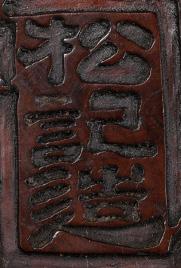


AUCTION RESULT COMPARISON
Type: Related
Auction: Sotheby’s Hong Kong, 2 May 2005, lot 662
Estimate: HKD 400,000 or approx. EUR 76,500 converted and adjusted for inflation at the time of writing
Description: A finely carved boxwood figure of a luohan, Qing dynasty, 18th century
Estimate EUR 3,000
Starting price EUR 1,500
247
The Shanghai architect Charles Henry Gonda, brother of Dr. Aurel Gonda
A LARGE PARCEL-GILT IRON VAJRA, TIBET, 12TH - 13TH CENTURY
The eight-pronged vajra with a central knob of compressed globular form, flanked to each side by four stylized beast masks, the recessed geometric decorations covered with gilt lacquer, a loose ring attached to the interior central pole to either end of the vajra, the prongs terminating in pointed finials.
Provenance: British trade.
Condition: Very good condition with expected wear from centuries of handling and worship, minor nicks and dents here and there, some casting flaws, light scratches.
Weight: 666.9 g
Dimensions: Length 25.4 cm
The vajra, a symbol of indestructibility and power, is one of the primary ritual symbols in Tibetan Buddhism. Derived from Sanskrit and translating to both thunderbolt and diamond, the vajra consists of two sets of prongs from which lotus petals emanate, flanking a central sphere. Often used in combination with a bell, which represents feminine wisdom, the vajra symbolizes the masculine attribute of skillful means or compassion.
AUCTION RESULT COMPARISON
Type: Closely related
Auction: Sotheby’s New York, 19 March 2014, lot 58
Price: USD 52,500 or approx. EUR 62,500 converted and adjusted for inflation at the time of writing
Description: An Iron Vajra with Gold Inlay Expert remark: Compare the related form, parcel gilt decoration, and size (25.4 cm)
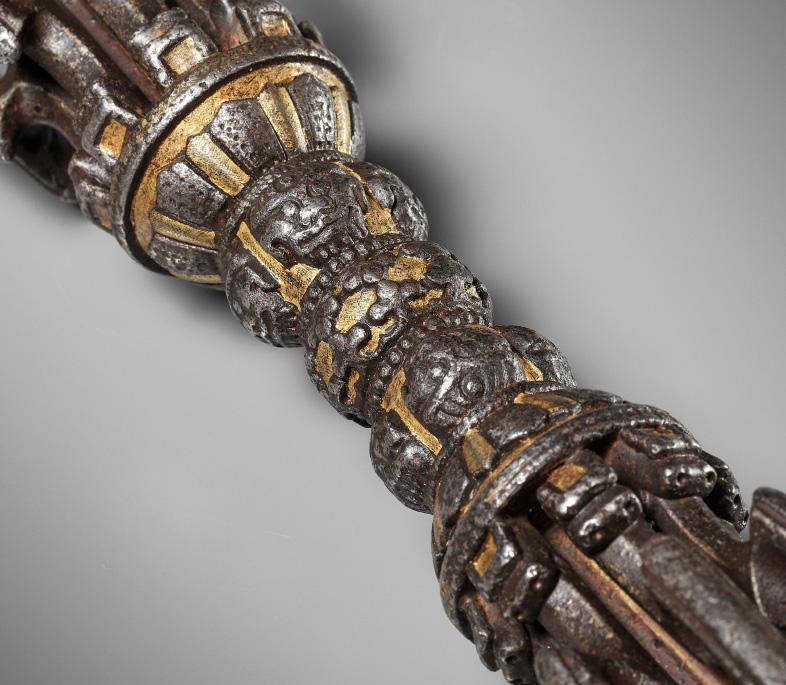
AUCTION RESULT COMPARISON
Type: Related
Auction: Sotheby’s New York, 20 March 2013, lot 220
Price: USD 25,000 or approx. EUR 30,000 converted and adjusted for inflation at the time of writing
Description: An Iron Vajra Expert remark: Compare the related form and size (25.7 cm). Note the lack of gilt.



Estimate EUR 6,000
Starting price EUR 3,000
248
166
A BRONZE FIGURE OF PADMAPANI, GUGE KINGDOM, WESTERN TIBET, 11TH-12TH CENTURY
Finely cast, standing on a lotus dais over a stepped pedestal cast with a central figure flanked by two lions, his right hand in abhayamudra and his left clutching a lotus stem blossoming at his shoulder, wearing a short dhoti with neatly incised folds and richly adorned with beaded jewelry. The face with elongated eyes, the hair in a topknot centered by a small image of the Buddha Amitabha, all backed by a finely incised flaming nimbus and aureole.
Provenance: German trade. By repute from a noted German private collection.
Condition: Good condition, commensurate with age. Extensive wear, losses, small dents, minor nicks, light scratches, encrustations. Fine, naturally grown patina with malachite and cuprite encrustations.
Weight: 796.7 g
Dimensions: Height 18.2 cm
The ancient Kingdom of Guge was a small Western Himalayan kingdom which was founded by King Yeshe-Ö and flourished from the tenth through twelfth centuries. Its artistic tradition was heavily influenced by Kashmiri sculptural and painting styles due to the presence of Kashmiri teachers and artisans active in the area during the period of the second dissemination of Buddhism in Tibet (c. 950-1200). The manner of modeling the rounded face with long, thin eyes, the pronounced belly, and the conjoined nimbus form in the present work are all reminiscent of Kashmiri prototypes that began appearing in Tibet at the turn of the eleventh century.
Literature comparison: The style of depiction closely resembles murals in caves such as those at Ropa and Tsaparang, surrounding the Sutlej River which was once the heart of the western Tibetan Kingdom of Guge. The present sculpture, with its restrained representation, differs from the early masterpieces of Kashmir, which are defined by their exaggerated features. Compare the iconography, proportions, and rendering of the facial features of the present work with a related figural depiction of Eleven-headed Avalokiteshvara attributed to the Tholing region of Western Tibet, from the eleventh century, at the Los Angeles Museum of Art, accession number M.78.40, illustrated by C. Luczanits in Collecting Paradise: Buddhist Art of Kashmir and Its Legacies, New York, p. 111, fig. 2.4.
AUCTION RESULT COMPARISON
Type: Closely related
Auction: Christie’s New York, 21 September 2022, lot 406
Price: USD 32,760 or approx. EUR 31,000 converted at the time of writing
Description: A bronze figure of Eleven-headed Avalokiteshvara, Western Tibet, probably Guge, 11th12th century
Expert remark: Compare the closely related stepped base with similar central figure and lions, and incised nimbus and aureole. Note the smaller size (12.7 cm).
AUCTION RESULT COMPARISON
Type: Closely related
Auction: Bonhams New York, 13 March 2017, lot 3062
Price: USD 18,750 or approx. EUR 21,500 converted and adjusted for inflation at the time of writing
Description: A copper alloy figure of Manjushri, Western Tibet, Kashmir Style, circa 11th century

Expert remark: Note the similar size (19 cm)
Auction result comparison:
Type: Related
Auction: Christie’s New York, 13 September 2011, lot 350
Price: USD 98,500 or approx. EUR 124,000 converted and adjusted for inflation at the time of writing
Description: A bronze figure of Padmapani, Kashmir or western Tibet, 11th/12th century


Expert remark: Note the much larger size (33.7 cm)
Estimate EUR 4,000
Starting price EUR 2,000
249
167

A LARGE BRONZE FIGURE OF NILAMBARA VAJRAPANI, TIBET, TSANG VALLEY, 13TH-14TH CENTURY
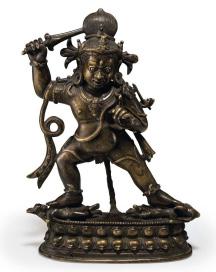
Powerfully modeled and boldly cast striding in aldhasana atop a double-headed naga on a lotus base, his right hand holding a vajra and his left held admonishingly in tarjani mudra. He is wearing a tiger pelt around his waist and adorned with jewelry in the form of snakes as well as a beaded necklace. His face with a wrathful expression marked by sharp fangs, wide eyes, raised brows centered by a prominent urna, and a neatly incised beard. His fiery hair is surmounted by a blade-like protuberance with an image of Akshobya Buddha.
Provenance: Oriental Gem Co., London, United Kingdom, by 1971. The John C. and Susan L. Huntington Collection, Columbus, Ohio, USA. John (d. 2021) and Susan Huntington are important scholars of Buddhist art, who have done extensive field research and photographic documentation throughout Asia. The couple were not just partners in life but partners in their chosen work of teaching, researching, and publishing about the art of Asia. John’s doctoral dissertation, Styles and Stylistic Sources of Tibetan Painting, was a pioneering work written at a time when there was little, if any, scholarly attention being paid to the study of Tibetan art. Following his doctoral work, John spent 19691970 traveling in Asia on a National Endowment for the Humanities postdoctoral fellowship pursuing his study of Buddhist art. At the same time, Susan was doing field research in India on a Fulbright grant for her doctoral dissertation. They married in India in 1970. Prior to undertaking graduate studies, John had been a professional photographer and throughout his life, his passion for photography never waned. Susan had developed an abiding interest in photography since taking a course in high school. Together, with Susan making exhaustive field notes as they photographed, the pair developed a teamwork that continued throughout their lifetime of field work, culminating in the John C. and Susan L. Huntington Photographic Archive of Buddhist and Asian Art, which contains nearly 300,000 original slides and photographs documenting art and architecture throughout Asia. Both taught at the Ohio State University, with Susan serving as Dean of the Graduate School and Vice Provost for Graduate Education from 1995 and 2005, and John building a flourishing program in Asian art history, and they have published many articles and books on a wide range of topics related to Asian and Buddhist art, both separately and together. The collecting history of the Huntingtons aligned closely with their academic research and passion for learning. While they collected works in established categories that epitomized major Indian and Himalayan artistic styles or periods, they also pursued pieces that were little understood and that begged for further academic research. Condition: Good condition commensurate with age. Expected old wear, predominantly from centuries of worship within the culture. Minor casting flaws, small dents, minuscule nicks, light scratches, some losses, the unsealed base further with a small tear. The left arm has been reattached with ancient rivets, probably hundreds of years ago. Remnants of pigment. Fine, naturally grown patina overall.
Weight: 998.7 g
Dimensions: Height 25.2 cm

Vajrapani, originally a peaceful bodhisattva in the Mahayana tradition, has a wrathful manifestation within the Tantric or Vajrayana Buddhist tradition. The present lot depicts Nilambara Vajrapani, or the Blue-Clad One. In this form Vajrapani is dark blue, with one face, three eyes, and two hands. His clothing is blue and his thick matted hair streams upward. His body is adorned with eight serpents in various places, and in his right hand he brandishes a vajra. For the Tibetans, and no doubt for Indian tantric practitioners, this form of Vajrapani was highly popular, to the extent that the Kangyur contains no less than seven tantras and two dharani texts centered on this awakened figure.
Published and exhibited: John C. Huntington and Dina Bangdel, The Circle of Bliss: Buddhist Meditational Art, Los Angeles County Museum of Art and Columbus Museum of Art, 5 October 2003 to 9 May 2004, pp. 203-204, cat. no. 53.


In this manifestation, the wrathful Vajrapani displays his rightful indignation at hindrances that impede the practitioner on the path to enlightenment, directed toward the foolishness of someone who has encountered the Buddha’s teaching and who is, even so, too arrogant and prideful to take refuge in the Buddha, Dharma, and the Sangha. For both protection and purification, a wrathful Vajrapani is invoked during the Krodhavesha ritual in the Kalachakra practice, in which the practitioner identifies with Vajrapani.
Stylistically the piece belongs to the Tsang Valley school of the 13th or 14th century, but it is entirely Tibetan in conception and execution, without the usual Newar-inspired characteristics associated with this school. Rather, it is freely modeled, ignoring all but the most significant details. The present sculpture’s great potency comes from the violently angry grimace and lunging thrust of its position. The modeler has truly captured the feeling of outrage at the unfortunate being who does not have the good sense to seek refuge in the Buddhist teachings.
LITERATURE COMPARISON
Compare a related brass figure of Chanda Vajrapani, 16.6 cm high, dated to the 13th century, in the Tibet Museum Fondation Alain Bordier, accession number ABS 070. Compare the iconography of a painting of Vajrapani, illustrated in Robert N. Linrothe and Jeff Watt, Demonic Devine: Himalayan Art and Beyond, New York, p. 229.
AUCTION RESULT COMPARISON
Type: Closely related

Auction: Christie’s New York, 18 September 2013, lot 304
Price: USD 75,000 or approx. EUR 92,500 converted and adjusted for inflation at the time of writing
Description: A bronze figure of Achala, Tibet, 13th century

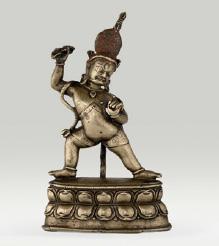
Expert remark: Compare the closely related striding pose, wrathful expression with three eyes and sharp fangs, snake ornaments, hairstyle, and color of the bronze. Note the related size (26.2 cm).
Estimate EUR 14,000
Starting price EUR 7,000
251 168
John Huntington at Kumari Bahal in Kathmandu, Nepal, 1970


A LARGE BRONZE FIGURE OF RATNASAMBHAVA, CENTRAL TIBET, 13TH-14TH CENTURY
Sensitively modeled and finely cast, seated in dhyanasana atop a double lotus base with beaded upper rim, his right hand held in varada mudra and the left lowered above his lap, wearing a sheer dhoti, billowing scarves and richly adorned with elaborate beaded jewelry, his serene face with sinuously lidded eyes, neatly incised brows centered by a rhombic urna, and full lips forming a calm smile, the hair piled up into a high chignon topped by a jewel behind the five-leaf tiara.
Provenance: Oriental Gem Co., London, United Kingdom, by 1971. The John C. and Susan L. Huntington Collection, Columbus, Ohio, USA. John (d. 2021) and Susan Huntington are important scholars of Buddhist art, who have done extensive field research and photographic documentation throughout Asia. The couple were not just partners in life but partners in their chosen work of teaching, researching, and publishing about the art of Asia. John’s doctoral dissertation, Styles and Stylistic Sources of Tibetan Painting, was a pioneering work written at a time when there was little, if any, scholarly attention being paid to the study of Tibetan art. Following his doctoral work, John spent 1969-1970 traveling in Asia on a National Endowment for the Humanities postdoctoral fellowship pursuing his study of Buddhist art. At the same time, Susan was doing field research in India on a Fulbright grant for her doctoral dissertation. They married in India in 1970. Prior to undertaking graduate studies, John had been a professional photographer and throughout his life, his passion for photography never waned. Susan had developed an abiding interest in photography since taking a course in high school. Together, with Susan making exhaustive field notes as they photographed, the pair developed a teamwork that continued throughout their lifetime of field work, culminating in the John C. and Susan L. Huntington Photographic Archive of Buddhist and Asian Art, which contains nearly 300,000 original slides and photographs documenting art and architecture throughout Asia. Both taught at the Ohio State University, with Susan serving as Dean of the Graduate School and Vice Provost for Graduate Education from 1995 and 2005, and John building a flourishing program in Asian art history, and they have published many articles and books on a wide range of topics related to Asian and Buddhist art, both separately and together. The collecting history of the Huntingtons aligned closely with their academic research and passion for learning. While they collected works in established categories that epitomized major Indian and Himalayan artistic styles or periods, they also pursued pieces that were little understood and that begged for further academic research. Condition: Good condition commensurate with age. Expected old wear, predominantly from centuries of worship within the culture. Minor casting flaws, small dents, minuscule nicks, light scratches, some losses, the base and seal plate with tears and some warping. The face with remnants of gilt.
Weight: 1,602 g
Dimensions: Height 31 cm

Ratnasambhava is one of the Five Dhyani Buddhas (or Five Meditation Buddhas) of Mahayana and Vajrayana or Tantric Buddhism. Ratnasambhava’s mandalas and mantras focus on developing equanimity and equality and, in Vajrayana Buddhist thought is associated with the attempt to destroy greed and pride. Ratnasambhava is associated with the skandha of feeling or sensation and its relationship with consciousness. His activity in promoting Buddhism is enriching and increasing knowledge of Dharma. Ratnasambhava is associated with the jewel symbol, which corresponds with his family. His right hand is granting wishes. He presides over the South, his element is earth, his sense is smell, and his color is yellow. It seems that he was the least popular of the group of five cosmic Buddhas, and for this reason large statues of him are exceedingly rare
Expert’s note: The present lot belongs to a group long considered to originate from western Tibet. However, more recent scholarship suggests this type of early Tibetan sculpture is more likely to be from the central regions where the primary stylistic influence up to around the 13th century was the art of Kashmir and eastern India during the late Pala period. Tibetan bronzes with Pala influence are mostly un-gilded, like the majority of their Indian antecedents. Tibetan sculpture after the 14th century, however, is increasingly modeled and gilded in the Nepalese manner.

LITERATURE COMPARISON
Compare two closely related hollow-cast brass figures of Ratnasambhava, one 42 cm high, the other 27 cm, with silver and copper inlays, both attributed to Western Tibet and dated to the 13th century, illustrated in Ulrich von Schroeder, IndoTibetan Bronzes, Hong Kong, page 180, figs. 34A and 34B. Compare a related silver and copperinlaid brass figure of Ratnasambhava, 42.3 cm high, attributed to western Tibet and dated to the 14th century, in the Tibet Museum Fondation Alain Bordier, accession number ABS 032.
AUCTION RESULT COMPARISON
Type: Closely related
Auction: Christie’s New York, 22 March 2011, lot 357
Price: USD 194,500 or approx. EUR 249,000 converted and adjusted for inflation at the time of writing
Description: A bronze figure of Buddha


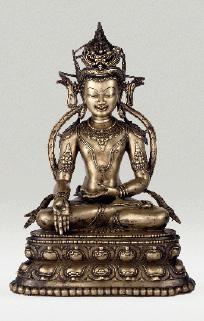
Vairocana, Tibet, 14th century
Expert remark: Compare the closely related pose, dress, jewelry, expression, hairstyle, and crown. Compare also the related subject, depicting another of the Five Dhyani Buddhas, and lotus base. Note the closely related size (30.5 cm).

AUCTION RESULT COMPARISON
Type: Closely related
Auction: Christie’s New York, 23 March 2010, lot 222
Price: USD 56,250 or approx. EUR 74,000 converted and adjusted for inflation at the time of writing
Description: A bronze figure of Ratnasambhava, Western Tibet, 14th/15th century Expert remark: Compare the closely related subject, pose, hand gestures, dress, jewelry, lotus base with beaded upper rim, expression, hairstyle, and crown. Note the gemstone inlays, silver-inlaid eyes, and slightly larger size (38.1 cm).
Estimate EUR 24,000
Starting price EUR 12,000
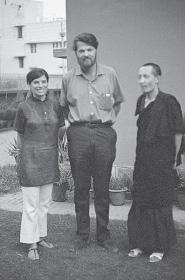
254 169
Susan and John Huntington in New Delhi with Domo Geshe Rimpoche, then Director of Tibet House Museum, 1970
Published: John C. Huntington and Dina Bangdel, The Circle of Bliss: Buddhist Meditational Art, Columbus, 2003, page 108, figure 1.


170
A COPPER ALLOY FIGURE OF AMITAYUS, NEPAL, C. 14TH-15TH CENTURY OR EARLIER
Remarkably solid cast with a total weight of almost 2 kilograms. The Lord of the Western Paradise seated in dhayanasana on a lotus base with neatly incised petals atop a footed and pierced pedestal, holding the amrita vase in his lap. Dressed in a sanghati with the folds elegantly arranged below the ankles and wearing a shawl drawn across the body. The face with heavy-lidded eyes below finely incised brows, adorned in beaded jewelry, the hair in a tall chignon behind a foliate tiara, and backed by a flaming mandorla.
Provenance: From a French private collection. A noted Hungarian collector, acquired from the above.
Condition: Good condition with significant old wear, scattered nicks and dents, light surface scratches, small cracks to the mandorla, and expected casting flaws. Remnants of blue pigment in the hair and tiny remnants of gilt on the left ear and crown. Fine, naturally grown, copperred patina overall.
Weight: 1,868 g
Dimensions: Height 18.2 cm
Expert’s note: The present sculpture appears to be an ancient copy of an even older Nepalese bronze, with several distinct features from works of the 9th and 10th century, including the incised lotus petals, the foliate crown, the beaded jewelry, the shawl and garment. See for example Bonhams Hong Kong, 7 October 2019, lot 805 (fig. 1), and Sotheby’s New York, 22 September 2020, lot 322. While
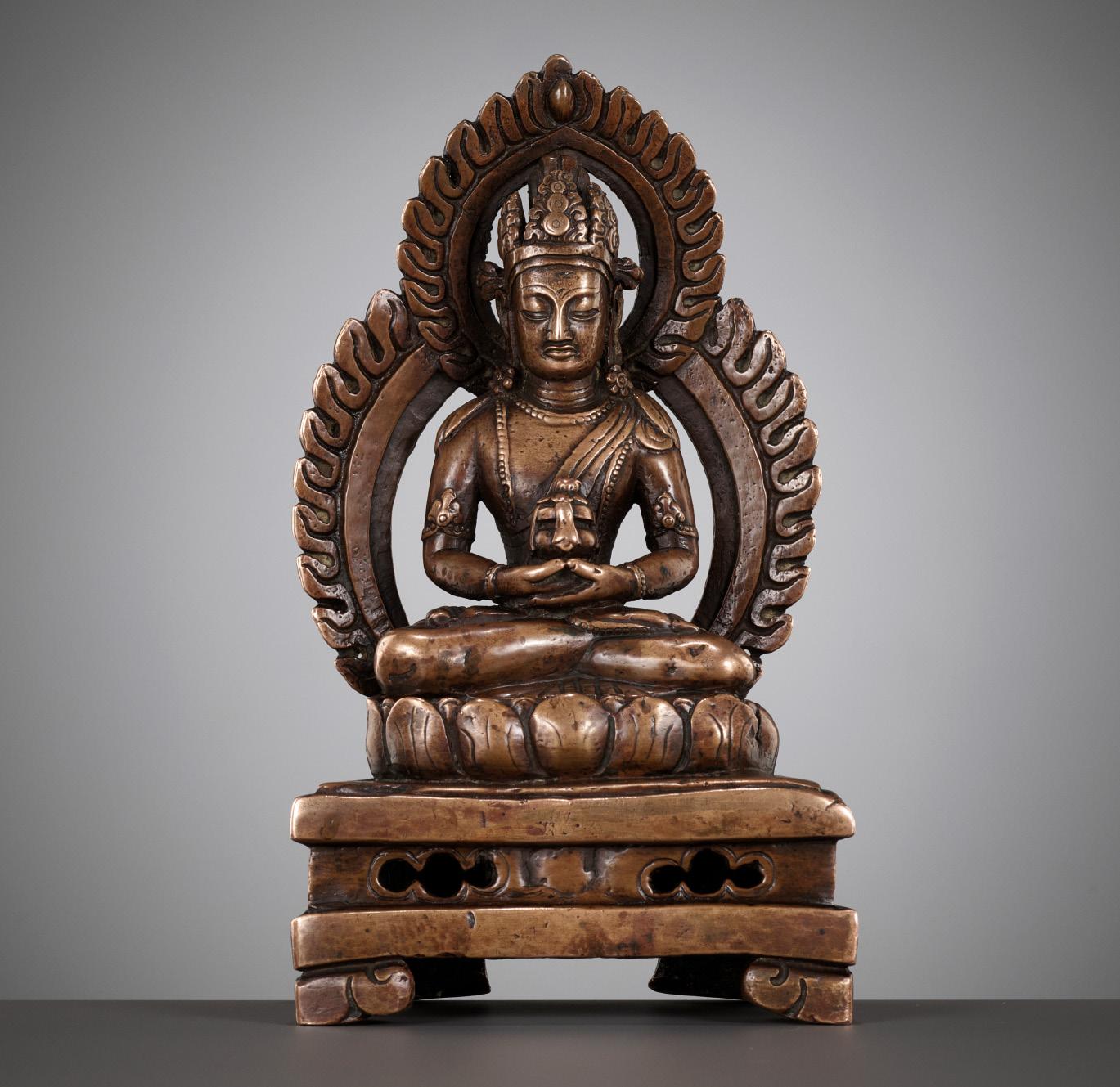
it seems rather difficult to accurately date such a work, it was clearly made not much later than the 15th century, as evidenced by the heavy weight of the cast, the characteristic old wear including the many small nicks and dents, as well as the finely incised yet sparse detail work, which does not appear in this distinct setting on later works.
AUCTION RESULT COMPARISON
Type: Closely related
Auction: Christie’s New York, 19 March 2013, lot 340
Price: USD 52,500 or approx. EUR 65,000 converted and adjusted for inflation at the time of writing
Description: A bronze figure of Amitayus, Nepal, circa 13th century

Expert remark: Compare the closely related expression, the jewelry with especially similar earrings and crown, and the distinct patina color of the copper alloy. Note that the figure itself is larger (18.7 cm) than the present lot if you discount the base and mandorla.
Auction result comparison:
Type: Related
Auction: Christie’s Paris, 15 December 2010, lot 321
Price: EUR 63,400 or approx. EUR 83,000 adjusted for inflation at the time of writing
Description: A rare gilt-copper figure of Manjushri, Nepal, 14th/15th century

Expert remark: Note the closely related size (18.5 cm)
Estimate EUR 12,000
Starting price EUR 6,000
257
fig. 1
A GILT BRONZE FIGURE OF BUDDHA SHAKYAMUNI, 15TH CENTURY, PUBLISHED BY SCHROEDER
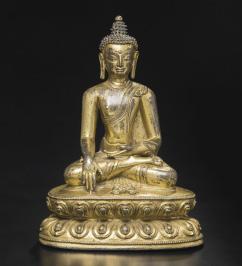
Published: Ulrich von Schroeder, Indo-Tibetan Bronzes, Hong Kong, 1981, page 430, no. 113A (illustrated).


Central Tibet. Finely cast, seated in dhyanasana on a double lotus base with beaded upper rim, his right hand lowered in bhumisparsha mudra and his left held in dhyana mudra above his lap, dressed in a diaphanous sanghati draped over his left shoulder with the hems neatly incised with a foliate pattern and the folds elegantly piled below the ankles. The face with heavy-lidded eyes below elegantly arched brows centered by a raised urna and flanked by elongated pierced earlobes, the hair in tight curls over the ushnisha and topped with a jewel.
Provenance: From the collection of Mr. and Mrs. John Marsing, and thence by descent in the family. John Marsing (1918-1998) was a Danish businessman who, at the age of 20, had established a pharmaceutical company, Marsing & Co. The firm expanded during the mid-20th century and had branches all over Europe, Canada, and Korea. Marsing was very interested in Asian culture and a passionate collector of Asian works of art, particularly from the Himalayas, China, and Korea. He built a substantial collection over decades, buying in Asia and from antique dealers in Denmark as well as auction houses all around Europe.

Condition: Very good condition with minor old wear and some casting irregularities, small dents, few minuscule nicks, the base unsealed.
Weight: 601 g
Dimensions: Height 15 cm
AUCTION RESULT COMPARISON
Type: Related
Auction: Christie’s New York, 19 March 2013, lot 408
Price: USD 81,250 or approx. EUR 94,000 converted and adjusted for inflation at the time of writing

Description: A bronze figure of Buddha Shakyamuni, Tibet, 15th century
Expert remark: Compare the closely related pose, sanghati with incised hems, face, ushnisha with jewel finial, and elongated pierced earlobes, as well as the related size (17.7 cm). Note the slightly different lotus base.
AUCTION RESULT COMPARISON
Type: Related
Auction: Sotheby’s New York, 16 March 2016, lot 709
Price: USD 23,750 or approx. EUR 26,500 converted and adjusted for inflation at the time of writing
Description: A gilt-bronze seated figure depicting Shakyamuni Buddha, Tibet, 15th century

Expert remark: Compare the closely related pose, sanghati with incised hems, face, ushnisha with jewel finial, and elongated earlobes, as well as the related size (17.5 cm). Note the slightly different lotus base with vajra at the top.
Estimate EUR 10,000
Starting price EUR 5,000
258
171
John Marsing (1918-1998)


A MAGNIFICENT GILT BRONZE FIGURE OF MAITREYA, 17TH CENTURY, PUBLISHED BY


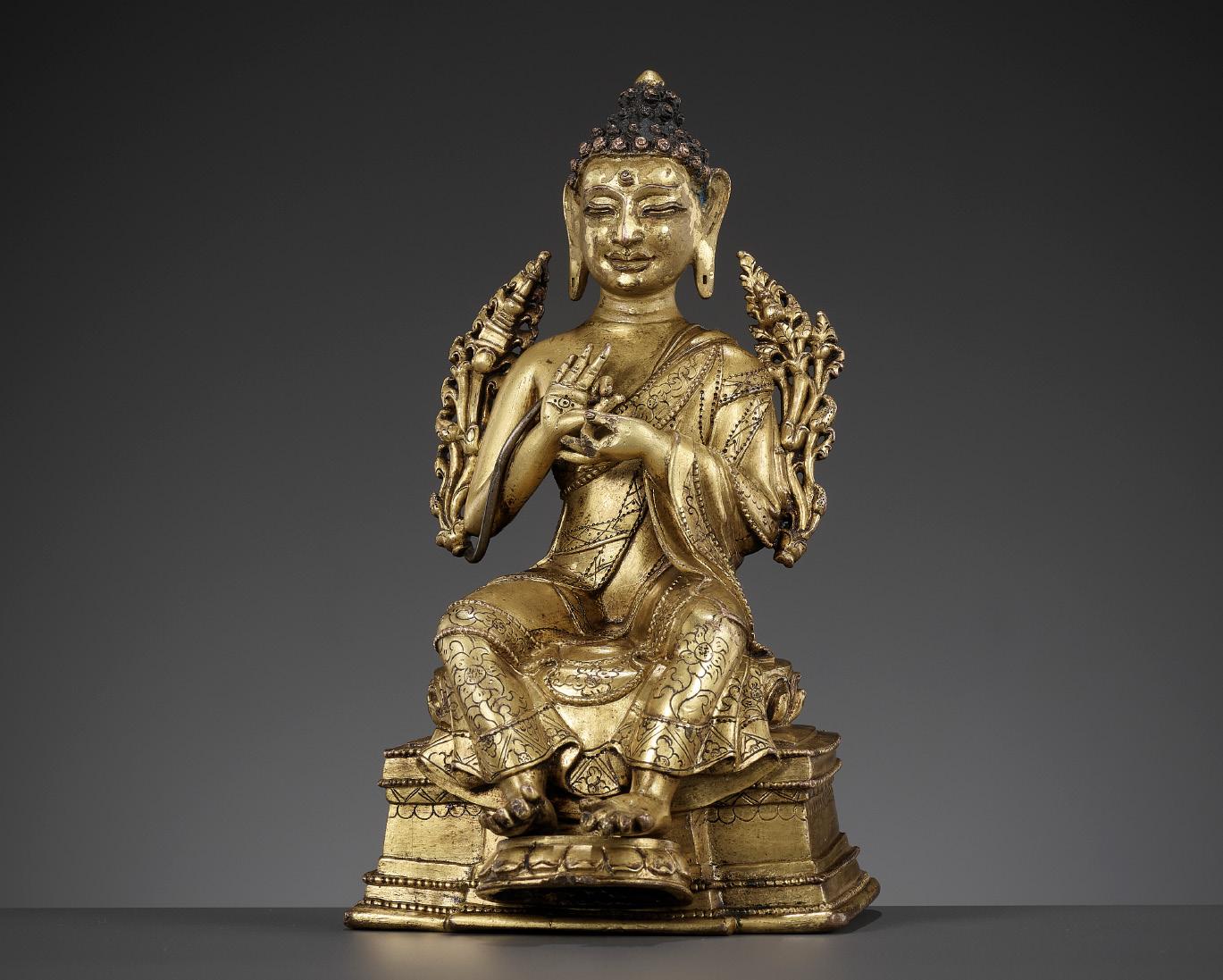 SCHROEDER
SCHROEDER
Published: Ulrich von Schroeder, Indo-Tibetan Bronzes, Hong Kong, 1981, pages 446-447, nos. 121D & E (illustrated).
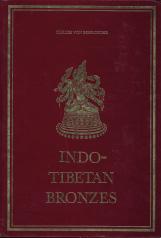
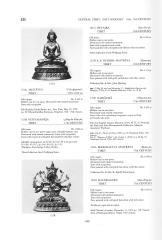
Central Tibet. Finely cast, seated in bhadrasana (‘European pose’) on a stepped rectangular throne with his feet resting on a lotus blossom, the hands in dharmachakramudra holding the stems of lotuses flowering along his upper shoulder supporting a flask and stupa, clad in a richly pleated robe neatly incised with geometric and floral designs. His serene face with sinuously lidded downcast eyes below gently arched brows centered by a raised urna and bow-shaped lips, flanked by long pierced earlobes. The hair arranged in tight curls, the high ushnisha surmounted by a jewel.
AUCTION RESULT COMPARISON
Type: Related
Auction: Christie’s New York, 23 March 2022, lot 424
Price: USD 44,100 or approx. EUR 40,500 converted at the time of writing
Description: A gilt-bronze figure of Maitreya, Tibet, 17th-18th century
Expert remark: Note the larger size (26.7 cm) and that the bronze depicts Maitreya in his more common bodhisattva form, unlike the present lot.
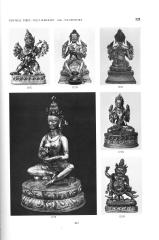 John Marsing (1918-1998)
John Marsing (1918-1998)

Provenance: From the collection of Mr. and Mrs. John Marsing, and thence by descent in the family. John Marsing (1918-1998) was a Danish businessman who, at the age of 20, had established a pharmaceutical company, Marsing & Co. The firm expanded during the mid-20th century and had branches all over Europe, Canada, and Korea. Marsing was very interested in Asian culture and a passionate collector of Asian works of art, particularly from the Himalayas, China, and Korea. He built a substantial collection over decades, buying in Asia and from antique dealers in Denmark as well as auction houses all around Europe.
Condition: Good condition with some wear and casting irregularities, small dents, minor losses, remnants of pigment. The base sealed.
Weight: 987 g
Dimensions: Height 17.5 cm

Maitreya awaits the day when the teachings of the Gautama Buddha, Shakyamuni, are forgotten by earth’s inhabitants, at which point he will descend from the Tushita Heaven to become a Buddha. The present lot exudes reassurance through his benevolent facial expression and graceful gesture. It depicts Maitreya in his Buddha form, which is much rarer than the more commonly encountered bodhisattva form
AUCTION RESULT COMPARISON
Type: Related
Auction: Bonhams New York, 16 March 2015, lot 28
Price: USD 35,000 or approx. EUR 40,000 converted and adjusted for inflation at the time of writing
Description: A gilt copper alloy figure of Maitreya, Tibet, 16th/17th century
Expert remark: Note the slightly larger size (21.8 cm) and that the bronze depicts Maitreya in his more common bodhisattva form, unlike the present lot.
Estimate EUR 20,000
Starting price EUR 10,000
261 172
173
A
GILT BRONZE FIGURE OF CHAKRASAMVARA, LATE MALLA, THREE KINGDOMS PERIOD
Nepal, 1520-1768. Striding in alidhasana with his consort Vajravarahi in yab-yum, the four-headed deity surmounted by a skull crown, his primary hands embracing his consort and holding a vajra and ghanta, the other ten hands holding attributes including damaru, kapala, kartika, and katvanga, dressed in a beaded loincloth, his legs flanked by two billowing scarfs, Vajravarahi wearing an elaborate skirt with skull pendant. Their faces finely incised with gently arched eyebrows centered by an urna, with almond shaped eyes, and a subtle smile.
Provenance: British trade.
Condition: Very good condition with expected old wear to the gilt, minimal losses, minor casting flaws, and few small malachite encrustations. The stand with few chips to the edges and natural age cracks.
Weight: 1,269 g (incl. stand)
Dimensions: Height 20.4 cm (incl stand)
With a fitted hardwood base, probably Zitan, finely carved as a double lotus throne. (2)
The Three Kingdoms period - the time of the later Mallas - began in 1520 and lasted until the mid-eighteenth century. The complete flowering of the unique culture of the Kathmandu Valley occurred during this period, and it was also during this time that the old palace complexes in the three main towns achieved much of their present-day forms. The kings still based their legitimate rule on their role as protectors of dharma, and often they were devout donors to religious shrines. Kings built many of the older temples in the valley, gems of late medieval art and architecture, during this final Malla period. The present figure seems to be rather early in the period, e.g.,16th to mid-17th century.
The vision of Twelve-armed Samvara in an ecstatic, dance-like embrace with his consort Vajravarahi is one of the most exquisite subjects in
Vajrayana Buddhist art. Meaning ‘Wheel of Bliss’ in Sanskrit, the union of the two deities is known as Chakrasamvara, as represented in this nearcomplete example. The deities embody the attainment of the highest yoga tantra tradition and Tibetan Buddhism’s supreme ideal: the skilled union of perfect wisdom (Vajravarahi) and compassion (Samvara).
Being so complex, only the very best artists were fit to undertake the challenge of casting Chakrasamvara. The task most often fell to Newari master craftsmen from Nepal who produced such sculptures for domestic and Tibetan worship. The stylistic preferences of each audience are somewhat slightly different. While many contemporaneous Tibetan examples emphasize the ferociousness of Chakrasamvara’s facial expressions, here instead, a benign intimacy is shared between the deities gazing into each other’s eyes. The sentiment betrays a preference in Nepal for showing divine couples in harmony, as representatives of ideal matrimony.
Literature comparison: Compare a related two-armed gilt bronze figure of Chakrasamvara, Nepal, 16th century, in the collection of the British Museum, museum number 1921,0219.1.
AUCTION RESULT COMPARISON
Type: Related
Auction: Christie’s New York, 15 September 2015, lot 35
Price: USD 32,500 or approx. EUR 39,000 converted and adjusted for inflation at the time of writing
Description: A gilt bronze figure of Durga, Nepal, 16th/17th century Expert remark: Compare the related motif, gilt accents, fine casting work, and stand. Note the size (16.5 cm).

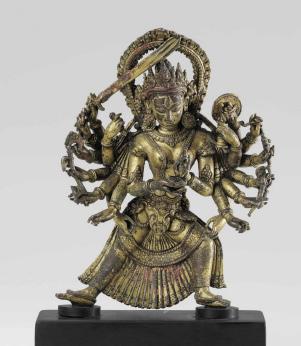
Estimate EUR 6,000
Starting price EUR 3,000
262
A PARCEL-GILT SOLID SILVER FIGURE OF SHADAKSHARI LOKESHVARA, PALA REVIVAL, TIBET, 17TH-18TH CENTURY

Opinion: This is probably a rather important commission because during the Pala revival era, Buddhist images that were cast in solid silver were extremely scarce. Most only contain a small amount of silver inlay instead. This may also suggest that this is an early example, as solid silver images were more prevalent in Tibet before the 17th century.

Seated in dhyanasana on a double lotus base with beaded rim, his principal hands in anjali mudra, the secondary hands holding a lotus flower and forming the vitarka mudra. Dressed in a diaphanous dhoti, richly adorned with fine beaded jewelry. The cold-gilded face with a serene expression and downcast eyes below gently arched brows, centered by an urna, flanked by elongated earlobes suspending two circular earrings, the hair tied in a high chignon secured by a foliate tiara. Note the finely gilt inlay work to both legs.
Provenance: From a private collection in Belgium.
Condition: Very good condition with old wear and casting irregularities, expected tarnishing to the silver, few minuscule nicks, rubbing to gilt, one of the celestial scarves possibly with a minor old repair.
Weight: 301.8 g
Dimensions: Height 13 cm
This figure follows Indian Pala period bronze prototypes, of which various examples were in the Chinese Imperial collection and which inspired the production of revival pieces during the first half of the Qing dynasty not only in Tibet, but also at the workshops of the Qing Imperial Court. It is an image of Shadakshari Lokeshvara, a form of the merciful and compassionate Bodhisattva Avalokiteshvara. This form of the deity is the ‘patron saint’ of Tibet and is known as the Lokeshvara of the Six Mystical Syllables: om mani pad me hum (Hail to the jewel in the lotus). All Dalai Lamas are believed to be reincarnations of Shadakshari Lokeshvara. In the 17th century in Tibet, silver was seen as more precious than gilt bronze, and the process of obtaining silver was considerably more laborious than that for obtaining gold. As such, statues cast in solid silver were viewed as lavish, and were almost certainly commissions to accompany prayers for the favorable rebirth of an important loved one.
AUCTION RESULT COMPARISON
Type: Closely related
Auction: Bonhams Hong Kong, 2 Oct 2018, lot 77
Estimate: HKD 300,000 or approx. EUR 38,000 converted and adjusted for inflation at the time of writing
Description: A silver figure of Amitayus, Tibet, 17th/18th century
Expert remark: This comparable shows a figure, while of arguably lower quality, that dates to the same era in Tibetan history, and is of a related scale. Note the slightly smaller size (10.5 cm).
Estimate EUR 6,000
Starting price EUR 3,000
263 174

175
A LARGE GILT BRONZE FIGURE OF TSONGKHAPA, 17TH-18TH CENTURY

Tibetan-Chinese. The heavily cast figure weighs over 6 kilograms and is applied overall with a fine gilding. Seated in dhyanasana on a sealed double-lotus base, the hands held in dharmachakra mudra. He is wearing loose-fitting monastic robes cascading in voluminous folds and neatly incised at the hems with foliate designs as well as a pandita hat with the lappets hanging over the shoulders. His serene face with heavy-lidded eyes below gently arched brows and full lips forming a calm smile. The seal plate finely incised with a double vajra.
Provenance: From a private collection in Paris, France.
Condition: Very good condition with some wear to gilt, minor casting irregularities, few minuscule nicks here and there, occasional light scratches. Fine, naturally grown patina overall. Sealed.
Weight: 6,058 g
Dimensions: Height 30.8 cm
Tsongkhapa (1357-1419) is widely regarded in Tibet as a second Buddha and the main teacher of the first Dalai Lama, Gendun Drub (1391-1474). An eminent scholar, he reformed the old Kadampa sect, creating the new Gelugpa sect (Yellow Hat), and is the founder of the monasteries Ganden, Drepung, and Sera. He is revered as an emanation of the Buddhist god of wisdom, Manjushri. Although the present bronze image lacks his attributes of the sword and the book, he is clearly recognizable by the pronounced facial features, for which Tsongkhapa was also known.
AUCTION RESULT COMPARISON
Type: Closely related
Auction: Christie’s Paris, 7 December 2007, lot
367
Price: EUR 31,450 or approx. EUR 40,000 adjusted for inflation at the time of writing
Description: A gilt-bronze figure of Tsongkhapa, Tibeto-Chinese, 17th/18th century
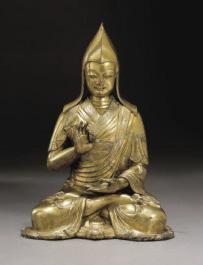
Expert remark: Note the similar size (30 cm) and the missing base
Estimate EUR 8,000
Starting price EUR 4,000
265
A RARE GILT BRONZE FIGURE OF VARAHA, NEPAL, 16TH-17TH CENTURY


Cast striding on a nagaraja above a lotus base, dressed in a loin cloth, adorned with beaded jewelry and bangles, his left arm raised supporting the goddess Bhudevi, his face in the form of a boar with long snout and two protruding fangs, standing on a coiled snake next to a small depiction of Buddha Muchalinda. The base sealed and incised with a double vajra.
Provenance: From the private collection of Angela Trueb, Somerset, United Kingdom, and thence by descent in the same family. Angela Trueb (19181991) was the wife of Swiss coffee planter Hans Trueb. During her childhood, she spent many years in a coffee estate in Doddengudda, South India, and later moved to India again with her husband. Trueb inherited her mother’s passion for Indian religious sculptures and art. During her stay in India, Trueb invested a lot of time and energy into researching Indian temple sites and started her collection, which was later moved to her home when her family returned to Somerset in 1967.

Condition: Very good condition with expected old wear, few nicks and dents, light surface scratches, and casting flaws. Very good, naturally grown patina overall. Sealed.
Weight: 646.5 g
Dimensions: Height 14.1 cm
The present figure depicts Vishnu as the cosmic boar Varaha telling the scene where the god prevents the earth from flooding. The earth goddess Bhudevi was captured by the demon Hiranayaksha and trapped in the cosmic waters when Vishnu took the form of a divine boar and rescued her after defeating the primeval serpent monster.
AUCTION RESULT COMPARISON
Type: Related
Auction: Christie’s New York, 15 September 2015, lot 22
Price: USD 12,500 or approx. EUR 15,000 converted and adjusted for inflation at the time of writing
Description: A gilt bronze figure of an animalheaded attendant, Tibet, 16th/17th century Expert remark: Compare the related pose, beast head, and size (15 cm)
Estimate EUR 4,000
Starting price EUR 2,000
266 176
Angela Trueb (1918-1991)
177
A
PARCEL-GILT

REPOUSSÉ
Tibet. The striding beast with a fierce expression, bulging eyes below flaming brows, the mouth revealing a set of sharp fangs below a ruyi shaped snout. The finely detailed flaming mane, tail, mouth, and bell nicely picked out. The head and body cast separately and joined with rivets.
Provenance: From the private collection of Jan Finch. Jan Ellen Finch (1952-2021) was a celebrated art and antiques dealer who started out in Portobello Market during the 1980s. Her company Finch & Co became one of the best-known and most charismatic dealerships of the modern era. The firm’s rigorously researched and hugely informative catalogs became the mainstay of many dealers’ and collectors’ libraries. Her private collection included numerous curiosities and rare examples of Asian and ethnographic art, European sculptures, and modern British art. Condition: Good condition, commensurate with age and the generally fragile nature of repoussé works, with some old wear, minor tears and small losses, dents and nicks, minute cracks, some added pinholes for suspension, few malachite encrustations. Remnants of ancient pigment.
Weight: 2,590 g (excl. base), 5,600 g (incl. base)
Dimensions: Length 42.6 cm
Mounted to a modern metal base. (2)
AUCTION RESULT COMPARISON
Type: Closely related
Auction: Christie’s New York, 31 March 2005, lot 193
Price: USD 9,000 or approx. EUR 13,000 converted and adjusted for inflation at the time of writing
Description: A Gilt Copper Repoussé Lion, Tibet, circa 17th century Expert remark: Compare the closely related pose and picked-out details. Note the related size (47 cm).

AUCTION RESULT COMPARISON
Type: Related
Auction: Bonhams London, 14 May 2009, lot 159
Price: GBP 13,200 or approx. EUR 24,500 converted and adjusted for inflation at the time of writing
Description: A pair of gilt-copper repoussé ‘lion’ panels, Tibet, 19th century



Expert remark: Compare the related motif. Note that the lot comprises two pieces of larger size (62.7 cm).
Estimate EUR 3,000
Starting price EUR 1,500
267
LARGE
COPPER
PLAQUE OF A SNOW LION, 17TH-18TH CENTURY
The interior of Finch & Co, ca. 1960
A PAIR OF GILT AND POLYCHROMEDECORATED COPPER REPOUSSÉ PLAQUES DEPICTING ‘PRECIOUS ELEPHANTS’, HASTIRATNA, 17TH-18TH CENTURY
Tibet. Each caparisoned elephant shown standing with the head turned to one side, the back supporting the Three Jewels over an elaborate saddle cloth decorated with foliate scroll and suspending beaded and floral jewelry, wearing a bell around the neck, finely detailed with red and green pigment. (2)

Provenance: Collection de Monsieur E., a private collection of Tibetan bronzes in France.
Condition: Very good condition with minor wear and manufacturing irregularities, rubbing to gilt and pigments, few small dents and tiny nicks.
Weight: 402 g (total)
Dimensions: ca. 29 x 27 cm (each)
Elephants are symbols of majesty, power, endurance, self-control, and gentleness in Buddhism. The present lot more specifically represents the Precious Elephant, which is one of the Seven Treasures of the chakravartin, or ‘universal monarch’. The mythical concept of the Buddhist chakravartin originated in India, where rulers rode elephants in both battle and peaceful processions. For further discussion of the chakravartin, see Beer, The Encylopedia of Tibetan Symbols, 1999, page 163.
Auction result comparison:
Type: Related
Auction: Bonhams, 2 October 2012, lot 1639
Price: USD 6,250 or approx. EUR 7,500 converted and adjusted for inflation at the time of writing
Description: A gilt copper alloy bronze ‘precious elephant’, hastiratna, Tibet, 17th century
Expert remark: Compare the closely related subject. Note that the lot comprises only a single elephant, cast in the round, and is of much smaller size (20.3 cm).
AUCTION RESULT COMPARISON
Type: Related
Auction: Christie’s New York, 23 March 2012, lot 1793
Price: USD 20,000 or approx. EUR 23,500 converted and adjusted for inflation at the time of writing
Description: A Gilt Repousse Copper Plaque of a Caparisoned Elephant, Ming Dynasty (1368-1644)

Expert remark: Compare the related subject, and the repoussé technique. Note the similar size (25.4 cm) and the fact that this example may be slightly earlier than the present lot.
Estimate EUR 4,000
Starting price EUR 2,000
268 178
A CAST AND REPOUSSÉ GILT COPPER ALLOY FIGURE OF TARA, NEPAL, 18TH-19TH CENTURY
The four-armed deity seated in lalitasana on a double-lotus base with beaded upper rim, the main left hand held in vitarka mudra and the main right lowered in varada mudra, the other two hands holding a short staff and sutra. The palm of one hand and sole of one foot each incised with a stylized flowerhead. She is dressed in a diaphanous robe and billowing scarves, and richly adorned with beaded jewelry.
Provenance: From the Folker Collection, Denmark. Mr. Folker, an industrialist and well-known collector of Himalayan art, bought from Danish dealers and noted auctioneers such as Lau Sunde and Bruun Rasmussen.
Condition: Good condition with minor wear and casting irregularities, small dents, minuscule nicks, minor losses, rubbing to gilt, the base unsealed.
Weight: 903 g
Dimensions: Height 17 cm
Her serene face with sinuously lidded eyes, gently arched brows, a raised urna, and bow-shaped lips forming a calm smile, flanked by elongated earlobes with large circular earrings, the hair arranged in a topknot with a vajra finial behind the foliate tiara, the head backed by a mandorla.
AUCTION RESULT COMPARISON
Type: Related
Auction: Christie’s New York, 13 September 2011, lot 326
Price: USD 10,625 or approx. EUR 12,500 converted and adjusted for inflation at the time of writing
Description: A gilt bronze figure of White Tara, Nepal, 18th century


Expert remark: Compare the closely related base, mandorla, and repoussé elements, as well as the related size (18.7 cm). Note the different pose and number of arms.
Estimate EUR 6,000
Starting price EUR 3,000
269 179
A GILT BRONZE FIGURE OF THE THIRD CHANGKYA HUTUKTU, ROLPAI DORJE (1717-1786)


Tibetan-Chinese, Qianlong period, c. 1750-1770. Heavily cast and finely gilt, seated in dhyanasana atop a double-cushion base with neatly incised foliate designs, the blanket with lotus roundels to the sides, his legs shrouded by his voluminous monastic robes with incised foliate hems. He is wearing a broad miter headdress and holding a vajra in his raised right hand, while his left is held in karana mudra and resting on his lap. His serene face with finely painted details such as heavy-lidded eyes, arched brows, and full lips, and further with subtle bumps to the forehead and right cheek.
Provenance: From the collection of Inger Lissanevitch, and thence by descent. Inger Lissanevitch (née Pheiffer, 1928-2013) was the wife of Boris Lissanevitch, a Russian ballet dancer, hotelier, and restaurateur who opened Nepal’s first hotel, The Royal Hotel, in 1951. The Danish Inger met Boris at his 300 Club in Kolkata in the late 1940s. They were married in Copenhagen in December 1948 and returned immediately to India. In 1951, they relocated to Kathmandu following the downfall of the Rana regime and the return from exile of their friend, King Tribhuvan (1906-1955). Boris opened The Royal Hotel in what is now the Election Commission offices in central Kathmandu. He persuaded Tribhuvan to issue the first tourist visas to Nepal and played host to a range of famous mountaineers and dignitaries and even orchestrated the state visit of Queen Elizabeth and Prince Philip to Nepal in 1961. Inger played an important role in the day-to-day running of the family and hotel: that of Boris’ long-suffering accountant. “He was a terrible businessman,” she once remarked in an interview, “he didn’t think about money at all, so that was left to me.” Her affection for her husband was impossible to dispute, however, and was rivaled only by that which she felt for her beloved Kathmandu. After Boris’ passing in 1985, Inger continued to live in Nepal for the rest of her life. Condition: Very good condition with expected old wear, the lotus inserts at the shoulders lost, minuscule nicks, light surface scratches, minor rubbing to gilt, the seal plate possibly a later replacement. Fine, naturally grown, smooth patina, showing signs of extensive worship and caress. The interior with sacred contents, probably original to the statue.

Weight: 1,536 g
Dimensions: Height 17.2 cm
The present bronze was commissioned to honor the most important Tibetan lama at the 18th-century Qing court, the Third Changkya Hutuktu, Rolpai Dorje (1717-1786). The identification is facilitated by the distinctive congenital bump on his lower right cheek. Meanwhile, the bronze is also comprised of the same hat and iconography that typify his sculptures. By each of his arms is a lotus holder that would have supported two separately cast lotus stems, with a sword emerging from the flower on his right side, and a book on his left. This iconographic arrangement arises from his being considered a manifestation of Manjushri.
The Changkya Hutuktu is a Gelug incarnate lineage with its seat at Changkya in Kham, Eastern Tibet. ‘Hutuktu’ is a Mongolian word meaning ‘spiritual master’. At an early age, Rolpai Dorje was recognized as the reincarnation of Ngawang Losang Choden (1642-1714), the previous Changkya Hutuktu and spiritual adviser of the Kangxi Emperor. Raised and educated in the imperial court of the Yongzheng Emperor, Rolpai Dorje grew up with prince Hongli who later became the Qianlong Emperor. A trusted advisor of the Emperor, and fluent in Tibetan, Manchu, Chinese, and Mongolian, Rolpai Dorje played a crucial role in the relations between Tibet, China, and Mongolia, and influenced the policies of all three countries.
Also remembered as a prominent scholar and translator, Rolpai Dorje organized the translation of the entire Tripitaka into Mongolian, Chinese, and Manchu. He was also involved in the artistic projects of the imperial workshops, and the design of monasteries and temples created during the Qianlong reign. Furthermore, he oversaw the cataloging of the palace collection of Buddhist bronzes and paintings. To commemorate his death, the Emperor built a massive funerary temple at Mount Wutai, a sacred Buddhist site located in Shanxi province, China.
Literature comparison: Compare a related bronze in the Capital Museum, Beijing, published in Gems of Beijing Cultural Relics Series: Buddhist Statues (I), Beijing, 1999, p. 202, no. 169.
AUCTION RESULT COMPARISON
Type: Closely related
Auction: Sotheby’s New York, 22 September 2020, lot 339
Estimate: USD 30,000 or approx. EUR 32,200 converted and adjusted for inflation at the time of writing
Description: A Gilt Copper Alloy Figure of Changkya Rolpai Dorje, Tibet, 18th Century
Expert remark: Compare the related pose, robe, base, and incised details. Note the similar size (16.2 cm).
AUCTION RESULT COMPARISON
Type: Closely related
Auction: Bonhams Hong Kong, 29 November 2016, lot 137
Estimate: HKD 300,000 or approx. EUR 44,500 converted and adjusted for inflation at the time of writing
Description: A Gilt Copper Alloy Figure of the Third Changkya Hutuktu, Rolpai Dorje (1717-1786)
Expert remark: Compare the related pose, robe, base, and incised details. Note the slightly larger size (21 cm).
Estimate EUR 8,000
Starting price EUR 4,000
270 180
Boris and Inger Lissanevitch
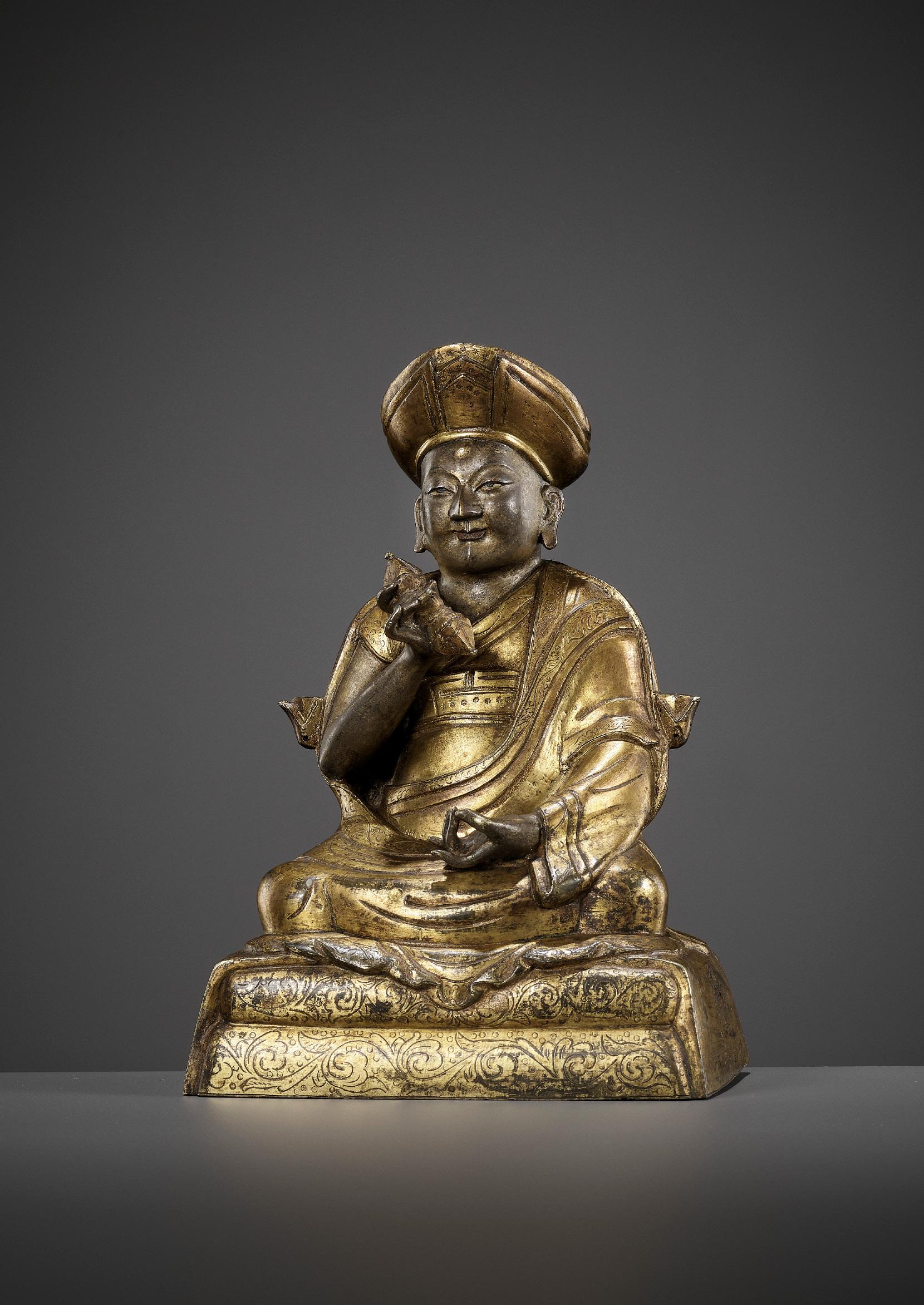
181
A GILT BRONZE FIGURE OF SADBHUJA MANJUSRI, NEPAL, DATED 1853, PUBLISHED BY SCHROEDER
Published: Ulrich von Schroeder, Indo-Tibetan Bronzes, Hong Kong, 1981, page 392, no. 108C (illustrated).

The three-headed and six-armed bodhisattva seated in lalitasana on a double lotus base with beaded upper rim, holding a vajra and bell in his primary hands and a sword, lasso, flower, and jewel emblem in the others. Wearing loose-fitting robes and richly adorned with beaded jewelry, his faces with heavy-lidded eyes, arched brows, urna, and full lips, flanked by long pendulous earlobes with large circular earrings. The hair piled up into a topknot with jewel finial behind the foliate tiara, his diminutive consort seated on one of his legs, all backed by a double-layered arched flaming mandorla.
Inscriptions: The back of the base with a lengthy dedicatory inscription, and dated ‘Newari Samvat 957’ (corresponding to 1853).

The back of the base and mandorla left ungilded and with a fine and rich copper-brown patina. Note that the figure is cast only, with no repoussé elements
Literature comparison: Compare a closely related gilt bronze figure of Sadbhuja Manjusri with consort, 12.5 cm high, dated by inscription to 1819, in the British Museum, registration number 1952,1021.1, illustrated by Ulrich von Schroeder, Indo-Tibetan Bronzes, Hong Kong, 1981, p. 391, no. 107F. Another example of Sadbhuja Manjusri with consort, which also shares the double-layered arch, is illustrated ibid., p. 389, no. 106F.
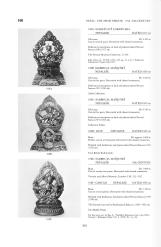
AUCTION RESULT COMPARISON
Type: Closely related
Auction: Bonhams Paris, 14 June 2022, lot 40
Estimate: EUR 25,000
Provenance: From the Folker Collection, Denmark. Mr. Folker, an industrialist and well-known collector of Himalayan art, bought from Danish dealers and noted auctioneers such as Lau Sunde and Bruun Rasmussen.
Condition: Good condition with minor wear, some casting irregularities, small losses, minor dents, minuscule nicks, the base unsealed.
Weight: 1,207 g
Dimensions: Height 17.5 cm

Description: A gilt copper alloy figure of Manjuvara and Prajnaparamita, Nepal, dated 1779
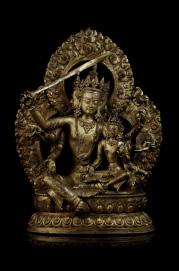

Expert remark: Compare the closely related poses, attributes, base, double-layered arched mandorla, manner of casting and gilding, and dedicatory inscription with dating. Note the larger size (32.5 cm).
Estimate EUR 10,000
Starting price EUR 5,000
272

THE MICHAEL PHILLIPS COLLECTION
PART 1
Lots 182-188
Michael Phillips (born 1943) is an Academy Awardwinning film producer. His most important films include The Sting (winning the Academy Award for Best Picture in 1973), Taxi Driver (winning the Palme d’Or at the 1976 Cannes Film Festival), and Steven Spielberg’s Close Encounters of the Third Kind.


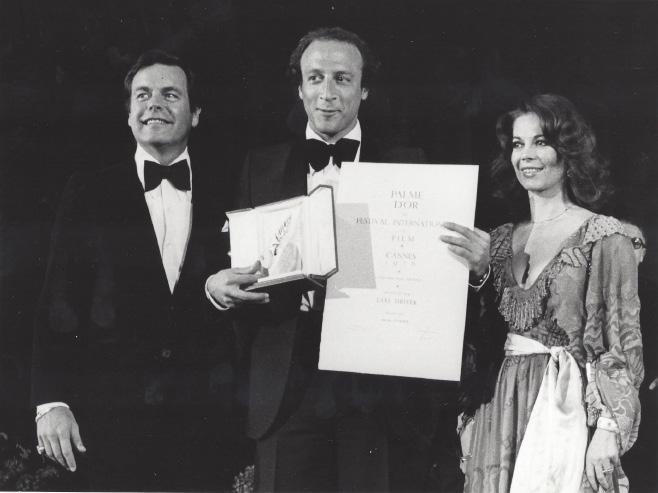
274
Michael Phillips and Queen Elizabeth II
Michael Phillips receiving the Palme d’Or for Taxi Driver at the 1976 Cannes Film Festival
Michael Phillips at the 46th Academy Awards in 1974 after winning the Best Picture Oscar for The Sting
Born in Brooklyn, New York, his parents were Lawrence and Shirley Phillips, noted New York dealers in Asian fine arts, selling to the Met, the LACMA, the Chicago Art Institute, and the British Museum among others. Michael Phillips is a collector of Asian art himself, particularly Indian, Southeast Asian, and Himalayan sculpture.
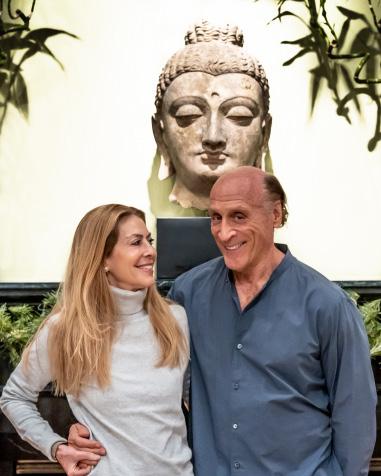


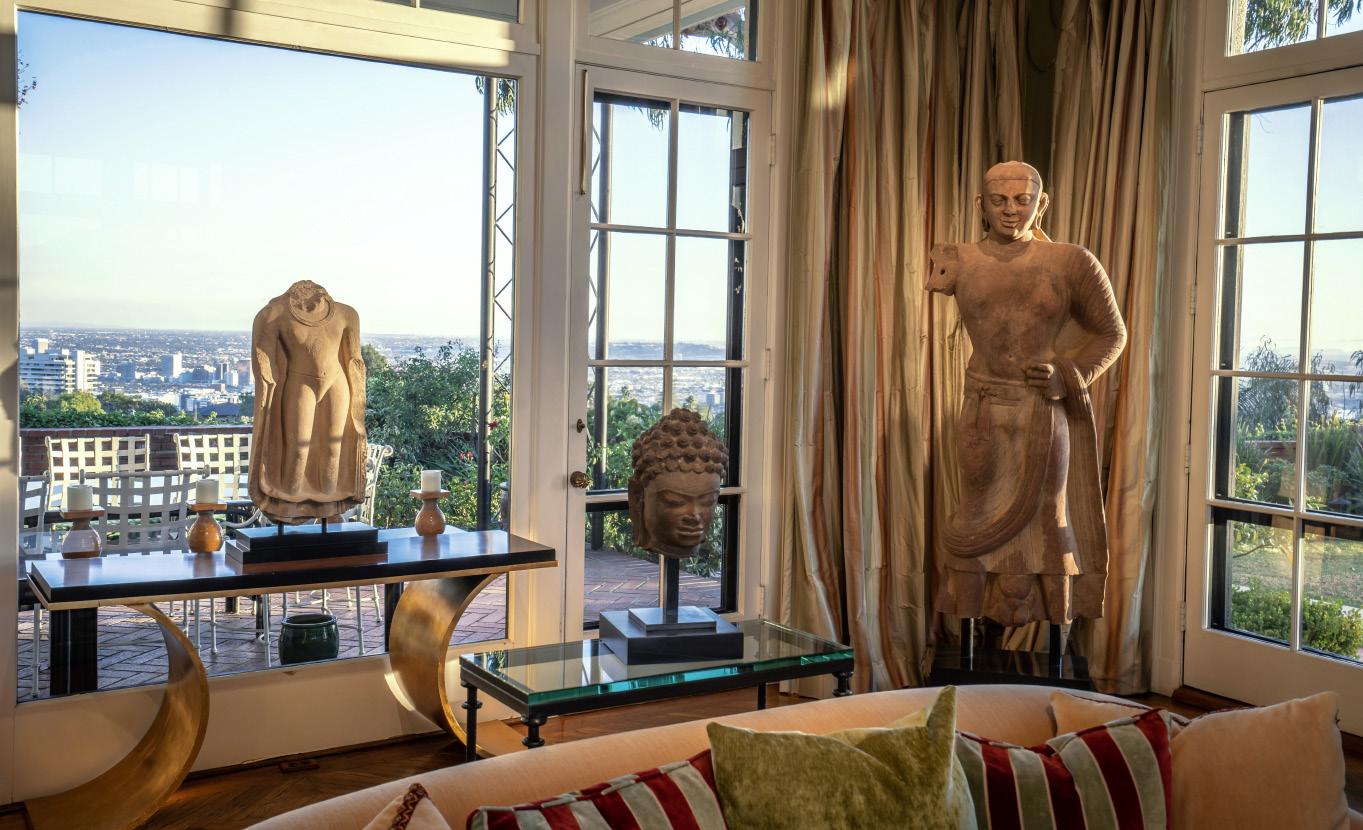
275
Impressions of the collection at the Michael Phillips residence in Beverly Hills – photos copyright Rob H. Aft
Michael Phillips and his wife Juliana Maio
A MONUMENTAL SANDSTONE HEAD OF BUDDHA, NORTHERN WEI DYNASTY, CHINA, 386-534
Opinion: The head is carved from buff sandstone that has the appearance of granite from a distance. The style and material are typical of examples from the Yungang caves and surrounding area.
Published: Stephen Little, Images of the Buddha from the Michael Phillips Collection, Arts of Asia, Jan-Feb 2013, page 112, no. 29.
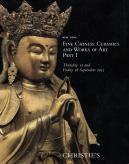


The rounded face deeply carved with small, pursed lips, broad flattened nose and thin, sharply cut eyes, flanked by long pendulous ears, all beneath the simply rendered hair and tall ushnisha. The stone of reddish-brown tone with some crystalline flecks.
Provenance: An American private collection. Christie’s New York, 15-16 September 2011, lot 1360, estimate of USD 60,000 or approx. EUR 72,000 (converted and adjusted for inflation at the time of writing). The private collection of Michael Phillips (born 1943), who is an Academy Awardwinning film producer.
Condition: Good condition, commensurate with age. Extensive wear, losses, nicks, scratches, signs of weathering and erosion.
Scientific Analysis Report: A scientific and technical examination was conducted by John Twilley, art conservation scientist. A copy of the examination report, dated 20 September 2007, accompanies this lot. The report concludes that “the evidence strongly supports a history of natural weathering of the stone, on a scale of centuries rather than decades, subsequent to its carving”. Note that this report is also mentioned in the catalog entry by Christie’s from 15-16 September 2011.
Dimensions: Height 43 cm (excl. stand) and 65 cm (incl. stand)
Mounted on an associated stand. (2)
The first of the formative phases of Buddhist sculpture in China, to which the current sculpture dates, lasted until roughly 495 AD and is represented by the cave temples in the north at Yungang. Over 50,000 statues lay within the Yungang Grottoes and surrounding area. Constructed during the Northern Wei dynasty by the imperial order of Emperor Wencheng, carving in the area began in 460 AD as an act of reparation for the Buddhist persecution of 445-452, and lasted until 494 AD when the capital was moved to Luoyang. The Yungang cliff is formed of horizontal layers of buff-colored sandstone, which lends itself well to sculpture, as well as to the excavation of large caves with horizontal ceilings. The sandstone of this head of Buddha is typical of that found in the Yungang region.
LITERATURE COMPARISON
Compare a polychromed figure of Buddha still in place in Cave 9 of the Yungang Grottoes. Compare a related sandstone head of Buddha with similar features and carved of the same type of stone in The Nelson-Atkins Museum of Art, illustrated in the Handbook of the Collection, Kansas City, 1993, p. 303. Also compare with a ‘yungang’ sandstone head of a bodhisattva, Northern Wei dynasty, at Sotheby’s London, 13 May 2015, lot 18. The use of this comparable, which is rather smaller in size (7 cm), serves as solid proof in tying our example to the Yungang area. The sandstone is of an identical color and texture, and the face has very similar features. It therefore almost certainly places our example amongst the most important Buddhist carvings from the Northern Wei period
AUCTION RESULT COMPARISON
Type: Closely related
Auction: Sotheby’s Hong Kong, 1 April 2018, lot 3029
Price: HKD 3,120,000 or approx. EUR 396,000 converted and adjusted for inflation at the time of writing
Description: A rare and large sandstone head of a Buddha, Northern Wei dynasty
Expert remark: This comparable shows numerous similarities with our example, from the domed ushnisha above the simple outlined hair to the long pendulous ears. Note the related size (40 cm).
AUCTION RESULT COMPARISON
Type: Closely related
Auction: Sotheby’s Hong Kong, 5 April 2016, lot 2814
Price: HKD 625,000 or approx. EUR 82,500 converted and adjusted for inflation at the time of writing


Description: A large ‘yungang’ sandstone head of Buddha, Northern Wei dynasty
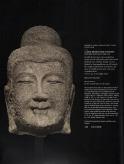

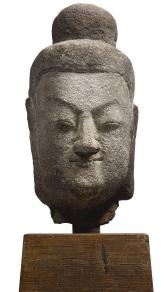

Expert remark: Note the closely related size (43 cm).
Estimate EUR 40,000
Starting price EUR 20,000
276
182
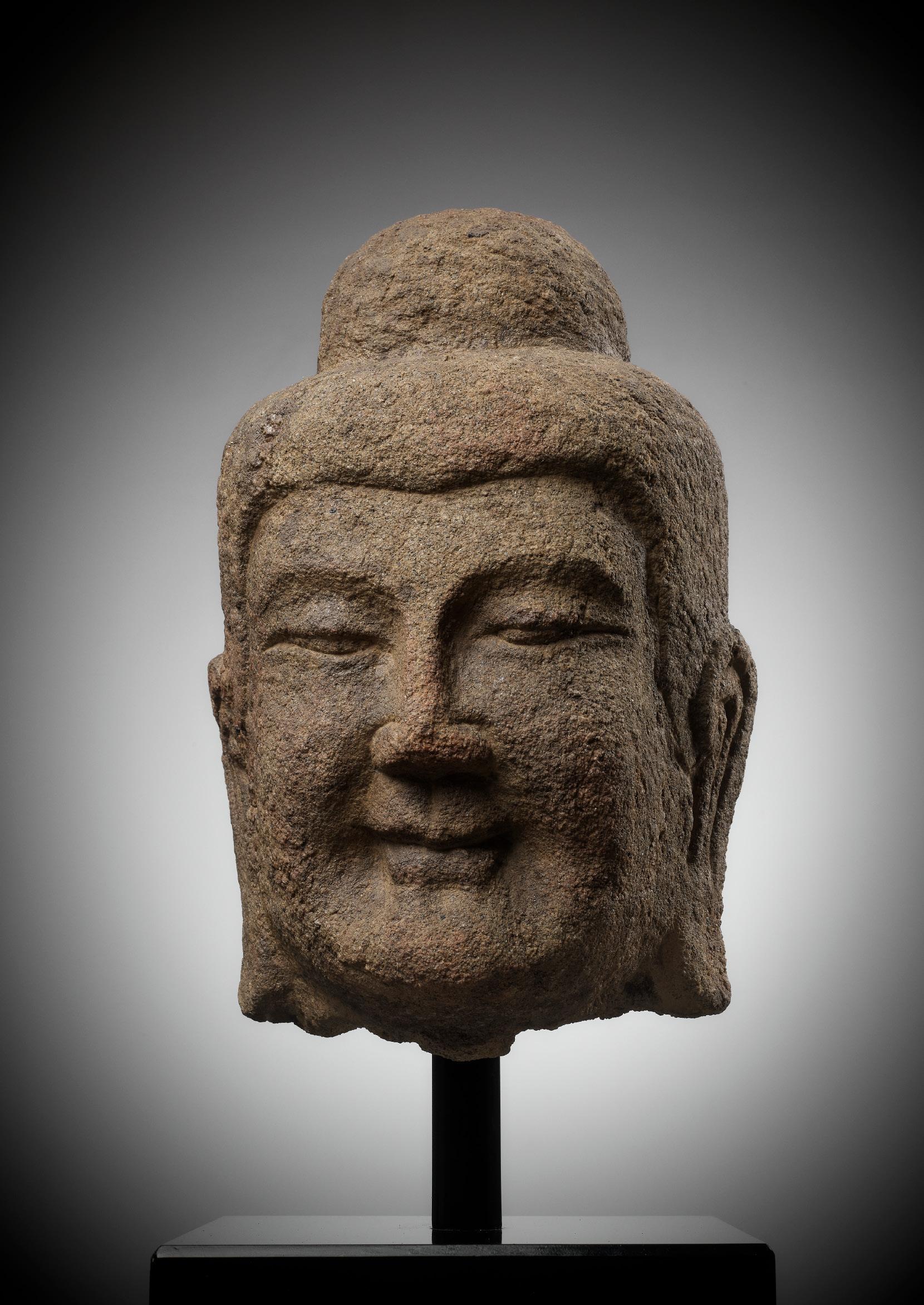
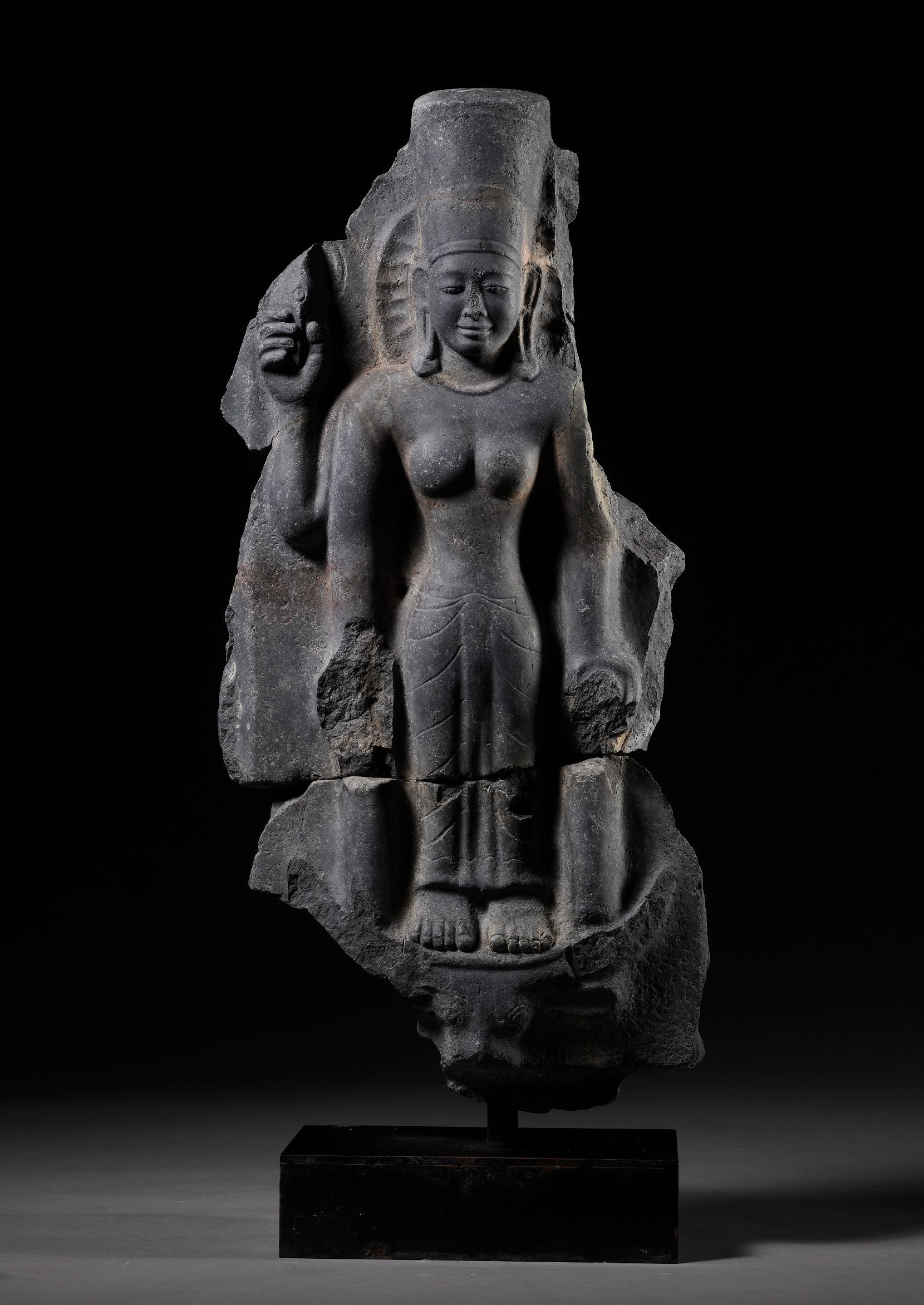
A BLACK STONE FIGURE OF DURGA MAHISHASURAMARDINI, PRE-ANGKOR PERIOD, KHMER, 7TH CENTURY

Opinion: Looking at Phnom Da style sculpture from Southern Cambodia, one can see a great degree of cross-cultural influence. While one could argue that this sculptural style is distinctly of Khmer origin, with such early sites present in Vietnam, we are more likely seeing the spread of sources of foreign cultural influence, bringing things like Hinduism, coming from outside the region and merging with local cultures. Certain attributes of this sculpture in particular can be seen in early Gupta sculpture, such as the 4th century Harihara in the National Museum of New Delhi. It is also interesting to note that the earliest known written texts in Southeast Asia are from Vietnam, written during the 4th century, predating the first Khmer texts by hundreds of years.
Finely carved in relief with four arms holding symbols of power, positioned above the severed head of a buffalo, with a tall crown and pendulous earlobes, backed by a striated nimbus.
Provenance: Spink & Son, London, by 2 November 1999 (according to Christie’s record). Christie’s New York, 20 September 2000, lot 154 (according to Christie’s record). Property from a West Coast collection, acquired from the above (according to Christie’s record). Christie’s New York, 13 September 2016, lot 245, estimate of USD 30,000 or approx. EUR 34,000 (converted and adjusted for inflation at the time of writing). Michael Phillips, acquired from the above in an after-sale transaction. A copy of a Christie’s record, accessed on 1 October 2018, confirming the provenance above, and stating an after-sale purchase price for the present lot of USD 18,750 or approx. EUR 21,000 (converted and adjusted for inflation at the time of writing), accompanies this lot.
Condition: Good condition, commensurate with age. Extensive wear, losses, nicks, scratches, signs of weathering and erosion, structural cracks, old fills.
Dimensions: Height 89 cm (excl. stand) and 97 cm (incl. stand)
Mounted on an associated stand. (2)
Mahishasura was a shape-shifting king who was granted the power of immortality by Lord Brahma. After years of tormenting his people, he was vanquished by a manifestation of the demon-fighting form of Parvati known as Durga. Durga fought Mahishasura over a period of fifteen days during which he kept changing his shape into different animals. She finally vanquished him when he took the form of a buffalo, slaying him with her trident. It is just after this victorious moment that we see Durga depicted here, with the severed head of Mahishasura laying at Durga’s feet and her four arms holding the conch shell, the wheel, the ball, and the club, symbolizing the powers given to her by Vishnu. It is an ancient story of good versus evil.
LITERATURE COMPARISON
Compare with a stone image of a female deity from the Da Nang Museum of Cham Sculpture, exhibited in Arts of Ancient Viet Nam: From River Plain to Open Sea at the Houston Museum of Fine Arts, both statues showing an unusual and rare striated nimbus. Also, compare with a stone image of a reclining figure of Vishnu in the Da Nang Museum of Cham Sculpture, both statues showing very similar facial characteristics.
AUCTION RESULT COMPARISON
Type: Closely Related
Auction: Christie’s New York, 13 September 2016, lot 245


Price: USD 21,250 or approx. EUR 24,000 converted and adjusted for inflation at the time of writing
Description: A gray sandstone figure of Durga Mahishasuramardini, Khmer, pre-Angkor period, Phnom Da style, 6th century Expert remark: This is an important comparable of Durga from an early period in Southeast Asian history, not only because it is “rare to find a sculpture of the demon-slaying goddess from the pre-Angkor period” (as noted in the catalog description for the lot), but also because it was in the same Christie’s sale. Note the much smaller size (51.5 cm)
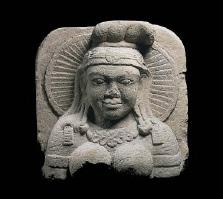

Estimate EUR 24,000
Starting price EUR 12,000
279
183
Compare the present lot with a painted stucco-coated limestone bust of Nefertiti, the wife of Egyptian pharaoh Akhenaten, crafted c. 1345 BC
A BRONZE FIGURE OF A STANDING BUDDHA, POST-GUPTA PERIOD, INDIA, C. 7TH CENTURY

Finely cast standing in contrapposto on an integral lotus-petal base upon a square plinth, the right arm extended to the earth, the open palm exaggerated, the left hand grasping the hem of the robe.

Provenance: Steven Finkelman, The Buddha Gallery, California, USA, 2014. Michael Phillips, acquired from the above. Steven Finkelman is a retired social work service director with over 30 years of experience in collecting and selling Buddhist and Hindu sculpture.
Condition: Very good condition, commensurate with age. Wear, minor dents, small nicks, light scratches, casting flaws, signs of weathering and erosion, losses.
Weight: 189.7 g
Dimensions: Height 11 cm
The present lot is characteristic of Indian art from the post-Gupta period. This small type of portable figure is thought to be one of the earliest kinds of Buddhist images to have been produced by local craftsmen, reflecting the spread of Buddhism throughout India and the rest of Asia after the 3rd century. We see this type of figure replicated in regional styles all the way out to Myanmar. It was even reported by the Chinese scholar Xuanzang (602-664), who traveled to India in the 7th century, that the monks of India had small icons of Buddha in their quarters that they venerated with chanting, ritual bathing, and small offerings of incense and food. He identified these as a small group of metal standing Buddha figures.

The Ajanta Caves are approximately thirty Buddhist cave monuments dating from the second century BC to about 480 AD in the Aurangabad district of Maharashtra state in India. Textual records suggest that these caves served as a monsoon retreat for monks, as well as a resting site for merchants and pilgrims in ancient India. The caves include paintings and rock-cut sculptures described as among the finest surviving examples

of ancient Indian art, particularly expressive works that present emotions through gesture, pose and form. They are universally regarded as masterpieces of Buddhist religious art. The caves were built in two phases, the first starting around the second century BC and the second occurring from 400 to 650 AD. They constitute ancient monasteries (Chaityas) and worshiphalls (Viharas) of different Buddhist traditions carved into a 75-meter (246 ft) wall of rock. The caves also present paintings depicting the past lives and rebirths of the Buddha, pictorial tales from Aryasura’s Jatakamala, and rock-cut sculptures of Buddhist deities. The patron and bronze founder of the present lot were clearly intimately familiar with the Ajanta site. In cave 4 for example, see a standing Buddha closely related to the present lot.
LITERATURE
COMPARISON
Compare a related carved relief of a standing Buddha in Cave 19 at the Ajanta complex, taken by Henry Cousens around 1880, from the Archaeological Survey of India Collections. See Sarita Khettry, ‘Portable’ Images (Buddhist) from Gandhara, Proceedings of the Indian History Congress, vol. 72, 2011, pp. 204-11. Compare also a related pillar painting in Cave 10. Compare a closely related figure, 11 cm high, dated 7th-8th century, at Galerie Hioco, June 24, 2019.
Estimate EUR 8,000
Starting price EUR 4,000
280 184
Ajanta, cave 4, a standing Buddha closely related to the present lot
185
A GILT-BRONZE FIGURE OF BUDDHA SHAKYAMUNI, KANDYAN PERIOD
Expert’s note: Sri Lankan figures of Buddha are noted for remarkable stylistic conservativism, having followed a consistent canon of proportions from their earliest origins. The later Kandyan period, however, saw considerable variation in the rendering of the robe, marked by highly precise linear patterns worked into the folds. There are elements to this specific bronze, from the softer casting style of the shoulders and arms to the pronounced surface wear, that make it feel a bit older than most of the Kandyan Period examples on the market.
Sri Lanka, 17th-18th century. Solidly cast seated in vajraparyankasana with his hands folded in dhyanamudra, the Buddha’s broadshouldered form is fitted in a finely pleated sanghati draped over his left shoulder. His face bares a calm, meditative expression and was likely once framed by pendulous earlobes and surmounted by a flaming siraspata.

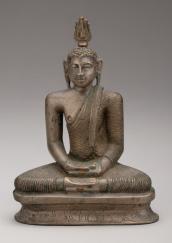
Provenance: The Phillips Family Collection, Lawrence and Shirley Phillips, and thence by descent to Michael Phillips (born 1943), who is an Academy Award-winning film producer.
Condition: Some wear and casting irregularities, minor losses, soldering marks, small nicks, light scratches. The head has been reattached at some point in time. Fine, naturally grown, rich patina.
Weight: 3,340 g
Dimensions: Height 15.5 cm
After three hundred years of internecine civil conflict and successive waves of European imperialists, the Kingdom of Kandy emerged as the pre-eminent Sinhalese political authority. Under its stability and the avid patronage of its kings, Sri Lanka witnessed a Buddhist revival with an unprecedented amount of building and restoring of monastic institutions. Bronze Buddha images proliferated, most of them either gilded or nongilded depicting the sage in a standing pose. Fewer portrayed the Buddha seated, like the present example.
Two predominant forces inform the distinctive style of Kandyan Buddhist art. One is the continuance of Sinhalese tradition in depicting Buddha with a broad body type wrapped in a pleated robe, set by colossal statues of the Anuradhapura and Polunnaruwa periods. The other is a South Indian tradition of expressing dynastic identity through artistic patronage of religious objects, pursued with enthusiasm by the Nayak princes, who were invited to assume Kandy’s throne after its last Sinhalese king died without an heir in 1739. Such fusion is exemplified by the present sculpture, whose massive shoulders and air of empyrean authority evoke tradition, while the mesmerizing crinkles of the garment, abstracted physiognomy, and enlarged flame finial summon Kandyan panache.
LITERATURE COMPARISON
Compare a closely related bronze figure of Buddha dated to the 18th century, in the Art Institute of Chicago, gifted by Lawrence and Shirley Phillips, the previous owners of the present lot, reference number 1984.1304. Compare fifteenth and sixteenthcentury Buddhas from the Divided Kingdoms period (c. 1232-1597), see U. von Schroeder, Buddhist Sculptures of Sri Lanka, p. 467, pls. 144 D-G.
AUCTION RESULT COMPARISON
Type: Related
Auction: Bonhams Hong Kong, 30 November 2022, lot 1047
Price: HKD 355,800 or approx. EUR 42,000 converted and adjusted for inflation at the time of writing
Description: A Silvered Copper Alloy Figure Of Seated Buddha, Sri Lanka, Kandyan Period, 18th Century

Expert remark: Note the closely related style of the garment folds. Also note that the figure is silvered and significantly larger (26.5 cm) than the present lot.
Estimate EUR 4,000
Starting price EUR 2,000
281
A RARE AND LARGE GILT BRONZE FIGURE OF AN ENTHRONED MAITREYA, CENTRAL JAVANESE PERIOD


Expert’s note: The fuller, fleshier depiction of Buddha, with a lack of jeweled adornment, places the style of this statue amongst examples dating from the 9th century. The throne and figure are cast from different metal alloys, the throne having a higher copper content and the figure having a higher iron content, resulting in a different appearance of the two, as the metals have developed differently over the centuries.
Indonesia, Java, 8th-9th century. Seated in bhadrasana on a stepped rectangular throne, his feet placed on a circular lotus dais, the hands held in dharmachakra mudra, dressed in a monastic robe, and backed by an ornately scrolled foliate mandorla.
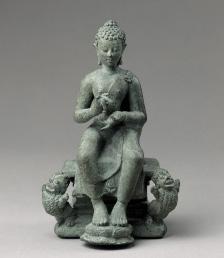
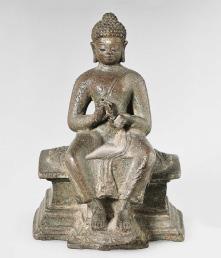
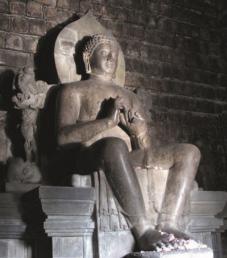
Provenance: Christie’s Paris, 10 December 2014, lot 349. Michael Phillips, acquired from the above. A copy of the original invoice from Christie’s, dated 16 January 2015, addressed to Michael Phillips, confirming the dating above, and stating a purchase price of EUR 6,500 or approx. EUR 7,500 (adjusted for inflation at the time of writing), accompanies this lot.

Condition: Good condition, commensurate with age. Extensive wear, minor nicks, scratches, pitting, losses to gilt, signs of weathering and erosion, corrosion. Still presenting remarkably well, especially given the high age of this sculpture.
Weight: 6,585 g
Dimensions: Height 28.5 cm
This extraordinary gilt-bronze statue represents Maitreya, the Buddha of the future. It is believed that Maitreya will come to save humanity during the final days. The iconography of this particular statue has many similarities with Western prototypes, demonstrating how Buddhist imagery spread to Java along the Silk Road from places as far away as Tibet and Sri Lanka. Such statues were often part of an important and much larger altar set forming a ritual mandala, flanked by supportive bodhisattvas and surrounded by lesser deities.
LITERATURE COMPARISON
Compare a closely related bronze figure in the Museum Volkenkunde, Leiden, inventory number 1403-2845. Compare a closely related bronze figure in the Metropolitan Museum of Art, accession number 1987.142.14. Compare also a stone image of Buddha located in situ at Candi Mendut, illustrated in Peter Sharrock and Emma Bunker, Seeds of Vajrabodhi: Buddhist Ritual Bronzes from Java and Khorat. Esoteric Buddhism in Mediaeval Maritime Asia: Networks of Masters, Texts, Icons, 2016, pp. 237-252.
AUCTION RESULT COMPARISON
Type: Related
Auction: Christie’s New York, 19 September 2000, lot 193
Price: USD 171,000 or approx. EUR 237,000 converted and adjusted for inflation at the time of writing
Description: An important bronze figure of Kubera, Indonesia, 9th/10th century
Expert remark: While representing Kubera, the statue contains numerous points for comparison. Note the larger size of 34.8 cm and the significantly better state of preservation.
AUCTION RESULT COMPARISON
Type: Related
Auction: Christie’s Paris, 9 October 2014, lot 350
Price: EUR 20,000 or approx. EUR 23,000 adjusted for inflation at the time of writing
Description: A bronze figure of the cosmic Buddha Amoghasiddi, Indonesia, East Java, 11th century

Expert remark: This statue is an important example for comparison, not only because of the age and casting similarities, but also because it was the following lot in the Paris 2014 Christie’s sale. It is important to note that this figure is about half as large and not gilt.
Estimate EUR 10,000
Starting price EUR 5,000
282 186
187
A
SANDSTONE HEAD OF BUDDHA SHAKYAMUNI,
Thailand, 8th-10th century. Sensitively carved with heavy-lidded downcast eyes with incised pupils, thick ridged brows, a broad nose, elongated earlobes, and full lips forming a calm smile, the hair in snail shell curls over a high ushnisha.
Provenance: Collection Monsieur M., an important French private collection. Michael Phillips, acquired from the above.
Condition: Good condition, commensurate with age. Old wear, losses, nicks, scratches, very minor old fills, signs of weathering and erosion, encrustations, structural cracks. Fine, naturally grown patina.
Scientific Analysis Report: A technical examination was conducted by Podany Conservation Services. The examination report concludes: “A comparison of observed features does favor the opinion that the head fragment is not of modern origin or a forgery.” The signed examination report, dated 24 May 2021, accompanies this lot. Note that the purported date stated in the examination report is circa 9th-11th century.
Weight: 3,340 g (incl. stand)
Dimensions: Height 17.5 cm (excl. stand) and 25.5 cm (incl. stand)
Mounted on an associated stand. (2)
While there is great variation within the Mon-Dvaravati tradition, the sensitivity paid to the modeling of these facial features is in keeping with the period’s focus on the purity and fluidity of form. As expressed by Jean Boisselier in The Heritage of Thai Sculpture, 1975, p. 73, “The school of Dvaravati may stand alongside the great Buddhist artistic traditions of India, so enduring were its innovations and so persuasive its influence on most of the art of Southeast Asia.”
Literature comparison: Compare a closely related sandstone head of Buddha in the National Museum Bangkok, dated 8th-10th century, with nearly identical facial features.
AUCTION RESULT COMPARISON
Type: Closely related
Auction: Christie’s Paris, 12 June 2018, lot 239
Price: EUR 15,000 or approx. EUR 18,000 adjusted for inflation at the time of writing
Description: A stone head of Buddha Shakyamuni, Thailand, Dvaravati period, 8th-9th century

Expert remark: Despite being a larger example (32 cm), this comparable shares very similar facial characteristics with the current lot, including a flattened down-turned nose, a joined brow, pointed helices of the ears, and a lower lip equal or greater in size to that of the upper.
AUCTION RESULT COMPARISON
Type: Related
Auction: Bonhams New York, 19 March 2019, lot 874
Price: USD 43,825 or approx. EUR 46,500 converted and adjusted for inflation at the time of writing
Description: A blackstone head of Buddha, Central Thailand, Dvaravati period, circa 8th century


Expert remark: Note the size (23.5 cm).
Estimate EUR 6,000
Starting price EUR 3,000
283
MON-DVARAVATI PERIOD
A RARE AND LARGE SANDSTONE HEAD OF HARIHARA, CHAM PERIOD

Opinion: This is a very early example of Harihara from Southeast Asia, of a type and size rarely encountered, and was likely once part of an important temple statue.
Vietnam, former kingdoms of Champa, 5th-7th century. A sensitively carved serene face surmounted by a circular miter, having a forehead with a vertical third eye above a connected brow, with a mustachioed smile, and long pendulous earlobes.
Provenance: The Phillips Family Collection, Lawrence and Shirley Phillips, and thence by descent to Michael Phillips (born 1943), who is an Academy Award-winning film producer. Condition: Good condition, commensurate with age. Extensive wear, losses, nicks, scratches, signs of weathering and erosion.
Dimensions: Height 49 cm (incl. stand) and 40 cm (excl. stand)
Mounted on an associated stand. (2)
The image of Harihara served as an icon representing the integration of both Shiva and Vishnu. This unified deity was created as a political effort to unite the followers of Saivism and Vaisnavism. Several legends were created over the centuries to support the religious union. Representational images of Shiva, whether singular or in combined form, are rarely encountered in early works from Vietnam. Early Vietnamese imagery of Shiva is usually restricted to types of linga.
The current lot could be considered one of the earliest representations from the region depicting Shiva as Harihara, displaying the facial characteristics and crown of Vishnu combined with the third eye of Shiva. Not until around the 7th century do we start to prominently see the more commonly recognized duality of Harihara in Southeast Asia with iconography displaying the deity physically split into two halves.
LITERATURE COMPARISON
See a closely related head of Harihara excavated at Oc Eo, believed to be one of the earliest Vietnamese examples, dated to the 5th century, illustrated in Indradjaya, Early Traces of Hinduism and Buddhism Across the Java Sea, p. 120, fig. 89.
Estimate EUR 12,000
Starting price EUR 6,000
284
188

A FINE THANGKA OF TSONGKHAPA, 18TH-19TH CENTURY


Tibet. Distemper and gilt on canvas. Seated in dhyanasana on a lotus base set in a bank of clouds with his hands in dharmachakra mudra, clad in heavy robes and flanked by lotus blossoms at the shoulder supporting the sword and book, the face with a serene expression surmounted by a pointed cap and backed by a nimbus, framed by two of his scholars, wrathful deities, lamas, and taras, all within a mountain landscape.
Inscriptions: To the reverse, ‘Om Ah Hum’.
Provenance: From a private collection in Vienna, Austria. Condition: Good condition with minor wear, little soiling, small losses, creasing, two old repairs to the reverse. The mount with tears and minor soiling.
Dimensions: Image size 68.5 x 48 cm, Size incl. frame 115 x 75 cm
LITERATURE COMPARISON
Type: Closely related
Auction: Christie’s New York, 15 March 2016, lot 204
Price: USD 15,000 or approx. EUR 18,000 converted and adjusted for inflation at the time of writing
Description: A thangka of Tsongkhapa, Tibet, 18th/19th century
Expert remark: Note the similar size (62.2 x 42.5 cm)
Estimate EUR 3,000
Starting price EUR 1,500
286 189
A SILK APPLIQUÉ THANGKA OF A CHITIPATI YANTRA, MONGOLIA, 19TH CENTURY
Finely woven with two skeletons standing in unity on conch shells atop a lotus pillow, holding a skull club, a kapala, a kundika, and a medicinal plant. The thangka is centered by the circular yantra with a lengthy inscription and decorated with flame, vajra, and floral designs.

Provenance: The Triay Collection of Himalayan Art. Ian Triay is a Spanish banking executive and the Honorary Consul in Spain for the Kingdom of Bhutan.
Condition: Good condition with old wear, traces of age and usage, little soiling, loose threads.
Dimensions: Image size 46 x 33 cm, Size incl. mounting 83.5 x 51.5 cm
Memento mori (Latin for ‘remember that you die’) is an artistic or symbolic trope acting as a reminder of the inevitability of death. The concept has its roots in the philosophers of classical antiquity and appeared in art and architecture from the medieval period onwards. The most common motif is a skull, often accompanied by one or more bones, or a complete skeleton. Often this alone is enough to evoke the trope, but sometimes other motifs such as a coffin, hourglass and wilting flowers were added to signify the impermanence of human life.
From Leonardo to Basquiat, the most important artists of the modern world were fascinated by the Memento Mori trope. Likewise, the Chitipati are a reminder of the eternal cycle of life and death. Furthermore, there is a mind training practice in Tibetan Buddhism known as Lojong, the ‘Four Contemplations to Cause a Revolution in the Mind’. The second of these four is the contemplation of impermanence and death. In particular, one contemplates that:
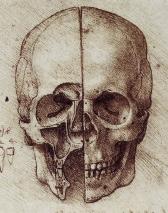
All compounded things are impermanent, The human body is a compounded thing, Therefore, death of the body is certain, The time of death is uncertain and beyond our control.
There are a number of classic verse formulations of these contemplations meant for daily reflection to overcome our strong habitual tendency to live as though we will certainly not die today
LITERATURE COMPARISON
Compare an earlier Tibetan painted thangka of the Chitipati, dated to the 15th century, in the Rubin Museum of Art, object number F1996.16.5. Compare a related painted Chitipati yantra, dated 1900-1959, in the collection of Richard R. and Magdalena Ernst, Himalayan Art Resources item no. 18430 (fig. 1). fig. 1

Estimate EUR 4,000
Starting price EUR 2,000
287
190
The Skull, by Leonardo da Vinci, 1489

A RARE AND EARLY THANGKA OF KUNTU ZANGPO, TIBET, 15TH CENTURY
Published: Per Kvaerne, The Bon Religion of Tibet: The Iconography of a Living Tradition, London, 1995, pl. 12.

The central deity seated in dhyanasana on a lotus throne supported by lions, flanked by flowering lotus and backed by a blue halo, against a finely painted scroll background, wearing only a loincloth with folds gathering at the base, surrounded by the lamas and deities of the Drenpa Akar Gongdü lineage, the lower register with monks wearing white meditation caps, dancing laypersons, and offerings.
Inscriptions: The mantra on the reverse of the painting describes Kuntu Zangpo in this form as a divine manifestation of the eighthcentury sage Drenpa Nankha, often referred to by Bonpa simply as lachen, The Great Lama (see Per Kvaerne, The Bon Religion of Tibet: The Iconography of a Living Tradition, London, 1995, page 119).

Provenance: The Richard & Magdalena Ernst Collection of Himalayan Art. Sotheby’s New York, 22 March 2018, lot 944, bought-in at an estimate of USD 40,000 or approx. EUR 43,000 (converted and adjusted for inflation at the time of writing).
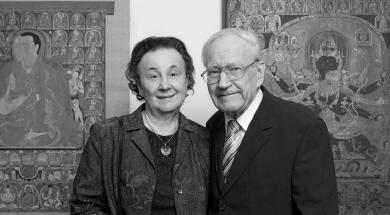
Richard Robert Ernst (1933-2021) was a Swiss physical chemist and Nobel Laureate. He was awarded the Nobel Prize in Chemistry in 1991 for his contributions towards the development of Fourier transform nuclear magnetic resonance (NMR) spectroscopy while at Varian Associates and ETH Zurich. He humbly referred to himself as a “tool-maker” rather than a scientist. Besides toiling with his work, Ernst also enjoyed music and art, specifically Tibetan paintings. Using scientific techniques, Ernst would research the pigments on the scrolls to learn about their geographic origin and age.
Condition: Good condition with expected old wear and traces of use. Minor creasing with associated small losses. The canvas made of two sections joined vertically at the second column of figures on the left side, with creases and losses at the joint. Some minor consolidation of the blue halo around the central figure but no further restoration.
Dimensions: Image size 66 x 56.5 cm

The elaborate frame with an aperture to the reverse to show the inscription. (2)
Kuntu Zangpo is a peaceful deity found within the Bon religion. He can have a similar appearance to a naked sanggye without any ornaments, as depicted in the present lot, or he can appear as a peaceful deity with ornaments and heavenly garments. The Tibetan term ‘kuntu zangpo’ in Bon usage can also be used as an epithet for other peaceful male deities.
Drenpa Namkha, who is mentioned in the mantra on the reverse of this thangka, was born in the 8th century near Mount Kailash in Chunlung Ngul Kha in south-western Tibet. As a young student he was blessed with eight principal Bon teachers. Drenpa Namkha became a self-realized supreme master of the three Bon practices, known as Sutra, Tantra, and Dzogchen. He is the primary long-life deity and a popular personage in the Bon tradition. He is said to have had twin sons: Tshe-dbang Rig-’dzin, a Bon teacher, and Pad-ma ‘Byung-gnas, the famous Buddhist teacher Padmsambhava.
Literature comparison: Compare the background scrollwork on a Sakya mandala, dated to ca. 1429-56, illustrated in Steven M. Kossak and Jane Casey Singer, Sacred Visions: Early Paintings from Central Tibet, New York, 1998, p. 170, pl. 47c.
AUCTION RESULT COMPARISON
Type: Related
Auction: Christie’s New York, 22 March 2011, lot 329
Price: USD 43,750 or approx. EUR 52,500 converted and adjusted for inflation at the time of writing
Description: A thangka of Amoghasiddhi



Buddha, Tibet, 15th Century
Expert remark: Compare the related style, period, and size (75.5 x 62.2 cm)

Estimate EUR 20,000
Starting price EUR 10,000
289 191
Magdalena and Richard Ernst
192
AN EMBROIDERED SILK THANGKA OF SUBHUTI PREACHING TO NAGAS AND GARUDAS, QING DYNASTY


China, late 18th to early 19th century, possibly Imperial workshops. Finely woven with the protector of Nagas, portrayed seated in lalitasana on a cushion next to a river with crashing waves, dressed in loose monk robes open at the chest, his left hand reaching out to gently caress a Garuda, accompanied by a monastic figure and Buddha in the earth-touching gesture with attendants in the upper register, protective deities, including Dhritarashtra in the lower left corner, framed by turbulent clouds, and various mythical beasts including Garudas, Nagas, and fish, in a landscape with lush trees, flowers and rocks, all beneath stylized clouds.
Provenance: From an old private collection in New York City, USA. Condition: Very good condition with minor wear, little staining, and few loose threads. The frame with old wear, and small nicks.
Dimensions: Size incl. frame 87.3 x 59.8 cm, image size 66 x 38.7 cm
Matted and framed behind glass. (2)
Expert’s note: Silk textiles of high quality are among the most revered articles in Buddhist worship in China and Tibet. Similar to sculptures and paintings, the finest textile Buddha images were commissioned to accrue religious merit. During the early Ming dynasty, magnificent silk thangkas were produced by the Chinese Imperial workshops as gifts to Tibetan monasteries. The tradition of weaving and embroidering sacred images and presenting them as lavish gifts to Tibetan monks of the highest ranks not only continued throughout the Qing dynasty, but rather became a common governmental practice.
Subhuti became a monk after hearing the Buddha teach at the dedication ceremony of the Jetavana Monastery. After ordination, he went into the forest and became an arahant while meditating on loving-kindness. It is said that due to his mastery of loving-kindness meditation, any gift offered to him bore the greatest merit for the donor, thus earning him the title of foremost in being ‘worthy of gifts’. Subhuti is a major figure in Mahayana Buddhism and is one of the central figures in the Prajnaparamita sutra.
LITERATURE COMPARISON
Compare a related painted thangka depicting Subhuti, Tibet, in the collection of the Boston Museum of Fine Arts, accession number 19.128.

AUCTION RESULT COMPARISON
Type: Closely related
Auction: Bonhams New York, 23 July 2020, lot 846
Price: USD 57,575 or approx. EUR 63,500 converted and adjusted for inflation at the time of writing
Description: An embroidered silk thangka of the Buddha of healing, Qing dynasty, late 18th/early 19th century Expert remark: Compare the closely related silk embroidery with the same rare tone of salmon color used in the background. Note the size (88.6 x 45.8 cm).
Estimate EUR 4,000
Starting price EUR 2,000
290
A THANGKA DEPICTING THE MANDALA OF VAJRAVARAHI
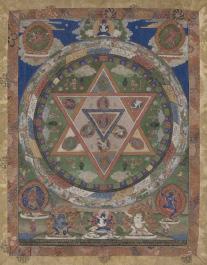
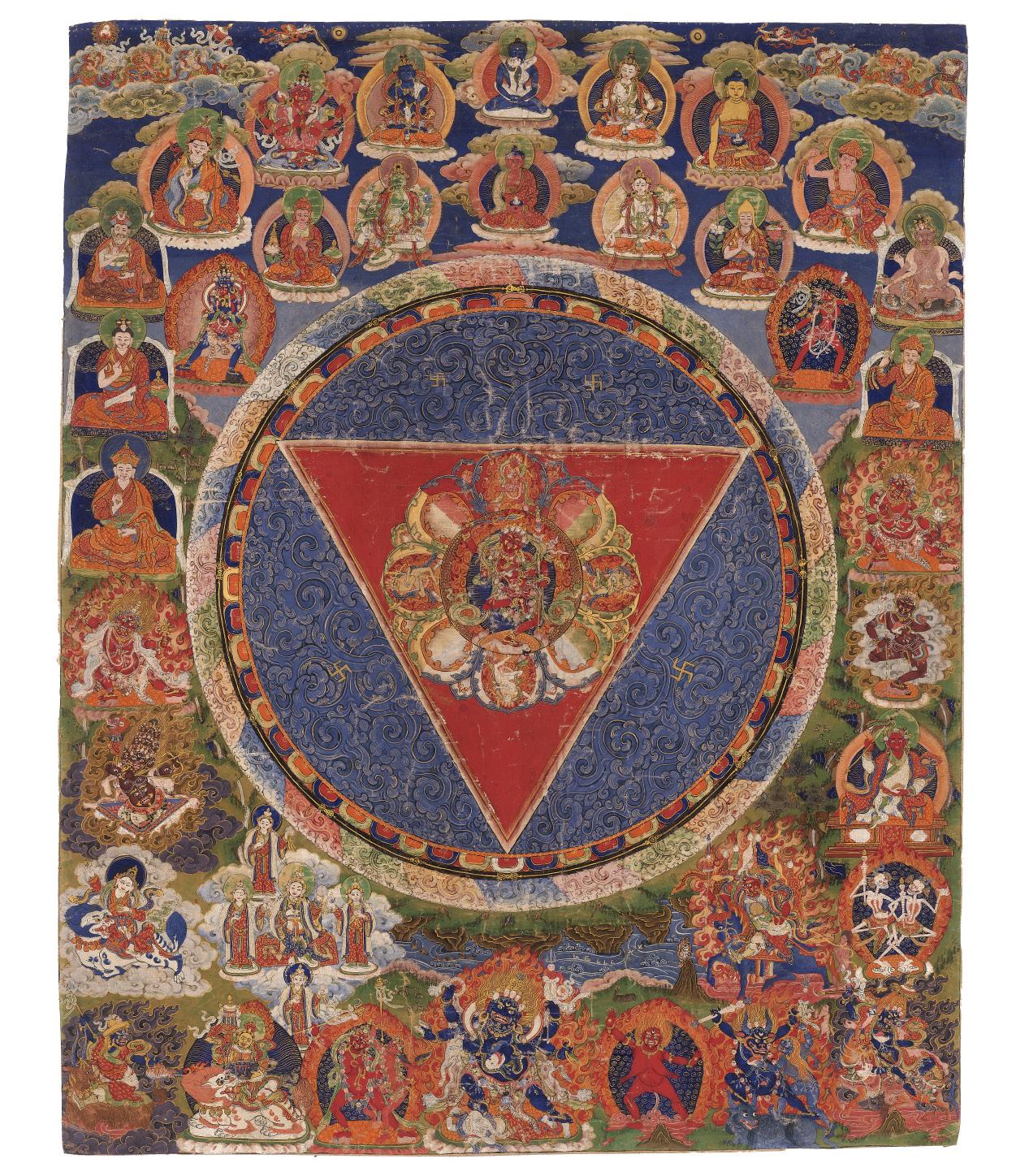
Tibet, c. late 18th to mid-19th century. Distemper and gold on cloth. The central deity dancing atop a prostrate figure, holding a kapala and kartrika in her primary hands, the two secondary hands holding a sword and khatvanga. She is wearing a diaphanous robe, garland of severed heads, and billowing scarves, and richly adorned with jewelry. Note the remarkably fine detail work.
Provenance: From an old private collection in Zagreb, Croatia. Condition: Good condition with minor wear, creasing, soiling, and tiny losses.
Dimensions: Size 72 x 57.5 cm
The central deity within a roundel encircled by foliate mandorlas, those at the cardinal points enclosing wrathful female deities, within an inverted triangle surrounded by foliate scroll interspersed by swastikas, enclosed by a band of lotus petals and scrolling vines. The mandala is set within a verdant landscape densely filled with numerous images of deities, the upper register with teachers, Buddhas, and bodhisattvas, centered by a blue Chakrasamvara with his consort Vajravarahi, the lower register with various wrathful and protector deities.
Vajravarahi, or the ‘Diamond Sow’, is a wrathful form of Vajrayogini associated particularly with the Chakrasamvara Tantra, where she is paired in yab-yum with the Heruka Chakrasamvara.
LITERATURE COMPARISON
Compare a related thangka, dated 1869, attributed to Nepal but clearly painted in the Tibetan tradition, from the Avery Brundage Collection and now in the Asian Art Museum of San Francisco, object number B60D11+
Estimate EUR 3,000
Starting price EUR 1,500
291 193
A LARGE KESI ‘PEACH FESTIVAL’ PANEL, QING DYNASTY
China, Wenzhou, Zhenjiang province, 18th-19th century. Finely woven in bright colors on a red ground with a lively scene depicting the festival. Xiwangmu, the Queen Mother of the West, descends from the sky astride her phoenix as the immortals eagerly await her arrival, amid swirling clouds, gnarled peach trees, and craggy rockwork, all below an image of the Buddha surrounded by four cranes in flight.
Expert’s note: The addition of the Buddha, which is prominently placed at the top center of the composition, is a rare and unusual feature of this panel, as the subject matter is Daoist. It is highly likely that the work was a special commission commemorating a birthday celebration, and as such, this Buddha would have reflected a particularly pious recipient.
Provenance: French trade.
Condition: Magnificent condition with only very minor wear, little soiling, minimal creasing, and few loose threads. Must be regarded as exceedingly rare in this pristine state of preservation.
Dimensions: ca. 250 x 112 cm
The Peach Festival is a popular Daoist theme associated with the birthday celebration of Xiwangmu, who has the sole authority to grant Peaches of Eternal Life and bestow celebrants of the festival with great fortune. According to legend, the festival is held at the Jade Palace in the Kunlun Mountains in the Western paradise and only takes place every 3000 years. Here, groups of Immortals are pictured waiting in anticipation for Xiwangmu, who gracefully arrives on a phoenix. The auspicious message of this theme made the present panel suitable for presentation at important festivities.
Kesi, which means ‘cut silk’, derives from the visual illusion of cut threads that is created by distinct, unblended areas of color, as the weft threads are woven into each color and then cut. The earliest surviving examples of kesi tapestries date to the Tang dynasty (618-907), although the technique was already used earlier in wool and became widely applied only during the Song dynasty (1127-1379). The fragment of a kesi tapestry was recovered in a tomb of a man and his wife in Dulan, Qinghai province, who died in 633 and 688 respectively, and another also excavated in Dulan, was included in the exhibition “China, Dawn of a Golden Age” at the Metropolitan Museum of Art, New York, 2005, cat. no. 245. During the Ming dynasty (13681644), kesi panels enjoyed a rise in popularity and thrived under the Qing emperors.

During the Qing dynasty (1644-1911), official weaving workshops were established both in the palace and in the cities of Jiangning, Suzhou and Hangzhou, in order to cater to the court’s increasing demand for palace and temple furnishings, clothing and presentation silks for civil and military officials. Specialized centers of production soon developed around this area, such as the city of Wenzhou, Zhenjiang province, which became particularly famous for its luxurious kesi tapestries.
Literature comparison: Compare a related kesi panel depicting the ‘Peach Festival’ on a red ground, in the Liaoning Provincial Museum, Shenyang, included in the Hong Kong Oriental Ceramic Society exhibition Heaven’s Embroidered Cloths. One Thousand Years of Chinese Textiles, Hong Kong, 1995, no. 119. Compare a related kesi panel depicting Xiwangmu being greeted by female Immortals included in the exhibition Masterpieces of Chinese Silk Tapestry and Embroidery in the National Palace Museum, Taipei, 1998, no. 21.
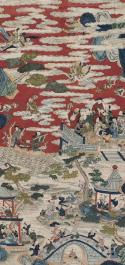
AUCTION RESULT COMPARISON
Type: Closely related
Auction: Bonhams London, 14 May 2009, lot 195
Price: GBP 26,400 or approx. EUR 43,000 converted and adjusted for inflation at the time of writing
Description: An ‘eight immortals’ kesi panel, the kesi 18th/19th century
Expert remark: Compare the closely related subject, kesi technique, and red ground. Note the smaller size (223 x 93.5 cm), which already includes the gilt paper dedication at the top.
AUCTION RESULT COMPARISON
Type: Closely related
Auction: Christie’s New York, 28 September 2021, lot 39
Price: USD 40,000 or approx. EUR 40,000 converted and adjusted for inflation at the time of writing
Description: A Large Silk Kesi Daoist Immortals ‘Birthday’ Panel, China, Late Qing Dynasty
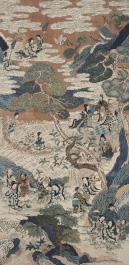

Expert remark: Compare the closely related subject, kesi technique, and red ground. Note the significantly smaller size (179.1 x 92.4 cm).
AUCTION RESULT COMPARISON
Type: Closely related
Auction: Christie’s London, 11 November 2016, lot 787
Price: GBP 16,250 or approx. EUR 23,000 converted and adjusted for inflation at the time of writing
Description: A kesi ‘eight immortals’ hanging panel, circa 1900
Expert remark: Compare the closely related subject, kesi technique, and red ground. Note the significantly smaller size (169.5 x 79.3 cm).
Estimate EUR 8,000
Starting price EUR 4,000
292
194

293
A POLYCHROME STUCCO FRESCO FRAGMENT DEPICTING A FLYING APSARA, YUAN TO MING DYNASTY

Expert’s note: This painting belongs to an important group of Buddhist stucco works dating from the Late Yuan to Early Ming dynasties, featuring ‘Court’ and ‘Paradise’ scenes from monasteries that date from the 12th to 13th centuries, containing a painting repertoire favored during the Tang dynasty. The style of painting in this fresco is reminiscent of the Tang dynasty painter Wu Daozi (c. 685–758) and was ideal for painting religious figures. Unlike earlier modes stressing precise contours, the whirling spiritual energy of this brushwork gives the impression of qi, or inner life.
China, 13th-14th century. The rectangular panel painted with a winged apsara, adorned in a phoenix headdress, wearing a flowing robe with an elaborate necklace of coral and jade beads, bearing wings, and holding a long-handled ritual censer issuing clouds, all painted in polychrome pigments highlighted in finely applied gesso relief.
Provenance: Boston trade. By repute acquired from an old private estate, where it was mounted in a fitted Perspex case to serve as tabletop. The table was subsequently disposed of, whereas the Perspex case is still present.
Condition: An intact section of a larger wall painting in overall good condition with faint cracks, losses and fading to the pigments, showing evidence of various periods of minor retouching. The edges minimally frayed.
Dimensions: 81 x 54 x 0.8 cm
Literature comparison: For a discussion on the creation of Yuan and Ming wall frescos, and their context in monasteries, see Ka Bo Tsang, Further Observations on the Yuan Wall Painter Zhu Haogu and the Relationship of the Chunyang Hall Wall Paintings to ‘The Maitreya Paradise’ at the ROM.” Artibus Asiae, vol. 52, no. 1/2, 1992, pp. 94-118.
AUCTION RESULT COMPARISON
Type: Closely related
Auction: Sotheby’s, New York, 15 September 2010, lot 293.
Price: USD 15,000 or approx. EUR 18,500 converted and adjusted for inflation at the time of writing
Description: A large polychrome fragment of a Buddhist fresco, Yuan / Ming dynasty
Expert remark: Compare the closely related manner of painting with similar wings and round faces. Note the size (135.3 x 104.1 cm).
AUCTION RESULT COMPARISON
Type: Closely related
Auction: Christie’s, New York, 16 September 2008, lot 378.
Price: USD 20,000 or approx. EUR 25,000 converted and adjusted for inflation at the time of writing
Description: A rare painted Buddhist wall fresco, Yuan/Ming dynasty
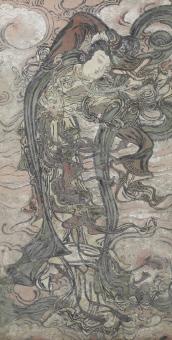

Expert remark: Compare the closely related manner of depicting the clouds, with a multitude of flowing lines and the use of peach for shading, as well as the figure, with a similar fleshy appearance and abundant trailing draperies. Note the size (77.5 x 45.5 cm).
Estimate EUR 4,000
Starting price EUR 2,000
294 195
A STUCCO FRESCO FRAGMENT DEPICTING A CELESTIAL MAIDEN, YUAN TO MING DYNASTY

China, 13th-16th century. Finely painted in polychrome pigments with details picked out in gesso relief. Depicting a celestial maiden dressed in flowing robes of red, pale blue, and white, as well as long billowing scarves, holding two long scrolls, the head turned to the side, her face with delicate features, the hair tied behind an ornamental headdress with scrolling clouds and ruyi decoration, the background with rockwork.
Provenance: From the collection of Dr. Wou Kiuan. Wou Lien-Pai Museum, coll. no. M.8.3. Dr. Wou Kiuan (1910-1997) was a Chinese diplomat and noted scholar of Chinese art. His father, Wou Lien-Pai (1873-1944), was one the leading political figures of early 20th century China, remembered for his role as speaker and leader of parliament during the turbulent years of the Republican era. Dr. Wou himself embarked on an illustrious career in diplomacy until his retirement in 1952, when he settled in London and devoted the rest of his life to the study of Chinese art. It was no doubt fortuitous that Dr. Wou’s years of collecting coincided with an abundant availability of exceptional Chinese art on the London market. From the mid-1950s to the late 1960s he was able to form a collection of well over 1,000 works that together represented virtually every category of Chinese art. At the heart of Dr. Wou’s drive to collect was a burning desire to preserve the relics of China’s rich historical past scattered across Europe, and to promote Chinese art and culture. It is unclear when Dr. Wou conceived of the idea to create a place to house his collection, but in 1968 he opened the doors to the Wou Lien-Pai Museum, named in honor of his father. Over the years the Museum became a ‘must see’ destination for collectors, academics, and visiting dignitaries, and Dr. Wou would delight in leading his visitors through the galleries, recounting stories of China’s glorious history. Condition: Good condition, commensurate with age. Old wear and expected age cracks, minor losses and touch-ups. The frame with some wear, nicks, and scratches. Presenting very well overall.

Dimensions: Image size 80.6 x 46.7 cm, Size incl. frame 89.3 x 55.1 cm
Framed behind glass and with a gilt wood frame. (2)
AUCTION RESULT COMPARISON
Type: Related
Auction: Sotheby’s New York, 11 September 2019, lot 816
Price: USD 37,500 or approx. EUR 41,000 converted and adjusted for inflation at the time of writing
Description: A polychrome stucco fresco fragment, Yuan / Ming dynasty

Expert remark: Compare the related figural motif and size (77.5 x 45.5 cm)
Estimate EUR 4,000
Starting price EUR 2,000
295 196
Dr. Wou Kiuan, Paris, November 1939
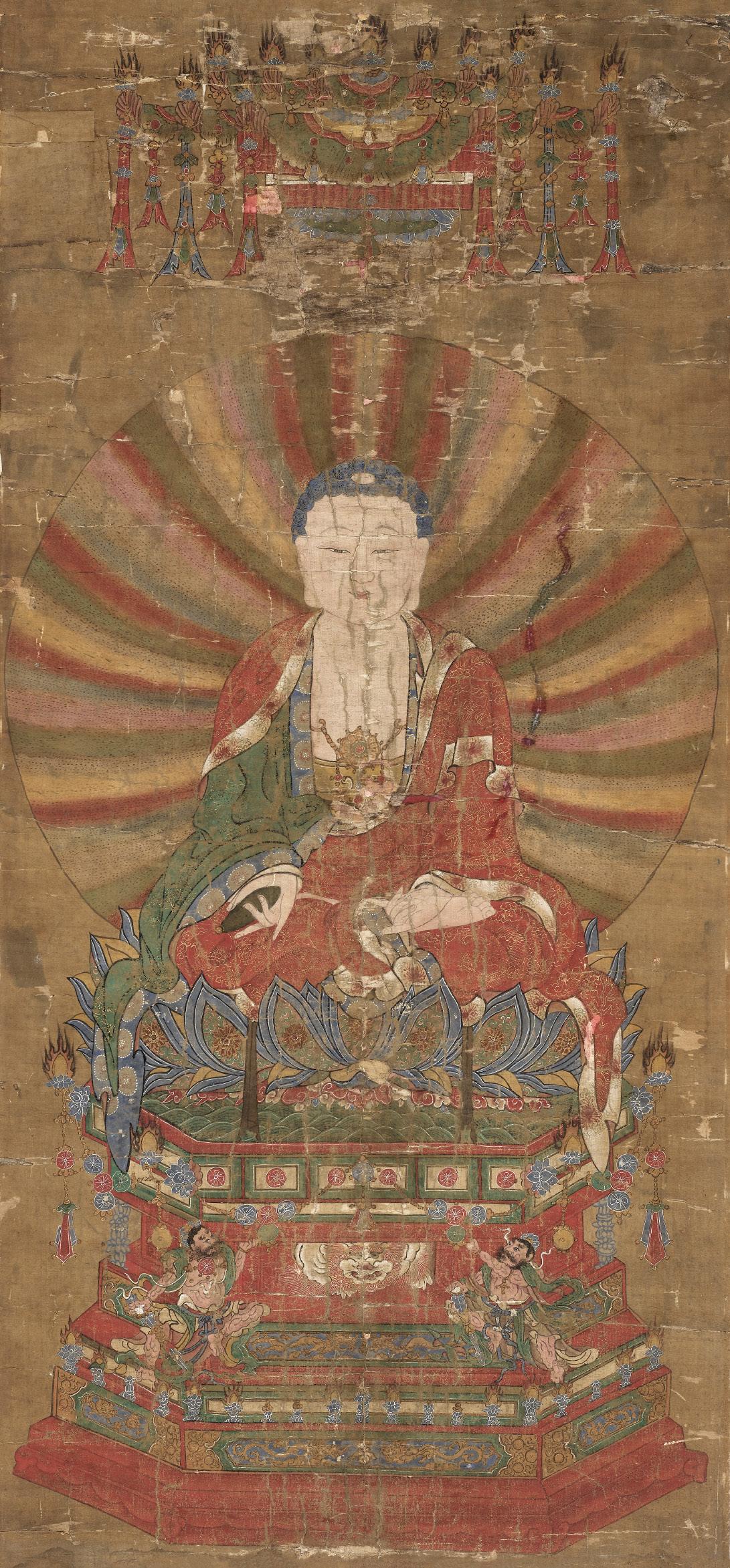
296
AN IMPORTANT BUDDHIST VOTIVE PAINTING DEPICTING BUDDHA, EARLY MING DYNASTY, 1400-1450
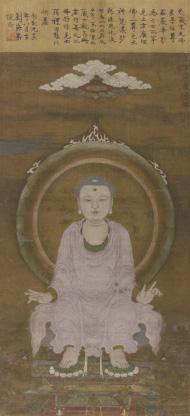
Published: Roderick Whitfield et al., Classical Chinese Art - Selected Catalogue of the Paintings and Calligraphy, Wou Lien-Pai Museum, Hong Kong, 2011, pages 16-17, elaborately discussed in Roderick Whitfield’s essay “Paintings of Distinction from the Wou Lien-Pai Museum of Chinese Art”, and page 109, no. 6 (note that the size is erroneously noted as 136.5 x 68 cm).

Expert’s note: According to Roderick Whitfield in his essay “Paintings of Distinction from the Wou Lien-Pai Museum of Chinese Art”, written in 2008, the present lot exhibits numerous features which are typical of Buddhist paintings on silk dating from the first half of the fifteenth century, some originating from the capital and others from Shanxi province. Roderick Whitfield (b. 1937) is a British scholar and art historian who was the Percival David Professor at the School of Oriental and African Studies of the University of London, as well as Assistant Keeper at the British Museum between 1968 and 1984 and head of the Percival David Foundation of Chinese Art between 1984 and 1993.

China, first half of the 15th century. Ink and watercolors on silk. Depicting the Buddha seated on a double lotus over an elaborate hexagonal tiered throne supported by two striding guardian figures centered by a lion, his left hand holding a small flask and his right held above his lap, wearing loose-fitting robes and adorned with jewelry, backed by a circular halo of multi-colored rays of light. His serene face with heavy-lidded eyes and pursed lips, his blue hair arranged in spiral curls around the central ushnisha.
Provenance: From the collection of Dr. Wou Kiuan. Wou Lien-Pai Museum, coll. no. P.38. The frame with an old label, ‘KW P38’, as well as further old labels to the back. Dr. Wou Kiuan (1910-1997) was a Chinese diplomat and noted scholar of Chinese art. His father, Wou Lien-Pai (1873-1944), was one the leading political figures of early 20th century China, remembered for his role as speaker and leader of parliament during the turbulent years of the Republican era. Dr. Wou himself embarked on an illustrious career in diplomacy until his retirement in 1952, when he settled in London and devoted the rest of his life to the study of Chinese art. It was no doubt fortuitous that Dr. Wou’s years of collecting coincided with an abundant availability of exceptional Chinese art on the London market. From the mid-1950s to the late 1960s he was able to form a collection of well over 1,000 works that together represented virtually every category of Chinese art. At the heart of Dr. Wou’s drive to collect was a burning desire to preserve the relics of China’s rich historical past scattered across Europe, and to promote Chinese art and culture. It is unclear when Dr. Wou conceived of the idea to create a place to house his collection, but in 1968 he opened the doors to the Wou Lien-Pai Museum, named in honor of his father. Over the years the Museum became a ‘must see’ destination for collectors, academics, and visiting dignitaries, and Dr. Wou would delight in leading his visitors through the galleries, recounting stories of China’s glorious history.

Condition: Extensive wear, creasing, losses, tears, and soiling. Minor old touch-ups here and there. The wood frame with wear, chips, and losses.
Dimensions: Image size 148 x 70 cm, size incl. frame 157.5 x 80 cm
With a finely carved old gilt wood frame. (2)
The present image is a symbolic representation placed on a wall during Buddhist rituals. From the Buddhist perspective, paintings and calligraphy belong to Silpakarma-vidya, one of the five types of knowledge and wisdom. Over time monks and laymen painted and practiced calligraphy and Buddhist-themed works became more sophisticated during the Song and Yuan dynasties. By the early Ming dynasty, votive paintings, such as the present example, were used within private chapels and side pavilions of major temple monasteries.
As explained in Caroline Gyss-Vermandes’ pioneering article about the sets of Shuilu (Water and Land) paintings obtained by Paul Pelliot from “a library in the Imperial Palace” and now in the Musée Guimet (Démons et Merveilles: vision de la nature dans une peinture liturgique du XVe siècle, Arts Asiatiques 43, 1988, pages 106-122), such paintings were not objects of worship, but rather illustrations of the pantheon invoked in the Water and Land rituals, hung up in a prescribed order on the left and right walls of the sanctuary, while the main deities, in a larger size, were hung slightly higher on the north wall.
Literature comparison: Compare a related painting of the Medicine Buddha, dated 1477, in the University of Oregon Museum of Art, illustrated in Marsha Weidner, Latter Days of the Law: Images of Chinese Buddhism 850-1850, cat. no. 5, pl. 3.

AUCTION RESULT COMPARISON
Type: Closely related
Auction: Sotheby’s New York, 17 March 2016, 1110

Price: USD 112,500 or approx. EUR 130,000 converted and adjusted for inflation at the time of writing
Description: A Buddhist Figure, ink and color on silk, anonymous Expert remark: Compare the closely related manner of painting. Note the smaller size (95.7 x 50.4 cm).
Estimate EUR 6,000
Starting price EUR 3,000
297 197
Roderick Whitfield, Percival David Professor, Emeritus, SOAS University of London
Dr. Wou Kiuan, Paris, November 1939
198
‘BUTTERFLIES, FLOWERS, SCEPTER, AND VASE’, BY LU XIAOMAN (1903-1965), CHEN XIAOCUI (1907-1968), XIE YUEMEI (1906-1998), AND PAN JINGSHU (1892-1940)
China, 1930s. Ink and watercolors on paper, with a silk brocade frame and mounted as a hanging scroll. Exquisitely painted with an Imperial lime-green-ground famille rose vase with dragon handles, probably Jiaqing, holding a bouquet with peony, hibiscus, and red bamboo, as well as leaves, scrolling vines, and fruit, surrounded by fluttering butterflies, all above a tasseled cloisonné ruyi scepter with floral and dragon decoration as well as a gilt-bronze head.
Inscriptions: Upper right, signed and inscribed ‘Lu Xiaoman painted the butterfies’ and with a poem by the Song-dynasty poet Lu You on butterflies; two seals of the artist, ‘Xiaoman’ and ‘Lu Mei’. Center left, signed and inscribed ‘Xiaocui painted the branches in Shanghai’; one seal of the artist, ‘Xiaocui’. Lower left, signed and inscribed ‘Xie Yuemei painted the ruyi [scepter]’; two seals of the artist, ‘Xie Yuemei yin’ and ‘Juanruo’. Lower right, signed and inscribed ‘Jingshu painted this vase in the style of the Yuan dynasty’; two seals of the artist, ‘Pan’ and ‘Jingshu zhi yin’.
Provenance: Dutch trade. By repute from an old private estate. Condition: Good condition with minor wear, creasing, and foxing.
Dimensions: Image size 137 x 44 cm, Size incl. mounting 240 x 59 cm
Chen Xiaocui (1907-1968) was a Chinese painter and cofounder of the Women’s Calligraphy and Painting Society. Daughter of a famous and popular writer, Chen Diexian, she was educated at a traditional academy in Hangzhou, but moved with her father and two brothers to Shanghai around 1920. Like her brothers, she became known at an early age for her published literary works, including poetry and at least fifty translations of foreign fiction. She studied painting with the conservative master Feng Chaoran (1894-1968), an artistic lineage that is reflected clearly in her work.

Xie Yuemei (1906-1998), sobriquet Juanruo, was a Chinese painter who lived and worked in Shanghai. She was the sister of the leading traditional painter Xie Zhiliu (1910-1997), a noted member of the Shanghai School. Although she was largely self-taught, only receiving some guidance in her early years from Zhang Hongwei (1878-1970), she became very popular and influential in her time.
Pan Jingshu (1892-1940) was a Chinese painter and the wife of the noted Suzhou painter Wu Hufan (1894-1968). Pan descended from a wealthy family of scholars and officials, and was educated at home in the classics and the arts of poetry, calligraphy, and painting. She married Wu in 1915, and together they named their residence Meijing Shuwu (Plum View Studio).

The poem inscribed upper right on the painting was originally written by Lu You (1125-1210), a Chinese historian and poet of the Southern Song dynasty. It can be translated as follows:
The blossoms in the garden are fragrant, The butterflies are dancing, One dwells by the window only because of you, Regardless of what color you have, if dark or bright yellow.
AUCTION RESULT COMPARISON
Type: Related
Auction: Sotheby’s New York, 18 March 2008, lot 67
Estimate: USD 120,000 or approx. EUR 151,000 converted and adjusted for inflation at the time of writing
The present painting is a collaboration between four female painters, all of whom were active in Shanghai during the 1930s. At least three of them – Pan Jingshu being the possible exception – were associated with the Chinese Women’s Calligraphy and Painting Society (Zhongguo nuzi shuhua hui) which was founded and held its first exhibition in 1934. By 1937, the group had enrolled more than 150 artists. These four, like those of the Women’s Society as a whole, are tied together by their art, their gender, and their city of residence, but not by other more obvious social factors. They came from different native places and did not necessarily move in the same social circles. They did not work in the same painting styles, share the same teachers, or specialize in the same subjects. As a group, they came together for two mutual goals: To promote women artists and the practice of traditional painting

Lu Xiaoman (1903-1965), born in Shanghai, was a celebrated painter, writer, singer, and actor, and studied under painters such as Liu Haisu, Chen Banding, and He Tianjian. As an artist, she specialized in flowers, birds, and light ink landscapes on long Chinese scrolls. She was also known to write poetry, prose, and fiction, but her writings were never published. Nevertheless, her appreciation for poetry inspired her to create a series of ink paintings in honor of the Tang poet Du Fu. Lu Xiaoman was also a singer and debuted on stage after receiving training in the renowned Peking Opera. In the 1950s and 1960s, she worked as a paid artist at the Shanghai Academy of Chinese Painting.

Description: Chinese School, Lotus Blossoms in a Blue and White Dragon Vase
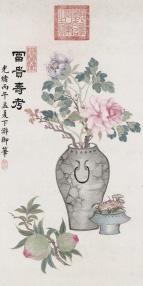

Expert remark: Note that this painting shows several seals of the Empress Dowager Cixi, and that according to an inscription on the painting it was presented to her. The Empress was an avid art collector and painter, who herself also painted several related works depicting flowers in an antique vase, which quite possibly served as inspiration for the present lot.
AUCTION RESULT COMPARISON
Type: Related
Auction: Christie’s Hong Kong, 30 May 2005, lot 1216
Price: HKD 288,000 or approx. EUR 52,500 converted and adjusted for inflation at the time of writing
Description: Empress Dowager Cixi (1835-1908), Flowers
Expert remark: The Empress Dowager Cixi was an avid art collector and painter, who painted several works depicting flowers in an antique vase which quite possibly served as inspiration for the present lot, as the Empress and her paintings would have clearly appealed to the feminist and traditional sensibilities of the Chinese Women’s Calligraphy and Painting Society’s members.
Estimate EUR 6,000
Starting price EUR 3,000
298
Chen Xiaocui (1907-1968)
Pan Jingshu (1892-1940) and her husband Wu Hufan (1894-1968)
Group image of the Chinese Women’s Calligraphy and Painting Society including Xie Yuemei, Chen Xiaocui and Lu Xiaoman
Lu Xiaoman (1903-1965)

299
199 ‘RIVER LANDSCAPE’, BY WU HUFAN (1894-1968), DATED 1945

China. Ink and watercolors on paper, with a silk brocade frame and mounted as a hanging scroll. Finely painted with gnarled pines and blossoming prunus growing from craggy rockwork classically executed in shades of blue and green, above a calm river with two fishing boats below a small waterfall.
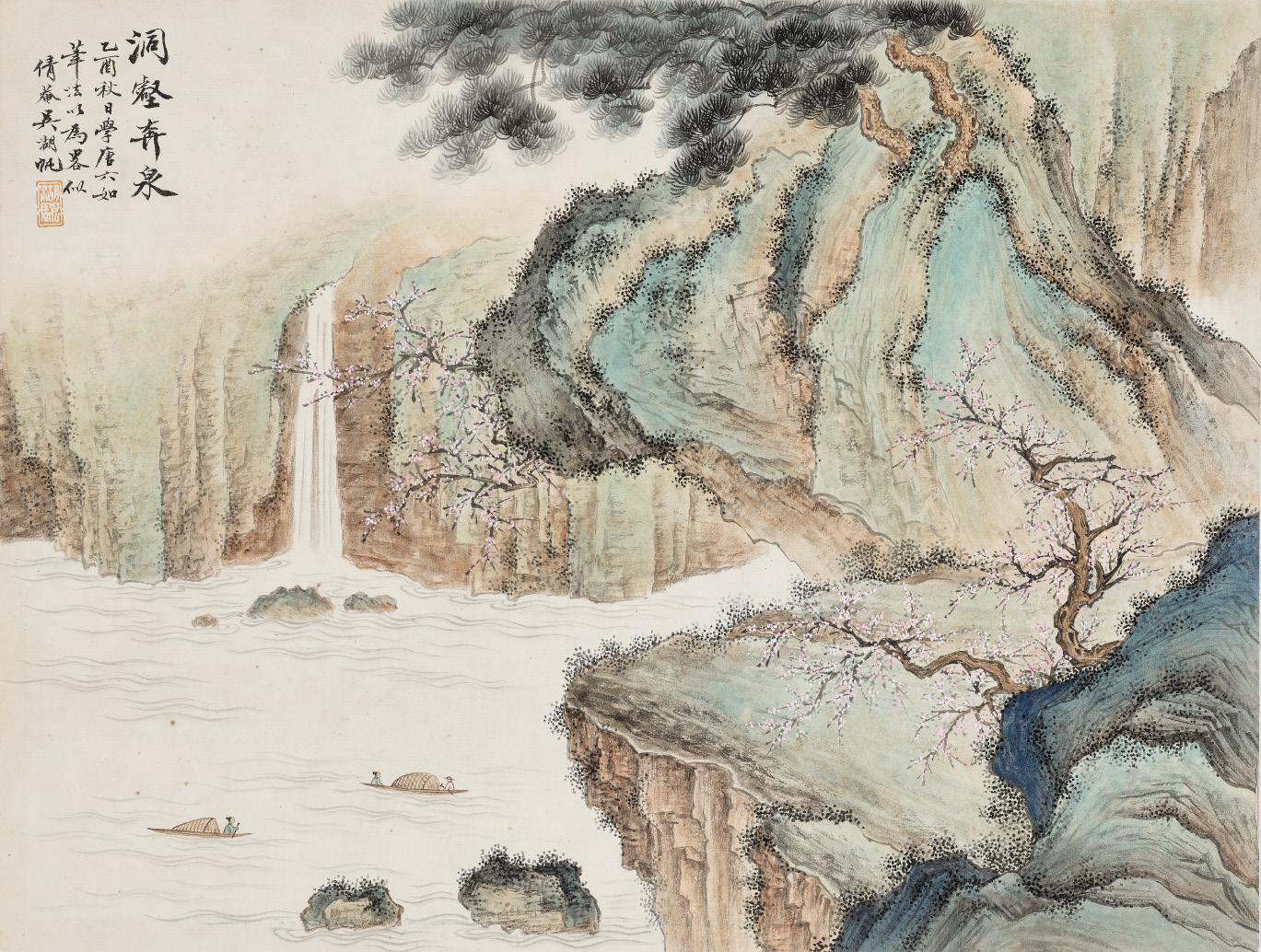
Inscriptions: Upper left, signed ‘Wu Hufan’, titled ‘The Waterfall’, dated ‘On an Autumn day in the Year of Yiyou (corresponding to 1945)’, and inscribed ‘In the style of Tang Yin’. One seal of the artist.
Provenance: UK trade.
Condition: Very good condition with minor wear and minimal foxing.
Dimensions: Image size 40 x 30 cm, Size incl. frame 57.8 x 47.7 cm
Framed behind glass. (2)
Wu Hufan (1894-1968) was a leading traditional painter, known for his sophisticated landscape works, as well as for being a noted collector and connoisseur. The grandson of calligrapher and painter Wu Dacheng, he was born into a family with generations of scholarofficials and received a classical education. Surrounded by genuine works from the past, he solidified his strong foundation in traditional culture, devoting his entire life to the realm of Chinese art. With both a firm

grasp and a rigorous practice of ancient inscriptions, painting, calligraphy, literature and opera, Wu lived the life of a traditional literatus. He spent the early part of his life in the Shanghai region, and, following the establishment of the People’s Republic of China in 1949, taught at the Shanghai Institute of Chinese Painting. He went on to become one of the city’s most important connoisseurs, writing extensively about the works in his collection.
AUCTION RESULT COMPARISON
Type: Closely related
Auction: Bonhams New York, 20 March 2013, lot 3083
Price: USD 15,000 or approx. EUR 18,000 converted and adjusted for inflation at the time of writing
Description: Wu Hufan (1894-1968), Blue-Green Landscape, 1948
Expert remark: Compare the closely related execution of the rockwork with similar shades of blue and green. Note the size (87.6 x 43.5 cm).
Estimate EUR 4,000
Starting price EUR 2,000
300
Wu Hufan (1894-1968) and his wife Pan Jingshu (18921940)
200
‘BIRD
AND BAMBOO’,
BY FANG ZHAOLIN (1914-2006)
China, c. 1950-1970. Ink and watercolors on paper. Depicting a black bird perched on a branch, to its right with hanging bamboo leaves, finely painted in splashy ink washes alongside gestural brushwork, characteristic for the artist.

Inscriptions: Lower right, signed ‘Zhaolin’, one seal ‘Fang shi’.
Provenance: French trade, previously in an old British private collection.
Condition: Presenting very well with some wear, little creasing, foxing, stains, and watermarks. Adhered to cardboard at two corners, backed by an old wooden board. The latter with some wear.
Dimensions: Size incl. backing 62.6 x 52 cm, Image size 58 x 43.9 cm
Fang Zhaolin (1914-2006) was born in Wuxi, Jiangsu province in east China. She studied Chinese painting with several masters including Qian Songyan, the Lingnan School master, Zhao Shao’ang (1905-1998), and later with one of the most celebrated Chinese artists, Zhang Daqian (1899-1983). In her forties, she completed her university training in Hong Kong and then Oxford. From the 1950s to the 1970s, Fang lived and traveled in Europe and America where she became knowledgeable about trends in modern Western painting. Her enduring passion was, however, the traditional Chinese style, rooted in national
Fang Zhaolin (1914–2006)
history and culture. The landscapes and the still lifes she painted were always depictions of home. She was fascinated by the simplicity of Han mural paintings and developed a distinctive style of her own in both figure paintings and in her landscapes which, from the 1970s, often combine calligraphic lines and forms to illustrate mountains and rocks instead of using the traditional method of ink strokes.

AUCTION RESULT COMPARISON
Type: Related
Auction: Bonhams London, 23 September 2015, lot 145
Price: GBP 4,375 or approx. EUR 6,700 converted and adjusted for inflation at the time of writing
Description: Fang Zhaoling (sic) (19142006), Eight birds perched on bamboo Expert remark: Compare the related motif, composition, brushwork, and size (60 x 45.5 cm)

Estimate EUR 3,000
Starting price EUR 1,500
301
‘LANDSCAPE’, BY PU RU (1896-1963)
China. Ink and watercolors on paper. Depicting an autumnal scene with pavilions nestled between pine trees and rocks above a river, the background with mountains picked out in blue and salmon.


Inscriptions: Top right, signed ‘Pu Ru’, and inscribed ‘In the mountains are thickly overgrown trees, many pines, the fog rises. One climbs into a gazebo to drink alone. The frost shields the moon. One hears the heavenly rooster singing.’ Two seals of the artist, ‘Xinshe’ and ‘Pu Ru zhi yin’.
Provenance: British trade.
Condition: Very good condition with minor wear, little foxing, and soiling. The frame with a few nicks, minor losses, and splits.
Dimensions: Size incl. frame 56.7 x 47.8 cm, Image size 39.5 x 31 cm
Framed behind glass. (2)
Pu Ru (1896-1963), also known as Pu Xinshe, was a traditional Chinese painter, calligrapher, and nobleman. A member of the Manchu Aisin Gioro clan, the ruling house of the Qing dynasty, he was a cousin to Puyi, the last
Emperor of China. It was speculated that Pu Ru would have succeeded to the Chinese throne if Puyi and the Qing government were not overthrown after the 1911 Xinhai Revolution. Pu Ru was reputed to be as talented as the famous southern artist Zhang Daqian. Together, they became known as ‘Pu of the North and Zhang of the South’. Pu Ru fled to Taiwan after the Communist Party of China came to power and was appointed by Chiang Kai-shek as a Manchu representative at the Constitutional National Assembly. In Taiwan, he made a living selling paintings and calligraphy, and taught as a professor of fine arts at the National Taiwan Normal University.
AUCTION RESULT COMPARISON
Type: Related
Auction: Bonhams San Francisco, 16 December 2014, lot 8399
Price: USD 11,250 or approx. EUR 13,500 converted and adjusted for inflation at the time of writing
Description: Pu Ru (1896-1963), Landscape
Expert remark: Compare the related motif and manner of painting. Note the size (127.5 x 47.5cm).
Estimate EUR 6,000
Starting price EUR 3,000
302
201
A SCENE FROM ‘JOURNEY TO THE WEST’, BY PU RU (1896-1963)
China. Ink and watercolors on paper, laid down on paper. Depicting the monkey king Sun Wukong and another monkey in a vicious fight, each holding a long staff and standing in a dynamic pose on a bridge next to a crashing waterfall, with Zhu Bajie watching nearby.
Inscriptions: Top left, inscribed ‘Journey to the West’, signed ‘Pu Ru’. One seal of the artist, ‘Xinshe’.
Provenance: British trade.
Condition: Very good condition with only minor wear and soiling.
Dimensions: Image size 16.4 x 8.1 cm, size incl. backing 30.4 x 15.8 cm
The present painting depicts a famous scene from Journey to the West (Xi You Ji), in which Sun Wukong is fighting a six-eared macaque who was impersonating him. Eventually, Sun Wukong vanquishes his doppelganger. Sun Wukong, also known as the Monkey King, is a legendary mythical figure who also appears in many later stories and adaptations. In Journey to the West, Sun Wukong is a monkey born from a stone who acquires supernatural powers through Taoist practices. After rebelling against heaven, he is imprisoned under a mountain by the Buddha, until he joins Tang Sanzang in his quest. Sun Wukong possesses many abilities, including amazing strength and extreme speed. Sun Wukong also acquires the 72 Earthly Transformations, which allow him to access 72 unique powers, including the ability to transform into sundry animals and objects. He is a skilled fighter, capable of defeating the best warriors of heaven. His hair has magical properties, capable of making copies of himself or transforming into various weapons, animals, and other things. He also shows partial weather manipulation skills and can stop people in place with fixing magic.

Journey to the West (Xi You Ji) is a Chinese novel published in the 16th century during the Ming dynasty and attributed to Wu Cheng’en. It is regarded as one of the greatest Classic Chinese Novels, and has been described as arguably the most popular literary work in East Asia. The novel is an extended account of the legendary pilgrimage of the Tang dynasty Buddhist monk Xuanzang, who traveled to the ‘Western Regions’ (Central Asia and India) to obtain Buddhist sacred texts and returned after many trials and much suffering. The monk is referred to as Tang Sanzang in the novel. The novel retains the broad outline of Xuanzang’s own account, Great Tang Records on the Western Regions, but adds elements from folk tales and the author’s invention: Gautama Buddha gives this task to the monk and provides him with three protectors who agree to help him as an atonement for their sins. These disciples are Sun Wukong, Zhu Bajie, and Sha Wujing, together with a dragon prince who acts as Tang Sanzang’s steed, a white horse. The pilgrims journey towards enlightenment through the power and virtue of cooperation.
Pu Ru (1896-1963), also known as Pu Xinshe, was a traditional Chinese painter, calligrapher, and nobleman. A member of the Manchu Aisin Gioro clan, the ruling house of the Qing dynasty, he was a cousin to Puyi, the last Emperor of China. It was speculated that Pu Ru would have succeeded to the Chinese throne if Puyi and the Qing government were not overthrown after the 1911 Xinhai Revolution. Pu Ru was reputed to be as talented as the famous southern artist Zhang Daqian. Together, they became known as ‘Pu of the North and Zhang of the South’. Pu Ru fled to Taiwan after the Communist Party of China came to power and was appointed by Chiang Kai-shek as a Manchu representative at the Constitutional National Assembly. In Taiwan, he made a living selling paintings and calligraphy, and taught as a professor of fine arts at the National Taiwan Normal University.

AUCTION RESULT COMPARISON
Type: Closely related
Auction: China Guardian, Beijing, 20 November 2010, lot 484
Price: CNY 280,000 or approx. EUR 52,000 converted and adjusted for inflation at the time of writing
Description: Paintings from record of journey to the west, Pu Ru (1896-1963)

Expert remark: Compare the near identical motif. Note that the lot comprises a second painting of closely related subject.
Estimate EUR 6,000
Starting price EUR 3,000
303
202
Pu Ru (1896-1963) in his studio

304
‘WISTERIA’, BY QI BAISHI (1864-1957)
China. Ink and watercolors on paper, with a silk brocade frame and mounted as a hanging scroll. Virtuously painted with a cluster of wisteria leaves hanging from a twisting vine further issuing leafy stems in variegated shades of green, executed with bold and vivid brushstrokes.
Inscriptions: Baishi shanweng Huanghun zuo (old man Baishi painted this at dusk). One seal of the artist ‘Qida’.
Provenance: From the collection of Hazel Elfwendahl, and thence by descent in the family. Hazel Elfwendahl (1923-2018) was the wife of Bo Elfwendahl (1928-2004), Vice Consul at the Royal Swedish Consulate in Hong Kong between 1957 and 1962. While in Hong Kong, she took great interest in and developed a deep understanding of Chinese art, perusing painting and calligraphy studies for the Lingnan School master Chow Leung Chen-Ying (1921-2005). She also befriended several noted Hong Kong art collectors. Note that another work by Qi Baishi from the collection of Hazel Elfwendahl, Pumpkins, was sold at Bonhams London, 3 November 2022, lot 212, for GBP 44,400 or EUR 50,700 (converted at the time of writing).
Condition: Excellent condition with minor wear and little soiling.
Dimensions: Image size 66.5 x 32.5 cm, Size incl. mounting 132.5 x 41.4 cm
Qi Baishi (1864-1957) is one of the world’s most important artists of the 20th century and has received countless honors and awards like no other painter in the People’s Republic of China. He began his career as a carpenter, though he taught himself to paint using a manual from the Qin dynasty period. His style, which Qi Baishi developed in the second half of his life, is characterized by a powerful, spontaneous brushstroke. He expanded his subject matter to insects, birds, figures, animals, vegetation, and landscapes, and began to incorporate rich color into his compositions, painting in an ever-freer style. His works are focused on Qi Baishi (1864-1957)

the spiritual, ephemeral, and mystical qualities of the human condition. In 1953, he was elected president of the China Artists Association, and one year later he was elected to the National People’s Congress.
Literature comparison Compare a related painting of Wisteria by Qi Baishi, dated ca. 1930, exhibited in the Noguchi Museum, Isamu Noguchi and Qi Baishi: Beijing 1930, 25 September 2013 to 26 January 2014.
AUCTION RESULT COMPARISON
Type: Closely related
Auction: Bonhams Hong Kong, 1 June 2021, lot 878
Price: HKD 565,000 or approx. EUR 68,000 converted and adjusted for inflation at the time of writing
Description: Qi Baishi (1864-1957), Wisteria
Expert remark: Note the closely related subject, executed with bold and vivid brushstrokes. Note the similar size (67.5 x 33.2 cm).
AUCTION RESULT COMPARISON
Type: Related
Auction: Christie’s New York, 18 March 2015, lot 303
Price: USD 81,250 or approx. EUR 93,000 converted and adjusted for inflation at the time of writing
Description: Qi Baishi (1864-1957), Wisteria
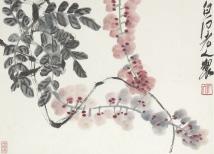

Expert remark: Note the smaller size (33 x 44.4 cm).
Estimate EUR 20,000
Starting price EUR 10,000
305
203
‘PLUM BLOSSOMS’, BY QI BAISHI (1864-1957), DATED 1923
China. Ink on paper, with a Japanese silk brocade mounting. Exquisitely painted with a flowering plum tree in the winter, the branches and twigs mostly upright with few hanging down, the blossoms and buds neatly detailed, the thicker branches executed with bold, dynamic brushstrokes.
Inscriptions: Lower left, signed ‘Baishi weng’ (old man Baishi), inscribed ‘The winter plum blossoms and the rest of the year, a thousand-year friendship with the rest of the year’, and dated ‘in the Winter of the Year of Guihai’ (corresponding to 1923). The last character (託) indicates that this work was painted by Qi Baishi in order to entrust it to the recipient.
Provenance: Kono Shuson, Japan, acquired directly from the artist. A private collection, acquired from the above, and thence by descent. The back with an old Japanese paper label from Kono Shuson, stamped and inscribed ‘Dai yonhyaku-ju-roku-go, Sai Hakuseki sensei, Kono Shuson sei’ (Number 416, Painting of Winter Plum Blossoms by Master Qi Baishi, compounded by Kono Shuson). Two further paper labels, each inscribed ‘7541’. Kono Shuson (1890-1987) was a Japanese painter and a pivotal figure in promoting the Nanga (Chinese literati) school of paintings in Japan. With Tomioka Tessai (18361924) as a consultant, he founded the Nihon Nanga-in (Japan Literati Painting Academy) and visited China frequently, including his first documented visit in 1923, the year the present work was painted. This is when he probably met Qi Baishi for the very first time, shortly after Qi’s initial exhibition in Japan (see lot essay below). He then began to import Qi Baishi’s works to Japan, together with the paintings of other contemporary Chinese artists, selling them at the Takashimaya Department Store and other notable places. He always mounted such paintings on Japanese kakejiku scrolls. For a work bearing a similar label from Kono Shuson, see for example Bonhams Hong Kong, 2 March 2022, lot 29, by Zhang Daqian (1899-1983), Scholar under Willow Tree.
Condition: Good condition with some wear, soiling, and few minor abrasions.
Dimensions: Image size 106.5 x 56 cm, Size incl. mounting 144 x 68 cm
Qi Baishi painted plum blossoms in several styles, including copies of those painted by Jin Nong (1687-1763), which the present lot shares some affinities with, including the absence of colors. Qi Baishi’s later plum paintings are primarily inspired by Wu Changshuo (1844-1927), who preferred bright colors and introduced an epigraphic aesthetic to the art of painting. Here however, Qi depicts the plum tree with its upward trunk and branches in calligraphic strokes of somber ink. The present painting can therefore be said to reflect an earlier style in painting plum blossoms for Qi Baishi, whose earliest works depicting this subject are dated by inscription to the year 1921, two years before the present work was executed. Qi’s paintings are, first of all, reflections of things and feelings that he had personally experienced in life. In the case of plum blossoms, his fondness of this subject resulted from nostalgia for his hometown in Hunan, where his dwelling, named ‘Studio of Hundred Plums’, was surrounded by a plum grove.
Qi Baishi (1864-1957) is one of the world’s most important artists of the 20th century and has received countless honors and awards like no other painter in the People’s Republic of China. He began his career as a carpenter, though he taught himself to paint using a manual from the Qin dynasty period. His style, which Qi Baishi developed in the second half of his life, is characterized by a powerful, spontaneous brushstroke. He expanded his subject matter to insects, birds, figures, animals, vegetation, and landscapes, and began to incorporate rich color into his compositions, painting in an ever-freer style. His works are focused on the spiritual, ephemeral, and mystical qualities of the human condition. In 1953, he was elected president of the China Artists Association, and one year later he was elected to the National People’s Congress.

Qi Baishi moved to Beijing in 1916 and earned his living there by selling paintings. However, his painting style was not welcome in Beijing at that time. Taking the advice of Chen Shizeng, Qi Baishi began his famous “initiating self-art-reform in senile age”, which finally led Qi Baishi to tremendous success. In 1922, Chen Shizeng visited Japan. He brought some works by Qi Baishi for exhibition and sale. This was the first time that Qi Baishi’s paintings were shown in Japan, and anywhere outside China. It is probable that Kono Shuson (the first owner of the present work) saw Qi’s work at this exhibition and was inspired to make his first trip to China less than a year later in 1923, meeting with the master for the first time. As recalled by Qi Baishi: “After Chen Shizeng returned to Beijing, I was told that all my paintings sold at very nice prices! Each of my paintings sold for at least 100 silver coins, and the landscape paintings were even more expensive, 250 silver coins for one that was only 60 inches long! I never imagined such prices in China! And I was also told that the French planned to exhibit my works and those of Shizeng in the Paris Art Expo. The Japanese were going to film my life and work for a movie! All this was just amazing! Afterwards, many foreigners came to Beijing to purchase my paintings, and I have been better off since then. It was Shizeng who helped me in my career and life - I will remember this forever.” (Baishi Laoren Zishu, Shandong Huabao Publishing House, 2000, pp. 131-133)

Auction result comparison:
Type: Related
Auction: Beijing Council International Auctions, 4 December 2013, lot 984
Price: CNY 632,500 or approx. EUR 110,000 converted and adjusted for inflation at the time of writing
Description: Qi Baishi, The ink plum blossom (1923)
Expert remark: Compare the related manner of painting with mostly upright branches and using only ink. Note that the work was painted in the same year (1923) as the present lot.
AUCTION RESULT COMPARISON
Type: Related
Auction: Poly International, Beijing, 17 December 2017, lot 1930
Price: CNY 862,500 or approx. EUR 142,000 converted and adjusted for inflation at the time of writing
Description: Qi Baishi, Plum blossom (1924)
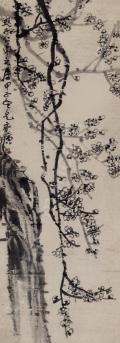
Expert remark: Compare the related manner of painting, also using only ink, but with more hanging branches than the present lot. Note that the work was painted one year later (1924) than the present lot.
Auction result comparison:
Type: Related
Auction: Christie’s New York, 9 December 2020, lot 48
Price: USD 18,750 or approx. EUR 20,500 converted and adjusted for inflation at the time of writing
Description: Qi Baishi (with signature of, 1863-1957), Plum Blossoms
Expert remark: Note the much smaller size (26.5 x 19 cm) of this work and the low estimate of only USD 300-600, which was clearly overruled by the market, with bidding eventually ending at USD 18,750.
Estimate EUR 20,000
Starting price EUR 10,000
306
204
Photo portrait of Qi Baishi in 1956
Kono Shuson (1890-1987)

307

308
205
‘SCHOLAR UNDER A WUTONG TREE’, BY ZHANG
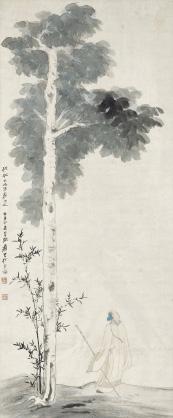 DAQIAN (1899-1983)
DAQIAN (1899-1983)
Exquisitely painted with a bearded scholar seated on a bamboo chair, wearing loose-fitting robes and a tall cap, under two blossoming wutong trees, their leaves painted in shades of blue with virtuosic skill, all above a squatting attendant fanning a small oven to prepare some tea.
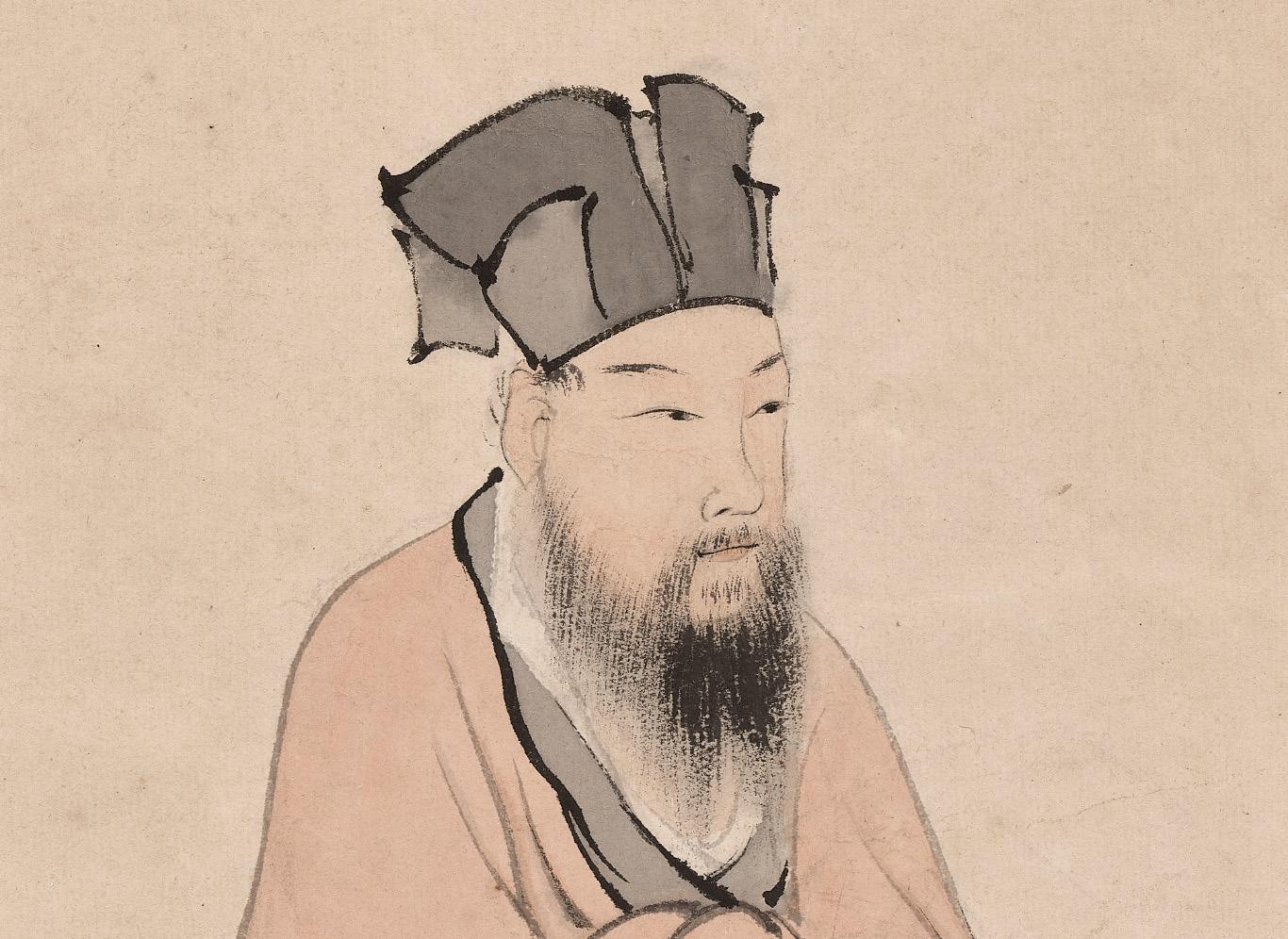
China. Ink and watercolors on paper, with a silk brocade frame and mounted as a hanging scroll.
Inscriptions: Upper right, signed ‘Zhang Daqian Yuan’, and titled ‘Scholar under a Wutong Tree’, two seals of the artist, ‘Zhang Yuan siyin’ and ‘Daqian Jushi’. Lower left, one seal.
Provenance: The Oliver Impey Collection of Modern Paintings. Oliver Impey (1936-2005) was the President of the Oriental Ceramics Society (19972000), a noted curator at the Ashmolean Museum in Oxford, and a leading authority on the arts of Japan. He studied at the University of Oxford, completing his thesis while working in London at Sotheby’s, where his connoisseurship and remarkable breadth of knowledge began to develop, as well as his intimate knowledge of the art trade and vigilant eye for a bargain. In 1967, he was appointed Assistant Keeper for Japanese Art at the Ashmolean, and was able, as a Sotheby’s colleague put it rather bluntly, to move “straight from the whorehouse to the nunnery”. For nearly four decades, Impey was a tireless acquirer of fine objects, vastly expanding the Museum’s holdings. He designed and raised the funds for a new Japanese Decorative Arts gallery to house these treasures and he also befriended several generous benefactors, who made important donations to the Museum. The respect with which he was held in Japan was marked by the award of the Koyama Fujio Memorial Prize in 1997. His personal collection contained works by major masters from Japan, China, and several other Asian countries, of which many were sold by Christie’s in Hong Kong in the late 2000s. Condition: Good condition with some wear, creasing, soiling, small losses, minor touchups, the roller caps lost.
Dimensions: Image size 98 x 51 cm, Size incl. mounting 208 x 62.4 cm
Zhang Daqian (1899-1983) was one of the best-known and most prodigious Chinese artists of the twentieth century. Originally active as a guohua (traditionalist) painter, by the 1960s he was also renowned as a modern impressionist and expressionist painter. In addition, he is regarded as one of the most gifted master forgers of the twentieth century. After the Communist Revolution in 1949, he left China and spent years living in South and North America, extensively touring Northern California. Zhang’s first California solo exhibition in 1967 at Stanford University attracted an opening reception crowd of a thousand. Finally, he settled in Taipei, Taiwan in 1978. During his years of wandering, he had several wives simultaneously, curried favor with influential people, and maintained a large entourage of relatives and supporters. He also kept a pet gibbon and affected the long robe and long beard of a traditional Chinese scholar.
AUCTION RESULT COMPARISON
Type: Related
Auction: Christie’s Hong Kong, 30 November 2021, lot 1127
Price: HKD 275,000 or approx. EUR 33,000 converted and adjusted for inflation at the time of writing
Description: Zhang Daqian (1899-1983), Scholar Looking for Inspiration
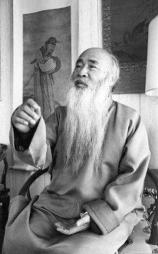

Expert remark: Compare the closely related subject with a similarly painted tree. Note the size (107 x 41.2 cm).
Estimate EUR 10,000
Starting price EUR 5,000
309
Oliver Impey (1936-2005)
Zhang Daqian (1899-1983)
206
‘AUTUMN MOUNTAIN LANDSCAPE’, BY HUANG JUNBI (1898-1991), CHINA, DATED 1951
Boldly painted with a scholar seated amid bamboo stalks near a bridge in a vast misty landscape with towering mountains, pines and other trees, two waterfalls, and small huts.
Ink and watercolors on paper, with a silk brocade frame and mounted as a hanging scroll.
Inscriptions: Upper left, signed ‘Huang Junbi’, titled ‘Landscape’, and dated ‘In the Summer of the Year of Xinmao’ (corresponding to 1951). Two seals of the artist, ‘Huang Junbi yin’ and ‘Jun Weng’.
Provenance: The Oliver Impey Collection of Modern Paintings.
Sotheby’s Hong Kong, 3 October 2011, lot 1836, sold for HKD 300,000 or approx. EUR 49,000 (converted and adjusted for inflation at the time of writing). A private collector, acquired from the above. Oliver Impey (1936-2005) was the President of the Oriental Ceramics Society (1997-2000), a noted curator at the Ashmolean Museum in Oxford, and a leading authority on the arts of Japan. He studied at the University of Oxford, completing his thesis while working in London at Sotheby’s, where his connoisseurship and remarkable breadth of knowledge began to develop, as well as his intimate knowledge of the art trade and vigilant eye for a bargain. In 1967, he was appointed Assistant Keeper for Japanese Art at the Ashmolean, and was able, as a Sotheby’s colleague put it rather bluntly, to move “straight from the whorehouse to the nunnery”. For nearly four decades, Impey was a tireless acquirer of fine objects, vastly expanding the Museum’s holdings. He designed and raised the funds for a new Japanese Decorative Arts gallery to house these treasures and he also befriended several generous benefactors, who made important donations to the Museum. The respect with which he was held in Japan was marked by the award of the Koyama Fujio Memorial Prize in 1997. His personal collection contained works by major masters from Japan, China, and several other Asian countries, of which many were sold by Christie’s in Hong Kong in the late 2000s.

Condition: Very good condition with minor wear and little soiling.
Dimensions: Image size 115 x 54 cm, Size incl. mounting 217 x 64 cm
Huang Junbi (1898-1991) was an important Chinese master painter, who strongly believed in the inheritance of traditional brushwork while reforming it constantly to express one’s personal feelings. He moved to Taiwan together with Pu Ru and Zhang Daqian in 1949, the group thus becoming known as the ‘The Three Masters Crossing The Sea’. Huang studied both Chinese and Western painting in Guangzhou and Japan, eventually teaching at the National University in Chongqing (Guoli zhongyang daxue) during the Second SinoJapanese war. After 1949, he became the head of the Fine Arts Department at the National Taiwan University.
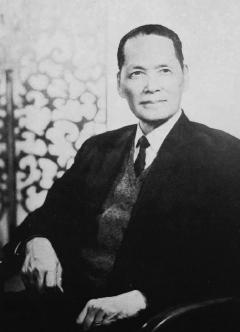
AUCTION RESULT COMPARISON
Type: Closely related
Auction: Bonhams San Francisco, 16 December 2014, lot 8401
Price: USD 75,000 or approx. EUR 88,500 converted and adjusted for inflation at the time of writing
Description: Huang Junbi (1898-1991), Waterfall Landscape, dated 1943

Expert remark: Note the size (102.9 x 59.4 cm)
AUCTION RESULT COMPARISON
Type: Closely related
Auction: Christie’s Hong Kong, 27 November 2012, lot 1339
Price: HKD 800,000 or approx. EUR 124,000 converted and adjusted for inflation at the time of writing
Description: Huang Junbi (1898-1991), Mountainous Landscape, dated 1941

Expert remark: Note the size (96 x 40.6 cm)
Estimate EUR 12,000
Starting price EUR 6,000
310
Huang Junbi (1898-1991)

311
‘SCHOLARS ON A BOAT’, BY FU BAOSHI (1904-1965), DATED 1962
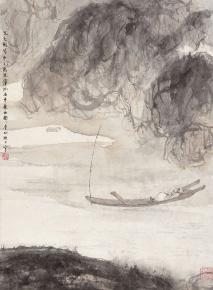
Ink and watercolors on paper, laid down on paper. Superbly painted in the artist’s characteristic style, mostly eschewing outlines in his dappling of the brush and ink washes while still meticulously rendering each element with distinctive purpose. Depicting two scholars seated in a boat, two fishing baskets at their side, floating along a calm stream below thick clouds, the riverbank with leafy and barren trees.
Inscriptions: Upper right, ‘View in the country, painted by Baoshi in Nanjing in May of the Year of Renyin (corresponding to 1962)’.
Provenance: West Berkshire, United Kingdom, local trade. By repute acquired from a private estate.
Condition: Some wear and minor soiling, losses, creasing. The paper with areas of minor corrugation. The mounting with creasing and small tears to edges.
Dimensions: Image size 32.4 x 34 cm, Size incl. mounting 40 x 52 cm
Fu Baoshi (1904-1965) was a Chinese painter from Xinyu, Jiangxi Province. Credited with revolutionizing Chinese ink painting, Fu is perhaps the most original figure painter and landscapist of China’s modern period, and one of the most important artists of the 20th century overall. In 1933, Fu went to Japan to study the History of Oriental Art at the Tokyo School of Fine Arts. After returning to China, he taught in the Art Department of Central University (today Nanjing University). At this time, Fu developed


a new style, smoothly incorporating foreign ideas and techniques, and began creating boldly individualistic yet sometimes strongly nationalistic work. He also sought to revive early schools of realist depiction that made greater use of color and ink wash. His most important and acclaimed works of landscape painting employed skillful use of inking methods, such as washing, rubbing or dotting, creating a distinct style that encompasses a sheerly enormous range of varieties, but all within strict traditional rules. His detailed paintings of miniature figures remain unmatched to this day, due to his remarkably delicate and thus inimitable brushstrokes.
Auction result comparison:
Type: Related
Auction: Christie’s Hong Kong, 1 December 2020, lot 1065
Price: HKD 8,650,000 or approx. EUR 1,051,000 converted and adjusted for inflation at the time of writing
Description: Fu Baoshi (1904-1965), Returning Boat
Expert remark: Note the much larger size (61.2 x 49.7 cm)
AUCTION RESULT COMPARISON
Type: Related
Auction: Christie’s Hong Kong, 27 May 2014, lot 1608
Price: HKD 3,640,000 or approx. EUR 521,000 converted and adjusted for inflation at the time of writing
Description: Fu Baoshi (1904-1965), Scholar
Resting on a Boat
Expert remark: Note the larger size (53 x 49.2 cm).
Estimate EUR 6,000
Starting price EUR 3,000
207
Fu Baoshi (1904-1965)
208
‘A PORTRAIT OF AUTUMN’, BY ZHOU SICONG (1939-1996), DATED 1978
China. Ink and watercolors on paper. Depicting two young boys playing with bowls, framed by banana leaves which are suggested by vivid brushstrokes. Note the gently graduated intensity of the black ink, adding depth and three-dimensionality to the work, one of the widely acclaimed skills of Zhou Sicong.

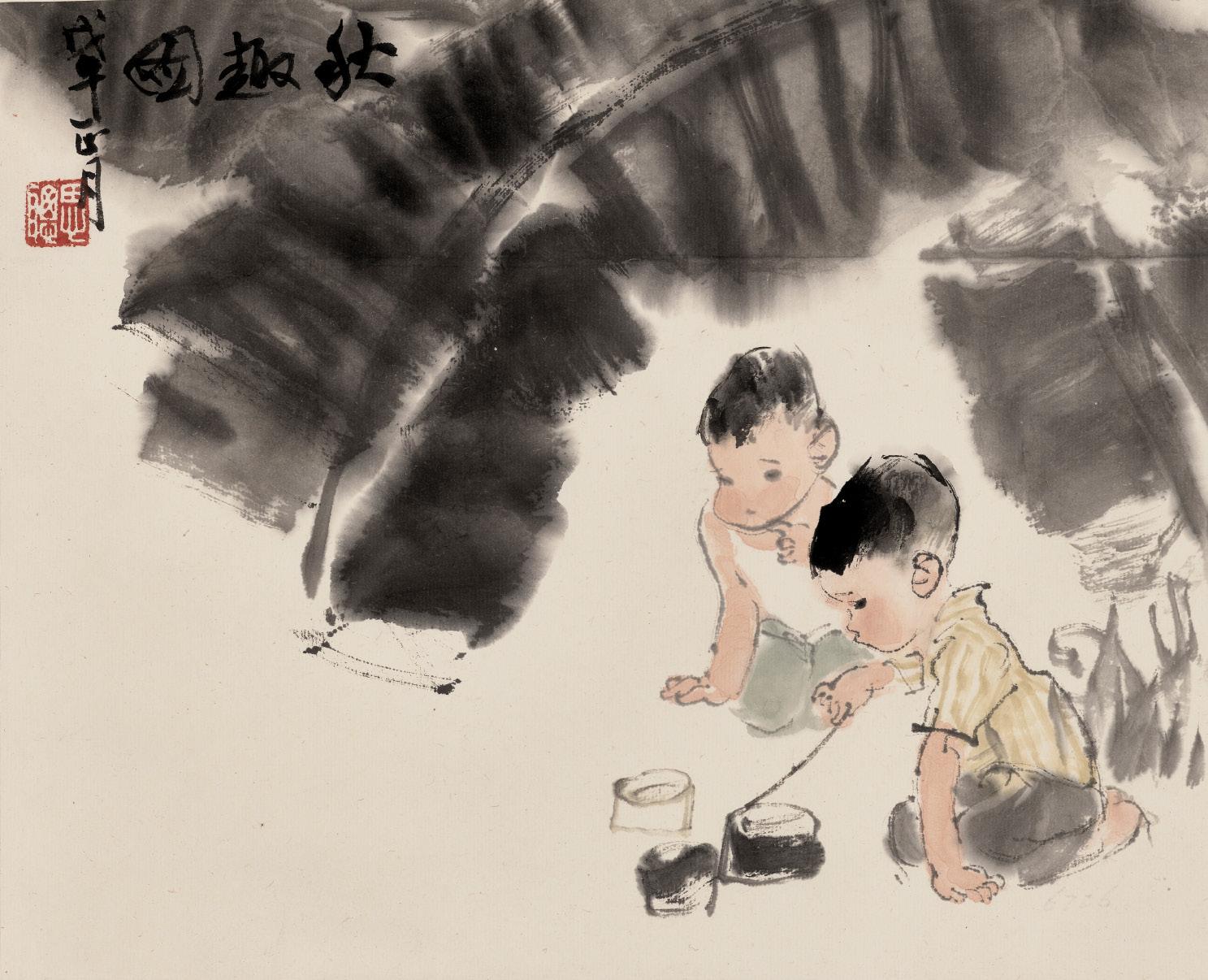
Inscriptions: Top left, inscribed ‘A Portrait of Autumn’, dated ‘First month of the year wuwu (1978)’. One seal of the artist, ‘Sicong’.
Provenance: From a British private collection, acquired between 1978 and 2000, and thence by descent.
Condition: Excellent condition with minor wear.
Dimensions: Size incl. frame 62.5 x 47 cm, image size 34.5 x 27.5 cm
Framed behind glass. (2)
Zhou Sicong (1939-1996) was a Chinese painter born in Ninghe, Hebei Province. She graduated in 1963 from the Chinese painting department of the Central Art Academy and later worked at the Beijing Painting Institute. Zhou is well-known for her figurative watercolor and oil paintings. Her work won the first prize in the prestigious Fifth National Fine Arts Exhibition in 1979, only one year after the present work was painted, and is now in the collection of the National Museum of Fine Arts, among other public collections. Her paintings have been exhibited across China, Japan, and other parts of Asia, as well as in Europe and the US.
Zhou Sicong (1939-1996)

AUCTION RESULT COMPARISON
Type: Closely related
Auction: China Guardian, Beijing, 25 March 2012, lot 1706
Price: CNY 402,500 or approx. EUR 70,500 converted at the time of writing
Description: Children and Banana Leaves (1979), Zhou Sicong (1939-1996)
Expert remark: Compare the closely related motif and composition. Note the size (68 x 45 cm).
Auction result comparison:
Type: Closely related
Auction: China Guardian, Beijing, 19 March 2011, lot 543
Price: CNY 230,000 or approx. EUR 41,500 converted and adjusted for inflation at the time of writing
Description: Children Playing (1981), Zhou Sicong (1939-1996)
Expert remark: Compare the closely related motif and composition. Note the size (66 x 45 cm).
Auction result comparison:
Type: Closely related
Auction: China Guardian, Beijing, 13 January 2018, lot 69
Price: CNY 172,500 or approx. EUR 23,500 converted and adjusted for inflation at the time of writing
Description: Children playing (1979), Zhou Sicong (1939-1996)
Expert remark: Compare the closely related motif and composition. Note the size (68 x 46 cm).
Estimate EUR 6,000
Starting price EUR 3,000
313
209
‘PAIR OF HERONS’, BY LIN FENGMIAN (1900-1991)
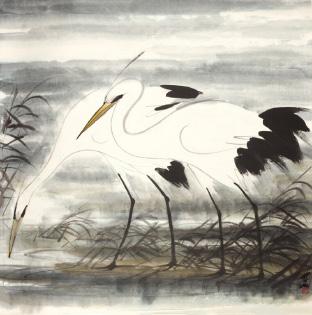
China. Ink and watercolor on paper. Depicting a pair of herons perched at the shore of a lake, fishing, surrounded by reeds, painted with vivid brush strokes, and sharp yellow beaks.

Inscriptions: Lower right, signed ‘Lin Fengmian’. One seal, ‘Lin Fengmian’
Provenance: From a noted private collection. By repute acquired from a collector who purchased the painting directly from Chung Kiu Chinese Products Emporium, which was established on Nathan Road in Hong Kong in 1958, and is a known early provenance of works by Lin Fengmian. Merchant paper label to backside with inscription: “Lin Fegmian, pair of herons”.
Condition: Very good condition with only minor wear, few minuscule tears, some foxing, and little creasing.
Dimensions: Image size 72 x 65.5 cm, Size incl. mounting 100 x 93 cm
Framed. (2)
Lin Fengmian (1900-1991) is considered a pioneer of modern Chinese painting, mostly for blending Western and Chinese styles, as he was one of the earliest Chinese painters to study in Europe. He was also an important innovator in the area of Chinese art education and one of The Four Great Academy Presidents, a group of artists who were revered in the early Republic due to their effective stewardship of the art academies they presided over.

Lin Fengmian (1900-1991)
AUCTION RESULT COMPARISON
Type: Closely related
Auction: Sotheby’s London, 4 November 2020, lot 131
Price: GBP 119,700 or approx. EUR 160,000 converted and adjusted for inflation at the time of writing
Description: Lin Fengmian (19001991), Two cranes
Expert remark: Compare the closely related motif, brush strokes, color, and size (66 x 69.5 cm)
Estimate EUR 30,000
Starting price EUR 15,000
314

315
210 ‘ZHUAN ZHU ASSASSINATES KING LIAO’, BY GUAN LIANG (1900-1986), DATED 1980
China. Ink and watercolors on paper, with a silk brocade frame and mounted as a hanging scroll. Depicting the theatric scene of the assassin Zhuan Zhu offering a fish to King Liao of Wu, who is standing in the back dressed in a yellow robe and wearing the Lingzi, a headdress with pheasant tails. The dagger with which Zhuan eventually killed the king is hidden inside the fish.


Inscriptions: Bottom left, inscribed ‘Zhuan Zhu stabs King Liao of Wu’, dated ‘in October of the Year of Gengshen’ (corresponding to 1980), signed ‘Guan Liang’. One seal ‘Guan Liang’. Top right, one seal of the artist, ‘Nanting’.
Provenance: From a private collection, acquired shortly after 1980, and thence by descent. British trade, by repute acquired from the above. Condition: Excellent condition with only minor wear, little foxing, and few small stains.
Dimensions: Image size 107 x 55.3 cm, Size incl. mounting 124 x 65.7 cm
Guan Liang (1900-1986) was a Chinese painter born in Guandong Province. He studied art in Japan and specialized in Chinese oil painting. Guan was a fine arts educator, professor at the Zhejiang Academy of Fine Arts in Zhejiang, China, and the director of the Shanghai branch of the Chinese Artists Association. Guan once mentioned that Paul Gauguin, Vincent van Gogh, and Henri Matisse had left a deep impression and a lasting influence on him, and that in his work he sought to merge Western techniques with Chinese themes.
Guan Liang (1900-1986)

Guan Liang developed a passion for Chinese opera from a young age, having grown up attending performances with his father. He was captivated by performing arts and became deeply involved in Beijing opera by acting and learning the art of theater from an opera singer, as well as acquiring costumes and props. In his opera ink paintings, Guan captures the spirit of each character by depicting their facial expressions and the emotions in their eyes.
The painting depicts the theater scene where Zhuan Zhu kills King Liao of Wu. Zhuan Zhu was an assassin who lived in the Spring and Autumn period. He was recruited by Prince Guang, who wanted to kill the king in order to take the throne himself. Zhuan Zhu finally managed to kill the king during a party with a dagger hidden in a fish.
AUCTION RESULT COMPARISON
Type: Related
Auction: Christie’s Hong Kong, 29 May 2012, lot 2911
Price: HKD 250,000 or approx. EUR 39,500 converted and adjusted for inflation at the time of writing
Description: Guan Liang, Opera Figures - Farewell My Concubine
Expert remark: Compare the related motif. Note the smaller size (67.5 x 44 cm).
AUCTION RESULT COMPARISON
Type: Related
Auction: Christie’s Hong Kong, 26 November 2013, lot 1428
Price: HKD 275,000 or approx. EUR 44,000 converted and adjusted for inflation at the time of writing
Description: Opera Figures
Expert remark: Note the considerably smaller size (33.5 x 34.5 cm).
Estimate EUR 8,000
Starting price EUR 4,000
316
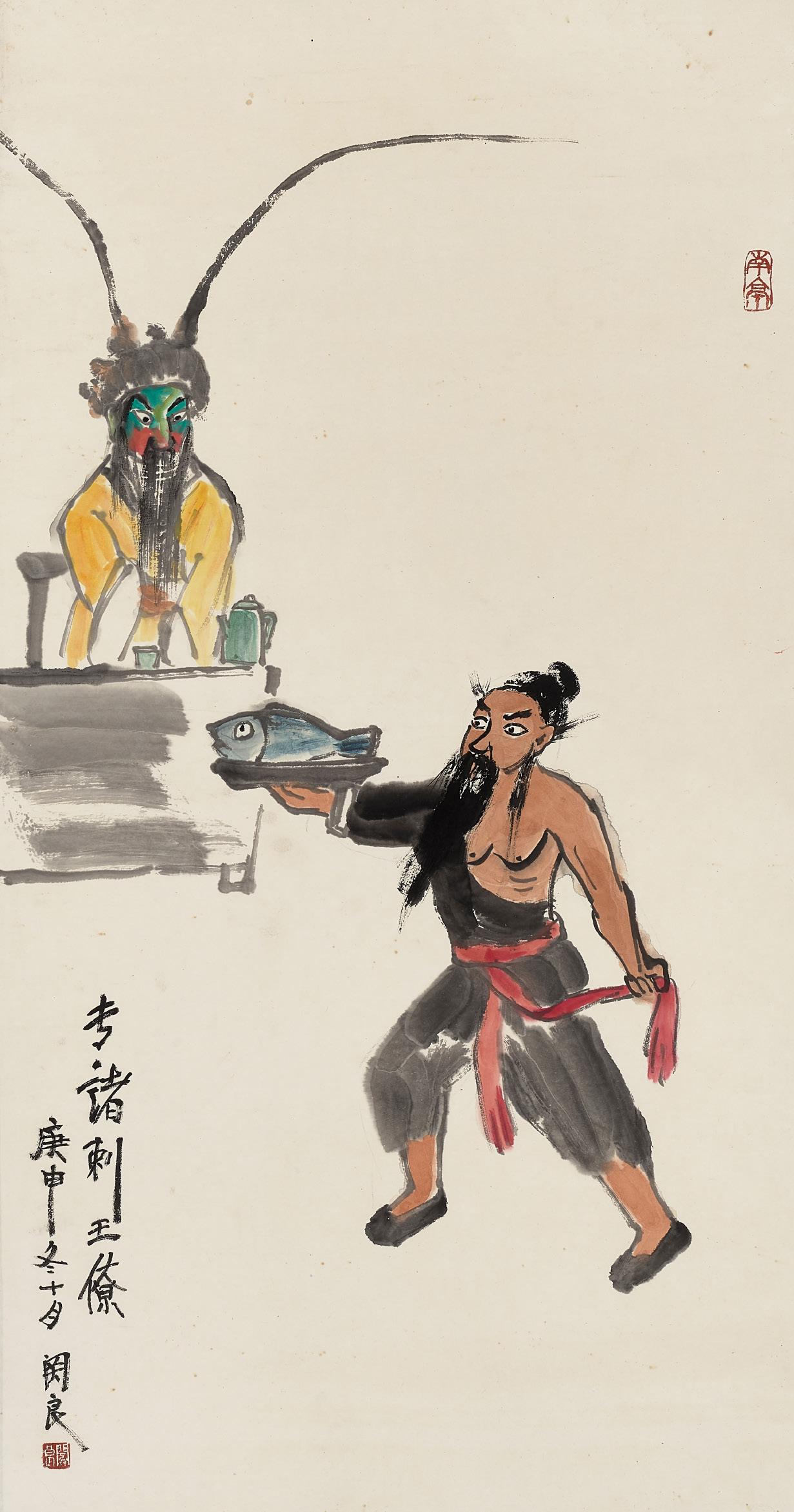
317
‘AUTUMN’,
China. Ink and watercolors on paper. Depicting an autumnal mountain landscape with a large tree in the front right, covered in red leaves, three farmers carrying buckets above a bridge, and birds in flight.
Inscriptions: Upper left, dated ‘February 1986, in Guangzhou’, and signed ‘Xiongcai’. Two seals, ‘Xiongcai Jijiu’ and ‘Guduanren ye’.
Provenance: Hong Kong trade. By repute acquired from a noted private collector.
Condition: Very good condition with few small stains, minor creasing, little foxing, and few abrasions. Laid down on paper.
Dimensions: Image size 103 x 53.3 cm
Li Xiongcai (1910-2001) was a figure, flower, bird, and landscape painter. Born in Gaoyao in the Guangdong Province, Li received his earliest artistic training from his father, and later studied with Gao Jianfu, founder of the Lingnan School of painting. His studies focused on Chinese painting and other artistic techniques, as well as sketching. In 1932, Li was given a scholarship by the Chunshui Studio to study Fine Art at the Tokyo Art Institute, which gave him the opportunity to learn about the various innovations in painting made by Japanese artists at the time. During the Second Sino-Japanese War, Li traveled extensively in the western part of China. Throughout his travels, he studied the details of cultural relics, and made a series of sketches of the places he visited. Li held a number of solo exhibitions throughout his career. In 1978, he was appointed as professor and deputy director of the Guangzhou Institute of Fine Arts. He was also elected director of the Chinese Artists Society, and deputy director of the Chinese Artists Association in Guangdong. In 2012, a retrospective of his work was held at the National Art Museum of China. Many of his most well-known works were executed on a large scale, and were characterized by bold, fluid brushstrokes.

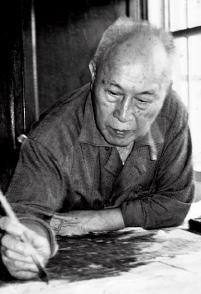
AUCTION RESULT COMPARISON
Type: Closely related
Auction: Bonhams Hong Kong, 29 May 2018, lot 1354
Price: HKD 2,000,000 or approx. EUR 262,000 converted and adjusted for inflation at the time of writing
Description: Li Xiongcai (1910-2001), Autumn Forest and Waterfall
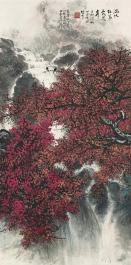
Expert remark: Compare the closely related motif and red accents. Note the size (137.5 x 67.8 cm).
AUCTION RESULT COMPARISON
Type: Closely related
Auction: Christie’s Hong Kong, 28 May 2010, lot 723
Price: HKD 300,000 or approx. EUR 51,500 converted and adjusted for inflation at the time of writing
Description: Li Xiongcai (1910-2001), Riding in the Autumn Woods

Expert remark: Compare the closely related motif and red accents. Note the size (69 x 43 cm).
Estimate EUR 12,000
Starting price EUR 6,000
318
211
BY LI XIONGCAI (1910-2001), DATED 1986
Li Xiongcai (1910–2001)

319
A RARE ‘PENSIVE MONKEY’ BRONZE VESSEL, DONG SON CULTURE
Vietnam, 500 BC to 300 AD. The vessel in the form of a seated monkey with slender elongated arms and legs, one elbow resting on his knee, the left hand lowered toward his waist and touching his prominent member. The face of almond shape with bulging eyes and a broad nose, the incised mouth forming a subtle smile, flanked by two tubular ears, the mouth of the vessel at the top of his head. The body incised with vertical lines, the recessed base decorated with a characteristic spiral design.
Provenance: From the private collection of Paolo Bertuzzi (1943-2022), who was a fashion stylist from Bologna, Italy, and the son of Enrichetta Bertuzzi, founder of Hettabretz, a noted Italian fashion company with customers such as the Rothschild family, Audrey Hepburn, and Elizabeth Taylor. Paolo Bertuzzi later took over his mother’s business and designed exclusive pieces, some of which were exhibited in the Costume Institute of the Metropolitan Museum in New York, USA. He was also an avid collector of antiques for more than 60 years. His collection includes both archaic and contemporary art, and he edited two important books about Asian art, Goa Made - An Archaeological Discovery, about a large-scale archaeological project carried out with the Italian and Indonesian governments, and Majapahit, Masterpieces from a Forgotten Kingdom.
Condition: Minor old repairs and fills as generally expected from ancient Dong Son excavations. Some losses, fissures, signs of weathering and erosion, casting flaws. Overall, still very good condition commensurate with age. Fine malachite-green patina with brown encrustations overall.
Weight: 663.8 g
Dimensions: Height 20 cm
Dong Son (named for Dong Son, a village in Thanh Hoa, Vietnam) was a Bronze Age culture in ancient Vietnam centered at the Red River Valley of northern Vietnam from 1000 BC until the first century AD. Vietnamese historians attribute it to the states of Văn Lang and Âu Lạc. Its influence spread to other parts of Southeast Asia, including Maritime Southeast Asia, throughout the first millennium BC. The culture long remained a mystery to western archaeologists, and it was known only through its bronze objects, many of which were taken from burial sites. Dong Son bronze objects were exhibited in Europe for a century before their original location was even determined, and several theories and speculations over the dating methodologies of the culture continue to this day.
Literature comparison: Compare a related seated male figure, though of much smaller size (8.9 cm), in the collection of the Metropolitan Museum of Art, accession number 2000.287.
AUCTION RESULT COMPARISON
Type: Closely related
Auction: Galerie Zacke Vienna, 16 October 2021, lot 579
Price: EUR 15,168 or approx. EUR 16,500 converted and adjusted for inflation at the time of writing

Description: A rare male bronze figure, Dong Son culture
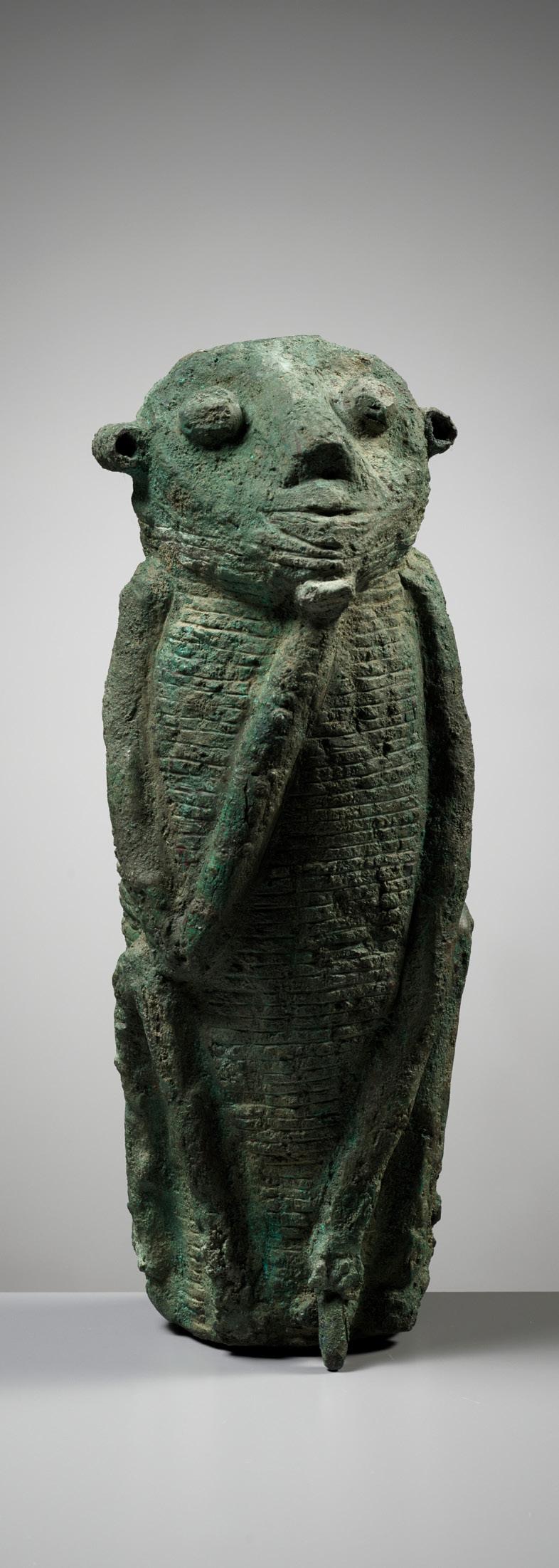

Expert remark: Compare the nude man with prominent member and related incised decoration. Note the size (28 cm).
Estimate EUR 3,000
Starting price EUR 1,500
320
212
Paolo Bertuzzi working on one of his books, Goa Made. An Archaeological Discovery
213 A BRONZE DEATH MASK, DONG SON CULTURE
Vietnam, 500 BC to 300 AD. Cast as the face of a man with arched brows above deep eye sockets, pierced almond-shaped eyes, a broad nose, and full lips, the mouth slightly open.
Provenance: From the collection of Paolo Bertuzzi (1943-2022), who was a fashion stylist from Bologna, Italy. He was the son of Enrichetta Bertuzzi, founder of Hettabretz, a noted Italian fashion company with customers such as the Rothschild family, Audrey Hepburn, and Elizabeth Taylor. Paolo Bertuzzi later took over his mother’s business and designed exclusive pieces, some of which were exhibited in the Costume Institute of the Metropolitan Museum in New York, USA. He was also an avid collector of antiques for more than 60 years. His collection includes both archaic and contemporary art, and he edited two important books about Asian art, Goa Made - An Archaeological Discovery, about a large-scale archaeological project carried out with the Italian and Indonesian governments, and Majapahit, Masterpieces from a Forgotten Kingdom.
Condition: Fine condition commensurate with age and displaying remarkably well given its high age. Some losses, dents, nicks, scratches and old wear. Expected signs of weathering, erosion and corrosion. Minor structural cracks, old fills and repairs. Magnificent, naturally grown patina overall with extensive malachite and cuprite encrustations.
Weight: 315.9 g
Dimensions: Height 20.8 cm
Dong Son (named for Dong Son, a village in Thanh Hoa, Vietnam) was a Bronze Age culture in ancient Vietnam centered at the Red River Valley of northern Vietnam from 1000 BC until the first century AD. Vietnamese historians attribute it to the states of Van Lang and Au Lạc. Its influence spread to other parts of Southeast Asia, including Maritime Southeast Asia, throughout the first millennium BC. The culture long remained a mystery to western archaeologists, and it was known only through its bronze objects, many of which were taken from burial sites. Dong Son bronze objects were exhibited in Europe for a century before their original location was even determined, and several theories and speculations over the dating methodologies of the culture continue to this day.
Literature comparison: Compare a related Dong Son bronze face mask, lacking most of the patina because of extensive restoration and conservatory work, illustrated by Danny Tan, Assistant Curator of the Asian Civilizations Museums, Singapore.
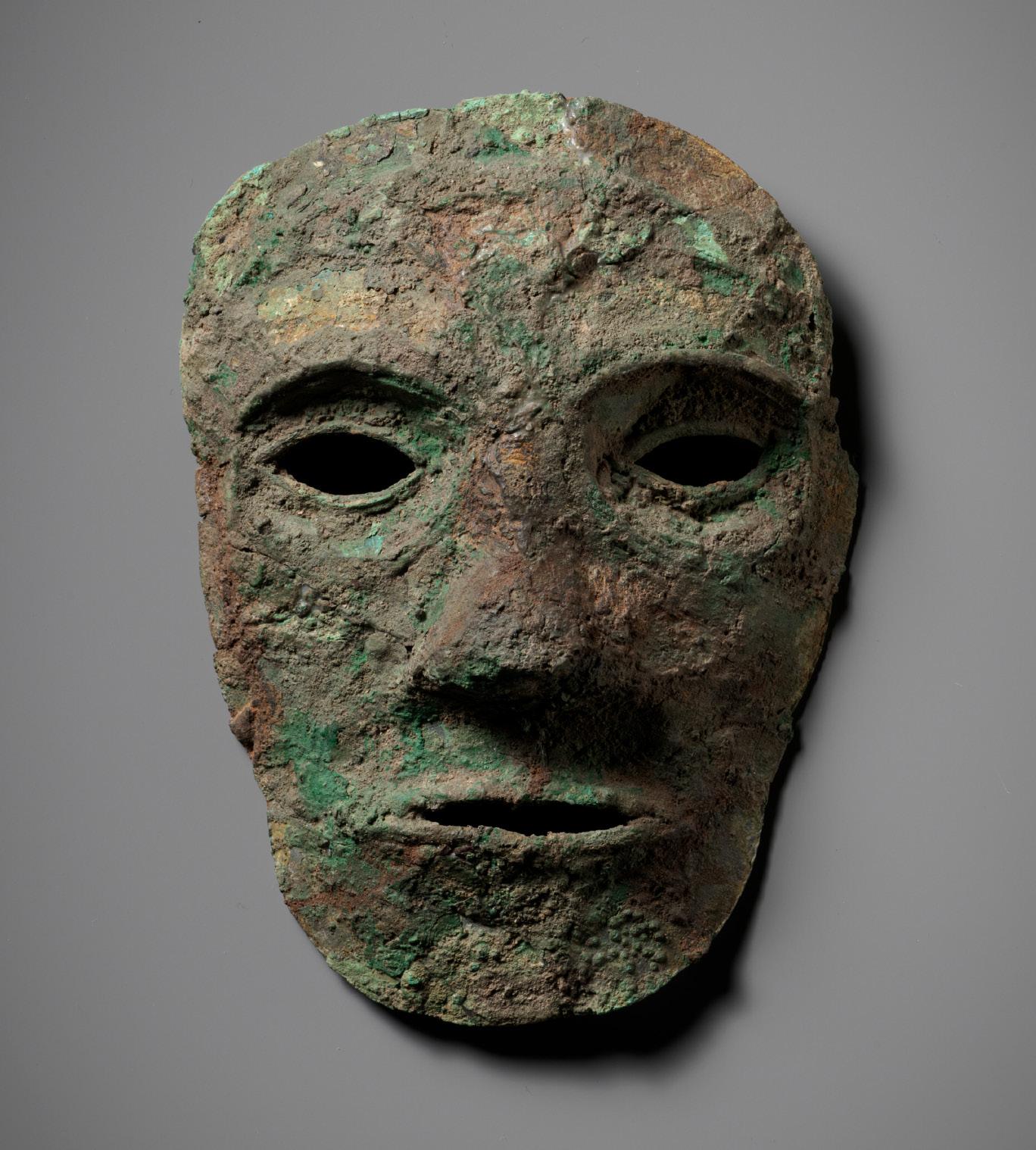
Estimate EUR 3,000
Starting price EUR 1,500
321

A BRONZE HEAD OF A MAN, GOA MADE, EAST JAVA, INDONESIA, 1ST MILLENNIUM BC - 1ST MILLENNIUM AD
Published: Claudio Giardino, Massimo Vidale, and Gian Luca Bonora (editors), Goa Made - An Archeological Discovery, Rome, 2012, page 241, no. 215.
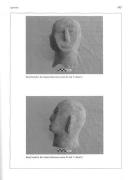

Agus Aris Munandar, Hitawasana: Studies on Indonesian Archeology, page 55, no. 6.

Weight: 735.1 g
Dimensions: Height 26 cm


Finely cast and modeled in the round with a hollow interior. The face with almond-shaped eyes below prominent lids and gently arched brows, centered by a long nose of trapezoidal section above a raised mouth, flanked by elongated ears.


Provenance: A private collector in London, United Kingdom, and thence by descent to his daughter Amanda Torri. Alex Torri, Bologna, Italy, inherited from the above. Paolo Bertuzzi, acquired from the above in 2002. A copy of the original invoice from Alex Torri, dated 25 June 2002, showing an image of the present lot, and stating a purchase price of ITL 15,000,000 or approx. EUR 12,000 (converted and adjusted for inflation at the time of writing), accompanies this lot. Paolo Bertuzzi (1943-2022) was a fashion stylist from Bologna, Italy, and the son of Enrichetta Bertuzzi, founder of Hettabretz, a noted Italian fashion company with customers such as the Rothschild family, Audrey Hepburn, and Elizabeth Taylor. Paolo Bertuzzi later took over his mother’s business and designed exclusive pieces, some of which were exhibited in the Costume Institute of the Metropolitan Museum in New York, USA. He was also an avid collector of antiques for more than 60 years. His collection includes both archaic and contemporary art, and he edited two important books about Asian art, Goa Made - An Archaeological Discovery, about a large-scale archaeological project carried out with the Italian and Indonesian governments, and Majapahit, Masterpieces from a Forgotten Kingdom. Condition: Excellent condition, commensurate with age. Some wear, minor losses, small nicks, light scratches, signs of weathering and erosion, encrustations. The head is entirely covered in a superb, naturally grown, malachite-green patina with small areas of azurite encrustation to the interior.

Paolo Bertuzzi working on one of his books, Goa Made. An Archaeological Discovery

Goa (or Gua) Made (Made Cave) is a site north of the Brantas River in East Java. Its importance was first discovered by Anacleto Spazzapan, an Italian archeologist, designer, and collector of ethnographic and folk art who frequently traveled to Indonesia. He was first led to the site in 1999 and brought back fragments of fired clay, which he sent to Arcadia labs in Milan for thermoluminescence testing. The first official excavations were subsequently conducted in an underground temple by the Bureau for the Archaeological Conservation of East Java (BACEJ) in 2001 and 2006, the latter funded by Paolo Bertuzzi (the last owner of the present lot), who had developed a profound interest in the site. Finds included imported glazed pottery, Chinese copper or bronze coins, and highly distinct bronze heads such as the present lot. Thermoluminescence analysis of terracotta bricks found in the excavations indicated a date in the early 1st millennium BC. This would not only suggest the discovery of a lost civilization but also challenge widely held notions of Southeast Asian history. The earliest uncontested architectural remains in East Java are two temples dating from the 8th - 9th century AD.
Inside
In 2007, larger-scale excavations were carried out by a team of Italian and Indonesian archeologists, which revealed a previously overlooked shaft, a complex subterranean structure displaying a sophisticated integrated design that would have required mass community involvement in both its construction and usage. In the following years, disagreements between archeologists involved in the Goa Made project began to emerge. A 2010 article by Andreas M. Steiner and Massimo Vidale in the renowned Italian magazine Archeo supports the dating of the bronze heads to the early 1st millennium BC. In the same year, however, Fiorella Rispoli wrote an article for World Archeology Magazine wherein she questions the accuracy of the thermoluminescence analysis and instead proposed a post-10th century AD dating for the bronze heads, suggesting that the underground temple was most likely a water control system, while the heads should rather be placed within the tradition of East Java folk practices. In his 2016 book Hitawasana, Studies on Indonesian Archeology (where the present lot is illustrated, page 55), Prof. Dr. Agus Aris Munandar from the University of Indonesia wrote that further scientific studies remain necessary, and that additional research is expected to step-by-step resolve the questions regarding this important archeological site.

Estimate EUR 6,000
Starting price EUR 3,000
323
214
the underground complex in which the Goa Made bronze heads were found
A TERRACOTTA FIGURE OF A SEATED MOTHER GODDESS, MATURE HARAPPAN
Scientific Analysis Report: A thermoluminescence sample analysis has been conducted by Arcadia, Tecnologie Per I Beni Culturali, Milan, dated 7 May 2014, reference no. 273D. The result is consistent with the suggested period of manufacture. A copy of the thermoluminescence analysis report accompanies this lot.

Indus Valley Civilization, c. 2500 BC. Finely potted, the deity in a seated pose with bent knees, the arms lowered and extended forward below her voluptuous breasts, the face with neatly incised elongated eyes below gently arched brows, the ovoid head with small pierced ears.

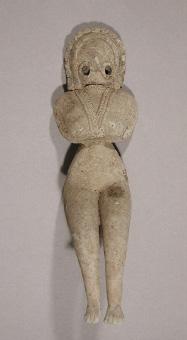
Provenance: Bruno Cooper, Norwich, United Kingdom, 2010. Paolo Bertuzzi, acquired from the above. A copy of the original invoice from Bruno Cooper, dated 4 December 2010, dating the piece to the 2nd millennium BC, and stating a purchase price of EUR 3,800 or approx. EUR 5,000 (adjusted for inflation at the time of writing), accompanies this lot. Paolo Bertuzzi (1943-2022) was a fashion stylist from Bologna, Italy, and the son of Enrichetta Bertuzzi, founder of Hettabretz, a noted Italian fashion company with customers such as the Rothschild family, Audrey Hepburn, and Elizabeth Taylor. Paolo Bertuzzi later took over his mother’s business and designed exclusive pieces, some of which were exhibited in the Costume Institute of the Metropolitan Museum in New York, USA. He was also an avid collector of antiques for more than 60 years. His collection includes both archaic and contemporary art, and he edited two important books about Asian art, Goa Made - An Archaeological Discovery, about a large-scale archaeological project carried out with the Italian and Indonesian governments, and Majapahit, Masterpieces from a Forgotten Kingdom.
Condition: Excellent condition, commensurate with age. Extensive wear, small losses, minor nicks, light scratches, some hairline cracks, small chips, minor old repairs and fills, encrustations, signs of weathering and erosion, the back with a shallow hole from sample-taking.
Weight: 123.7 g
Dimensions: Height 15.5 cm
The Indus Valley Civilization was a Bronze Age culture in the northwestern regions of South Asia, lasting from 3300 BC to 1300 BC, and in its mature form 2600 BC to 1900 BC. Together with ancient Egypt and Mesopotamia, it was one of three early civilizations of the Near East and South Asia, and of the three, the most widespread. Its sites spanned an area from northeast Afghanistan and much of Pakistan to western and northwestern India. The civilization flourished both in the alluvial plain of the Indus River, which flows through the length of Pakistan, and along a system of perennial monsoon-fed rivers that once coursed in the vicinity of the Ghaggar-Hakra, a seasonal river in northwest India and eastern Pakistan. The cities of the ancient Indus were noted for their urban planning, baked brick houses, elaborate drainage systems, water supply systems, clusters of large non-residential buildings, and techniques of handicraft and metallurgy. Both Mohenjo-Daro and Harappa likely grew to a size of 30,000 and 60,000 individuals, and the civilization may have contained between one and five million total population during its florescence. It is also known as the Harappan civilization, after its type site Harappa, the first to be excavated early in the 20th century in what was then the Punjab province of British India and is now Punjab, Pakistan. The discovery of Harappa and soon afterwards Mohenjo-Daro was the culmination of work that had begun after the founding of the Archaeological Survey of India in the British Raj in 1861. There were earlier and later cultures called Early Harappan and Late Harappan in the same area. The early Harappan cultures were populated by Neolithic civilizations, the earliest and best-known of which is Mehrgarh in Balochistan, Pakistan. Harappan civilization is sometimes called Mature Harappan to distinguish it from the earlier cultures

LITERATURE COMPARISON
Compare a related terracotta figure of a seated mother goddess, 13.3 cm high, dated ca. 3000-2500 BC, in the Metropolitan Museum of Art, accession number 2001.305. Compare a related limestone or lime plaster head, 4.57 cm high, dated ca. late 3rd to early 2nd millennium BC, in the Metropolitan Museum of Art, accession number 1988.81.1.
Estimate EUR 3,000
Starting price EUR 1,500
324 215
A MAGNIFICENT AND VERY LARGE TERRACOTTA FIGURE OF A STANDING BEAUTY, MAJAPAHIT PERIOD

Java, 14th-16th. The lady modeled standing with her right arm wrapped around the waist, dressed in a long robe, with bare feet, adorned with a floral necklace, bangles, and circular earrings, the face with almond shaped eyes, subtle smile and high coiffure, a hair arrangement typical of the period.
Provenance: From the private collection of a diplomat in England, and thence by descent to the last owner.
Condition: Some old wear, soil encrustations and signs of weathering. Minor nicks, cracks, losses, obvious repairs, overall commensurate with age and exactly as expected of a 14th-century terracotta statue from this region.
Dimensions: Height 74.7 cm
Ornamental roof statues such as the present lot often decorated houses in the capital of the East Javanese kingdom of Majapahit near the present-day village of Trowulan. Sculptures, molded in clay and sun dried or baked at low temperatures, enhanced and protected the main columns of these open, pavilion-like buildings. Dressed in an orthodox Majapahit fashion with a hair arrangement typical of the period, the standing woman gazes outward in a pensive manner. Figures such as this often illustrated popular legends of the period, and it is possible that she was part of a larger narrative series.
LITERATURE COMPARISON
Compare with a closely related statue at the Metropolitan Museum of Art, New York, gift of MarieHélène and Guy Weill, in memory of William Wolff, 1992, accession number 1992.151.

AUCTION RESULT COMPARISON
Type: Related
Auction: Bonhams San Francisco, 10 December 2012, lot
5378
Price: USD 4,500 or approx. EUR 5,500 converted and adjusted for inflation at the time of writing
Description: A tuff standing female, Java, Majapahit period, 14th-16th century Expert remark: Compare the related pose and coiffure. Note the much smaller size (27.9 cm).

Estimate EUR 4,000
Starting price EUR 2,000
216
A SANDSTONE HEAD OF AVALOKITESHVARA, PRE-ANGKOR PERIOD
Khmer Empire, late 7th – early 8th century. Well carved, the serene face with almond-shaped eyes, round pupils, a ridged brow centered by a neatly incised spiral mark representing the urna, full lips forming a calm smile, and a thin wavy mustache. The hair is piled up into a high chignon centered by an image of the Buddha Amitabha.

Provenance: From the collection of René Ronveaux (d. 1991), Belgium, probably acquired in the 1970s, and thence by descent in the same family. A copy of a provenance statement, written and signed by the previous owner, dated 8 December 2022, confirming the provenance stated above, accompanies this lot.
Condition: Very good condition, commensurate with age. Wear, losses, minor structural cracks, nicks, scratches, signs of weathering and erosion, encrustations.
Weight: 5,986 g (excl. stand) and 7,569 g (incl. stand)
Dimensions: Height 26 cm (excl. stand) and 31 cm (incl. stand)
LITERATURE COMPARISON
Compare a closely related sandstone head of Avalokiteshvara, 22 cm high, dated to the last quarter of the 7th century, in the Musée Guimet, Paris, accession number MA2554, exhibited in The Metropolitan Museum of Art, Lost Kingdoms: Hindu-Buddhist Sculpture of Early Southeast Asia, 5th to 8th Century, 14 April to 27 July 2014. For a complete figure of Avalokiteshvara from the Battambang area, see Garnier and Nafilyan L’art Khmer en situation de reserve, Paris, 1997, no. 89.

Estimate EUR 6,000
Starting price EUR 3,000
326
217
A SANDSTONE HEAD OF GARUDA, KOH KER STYLE, KHMER EMPIRE, 10TH CENTURY
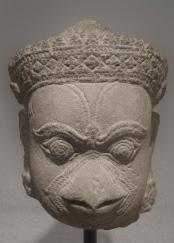
The face finely carved and well detailed with large bulging eyes, the thick brows and prominent beak with beaded decoration, the beard and hair neatly incised, the head surmounted by an elaborate foliate crown and conical headdress.

Provenance: From the collection of René Ronveaux (d. 1991), Belgium, probably acquired in the 1970s, and thence by descent in the same family. A copy of a provenance statement, written and signed by the previous owner, dated 8 December 2022, confirming the provenance stated above, accompanies this lot.
Condition: Good condition, commensurate with age. Wear, losses, nicks, scratches, signs of weathering and erosion, encrustations.
Weight: 7,226 g (excl. stand) and 8,322 g (incl. stand)
Dimensions: Height 27 cm (excl. stand) and 38 cm (incl. stand)
Koh Ker, which lies 50 miles (80 km) northeast of Angkor, was the capital of the Khmer Empire from 928-944. Koh Ker’s sculptural style is thus distinct from those developed in Angkor’s immediate vicinity. The stone sculpture,
often monumental in size, is imbued with a heightened sense of movement and suppleness of form. The Koh Ker rulers adhered to the Hindu religion, especially the Shaiva sect.
Garuda is a half-bird, half-human creature that appears in both Hinduism and Buddhism. In Hinduism, Garuda is the mount of the god Vishnu and the sworn enemy of the Naga serpent. As a symbol of supremacy, this bird-king demonstrates the harmony between power and grace, creating a magical figure of strength and heroism.
LITERATURE COMPARISON
Compare a closely related head of Garuda, also dated to the 10th century, in the Honolulu Museum of Art, accession number 12394.1. Compare a closely related Koh Ker sandstone head of Garuda, 16 cm high, in the National Museum of Cambodia, inventory number Ka.3053. Compare a complete sandstone figure of Garuda, 216.5 cm high, in the National Museum of Cambodia, inventory number Ka.1737.
Estimate EUR 8,000
Starting price EUR 4,000
327 218

A MONUMENTAL SANDSTONE FIGURE OF NARASIMHA, KHMER EMPIRE, 10TH-12TH CENTURY
Finely carved to depict an imposing anthropomorphic guardian with a fierce gaze, displaying the head of a lion and body of a man, kneeling on a square plinth, wearing a pleated sampot, holding a vajra in his right hand. Note the unusually elaborate coiffure, especially at the backside of the head.
Provenance: An old collection in the United States, formed between the 1970s and 1990s, by repute acquired as part of a deaccession from an American museum. A private collection in California, United States, acquired from the above.
Condition: Overall good condition, commensurate with age. Extensive wear, some losses, dents, structural cracks with associated old fills, signs of weathering and erosion, drilled to underside of platform. Fine, naturally grown patina.
Dimensions: Height 84 cm
Such imposing figures, a symbol of both caution and importance, once served as guardians at the gates and entrances of sacred temple sites throughout Southeast Asia. The mythical composition of the figure, in addition to the presence of a celestial weapon, alludes to this being a divine being with powers far greater than that of any mortal. The iconography, an evolutionary mix of lion imagery with fierce deities, is one repeated throughout the ancient world, from the Gates of Ishtar to the Temple of Todaiji.
Expert’s note: The figure compares well against closely related examples that have come on the market in the last century, however also exhibits subtle stylistic differences from each that make connecting it to any specific temple site or region difficult. This is further confounded by the fact that many known sites are in varied states of disarray and near complete ruin. For example, if compared with the Banteay Srei guardians of Cambodia, we see that the vajra is proportionally much larger, and the style of the face is much more rectangular. The two are clearly from different areas. In addition to the old restorations, the figure exhibits other attractive signs of weathering, including complex organic growth in the form of black algae (upper torso) and crustose lichens (left knee), and is decidedly ancient. We must conclude that the figure is from a yet unknown site somewhere else in the vast ancient Khmer empire, an empire that at its peak was larger than the Byzantine Empire, and spread across the countries of China, Thailand, Vietnam, Cambodia, and Myanmar.
LITERATURE COMPARISON
Compare a closely related sandstone figure of Narasimha, 82.5 cm high, Banteay Srei style, dated to the late 10th century, in the National Museum of Cambodia, inventory number Ka.786 (fig. 1). Note the difference in gaze, being downward facing versus straight-on, the noticeably smaller vajra, and the thicker platform. Interestingly, note the very similar damage to the right arm and right thigh, damage that is also shared to some extent with a comparison from Christie’s below. The figure in the National Museum of Cambodia appears to exhibit fewer characteristic signs of surface weathering than the present lot and in comparison has the feeling of being a younger figure.

AUCTION RESULT COMPARISON
Type: Closely related
Auction: Christie’s Paris, 6 June 2011, lot 381
Price: EUR 97,000 or approx. EUR 115,000 adjusted for inflation at the time of writing
Description: An important sandstone figure of a lion-headed guardian, Cambodia, Khmer, Koh Ker style, mid-10th century Expert remark: The figures share several characteristics. The Christie’s example, however, attributed to Koh Ker, has a style that is somewhat fleshier and more playful. It also has a platform adorned with lotus petals. Note the identical size (84 cm) and similar areas of damage to the right arm and thigh.

AUCTION RESULT COMPARISON
Type: Closely Related
Auction: Christie’s Amsterdam, 20 November 2001, lot 215.
Price: EUR 19,975 or approx. EUR 31,500 adjusted for inflation at the time of writing
Description: A Khmer, Angkor Vat style, sandstone figure of a lion-headed guardian


Expert remark: Stylistically, the body is similar at first appearance, but the Christie’s figure has significantly less detail. The lack of finer carving work is most notable on the face, with less teeth, larger swirls on the muzzle, and plain convex eyes. It is also significantly smaller (55 cm).
Estimate EUR 20,000
Starting price EUR 10,000
329
219
fig. 1
A BRONZE FIGURE OF A DANCING HEVAJRA, ANGKOR PERIOD, BAYON STYLE
Khmer Empire, late 12th to early 13th century. The eight-headed deity very well cast dancing atop a prostrate figure with one leg raised and arms radiating around him holding diminutive figures of deities and animals, wearing a short sampot secured with a pendent fishtail sash, the details intricately rendered.
Provenance: From a noted private collection. A copy of a certificate of authenticity, N° 389912, issued and signed by an archeologist and an official representative of the Asian Antiques Association of Thailand, dated 17
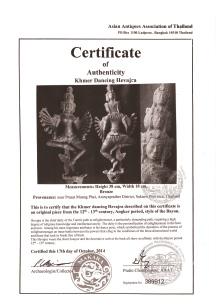
October 2014, confirming the dating above, and noting Prasat Muang Phai, Sakaew province, Thailand, as the original provenance for the present figure, accompanies this lot. A copy of an export license, issued by the government of the Kingdom of Thailand, EB0078/2022, also accompanies this lot.
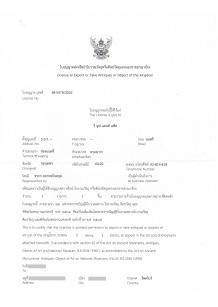
Condition: Good condition, commensurate with age. Extensive wear, minor losses, small dents and nicks, signs of weathering and erosion, soil deposits, corrosion, encrustations, all as expected from a Khmer bronze of nearly 1,000 years of age. Superb, naturally grown, rich patina with extensive malachite encrustation and faint hues of cuprite. The surface of the figure has been cleaned in areas where the corrosion was thick and obscured the cast detail. A corrosion inhibiting varnish was then applied to the surface for protection against moisture intake from the atmosphere.
Weight: 3,613 g (excl. base)
Dimensions: Height 37.5 cm (excl. base, incl. tang) and 41 cm (incl. base)
With a fitted modern metal base. (2)
Hevajra is the personification of enlightenment, the dance pose symbolizing the process of enlightenment as liberation from worldly constraints.

LITERATURE COMPARISON
Compare a closely related Khmer Bayon-style bronze of Hevajra, 22.7 cm high, in the National Museum of Cambodia, inventory number Ga.4170 (fig. 1). Another closely related example was exhibited in the Ethnological Museum, Berlin. Compare a closely related Khmer Bayon-style bronze of Hevajra, 41 cm high, dated c. 1180-1230, illustrated in Wolfgang Felten and Martin Lerner, Thai and Cambodian Sculpture from the 6th to the 14th centuries, Stuttgart, 1988, p. 235, no. 37. fig. 1
AUCTION RESULT COMPARISON
Type: Closely related
Auction: Christie’s New York, 23 September 2004, lot 57
Price: USD 31,070 or approx. EUR 44,500 converted and adjusted for inflation at the time of writing
Description: A bronze figure of a dancing Hevajra, Khmer, Angkor period, Bayon style, late 12th/early 13th century

Expert remark: Compare the closely related pose, number of heads and arms, and malachite patina. Note the smaller size (24 cm).
Estimate EUR 20,000
Starting price EUR 10,000
330 220

A LARGE BRONZE FIGURE OF AVALOKITESHVARA, ANGKOR PERIOD, BAYON STYLE
Khmer Empire, 12th-13th century. Finely cast, standing in samabhanga atop a square plinth, holding in his four hands a water vessel, rosary, lotus flower, and a book. Wearing a short sampot secured with an elaborate belt and the fishtail hem extending to the knee. His serene face with almond-shaped eyes, gently arched brows, and full lips, the hair drawn up into a high chignon centered by a small image of the Buddha Amitabha and secured with a foliate crown.

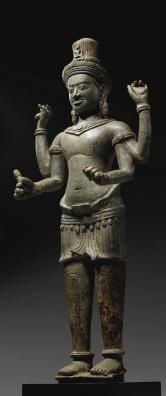
Provenance: From the private collection of Camille Mines (1950-2018), Luxembourg. By repute acquired by his father, René Mines, in the local trade during the early 1970s. By descent to Robert Mines. A copy of a handwritten provenance statement signed by Robert Mines, dated 15 September 2022, confirming the above, accompanies this lot. Condition: Very good condition, commensurate with age. Extensive wear, some losses and cracks, small nicks, light scratches, signs of weathering and erosion, possibly minor old fills. Fine, naturally grown, solid patina with malachite encrustations.
Dimensions: Height 40.5 cm (incl. stand), height 33.5 cm (excl. stand)
Mounted on a modern stand. (2)
Literature comparison: For similar examples see P. Krairiksh, Khmer Bronzes – A Selection from the Suan Phka Tevoda Collection, Lugano, 1982, fig. 3; and G. Coedes, Bronzes Khmers, Ars Asiatica, Vol. V, Paris, Les Editions G. Van Oest, 1923, pl. XXVI, no. 3.
AUCTION RESULT COMPARISON
Type: Closely related
Auction: Sotheby’s New York, 19 March 2008, lot 243
Price: USD 73,000 or approx. EUR 91,500 converted and adjusted for inflation at the time of writing
Description: Avalokiteshvara, copper alloy, Khmer, Angkor period Expert remark: Note the size (34 cm).
AUCTION RESULT COMPARISON
Type: Closely related
Auction: Christie’s New York, 21 September 2007, lot 366
Price: USD 21,250 or approx. EUR 27,500 converted and adjusted for inflation at the time of writing
Description: A bronze figure of Lokeshvara, Khmer, Angkor period, Bayon style, 13th century

Expert remark: Note the size (26.5 cm).
Estimate EUR 16,000
Starting price EUR 8,000
221
A BRONZE FIGURE OF THE GODDESS UMA, KHMER, ANGKOR WAT STYLE, 12TH – 13TH CENTURY

Uma is standing upon a simple square plinth with her hands extended, dressed in a pleated sampot suspended from a charm-embellished belt and a central sash tapering off in a fishtail shape. Her body is ornamented in fine jewelry, including a collar necklace, bracelets, armbands, earrings, and an ornate diadem. The face finely cast with almond shaped eyes and wide mouth.
Provenance: Sotheby’s New York, 22 March 1989, lot 438. A Swiss private collection, acquired from the above. The base with an old label, ‘Soth. NY 22.3.1989 Lot 438’. Note that on the image in the Sotheby’s catalog, the present statue shows an inappropriate modern gilding which was since then professionally removed.
Condition: Good condition commensurate with age, with extensive wear, some weathering, a few small nicks and dents, expected casting flaws. The feet re-attached to the base with old soldering marks.
Weight: 1,106 g
Dimensions: Height 26.8 cm

Expert’s note: The details of the face, clothing, and jewelry of the present lot are all indicative of the Angkor period. Uma was a favored goddess in Khmer Angkor, and while sandstone representations of the goddess abound, devotional bronze figures of Uma are considerably rarer.
LITERATURE
COMPARISON
Compare a related bronze figure of Uma, dated 11th12th century, in the Victoria & Albert Museum, accession number IS.621993.


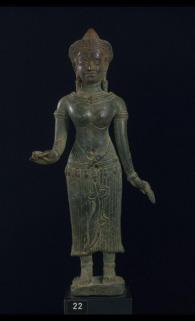
AUCTION RESULT
COMPARISON
Type: Closely related
Auction: Christie’s New York, 23 July 2020, lot 36
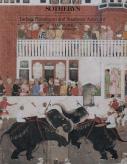
Price: USD 8,125 or approx. EUR 9,000 converted and adjusted for inflation at the time of writing
Description: A rare bronze figure of Uma, Khmer, Angkor period, 12th century
Expert remark: Compare the closely related pose and dress. Note the much smaller size (18.5 cm).
Estimate EUR 4,000
Starting price EUR 2,000
222
A RARE SANDSTONE HEAD OF HARIHARA, PRE-ANGKOR PERIOD


Southern Cambodia, 7th to late 8th century. Finely carved with a serene expression, almond-shaped eyes with neatly incised pupils, and full lips forming a subtle smile, flanked by long pendulous earlobes. The hair is partly jatamakuta (braided) and partly kiritamakuta (cylindrical), representing Shiva and Vishnu, respectively.
Provenance: From the private collection of Camille Mines (1950-2018), Luxembourg. By repute acquired by his father, René Mines, in the local trade during the early 1970s. By descent to Robert Mines. A copy of a handwritten provenance statement signed by Robert Mines, dated 15 September 2022, confirming the above, accompanies this lot. Condition: Good condition, commensurate with age. Extensive wear, cracks, losses, nicks, scratches, signs of weathering and erosion, encrustations.
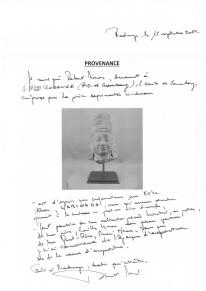
Dimensions: Height 30 cm (excl. stand), height 41 cm (incl. stand)
Mounted to a modern stand. (2)
Syncretism is a favored device in Indian cosmologies for representing the complex and multifaceted personalities of the gods. The oldest
archaeological evidence of this practice is sculptures from Kushana-era Mathura (late 1st – 3rd century), northern India, depicting Shiva combined with his female aspect, Parvati, as the androgynous Ardhanarishvara. Vishnu (Hari) combined with Shiva (Hara) appeared later in India, in the fifth century during the Gupta period, and is explained mythically as Shiva representing the male half of the universe and Vishnu, in his female aspect as Mohini, representing the female element. Harihara is born of their sexual union.
The artistic styles that developed during the Pre-Angkor period, before the capital was moved north to Angkor, exhibit a wider range of artistic motifs than those that would develop during the Angkor period. Phnom Da, located in Southern Cambodia, was an important center of artistic creation during the 6th-7th centuries.
LITERATURE COMPARISON
Compare a related sandstone head of Harihara, 11.5 cm high, also dated to the Pre-Angkor period, in the National Museum of Cambodia, inventory number Ka.2687. Compare a related sandstone head of Harihara, dated to the early 7th century, in the collection of the Musée Guimet, inventory number MG14899 (fig. 1), exhibited in The Metropolitan Museum of Art, Lost Kingdoms: HinduBuddhist Sculpture of Early Southeast Asia, 5th to 8th Century, 14 April to 27 July 2014, cat. no. 91. fig. 1
Estimate EUR 14,000
Starting price EUR 7,000
334 223
A GRAY SCHIST FIGURE OF A WINGED ATLAS, ANCIENT REGION OF GANDHARA, 3RD - 4TH CENTURY

The atlant squats with his right leg raised, his toes outstretched, his right hand resting on his knee and his left still holding part of the superstructure which was originally located above him. His face superbly carved with almond-shaped eyes below bushy furrowed brows and full bow-shaped lips, framed by thick tufts of hair, flanked by his large wings.
Provenance: An old private collection in France. Acher Eskenasy, Paris, France, acquired from the above in 2001. LP Collection Paris, France, acquired from the above. Acher Eskenasy is a noted French scholar and collector of Asian and tribal art. Major works previously owned by him are now in important collections and museums, such as the Metropolitan Museum of Art in New York and the Musée du Quai Branly in Paris.
Condition: Good condition, commensurate with age. Extensive wear, losses, nicks, scratches, structural cracks, signs of weathering and erosion, encrustations. With an old sand-colored pigment coating.
Weight: 8,241 g (incl. stand)
Dimensions: Height 30.5 cm (excl. stand) and 35.5 cm (incl. stand)
With a fitted wood stand. (2)
Only a few sculptures communicate so clearly the classical legacy in Gandharan art. His mature, bushy face recalls the portraits of Greek and Roman gods and leaders, while his Herculean musculature evokes the athletic ideal. Furthermore, the atlant type stems from a tradition in classical architecture of depicting male and female figures supporting architectural superstructures best known from The Ten Books on Architecture by Vitruvius, dedicated to Emperor Augustus (see Rowland, Vitruvius: Ten Books on Architecture, Cambridge, 1999, pages 83 and 135).
In the Gandharan context, similar examples in stucco surviving in situ line the veneer of stupa bases at Taxila and Hadda, recording the placement of such figures at Buddhist sites. Whilst maintaining a similar function and a clearly Western look, the Gandharan version differs from the classical prototype in the common inclusion of wings and the primarily ornamental rather than architectural function of the figure. Moreover, while we have evidence from which to understand his context at Buddhist sites, his precise identity remains a mystery. He has been called a disguised
yaksha, a lesser Greek god, and a Garuda, yet there is no archaeological or textual foundation to underpin any of these claims (see Foucher, L’art Gréco-Bouddhique du Gandhara, 1905, page 208, and Errington, The Western Discovery of the Art of Gandhara and the Finds of Jamalgarhi, London, 1987, page 67). Perhaps, the term “Atlas” ties him too closely to the classical prototypes, at the risk of obscuring added layers of meaning in the unique Gandharan context.
Literature comparison: For a further discussion of winged Atlas figures from Gandhara, see P. Pal, Asian Art at the Norton Simon Museum, vol. 1, fig. 35, p. 68. For similar examples of winged “Atlas” figures, see W. Zwalf, A Catalogue of the Gandhara Sculpture at the British Museum, 1996, pp. 206211, fig. 355-368. Two other examples survive in the Claude de Marteau collection in Brussels and the Peshawar Museum (see Kurita, Gandharan Art, vol. II, Tokyo, 1990, figs. 448 & 453, pp. 155 & 157).

AUCTION RESULT COMPARISON
Type: Closely related
Auction: Bonhams New York, 17 March 2014, lot 66
Price: USD 245,000 or approx. EUR 280,000 converted and adjusted for inflation at the time of writing
Description: A schist figure of a winged atlas, Ancient region of Gandhara, 3rd/4th century
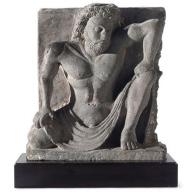
Expert remark: Note the larger size (40 cm).
AUCTION RESULT COMPARISON
Type: Closely related
Auction: Christie’s New York, 21 March 2007, lot 238
Price: USD 12,000 or approx. EUR 15,500 converted and adjusted for inflation at the time of writing
Description: A Gray Schist Figure of Atlas, Gandhara, 2nd/3rd Century
Expert remark: Compare the subject, style of carving and material. Note the slightly smaller size (28.5 cm).
Estimate EUR 10,000
Starting price EUR 5,000
224
A GRAY SCHIST HEAD OF BUDDHA, KUSHAN PERIOD
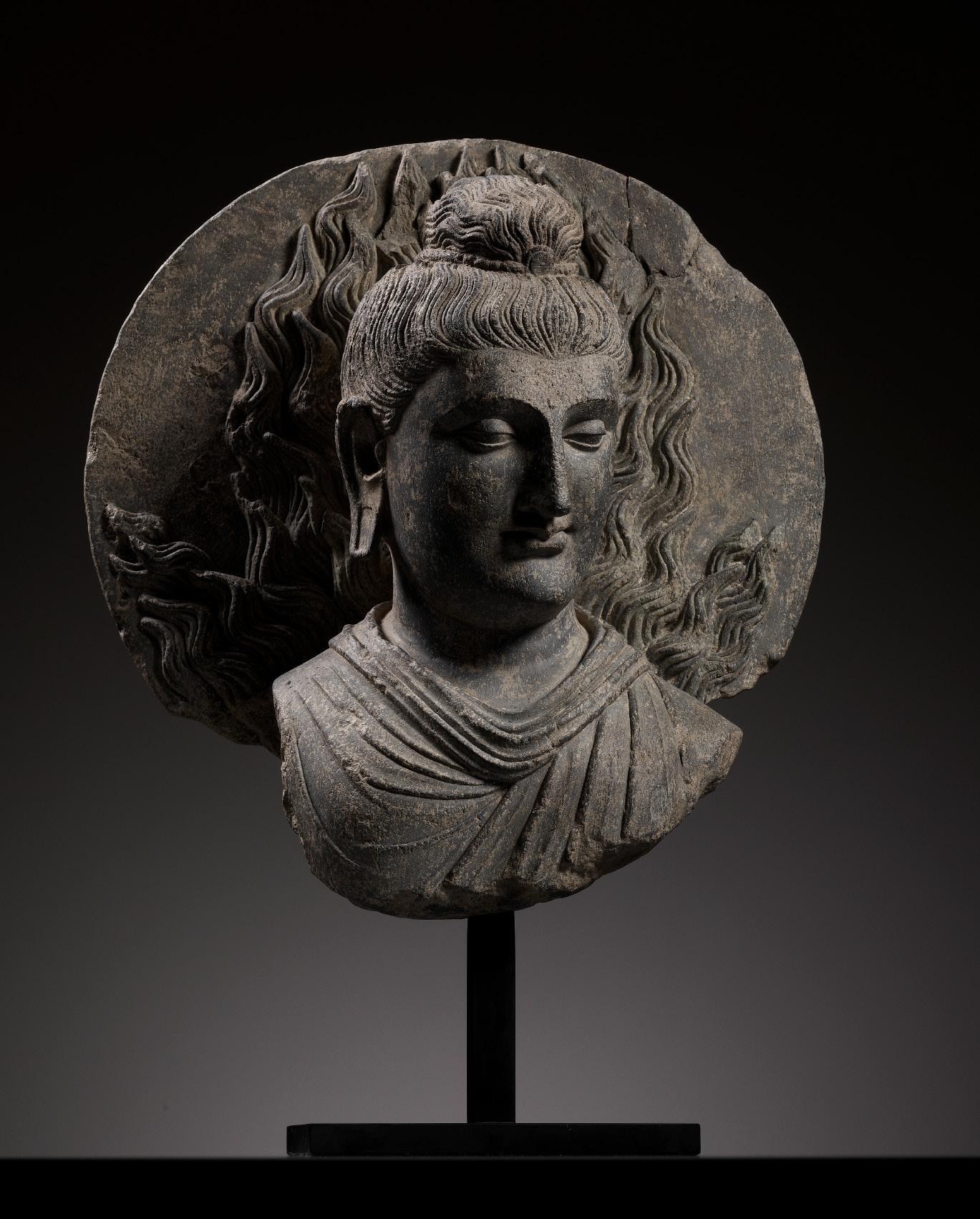
Ancient region of Gandhara, 2nd-3rd century. Finely carved, the serene face with heavy-lidded almond-shaped eyes, elegantly arched brows, and full lips forming a subtle smile, the wavy hair secured by a jeweled headband, the robes heavily pleated, backed by a halo carved with rising flames.
Provenance: From an old Belgian private collection. Acquired before 1970 and thence by descent in the family.
Condition: Good condition, commensurate with age. Extensive wear, losses, nicks, scratches, signs of weathering and erosion, few structural cracks, sign. The halo with a visible old repair at the one o’clock position.
Dimensions: Height 47 cm (excl. stand) and 60 cm (incl. stand)
With a modern metal stand. (2)
AUCTION RESULT COMPARISON
Type: Related
Auction: Sotheby’s New York, 19 September 2008, lot 264
Price: USD 242,500 or approx. EUR 312,000 converted and adjusted for inflation at the time of writing
Description: Bust of Buddha, gray schist, ancient region of Gandhara, Kushan period

Expert remark: Note the related size (50.2 cm)
Estimate EUR 40,000
Starting price EUR 20,000
336 225

226
AN
IMPORTANT SCHIST HEAD OF MAITREYA, ANCIENT REGION OF GANDHARA, 2ND-3RD CENTURY

Finely carved, the serene face with heavy-lidded almond-shaped eyes, elegantly arched brows, full lips, and a wavy mustache, flanked by leogryph earrings. His coiffure secured by beaded and jeweled bands and immaculately arranged in a butterfly topknot with ringlets falling across his forehead in high relief.
Provenance: From the collection of Yvette Starck, Luxembourg, by c. 1970, and thence by descent. A noted Belgian collector, acquired from the above. A copy of a provenance statement, written and signed by the previous owner, dated 25 November 2022 and confirming the provenance stated above, accompanies this lot. Condition: Good condition, commensurate with age. Some wear, minor losses, nicks, scratches, signs of weathering and erosion, encrustations. Structural cracks, partially with minor old repairs and fills.
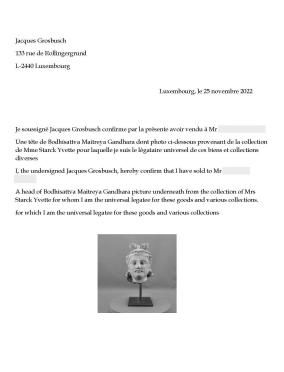
Weight: 9,523 g (excl. stand) and 11,657 g (incl. stand)
Dimensions: Height 26 cm (excl. stand) and 40 cm (incl. stand)
The luxurious treatment of the voluminous curls across his broad forehead and the tops of his ears presents the lingering influence of GrecoRoman sculpture on early Buddhist art. Each terminates with exquisite tail-like twists. This style of the topknot is generally assigned to Maitreya, as in an example from the Avery Brundage Collection (see Literature comparison).
The leogryph earrings seen on the present head are a common feature of Gandharan depictions of Maitreya that exemplifies the wide range of influences on Gandharan art, such as the hybrid lion-eagle creatures popular in Persian art motifs and the centaurs of Greek mythology.
With a modern metal base. (2)
LITERATURE COMPARISON
Compare a figure of Maitreya from the Avery Brundage Collection in the Asian Art Museum of San Francisco, object number B60S597, illustrated in The Asian Art Museum of San Francisco: Selected Works, 1994, p. 23.
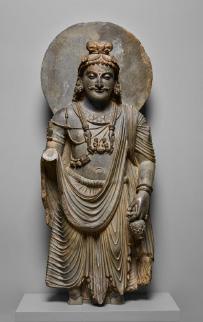
AUCTION RESULT COMPARISON
Type: Closely related
Auction: Christie’s New York, 18 September 2013, lot 201
Price: USD 87,500 or approx. EUR 104,000 converted and adjusted for inflation at the time of writing
Description: A gray schist head of a bodhisattva, Gandhara, 2nd/3rd century Expert remark: Compare the closely related treatment of the face and butterfly topknot with similar ringlets. Note the smaller size (22.8 cm).
Estimate EUR 20,000
Starting price EUR 10,000
338
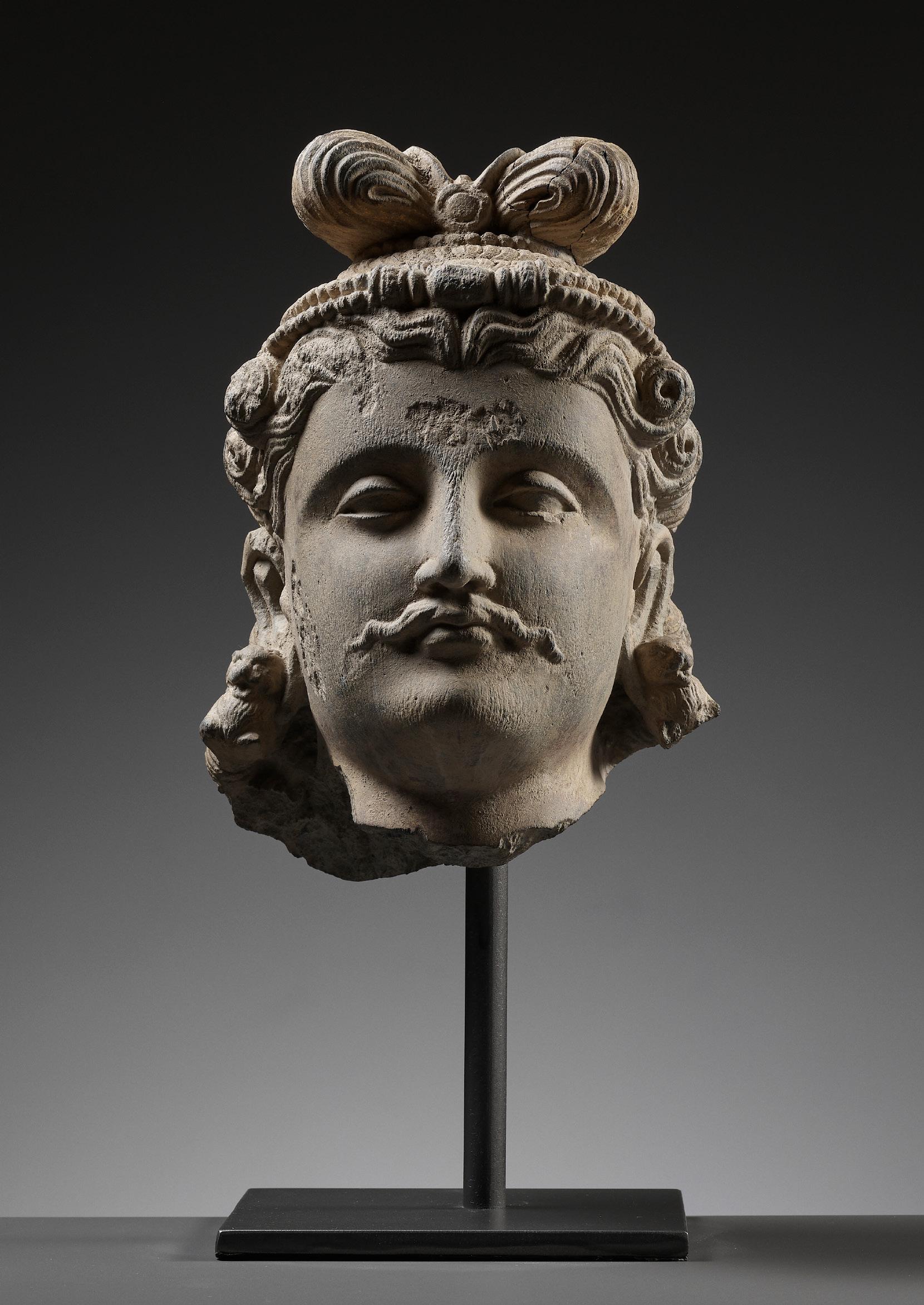
A LARGE AND IMPORTANT GRAY SCHIST FIGURE OF MAITREYA, ANCIENT REGION OF GANDHARA

2nd-3rd century. Superbly carved standing on a square base depicting donor figures venerating a Buddhist reliquary that rests on a low throne under a canopy. Wearing a dhoti with elaborate cascading folds and secured with a finely detailed sash at the waist, a further cloak draped across his shoulder in an elegant sweeping curve, richly adorned with beaded necklaces and armlets. His serene face with crisply delineated features, such as the full lips, wavy mustache, and heavy-lidded eyes. The hair tied in a looped topknot. The head backed by a round halo.

Provenance: From an old Belgian private collection. Condition: Good condition, commensurate with age. Extensive wear, losses, nicks, scratches, possibly old fills and small pieces reattached, signs of weathering and erosion, encrustations. The fragment of one hand still present, which was broken in two and reassembled some time ago, and possibly associated. Fine, naturally grown, smooth patina.
Dimensions: 115 cm (incl. stand) and 112 cm (excl. stand)
Mounted on an associated stand. (2)
The present schist figure of Maitreya is of exceptional sculptural quality. The statue’s refinement and elegant restraint place it in the 2nd-3rd centuries, often considered the high period of Gandharan art. Maitreya is considered the Buddha of the future. When the dharma is forgotten on Earth, he will descend from the Tushita Heaven, where he resides, to be born in our realm as the next Buddha. When he is born on Earth, Maitreya is depicted in rich robes similar to that of the historical Gautama Buddha, prior to his renunciation of worldly goods. In the Gandharan period, Maitreya is considered the most important Bodhisattva.
It is likely he would have held a water vessel in the left hand, which is found in many different contexts within Indian sculpture, but is almost always a symbol of fertility and life. It is an apt visual icon, therefore, for Maitreya’s role as a progenitor of future peace and order.
Literature comparison: Compare a closely related gray schist figure of Maitreya, 163.2 cm high, dated ca. 3rd century, in the Metropolitan Museum of Art, accession number 1991.75.
AUCTION RESULT COMPARISON
Type: Closely related
Auction: Christie’s New York, 23 March 2010, lot 140
Price: USD 80,500 or approx. EUR 100,000 converted and adjusted for inflation at the time of writing
Description: A gray schist figure of a standing Maitreya, Gandhara, 2nd/3rd century

Expert remark: Compare the closely related pose, robes, jewelry, and base. Note the slightly smaller size (102.9 cm).
AUCTION RESULT COMPARISON
Type: Closely related
Auction: Christie’s New York, 16 September 2008, lot 327
Price: USD 146,500 or approx. EUR 184,000 converted and adjusted for inflation at the time of writing
Description: A large gray schist figure of Maitreya, Gandhara, 2nd/3rd century
Expert remark: Compare the closely related pose, robes, jewelry, and base. Note the slightly larger size (127 cm).
Estimate EUR 60,000
Starting price EUR 30,000
227
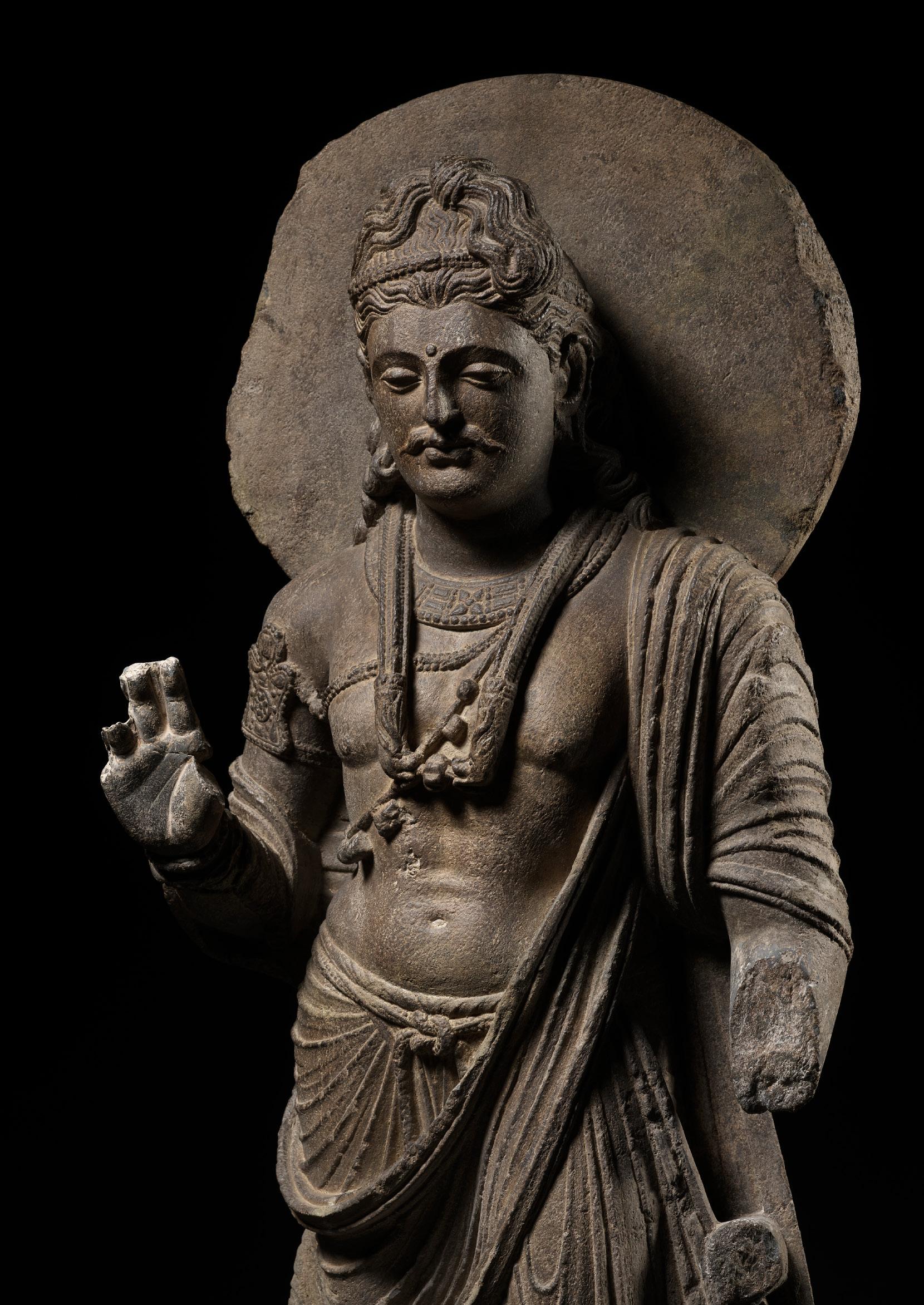
A SCHIST STELE DEPICTING BUDDHA, ANCIENT REGION OF GANDHARA, 3RD-4TH CENTURY
Of rectangular form, deeply carved in high relief, with Buddha seated in dhyanasana atop a lotus base supported by two small figures, flanked by bodhisattvas, under a canopy with apsaras flanked by a Buddha and a bodhisattva, all above kneeling worshippers. His hands are held in dharmachakra mudra, wearing a loose-fitting robe with deeply carved folds, his serene face with almond-shaped eyes, elegantly arched brows, a circular urna, and full lips, the wavy hair with a high ushnisha, backed by a halo.

Provenance: Dr. René Schroeder, Luxembourg, 1973. The collection of Yvette Starck, Luxembourg, acquired from the above and thence by descent. A noted Belgian collector, acquired from the above. A copy of the original invoice from Dr. René Schroeder, dated 10 September 1973, addressed to Yvette Starck, accompanies this lot.
Condition: Very good condition, commensurate with age. Some wear, minor losses, few structural cracks, small nicks, light scratches, signs of weathering and erosion, encrustations.
Dimensions: Height 46.5 cm (excl. stand) and 49 cm (incl. stand)
With a modern metal stand. (2)
Literature comparison: Compare a related schist stele depicting Buddha, 97 cm high, in the Lahore Museum, Pakistan. Compare a related schist stele depicting Buddha, dated c. 3rd century AD, in the Government Museum and Art Gallery, Chandigarh, object number 572.
AUCTION RESULT COMPARISON
Type: Related
Auction: Christie’s Paris, 8 June 2010, lot 423
Price: EUR 70,600 or approx. EUR 86,000 adjusted for inflation at the time of writing
Description: An important gray schist relief, Gandhara region, 3rd/4th century
Expert remark: Note the significantly larger size (76 x 59.5 cm)
Estimate EUR 16,000
Starting price EUR 8,000
A copy of the original invoice from Dr. René Schroeder, dated 10 September 1973, addressed to Yvette Starck, accompanies this lot
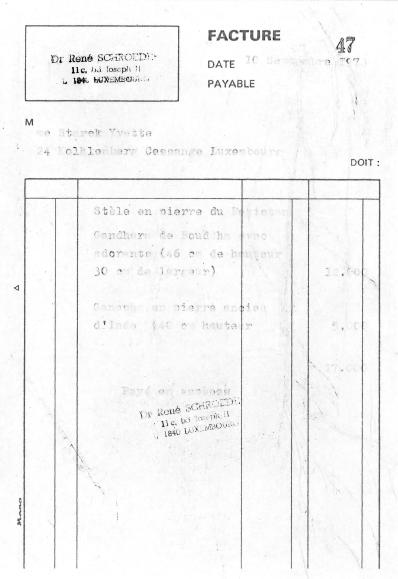
342
228

229
A RARE AND IMPORTANT STUCCO FIGURE OF BUDDHA, ANCIENT REGION OF GANDHARA

3rd-4th century. Superbly modeled standing on a square plinth and holding the folds of his sanghati in his left hand, the robe finely detailed with voluminous folds, the serene face with bow-shaped mouth, aquiline nose, and heavy-lidded eyes flanked by pendulous earlobes, the hair in thick locks over the ushnisha.

Provenance: An old private collection in Paris, France. Indian Heritage, Paris, France, acquired from the above. LP Collection Paris, France, acquired from the above. An expertise signed by Frédéric Rond, owner of Indian Heritage, dated 27 August 2015, addressed to the present owner, and dating the present lot circa 3rd century, accompanies this lot. Established in 2006 by Frédéric Rond, Indian Heritage is a gallery specializing in Indian and Himalayan art. Located in St Germain des Prés, Paris, it offers a large selection of primitive and classical pieces.
Condition: Good condition, commensurate with age. Restoration to where the feet connect with the base. Several smaller breakages and losses with associated minor repairs and old fills. Nicks and light scratches. Signs of weathering and erosion, encrustations. Good patina.
Dimensions:
In addition to schist, stucco was a popular medium for sculpture in the ancient Gandhara region. A lightweight, malleable ware, stucco readily lends itself to delicate detailing and sensitive modeling, conveying a sense of emotional presence exemplified in this large-scale figure of Buddha. With idealized proportions, beatific expression, and flowing robes, the serene figure is the embodiment of compassion.
LITERATURE COMPARISON
Compare two related Gandharan stucco figures of standing Buddhas in the National Museum, New Delhi, dated 2nd-3rd century, illustrated by Giovanni Verri, et al., Investigations of a Gandharan stucco head of the Buddha at the Victoria and Albert Museum (IM.3-1931), Techne, issue 48, 2019, fig. 13. Compare a related example illustrated in Kurita, Gandharan Art, Vol. II, Tokyo, 1990, no. 305.
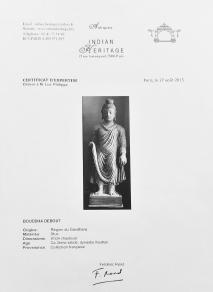
AUCTION RESULT COMPARISON
Type: Closely related
Auction: Christie’s New York, 20 March 2012, lot 16

Price: USD 98,500 or approx. EUR 116,000 converted and adjusted for inflation at the time of writing
Description: An important polychromed stucco figure of Buddha, Gandhara, 3rd/4th century Expert remark: Note the similar size (80 cm) and faint remnants of polychrome pigments.
Estimate EUR 30,000
Starting price EUR 15,000
344
cm (excl. base)
ca.
cm (incl. base)
Height 87
and
110
Frédéric Rond

AN IMPORTANT TERRACOTTA STATUE OF VAJRAPANI IN THE FORM OF HERCULES, ANCIENT REGION OF GANDHARA
Scientific Analysis Report: A thermoluminescence sample analysis has been conducted by Arcadia, Tecnologie Per I Beni Culturali, Milan, dated 2 October 2015, reference no. 348E. The result is consistent with the suggested period of manufacture. A copy of the signed thermoluminescence analysis report accompanies this lot.

4th-5th century. The gallant masculine figure seated with his hands placed on his knees, his torso left bare save for a loin cloth gathered around the waist, the mustachioed face with almond-shaped eyes and full lips, the curled hair secured by a twisted headband.


Provenance: Collection of Elisabeth Maria Coebergh, Paris, France, acquired c. 1980. An important private collection of a distinguished gentleman in Milan, Italy, assembled in the 1990s and early 2000s, acquired from the above in 2003. Collection of Leonardo Vigorelli, Bergamo, acquired from the above. A provenance statement written and signed by Elisabeth Coebergh, dated 30 September 2003, describing the present figure as a depiction of Kubera, accompanies this lot. Leonardo Vigorelli is a retired Italian art dealer and noted collector, specializing in African and ancient Hindu-Buddhist art. After studying anthropology and decades of travel as well as extensive field research in India, the Himalayan region, Southeast Asia, and Africa, he founded the Dalton Somaré art gallery in Milan, Italy, which today is being run by his two sons.
Condition: Good condition, commensurate with age. Wear, losses, nicks, structural cracks with associated old fills, drilled holes from sample-taking, signs of weathering and erosion, encrustations.
Dimensions: Height 72 cm (incl. stand) and 74 cm (excl. stand)
Mounted on an associated stand. (2)
This large terracotta sculpture is a rare legacy of the ancient kingdom of Gandhara, encapsulating the rich cultural interplay and hybrid art styles derived from Hellenistic and Indian influences. It depicts the bodhisattva Vajrapani, the protector of Buddhism, represented with the iconography of the Greek god Hercules, who was widely venerated as a hero and savior in western Asia during the early centuries of the present era. As a great champion, yet one who nevertheless understood the human condition, Hercules was easily assimilated into Mahayana Buddhism. Like other Gandharan bodhisattvas, he is depicted as an earthly prince with his aristocratic bearing and posture. While his distinct mustache belongs to the Indian world, the naturalistic face and especially the muscular body are clearly reminiscent of Greco-Roman sculpture
The kingdom of Gandhara lasted from 530 BC to 1021 AD, when its last king was murdered by his own troops. It stretched across parts of presentday Afghanistan and Pakistan. Gandhara is noted for its distinctive style in Buddhist art, which developed out of a merger of Greek, Syrian, Persian and Indian artistic influences. Gandharan style flourished and achieved its peak during the Kushan period, from the 1st to the 5th century. In the 1st century AD, Gandhara was the birthplace of some of the earliest Buddhist images.
The use of hard-fired earthenware instead of stone such as schist, marble or sandstone became popular during the later Gandharan period from the 4th to 6th centuries AD. Fired clay was expensive in the area, because the wood needed for the firing process was scarce. Therefore, such a large and expensive sculpture would have been a highly meritorious Buddhist offering. Only a few terracotta statues from this period and of this spectacular size have ever been recorded
AUCTION RESULT COMPARISON
Type: Closely related
Auction: Sotheby’s Hong Kong, 1 April 2019, lot 3105
Estimate: HKD 1,500,000 or approx. EUR 186,000 converted and adjusted for inflation at the time of writing.
Description: A monumental terracotta statue of Vajrapani in the form of Hercules, Gandhara, 4th-5th century Expert remark: Compare the closely related material, style of carving and subject. Note the larger size (91 cm).

Estimate EUR 20,000
Starting price EUR 10,000

346 230
Leonardo Vigorelli
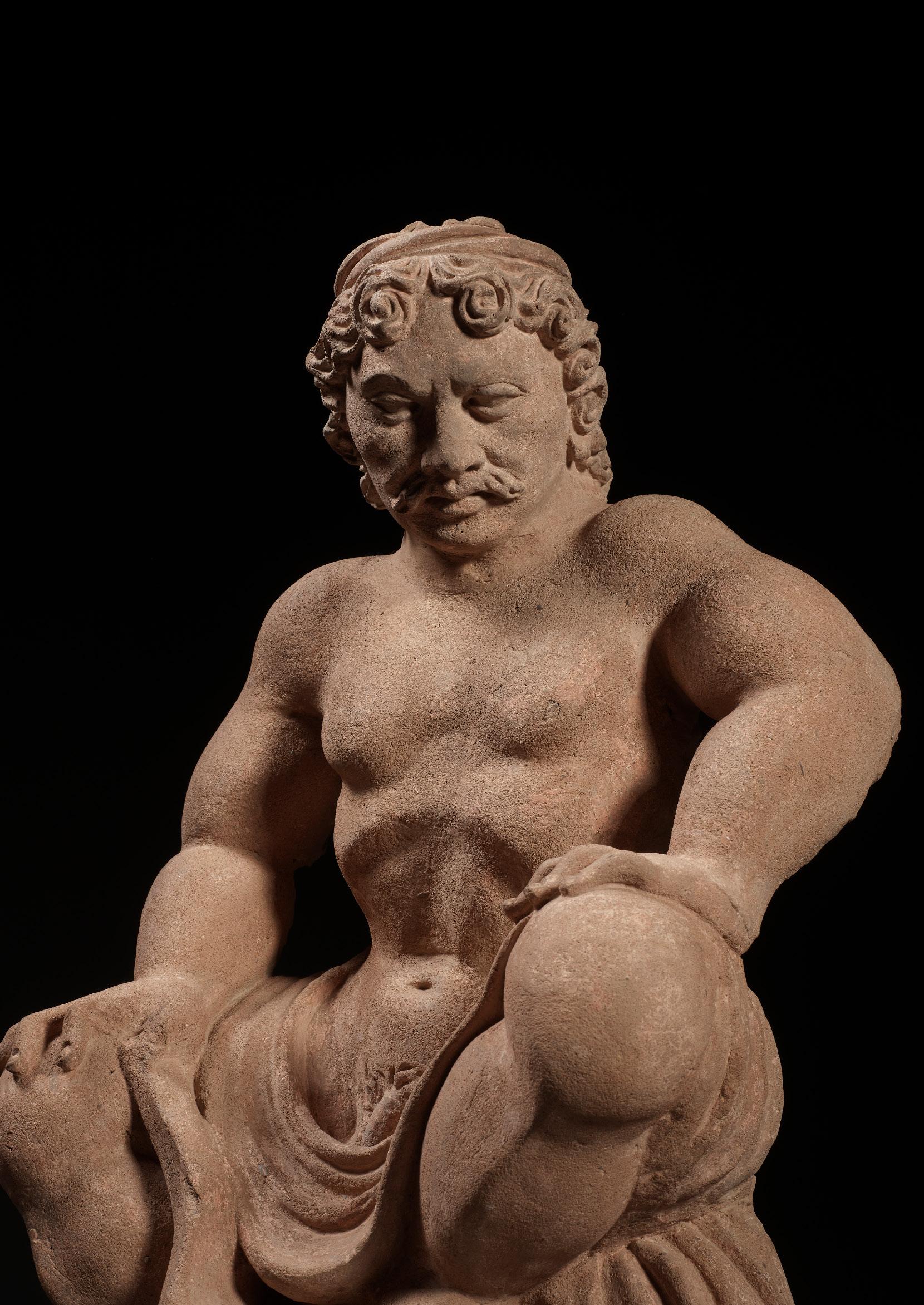
231
A GRAY SCHIST GABLE OF BUDDHA SURROUNDED BY HIS DISCIPLES, KUSHAN PERIOD


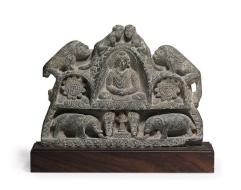
Ancient region of Gandhara, 2nd - 3rd century. Finely carved with a central figure of Buddha seated on a lotus pedestal, flanked by standing and kneeling acolytes with hands clasped together in prayer, all above five arches enclosing the Buddha accepting an offering from a lady flanked by busts of female deities.
Provenance: Old European collection, 1970s. The collection of a gentleman in London, United Kingdom, acquired during the early 2000s in France.
Condition: Good condition, commensurate with age. The faces of most figures, particularly that of the central Buddha, are exceptionally wellpreserved, which is rare in Gandharan reliefs. Extensive wear, losses, nicks, scratches, signs of weathering and erosion, old repairs and minor fills, few structural cracks, soil encrustations.
Weight: 22.9 kg
Dimensions: Length 61 cm, Height 38 cm (excl. base)
With a fitted wood base. (2)
Narrative panels were often affixed to the drums of large and small stupas and could thus be read like a storyboard sequentially in the ritual process of circumambulation. Reliefs were also placed in false gables on the front and the mid-section of a stupa. For a structural illustration, see Behrendt, The Art of Gandhara in the Metropolitan Museum of Art, New York, 2007, fig. 15, page 33.
Literature comparison: Compare a complete upper false gable depicting a narrative scene from Buddha’s life, illustrated in Miyaji, Gandhara Art, Tokyo, 1984, no. 50. Compare a panel in the Musée Guimet and another in the Victoria and Albert Museum, illustrated in Kurita, Gandharan Art, vol. I, Tokyo, 1988, p. 276, nos. 590 and 591. For further examples, see Tissot, The Art of Gandhara, Paris, 1985, figs. 30 and 31.
AUCTION RESULT COMPARISON
Type: Related
Auction: Christie’s, 23 March 2010, lot 145
Price: USD 8,125 or approx. EUR 10,500 converted and adjusted for inflation at the time of writing
Description: An unusual green schist gable with Buddha and animals, Gandhara, 2nd/3rd century
Expert remark: Note the much smaller height (14.3 cm)
AUCTION RESULT COMPARISON
Type: Related
Auction: Bonhams New York, 17 September 2014, lot 84
Estimate: USD 35,000 or approx. EUR 42,000 converted and adjusted for inflation at the time of writing
Description: A schist false chaitya arch with the attack of Mara, ancient region of Gandhara, 2nd/3rd century
Expert remark: Note the similar height (44.4 cm)
Estimate EUR 6,000
Starting price EUR 3,000
348
A RARE MARBLE LINGA WITH FOUR FACES, PANCHAMUKHALINGA, HINDU SHAHI
Northwestern India, c. 8th century. Finely carved with four faces of Shiva around a central domed shaft, all supported on a square base, each head with a slightly different hairstyle, headdress, and jewelry.
Provenance: From the collection of Anthony d’Offay. Christie’s New York, 19 September 2002, lot 127. A private collection in the United States, acquired from the above. Copies of two handwritten labels, confirming provenance and dating, accompany this lot. Georges Anthony d’Offay (b. 1940) is a retired British art dealer, collector, and curator. In 1965, at the age of 25, he opened his first gallery in London. His personal art collection, valued in excess of £100 million, was donated jointly to the National Galleries of Scotland and the Tate in 2008 with the assistance of the Scottish and British Governments. The various exhibitions of his pieces have been seen by a total of over 29 million visitors. Anthony d’Offay has received The Prince of Wales Medal for Arts Philanthropy (2011).
Condition: Good condition, commensurate with age. Extensive wear and weathering as expected, some losses, nicks and scratches. Signs of erosion, minor fissures and encrustations. Nicely grown natural patina with a beautiful ivory tone overall.
Weight: 3,684 g
Dimensions: Height 16.5 cm

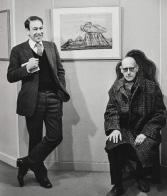
Lingas such as the present lot are extremely rare and were produced under the Shahi dynasties (6th-11th centuries), which ruled in the lands formerly known as the ancient region of Gandhara under the Kushan empire. The most recent analysis of this subject is found in Michael Henss, The Mystery of the ‘Hund Statues’: An Unknown Chapter of Central Asian Statuary, Arts of Asia, January 2016, pp. 28-43. As exemplified in this sculpture, the hair and regalia still echo the visual apparatus of Gandhara, while the rounder facial features are informed by the Gupta style.
The linga is the sign of Shiva, a column connecting heaven and earth representing creative power. This form is thought to indicate a five-faced linga (panchamukhalinga), but the fifth face is invisible as it cannot be comprehended by mortals, so lingas of this type always show just four faces. The linga is the main object of worship in Hindu temples.
AUCTION RESULT COMPARISON
Type: Related
Auction: Bonhams New York, 19 March 2018, lot 3069

Price: USD 75,000 or approx. EUR 83,500 converted and adjusted for inflation at the time of writing

Description: A marble mukhalinga, Hindu Shahi, circa 9th century


Expert remark: Note the larger size (25.9 cm)
Estimate EUR 4,000
Starting price EUR 2,000
349 232
Anthony d’Offay and Cecil Collins, by Jane Bown, 1981
A BRONZE FIGURE OF BUDDHA SHAKYAMUNI, SWAT VALLEY, 8TH-9TH CENTURY
Scientific Analysis Report: A thermoluminescence analysis report issued by Oxford Authentication on 31 March 2021, based on sample number N121c25, sets the firing date of one sample taken at between 800 and 1200 years ago, consistent with the suggested period of manufacture (8th-9th century). A copy of the report, signed by Helen Mason and Doreen Stoneham for Oxford Authentication, accompanies this lot.

Seated on a cushion over an elaborate lotus throne with lions on either side and supported on a rectangular plinth, his right hand lowered in abhaya mudra and his left holding the hem of his sanghati falling over the chest in finely incised rhythmic folds. His serene face with silver-inlaid eyes and urna, deeply incised brows, and full lips forming a calm smile, flanked by long pendulous earlobes, the hair in tight curls over the ushnisha.
Provenance: A private collection in Hong Kong. German trade, acquired from the above.
Condition: Very good condition, commensurate with age. Extensive wear, some losses, obvious signs of weathering and erosion, soil encrustations, small nicks and dents, light scratches. Superb, naturally grown malachite and cuprite patina overall.
Weight: 1,894 g (incl. backplate) and 1,280 g (excl. backplate)
Dimensions: Height 25 cm (incl. backplate) and 22 cm (excl. backplate)
Few Swat bronzes are known that retain a complete backplate as in the present example. It is separately cast and inserted into a loop on the throne and a tang issuing from Buddha’s back. The flaming mandala is topped with a stupa and flanked by female bodhisattvas standing on lotus bases below seated male bodhisattvas.
According to Pal, placing Buddha on a throne like on the present lot associates him with royal imagery and emphasizes his spiritual sovereignty, while the lotus base symbolizes his divine quality (see Pal, Indian Sculpture, Vol.2, 1988, pp.68-9). His enlightened nature is further signaled by the silver-inlaid eyes and urna. Gently looking down with a compassionate expression, he extends his right hand in the gesture of charity. With his left, he holds the hem of his robe. The iconography of Shakyamuni holding his garment is widely employed in seated Swat figures, extending the idiom from earlier Gandharan stone images.
The Swat Valley is located along the upper stream of the Indus in the heartland of the Gandhara region. It was a melting pot of various people and arts and served as a link between India and Central Asia and further eastwards for a constant flow of Buddhist pilgrims. The earlier Gandhara style is still echoed in the art of many icons of the Swat Valley, as visible in the present example. The Buddha’s parallel folds as well as the protuberance on top of his head, can be traced back to Gandhara Buddha figures. However, the V-shaped pleats around his neck are associated with Kashmiri prototypes, as is the use of silver inlay. His face reflects a Gupta idiom, with its small mouth and incised eyebrows. The lotus base on which he sits is typical for Swat Valley images. Thus, this fine bronze Buddha figure perfectly embodies the aforementioned melting pot of various styles.
Literature comparison: Compare a closely related Swat Valley bronze Buddha, with a similar base and hand gesture, dated 625-1003, in the National Museum of Pakistan, Karachi, recorded in the Huntington Archive, scan number 9602. Compare a related Swat Valley bronze Buddha, dated circa 7th-8th century, in the National Museum of Pakistan, Karachi, recorded in the Huntington Archive, scan number 9600. Compare the throne, gestures, and the robe’s evenly arranged narrow folds with that of a closely related example published in von Schroeder, Buddhist Sculptures in Tibet, Vol. I, 2001, pp. 40-1, figs. 6A-C. Also see Pal, Bronzes of Kashmir, 1975, pp. 194-5, no. 73. For a fragment of a backplate from the Eilenberg Collection, see M. Lerner and S. Kossak, The Lotus Transcendent, 1991, cat. no. 86, p. 116.
AUCTION RESULT
COMPARISON
Type: Closely related
Auction: Christie’s New York, 21 September 2007, lot 230
Price: USD 115,000 or approx. EUR 160,000 converted and adjusted for inflation at the time of writing
Description: A rare bronze figure of Buddha Shakyamuni with backplate, Swat Valley, 7th/8th century

Expert remark: Compare the closely related pose, expression, patina, the abhaya mudra of the lowered right hand, the elaborate throne and base, and the backplate with attendant figures and central stupa. Note the smaller size (20.3 cm).
Estimate EUR 30,000
Starting price EUR 15,000
350 233
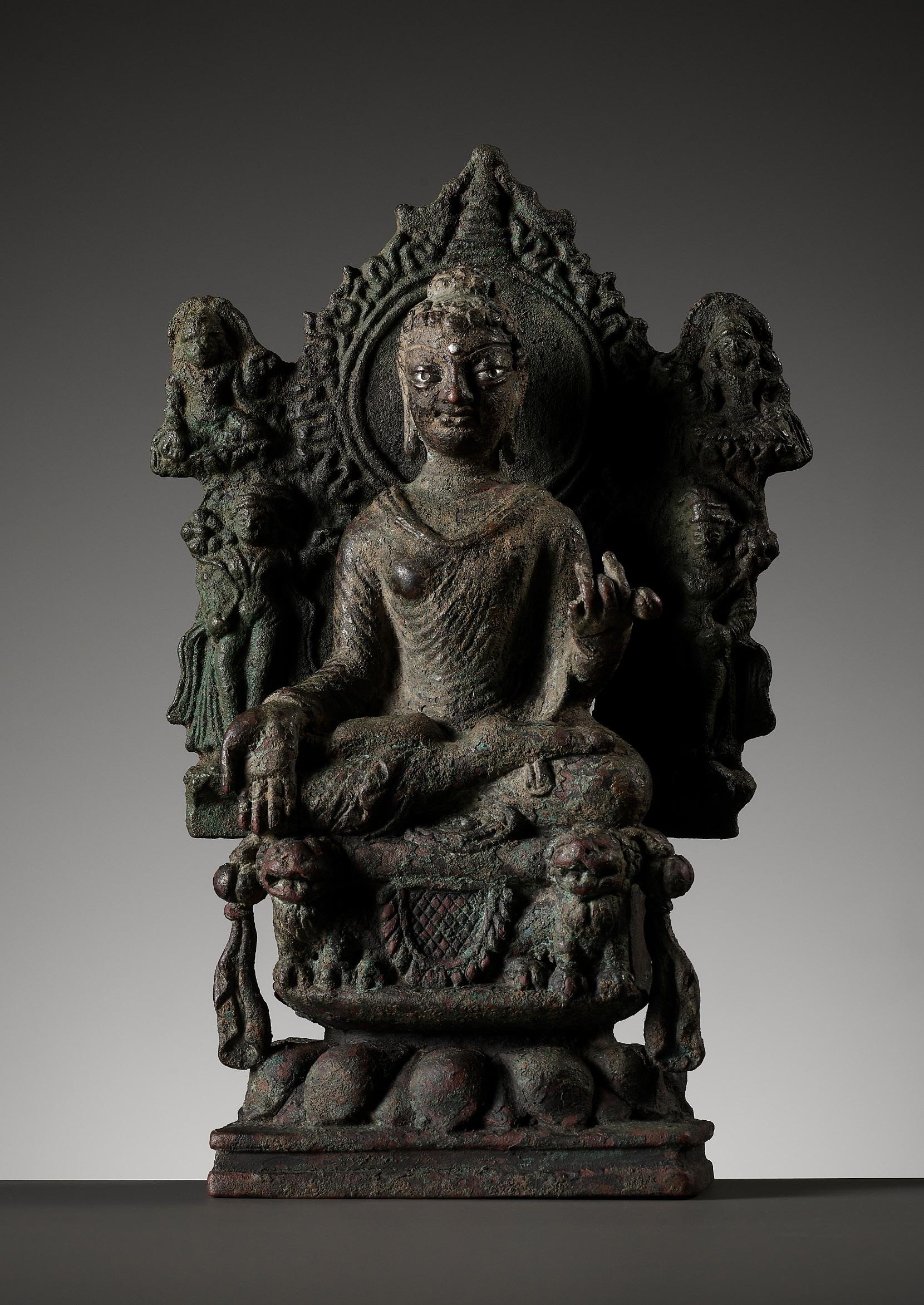
A PINK SANDSTONE STELE OF BUDDHA SHAKYAMUNI, KUSHAN PERIOD, MATHURA, LATE 1ST TO EARLY 2ND CENTURY
Of rectangular form with an arched top, finely and deeply carved in high relief, depicting Buddha seated in dhysanasana atop a tiered square plinth with three lions, flanked by chauri bearers below flying apsaras. He is wearing a heavily pleated robe draped over his left shoulder. His serene face with heavy-lidded almond-shaped eyes below thick, elegantly arched brows centered by a circular urna, the hair surmounted by a whorled ushnisha, backed by a sun-form halo.

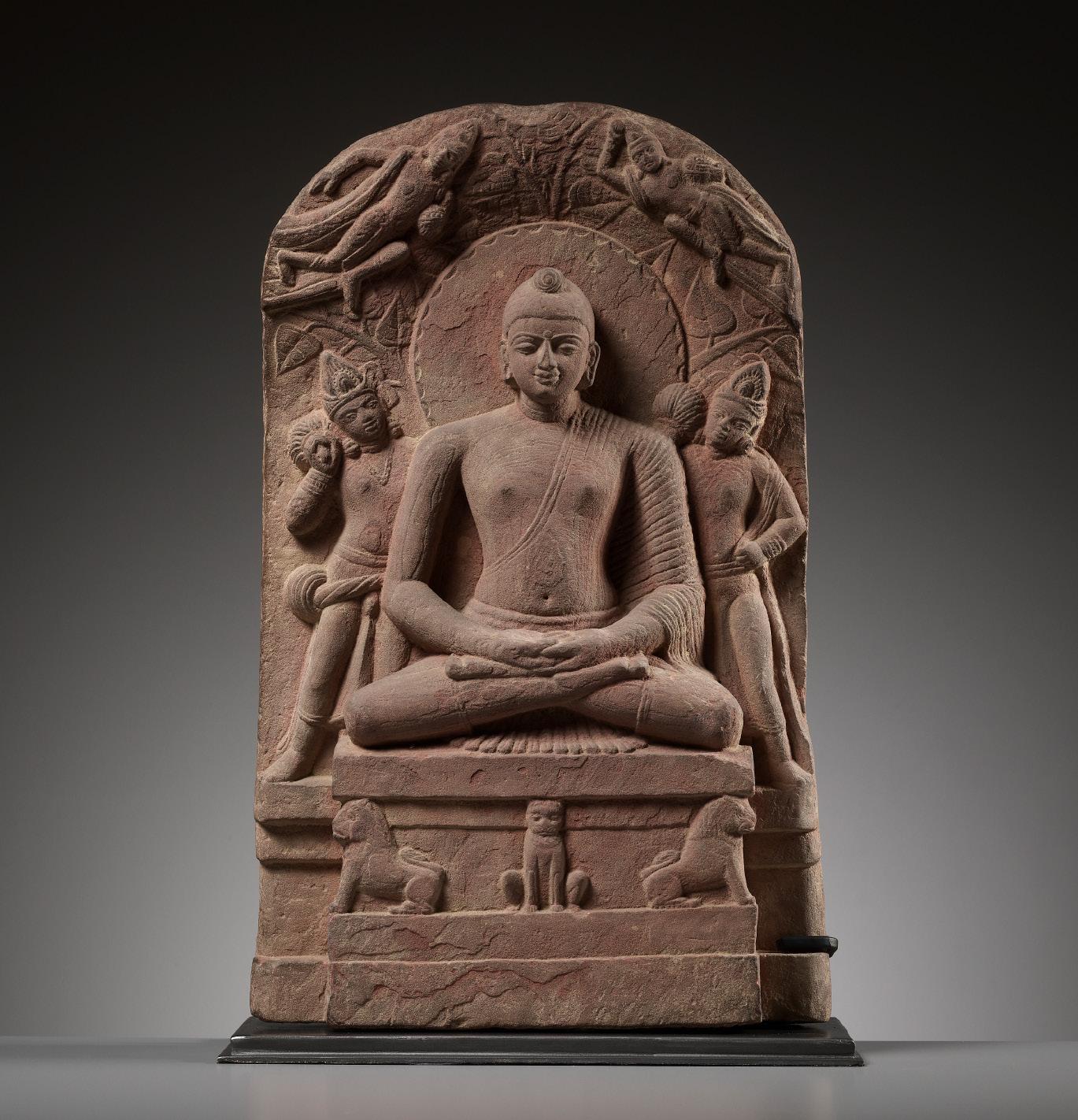
Provenance: From the collection of Jean-Marc Andral, acquired between 1996 and 2005 at Galerie Carré des Antiquaires in Versailles, France. A copy of a provenance statement, written and signed by Jean-Marc Andral, dated 31 July 2022, accompanies this lot. Jean-Marc Andral is a Belgian manager based in Brussels and active in the healthcare industry for over 25 years.
Condition: Very good condition, commensurate with age. Some wear, minor losses, few structural cracks, small nicks, light scratches, signs of weathering and erosion, encrustations.
Jean-Marc Andral

Dimensions: Height 52 cm (excl. stand) and 54 cm (incl. stand)
With a modern metal stand. (2)
LITERATURE COMPARISON
Compare the closely related pink sandstone stele of Buddha, known as the “Katra stele”, dated end of 1st century AD, in the Government Museum, Mathura, illustrated in James C. Harle, The Art and Architecture of the Indian Subcontinent, Yale University Press, 1994, p. 63, no. 43 (fig. 1) (where it is dated to the early 2nd century). Compare a closely related sandstone stele of Buddha, dated 110 AD, in the National Museum, New Delhi, object number L.55.25. Compare a related pink sandstone stele of Buddha, 93 cm high, dated c. 131 AD, in the Kimbell Art Museum, accession number AP 1986.06.
Estimate EUR 16,000
Starting price EUR 8,000
352 234
fig. 1


A PINK SANDSTONE STELE DEPICTING BUDDHA, MATHURA, 2ND-3RD CENTURY

Expert’s note: Due to the front side of the base section as well as parts of the legs and arms protruding slightly further than the Buddha’s face, his nose has remained mostly unscathed despite the stele obviously having fallen down from its original place of worship. The excellent and fully original state of preservation of this Buddha’s face makes the statue an extremely rare example of its kind.
North India, Uttar Pradesh. Of rectangular form with an arched top, finely and deeply carved in high relief, depicting Buddha seated in dhyanasana atop a tiered square base supported by three lions. His left hand raised in abhaya mudra and his right resting on his leg, flanked by chauri bearers below flying apsaras. He is wearing a richly pleated robe draped over his left shoulder. His serene face with almond-shaped eyes below arched brows and a circular urna, the hair with a neatly incised whorled ushnisha, backed by a sun-form halo.


Provenance: An important private collection of a distinguished gentleman in Milan, Italy, assembled in the 1990s and early 2000s. Collection of Leonardo Vigorelli, Bergamo, acquired from the above.
Leonardo Vigorelli is a retired Italian art dealer and noted collector, specializing in African and ancient Hindu-Buddhist art. After studying anthropology and decades of travel as well as extensive field research in India, the Himalayan region, Southeast Asia, and Africa, he founded the Dalton Somaré art gallery in Milan, Italy, which today is being run by his two sons.

Condition: Very good condition, commensurate with age. Wear, minor losses, small nicks, light scratches, few structural cracks, signs of weathering and erosion, encrustations.
Dimensions: Height 79.5 cm
LITERATURE COMPARISON
Compare the closely related pink sandstone stele of Buddha, known as the “Katra stele”, dated end of 1st century AD, in the Government Museum, Mathura, illustrated in James C. Harle, The Art and Architecture of the Indian Subcontinent, Yale University Press, 1994, p. 63, no. 43 (where it is dated to the early 2nd century). Compare a closely related sandstone stele of Buddha, dated 110 AD, in the National Museum, New Delhi, object number L.55.25. Compare a related pink sandstone stele of Buddha, 93 cm high, dated c. 131 AD, in the Kimbell Art Museum, accession number AP 1986.06 (fig. 1).
Estimate EUR 20,000
Starting price EUR 10,000
355 235
fig. 1
Leonardo Vigorelli
A RED SANDSTONE HEAD OF BUDDHA, MATHURA, KUSHAN PERIOD
Northern India, 2nd-3rd century. Carved from a single piece of pinkish-red sandstone, this head shows traditional yet remarkably modern features, including the curled hair, almond-shaped eyes, finely incised v-shaped brows, and an unusually large, slightly raised urna. The elegantly curved nose and the subtle smile add further to the benevolent character of this fine image.
Provenance: Dr. Robert R. Bigler, Zurich, 2002. Friedrich A. Hof, acquired from the above. A copy of the original invoice from Dr. Robert R. Bigler, dated 3 April 2002, describing the piece as a Kushan-style red sandstone head of a bodhisattva from North India, dated ca. 2nd century AD, and stating a purchase price CHF 10,000 or approx. EUR 16,500 (converted and adjusted for inflation at the time of writing), accompanies this lot. The invoice mentions an analysis conducted by the Leuven University, Belgium, in 2001 which confirms the dating and authenticity of the present lot (lost). Dr. Robert R. Bigler is a renowned and important dealer of Asian and Egyptian art, based in Ruschlikon, Zurich, Switzerland. Friedrich A. Hof (d. 2020) was a noted Swiss art collector, business consultant and the president of the Swiss football club FC Laufen.


A copy of the original invoice from Dr. Robert R. Bigler, dated 3 April 2002, accompanies this lot
LITERATURE COMPARISON
Dr. Robert R. Bigler Friedrich A. Hof

Compare a closely related red sandstone head, 25.4 cm high, also attributed to Kushan-period Mathura, dated approx. 200-300, in the Asian Art Museum of San Francisco, object number B62S63 (fig. 1). Compare also a related red sandstone head of Kubera, 16 cm high, also attributed to Kushan-period Mathura, dated to the 3rd century, in the Cleveland Museum of Art, accession number 2012.295. fig. 1
Auction result comparison:
Type: Closely related
Auction: Bonhams New York, 11 September 2012, lot 2
Condition: Good condition, commensurate with age and as expected from a stone sculpture with an age of roughly two millennia. Extensive wear with signs of weathering and erosion, encrustations, some nicks, structural cracks, and losses. Fine, naturally grown patina.
Weight: 1,748 g (excl. stand) and 3,952 g (incl. stand)
Dimensions: Height 15.5 cm (excl. stand) and 26.2 cm (incl. stand)
With an associated metal stand. (2)
Due to its location on the caravan trade routes through central India, Mathura was for centuries an important economic center. In the 2nd and 3rd centuries, it became a capital for the mighty Kushan Empire. During this time, both in Mathura and the region of Gandhara simultaneously, images of Buddha began to appear in anthropomorphic form for the first time. In contrast to Gandhara, where Greco-Roman concerns for naturalism were stressed, the body types of the Mathura Buddhas convey an idealized Indian vitality.
Price: USD 8,500 or approx. EUR 10,500 converted and adjusted for inflation at the time of writing
Description: A red sandstone head of Buddha, Mathura, North India, Kushan period, circa 2nd century
Expert remark: Note the size (26.7 cm)
AUCTION RESULT COMPARISON
Type: Closely related
Auction: Bonhams New York, 14 September 2015, lot 82
Price: USD 47,500 or approx. EUR 56,500 converted and adjusted for inflation at the time of writing
Description: A sandstone head of Buddha, Mathura, Kushan period, 2nd/3rd century

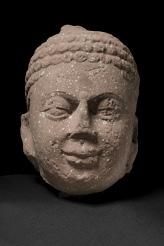
Expert remark: Note the size (33 cm)
Estimate EUR 6,000
Starting price EUR 3,000
356
236


A BRONZE FIGURE OF BUDDHA, NORTHEASTERN INDIA, 8TH-10TH CENTURY
Exquisitely modeled standing in a dynamic pose, reminiscent of tribhanga and similar to contrapposto, his right hand raised in shuni mudra and his left holding the hem of his diaphanous robe draped over his left shoulder. The crisply cast serene face with heavy-lidded downcast eyes below gently arched brows centered by an urna, an aquiline nose, and full lips, flanked by long pendulous earlobes. The hair arranged in tight curls with an ushnisha. The bronze with a rich, naturally grown patina with malachite encrustations.
Provenance: From a distinguished French collection, assembled in the course of over forty years. A noted Italian private collection, acquired from the above.
Condition: Good condition, commensurate with age. Minor old repairs and fills. Extensive wear, casting irregularities, small nicks, light scratches, minor losses, signs of weathering and erosion, encrustations.
Weight: 2,675 g (incl. stand)
Dimensions: Height 31.5 cm (excl. stand) and 39.5 cm (incl. stand)
Mounted to an associated wood stand. (2)
Literature comparison: Compare a related bronze figure of Buddha, attributed to Bihar and dated to the 10th century, in the National Museum, New Delhi, object number 47.47. Compare a related bronze figure of Buddha, attributed to Bihar and dated circa 10th century, in the Indian Museum, Kolkata, object number 9436/A24276.
AUCTION RESULT COMPARISON
Type: Related
Auction: Christie’s New York, 17 March 2015, lot 29
Price: USD 269,000 or approx. EUR 314,000 converted and adjusted for inflation at the time of writing
Description: A bronze figure of Buddha, Thailand, 8th century Expert remark: Compare the related pose, robe, and color of the bronze. Note the larger size (36.1 cm) and that the figure was attributed to Thailand.

Estimate EUR 20,000
Starting price EUR 10,000
359 237
A BLACK STONE STELE OF PADMAPANI, PALA PERIOD, NORTHEASTERN INDIA, BIHAR, 10TH CENTURY
He is dressed in the trappings of royalty with a crisply carved jeweled collar, belt, and yajnopavita (sacred thread). His serene face with heavy-lidded downcast eyes below gently arched brows and an urna, his full lips forming a subtle smile, his head surmounted by an elaborate crown centered by an image of the Buddha Amitabha. The arched mandorla flanked by two flying apsaras.
Provenance: From the collection of Jean-Marc Andral, acquired between 1996 and 2005 at Galerie Carré des Antiquaires in Versailles, France. A copy of a provenance statement, written and signed by Jean-Marc Andral, dated 31 July 2022, accompanies this lot. Jean-Marc Andral is a Belgian manager based in Brussels and active in the healthcare industry for over 25 years.
Condition: Excellent condition, commensurate with age. Wear, minor losses, small nicks, light scratches, a small decorative element reattached, signs of weathering and erosion, remnants of pigment, encrustations.
Weight: 31 kg (incl. stand)
Dimensions: Height 57 cm (excl. stand) and 59 cm (incl. stand)
Mounted on an associated stand. (2)
This superbly carved sculpture depicts Avalokiteshvara as the lotus-bearer Padmapani, further identified by the image of his spiritual father Amitabha in the crown. Finely carved, standing in tribhanga on a double-lotus pedestal, flanked by two standing bodhisattvas, one side with two kneeling worshippers, all atop similar lotus platforms. His right hand is holding a rosary while his left is holding a lotus stem coming to full bloom at the shoulder.
AUCTION RESULT COMPARISON
Type: Closely related
Auction: Sotheby’s New York, 16 March 2016, lot 757
Price: USD 52,500 or approx. EUR 60,000 converted and adjusted for inflation at the time of writing
Description: A black stone stele depicting Padamapani Lokeshvara, Eastern India, Bihar, 10th century
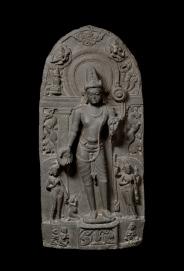
Expert remark: Note the larger size (83.8 cm)

AUCTION RESULT COMPARISON
Type: Closely related
Auction: Bonhams New York, 17 September 2014, lot 92
Price: USD 245,000 or approx. EUR 280,000 converted and adjusted for inflation at the time of writing
Description: A black stone stele of Avalokiteshvara, Bihar, Pala period, late 10th century
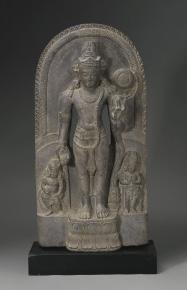

Expert remark: Note the much larger size (103 cm)
Estimate EUR 20,000
Starting price EUR 10,000
360
238
Jean-Marc Andral

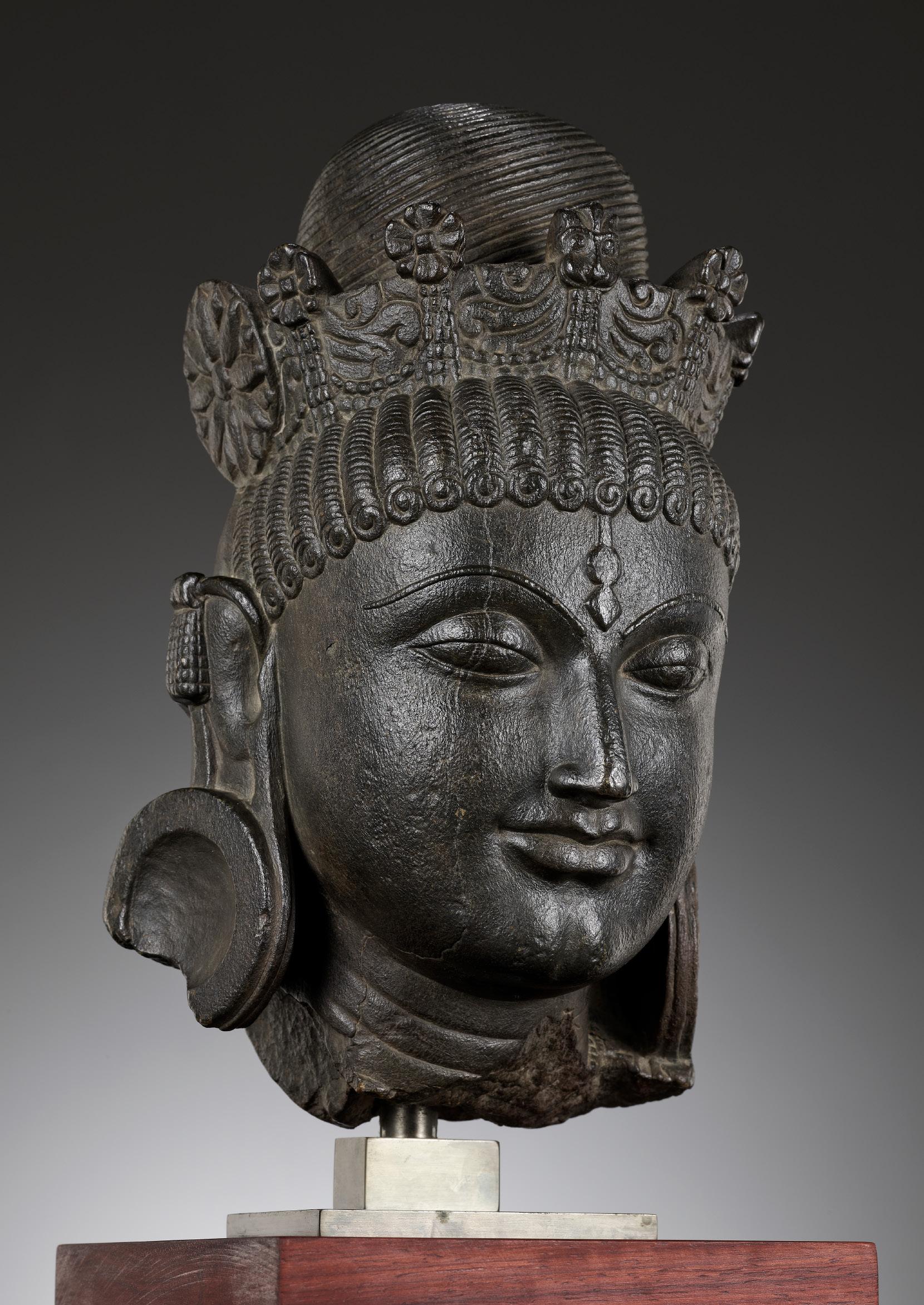
239
AN
IMPORTANT AND MONUMENTAL BLACK STONE HEAD OF TARA, PALA PERIOD

Opinion: This particular work should be considered a most important example from an era that saw the production of some of the finest sculptural works ever produced in India. The quality of the carving, coupled with the life-size proportions, indicates that this was likely part of a monumental statue that was a principal focus of worship. India, 10th-12th century. Finely carved with a benevolent expression, having full bow-shaped lips, rounded cheeks, and heavy-lidded eyes beneath a swirled high chignon surrounded by an elaborate jewelswagged diadem. The ears pierced at the helix with hanging gems and set with massive ear spools. The surface smoothly polished.
Provenance: From a noted private collection in the United States. Acquired in Lille, France, previously in a Belgian private collection. Condition: Very good condition consistent with an example of great antiquity. Wear, losses, structural cracks, minor nicks, light scratches, signs of weathering and erosion. Fine, naturally grown, rich, smooth patina overall.
Dimensions: Height 38 cm (excl. stand) and 45 cm (incl. stand)
Mounted on a modern stand. (2)
Expert’s note: The iconography of the carving points to this being an image of Syama Tara, a female bodhisattva known as the Mother of Liberation. Figures of similar iconography show the bodhisattva seated on a double-lotus throne, with right leg extending below the throne and right foot supported by a lotus, all surrounded by a large mandorla, flanked by pearls and flames or adorative figures such as apsaras. This complete picture gives us an idea of the original scale and grandeur of the complete
life-size work, which is unusual for its fine craftsmanship and monumental scale, pointing to a sculpture that was likely made for passing pilgrims. For a figure with similar distinctive features, including the massive ear spools and jewel-swagged diadem, see the Khadiravani Tara dating to the reign of Ramapala, acc. no. 3824/A25158 in the collection of the Indian Museum of Kolkata.
AUCTION RESULT COMPARISON
Type: Related
Auction: Christie’s, New York, 20 March 2009, lot 1203.
Price: USD 43,750 or approx. EUR 55,000 converted and adjusted for inflation at the time of writing
Description: A black stone head of Vishnu, Northeastern India, Pala period, 12th century Expert remark: Note the much smaller size (24 cm) and almost complete loss of the ears.
AUCTION RESULT COMPARISON
Type: Related
Auction: Christie’s New York, 17 September 2003, lot 22
Price: USD 47,800 or approx. EUR 70,000 converted and adjusted for inflation at the time of writing
Description: An important large black stone head of a crowned Buddha, Northeastern India, Bihar, Pala period, 10th/11th century Expert remark: Note the larger size (48.2 cm).
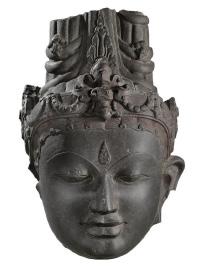
Estimate EUR 12,000
Starting price EUR 6,000
363
A SANDSTONE STELE OF UMA MAHESHVARA, CENTRAL INDIA, 11TH-12TH CENTURY

Uma-Maheshvara represents the sacred embrace, alingana, of the Lord Shiva, the Great Ascetic, joined with the eternal beauty, the Goddess Uma. As the divine couple, their union is metaphysical and meant to act as the gateway for the devotee to enter their sacred realm.
The divine couple seated in royal ease, wearing diaphanous dhotis and beaded jewelry, backed by floral halos. Shiva holding a trident, surrounded by smaller figures of deities, including their son Ganesha, as well as Shiva’s mount Nandi, apsaras, attendants, and kneeling worshippers.
Provenance: From the collection of Leonardo Vigorelli, Bergamo, Italy. Leonardo Vigorelli is a retired Italian art dealer and noted collector, specializing in African and ancient Hindu-Buddhist art. After studying anthropology and decades of travel as well as extensive field research in India, the Himalayan region, Southeast Asia, and Africa, he founded the Dalton Somaré art gallery in Milan, Italy, which today is being run by his two sons.
Condition: Good condition, commensurate with age. Extensive wear, losses, nicks, scratches, signs of weathering and erosion, encrustations.
Dimensions: Height 63 cm (excl. stand) and 71 cm (incl. stand)
With an associated stand. (2)
AUCTION RESULT COMPARISON
Type: Closely related
Auction: Bonhams New York, 18 September 2013, lot 76
Price: USD 31,250 or approx. EUR 36,500 converted and adjusted for inflation at the time of writing
Description: A gray sandstone stele of Uma Maheshvara, Central India, 11th/12th century Expert remark: Note the similar size (59.7 cm)
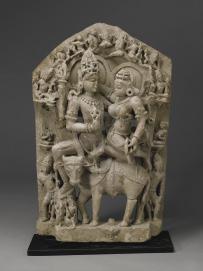
AUCTION RESULT COMPARISON
Type: Closely related
Auction: Sotheby’s New York, 16 March 2016, lot 761
Price: USD 32,500 or approx. EUR 36,500 converted and adjusted for inflation at the time of writing
Description: A buff sandstone figure depicting Uma-Maheshvara, Central India, 10th/11th century

Expert remark: Note the larger size (78.8 cm)
Estimate EUR 10,000
Starting price EUR 5,000

364 240
Leonardo Vigorelli
A MAGNIFICENT BLACK STONE STELE DEPICTING AN ENSHRINED VAIROCANA, PALA PERIOD, NORTHEASTERN INDIA, 11TH-12TH CENTURY

Expert’s note: This depiction of Vairocana shows the distinct Pala emphasis on figures with broad shoulders and chests, articulated waists, and almost square faces, with long, thin features.
Finely and deeply carved in high relief with Vairocana seated in dhyanasana on a lotus base, his right hand lowered in bhumisparsha mudra and his left resting on his lap, the primordial Buddha within a tri-lobed arched shrine supported by two columns and centered by a kirtimukha, surrounded by seated Buddhas in niches, the top corners each with a stupa.
Provenance: From a private collection in Bergamo, Italy, acquired in the antiques trade during the late 1980s and early 1990s. Collection of Leonardo Vigorelli, Bergamo, acquired from the above. Leonardo Vigorelli is a retired Italian art dealer and noted collector, specializing in African and ancient Hindu-Buddhist art. After studying anthropology and decades of travel as well as extensive field research in India, the Himalayan region, Southeast Asia, and Africa, he founded the Dalton Somaré art gallery in Milan, Italy, which today is being run by his two sons.
Condition: Very good condition, commensurate with age. Wear, minor losses, small nicks, light scratches, few minor cracks, signs of weathering and erosion, encrustations.
Dimensions: Height 59 cm (excl. stand) and 60 cm (incl. stand)
Mounted on an associated stand. (2)
Vairocana, also known as the primordial Buddha, is a celestial deity central to many Buddhist sutras and the development of Vajrayana Tantric Buddhism. This stele was likely one of five panels, each depicting one of the five Dhyani Buddhas, who represent the five mental and physical aggregates that make up the whole of cosmic and individual existence.
AUCTION RESULT COMPARISON
Type: Closely related
Auction: Christie’s New York, 18 March 2015, lot 4049
Price: USD 32,500 or approx. EUR 37,000 converted and adjusted for inflation at the time of writing
Description: A stone stele depicting Vairocana, Northeastern India, Pala period, 11th/12th century Expert remark: Note the smaller size (51.4 cm)

Estimate EUR 16,000
Starting price EUR 8,000
241
A JAIN SANDSTONE STELE OF THREE JINAS, WESTERN INDIA, RAJASTHAN OR GUJARAT, 10TH-12TH CENTURY
Finely carved in high relief with three nude Jinas standing side by side in kayostarga, each on a rectangular plinth with small figures of worshippers and vyalas, the central Jina flanked by two small figures, the top carved with a seated deity flanked by elephants.
Provenance: From the collection of JeanMarc Andral, acquired 1990 in Belgium. A copy of a provenance statement, written and signed by Jean-Marc Andral, dated 10 December 2022, accompanies this lot. Jean-Marc Andral is a Belgian manager based in Brussels and active in the healthcare industry for over 25 years.
Condition: Very good condition, commensurate with age. Extensive wear, minor losses, nicks and scratches, signs of weathering and erosion, structural cracks, encrustations.
Dimensions: Height 51 cm (excl. stand) and 52 cm (incl. stand)
With a modern metal stand.
Jinas are depicted in only two poses: Kayostarga, standing, or dhyani, seated in meditation, and due to the identical poses and expressions they are distinguished mainly by their vahanas, or vehicles, appearing at the feet of the figures or carved on to the pedestals. In the present example, an exact identification of the Jina is not possible. However, Mahavira is the most commonly represented of the tirthankaras in the kayostarga attitude, and therefore an attribution seems appropriate. Another reasonable attribution would be the second tirthankara, Ajitanatha, whose emblem is the elephant, two of which are carved at the top of this stele.
The earliest extant Jain images date to the first century C.E. and were created in the area around Mathura, the center of much religious activity. Jainism is India’s third great ancient religion and was founded contemporaneously with Buddhism, from which it differed by its advocating the attainment of a spiritual life through asceticism. This may account for the conventional depiction of tirthankaras in a rigid frontal pose. The term Jina, meaning “Conqueror” or “Victor of over Life” is applied to one who, like the Buddha, has attained perfect knowledge. Tirthankara meaning “He who has crossed the Ford” of rebirth and attained perfect freedom, is equivalent to Jina. In many respects, and more particularly in the seated poses, the Jina figure has many parallels to the Buddha image with the exception that, among the Digambara sect of Jains, the figure is always nude and the chest bears the srivasta.

The nudity of Jain saints was a practice of both asceticism and their belief in non-possession, dating back to the days of Mahavira. However, a schism arose in around 79 C.E., extensively recorded in literature, about what constitutes total renunciation. At the time, Jain monks separated into rival factions, the Digambaras “clothed with the sky” or nude and the Svetambaras, “clothed with white”, who partially clad themselves with white cloth. According to inscriptions the Svetambaras worshipped the nude image without objection and for both sects the Jinas and the saint Bahubali are represented naked while all other deities are clothed and even ornamented.
The present sculpture symbolizes mankind disregarding the material world and his animal nature. The figure is a human being transformed into a godlike state and the worship of it is not a two-way interaction but a meditation, where the deity is not expected to grant favors but rather to exemplify a state of being attainable by all.
Literature comparison: Compare a related marble stele of Ajitanatha and his divine assembly, dated 1062, 149.9 cm high, in the Norton Simon Museum, accession number M.1998.1.S.
AUCTION RESULT COMPARISON
Type: Related
Auction: Christie’s Paris, 7 June 2011, lot 353
Price: EUR 46,600 or approx. EUR 55,500 adjusted for inflation at the time of writing
Description: A fine sandstone figure of a Jain tirthankara, India, Rajasthan or Gujarat, 11th century

Expert remark: Note the significantly larger size (100 cm)

Estimate EUR 16,000
Starting price EUR 8,000
366 242
Jean-Marc Andral

A RARE, LARGE AND VERY HEAVY BRONZE FIGURE OF VISHNU, VIJAYANAGARA EMPIRE, 1336-1646, OR EARLIER
South India. Heavily cast, standing in samabhanga atop a circular plinth, clad in a loincloth, his four arms held around him, the face with large and neatly incised almond-shaped eyes, pierced ears, full lips, and a prominent chin, the head surmounted by a conical headdress topped with a bud-form finial, a small lotus halo on the back, the bronze with a rich deep brown patina overall.
Provenance: Property from an Asian collection, acquired in the 1990s.
Christie’s Amsterdam, 21 November 2001, lot 41 (described as Vijayanagar, 14th/15th century, probably Rama).
Christie’s New York, 21 March 2008, lot 761 (described as a four-armed deity, South India, 16th century), sold for USD 39,400 or approx. EUR 52,000 (converted and adjusted for inflation at the time of writing).

Condition: Very good condition with expected old wear, small nicks and light scratches, minor losses. Superb, naturally grown patina with areas of malachite encrustation overall. Displaying remarkably well.
Weight: 8,195 g
Dimensions: Height 42.5 cm
This is a remarkable bronze for which there is no direct comparison. The arms and hands combine to form a striking sense of movement, cleverly balanced against the high cylindrical headdress pronouncing the vertical axis.


Please note that additional research about this lot is available in the online catalog at www.zacke.at.
Estimate EUR 40,000
Starting price EUR 20,000
243

A WHITE MARBLE FIGURE OF GANESHA, HINDU SHAHI, AFGHANISTAN, 822-1026


Finely carved, the coiled trunk raised toward the mouth as he has just sampled a sweet from the bowl held in his right hand, the face with almond-shaped eyes below elegantly arched and raised brows centered by an urna, the hair secured by a beaded headband.
Provenance: Dr. René Schroeder, Luxembourg, 1973. Yvette Starck, Luxembourg, acquired from the above and thence by descent. A Belgian private collection, acquired from the above. A copy of the original invoice from Dr. René Schroeder, dated 10 September 1973 and addressed to Yvette Starck, accompanies this lot.

Condition: Good condition, commensurate with age. Extensive wear, losses, nicks, scratches, signs of weathering and erosion, structural cracks, minor old repairs and fills, encrustations.
Weight: 17.3 kg (incl. stand)
Dimensions: Height 39 cm (excl. stand) and 45 cm (incl. stand)
Mounted on an associated stand. (2)
The Hindu Shahis (822-1026) were a dynasty that held sway over the Kabul Valley, Gandhara, and western Punjab during the early medieval period in the Indian subcontinent. The dynasty was established after the
overthrow of the Turk Shahis. Shaivism was practiced by the Hindu Shahis and likely was also the predominant religion. Saura was practiced by some subjects, as were Buddhism and Islam. Scholarship on the Hindu Shahis remains scarce and details regarding past rulers can only be assembled from disparate chronicles, coins, and stone inscriptions.
LITERATURE COMPARISON
Compare a related marble figure of Ganesha, 22.6 cm high, attributed to Pakistan or Afghanistan and dated to the Shahi period, 7th-8th century, in the Art Institute of Chicago, reference number 2012.689. Compare the related manner of carving of a Hindu Shahi white marble linga, with similar eyes and brows, dated 9th century, in the Metropolitan Museum of Art, accession number 1980.415. A related white marble figure of Ganesha, 47.5 cm high, attributed to the Hindu Shahi or post-Gupta period, Punjab Hills, dated mid-9th century, was exhibited at Asian Art in London by Joost Van den Bergh in Objects of Veneration: Sculpture & Paintings from Gandhara, Burma, Khmer, Ceylon, India & Tibet, 5-14 November 2015.
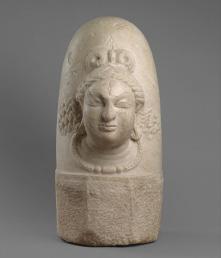
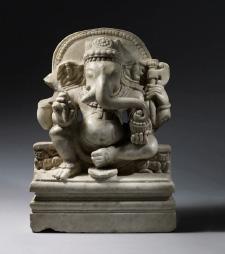
370
244
Estimate EUR 16,000 Starting price EUR 8,000
A GRANITE FIGURE OF GANESHA, ORISSA, 13TH CENTURY


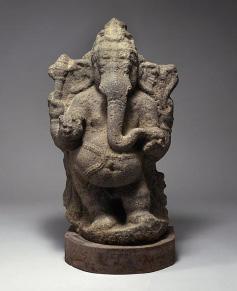
Standing in sambhanga on a lotus pedestal with a female worshipper kneeling at his side above a crouching rat. Wearing a short dhoti, sacred thread, and beaded jewelry. In his four hands he is holding a staff, rosary, broken tusk, and a bowl of sweets, from which he samples with his curved trunk. The face with almond-shaped eyes centered by a circular design, flanked by prominent veined ears, the head surmounted by an elaborate headdress.
Provenance: From the collection of Jean-Marc Andral, acquired between 1996 and 2005 at Galerie Carré des Antiquaires in Versailles, France. A copy of a provenance statement, written and signed by Jean-Marc Andral, dated 31 July 2022, accompanies this lot. Jean-Marc Andral is a Belgian manager based in Brussels and active in the healthcare industry for over 25 years.
Condition: Very good condition, commensurate with age. Extensive wear, losses, nicks and scratches, signs of weathering and erosion, encrustations, few structural cracks. Solid, naturally grown patina.
Weight: 46.1 kg

Dimensions: Height 64 cm
LITERATURE COMPARISON
Compare a related schist figure of Ganesha, 119 cm high, attributed to Orissa and dated to the 13th century, with a similar lotus pedestal and veined ears, and holding the same attributes, in the British Museum, registration number 1872,0701.59. Compare also a related and slightly earlier granite figure of Ganesha, 86.4 cm high, dated to the late Chola dynasty, 10th-12th century, from the Avery Brundage collection and now in the Asian Art Museum of San Francisco, object number B63S45+.
Estimate EUR 16,000
Starting price EUR 8,000
371
245
Jean-Marc Andral
246
A SILVER-INLAID COPPER ALLOY FIGURE OF GANESHA, SOUTH INDIA, C. 1650-1750
Well cast seated on a square base with spreading feet, his vehicle the rat found prominently at the front, holding in his secondary hands two axes and in his primary hands his broken tusk and sweets which he is sampling from with his elegantly curved trunk. He is wearing a short dhoti and an upavita. His almond-shaped eyes are finely inlaid in silver. His head is surmounted by a tiered conical crown and backed by a floral halo. With an attractive, buttery patina, this personal shrine image has clearly been the object of much affection under the devotee’s thumbs over the past centuries.
Provenance: German trade.
Condition: Good condition with some wear, casting flaws, small nicks, minor losses, dents, light scratches. Fine, naturally grown patina with areas of malachite encrustation.
Weight: 2,284 g
Dimensions: Height 18.2 cm
Literature comparison: Compare a related bronze figure of Ganesha, 16.5 cm high, also attributed to South India and dated 1650-1750, in the Victoria & Albert Museum, accession number IM.76-1914.
AUCTION RESULT COMPARISON
Type: Closely related
Auction: Christie’s New York, 21 March 2001, lot 42
Price: USD 8,813 or approx. EUR 14,000 converted and adjusted for inflation at the time of writing
Description: A Bronze Figure Of Ganesha, South India, 17th Century


Expert remark: Note the similar size (19 cm)
Estimate EUR 4,000
Starting price EUR 2,000
372
A SANDSTONE FIGURE OF DANCING GANESHA, MADURAI, 12TH CENTURY
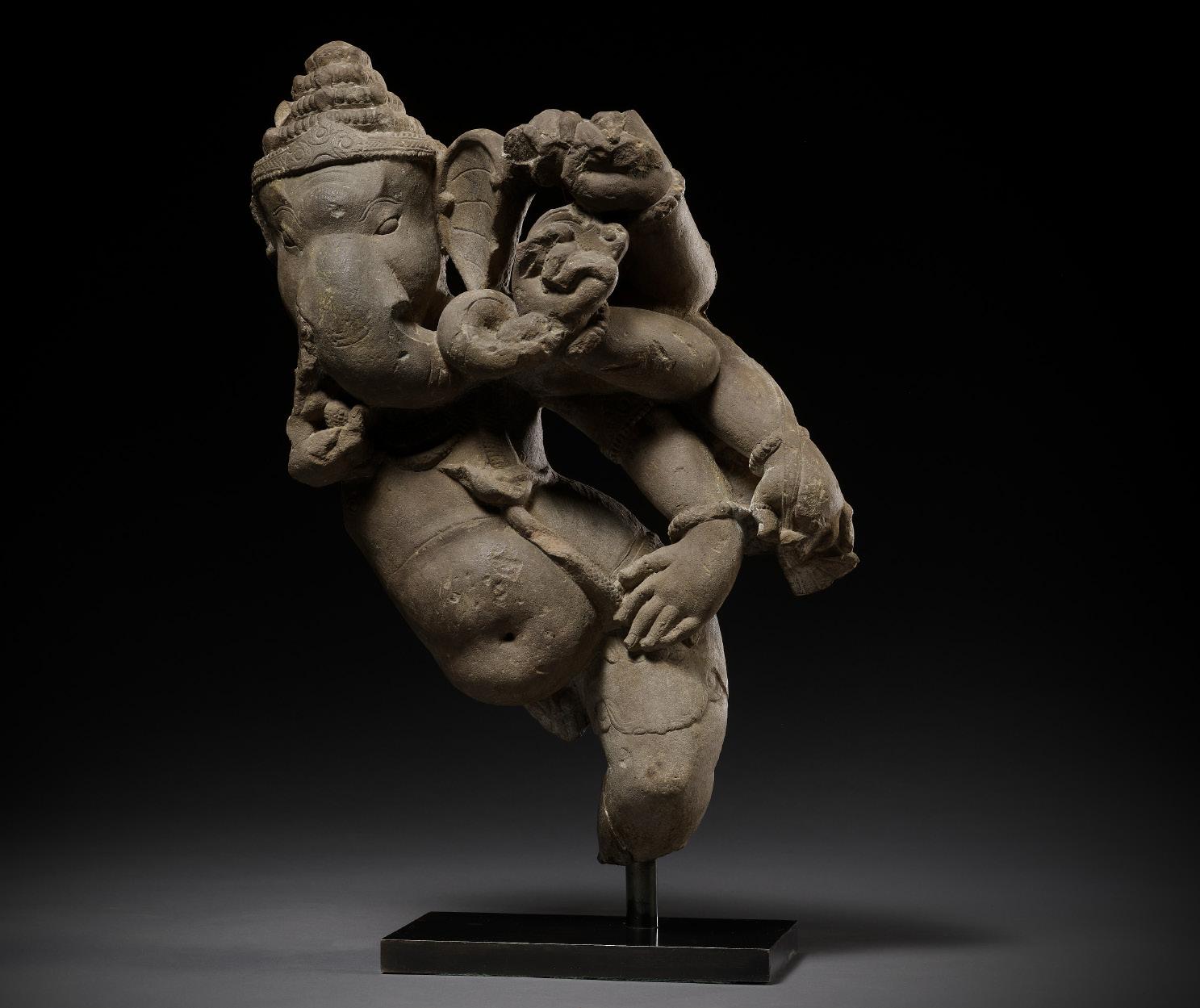
South India, Tamil Nadu. Finely carved in a dancing pose, his left side with four arms, one hand holding the hem of his robe, another holding his broken tusk, the coiled trunk extended toward the left side, his face with almond-shaped eyes and neatly incised arched brows, the head surmounted by an elaborate crown.
Provenance: Parminder Soin, Munich, Germany, by 1983. A private collection in Germany, acquired from the above and thence by descent. A copy of an expertise, signed by Parminder Soin, owner of Alte Indische und Asiatische Kunst, Munich, Germany, dated 12 August 1983, dating the present figure to the 12th century and attributing it to a Shiva temple in Madurai, stating a value of DEM 20,000-22,000 or approx. EUR 17,500-19,500 (converted and adjusted for inflation at the time of writing), accompanies this lot.

Condition: Good condition, commensurate with age. Extensive wear, losses, nicks, scratches, signs of weathering and erosion, structural cracks, encrustations.
Weight: 23.7 kg (incl. stand)
Dimensions: Height 51 cm (excl. stand) and 55 cm (incl. stand)
Mounted on an associated stand. (2)
Madurai, a major city in the Indian state of Tamil Nadu and its cultural capital, is built around the Meenakshi Temple, which acted as the geographic and ritual center of the ancient city of Madurai. Madurai Meenakshi Sundareswarar temple was built by the Pandayan Emperor Sadayavarman Kulasekaran I (reigned 1190-1205). The temple is a
major pilgrimage destination within the Shaivism tradition, dedicated to Meenakshi Devi and Shiva. Other temples in Madurai include the Koodal Azhagar and Kallalagar temples, which are dedicated to Vishnu, and the Madurai Mukkuruni Vinayagar Ganesh temple.
Sculptures in the 1000-pillar mandapa (choultry) of the Meenakshi Temple, around 1895, photograph from the Elgin Collection, British Library

Known as the Remover of Obstacles and worshipped for auspicious beginnings, Ganesha is a beloved Hindu deity. Regardless of his elephant head, multiple arms, jewelry, and plump figure, his character is clever and his body remarkably agile, as demonstrated by his dancing steps in the present example. Like the other Hindu gods, Ganesha manifests a variety of appearances, always recognizable by his elephant head. The theme of the dancing Ganesha, in which he follows in the footsteps of his father, Shiva Nataraja, also captivated the sculptors of Central India, who produced some of the liveliest examples between the 8th and 11th centuries, the present lot however being in no way inferior to such pieces.
AUCTION RESULT COMPARISON
Type: Related
Auction: Christie’s New York, 20 March 2019, lot 645
Price: USD 50,000 or approx. EUR 53,000 converted and adjusted for inflation at the time of writing
Description: A Red Sandstone Stele of Dancing Ganesha, Central India, 10th-11th Century Expert remark: Compare the related style, carving technique, pose, material and size (62 cm).

Estimate EUR 6,000
Starting price EUR 3,000
373 247
A VERY LARGE BRONZE OF SHIVA NATARAJA, SOUTH INDIA, 18TH - 19TH CENTURY
Finely cast, the eight-armed deity gracefully presented with a raised leg, dancing on a lotus pedestal atop a rectangular plinth, within a flaming aureole, his right foot resting upon the demon Apasmarapurusha, his hands holding various implements including a drum, flame, dagger, disk, and trident. His face neatly incised with almond-shaped eyes, gently arched brows, an urna, and full lips, his hair radiating in serpentine tresses, the head surmounted by a naga headdress.
Provenance: From an Austrian private collection. Old trade label to backside.
Condition: Very good condition with expected old wear and casting irregularities, small nicks, light scratches, minor dents. Beautiful, naturally grown chocolate-brown patina overall.
Dimensions: Height 91 cm
Shiva Nataraja, Shiva as Lord of the Dance, is considered the creator of the universe and dances the world into existence. At the same time, he is also its destroyer. Much symbolism is attached to this specific form of Shiva. His drum stands for the creation of the world. His open palm protects human beings while his downward stretched hand symbolizes the solace of the world. His other hand holds the fire standing for the dissolution of the world. The dwarf on whom he tramples represents ignorance and the large flaming aureole the cosmos. The goddess Ganga represented in his hair fell from heaven to earth through his hair.
Literature comparison: Compare a closely related bronze figure of Shiva Nataraja, 76.2 cm high, dated to the 18th century, in the Brooklyn Museum, accession number 27.959.
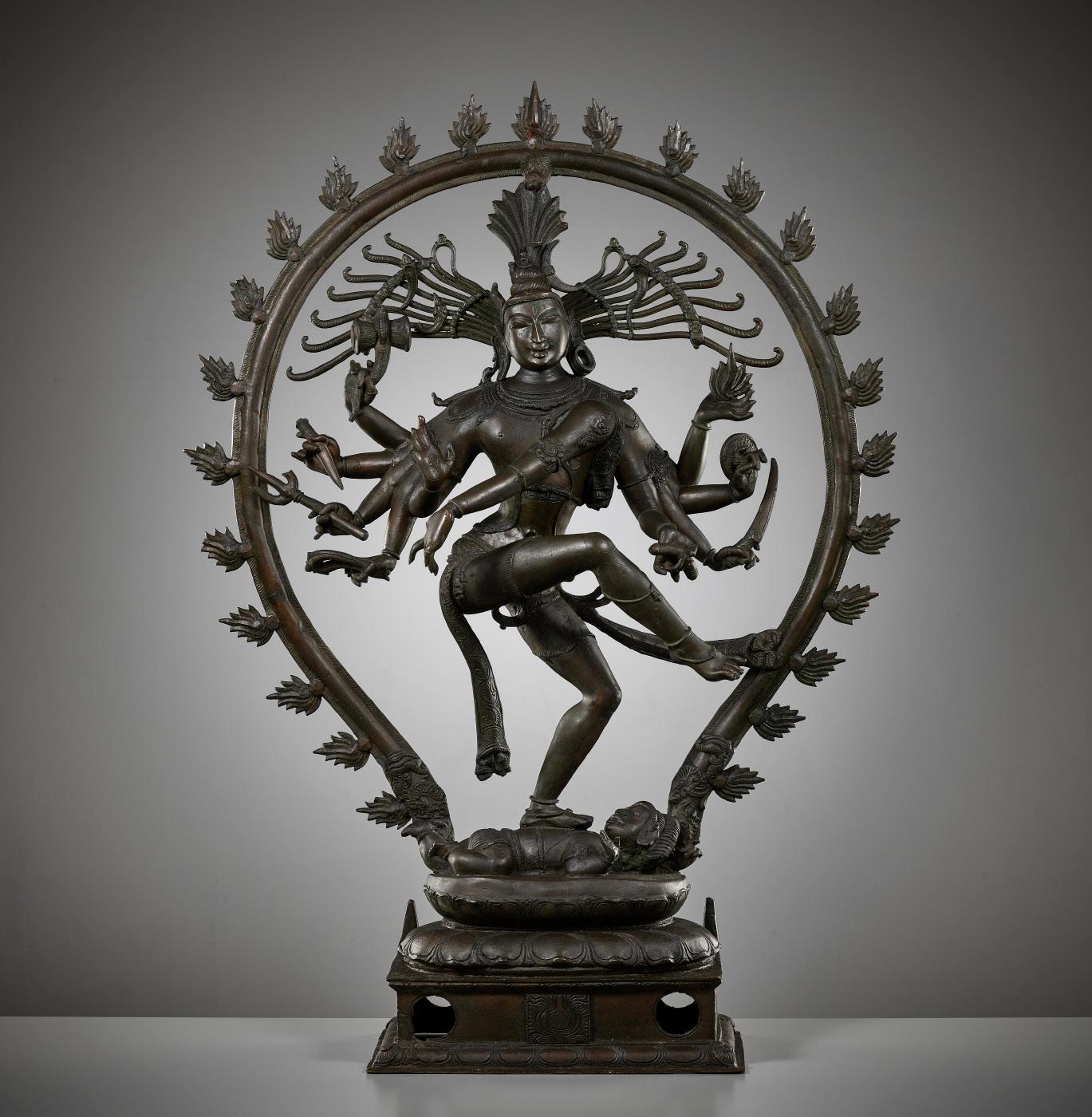
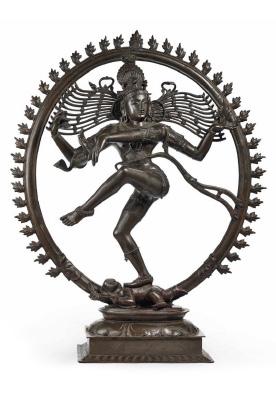
AUCTION RESULT COMPARISON
Type: Related
Auction: Christie’s Paris, 14 December 2016, lot 5
Price: EUR 92,500 or approx. EUR 113,000 adjusted for inflation at the time of writing
Description: An important bronze figure of Shiva Nataraja, South India, Nayak period, late 18th century Expert remark: Compare the closely related pose, manner of casting, serpentine hair and naga headdress, flaming aureole, and lotus pedestal. Note the size (106 cm).
Estimate EUR 10,000
Starting price EUR 5,000
374 248
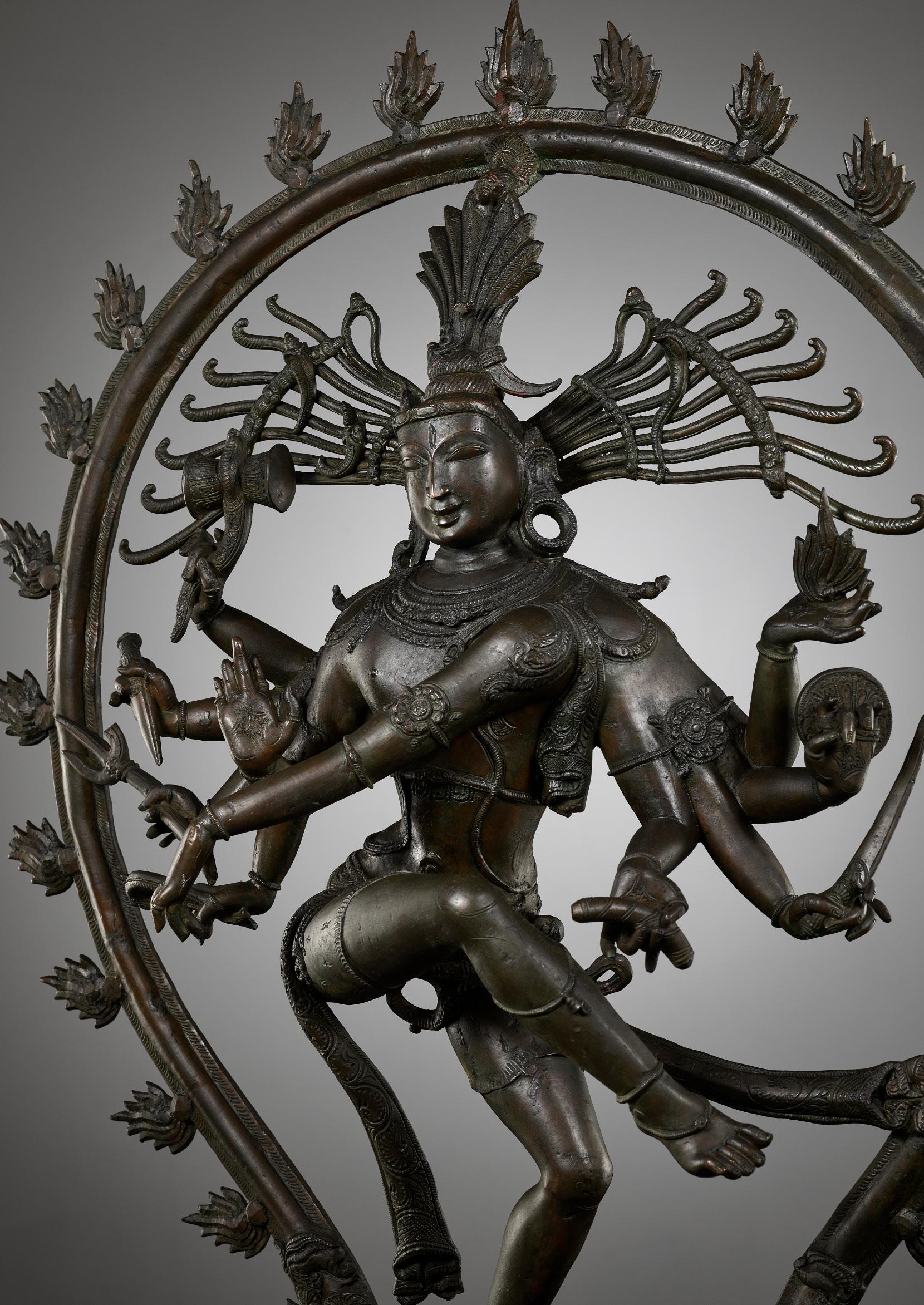
A HORSE-FORM BRONZE RHYTON, CENTRAL ASIA, C. 1000 AD

Scientific Analysis Report: A copy of an Expert Report from Antiques Analytics – Institute of Scientific Authenticity Testing, test report number AA 22-10021, dated 11 March 2022, written and signed by Dr. R. Neunteufel, accompanies this lot. The alloy components of the present lot have been analyzed via atomic emission spectrometry of a sample dissolved in mineral acid. Findings include a zinc content of 5.6% (rare for objects from the period), a low arsenic content of 0.02% (could indicate a refinement of raw copper, speaking for a later period of manufacture), and a tin content of 5.7% (lower than usually found in Central Asian bronzes of the period). The report concludes that the findings do not decisively contradict the suggested period of manufacture.
The horn-shaped beaker with fluted sides below a neatly incised wave band and the gently everted rim. The separately cast horse and rhyton are connected by a raised cuff. The muscular animal shows bent forelegs just below a small filler neck, further detailed with pricked ears, almond-shaped eyes, a prominent muzzle, and a short mane. The bronze with a superb, naturally grown and professionally stabilized patina with malachite encrustation.
Provenance: The collection of The Zelnik István Southeast Asian Gold Museum. Institutional art collection in Belgium, acquired from the above. Dr. István Zelnik, President of the Hungarian South and Southeast Asian Research Institute, is a former high-ranking Hungarian diplomat who spent several decades in Southeast Asia, building the largest known private collection of Asian art in Europe. Condition: Good condition, commensurate with age. Wear, losses, minor dents and nicks, light scratches, encrustations, signs of weathering and corrosion. The patina was stabilized with a layer of varnish some time ago. A drilled hole from sample-taking.

Dimensions: Height 24.5 cm
Estimate EUR 8,000
Starting price EUR 4,000

376
249
Dr. István Zelnik
A PAIR OF GOLD ‘BIRD’ BANGLES, PERSIA, 11TH TO 12TH CENTURY

Of circular form, with hinged upper section terminating in two confronting birds centered by a clasp, their plumage inlaid in coral, turquoise, and corundum framed by beaded borders.
Provenance: The collection of The Zelnik István Southeast Asian Gold Museum. Institutional art collection in Belgium, acquired from the above. Dr. István Zelnik, President of the Hungarian South and Southeast Asian Research Institute, is a former high-ranking Hungarian diplomat who spent several decades in Southeast Asia, building the largest known private collection of Asian art in Europe.

Condition: Good condition, expected old wear and traces of use, small nicks and dents, light surface scratches, few inlays lost.
Alloy composition range: 70.21% gold, 28.36% silver, 1.42% copper. The bangles were tested by the Zelnik István Southeast Asian Gold Museum.
Weight: 54.65 g and 48.67 g
Dimensions: Outer diameter 8.4 cm (each), Inner diameter 6.2 cm (each)

AUCTION RESULT COMPARISON
Type: Closely related
Auction: Bonhams London, 24 April 2012, lot 47
Price: GBP 3,750 or approx. EUR 6,000 converted and adjusted for inflation at the time of writing
Description: A Gold Bracelet with Bird-Shaped Terminals, Persia, 11th-12th Century
Expert remark: Compare the closely related form, bird finials, and size (8.2 cm). Note the apparent condition issues, missing inlays, lower weight (15 g), and that this listing is for a single bracelet only.

Estimate EUR 12,000
Starting price EUR 6,000
377 250
The Zelnik István Southeast Asian Gold Museum
A SILVER-INLAID BRONZE FIGURE OF BUDDHA SHAKYAMUNI, PAGAN KINGDOM
Burma, 12th-13th century. Finely cast seated in dhyanasana with his left hand resting in his lap and the right lowered in bhumisparsha mudra. He is wearing a diaphanous sanghati draped over his left shoulder and with folds gathering below his feet. His oval face with silver-inlaid almond-shaped eyes and a circular urna, aquiline nose, and pursed lips forming a serene smile, flanked by long pendulous earlobes, his hair arranged in tight curls rising to a domed ushnisha. The back with a long and massive tang.
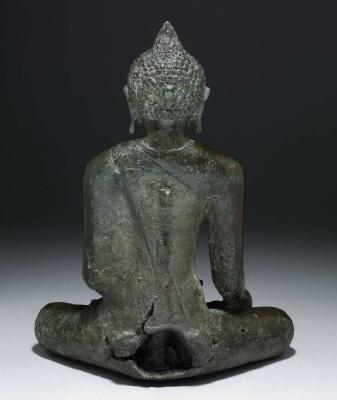

Provenance: English trade.
Condition: Good condition, commensurate with age. Extensive wear and weathering as expected, some losses with associated old fills mostly around the base, casting flaws, foundry grit, nicks and dents, shallow surface scratches, encrustations. Naturally grown, rich malachite-green patina overall.
Weight: 3,408 g
Dimensions: Height 26 cm
The Kingdom of Pagan was the first Burmese kingdom to unify the regions that would later constitute modern-day Myanmar. Pagan’s 250-year rule over the Irrawaddy valley and its periphery laid the foundation for the ascent of Burmese language and culture, the spread of Bamar ethnicity in Upper Myanmar, and the growth of Theravada Buddhism in Myanmar and in mainland Southeast Asia. The Burmese language and culture gradually became dominant in the upper Irrawaddy valley, eclipsing the Pyu, Mon, and Pali norms by the late 12th century. Theravada Buddhism slowly began to spread to the village level although Tantric, Mahayana, Brahmanic, and animist practices remained heavily entrenched at all social strata. Pagan’s rulers built over 10,000 Buddhist temples in the Bagan Archaeological Zone of which over 2,000 remain today. The wealthy donated tax-free land to religious authorities. The kingdom went into decline in the mid-13th century as the continuous growth of tax-free religious wealth by the 1280s had severely affected the crown’s ability to retain the loyalty of courtiers and military servicemen. This ushered in a vicious circle of internal disorders and external challenges by the Arakanese, Mons, Mongols and Shans. Repeated Mongol invasions between 1277 and 1301 toppled the four-century-old kingdom.
LITERATURE COMPARISON
Compare a closely related Pagan bronze figure of a seated Buddha, with a similar tang to the back (referred to as a “strut”), 34 cm high, also dated 12th-13th century, in the British Museum, registration number 1971,0727.1 (fig. 1). Compare a related Pagan bronze figure of a standing Buddha, with a similar expression and silver-inlaid eyes, 50.5 cm high, also dated 12th-13th century, in the Metropolitan Museum of Art, accession number 1993.235.1.
AUCTION RESULT COMPARISON
Type: Related
Auction: Christie’s New York, 17 September 1998, lot 170
Price: USD 134,500 or approx. EUR 231,000 converted and adjusted for inflation at the time of writing
Description: A large bronze figure of Buddha, Burma, Pagan period, 12th century
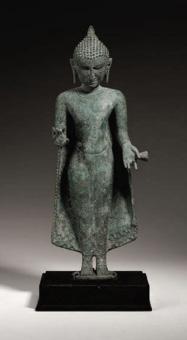

Expert remark: Compare the closely related expression, with similar silver-inlaid eyes, and rich green patina. Note the standing pose and larger size (50.5 cm).
Estimate EUR 8,000
Starting price EUR 4,000
378 251
fig. 1


252
A LARGE AND HEAVY WHITE MARBLE LACQUERED FIGURE OF BUDDHA SHAKYAMUNI, 17TH CENTURY
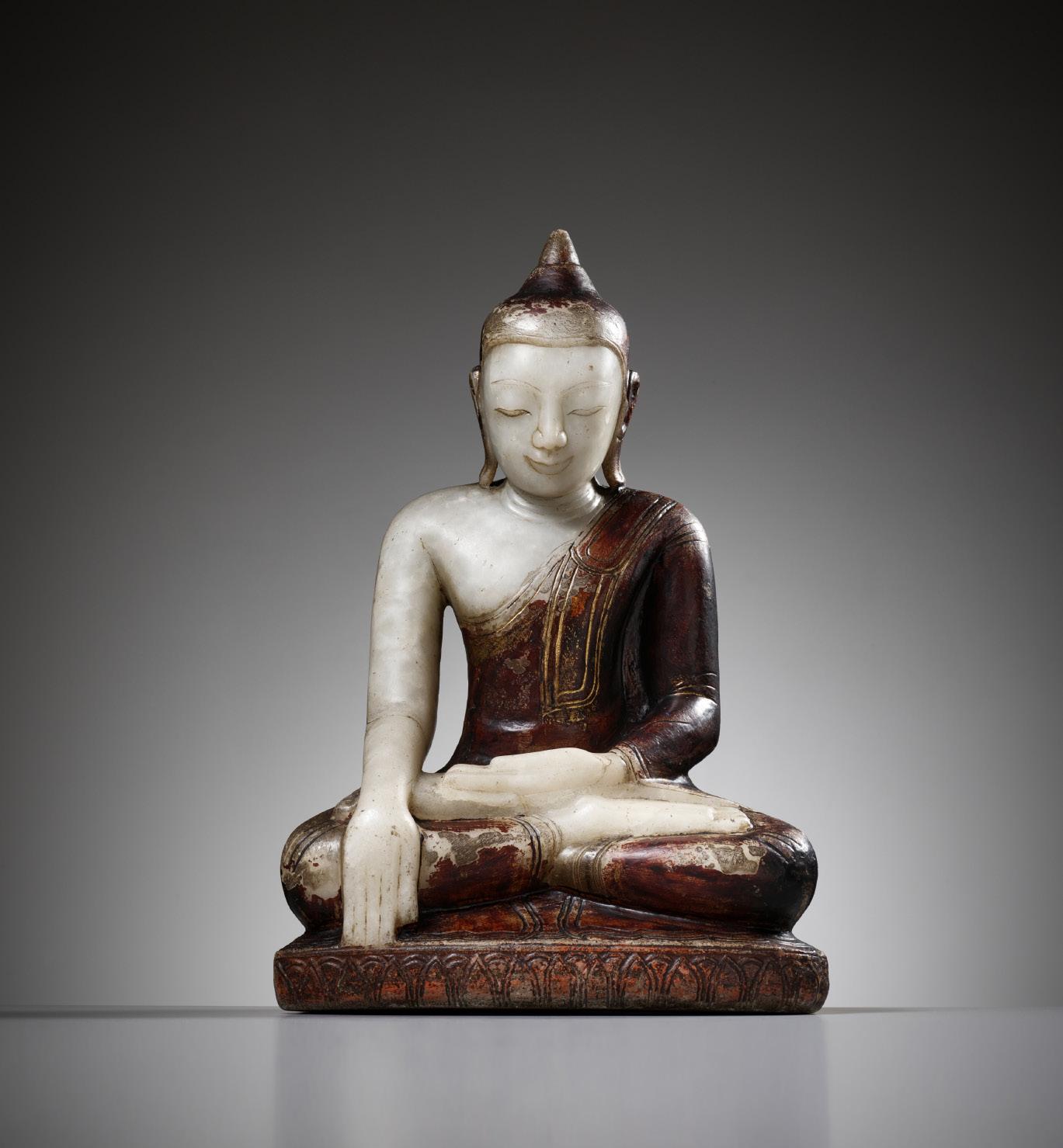
Burma. The white marble finely carved to depict Buddha seated in dhyanasana atop a neatly incised lotus throne, his left hand above his lap and the right lowered in bhumisparsa mudra, wearing a tight-fitting robe draped over his left shoulder and gathering in folds at the base. The serene face with heavy-lidded downcast eyes above gently arched brows and full lips forming a calm smile, flanked by long pendulous earlobes, the hair surmounted by a conical ushnisha. The hair, ears, robe, and base covered in a reddish-brown lacquer, the marble of an attractive milky white tone.
Provenance: Austrian trade.
Condition: Good condition overall with expected wear, weathering and traces of use. Flaking to lacquer, remnants of gilt, nicks, scratches, signs of erosion, some losses and minor structural cracks.
Weight: 27.6 cm
Dimensions: Height 51 cm
The knob on the top of the head of this Buddha image is the ultimate successor to the cranial protuberance covered with hair found on the very earliest Buddha images (first-second centuries AD). This most probably served as a reminder that the Buddha, once from a warrior caste, originally wore his uncut hair in a bun or chignon hidden under his turban. The origin of this feature came to be forgotten, but was re-discovered in the 16th-17th centuries and eventually topped by a flame.
LITERATURE COMPARISON
Compare a related giltlacquered white marble figure of Buddha, 75 cm high, also dated to the 17th century, in the Ashmolean Museum, Oxford, accession number 1685 B no. 175 A.

Estimate EUR 6,000
Starting price EUR 3,000
381
A MONUMENTAL LACQUER-GILT BRONZE STATUE OF BUDDHA SHAKYAMUNI, MANDALAY PERIOD
Burma, 1853-1948. Massively cast, seated in dhyanasana atop a tiered base centered by a shaped panel, his left hand resting on his lap and his right lowered in bhumisparsha mudra. Wearing long flowing robes cascading in voluminous folds, his serene face with agate-inlaid eyes. The full lips forming a calm smile, flanked by long pendulous earlobes, the hair in tight curls surmounted by an ushnisha and secured by a band of glass inlays.


Provenance: From an Austrian private estate. Condition: Very good condition with expected wear and weathering, mostly to lacquer gilding, minor losses, some dents and nicks, light scratches, casting flaws.
Dimensions: Height 104.5 cm
LITERATURE COMPARISON
Compare closely related examples in the Guimet Museum, Paris, accession number MA6210, and in the Asian Civilisations Museum, Singapore, accession number 2014-00461 (fig. 1).
AUCTION RESULT COMPARISON
Type: Closely related
Auction: Bonhams Hong Kong, 29 March 2019, lot 41
Price: HKD 250,625 or approx. EUR 35,200 converted and adjusted for inflation at the time of writing
Description: A copper alloy and lacquer seated Buddha in Maravijaya, Myanmar, Mandalay period

Expert remark: Compare the closely related pose, casting, and slightly smaller size (100 cm).
Estimate EUR 10,000
Starting price EUR 5,000
382
253
fig. 1
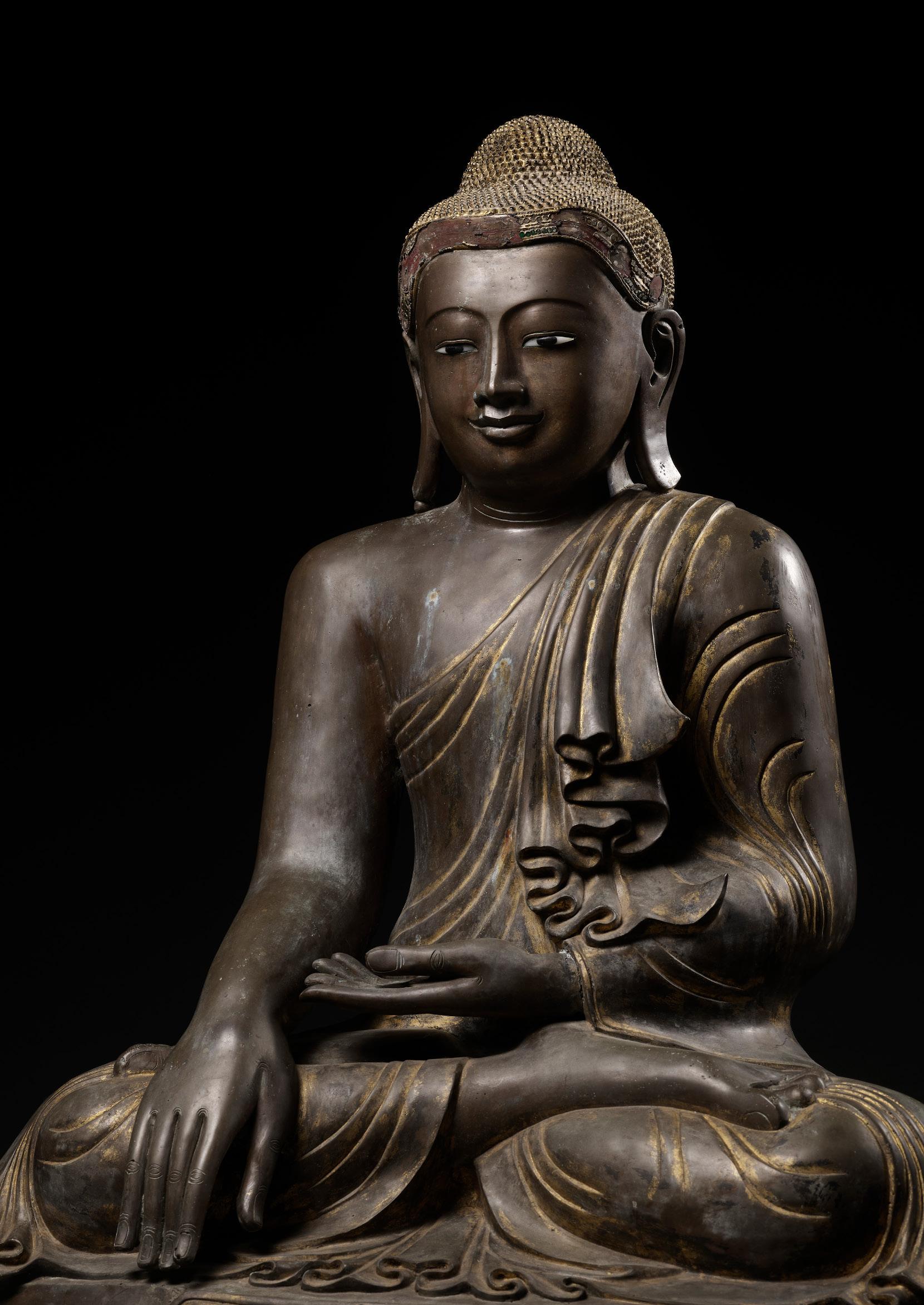

A RARE BRONZE FIGURE OF BUDDHA, MON DVARAVATI PERIOD

Scientific Analysis Report: A thermoluminescence analysis report issued by Oxford Authentication on 12 February 2020, based on sample number N120b91, sets the firing date of one sample taken between 1000 and 1600 years ago. A copy of the report, signed by Helen Mason and Doreen Stoneham for Oxford Authentication, accompanies this lot.

Thailand, 8th-9th century. Superbly cast standing with the hands extended, draped in a dhoti and sanghati, his face with benign expression, downcast eyes, arched joined brows, full lips, and a broad nose, flanked by pendulous earlobes, his hair in tight curls over a high ushnisha.
Provenance: From an old Belgian private collection.
Condition: Good condition commensurate with age. As expected there is extensive wear, some casting flaws, losses to the hands, signs of weathering and erosion, few nicks and shallow surface scratches. The back drilled with a hole from sample-taking. Naturally grown patina of a fine malachite-green tone overall, with distinct areas of cuprite encrustations.
Weight: 1,812 g (excl. base) and 2,586 g (incl. base)
Dimensions: Height 31 cm (excl. base and tang), 36 cm (excl. base) and 42 cm (incl. base)
With a modern base. (2)
The Mon polity of Dvaravati was one of the earliest and most important societies in mainland Southeast Asia. Based around the Chao Phraya and Mae Klang river basins of central Thailand, Dvaravati was known from early Chinese textual sources, as well as being mentioned in a single local inscription that dates to roughly 550-650 AD. Due to the large numbers of Buddhist sculptures associated with the culture, it is most likely that the rulers were patrons of the Buddhist faith. The images of Buddha were influenced by contemporary Indian sculptural works, including the Gupta style based around the site of Sarnath. The facial features of the Mon Dvaravati Buddhist images, however, display arched, joined eyebrows which are unlike those found in India, and are therefore characteristic of Mon Dvaravati. Compared to earlier and later Thai kingdoms, Dvaravati was geographically and economically isolated, which contributed to the distinct qualities of its sculpture. Their style was bold, self-assured, recognizable, and highly influential on subsequent Thai sculpture and artistic production throughout Southeast Asia.
Within the context of the dominant Theravada school of Buddhism, which emphasized the singularity of the Buddha Shakyamuni, bronze sculptures from this area also demonstrate a remarkably cohesive design. As unifying features, the Buddha is clad in the humble dress of a religious renunciant, with the thin garment clinging closely to the body to reveal his delicate proportions and graceful contours that lie beneath. His face is characterized by high cheekbones, full lips, prominent eyes, and – as stated – the curved brows that form the characteristic V-shape at the bridge of the nose.
As expressed by Jean Boisselier, “The school of Dvaravati may stand alongside the great Buddhist artistic traditions of India, so enduring were its innovations and so persuasive its influence on most of the art of Southeast Asia” (J. Boisselier, The Heritage of Thai Sculpture, 1975, page 73). Bronze sculptures of this type and large size are exceedingly rare.
Further emphasizing the presence of Buddha in the world of the devotee, the figure is depicted as if in motion, with the hems of the robe gently swaying to the sides. This stance, which also draws upon the classic tribhanga posture of Indian sculpture, presages the famous “Walking Buddhas” of Thailand that would grow prominent many centuries later. The bronze caster has masterfully captured the youthful appearance of Buddha that gives the spiritual themes imported from India their highly unique and refined local expressivity.
AUCTION RESULT COMPARISON
Type: Closely related
Auction: Christie’s New York, 17 March 2015, lot 29
Price: USD 269,000 or approx. EUR 318,000 converted and adjusted for inflation at the time of writing
Description: A Bronze Figure of Buddha, Thailand, 8th Century
Expert remark: Compare the closely related pose, facial features, expression, robe, and size (36.1 cm)
AUCTION RESULT COMPARISON
Type: Closely related
Auction: Christie’s New York, 15 March 2017, lot 244
Price: USD 68,750 or approx. EUR 80,500 converted and adjusted for inflation at the time of writing
Description: A bronze figure of Buddha, Thailand, Mon Dvaravati style, 9th century


Expert remark: Compare the closely related pose, facial features, expression, curls, ushnisha, and robe. Note that the figure is of slightly larger size (42.5 cm).
AUCTION RESULT COMPARISON
Type: Closely related
Auction: Christie’s New York, 16 September 2008, lot 572
Price: USD 32,500 or approx. EUR 43,000 converted and adjusted for inflation at the time of writing
Description: A bronze figure of Buddha, Thailand, Mon-Dvaravati, 8th/9th century
Expert remark: Compare the closely related pose, facial features, expression, and robe. Note that the figure is of smaller size (21.6 cm).
Estimate EUR 20,000
Starting price EUR 10,000
385 254
A RARE AND MONUMENTAL GILT-LACQUERED BRONZE
FIGURE OF BUDDHA, AYUTTHAYA KINGDOM, U-THONG STYLE
Thailand, 14th century. Superbly cast, standing in samabhanga with both hands extended forward in abhaya mudra, wearing a long sanghati, his serene face with heavy-lidded downcast eyes, elegantly arched brows, and full lips, flanked by long pendulous earlobes, the hair in tight curls over the ushnisha surmounted by a flaming ketumala.

Provenance: The collection of Jean-Pierre Yonan, London, United Kingdom, in his private residence since the 1980s. Godfried Wauters, acquired from the above, via an intermediary. Jean-Pierre Yonan (1943-2019) was a Lebanese businessman who lived and worked in London and a keen collector of Buddhist and Hindu art, who traveled worldwide in search of unique works of art, driven by deep emotion and spirituality. The carefully selected pieces of his collection were distributed between his homes in London, New York, Geneva, and southern France. Godfried Wauters has been active in the Belgian trade for over 40 years. He has built a substantial art collection including Chinese and Buddhist sculptures, significantly expanding on the collection already built by his late father Gustaaf Wauters (1905-1992).
Condition: Good condition, commensurate with age. Extensive wear, losses, structural cracks with associated old fills, soldering marks. The bronze covered in numerous layers of lacquer which were applied at different times over centuries. The back with a drilled hole.
Dimensions: Height 136 cm (excl. base) and 185 cm (incl. base)
Mounted on a metal base, fitted with an inscribed brass plaque. (2)
The style of this large and powerfully cast representation of Buddha is named after Prince U-Thong of Ayutthaya (1314-1359), who annexed territory from the northern regions of the Khmer empire. The style bears Khmer and Lopburi characteristics, such as the squareness of the face, treatment of the hair and distinct modeling of the lips. Only a small number of U-Thong period bronzes from the early phase are recorded in any private or museum collection and standing figures of this size are extremely rare.
AUCTION RESULT COMPARISON
Type: Closely related Auction: Sotheby’s London, 7 December 2022, lot 3
Price: GBP 239,400 or approx. EUR 270,000 converted and adjusted for inflation at the time of writing
Description: A large bronze figure of Shakyamuni Buddha, Thailand, U-Thong style, circa 14th century Expert remark: Compare the closely related style, facial features and metal treatment. Note the smaller size (111 cm) and that the statue is seated.

Estimate EUR 40,000
Starting price EUR 20,000
255


Opinion: The present lot is a sad and, at the same time, hopeful testimonial to the sheer endless number of Buddhist images that were destroyed during two millennia of turmoil, upheaval, revolution, and outright war. Sad, because the tragedy of brutal and mortifying repression is apparent in this statue, hopeful because even the most savage physical harm was unable to diminish Buddha’s eternally peaceful appearance.
Thailand, 15th-16th century. Cast striding with the right leg slightly raised, his left hand in vitarka mudra and his right gracefully extended alongside his body, wearing a diaphanous sanghati over his left shoulder and flaring down towards a gently undulating hemline.
Provenance: French trade. By repute acquired from an old private estate.
Condition: Presenting remarkably well. Condition overall commensurate with age. Old wear, partially from extensive worshipping within the culture. Some casting flaws, few nicks and dents, small cracks and old fills, obvious losses. Fine, naturally grown, dark patina.
Dimensions: Height circa 84 cm (excl. stand), circa 97 cm (incl. stand)
Mounted to a modern metal stand. (1)
The ‘Walking Buddha’ is a striking and iconic Thai invention emerging in bronze sculpture during the 14th century. Known in Sukhothai as cankrama (walking back and forth) it refers to the pacing of Buddha during the third week after Enlightenment, see H. Woodward, The Sacred Sculpture of Thailand, 1997, page 160ff. When Shakyamuni renounced his princely life, he dismounted from his horse to become a peripatetic mendicant. Buddhist texts describe his constant wandering from city to city in the course of his teaching, exemplifying the important role that the act of walking had upon Buddha’s life.
LITERATURE COMPARISON
Large models of this size and condition are extremely rare Compare a related bronze figure of the walking Buddha, dated to the 15th century, height 128.3 cm, in the Minneapolis Institute of Art, accession number 31.115 (fig. 1). Compare another smaller example of the walking Buddha, dated to the 14th century, height 28 cm, in the British Museum, museum number 1947,0514.1.
AUCTION RESULT COMPARISON
Type: Closely related
Auction: Christie’s New York, 17 September 1999, lot 254
Price: USD 112,500 or approx. EUR 194,000 converted and adjusted for inflation at the time of writing
Description: A Large and Important Bronze Figure of a ‘Walking Buddha’, Thailand, Sukhothai, 15th/16th century
Expert remark: Compare the closely related pose, color of the bronze, and size (117 cm including head and feet).
Auction result comparison:
Type: Closely related
Auction: Christie’s New York, 13 September 2017, lot 635
Price: USD 100,000 or approx. EUR 117,000 converted and adjusted for inflation at the time of writing
Description: A Rare Bronze Figure of a Walking Buddha, Thailand, Sukhothai period, 15th century


Expert remark: Compare the closely related pose and dress. Note the small size (43.7 cm).
Estimate EUR 8,000
Starting price EUR 4,000
389
256
AN ICONIC LARGE BRONZE TORSO OF THE ‘WALKING BUDDHA’, SUKHOTHAI KINGDOM
fig.
1
A GILT-LACQUER BRONZE
FIGURE OF BUDDHA SHAKYAMUNI, RATTANAKOSIN KINGDOM
Thailand, reign of King Rama III, 1824-1851. Seated in virasana, his right hand lowered in bhumisparsha mudra and his left held in dhyana mudra above his lap, his close-fitting sanghati finely cast with diapered floral designs and embellished in ‘gesso’ with floral roundels (pha lai) conveying a lavishly embroidered cloth. His serene face with heavylidded eyes below gently arched brows and full lips forming a calm smile, flanked by long pendulous earlobes, the hair arranged in tight curls over the ushnisha surmounted by a separately cast ketumala.

Provenance: Galerie Claude Jongen, Belgium, by 1977. Gustaaf Wauters, Belgium, acquired from the above, and thence by descent to his son Godfried Wauters, who has been active in the Belgian trade for over 40 years. He has built a substantial art collection including Chinese and Buddhist sculptures, significantly expanding on the collection already built by his late father Gustaaf (1905-1992).
Condition: Very good condition with minor wear and casting irregularities, minor flaking to gilt, few minuscule nicks, small dents, occasional light scratches.
Dimensions: Height 92 cm (incl. flame)
Buddha images wearing such patterned robes, a symbol of royalty, were introduced during the reign of King Rama III (reigned 1824-1851), and disappeared thereafter. It is thus most likely that this majestic sculpture was one such royal commission produced under King Rama III’s reign.
Literature comparison: See further examples of Rattanakosin-period gilt-lacquer bronze Buddha images discussed in Rod-Ari, The Buddha as Sacred Siamese King: Brocaded Buddhas of the Third Reign, The Walters Art Museum Journal, vol. 73, 2018, figs. 1-5.
AUCTION RESULT COMPARISON
Type: Closely related
Auction: Bonhams New York, 23 July 2020, lot 841
Price: USD 22,575 or approx. EUR 23,500 converted and adjusted for inflation at the time of writing
Description: A gilt lacquer copper alloy figure of Buddha, Thailand, Rattanakosin period, 19th century
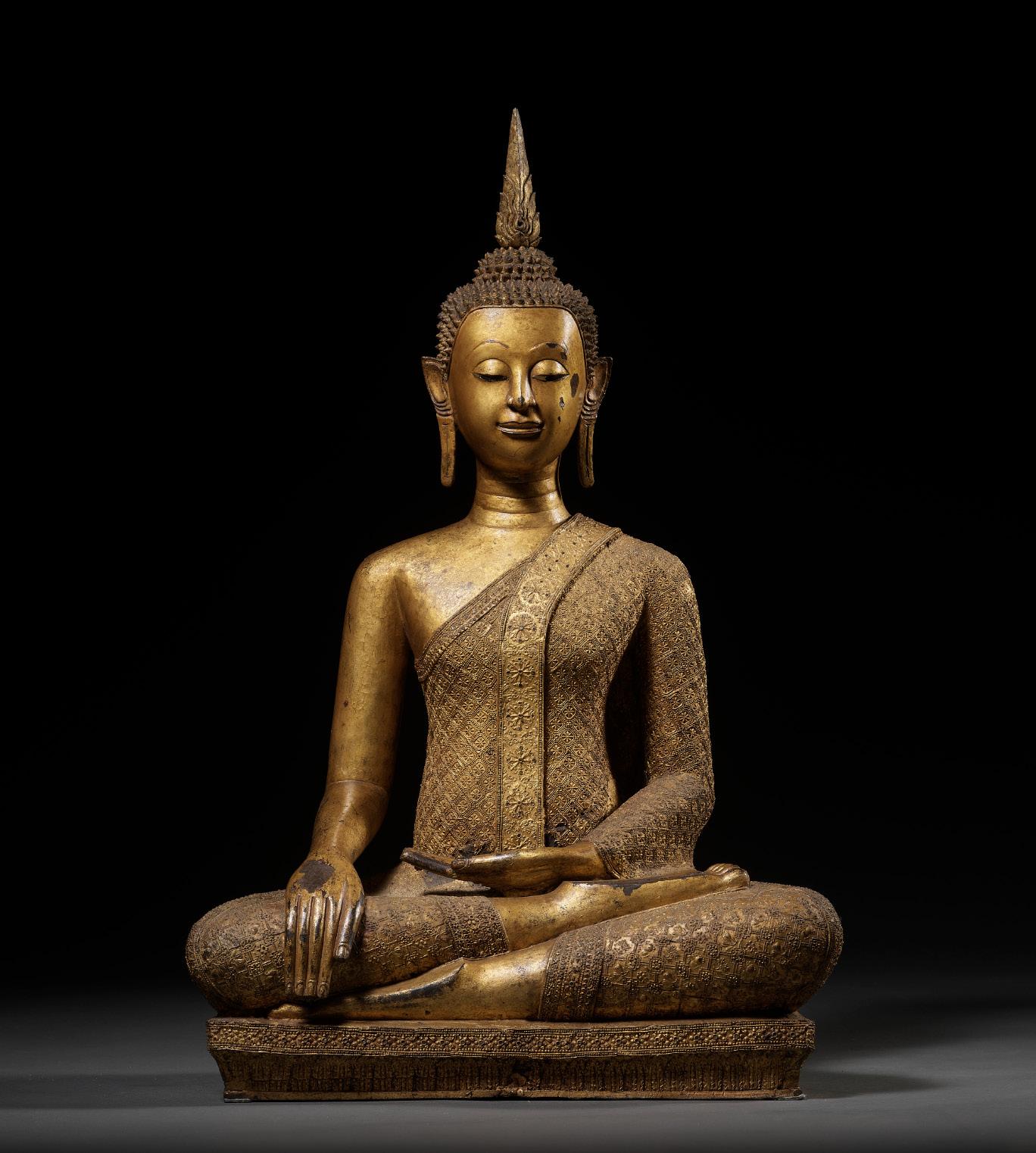
Expert remark: Compare the closely related pose, robe, and face. Note the related size (90 cm). Note the missing flame.
Estimate EUR 10,000
Starting price EUR 5,000
390 257
258 A MAGNIFICENT BRONZE HEAD OF BUDDHA, SUKHOTHAI KINGDOM
Thailand, 15th-16th century. The serene face with arched eyebrows above heavy-lidded downcast eyes, a broad nose with incised nostrils, thin lips forming a benevolent smile, the chin heightened with incision work as well, flanked by long pendulous earlobes, the hair in tight curled spikes with a raised ushnisha.
Provenance: From a noted Hungarian private collection. Condition: Good condition, commensurate with age, with expected old wear, small nicks here and there, obvious losses, some encrustations, minor casting irregularities, and a small aperture beside the ears. Naturally grown, almost black patina overall.
Weight: 4,974 g (incl. stand)
Dimensions: Height 24.5 cm (excl. stand), 35.7 cm (incl. stand)
Mounted to a modern stand. (2)
Expert’s note: Over the centuries, the bronze has naturally patinated into a dark green, almost black tone with an unctuous feel to the surface, creating an overall not only elegant, but also meditative appearance.
The Sukothai kingdom lasted for just two centuries but was an extremely wealthy and powerful period in the history of Thailand. Artists produced some of the most sophisticated and original sculpture found in the history of Thailand. For example they were the first to depict Buddha in four different attitudes: standing, seated, walking and reclining. The influence of this period can be seen in Thai sculpture throughout subsequent centuries. Religious texts prescribed strict definitions as to how Buddha should be depicted and these rules were firmly adhered to while maintaining an inspiring and meditative fluidity of line.
AUCTION RESULT COMPARISON
Type: Related
Auction: Christie’s London, 11 May 2016, lot 94
Price: GBP 20,000 or approx. EUR 29,500 converted and adjusted for inflation at the time of writing
Description: A fine bronze head of buddha, Thailand, Sukhothai period, 15th century Expert remark: Compare the closely related facial features, particularly the eyes, brows, nose, and ears, and the remarkably fine lines. Note the size (33 cm).

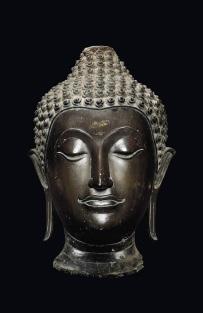
Estimate EUR 6,000
Starting price EUR 3,000
391
§ 1) The auction shall be carried out in accordance with the provisions of the rules of procedure of GALERIE ZACKE©, SZA VERSTEIGERUNGEN UND VERTRIEBS GMBH, Sterngasse 13, 1010 WIEN (hereinafter referred to as the company) as well as in accordance with sections 244-246 of the GEWERBEORDNUNG [Industrial Code] of 1994. The auction shall be carried out on commission. The auctioneer shall be entitled to withdraw lots exceptionally, to conduct the auction deviating from the order of the catalog numbers and to offer lots jointly. In the event of any dispute concerning a double bid or if the auctioneer has missed a bid, the auctioneer shall be entitled to revoke acceptance of a bid and to continue auctioning the item. The figures stated in the catalog shall be the highest bid in Euro (€) expected by the respective expert. As a rule, the bid shall be increased by 10% of the last bid. (See table of the bidding increments).
§ 2) The acceptance of a bid shall be granted to the highest bidder unless a hidden reserve has been agreed upon with the consignor of the item in question. Such a hidden reserve (also called limit or just reserve) shall be the minimum price under which the item will not be sold during the auction. This reserve will be disclosed upon request and after the auction only and may exceed the estimate. The auctioneer will in this case bid on behalf of the seller against all other bidders until the reserve has been reached. If a reserve is not reached during the auction, the auctioneer will knock down the item to the highest bidder at the final bid, but the sale will be conditional of the acceptance of this final bid by the seller. In this case the highest bidder shall be bound to his/her last bid for a term of 8 days starting with the day of the knockdown. If the winning bidder does not receive a written cancellation notice within this term of 8 days, the knockdown becomes unconditional and the sale is final. Typically, only a minority of all items in an auction have a hidden reserve.
§ 3) Most items shall be subject to differential taxation. A uniform surcharge of 25% plus the value added tax applicable to the surcharge to the amount of 20% shall be added to the achieved highest bid (final and highest bid). Thus, the surcharge shall be 30% of the final and highest bid in total. Items with added VAT are marked † in the online catalog.
§ 4) In the event of sales abroad, the value added tax will be repaid if the item is sold to a country which is not a member country of the European Union (third country), the legal requirements are met, and the proof of exportation is provided. The value added tax shall not be shown separately on the invoice.
§ 5) The auction buyer must pay the purchase price immediately upon acceptance of the bid (final and highest bid plus 25% surcharge, plus the value added tax applicable to the surcharge to the amount of 20%, or the added VAT on top of the final price, when a lot is highlighted accordingly in the auction catalog). The company may grant an auction buyer a term of payment for the purchase price in whole or in part when this has been formally applied for in writing before the auction.
§ 6) In the event of a term of payment, or any payment delay, in whole or in part, the company shall be entitled to charge default interest (12% p.a.) as well as storage charges (2.4% pf the final and highest bid per month commenced) after 14 days upon acceptance of the bid. The item purchased at auction shall be handed over exclusively upon full payment of the purchase price including all costs and charges accrued since the acceptance of the bid.
§ 7) The buyer should take acquired items into possession, as far as possible, immediately or after the end of the auction. Items which have been fully paid for shall be handed over in our show rooms in GALERIE ZACKE, Sterngasse 13, 1010 VIENNA. If a deferred purchase price is not paid within the set period, the company shall be entitled to auction the item again in order to recoup its claim from the defaulting auction buyer. In this case, the defaulting auction buyer shall be liable to the company for the total loss of commission incurred by the company due to the re-auctioning as well as for any default interest and storage charges.
§ 8) The company shall be entitled to a lien on all items of the buyer irrespective of whether the buyer bought them within the scope of an auction or in free sale or the company secured ownership of these items otherwise. This lien shall serve to secure all current and future, qualified, limited and unmatured claims to which the company is entitled and which result from all legal transactions concluded with the buyer.
§ 9) The items received for auction will be exhibited and may be viewed prior to the auction. In doing so, the company shall give everyone the opportunity to check the nature and the condition of the exhibited items to the extent deemed possible within the scope of the exhibition. Every bidder shall be deemed to act on its own behalf unless it provides a written confirmation saying that it acts as a representative or agent of a well-known principal. The company may refuse bids; this shall particularly apply if a bidder who is unknown to the company or with whom the company has no business connections yet does not provide a security deposit before the auction. However, in principle there shall be no claim to accept a bid. If a bid has been refused, the previous bid shall remain effective.
§ 10) The company’s experts evaluate and describe the items received for auction and determine the starting prices unless otherwise stated in the catalog or expert opinion. The information concerning production technique or material, state of preservation, origin, design and age of an item is based on published or otherwise generally accessible (scientific) findings concluded by the company’s expert with the necessary care and accuracy. The company shall warrant to the buyer according to §34-38 of the AGB (Terms and Conditions) that properties are correct provided that any complaints referring to this are made within 45 days after the auction day. Subsequent complaints shall be excluded in principle. The company shall not be liable for any further information in the catalog and expert opinion as well. This shall also apply to illustrations in the catalog. The purpose of these illustrations is to guide the potential buyer during the preview. They shall not be authoritative for the condition or the characteristics of the pictured item. The published condition reports shall only mention defects and damage affecting the artistic or commercial value significantly. Complaints concerning the price shall be excluded upon acceptance of the bid. The company reserves the right to amend the catalog online prior to the auction. These amendments shall also be made public orally by the auctioneer during the auction. In this case, the company shall be liable for the amendment only. All items offered may be checked prior to the auction. These items are used. Any claims for damages exceeding the liability named above and resulting from other material defects or other defects of the item shall be excluded. When making the bid, the bidder confirms that he/she has inspected the item prior to the auction and has made sure that the item corresponds to the description.
§ 11) If a customer is not able to participate in an auction personally, the company shall accept purchase orders. These orders may be placed in writing via mail, e-mail, fax, www.zacke.at or a third party bidding platform. In the case of a purchase order placed by phone or orally, the company shall reserve the right to make the performance dependent on a confirmation from the principal communicated in writing. Furthermore, the company shall not be liable for the performance of purchase orders. Equal purchase orders or live bids will be considered in the order of their receipt. Bids which below the estimate shall be exhausted completely. Bids which do not correspond to the increments determined by the company (see bidding increment table) will be rounded up to the next higher increment. The table of these increments can be sent upon request. The written bid (purchase order) must include the item, the catalog number and the offered top bid limit which is quoted as the amount of the acceptance of the bid without buyer’s commission and without taxes.
Ambiguities shall be carried by the bidder. A purchase order which has already been placed may only be cancelled if the written withdrawal is received by the company at least 72 hours prior to the beginning of the auction.
§ 12) The company may refuse a purchase order without explanation or make its execution dependent on payment of a security deposit. In the event of an unsuccessful order, such a deposit will be reimbursed by the company within 5 working days. Processing of purchase orders is free of charge.
§ 13) Every seller shall in principle be entitled to withdraw the items offered for auction until the start of the auction. Therefore, it is impossible to assume liability or to give warranty for the actual offering.
§ 14) Paid items must be collected within 30 days after payment. Items which have not been collected may be re-offered without further communication at the starting price from the recent auction reduced by 50%. Items which have not been collected within 30 days after the auction or for which the company does not receive any proper shipping instructions stating the type of shipping and the address of dispatch (independent of a possibly placed purchase order) shall be stored at the owner’s risk. Furthermore, the company shall be entitled to store items which have been purchased at auction and paid but not collected at the buyer ś risk and expense, including the costs for an insurance, with a forwarding agency. It shall be understood that the provision concerning the re-auctioning of unpaid and paid but not collected items must also apply to items not exhibited or stored on the premises of the company. The ownership shall be transferred to the buyer at the time of handing over the issuing note.
§ 15) In the case of mixed lots with a starting price of less than EUR 350.00, the company shall not warrant for the completeness or correctness of the individual items within a mixed lot.
§ 16) A registration for a bid by telephone for one or several items shall automatically represent a bid at the estimate price of these items. If the company cannot reach a bidder by telephone, it will bid on behalf of this bidder up to the estimate price when the respective lot is up for auction.
§ 17) Payments made to the company by mistake (through the payer ś fault) (e. g. due to miscalculation of the exchange rate by the payer) or payments made to the company for the same invoice several times shall be compensated in form of a credit note for goods for an indefinite period of time. The repayment of such payments in cash shall be excluded.
§ 18) Certain auction lots may exist several times (multiples). In such a case, the auctioneer may accept a second, third or even more bids from the underbidder(s). In this case, the text in the catalog and not the illustration shall be exclusively binding with regard to the warranty.
§ 19) The company reserves the right to assign to the buyer all rights and obligations resulting from the contractual relationship between the company and the seller by way of a respective declaration, as well as to assign to the seller all rights and obligations resulting from the contractual relationship between the company and the buyer by way of a respective declaration, in each case in terms of a complete assignment of contract with the result that the contractual relationship - following the submission of the aforementioned declarations by the company – shall exclusively be between the seller and the buyer, all of which is in accordance with the basic model of the commission agreement. Buyers and sellers shall already now give their explicit consent to this contract assignment.
§ 20) The place of performance of the contract brought about between the company on the one hand and the seller as well as the buyer on the other hand shall be the place of business of the company. The legal relationships and contracts existing between the company, the sellers and the buyers shall be subject to Austrian law. The company, the sellers and the buyers shall agree to settle all disputes resulting from, concerning and in connection with this contract before the territorially competent court of Vienna.
§ 21) The export of certain art objects from Austria shall require a permit from the Bundesdenkmalamt [Federal Monuments Office]. The company will orally provide information about art objects for which such export permit will probably not be granted at the beginning of the auction.
§ 22) Whenever making a bid, whether personally or via an agent, in writing, online, telephone, or in any other way, the bidder fully and unconditionally accepts the Terms of Auction, the ‘Important Information’ section in the auction catalog, the Terms and Conditions (AGB) of Galerie Zacke, §1-50, the Fee Tariff, and the Bidding Increments table, all as published on www.zacke.at on the day of the auction.
TERMS OF AUCTION
Lynn Greenwold, Gloucestershire
The Neame family collection, Chesham
Dr. Anton C.R. Dreesmann (1923-2000)
Felix Tikotin (1893-1986)
Adolf Georg Otto „Ago“ von Maltzan, Freiherr zu Wartenberg und Penzlin (1877-1927)
Dr. Cornelius Osgood (1905-1983)
Soo Sui-ling
Jerry Vest and Peter Kuring (1951-1987), Woollahra, Sydney
Gottfried Hertel (1925-2019) and Helga (1928-2013) Hertel, Cologne
The Ji Zhen Zhai Collection
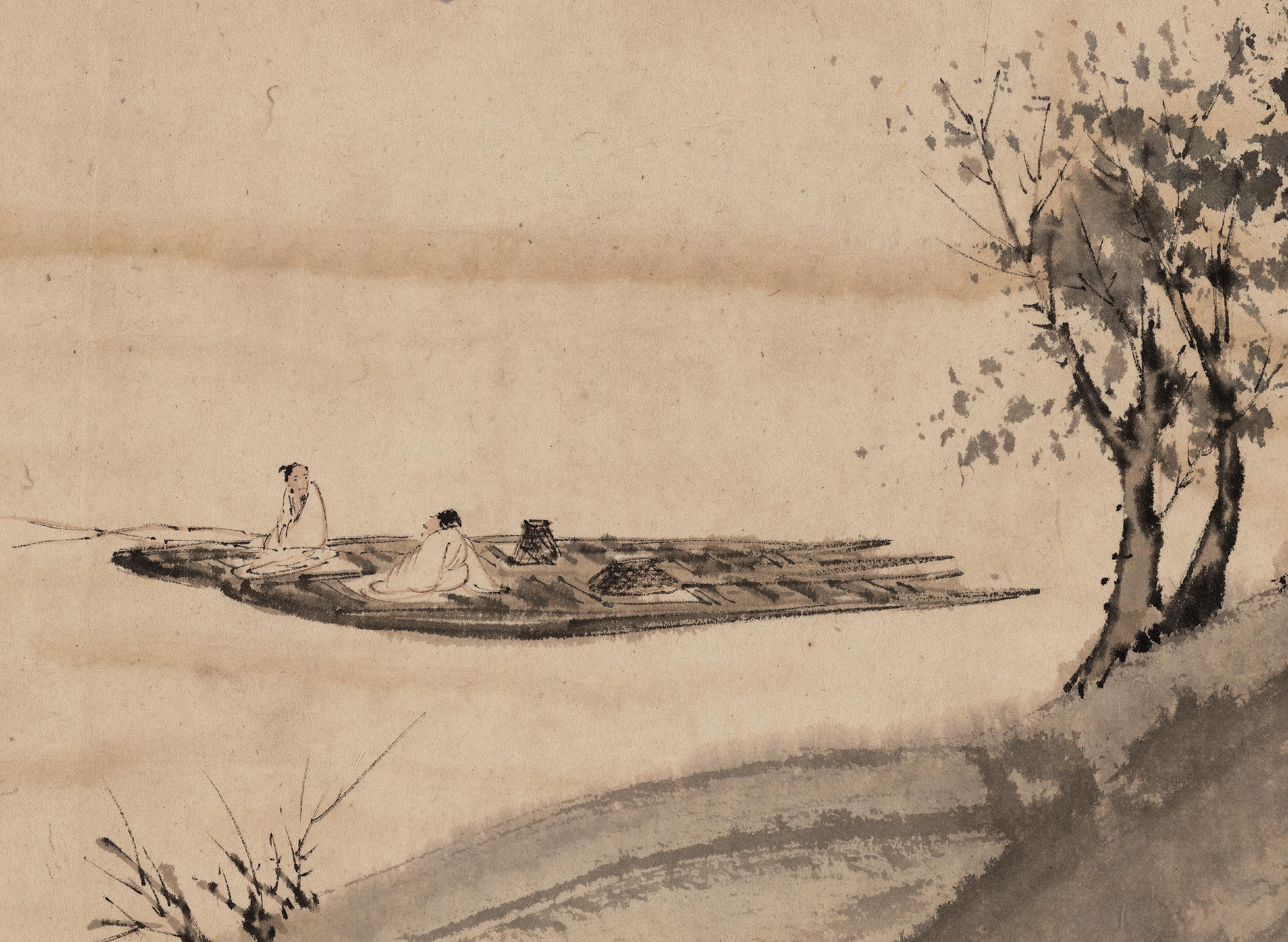
Dr. John Fong, Philadelphia
Dr. David McCay, England
Anthony Powell (1935-2021), London
Bertin Verstraete, Belgium
Inez Utter (née Bonnier, 1890-1968) and Tore Utter (1880-1953)
Theodore Schrire (1906-1991), Cape Town, South Africa
Dr. Aurel Gonda (1885-1964)
The John C. (d. 2021) and Susan L. Huntington Collection, Columbus
John Marsing (1918-1998)
Angela Trueb (1918-1991), Somerset
Jan Ellen Finch (1952-2021)
Provenance list starts on the inside front cover
Monsieur E., France
The Folker Collection, Denmark
Inger Lissanevitch (née Pheiffer, 1928-2013)
Michael Phillips (born 1943)
The Phillips Family Collection, Lawrence and Shirley Phillips
The Triay Collection of Himalayan Art
The Richard & Magdalena Ernst Collection of Himalayan Art
Hazel Elfwendahl (1923-2018)
Kono Shuson (1890-1987), Japan
The Oliver Impey (1936-2005) Collection of Modern Paintings
Amanda and Alex Torri, Bologna
Camille Mines (1950-2018), Luxembourg
René Mines
Acher Eskenasy
LP Collection Paris, France
Yvette Starck, Luxembourg
Dr. René Schroeder, Luxembourg
Collection of Elisabeth Maria Coebergh, Paris
Friedrich A. Hof
The collection of Jean-Pierre Yonan (1943-2019), London
Godfried Wauters
Anton Exner (1882-1952), Vienna
Sören Ström (1934-2021)
Robert H. Ellsworth, New York
Charles M. Blackmon, South Carolina, USA
Collection of Mr. and Mrs. J. L. Sharpe, Strasbourg, France
Giannozzo Pandolfini, Homo Sapiens, Florence
Natanael Wessén
Laurent Wannieck, Paris
Gabriele Aronica, Rome
Anacleto Spazzapan (b. 1943)
John O’Hara, Philadelphia
William Martin-Hurst (1876-1941)
House of Bergenstråhle, Sweden
Anthony Gustav de Rothschild, United Kingdom
R. Marian Hicks, OBE
David Dunham, United States
Salisbury Langton Dennis (b. 1906)
Dr. Neill Kendall
Peter Sloane, London
Joost Slingerland, Yorkshire, United Kingdom
Dr. Frederick Whiting (1861-1946)
Roger Hollander (1934-2018)
Dr. Ma Luk (1883-1963), Hong Kong
Professor Jocelyn Chey, Sydney
Valdemar’s Castle, Tåsinge, Denmark


1010 VIENNA AUSTRIA STERNGASSE 13 www.zacke.at Tel +43 1 532 04 52 . Fax +20 E-mail office@zacke.at























































































































































































































































































































































































































































































































































































































































































































































































 SCHROEDER
SCHROEDER


 John Marsing (1918-1998)
John Marsing (1918-1998)







































































































































 DAQIAN (1899-1983)
DAQIAN (1899-1983)












































































































































































































